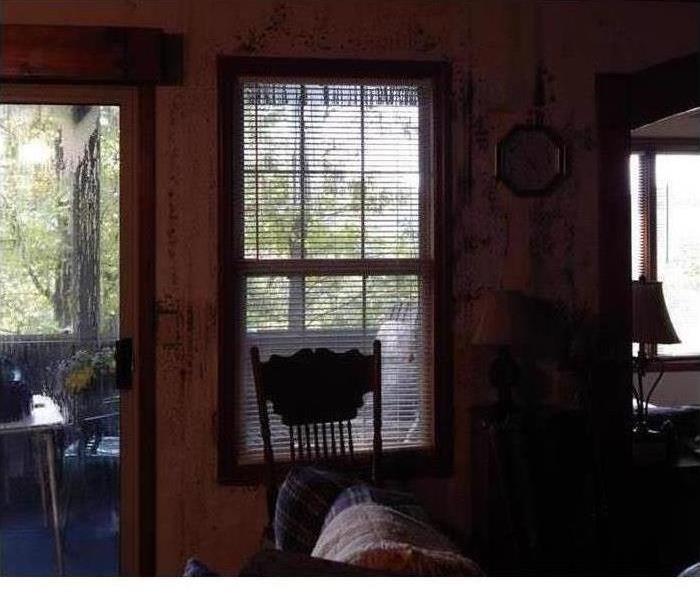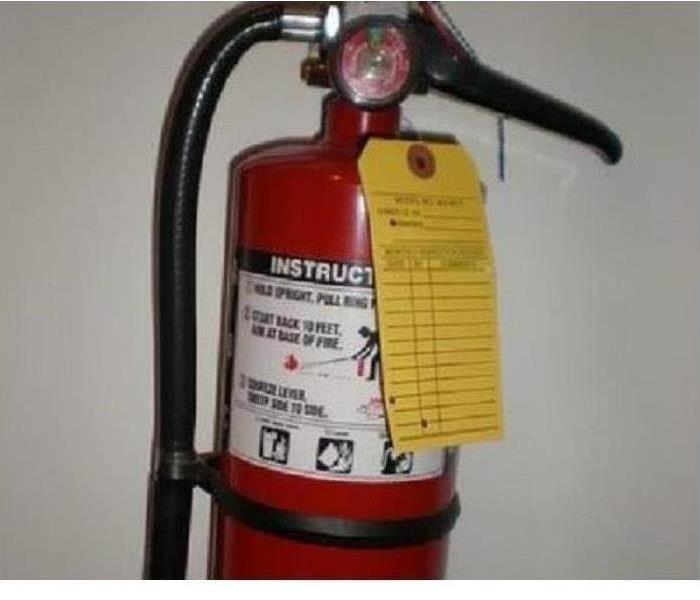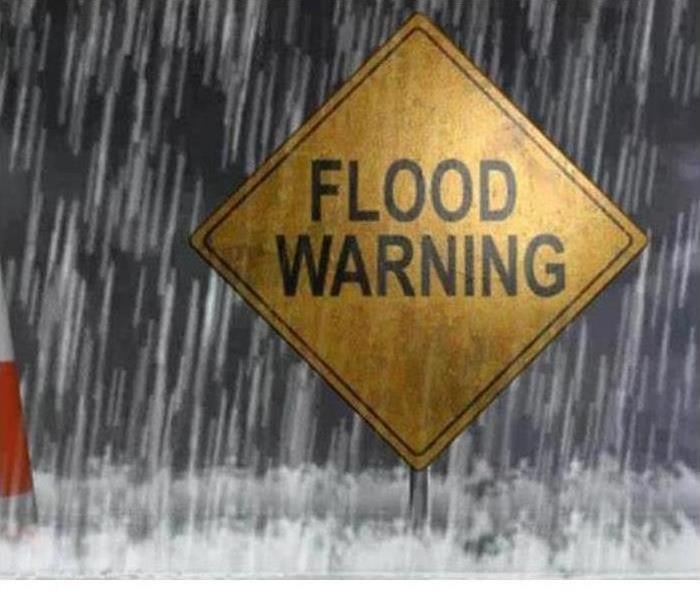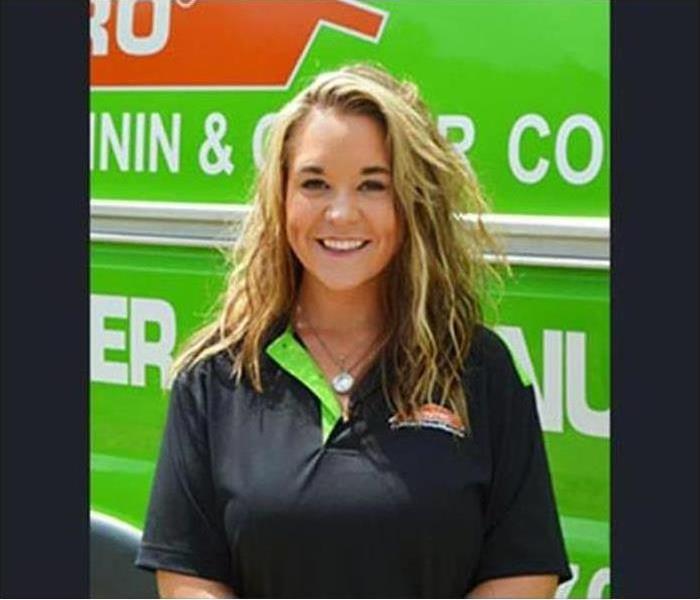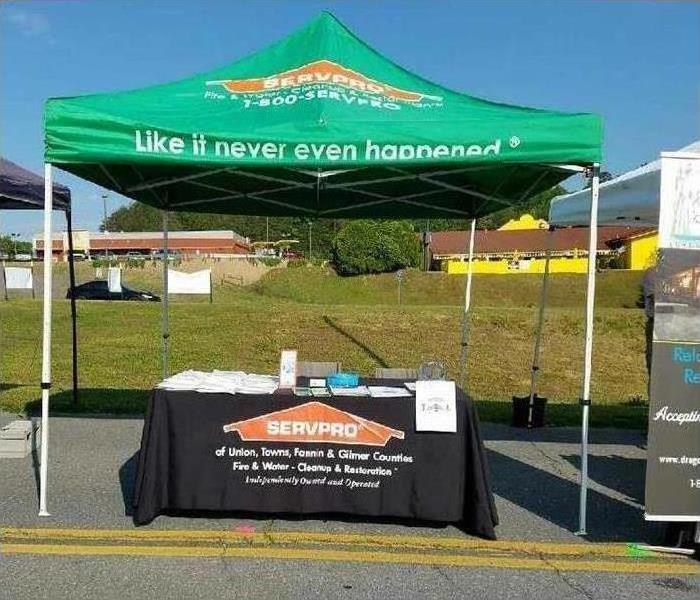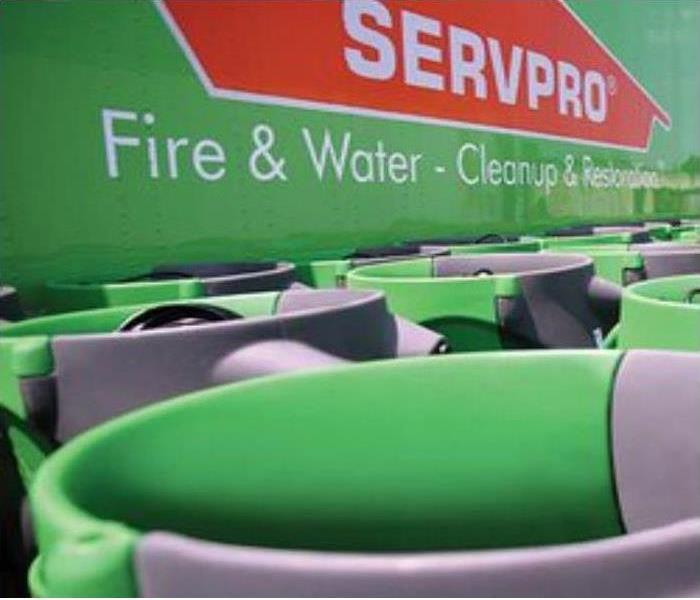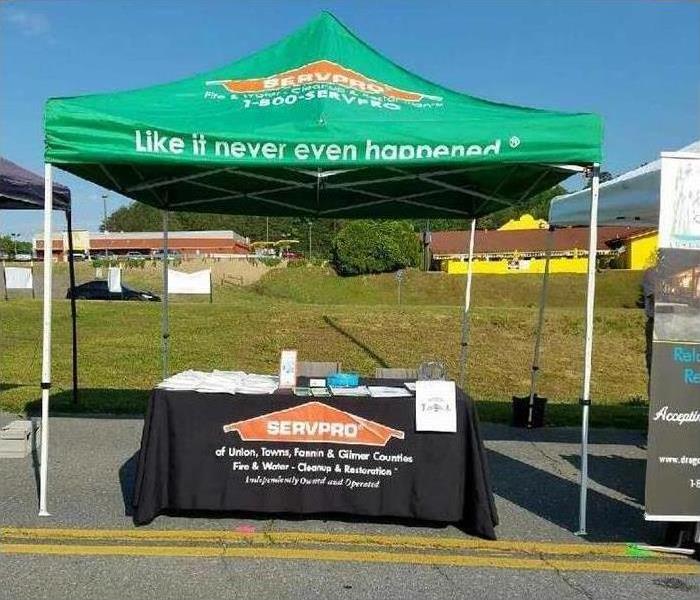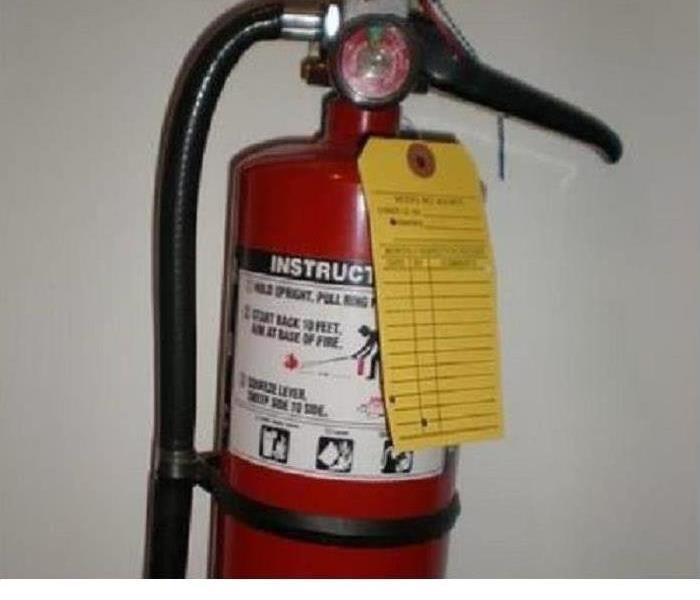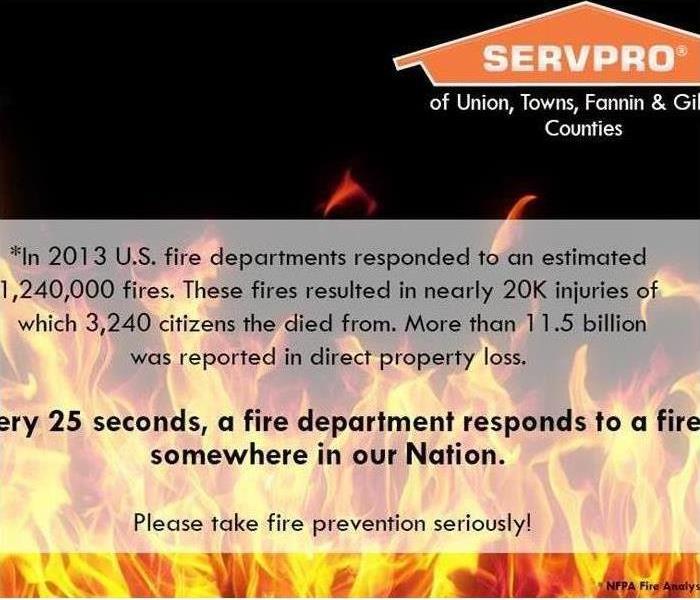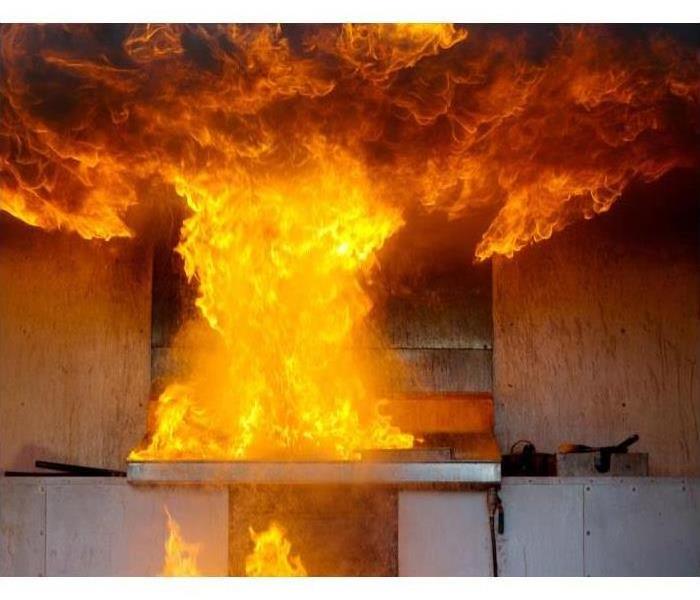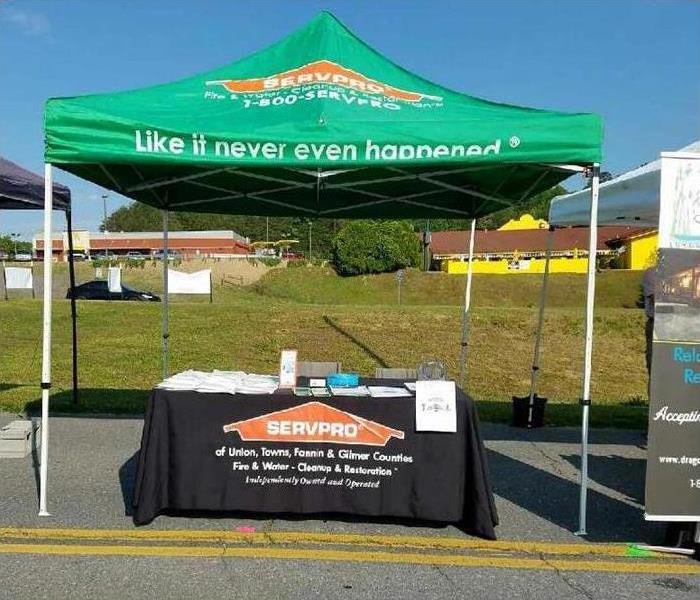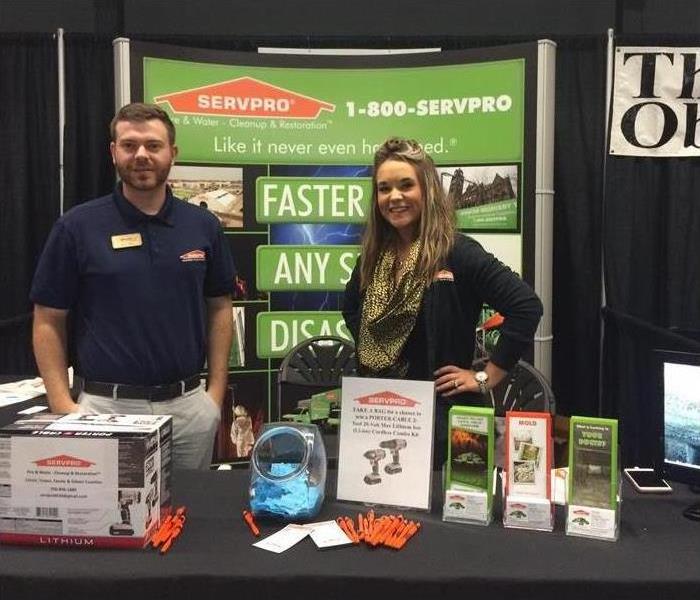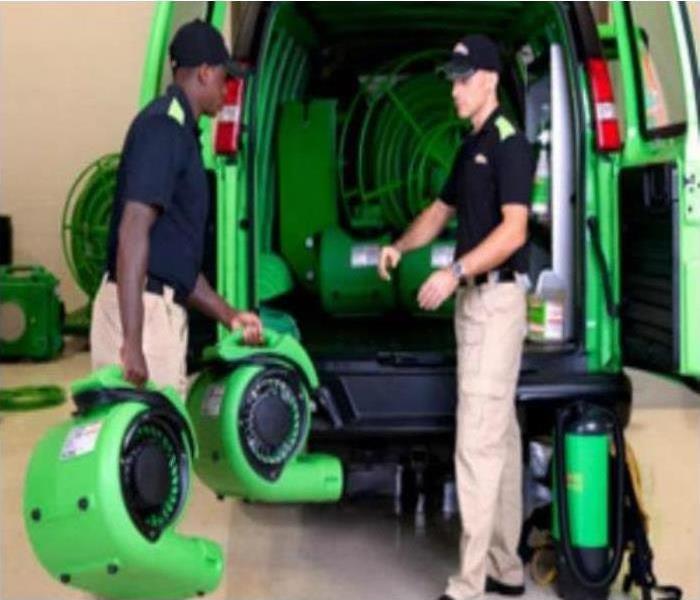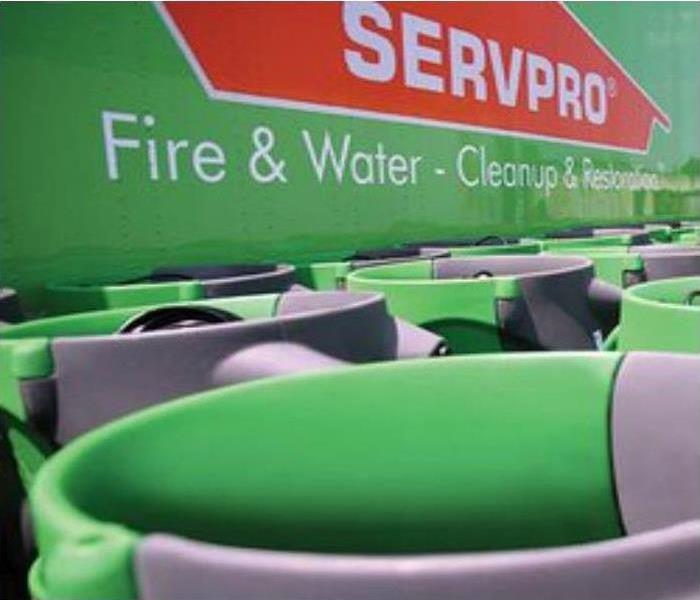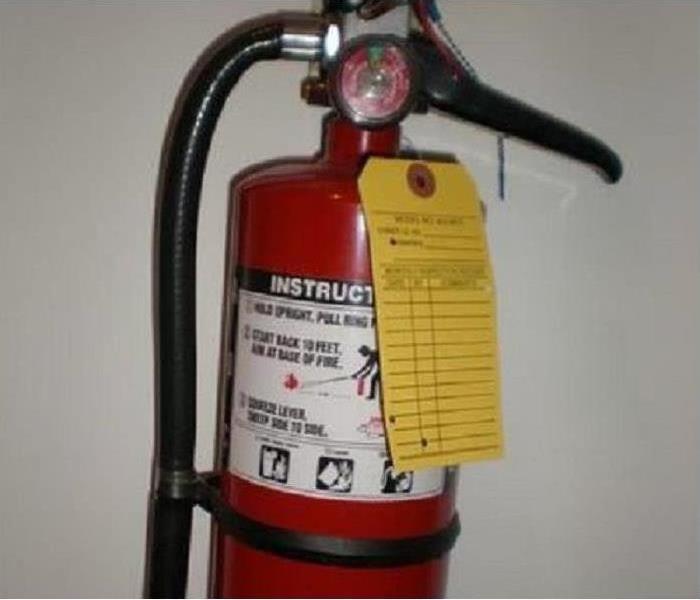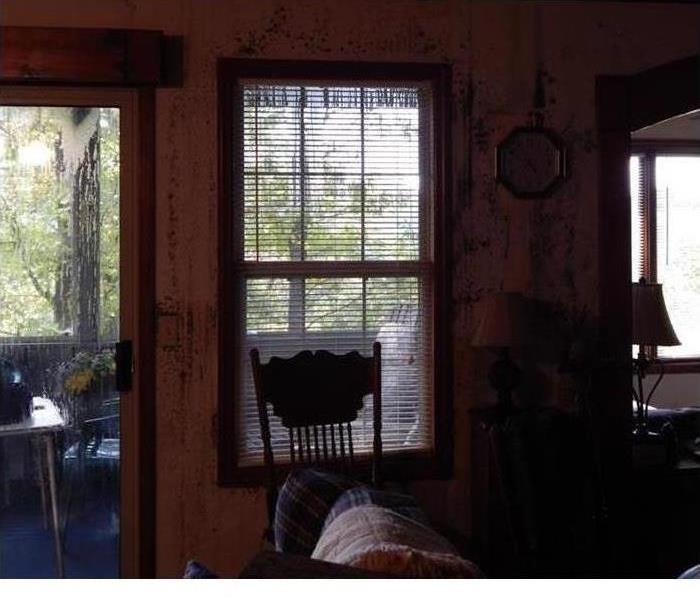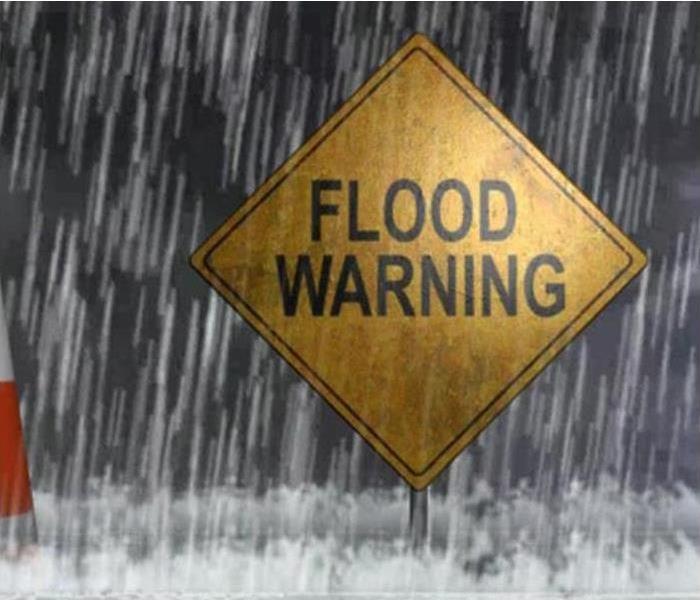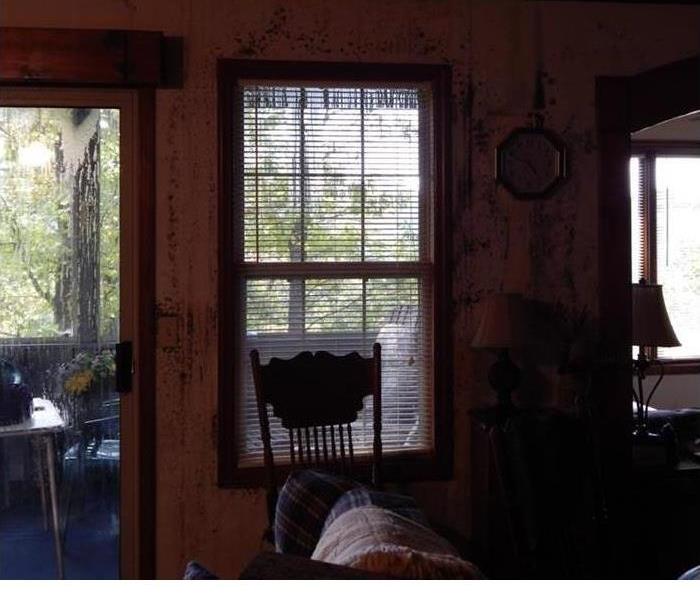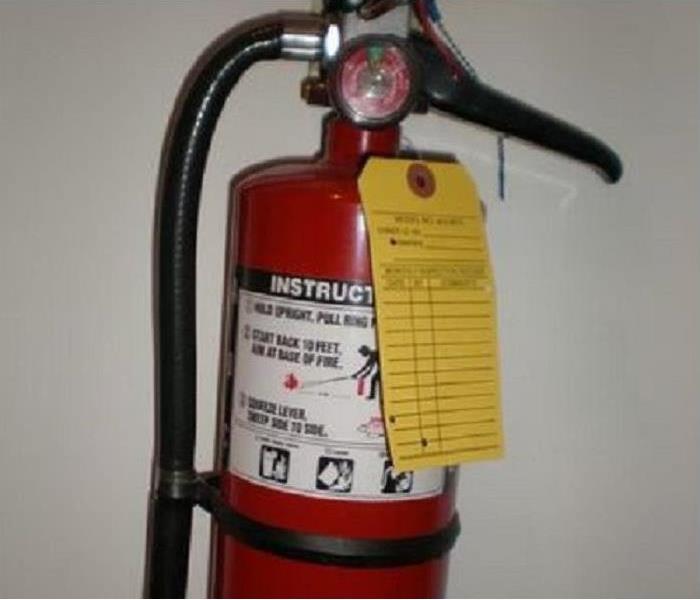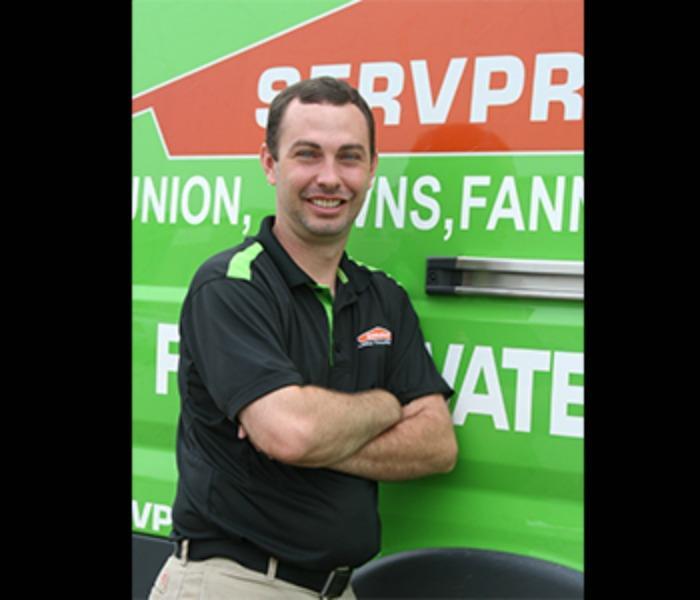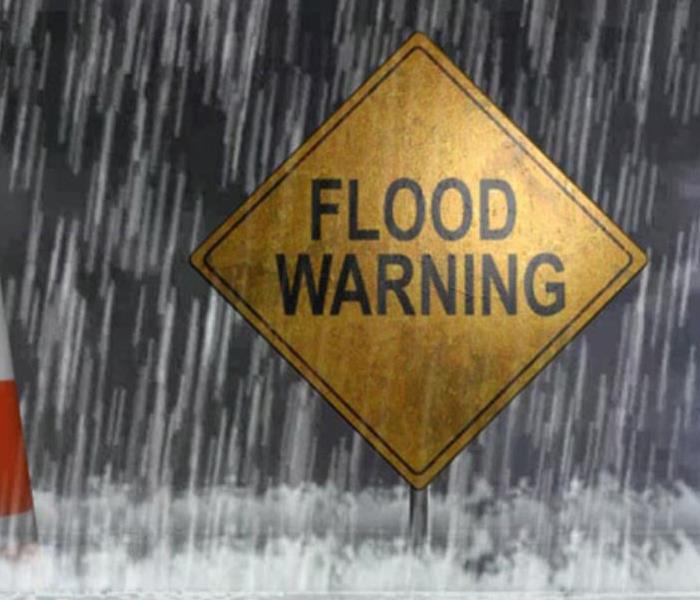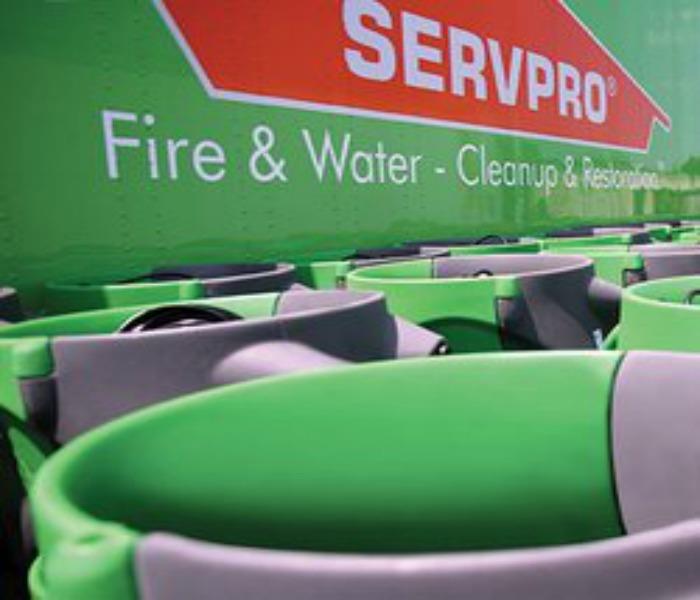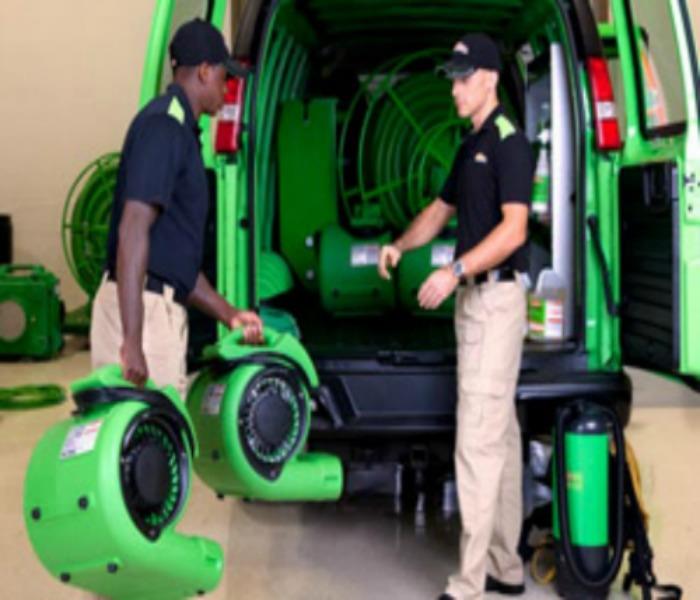Archived Blog Posts
Grease Fire Prevention: 8 Effective Tips For Your Kitchen
4/29/2024 (Permalink)
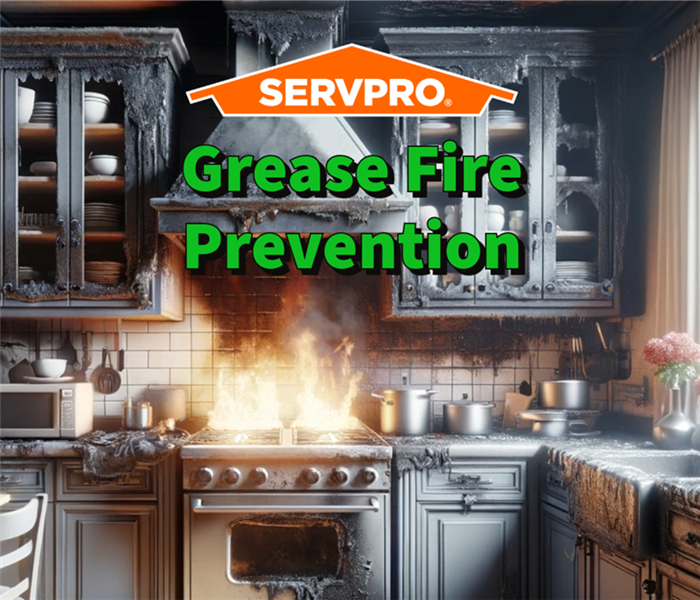 The professionals at SERVPRO are ready to help you combat fire damage caused by a grease fire.
The professionals at SERVPRO are ready to help you combat fire damage caused by a grease fire.
Navigate the risks of kitchen fires with our expert guide on effective grease fire prevention strategies.
Cooking is a daily activity that, while necessary and enjoyable, comes with significant fire risks if not managed properly. Grease fires, in particular, pose a daunting threat due to their common occurrence and potential for rapid spread. This blog post will explore the critical steps for preventing grease fires in kitchens. We will also highlight a recent incident where SERVPRO® intervened to manage and restore after a severe grease fire.
Understanding Grease Fires
A grease fire occurs when cooking oil becomes too hot and ignites. It typically starts in a pan or skillet and quickly escalates to other combustible items. These fires are intensely hot and can cause significant damage to a kitchen in moments.
Causes of Grease Fires
- Unattended Cooking: Leaving cooking oil unmonitored on the stove.
- High Cooking Temperatures: Not adjusting heat settings appropriately when cooking with oil.
- Improper Handling of Cooking Equipment: Using pans unsuitable for high-heat cooking.
Preventative Measures for Grease Fire Safety
- Stay in the Kitchen: Always be present when cooking, especially when using oil or frying foods.
- Heat Management: Gradually heat oil and avoid cooking above recommended temperature settings.
- Appropriate Cookware: Use heavy-duty pans that properly distribute heat and handle high temperatures.
- Regular Cleaning: Keep your stove and oven free from built-up grease that could ignite.
- Install a Smoke Detector: Ensure a functional smoke detector is near the kitchen.
- Keep a Fire Extinguisher: Have a Class K fire extinguisher accessible in your kitchen at all times.
- Emergency Plan: Educate all household members about what to do in case of a fire, including how to smother a grease fire with a metal lid or baking soda (never water!).
- Professional Inspection: Have your kitchen appliances and exhaust systems professionally inspected annually.
A Cautionary Tale from Blue Ridge, Georgia
A family in Blue Ridge recently experienced a frightful wake-up call when a grease fire erupted in their kitchen. The fire started when a pan of oil was left unattended on the stove and reached ignition temperature. Fortunately, no one was injured, but the kitchen suffered extensive damage.
Rapid Response:
The homeowner immediately called SERVPRO, and our team responded swiftly. Upon arrival, we assessed the situation and began fire mitigation procedures.
Restoration Steps:
Our specialists cleaned all surfaces to remove soot and grease, replaced damaged cabinetry, and used advanced deodorizers to eliminate smoke odors. The kitchen was restored to its pre-fire condition, adhering to the highest safety and quality standards.
Preventive Advice:
After the restoration, we provided the homeowners with grease fire prevention tips and recommended installing a stovetop guard to prevent future incidents.
This incident underscores the necessity of vigilance in the kitchen and the effectiveness of prompt, professional intervention by SERVPRO.
What to Do if a Grease Fire Occurs
- Do Not Use Water: Throwing water on a grease fire will cause it to spread.
- Turn Off the Heat: If it is safe, turn off the heat source.
- Cover with a Metal Lid: Smother the flames with a metal lid or cookie sheet.
- Use Baking Soda for Small Fires: If the fire is small, sprinkle baking soda to extinguish the flames.
- Call for Help: If the fire does not go out immediately, leave the house and call 911.
Your Safety is SERVPRO's Priority
Preventing grease fires is vital to ensuring kitchen safety. By following these tips, you can significantly reduce the risk of a fire in your Blue Ridge home. SERVPRO is ready to respond with fast, professional service to manage fire damage restoration if a grease fire happens. We are committed to helping you recover quickly and efficiently, with minimal disruption to your life.
Weatherproofing 101: Ultimate Guide to Protect Your Property
3/25/2024 (Permalink)
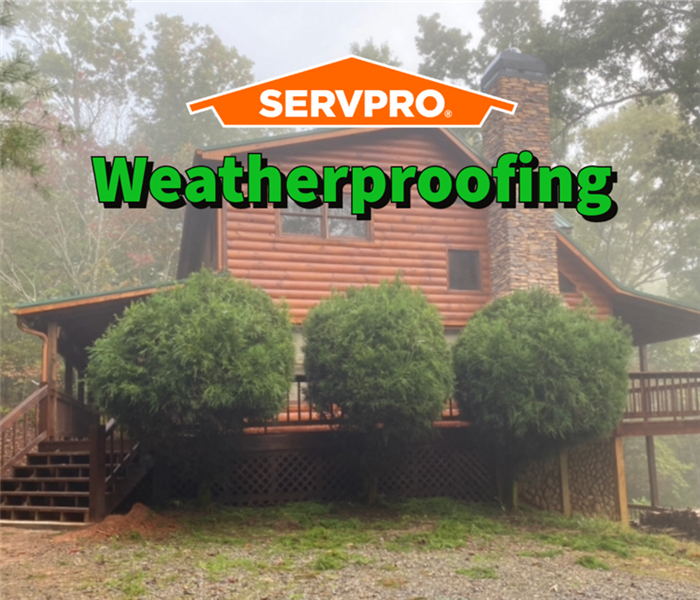 The professionals at SERVPRO understand the importance of safeguarding your property with quality weatherproofing!
The professionals at SERVPRO understand the importance of safeguarding your property with quality weatherproofing!
Discover how property damage restoration experts can help shield your Blue Ridge home from the elements
Weatherproofing your property is not just about shielding it from the elements; it's about fortifying your home against nature's fury and safeguarding your peace of mind. This comprehensive guide delves into the importance of weatherproofing, discusses common vulnerabilities, and describes essential steps to weatherproof your home. We will explore a scenario in Blue Ridge, Georgia, where a homeowner faced the consequences of inadequate weatherproofing and turned to SERVPRO® for expert assistance.
Understanding the importance of weatherproofing
Weatherproofing is the proactive approach to protecting your property from adverse weather conditions, including rain, snow, wind, and extreme temperatures. By weatherproofing your home, you can:
- Prevent water intrusion: Proper weatherproofing measures help prevent water infiltration, reducing the risk of moisture damage, mold growth, and structural deterioration.
- Enhance energy efficiency: Weatherproofing improves insulation and seals air leaks, reducing energy consumption and utility costs associated with heating and cooling.
- Increase property value: A weatherproofed home is more resilient to weather-related damage, enhancing its overall value and market appeal.
- Ensure comfort and safety: Weatherproofing creates a comfortable and safe indoor environment by minimizing drafts, temperature fluctuations, and moisture-related issues.
A recent scenario in Blue Ridge, Georgia: The consequences of inadequate weatherproofing
In Blue Ridge, Georgia, a homeowner experienced recurring water leaks during heavy rain and drafts during extreme cold periods. Concerned about the potential damage and ongoing discomfort, the homeowner sought professional property damage restoration assistance from SERVPRO to assess and address the weatherproofing vulnerabilities.
Professional weatherproofing assessment
Upon arrival, our SERVPRO team conducted a comprehensive weatherproofing assessment, examining the exterior envelope, roofing system, windows, doors, and foundation for vulnerabilities. We utilized advanced technology and expertise to identify areas prone to water infiltration, air leaks, and structural weaknesses.
Seal and insulate
Our assessment recommended sealing gaps, cracks, and openings in the building envelope to prevent water intrusion and air leakage. We also applied weatherstripping around windows and doors, installed caulking and sealants, and insulated attic spaces and exterior walls to enhance thermal efficiency.
Roof inspection and maintenance
We thoroughly inspected the roofing system to safeguard against roof leaks and water damage, identifying missing shingles, damaged flashing, and deteriorating seals. We performed necessary repairs, reinforced flashing around chimneys and vents, and cleared debris from gutters and downspouts to ensure proper drainage.
Upgrade windows and doors
Inadequate windows and doors can compromise weatherproofing efforts, allowing water and air infiltration. To enhance insulation and durability, we recommend upgrading to energy-efficient windows and doors with double—or triple-pane glass, low-emissivity coatings, and weatherproof seals.
Foundation waterproofing
A strong foundation is essential for weatherproofing your home and maintaining structural integrity. We inspected the foundation for cracks, leaks, and moisture intrusion, applied waterproof coatings, installed drainage systems, and graded the landscape to direct water away from the property.
Ongoing maintenance and monitoring
Weatherproofing is an ongoing process that requires regular maintenance and monitoring. We provided the homeowner with maintenance tips and schedules to preserve the effectiveness of weatherproofing measures and ensure long-term protection against the elements.
Partner with SERVPRO for comprehensive weatherproofing solutions
Weatherproofing your home is a proactive investment in protection, comfort, and peace of mind. With SERVPRO as your trusted partner, you can weatherproof your property confidently, knowing that skilled professionals are dedicated to fortifying your home against nature's fury.
When it comes to weatherproofing, don't wait for the next storm to strike—take proactive steps today to safeguard your Blue Ridge, Georgia, home with SERVPRO. Let us help you weatherproof your property and prepare for whatever nature may bring. With SERVPRO by your side, your home can weather any storm and emerge more robust and resilient.
The 7 Effective Property Restoration Safety Measures We Use
2/26/2024 (Permalink)
 SERVPRO professionals always prioritize property restoration safety!
SERVPRO professionals always prioritize property restoration safety!
When you work with SERVPRO® after property damage, you can be sure we keep property restoration safety in mind!
Safety meets restoration excellence here at SERVPRO. This comprehensive blog post explores the importance of property restoration safety and why SERVPRO is the premier choice for safeguarding your assets. Drawing upon real-life experiences and expertise, we showcase a scenario from Blue Ridge, Georgia, where a distressed property owner turned to SERVPRO after a devastating loss, highlighting our commitment to restoring properties while prioritizing safety. Join us as we delve into the intricacies of safety restoration and discover why SERVPRO is your trusted partner in property recovery.
What does it mean to restore a property?
Restoring a property goes beyond physical repairs, encompassing safety and security. At SERVPRO, we understand the holistic nature of property restoration, prioritizing safety as a fundamental aspect of our services. From assessing structural integrity to mitigating hazards, we aim to restore your property to a safe and habitable condition, ensuring peace of mind for you and your loved ones.
A recent example of property restoration safety:
Recently, a quaint residence in Blue Ridge, Georgia, faced a sudden and catastrophic event. This extensive fire outbreak left the property in shambles, with structural damage and safety hazards.
Recognizing the urgent need for professional assistance, the homeowner contacted SERVPRO for help. Our expert team swiftly responded, thoroughly assessing the property's safety risks and devising a comprehensive restoration plan.
From securing unstable structures to mitigating hazardous materials, SERVPRO's meticulous approach ensured the restoration of the property and the safety and wellbeing of its occupants. Amidst the chaos, our commitment to safety shone brightly, guiding the property towards a swift and secure recovery.
Why choose SERVPRO for property restoration?
Now, let's delve into why SERVPRO is the top choice: our property restoration safety measures offer unparalleled expertise and dedication to the wellbeing of all parties.
Expert safety assessments
Safety restoration begins with a thorough assessment of the property's safety risks. At SERVPRO, our expert restoration team has extensive training and experience in identifying potential hazards, from structural instability to electrical dangers. We conduct meticulous safety assessments to pinpoint areas of concern and develop tailored restoration plans prioritizing safety.
Comprehensive safety protocols:
Safety is at the forefront of everything we do at SERVPRO. We adhere to stringent safety protocols and industry standards to ensure the wellbeing of our team members and occupants of the property. From implementing personal protective equipment (PPE) to securing work areas and employing safe work practices, we leave no stone unturned in safeguarding your property during restoration.
Specialized equipment and techniques:
Property restoration safety often requires specialized equipment and techniques to address unique challenges effectively. SERVPRO invests in state-of-the-art tools and technologies designed to enhance safety and efficiency. Whether using advanced monitoring devices to detect hidden hazards or employing specialized extraction equipment to remove hazardous materials, we leverage innovative solutions to ensure a safe restoration process.
Emergency response and rapid restoration:
Emergencies don't wait, and neither do we. SERVPRO offers round-the-clock emergency response services, ensuring that help is just a phone call away. Our rapid response teams are trained to assess safety risks swiftly and take immediate action to mitigate hazards and prevent further damage. By prioritizing safety restoration, we expedite recovery while minimizing risks to property occupants and our team members.
Collaboration with insurance providers:
Dealing with insurance claims can be daunting, especially after a property loss. SERVPRO simplifies the process by collaborating closely with insurance providers to ensure seamless coordination and maximum coverage for safety restoration services. Our expertise in navigating insurance claims allows us to alleviate the burden on property owners, facilitating a smoother and more efficient recovery journey.
Transparent communication and customer support:
Clear communication is essential for property restoration safety. SERVPRO prioritizes transparent communication with our clients, keeping you informed at every step. Our dedicated customer support team is available to address any questions or concerns you may have, providing reassurance and peace of mind throughout the restoration process.
Commitment to excellence:
At SERVPRO, excellence is not just a goal; it's our standard. We approach every safety restoration project with a commitment to delivering exceptional results. Our trained professionals adhere to the highest quality and safety standards, ensuring your property is restored to a safe and habitable condition. From the initial assessment to the final walkthrough, SERVPRO's dedication to excellence shines through, giving you confidence that your property is in capable hands.
Give SERVPRO a call when you need expert property restoration
In conclusion, SERVPRO is your trusted partner for property restoration safety services, offering expertise, comprehensive safety protocols, specialized equipment, emergency response, collaboration with insurance providers, transparent communication, and a commitment to excellence. Our scenario from Blue Ridge, Georgia, exemplifies our dedication to prioritizing safety during restoration, ensuring properties' swift and secure recovery in the face of adversity. When safety is paramount, choose SERVPRO for unparalleled expertise and peace of mind. Contact us today to experience the difference SERVPRO can make in restoring your property safely and effectively.
Expert Basement Sewage Cleanup: 7 Benefits You Can't Ignore
1/29/2024 (Permalink)
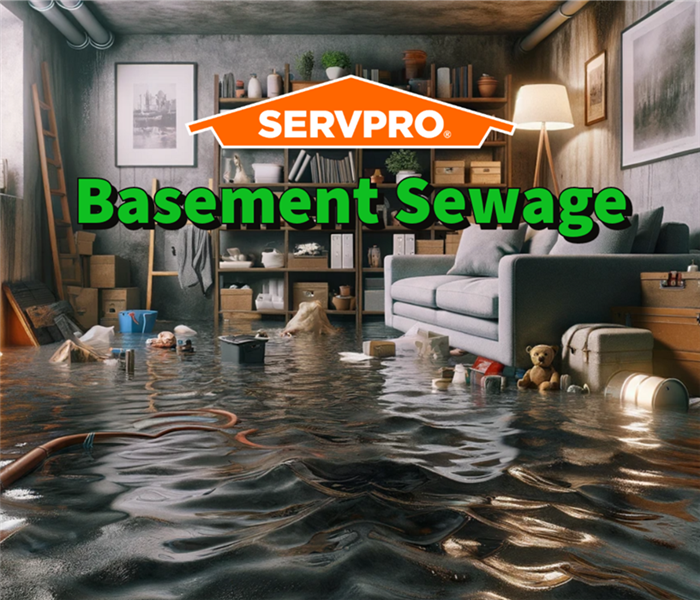 SERVPRO professionals are prepared to combat the most severe basement sewage damage job!
SERVPRO professionals are prepared to combat the most severe basement sewage damage job!
Learn how to get your property back in top shape after a basement sewage leak interrupts your life.
Welcome to the SERVPRO® hub of property wisdom, where we delve into the intricacies of restoration. This comprehensive guide addresses a pressing concern that can send shivers down any homeowner's spine—basement sewage damage. Join us as we explore the seven compelling reasons why choosing SERVPRO's water damage professionals is essential when your basement becomes a battleground for sewage woes. Embark on a journey through a real-life scenario in Georgia, where our SERVPRO team leaped into action to rescue properties from the clutches of basement sewage damage and witness the meticulous restoration that ensued.
Why is raw sewage coming up in my basement?
The dreadful sight of raw sewage seeping into your basement can be a nightmare. There are different reasons why this can happen. Understanding the root causes is essential. In Georgia, a property recently grappled with basement sewage damage due to a blockage in the sewer line—the distressing situation called for immediate action.
What causes sewage to back up in the basement?
Sewage backup in the basement can occur due to various factors, including clogged sewer lines, tree root intrusion, or heavy rainfall overwhelming the system. In Georgia, the property owner faced this predicament when torrential rains overloaded the sewage system, causing a backup that flooded the basement.
Swift response to sewage emergencies
One of the primary benefits of choosing SERVPRO for basement sewage cleanup is our rapid response. In the Georgia scenario, our team arrived promptly to assess the situation. This swift action prevented further contamination and minimized the potential for long-term damage.
Expert assessment and safety measures
Our experts thoroughly assessed the basement sewage damage in the Georgia property. Safety is paramount, and we implemented appropriate measures to protect both our team and the property's occupants from health hazards associated with sewage backup.
Proper cleanup and decontamination
Basement sewage damage requires more than just the removal of visible waste. Our SERVPRO team employed specialized equipment and techniques to thoroughly clean and decontaminate the affected area. We left no corner untouched, ensuring the property was safe and habitable again.
Comprehensive restoration
Choosing SERVPRO for basement sewage damage means opting for a comprehensive restoration. Beyond cleanup, we handled repairs and reconstruction as needed. In Georgia, we eliminated the sewage damage. We restored the basement to its pre-damage condition, ensuring the property owner's peace of mind.
Preventing future sewage mishaps
We went the extra mile in Georgia by addressing the root causes of the sewage backup, ensuring that future incidents were less likely to occur. Our preventive measures included sewer line inspections and recommendations for maintenance.
Scenario in Georgia:
Amid the serene landscape of Georgia, a homeowner faced a dire situation as sewage backup flooded their basement. Heavy rainfall had overwhelmed the local sewer system, causing raw sewage to seep into the property. Recognizing the urgency, the homeowner contacted SERVPRO for assistance.
Our team, well-versed in swift response to sewage emergencies, arrived promptly. We comprehensively assessed the basement sewage damage, prioritizing safety measures to protect our team and the property's occupants from potential health hazards. With meticulous attention to detail, we undertook the cleanup and decontamination process, ensuring no sewage trace remained.
Beyond the cleanup, we embraced the challenge of comprehensive restoration. Repairs and reconstruction were performed to return the basement to its pre-damage condition. In this instance, the homeowner was relieved to see their basement transformed from a sewage-stricken space back into a clean, functional area.
Our commitment to excellence extended to preventive measures. We addressed the root causes of the sewage backup, recommending sewer line inspections and maintenance to reduce the risk of future mishaps. The homeowner was relieved and empowered with the knowledge to safeguard their property against future sewage woes.
Call SERVPRO
Basement sewage damage is a homeowner's worst nightmare. Still, SERVPRO is the beacon of hope in the face of such adversity. Our rapid response, expert assessment, safety measures, and thorough cleanup and decontamination make us the ideal choice for restoring your basement. We go beyond the cleanup, offering comprehensive restoration services that ensure your property is returned to its pre-damage condition.
By choosing SERVPRO, you're addressing the immediate issue and preventing future sewage mishaps through our preventive measures and recommendations. Don't let basement sewage damage overwhelm you. Trust SERVPRO to handle the challenges while you focus on regaining the comfort and functionality of your basement. Our track record speaks for itself—when it comes to basement sewage cleanup, SERVPRO stands as the epitome of efficiency and expertise, ready to restore your peace of mind.
Office Water Damage: #1 Guide for Navigating Severe Damage
12/25/2023 (Permalink)
 SERVPRO professionals are on-call ready to help you combat office water damage!
SERVPRO professionals are on-call ready to help you combat office water damage!
Navigating the complexities of office water damage requires a blend of keen awareness, prompt action, and expert intervention.
Water damage in a commercial setting can be a formidable adversary, capable of disrupting operations and causing significant financial strain. Particularly in office environments, water damage can arise from various sources and manifest in multiple forms.
This extensive guide explores the multifaceted nature of office water damage, delving into its signs, causes, prevention, and recovery. Furthermore, we will illustrate how SERVPRO®, a leader in property restoration services, stands as your steadfast ally in addressing and recovering from such incidents.
The telltale signs of office water damage
Understanding the early signs of office water damage is fundamental in mitigating its impact. Look for subtle cues like musty odors, peeling paint, or swollen woodwork. Look for damp carpets, rusting metal fixtures, and electrical issues, which could all indicate underlying office water damage. Prompt recognition of these signs is crucial to prevent long-term structural damage and costly repairs.
Unraveling the common causes of office water damage
Office water damage can have a variety of origins, each requiring careful attention and preventive measures. Common causes include:
- Plumbing issues: Leaks from aging or faulty pipes, dripping faucets, or malfunctioning appliances like water heaters.
- Roof leaks: Deteriorated shingles or improper sealing, particularly in older buildings.
- HVAC problems: Condensation or leaks from air conditioning units.
- Natural disasters: Floods, heavy rains, or snow melts leading to water intrusion.
- Foundation seepage: Water enters through cracks or gaps in the building's foundation.
- Human error: Situations like overflowing sinks or accidental sprinkler activations.
Proactive strategies to prevent office water damage
Proactive and preventive measures are crucial to avert potential water damage in office settings. Consider implementing the following strategies:
- Regular inspections: Schedule routine checks of plumbing, roofing, and HVAC systems for signs of wear or leaks.
- Water detection devices: Install sensors in critical areas to alert you to the presence of water.
- Employee education: Train staff to recognize and report early signs of water damage.
- Emergency response plan: Develop a clear action plan for handling water intrusion incidents.
- Good housekeeping: Ensure gutters and drains are clear of debris to prevent water accumulation.
- Building upgrades: Consider waterproofing basements and upgrading old pipes and roof materials.
- Landscaping adjustments: Modify the surrounding landscape to divert water from the building foundation.
Our comprehensive approach to office water damage
SERVPRO's approach to office water damage encompasses a full spectrum of services. From initial damage assessment to water extraction, dehumidification, mold remediation, and structural repairs, our team leverages state-of-the-art technology and proven methodologies. We focus on minimizing downtime and restoring your office environment to its pre-damage condition quickly and precisely.
Opting for SERVPRO for your office water damage repairs is a decision for unrivaled professionalism and efficiency. Our rapid response team, available 24/7, is prepared to tackle emergencies at a moment's notice. With our expertise in handling complex water damage scenarios, we assure a restoration process that is thorough, reliable, and tailored to your specific needs.
In a critical Blue Ridge, Georgia situation, a commercial property faced severe office water damage due to a ruptured water heater. The SERVPRO team was on site within hours, deploying advanced water extraction tools and air movers. We meticulously salvaged essential documents and electronics, and our rapid mold prevention measures safeguarded the property from further damage. Our concerted efforts brought the office back to a safe and operational state, highlighting our commitment to excellence in crisis management.
Final thoughts
Confronting office water damage requires more than a quick fix; it demands expertise, foresight, and a dedicated partner. SERVPRO stands as that partner, offering a blend of advanced techniques, swift action, and customer-centric services. By choosing us, you entrust your property to skilled hands capable of restoring normalcy and ensuring the longevity of your office space.
Remember, immediate and expert response is critical in the face of office water damage, and SERVPRO is always ready to rise to the occasion.
Winter Fire Damage: 5 Critical Tips For Your Property
11/27/2023 (Permalink)
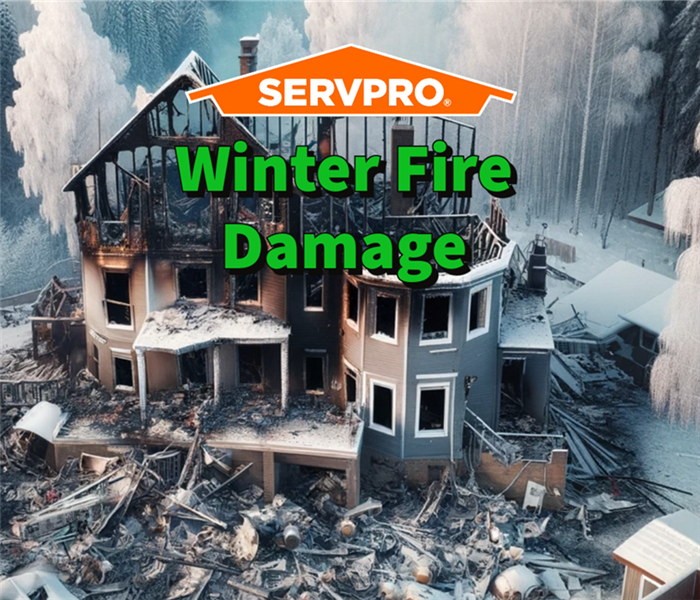 The professionals at SERVPRO are ready to help you combat winter fire damage!
The professionals at SERVPRO are ready to help you combat winter fire damage!
Navigate winter fire damage like the pros.
Winter brings not only a drop in temperature but also a rise in the risks associated with fire damage. This article aims to illuminate the complexities of winter fire damage, guiding you through its causes, prevention methods, and effective recovery solutions. Highlighting the SERVPRO® expertise, we provide an in-depth look at how to best protect and restore your property in the face of these seasonal hazards.
What is winter fire damage?
Winter fire damage encompasses the destruction caused by fires during the colder months in Blue Ridge. It's a unique subset of fire damage with distinct causes and consequences. The combination of dry indoor air, extensive use of heating appliances, and holiday festivities can increase the likelihood and severity of fire incidents.
What are the common causes?
Understanding the common causes of winter fire damage is critical to preventing them, as various everyday elements can turn into potential hazards during the colder months. The following are some of the most prevalent factors contributing to fire incidents:
- Heating equipment: Central heating systems, space heaters, and fireplaces, if not properly maintained, can become significant fire hazards. Regular inspection and maintenance are crucial.
- Electrical overloads: Winter demands more from electrical systems, whether for lighting or heating. Faulty wiring or overloaded circuits can quickly spark a fire.
- Cooking and kitchen mishaps: The winter season sees more indoor cooking and holiday feasts, leading to a heightened risk of kitchen fires.
- Candles and decorative lighting: While adding to the festive ambiance, these can be dangerous fire sources if not monitored.
- Neglected chimneys and flues: Chimneys can accumulate dangerous levels of creosote, a highly combustible residue, without regular cleaning.
Tips to prevent winter fire damage
- Regular maintenance of heating systems: Have your heating system, including fireplaces and chimneys, professionally inspected and cleaned before the winter season.
- Safe electrical practices: Ensure your home's electrical system can handle additional winter loads. Use surge protectors and avoid overloading outlets.
- Kitchen safety measures: Always monitor cooking appliances, keep flammable materials away from heat sources, and educate your family about kitchen fire safety.
- Responsible use of candles and lights: Keep candles away from flammable materials and never leave them unattended. Use LED lights for decorations, which are cooler and less risky.
- Annual chimney inspections: Get your chimney cleaned and inspected annually to prevent creosote buildup and chimney fires.
A recent response to winter fire damage
In Blue Ridge, Georgia, SERVPRO was called to a home with severe winter fire damage due to an overloaded electrical circuit. Our team's immediate response included a thorough assessment of the damage, followed by a structured recovery plan. We employed advanced technology—such as thermal foggers and air scrubbers—to address smoke damage and air quality. Our technicians meticulously repaired structural damage, replaced damaged materials, and used specialized cleaning techniques to restore the home's interior.
The SERVPRO team's swift and strategic actions salvaged the property and minimized the disruption to the homeowners' lives.
Why opt for SERVPRO in winter fire damage situations?
Choosing SERVPRO for fire damage restoration means relying on a team equipped with cutting-edge technology and extensive experience. We offer:
- Rapid response: Our 24/7 availability ensures immediate action, which is crucial in mitigating further damage.
- Advanced technology: We utilize the latest fire restoration technology, from thermal imaging to identifying hidden damage to state-of-the-art cleaning and deodorizing equipment.
- Expertise and training: Our professionals are highly trained in fire damage restoration, ensuring the most effective and efficient recovery process.
- Comprehensive services: From initial damage assessment to the final restoration, we handle all aspects of recovery, ensuring a seamless process for our clients.
- Compassionate customer service: Understanding the emotional toll of fire damage, we approach each situation with sensitivity and care, ensuring your peace of mind throughout recovery.
Wrapping up
With its distinct causes and consequences, winter fire damage requires a specialized approach for effective management and recovery. You can significantly reduce the risks through preventative measures and the readiness to respond in case of an incident.
In the event of fire damage, SERVPRO is your trusted ally, offering unparalleled expertise, technology, and compassionate service to restore your property to its pre-fire condition. With SERVPRO, you're not just repairing damage but reclaiming your peace of mind and security, making it "Like it never even happened."
5 Essential Storm Protection Tips For Property Owners
10/30/2023 (Permalink)
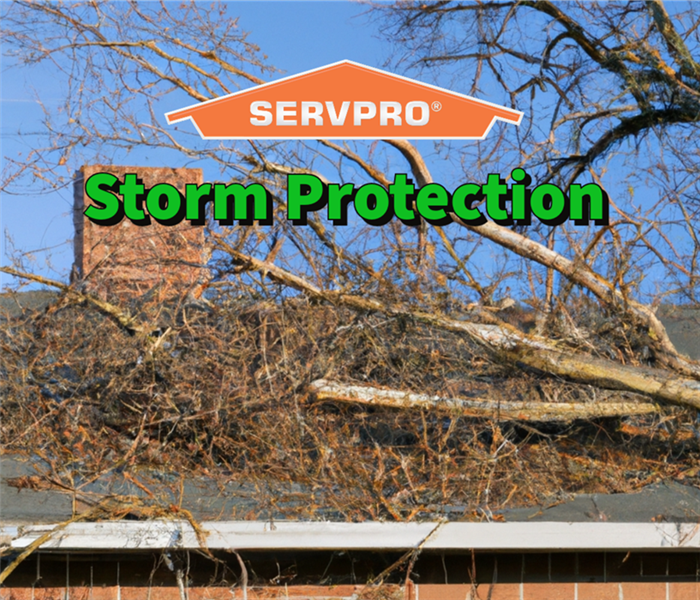 SERVPRO offers prompt, reliable, and professional storm restoration services.
SERVPRO offers prompt, reliable, and professional storm restoration services.
Learn how to shield your Blue Ridge property with our superior storm protection tips.
Storms are nature's most theatrical performances, but the aftermath can be devastating when their intensity targets our homes. With its scenic views and tranquil environment, Blue Ridge, Georgia, isn't immune to these natural events. As residents, equipping ourselves with essential storm protection knowledge safeguards our property and brings peace of mind.
With this in mind, let's delve into the importance of storm protection and why SERVPRO® should be your first call when the storm has passed!
What are the common types of storms in Blue Ridge?
Blue Ridge experiences a range of climatic disturbances, from heavy rainfalls and thunderstorms to occasional snowstorms in the colder months. While the weather is generally pleasant, these sporadic yet intense weather events call for proactive storm protection measures. By understanding the types of storms in Blue Ridge you're likely to face, you can better prepare for them.
How can homeowners prevent storm damage to their property?
Forewarned is forearmed. Here are five essential storm protection tips that can help you minimize potential damage:
- Secure outdoor items: Loose items like garden tools, furniture, and decorative items can become potential projectiles during strong winds. Ensure they are stored safely or anchored correctly.
- Inspect and repair your roof: Regularly check for missing or loose shingles. A strong gust can exploit weaknesses, leading to leaks or more severe roof damage.
- Clean gutters and drains: A blocked drainage system can lead to water accumulation and possible flooding. Ensure they are free of debris, especially during a storm warning.
- Install storm shutters: Especially for properties prone to severe weather, storm shutters can shield your windows from breaking due to flying debris.
- Trim trees and large plants: Overhanging branches or weak trees can fall on your property. Regular trimming and removal of vulnerable trees can prevent potential damage.
Why is it crucial to call professionals post-storm, even if the damage isn't visible?
Let's look at a recent scenario. A homeowner in Blue Ridge believed they had weathered a particularly nasty storm without any damage. To the naked eye, their property seemed fine. However, small leaks had formed in the attic, and the basement showed subtle signs of water infiltration. Left unchecked, this could lead to mold growth and structural issues.
Enter SERVPRO. The homeowner, realizing the potential problems, called our team. Our trained storm damage professionals swiftly identified and rectified the hidden damage, saving the property from longer-term issues and potentially higher repair costs.
This instance serves as a poignant reminder: just because storm damage isn't immediately visible doesn't mean it's not there.
What makes SERVPRO the ideal choice for storm damage repairs?
When faced with storm aftermath, you need a team that understands the intricacies of damage repair and offers prompt, reliable, and professional service. Here's why SERVPRO fits the bill:
- Swift response: Time is of the essence post-storm. SERVPRO ensures quick damage assessments and timely repairs, reducing the risk of further damage.
- Highly trained professionals: Our team is well-versed with advanced techniques to handle storm damage of any scale. Our expertise ensures that the job gets done right.
- Advanced equipment: We employ state-of-the-art equipment for thorough cleanup, drying, and restoration.
- Trust and reliability: With a reputation built over the years, SERVPRO is a trusted name in the industry. Our commitment is to restore your property to its pre-storm condition.
- Holistic approach: From water extraction and mold remediation to complete restoration, SERVPRO provides comprehensive solutions.
Conclusion
Storm protection isn't just about preparing for the event; it's about having a reliable partner to turn to when the skies clear. Blue Ridge, with its diverse weather patterns, demands a proactive approach. Homeowners can significantly reduce the risks associated with severe weather events through our outlined storm protection tips.
However, when the storm passes, and you're faced with the aftermath, know that SERVPRO is just a call away. Our prompt response, expert teams, and unwavering commitment ensure your property returns to its pristine condition. Remember, with SERVPRO by your side, you're never alone against the storm.
Hardwood Flooring: 5 Simple Benefits to Choosing Hardwood
9/25/2023 (Permalink)
 SERVPRO can help restore and install new hardwood flooring!
SERVPRO can help restore and install new hardwood flooring!
Installing hardwood flooring is a craft of its own.
When you invest in classic and timeless hardwood flooring, deciding whom to trust with the installation can be daunting. As more homeowners shift towards this luxurious flooring, they want assurance that their installation is in expert hands. Enter SERVPRO®—a brand synonymous with superior service and quality.
As we dive deeper into the details of hardwood flooring and its myriad benefits, you'll discover the compelling reasons why SERVPRO should be your preferred choice for hardwood flooring installation services.
What are the different styles of hardwood flooring?
There are several options available for hardwood flooring, each promising to transform the aesthetic of your home. Whether you're looking for traditional oak, exotic teak, or modern bamboo, there's a hardwood style tailored to your design preferences. The range of finishes, from matte to glossy, further accentuates the versatility of hardwood flooring. When partnering with SERVPRO, our experts guide you through the selection process, ensuring you land on a style that complements your home and aligns with your vision.
What are the pros and cons of hardwood flooring?
Pros:
- Durability: Hardwood floors can last generations if properly maintained.
- Value: Homes with hardwood flooring often command higher resale values.
- Hygiene: Hardwood doesn't trap dust, pollen, or other allergens, making it a healthier option.
- Versatility: It can be sanded and refinished multiple times, offering a fresh look each time.
Cons:
- Cost: Initial installation can be more expensive than other flooring types.
- Maintenance: Requires consistent cleaning and occasional refinishing to prevent damage and maintain its look.
The beauty of choosing SERVPRO is that we mitigate the cons through our expert installation and advice on long-term care.
A true story: Why did a property in Blue Ridge, Georgia, turn to SERVPRO?
Earlier this year, a quaint home in Blue Ridge, Georgia, suffered significant water damage. The once-pristine hardwood flooring was left warped and discolored, transforming the homeowner's dream home into a nightmare.
In their time of need, the homeowners turned to SERVPRO, having heard of our reputation for tackling even the most challenging water damage scenarios. Our team arrived promptly, assessed the damage, and presented a comprehensive plan for restoring their home to its former glory. Not only did we address the immediate water damage, but we also laid down new hardwood flooring, ensuring each plank was perfectly aligned and secure. The homeowners were left with a more beautiful floor than before the disaster.
What steps does SERVPRO take when handling a hardwood flooring job?
Our process is meticulously designed for perfection. It begins with:
- Consultation: Understanding the homeowner's requirements and vision.
- Site assessment: Checking for issues like moisture, which can impact the longevity of the hardwood flooring.
- Selection: Guiding homeowners through the diverse world of hardwood options.
- Preparation: Ensuring the subfloor is clean, dry, and level.
- Installation: Laying down the flooring with precision and care.
- Finishing: Applying sealants or finishes as required, providing that final touch of elegance.
- Aftercare advice: Offering tips and guidance on maintaining the newly installed flooring.
What makes SERVPRO the best choice for new hardwood flooring?
- Experience: With years in the business, our team has honed their skills, making them experts in hardwood flooring installation.
- State-of-the-art equipment: From moisture meters to cutting-edge installation tools, we use the best to ensure optimal results.
- Customer service: Our relationship with homeowners continues after installation. We provide ongoing support and advice on maintaining the pristine condition of the flooring.
- Fast response time: Especially in cases of water damage, we understand the urgency and are on-site in the shortest time possible.
- Comprehensive Services: Beyond installation, we offer services that cater to all hardwood flooring needs.
Wrapping up
Choosing hardwood flooring is a significant investment that promises to elevate the aesthetics and value of your home. However, the installation process is just as crucial as the flooring type itself, and this is where SERVPRO shines. With our unparalleled experience, commitment to excellence, and holistic approach, homeowners can rest assured that their flooring is in the best hands.
The choice is clear from the heartwarming story of restoration in Blue Ridge, Georgia, to the intricate details of hardwood styles, the benefits, and the unmatched services SERVPRO offers. When considering hardwood flooring installation, consider SERVPRO because your home deserves the best. Contact us today for superb hardwood flooring installation services!
5 Devastating Damage Types an HVAC Leak Can Cause
8/28/2023 (Permalink)
 24/7 HVAC leak warriors! When drips strike, we're ready to restore!
24/7 HVAC leak warriors! When drips strike, we're ready to restore!
Water restoration professionals receive numerous calls a year after damages caused by an HVAC leak.
As property owners, we invest substantial time and effort in maintaining the comfort and safety of our homes. However, unforeseen calamities can strike even the most prepared homeowners. One such stealthy adversary is an HVAC leak—a catastrophe that can silently wreak havoc on your property while you're away. This blog post delves into the dire damages that can be caused by an HVAC leak, recounting a recent incident in Blue Ridge where the SERVPRO® team emerged as the knights in shining armor. With valuable insights on HVAC leak detection and prevention combined with the unparalleled water restoration services SERVPRO offers, we empower you to safeguard your sanctuary effectively.
What are common signs of an HVAC leak?
Early detection of an HVAC leak can save you from a cascade of destruction. Common indicators include unusually high energy bills, poor indoor air quality, uneven cooling or heating, and visible moisture or puddles near the HVAC system. These red flags might seem minor, but ignoring them can lead to colossal consequences.
What are the leading causes of HVAC leaks?
Understanding the root causes of HVAC leaks is pivotal in prevention. Factors like corroded drain pans, clogged condensate lines, frozen evaporator coils, or improper installation can all contribute to leaks. Regular maintenance and professional inspections can nip these issues in the bud.
Recent scenario: a vacation went awry in Blue Ridge
As the gentle breeze of spring swept through Blue Ridge earlier this year, a property owner embarked on a long-awaited vacation. Unbeknownst to them, a sinister HVAC leak was brewing in their absence. The leak originated from a malfunctioning condensate line, steadily saturating their property. When the homeowners returned, the damage was palpable—warped floorboards, sagging ceilings, and mold creeping across walls. Panicked and overwhelmed, they turned to the experts at SERVPRO for our industry-leading water damage restoration services.
5 damages caused by an HVAC Leak
An HVAC leak may start as a minor nuisance, but its ramifications can be catastrophic:
- Structural compromise: Water intrusion weakens structural components, causing the wood to warp, plaster to crack, and weakening the foundation over time.
- Mold infestation: Dampness breeds mold, endangering inhabitants' health and necessitating extensive remediation.
- Electrical hazards: Water and electricity don't mix. Leaks can trigger short circuits, causing fires and endangering lives.
- Decreased indoor air quality: Lingering moisture fosters the growth of allergens, compromising the air quality.
- Financial toll: The monetary burden of repairs, increased energy bills, and potential insurance claims can be overwhelming.
Why SERVPRO reigns supreme in water restoration
When disaster strikes, choosing the right restoration partner is paramount. SERVPRO stands as a beacon of reliability and expertise:
- Immediate response: SERVPRO understands the urgency of water damage. Our 24/7 emergency service ensures a swift reaction, minimizing further destruction.
- Advanced equipment: With cutting-edge technology, SERVPRO mitigates water damage efficiently, promoting rapid drying and preventing secondary issues like mold growth.
- Expertise and experience: With decades of experience, SERVPRO's technicians possess unparalleled knowledge of water restoration techniques.
- Comprehensive solutions: From water extraction and drying to thorough cleaning and restoration, SERVPRO offers an all-encompassing solution.
- Insurance coordination: Dealing with insurance can be daunting. SERVPRO simplifies the process, aiding in claims and documentation.
- Preventive measures: Beyond restoration, SERVPRO provides insights into preventing future HVAC leaks.
Wrapping up
An HVAC leak can plunge your haven into disarray, leaving destruction in its wake. The incident in Blue Ridge serves as a poignant reminder of this peril. Swift action is imperative to protecting your property, and SERVPRO is your sanctuary's ultimate guardian. Armed with expertise, cutting-edge technology, and an unwavering commitment to restoration, SERVPRO is your ally in thwarting the havoc an HVAC leak can unleash. Choose SERVPRO as your first line of defense against water-related disasters.
Conquer Motel Water Damage: Beware of these 4 Causes
7/31/2023 (Permalink)
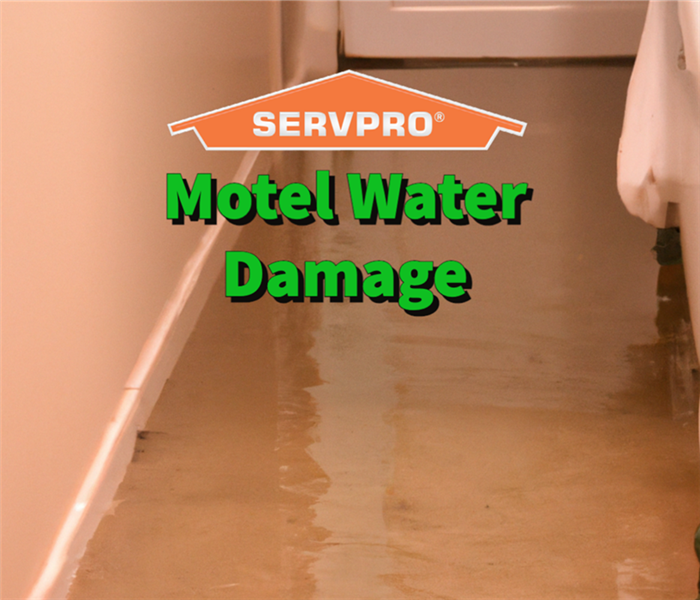 The professionals at SERVPRO are available 24/7 to help combat motel water damage!
The professionals at SERVPRO are available 24/7 to help combat motel water damage!
Water damage can shut down a motel for possibly months.
Water damage can wreak havoc on any property, and motels are no exception. In the serene town of Blue Ridge, nestled amidst breathtaking landscapes, a local motel recently experienced a devastating flood caused by a pipe burst. This unforeseen disaster left the motel owners grappling with the aftermath, highlighting the need for a reliable and efficient commercial restoration service.
In this blog post, we will explore the common causes of motel water damage and shed light on why choosing SERVPRO® for all your commercial restoration needs is a prudent decision. Let's delve into the world of water damage and discover the power of SERVPRO.
What is motel water damage?
Water damage is a term that encompasses various forms of harm caused to a property due to the presence of excess water. In the context of motels, water damage can arise from numerous sources, including plumbing system failures, natural disasters, faulty appliances, and human error. When water infiltrates the structural integrity of a motel, it can lead to costly repairs, compromised guest experience, and significant business interruptions.
4 common causes of motel water damage
- Pipe bursts: aging or poorly maintained plumbing systems can succumb to the pressure over time, resulting in breaks that can release a deluge of water into the motel premises. The destructive power of a pipe burst is immense, often causing extensive damage to walls, ceilings, and valuable belongings.
- Roof leaks: motels with flat roofs are susceptible to leaks, especially during heavy rains or snowstorms. A compromised roof can allow water to seep through, leading to damaged ceilings, electrical systems, and potential mold growth if left unaddressed.
- HVAC malfunctions: heating, ventilation, and air conditioning (HVAC) systems play a vital role in maintaining a comfortable environment for motel guests. However, if not properly maintained, these systems can cause water damage. Condensate line clogs or leaks, faulty drain pans, or malfunctioning components can result in water seeping into walls, carpets, and other areas of the motel.
- Faulty appliances: motels rely on various devices such as washing machines, dishwashers, and water heaters to provide essential services to their guests. Unfortunately, when these appliances malfunction or experience leaks, they can quickly escalate into substantial motel water damage incidents, potentially affecting multiple rooms or entire floors.
Your trusted partner in commercial restoration
Choosing the right professional service is crucial when facing the daunting task of motel water damage restoration. SERVPRO has established itself as a trusted industry leader, offering a comprehensive range of commercial restoration services catering to motels and hospitality businesses.
Here's why SERVPRO should be your go-to choice:
- Prompt response: time is of the essence when dealing with water damage, especially in a commercial setting like a motel. SERVPRO understands the urgency and responds quickly to your call, arriving on-site promptly to assess the situation and initiate the restoration process without delay.
- Expertise and experience: with decades of experience in the restoration industry, SERVPRO professionals possess the knowledge, skills, and training to tackle even the most challenging motel water damage scenarios. They leverage the latest equipment and techniques to mitigate damage, restore affected areas, and prevent future issues.
- Tailored solutions: every motel water damage situation is unique, necessitating a personalized approach. SERVPRO recognizes this and tailors their restoration strategies to suit your needs, ensuring minimal disruption to your operations and a swift return to normalcy.
- Comprehensive services: SERVPRO offers a complete suite of services, encompassing water extraction, drying and dehumidification, mold remediation, carpet and upholstery cleaning, structural repairs, and more. By relying on a single provider for all your restoration needs, you can streamline the process and enjoy a hassle-free experience.
Wrapping up
When water damage strikes your motel, SERVPRO is a reliable water restoration partner committed to restoring your business and protecting your guests' well-being. The recent flooding incident in Blue Ridge serves as a reminder of the devastating consequences of motel water damage and emphasizes the importance of choosing a trusted professional restoration service.
With our prompt response, expertise, tailored solutions, and comprehensive services, SERVPRO ensures that your motel recovers swiftly, allowing you to focus on delivering exceptional hospitality experiences. Don't let water damage dampen your business—let SERVPRO be your guiding light in the face of adversity.
Soot Residue: Helpful Advice From the Unrivaled #1 Team
6/26/2023 (Permalink)
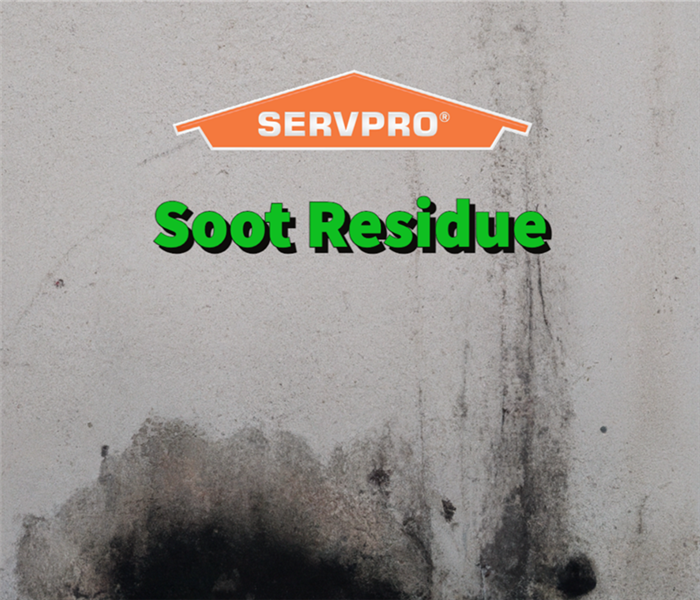 The professionals at SERVPRO are available 24/7 to help tackle soot residue!
The professionals at SERVPRO are available 24/7 to help tackle soot residue!
SERVPRO can tackle soot residue head-on and deliver unmatched results.
When disaster strikes and flames engulf your property, the aftermath can be overwhelming. Beyond the visible damage lies a hidden enemy: soot residue. Soot residue can wreak havoc on your property, compromising its structural integrity and posing severe risks.
This blog post will explore the causes and consequences of soot residue, providing valuable insights on prevention and the critical role SERVPRO plays in effective soot cleaning and fire restoration. Discover why SERVPRO is the unrivaled choice when tackling soot-related challenges head-on.
What is soot residue?
When a fire ravages a building, soot residue becomes an unwelcome intruder. Composed of fine black particles, soot residue is a byproduct of incomplete combustion, originating from burning organic matter such as wood, coal, oil, or gas. These microscopic particles can travel through the air, settling on various surfaces within your property, penetrating porous materials, and causing long-lasting damage if not addressed promptly.
Soot residue, often mistaken for superficial dirt or dust, is more insidious than it appears. Over time, its acidic nature can corrode metals, tarnish delicate surfaces, and weaken structural components, compromising the stability and safety of your property.
What are the long-term effects of soot residue on a property?
The long-term effects of soot residue on a property can be significant and far-reaching. If left untreated, soot residue can gradually deteriorate various surfaces and materials within the property. The acidic nature of soot particles can corrode metals, leading to structural damage and weakening the integrity of the building. Delicate surfaces, such as walls, ceilings, and furniture, can become discolored, stained, or permanently damaged due to the abrasive nature of soot. Additionally, soot residue can penetrate porous materials like upholstery, carpets, and curtains, making removing it challenging and potentially causing lingering odors.
Over time, soot residue can compromise indoor air quality, triggering respiratory issues and exacerbating allergies or asthma. Therefore, it is crucial to address soot residue promptly and thoroughly to prevent long-term damage and maintain a safe and healthy living environment.
Preventing soot residue
- Regular maintenance and inspections: a proactive property maintenance approach can help prevent soot residue buildup. Regularly inspecting and cleaning fireplaces, chimneys, and HVAC systems and ensuring proper ventilation can reduce the risk of fires and associated soot-related issues.
- Fire safety measures: prevention is always better than restoration. Equipping your property with smoke detectors, fire extinguishers, and a well-maintained sprinkler system can minimize the likelihood of fire incidents and subsequent soot residue accumulation.
Does insurance cover soot residue cleaning and restoration?
The coverage for soot residue cleaning and restoration can vary depending on the specifics of your insurance policy. Standard homeowner's insurance policies often include fire damage coverage, typically extending to soot residue cleaning and restoration.
However, it is essential to review your policy and consult with your insurance provider to understand the extent of coverage and any applicable deductibles or limitations. Some policies may have specific provisions for soot-related damages, while others require additional endorsements or riders for comprehensive coverage. Documenting the damage, including photographs and detailed inventory, can facilitate the insurance claim process.
Professional restoration companies like SERVPRO often work closely with insurance providers. They can assist in navigating the claims process, ensuring you receive the appropriate coverage for soot residue cleaning and restoration expenses.
The SERVPRO difference: expert soot cleaning and fire restoration
- Extensive experience: SERVPRO, with decades of experience in the restoration industry, has encountered countless soot-related challenges. Our highly trained technicians deeply understand the complex nature of soot residue, enabling us to employ the most effective techniques and equipment for optimal cleaning and restoration results.
- Cutting-edge technology: SERVPRO continuously invests in state-of-the-art technology to provide unparalleled soot cleaning and fire restoration services. Our advanced equipment, such as high-efficiency particulate air (HEPA) vacuums and specialized cleaning agents, ensures the thorough elimination of soot residue, leaving your property cleaner and safer than ever.
- Comprehensive approach: when you choose SERVPRO, you're not just hiring a cleaning service—you're gaining a trusted partner dedicated to restoring your property to its pre-fire condition. We employ a comprehensive approach, addressing visible soot residue, hidden damage, and potential safety hazards, delivering an extensive restoration experience.
- Rapid response and 24/7 availability: time is of the essence when dealing with soot residue. That's why SERVPRO offers swift, round-the-clock emergency services. Our dedicated teams are on standby, ready to respond to your call at any hour, ensuring the restoration process begins promptly, minimizing further damage and disruption to your life.
Conclusion
Soot residue is a formidable opponent, capable of causing lasting damage to your property and endangering the health of its occupants. By choosing SERVPRO, you're selecting a seasoned industry leader equipped with the knowledge, technology, and unwavering commitment needed to combat the perils of soot residue head-on.
With an extensive track record of excellence and a comprehensive approach to restoration, SERVPRO stands as the trusted partner you need to restore your property to its pre-fire glory. Don't let soot residue cast a shadow over your life—reach out to SERVPRO today and let us unveil the brilliance hidden beneath the grime!
Asphalt Shingle Damage: Our #1 Guide to Protect Your Roof
5/29/2023 (Permalink)
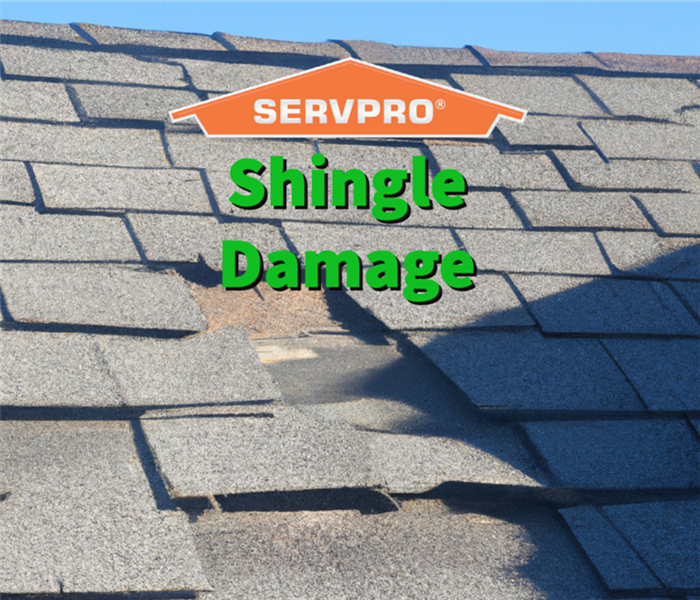 SERVPRO will ensure shingle damage doesn't compromise the safety and integrity of your home.
SERVPRO will ensure shingle damage doesn't compromise the safety and integrity of your home.
Understanding the common signs of asphalt shingle damage can help you avoid severe damage.
Few things are as crucial as a sturdy roof when safeguarding your home from the elements. Asphalt shingles are popular for homeowners, offering durability and aesthetic appeal. However, even the most robust shingles can fall victim to shingle damage caused by severe storms. Detecting signs of asphalt shingle damage early on is vital to preventing further issues, such as leaks and structural compromises.
In this blog post, we will explore the common signs of shingle damage and how the professionals at SERVPRO can come to your aid when shingle damage occurs. So don't let your home's first line of defense crumble—take action with SERVPRO of Union, Towns, Fannin & Gilmer Counties today!
The telltale signs of asphalt shingle damage
There are two main signs of asphalt shingle damage:
- Curling and clawing shingles
- Missing shingles
Curling and clawing shingles
One of the most visible signs of shingle damage is curling or clawing. When shingles start to curl, they become vulnerable to water infiltration and are more likely to be blown off during high winds. Conversely, clawing occurs when the edges of the shingles remain flat, but the middle starts to rise. Both of these conditions are indications of shingle wear and require immediate attention.
Missing shingles
Storms with strong winds can cause shingles to become dislodged or completely blown off, leaving your roof vulnerable to water damage and compromising its ability to protect your home. Inspecting your roof after a storm and checking for any missing shingles is essential in preventing further deterioration. If you notice any gaps or exposed areas, contact the professionals at SERVPRO for a thorough inspection and prompt repairs.
Your shingle damage solution
When storm damage strikes, time is of the essence. SERVPRO understands the urgency and the need for swift action. Upon contacting them, our team of experienced professionals will promptly respond to your call, equipped with the necessary tools and expertise to assess the extent of the damage. Then, using advanced techniques and state-of-the-art equipment, we will thoroughly inspect your roof for signs of shingle damage, ensuring no underlying issues go unnoticed.
After a thorough assessment, SERVPRO's highly skilled technicians will devise a customized plan to restore your asphalt shingles to their former glory. Whether repairing a few damaged shingles or replacing the entire roof, we will work diligently to provide a comprehensive solution tailored to your needs. In addition, with our expertise in storm damage, you can trust that we can help protect your home against future weather events. For example: reinforcing vulnerable areas, such as the edges and corners of shingles, can increase their resistance to wind uplift. Using innovative techniques and quality materials, SERVPRO ensures your roof is fortified against the harshest elements nature can unleash.
Why choose SERVPRO services for your shingle damage
SERVPRO takes pride in our team of skilled technicians with extensive knowledge of handling storm damage and asphalt shingle repairs. Our storm damage professionals undergo rigorous training and stay updated on the latest industry standards to ensure the highest level of service. With their attention to detail and commitment to excellence, you can have peace of mind knowing that your home is in capable hands.
We understand that dealing with shingle damage can be overwhelming, especially when navigating insurance claims. SERVPRO provides valuable assistance by working closely with insurance companies on your behalf. Their experienced team will document the damage, prepare detailed reports, and communicate directly with the insurance adjusters. This streamlined approach ensures a smooth and hassle-free claims process, allowing you to focus on restoring your home while leaving the paperwork to the experts.
Wrapping up
Your roof is your home's first line of defense, and asphalt shingles protect it from the elements. Identifying signs of shingle damage and taking prompt action can save you from extensive repairs and potential water damage. SERVPRO is your trusted partner in restoring and fortifying your asphalt shingles during storm damage. With our expertise, rapid response, and commitment to quality, we provide comprehensive solutions tailored to your specific needs.
Quality is always maintained at SERVPRO of Union, Towns, Fannin & Gilmer Counties. We utilize top-of-the-line materials and advanced equipment to deliver exceptional results. From durable replacement shingles to cutting-edge tools, every aspect of our service is designed to withstand the test of time and provide long-lasting protection for your home. Regarding asphalt shingle repairs, SERVPRO's commitment to quality ensures that you receive the best possible solution for your roofing needs.
Don't let shingle damage compromise the safety and integrity of your home. Instead, unleash the power of SERVPRO today and experience unparalleled service that keeps your roof strong and your peace of mind intact. Contact us today for 24/7 emergency services!
Best Custom Carpentry: Reclaim Your Space with The #1 Team
4/24/2023 (Permalink)
 Our team of experienced craftsmen can help make any custom carpentry project happen.
Our team of experienced craftsmen can help make any custom carpentry project happen.
The custom carpentry services provided by SERVPRO of Union, Towns, Fannin & Gilmer Counties are unmatched in the market.
When it comes to home improvement, many of us think of remodeling in terms of paint colors and furniture. But custom carpentry services can provide an invaluable addition to any space. From adding a unique touch to your living room to creating extra storage in your business office, the possibilities are endless when you choose SERVPRO's world-class custom carpentry solutions.
This article will discuss why custom carpentry is an excellent choice for homeowners or businesses looking for something special, what types of projects SERVPRO of Union, Towns, Fannin & Gilmer Counties can handle, and some tips on selecting a reliable service provider. So if you're ready to add value, beauty, and function to any space, let's begin!
What is custom carpentry in construction?
Custom carpentry is a specialized field of construction that involves creating unique and personalized woodwork for homes and businesses. These services go beyond traditional construction techniques, requiring expert craftsmanship and attention to detail. Custom carpentry solutions can range from designing and building furniture or cabinets to creating decorative trim, molding, and anything else you can imagine.
One of the main benefits of custom carpentry is the ability to transform a dull space into a unique and inviting one. For homes, custom carpentry can add character and charm to living areas and provide additional storage and functionality. Custom carpentry can help create a professional and polished look in businesses while adding much-needed storage and organization.
What to look for when selecting a reliable custom carpentry service provider?
When selecting a custom carpentry service provider, choosing one with a proven track record of delivering high-quality solutions is essential. In addition, look for a company with a portfolio of completed projects demonstrating their expertise and attention to detail. It's also necessary to select a provider that offers a range of services, as this will allow you to customize your project to your specific needs and budget. Finally, choose a licensed, insured provider with a strong reputation in the industry.
Why SERVPRO for custom carpentry?
SERVPRO of Union, Towns, Fannin & Gilmer Counties is a leader in the custom carpentry industry, offering world-class solutions for any project. The company's construction division has the expertise and experience to handle even the most complex custom carpentry projects, using only the highest quality materials and equipment. Whether a small-scale remodel or a large-scale renovation, SERVPRO's team of skilled craftsmen will work closely with clients to ensure their vision becomes a reality.
Our custom carpentry solutions include but are not limited to the following:
- Design and build furniture
- Custom trim and molding
- Cabinetry installation
- Deck and patio construction
- Window and door framing
- Wall paneling
- Staircases
At SERVPRO of Union, Towns, Fannin & Gilmer Counties, anything is possible regarding custom carpentry. So whether you're looking to add a touch of elegance to your home or create an unforgettable customer experience in your business, we have the tools and resources needed to make it happen.
Wrapping up
Today we discussed why custom carpentry is a valuable addition to any home or business, what types of projects SERVPRO of Union, Towns, Fannin & Gilmer Counties can handle, and tips on selecting a reliable service provider. Custom carpentry solutions offer endless possibilities for design and style, allowing homeowners and businesses to create unique spaces that reflect their tastes and needs.
SERVPRO of Union, Towns, Fannin & Gilmer Counties has the expertise and tools to provide world-class custom carpentry solutions tailored to each client's needs. So whether you're looking for an elegant touch for your home or a professional aesthetic for your business, our team of experienced craftsmen can help make it happen. Contact us today to get started!
Sump Pump Water Damage: 5 Practical Tips To Avoid Disaster
3/27/2023 (Permalink)
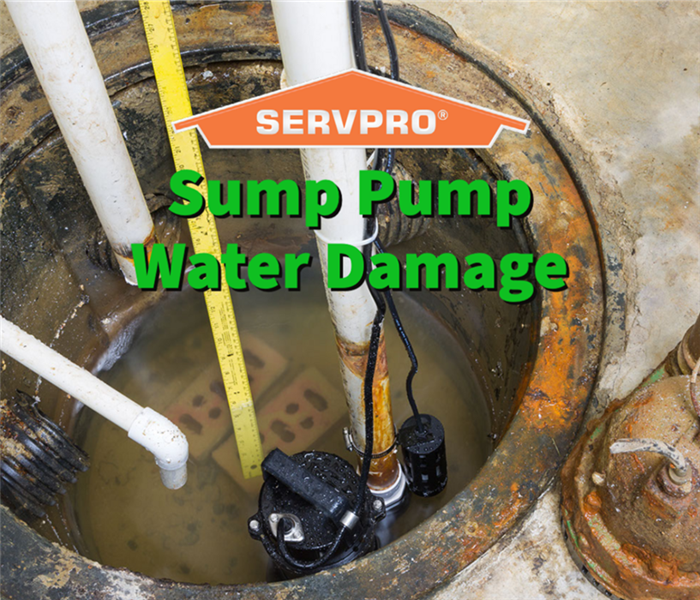 The professionals at SERVPRO are available 24/7 for sump pump water damage emergencies!
The professionals at SERVPRO are available 24/7 for sump pump water damage emergencies!
Water damage is a significant concern for homeowners, and sump pump failure can lead to extensive damage that can cost thousands of dollars.
A sump pump is a device that helps to keep the lowest level of a property dry by controlling basement flooding from rain or groundwater accumulation. Sump pumps are typically installed in sump pits and work by pumping water away from the sump pit, preventing flooding and limiting the potential for damage to the home.
Sump pumps are essential for at-risk homeowners, but unfortunately, these devices may be susceptible to failure or malfunction if not properly maintained.
The professionals at SERVPRO of Union, Towns, Fannin & Gilmer Counties are all too familiar with the impact that sump pump water damage can have on your home. To help you prevent sump pump issues, we’ve compiled five practical tips that maintain your pump in tip-top shape in the following blog post, letting you avoid costly damages!
What is sump pump water damage?
Sump pump water damage occurs when a property’s sump pump fails or malfunctions, resulting in basement flooding from rain or groundwater accumulation. Sump pump water damage can be extensive and costly to repair, requiring the replacement of damaged items throughout the home, including walls, floors, carpets, furniture, wiring, and appliances. In extreme cases, sump pump water damage can result in mold growth and structural damage.
5 tips for avoiding sump pump water damage
To avoid sump pump water damage, it’s essential to properly maintain sump pumps by regularly inspecting, testing, and replacing them as needed. Here are five tips for avoiding sump pump water damage:
- Test your sump pump at least once a year to ensure it is working correctly. When performing a sump pump test, you must fill the sump pit with water and ensure the pump activates correctly.
- Clear sump pits of debris and dirt to avoid clogging the sump pump.
- Set up a schedule for routine cleaning to maintain optimal performance.
- Install a sump pump alarm system to alert you if the sump pump fails or the sump pit is full of water. Many alarm systems can alert you through audible alarms, text messages, and emails.
- Check sump pump backup batteries regularly to ensure they work correctly and replace them as needed.
By following these tips, you can help protect your home from sump pump water damage and save money on costly repairs in the long run!
How can SERVPRO help?
Professionals at SERVPRO can help you with award-winning water damage repair and restoration services. Our highly trained technicians are equipped to respond quickly to sump pump water damage emergencies and provide comprehensive services to restore your home to its pre-damage condition. We have the experience and expertise to handle water damage of any size, from minor leaks to significant flooding.
Our water restoration services include:
- Extraction and water removal
- Drying, dehumidification, and humidity control
- Mold prevention and remediation
- Cleaning, sanitizing, and odor removal
- Repair/restoration of damaged property
SERVPRO of SERVPRO of Union, Towns, Fannin & Gilmer Counties is here to help with water damage repair and restoration services 24 hours a day, seven days a week.
Wrapping up
Today we reviewed sump pump water damage and five tips for pump maintenance that help prevent sump pump failure or malfunction. If your home has already suffered from sump pump water damage, the SERVPRO of SERVPRO of Union, Towns, Fannin & Gilmer Counties professionals can provide comprehensive water damage repair and restoration services. Our services are known to be the fastest and most reliable sump pump water damage services in the area. So don’t let sump pump water damage ruin your home or business; contact us today for help!
Hotel Water Damage: 5 Effective Prevention Tips
2/28/2023 (Permalink)
 The professionals at SERVPRO are readily available to handle any size commercial loss!
The professionals at SERVPRO are readily available to handle any size commercial loss!
Since hotel water damage can strike anytime, hotel owners should take steps to prevent it.
One of the responsibilities of a hotel owner or manager is protecting your hotel from water damage. Water damage can cause severe structural issues and health hazards; therefore, hoteliers must be aware of the potential risks. Fortunately, with the help of SERVPRO professionals, hotel owners can restore their property to its original condition after a water damage disaster.
This article will explore the common causes of hotel water damage and discuss how SERVPRO professionals restore commercial properties after a water disaster. We will also include tips to prevent hotel water damage. With these tips in mind, hotel owners can proactively avoid costly repairs and keep guests safe from hazardous conditions caused by water damage.
For hotel owners or managers suffering from water damage, act quickly to ensure your hotel is safe and secure. The water restoration professionals at SERVPRO of Union, Towns, Fannin & Gilmer Counties are available 24/7 and can respond immediately with the latest water extraction and drying equipment.
What is hotel water damage, and why is it a problem?
It is common for severe hotel water damage to occur after the property is exposed to excessive moisture and humidity. Hotel water damage can occur due to natural causes, such as heavy rains or flooding, or other sources like faulty plumbing fixtures and leaking roofs. Whatever the reason, water damage can cause severe structural damage to hotel buildings and create health hazards for hotel guests.
A deeper dive into the common causes of hotel water damage:
- Faulty plumbing: a hotel’s plumbing system can become damaged over time due to wear and tear and age-related issues. If not properly maintained, the hotel’s plumbing system can cause significant leaks, leading to severe water damage in hotel rooms and common areas.
- Malfunctioning appliances: hotel appliances, such as washing machines and dishwashers, can malfunction due to wear and tear or improper usage. If not addressed promptly, hotel water damage from the leaking appliance can lead to significant structural damage and unsanitary conditions for hotel guests.
- Roof leaks: if hotel roofs are not properly installed or maintained, they can develop leaks that cause water damage to hotel structures. Poor maintenance and aging roof materials can lead to significant structural damage if left unresolved for a prolonged period.
- Natural disasters: heavy rains and flooding can be significant sources of hotel water damage. Therefore, installing waterproofing membranes and using sump pumps to remove accumulated water from hotel buildings is essential for protecting hotel property.
Preventing hotel water damage
By taking preventive measures, hotel owners can avoid filing a hotel insurance claim and mitigate damages before they become a significant problem. Here are five tips hoteliers can use to reduce the risk of hotel water damage:
- Regularly inspect plumbing fixtures: hotel owners should review them periodically and ensure they are in proper working order. Check for signs of wear and tear, such as loose fittings or cracked pipes, that could lead to hotel water damage.
- Regularly maintain appliances: hotel owners should inspect and ensure all machines work correctly. Check for signs of wear and tear, such as rusted parts or leaking hoses, that could lead to hotel water damage.
- Perform routine roof inspections: hotel owners should inspect their roofs regularly to ensure they are in proper working order. Ensure that signs of wear and tear—such as loose shingles or cracked flashing—that could lead to hotel water damage are checked.
- Install waterproofing membranes: hotel owners should consider installing waterproofing membranes on hotel roofs, walls, and floors to prevent water damage from rain or flooding.
- Install sump pumps: Consider installing sump pumps in areas prone to flooding to help remove accumulated water and protect hotel property from water damage.
How SERVPRO professionals help with hotel water damage
When hotel water damage occurs, hotel owners should turn to professional water damage restoration services like SERVPRO. The team of certified technicians at SERVPRO specializes in restoring hotel properties after a water disaster. They use the latest equipment and techniques to quickly extract standing water from hotel buildings and dry out affected rooms and common areas.
After addressing hotel water damage, SERVPRO professionals can also help hotel owners restore their hotel property to its former glory. In addition, SERVPRO professionals can perform structural repairs such as replacing drywall and flooring and sanitizing hotel rooms and common areas to prevent the spread of bacteria and mold.
From restoration projects to renovations, hotel owners can count on the team of certified technicians at SERVPRO to help restore hotel properties after a water disaster. Contact SERVPRO of Union, Towns, Fannin & Gilmer Counties today for hotel water damage restoration. We are available 24/7 to respond quickly and effectively to hotel water damage emergencies. With the help of our experienced professionals and advanced drying equipment, hotel owners can have their hotel property restored in no time.
The Danger of Fallen Tree Damage & 4 Steps to Recovery
1/30/2023 (Permalink)
 The professionals at SERVPRO are readily available to clean up damages caused by fallen trees.
The professionals at SERVPRO are readily available to clean up damages caused by fallen trees.
Fallen tree damage can cause severe destruction to your property.
The professionals at SERVPRO of Union, Towns, Fannin & Gilmer Counties have seen it all when it comes to fallen tree damage, from structural damage to landscape destruction. Fallen trees can be hazardous when they cause power outages or knock down power lines.
It’s important to remember the impact fallen tree damage can have on your home or business and highlight the importance of proper tree management and maintenance. Taking steps to avoid fallen trees can make a huge difference in restoring your property from tree-related damage.
When dealing with fallen tree damage, taking action quickly and preparing for the aftermath is essential. The following blog post will go over the four steps to recovering from fallen tree damage and how SERVPRO of Union, Towns, Fannin & Gilmer Counties can help.
What is fallen tree damage?
Fallen tree damage typically involves fallen trees damaging structures and property and even causing power outages. The potential destruction caused by fallen tree damage is quite vast. It includes damaged roofing, broken windows, destroyed walkways, fallen limbs on cars or homes, fallen trees blocking driveways, and fallen trees on power lines.
The importance of proper tree management and maintenance
Proper tree management and maintenance are essential to preventing fallen tree damage. Have your trees regularly inspected by a professional arborist who can provide expertise on the health of your trees and identify any potential risks associated with fallen tree damage.
The four steps to recovering from fallen tree damage
- Talk to your insurance company: If fallen trees have caused structural damage to your property, it’s essential to contact your insurance provider and make a claim for any repairs that may be necessary. You will want your insurance to cover the damages when fallen trees have caused extensive damage or destroyed large portions of your property.
- Clean up: Once fallen trees are removed, focus on cleaning up the area and disposing of fallen limbs, leaves, and other debris. Cleaning up the debris will help prevent further damage from occurring.
- Repair damages: Depending on the extent of the fallen tree damage, some repairs may be necessary to restore your property to its original condition. Contact a storm damage restoration company that can repair damaged roofing, broken windows, fallen limbs on cars or other outside structures, fallen trees blocking driveways, and fallen trees on power lines.
- Contact a professional arborist: Consulting a professional arborist can help avoid future fallen tree damage. They can provide expertise on the health of your trees and identify any potential risks associated with fallen tree damage.
How can the professionals at SERVPRO help?
When your property suffers from fallen tree damage, the professionals at SERVPRO of Union, Towns, Fannin & Gilmer Counties are here to help. We specialize in fallen tree clean-up and recovery and can assist with debris removal, structural repairs, insurance claims processing, and more. No matter how severe the fallen tree damage may be, we are equipped with the latest technology and the expertise to restore your property to its original condition.
Conclusion
Fallen tree damage can cause extensive problems, from structural damage to landscape destruction. Therefore, it’s essential to be aware of the potential destruction fallen trees can cause and take the steps above after fallen tree damage has occurred.
When your property suffers from fallen tree damage, SERVPRO of Union, Towns, Fannin & Gilmer Counties are experienced in dealing with fallen tree damage and can help restore your property to its original condition. They can help with fallen trees, fallen tree removal, and repairs to damaged structures or property.
If you require fallen tree damage assistance, contact SERVPRO of Union, Towns, Fannin & Gilmer Counties for reliable service and recovery!
Subfloor Damage: 3 Surefire Signs of Damaged Subflooring
12/26/2022 (Permalink)
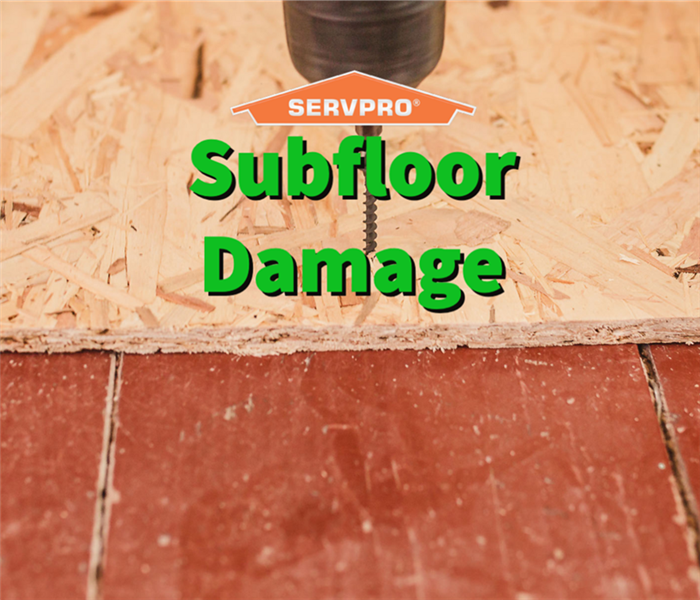 The professionals at SERVPRO can help repair or replace your subfloor damage!
The professionals at SERVPRO can help repair or replace your subfloor damage!
The professionals at SERVPRO of Union, Towns, Fannin & Gilmer Counties know that subfloor damage is a common issue that can often be challenging to recognize.
Your home is layered with subflooring. The subfloor sits between your floor covering, such as carpet or hardwood, and your home’s structural floor joists. When subfloors become damaged, they can compromise the structural integrity of your home and make it difficult to install new floor coverings.
While subfloor damage isn’t always easy to spot, there are a few tell-tale signs. In the following blog post, we will be going over the three most common subfloor damage indicators.
If you are currently suffering from subfloor damage, contact our team of professionals at SERVPRO of Union, Towns, Fannin & Gilmer Counties. We specialize in subfloor replacement and other subfloor repair services.
Three signs of subfloor damage
Water Damage
Water damage is one of the most common subfloor damage signs. Water damage may occur from a significant leak, flooding, or even more minor sources, such as high humidity levels over an extended time. If you notice any water damage on your floor, call water damage professionals immediately before the damage worsens.
Termites
Another standard subfloor damage indicator is termite infestation. If you see signs of termites, such as mud or damaged wood, it’s essential to take action quickly before the problem worsens.
Rot
Finally, subfloor rot is another subfloor damage indicator. Rot is caused by water seeping into the subflooring, creating an ideal mold growth environment. If left unchecked, subfloor rot can lead to major structural issues in your home.
Common areas for subfloor damage to occur
Some areas of your home are more susceptible to subfloor damage than others. The most common rooms where subfloor damage occurs include bathrooms, laundry rooms, and kitchens due to the increased moisture levels in these areas. In the bathroom, watch for subfloor damage around the tub, shower, and toilet.
In the kitchen, you will want to inspect subflooring around areas where water or steam may accumulate, such as near the sink and dishwasher. And in the laundry room, subfloor damage can occur from a washing machine leak or high humidity levels.
Steps to take after you suspect subfloor damage in your home
After you have identified subfloor damage, it’s essential to take action right away. The first step is to contact a water damage restoration company like ours. The team of professionals at a company like ours will be able to assess the damage and recommend the best course of action for subfloor repair or replacement.
After you contact your restoration contractor, contact your insurance company. They can help you determine what subfloor repair services are covered under your specific policy.
Finally, you should take steps to prevent subfloor damage in the future. Inspect subfloors regularly and address any leaks or water damage before they cause extensive subfloor deterioration.
SERVPRO of Union, Towns, Fannin & Gilmer Counties offers subfloor damage repair services
When you choose to hire the team of professionals at SERVPRO of Union, Towns, Fannin & Gilmer Counties for subfloor damage repair services, you will receive peace of mind knowing that we will be able to get the job done right. We specialize in finishing projects in a timely and efficient manner—that's why we're the industry's best!
Our subfloor repair services include subfloor replacement, subfloor drying and dehumidification, subfloor cleaning and sanitizing, subfloor repair, and subfloor insulation.
No matter what type of subfloor damage you may be dealing with in your home, our team can help. Contact us today to learn more about our subfloor repair services. We look forward to helping you get your home back in top condition!
Frozen Pipes: 3 Effective Water Damage Prevention Tips
11/23/2022 (Permalink)
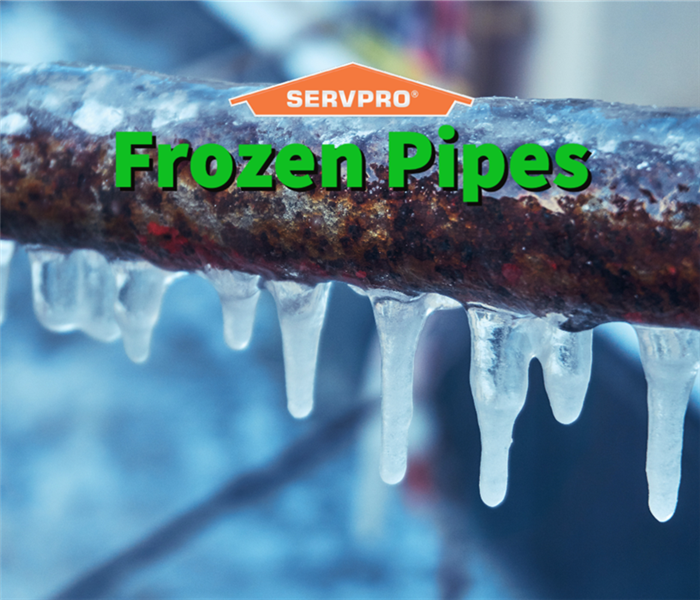 The professionals at SERVPRO can help mitigate any amount of damage caused by frozen pipes.
The professionals at SERVPRO can help mitigate any amount of damage caused by frozen pipes.
Frozen pipes can result in severe water damage to your home if they unexpectedly burst.
It's that time of year again when the temperature starts to drop. Unfortunately, as the weather becomes colder, the professionals at SERVPRO of Union, Towns, Fannin & Gilmer Counties begin receiving an influx of calls from customers with frozen or burst pipes. While frozen pipes are most common in unheated home areas, such as basements, attics, and crawl spaces, they can occur anywhere water is present and the temperature drops below freezing.
Since frozen pipes can result in severe water damage to your home, it's essential to take steps to prevent them from happening in the first place. The following blog post will cover everything you need to know about frozen pipes and how the water damage restoration professionals at SERVPRO can help you restore your property after any size water disaster a burst pipe may cause.
What exactly causes frozen pipes?
Frozen pipes occur when the water inside them freezes and expands; this expansion either directly causes the pipe to burst or increases the pressure of the water still flowing so much that the pipe can’t handle the added stress. A pipe freeze usually happens when the temperature outside drops below freezing and water in the pipes isn't being used regularly, allowing it to cool down and freeze in the first place.
Pipes that run against exterior walls or in unheated home areas are most susceptible to freezing because they're most exposed to the cold air. When water freezes in a pipe, it can cause the pipe to burst, leading to severe water damage in your home, increasing your water bill and requiring professional restoration.
What to do when you find frozen pipes?
If you discover a frozen pipe before it bursts, turn off the water to your home using the main shut-off valve. Turning off the main water shut-off valve will help prevent any further damage and flooding.
Once the water is off, open your faucets to release any built-up water pressure in the frozen pipe. Next, use a heating device like a space heater or hair dryer to thaw the frozen pipe. Never use an open flame to thaw a frozen pipe because it can result in a fire.
After the water in the pipe is thawed, turn it back on at the main shut-off valve and check your faucets to ensure they're working correctly. If a frozen pipe has already burst, call a professional water damage company to repair the damage and prevent further flooding.
Three tips to prevent frozen pipes
Now that you know what to do when you find frozen pipes, it's also essential to understand how to prevent them. The following are three tips to avoid freezing pipes:
- Keep your thermostat at a steady temperature: When the temperature outside starts to drop, make sure you keep your thermostat at a constituent temperature because a sudden drop in temperature can cause your pipes to freeze.
- Allow at-risk faucets to run during cold weather: Even flow as slow as a drip during cold weather can help prevent frozen pipes because it keeps water moving through the pipes, preventing them from freezing.
- Insulate exposed pipes: Properly insulating exposed pipes in your home helps prevent them from freezing, particularly those in the basement or garage
How can SERVPRO help if your frozen pipe bursts?
When your frozen pipe bursts, you can rely on the professionals at SERVPRO of Union, Towns, Fannin & Gilmer Counties. We have the training and experience to handle any size of water damage disaster. We will work quickly to remove any standing water and dry out your home to prevent any further damage.
SERVPRO of Union, Towns, Fannin & Gilmer Counties is an IICRC-certified water damage restoration company. We are dedicated to helping our customers restore their homes and businesses to their preloss condition. We understand the importance of a quick response time and will work quickly to mitigate further damage.
Our water damage restoration service includes:
- Water extraction
- Structural drying
- Dehumidification
- Mold Remediation
If your home has been affected by frozen pipes or any other water damage, contact SERVPRO of Union, Towns, Fannin & Gilmer Counties! We are available 24/7 and will respond quickly to any water damage disaster.
Lint Trap Fire: 5 Effective Tips To Avoid Major Fire Damage
10/24/2022 (Permalink)
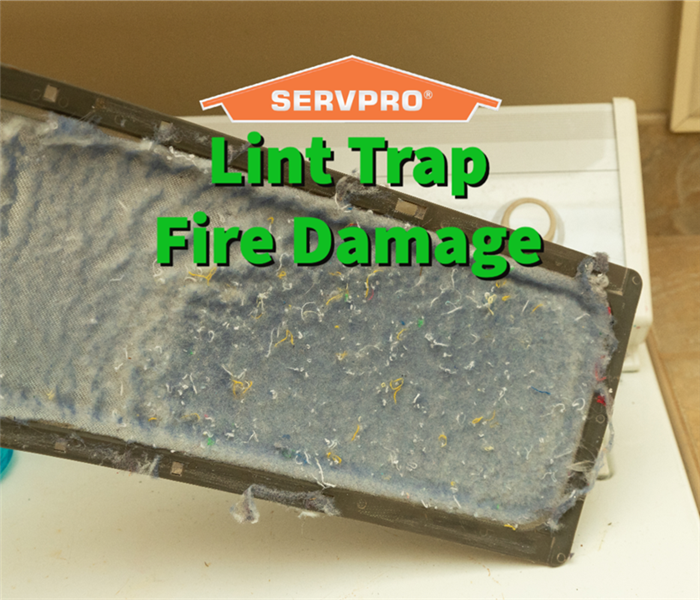 The professionals are on call and ready to restore your fire-damaged property!
The professionals are on call and ready to restore your fire-damaged property!
The professionals at SERVPRO of Union, Towns, Fannin & Gilmer Counties are here to help your property avoid lint trap fires.
Dryer fires are common in homes across the United States, and lint build-up is the leading cause of this type of fire. SERVPRO professionals have seen the damage these fires can cause, and we want to help you avoid becoming a victim of a lint trap fire.
Lint trap fires typically happen when the lint build-up in the dryer or around the vent becomes hot enough to ignite. The fire then has access to the home through the ductwork and quickly begins to spread, causing significant fire damage.
The following blog post will go over five tips the experts at SERVPRO of Union, Towns, Fannin & Gilmer Counties advise to help avoid a lint trap fire in your home. Keep reading to learn more about lint trap fires and what you can do after fire damage occurs on your property.
What is lint, and how does it cause fires?
Lint is a fluffy, cotton-like material produced when clothes are dried. Lint can cause fires because it is very flammable and often collects in the dryer and around the vent where there is extra heat. Lint build-up in the dryer is the leading cause of dryer fires.
Tips to prevent a lint trap fire
Now that you know the dangers of lint build-up let's review some tips on preventing a lint trap fire from happening in your home.
1) Clean out the lint trap after every load of laundry
One of the best ways to prevent a lint fire is to clean out the lint trap after every load of laundry. Lint can quickly build up in the trap and cause a fire if it is not removed regularly.
2) Keep an eye on the dryer while it's in use
Another way to prevent a lint fire is to keep an eye on the dryer while it is in use. If you notice any sparks or excessive heat coming from the machine, unplug it immediately.
3) Have your clothes dryer installed by a professional
If you are unsure how to install a clothes dryer properly, it is best to hire a professional. Professional installation will help ensure that the dryer is installed correctly and will not pose a fire hazard.
4) Clean lint out of the vent pipe every three months
It is vital to clean lint out of the vent pipe every three months. Lint can quickly build up in the pipe and cause a fire if it is not removed regularly.
5) Check regularly to make sure nests of small animals and insects are not blocking the outside vent
Nests of small animals and insects can block the dryer's outside vent, limiting airflow and contributing to a fire. Therefore, it is essential to check the vent regularly to ensure it is clear.
What should you do if a lint fire occurs?
Call the fire department immediately when a lint fire occurs in your home. Once the fire is out, you should contact a professional fire restoration company. The right company will be able to quickly and efficiently restore your home to its pre-fire condition and will know its way around insurance claims.
SERVPRO of Union, Towns, Fannin & Gilmer Counties—your local fire damage restoration company
When a lint trap fire breaks out, you must have a company on-call that you can trust. The experts at SERVPRO of Union, Towns, Fannin & Gilmer Counties are here to help! We have the knowledge and experience to quickly and efficiently restore your home or business to its pre-fire condition.
SERVPRO of Union, Towns, Fannin & Gilmer Counties is a leading provider of fire restoration services. Our team of certified professionals has the knowledge and experience to handle any sized job, big or small. When you hire us for fire restoration services, you can expect a quick response time because we understand that time is of the essence when a fire occurs. Our team will arrive on-site within hours of your call to begin the restoration process.
Contact us today for more information about our fire restoration services.
Banquet Hall Water Damage: 3 Easy Steps For Minimizing Damages
9/30/2022 (Permalink)
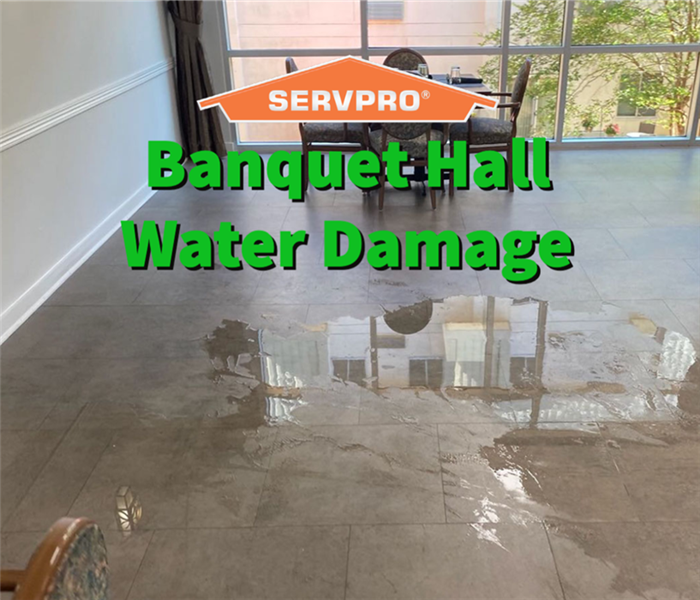 The professionals at SERVPRO are always available to help combat commercial water losses!
The professionals at SERVPRO are always available to help combat commercial water losses!
With SERVPRO in your corner, you can forget combating banquet hall water damage alone!
Commercial property owners know that water damage can be a significant setback. Unfortunately, your banquet hall is one of the most versatile event spaces that is a common place for water damage. Whether the damage is caused by a natural disaster or a plumbing failure, taking action as soon as possible is essential to minimize the damage.
The inspiration behind the following blog post is due to a recent banquet hall water loss our SERVPRO of Union, Towns, Fannin & Gilmer Counties production team was able to help mitigate and restore. However, the damages would not have been as extensive had the banquet hall owner known the steps to minimize the damages.
Continue reading to learn the three steps you can take to quickly bounce back and minimize the banquet hall water damage and how the professionals at SERVPRO of Union, Towns, Fannin & Gilmer Counties can help.
What is a banquet hall, and what are the common causes of water damage?
A banquet hall is a large event space for various occasions, such as weddings, business meetings, and conventions. Water damage is a common occurrence in banquet halls and can occur by many different factors, such as:
- Plumbing failure
- Natural disasters,
- Leaking roofs
- Burst pipes
- Overflowing toilets
These are just a few potential causes of banquet hall water damage. However, no matter the cause, it is essential to minimize the damages quickly!
3 Steps to minimize banquet hall water damage
When banquet water damage is not addressed quickly, it can cause extensive damage to the property and put the business out of commission for quite some time. Here are three steps you can take to minimize banquet hall water damage:
Step 1. Shut off the water source: No matter what the cause of the water damage is, it's essential to shut off the water source as soon as possible. Shutting off the water source will help prevent further damage to the property.
Step 2. Call a water restoration company: The next step is to call a professional water restoration company that can quickly assess the situation and start the water mitigation and restoration process.
Step 3. Contact your insurance carrier: Once you have contacted a water restoration company, you must contact your banquet hall insurance carrier to start the claims process. Your insurance carrier will recommend that you document the damages with photos and video to support your claim.
When a banquet hall experiences water damage, getting the business back up and running can be daunting. However, by taking actionable steps and working with the right professionals, you can minimize the damages caused by water and get your banquet hall back on track.
How SERVPRO of Union, Towns, Fannin & Gilmer Counties helps with banquet hall water damage
The professionals at SERVPRO of Union, Towns, Fannin & Gilmer Counties are water damage experts. We have the training and experience to assess the situation and start the water mitigation process quickly. Here is what you can expect when you work with SERVPRO of Union, Towns, Fannin & Gilmer Counties:
- Create a plan: The first step our professionals will take is to evaluate the damage and determine the best course of action.
- Water extraction: The next step is to extract the water from the banquet hall. Extraction is performed by using industrial-strength pumps and vacuums.
- Drying and dehumidification: Once the water has been extracted, our professionals will use industrial-strength fans and dehumidifiers to dry the banquet hall.
- Cleaning and disinfecting: The last step is to clean and disinfect the banquet hall to prevent the growth of mold and mildew.
When you work with SERVPRO of Union, Towns, Fannin & Gilmer Counties, you can rest assured that you are in good hands. We will work quickly to minimize the banquet hall water damage and get your business back up and running.
Wrapping up
We hope that you found this blog post helpful. Banquet hall water damage is a common occurrence that many factors can cause. However, you can minimize banquet hall water damage by taking these three actionable steps:
- Shut off the water source
- Call a professional water restoration company
- Contact your insurance carrier
By contacting the professionals at SERVPRO of Union, Towns, Fannin & Gilmer Counties, you can rest assured that we will work quickly to minimize the banquet hall water damage and get your business back up and running.
If you have any questions or would like more information, please feel free to contact us at any time. We are always here to help!
Electrical Fire Damage: 5 Steps to Take to Speed Up Recovery
9/23/2022 (Permalink)
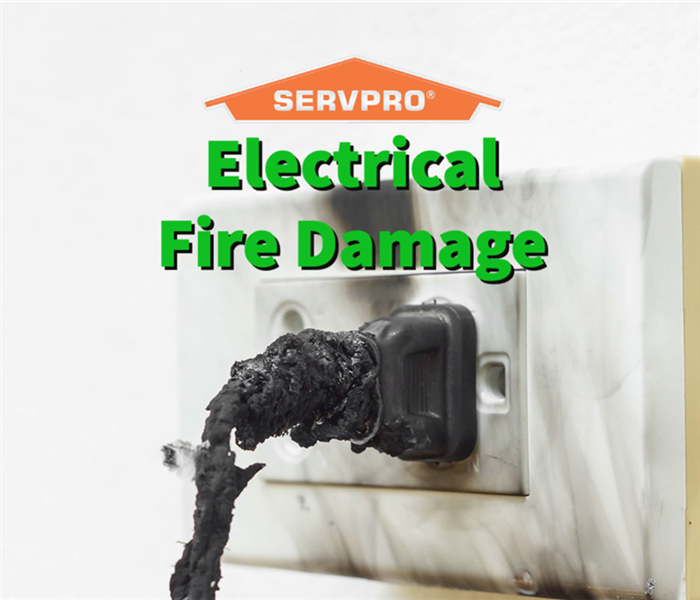 The professionals at SERVPRO are always available to help combat electrical fire damage!
The professionals at SERVPRO are always available to help combat electrical fire damage!
Having a restoration company like SERVPRO in your corner can help make electrical fire damage disappear!
The professionals at SERVPRO of Union, Towns, Fannin & Gilmer Counties understand that an electrical fire can be a frightening experience. Not only is there the potential for extensive damage to your property, but there is also a guarantee that your personal belongings could be lost or damaged. We have seen electrical fires occur for several reasons, but the most common causes include:
- Faulty electrical wiring
- Overloaded electrical circuits
- Extension cords
- Appliance malfunctions
When an electrical fire occurs, you will want to take steps to ensure that your home or business is back in its pre-damaged condition as quickly as possible. This blog post will discuss five steps you can take to speed up the restoration process.
What is an electrical fire?
Electrical fires are a type of fire caused by electrical wiring or equipment. These fires can be hazardous and can cause extensive damage to your property. The best way to prevent electrical fires is to ensure that your electrical wiring and equipment are in good condition and are not overloaded.
Five steps to take when an electrical fire occurs
You will want to prioritize your family's safety when an electrical fire occurs. Once you have done that, you can focus on the steps needed to get your home back to normal as quickly as possible. The following steps are recommended to start the restoration process quickly and to save your damaged belongings:
Step 1. Call the Fire Department
The first step you should take when an electrical fire occurs is to call the fire department. Electrical fires can be hazardous, and you must have professional help to put out the fire and ensure safety.
Step 2. Evacuate the premises
Once the fire department has been notified, you will need to evacuate the premises. You and your family must leave the area immediately and go to a safe place.
Step 3. Shut off the power
It is essential to shut off the power to reduce the risk of further damage.
Step 4. Contact a fire restoration company
The next step is to call a fire restoration company. Electrical fires can cause extensive damage to your property, and it's essential to have a professional help you restore your home or business.
Step 5. Contact your insurance company
If your home suffers any damage from an electrical fire, contact your insurance company. They will be able to help you with the claims process and provide you with the financial assistance you need.
Our electrical fire restoration process
As you have learned in step four, calling a restoration company is crucial as soon as possible after an electrical fire occurs. SERVPRO of Union, Towns, Fannin & Gilmer Counties is available 24 hours a day, seven days a week, and will respond quickly to your electrical fire emergency. Our electrical fire restoration process includes the following steps:
- Inspection and assessment: The first step in our electrical fire restoration process is to inspect and assess the damage. The fire damage assessment will help us determine the best action to restore your property.
- Board-up and tarp-over services: If necessary, we will provide board-up and tarp-over services to secure your property. These services will help prevent further damage and protect your property from the elements.
- Electrical system repair: Repairing your electrical system is essential to avoid another electrical fire. Common electrical repairs include replacing electrical wiring, outlets, and switches.
- Fire damage cleaning: Once the electrical repairs are complete, we will begin fire damage cleaning. Deep fire damage cleaning will remove any smoke and soot from your property.
- Rebuild: The final step in our electrical fire restoration process is to rebuild your property to its pre-fire condition. They may involve drywall repairs, painting, and structural rebuilds.
Wrapping up
We hope you enjoyed learning the steps you need to take if an electrical fire occurs in your home or business. Remember that the first thing you should do when an electrical fire occurs is to call the fire department and evacuate the premises. Then, once the fire is extinguished, you should contact a fire restoration company like SERVPRO of Union, Towns, Fannin & Gilmer Counties.
As an IICRC-certified firm, we have the experience, training, and equipment necessary to restore your property quickly and efficiently. We understand the stress that electrical fires can cause, and we will work tirelessly to return your home or business to its pre-fire condition.
If you have any questions about our electrical fire restoration process or need assistance with a restoration project, please contact us today. We are always here to help!
Autumn Storm Damage: 4 Common Weather Threats
9/16/2022 (Permalink)
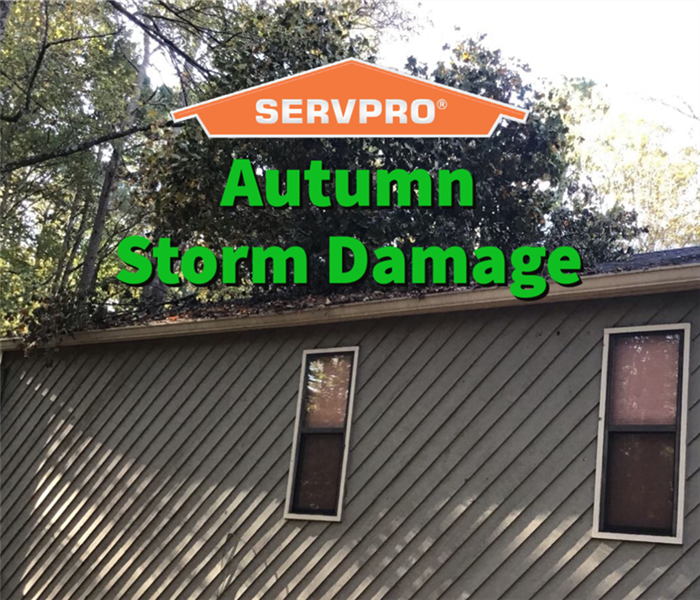 The professionals at SERVPRO offer emergency storm restoration services!
The professionals at SERVPRO offer emergency storm restoration services!
The professionals at SERVPRO of SERVPRO of Union, Towns, Fannin & Gilmer Counties are here to help you combat autumn storm damage.
The autumn season is most people's favorite season. The leaves are changing color, the air is getting cooler, and pumpkin spice lattes are back on the menu. But autumn also brings potentially dangerous weather conditions that can cause severe damage to your home or property.
The professionals at SERVPRO of Union, Towns, Fannin & Gilmer Counties have seen it all when it comes to autumn weather damage, and we want to ensure you are well prepared before the storm hits.
Here are four of the most common autumn weather threats:
- High winds
- Heavy rains
- Cold fronts
- Snowfall
In the following blog post, we will be going over what damages each weather condition can cause and how SERVPRO of Union, Towns, Fannin & Gilmer Counties can help.
What is autumn storm damage?
Autumn storm damage is any damage that is caused by autumn weather conditions. The best way to protect your home or property from autumn storm damage is to be aware of the threats and take the necessary precautions. Here is a list of the four most common autumn weather threats and the damages they can cause:
1) What damages can high winds cause?
High winds can cause severe property damage by blowing objects around or even lifting them and carrying them away. They can also knock down trees and power lines, causing power outages.
2) What damages can heavy rains cause?
Heavy rains can lead to flash flooding when water accumulates rapidly and causes sudden flooding in areas that are generally not prone to it. Flash flooding can be hazardous and will leave a property with water damage.
3) What damages can cold fronts cause?
A cold front is a weather system that brings a sudden drop in temperature and is often accompanied by rain or snow. Cold fronts can cause power outages and pipe bursts from the extreme influx in temperature.
4) What damages can snowfall cause?
Snowfall can cause several types of damage, including roof collapses, downed power lines, and slippery conditions.
How can you protect your home and property from autumn storm damage?
Now that you know the four most common autumn weather threats and the damages they can cause, it's time to learn how you can protect your property from them. Here are some of the most important tips to remember this autumn season:
- Have a disaster preparedness plan. This plan should include a list of emergency contact numbers, evacuation routes, and a safe place to go if you need to evacuate.
- Make sure your home is properly insured. Autumn storm damage can be very costly, so it is essential to have insurance coverage in case of a storm.
- Keep an eye on the weather forecast and be prepared for severe weather conditions. Make sure you have plenty of food, water, and other supplies if you lose power or must evacuate.
- Clean up any debris or branches that could cause problems during a storm. Clogged gutters are a real issue, so it is essential to ensure your gutters are clear and free of leaves so water can flow away from your home.
- Stay safe during a storm! Do not try to leave your home during high winds or heavy rains, and stay away from downed power lines.
How does SERVPRO of Union, Towns, Fannin & Gilmer Counties help with autumn storm damage restoration?
Even the most prepared property owners can't always avoid autumn storm damage. If your home or property is damaged by an autumn storm, SERVPRO of Union, Towns, Fannin & Gilmer Counties is here to help. We are a professional storm restoration company with years of experience helping homeowners recover from storm damage. We have the knowledge and equipment to quickly and efficiently restore your home or property to its pre-storm condition.
When you choose to hire us for storm damage restoration, we will:
- Inspect your home or property for damage and identify the extent of the damage.
- Determine what type of repairs are needed and create a plan to restore your property to its pre-storm condition.
- Create a detailed insurance estimate.
- Work quickly and efficiently to repair any damage caused by the storm.
- Keep you updated on our progress and answer any questions you may have.
Contact SERVPRO of Union, Towns, Fannin & Gilmer Counties today for all your autumn storm restoration needs! We are available 24/7 and will respond quickly to help minimize the damages caused by a storm.
5 Amazing Tips to Prevent Roof Leaks
9/9/2022 (Permalink)
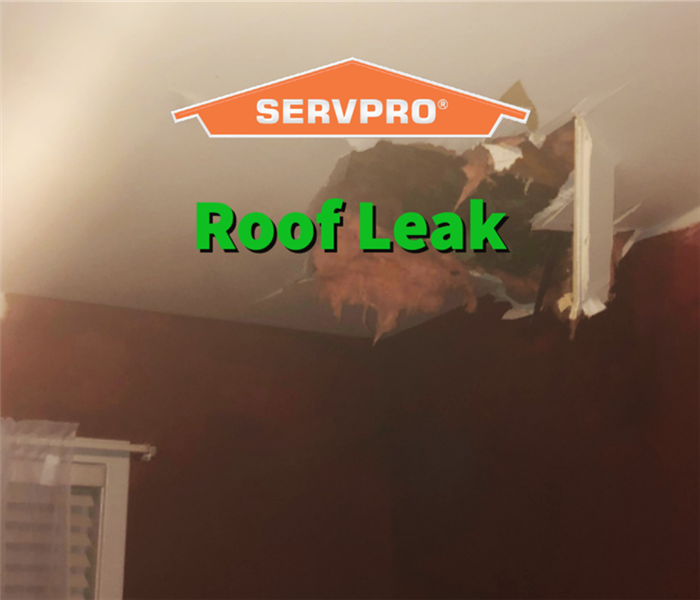 The professionals at SERVPRO are available 24/7 to help combat water damage caused by a roof leak!
The professionals at SERVPRO are available 24/7 to help combat water damage caused by a roof leak!
Recover quickly from a roof leak with help from the professionals at SERVPRO of Union, Towns, Fannin & Gilmer Counties!
Water damage is one of the most severe problems a homeowner can face, and roof leaks are often to blame. Unfortunately, a roof leak can lead to costly repairs and, in some cases, even cause your home to be uninhabitable. But don't worry, the team at SERVPRO of Union, Towns, Fannin & Gilmer Counties is here to help!
Every year the professionals at SERVPRO receive numerous calls regarding roof leaks. As a result, we have put together the following blog post today to help educate our customers on roof leaks and how to prevent them.
Roof leaks can cause a lot of damage to your home and possessions, so it's essential to take steps to prevent them from happening in the first place. In the following blog post, you will learn about five tips we recommend to keep your roof in good condition and avoid costly water damage.
What causes a roof leak?
A roof leak can occur for several reasons, such as weather damage, roofing failures, or improper roof maintenance. Although, in most cases, roof leaks result from faulty roofing materials or poor installation. If your roof isn't properly sealed or the flashing is damaged, water can easily find its way in and cause damage to your home.
One of the telltale signs of a roof leak is water damage on the ceilings or walls of your home. If you see any water stains or discoloration, this is a sure sign that you have a roof leak.
Five tips to prevent roof leaks
Fortunately, there are a few things that you can do to help prevent roof leaks from happening. Here are our five tips that we recommend to every property owner:
Make sure your roof is adequately sealed.
Ensure all seams and joints are properly sealed with caulk or sealant to keep moisture out. When your roof isn't properly sealed, water can easily find its way in and cause damage.
Install wind anchors
Wind anchors are installed around the roof's edge for additional support. They will help keep your roofing materials in place and prevent them from becoming loose or dislodged.
Keep your gutters clean and install gutter guards.
Clogged gutters can cause water to back up and overflow onto your roof, leading to leaks. Make sure you keep your gutters clean and free of debris so that water can flow freely. It is a good idea to install gutter guards to help keep leaves and other debris out.
Keep trees and other vegetation trimmed away from your roof.
Overhanging branches and other vegetation can damage your roof or allow water to pool on top of it. Keep trees trimmed away from your roof to prevent any damage.
Get regular roof inspections done by a qualified professional
One of the best ways to prevent roof leaks is to get regular roof inspections done by a qualified professional. A roof inspector can identify any potential problems and fix them before they become a more significant issue.
SERVPRO can help in the event of a roof leak
A roof is an essential part of a home, and it's crucial to ensure it functions correctly. By following the tips in this blog post, you can ensure that your home and possessions are safe from damages caused by a leaking roof.
In the unfortunate event that your roof does leak, SERVPRO of Union, Towns, Fannin & Gilmer Counties can help. We are a water damage restoration company that specializes in helping homeowners recover from water damage.
When you choose to hire us for a roof leak, we will:
- Assess the damage and develop a plan of action
- Work to prevent any further damage from occurring
- Restore your home to its original condition
As an IICRC-certified firm, we have the knowledge and experience to restore your home to its original condition quickly and effectively. Please get in touch with us today if you have any questions or would like to schedule an estimate.
Fireplace Fire Damage: 5 Tips to Prevent Fireplace Fires
9/2/2022 (Permalink)
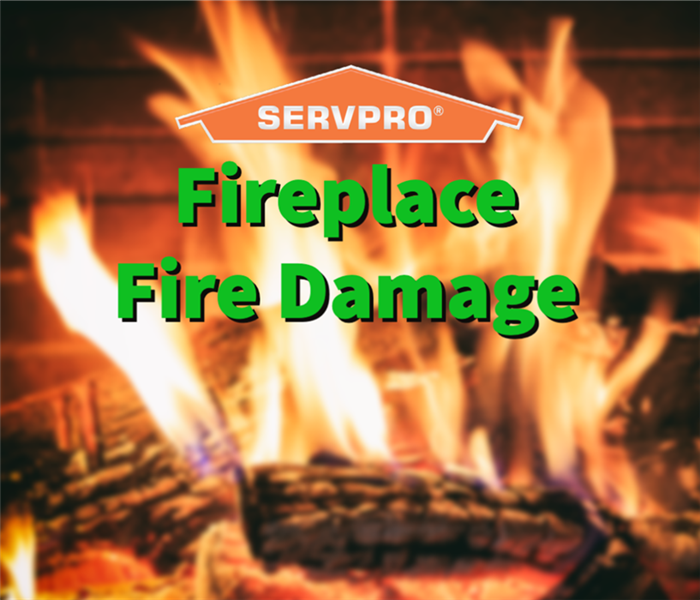 The professionals at SERVPRO are available 24/7 to combat any amount of fire damage.
The professionals at SERVPRO are available 24/7 to combat any amount of fire damage.
The professionals at SERVPRO of Union, Towns, Fannin & Gilmer Counties want to ensure that you and your family are safe this fireplace season.
Fireplaces are a cozy addition to any home in the fall and winter, but they can also be dangerous if not used safely. The professionals at SERVPRO have seen the first-hand effects of fireplace fire damage and want to ensure that the residents of the North Georgia Counties avoid any possibility of a fireplace fire in their homes.
The following blog post will cover our top five favorite tips on how a property owner can avoid a fireplace fire and what steps they should take in the event that a fireplace fire does occur. However, before we get started, we must mention that it is best to contact fire restoration professionals immediately after experiencing fire damage.
The dangers of fireplace fires
Fireplace fires are one of the leading causes of residential fires in the United States. A fireplace fire can cause extensive damage to your home and, in some cases, even may be catastrophic. Many things can contribute to a fireplace fire, but some causes are more common than others. The following outlines the most popular reasons for a fireplace fire:
- Burning materials other than wood- One of the most common fireplace fire hazards is burning materials other than wood in your fireplace. Avoid burning paper, leaves, and trash. While it might be tempting to burn these items in your fireplace, it is best to avoid them, as they can easily ignite and cause a fire.
- Not using a fireplace screen- A fireplace screen is designed to keep embers and sparks from flying out of the fireplace and landing on nearby combustible materials. If you do not have a fireplace screen, keep a close eye on the fireplace while it is in use.
- Creosote build-up- Creosote is a flammable substance that builds up inside your chimney. If not removed, it can easily ignite and cause a fireplace fire. Be sure to have your chimney cleaned regularly to avoid build-up.
Five tips to prevent fireplace fires
Now that we have covered the dangers of fireplace fires, let's look at some tips for preventing them.
- Use a fireplace screen- As we mentioned before, fireplace screens are designed to keep embers and sparks from flying out of the fireplace. Be sure to use one whenever you have a fire in your fireplace.
- Only burn dry wood- Wet or green wood is one of the leading causes of fireplace fires. This type of wood contains a high amount of moisture, which can cause it to ignite quickly and produce a lot of smoke. Be sure only to burn dry, seasoned wood in your fireplace.
- Minimize creosote build-up- As we mentioned before, creosote is a flammable substance that can build up inside your chimney. To avoid this hazard, be sure to have your chimney cleaned regularly.
- Schedule annual chimney inspections- A yearly chimney inspection can help identify any potential fireplace hazards before they have a chance to cause a fire.
- Install a chimney cap- A chimney cap is designed to keep debris and animals out of your chimney. A chimney cap has proven to help prevent a fireplace fire from starting in the first place.
What to do in the event of a fireplace fire?
In the event that a fireplace fire does occur, it is essential to take the following steps:
Step 1: Evacuate your home immediately- The first step is to evacuate your home immediately. Be sure to leave all of your belongings behind and get out safely.
Step 2: Call the local fire department once you are safely out of your home.
Step 3: Contact your insurance company- After you have evacuated your home and contacted the fire department, be sure to contact your insurance company. They will be able to help you with the next steps in the claims process.
Step 4: Contact a reliable restoration company- Once the fire is extinguished and you have contacted your insurance company, it is essential to contact a dependable restoration company. They will be able to help you restore your home back to its preloss condition.
SERVPRO of Union, Towns, Fannin & Gilmer Counties can help when disaster strikes!
We hope you enjoyed learning about fireplace safety and what to do in the event of a fireplace fire.
When a fireplace fire occurs, acting quickly and contacting a reliable restoration company is essential. SERVPRO of Union, Towns, Fannin & Gilmer Counties has the training and experience necessary to restore your home back to its preloss condition.
Our fire damage services include:
- Board-ups
- Contents cleaning
- Smoke and odor removal
- Structural repairs
We understand that fireplace fires can be stressful, and when you choose to hire us, we promise to work quickly and efficiently to get your home back to normal. So do not hesitate to contact us when you have experienced a fireplace fire! We are available 24 hours a day, seven days a week, 365 days a year.
Summer Storm Damage: 5 Tips for Cleaning Up After a Storm
8/19/2022 (Permalink)
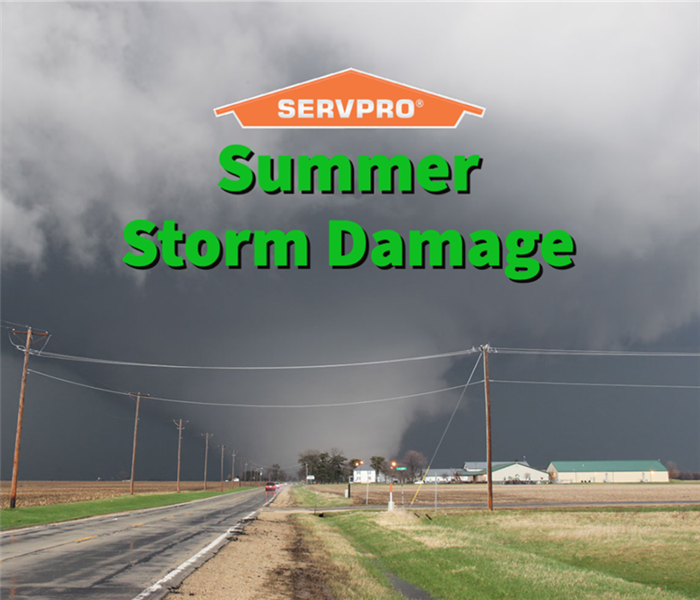 The professionals at SERVPRO are here to help you combat summer storm damage!
The professionals at SERVPRO are here to help you combat summer storm damage!
With the help of the professionals at SERVPRO of Union, Towns, Fannin & Gilmer Counties, you never have to face summer storm damage alone!
Summer storms can cause a lot of damage, both to your property and to your peace of mind. When unprepared, a summer storm's aftermath can be chaotic and overwhelming. That's why it's essential to have a plan in place before the storm hits.
Although even with thorough planning, your property may still obtain severe summer storm damage, and you may not know what to do to start the cleanup process. That is why we put together five tips for cleaning up after a summer storm has passed so that you can get your home back to normal as soon as possible!
The most common type of summer storm that causes damage
Every summer, the state of Georgia is hit with multiple storms, and thunderstorms are the most common type of storm that causes damage. Thunderstorms can cause damage to your property in several ways, including exterior damage, water damage, and fallen tree damage.
While all thunderstorms have the potential to cause summer storm damage, some are more powerful than others. Severe thunderstorms can produce wind gusts with high mph, hail the size of quarters or larger, and tornadoes. Therefore, when a severe thunderstorm hits, it's essential to take shelter immediately.
What to do after summer storm damage has occurred?
Once the storm has passed, it's time to start the cleanup process! Here are five tips for cleaning up after summer storm damage has occurred:
- Stay Safe: First and foremost, staying safe is vital after summer storm damage. Be sure to avoid any downed power lines and beware of broken glass or other sharp objects that may be present. Contact a professional for assistance if you encounter any summer storm damage that presents a safety hazard.
- Contact Your Insurance Company: The next step is to notify your insurance company of the summer storm damage that has occurred. They will likely send an adjuster to assess the damage and determine if your insurance policy covers the damages.
- Make a List of Damages: Once you have contacted your insurance company, it's time to list all the summer storm damage that has occurred to your property. Your list will be helpful when filing your insurance claim. At this time, you will also want to take photos or videos of the damage for documentation purposes.
- Start the Cleanup Process: Once you have made a list of all the summer storm damage, it's time to start the cleanup process. Depending on the severity of the damage, you may be able to clean up some of the summer storm damage yourself. However, it's best to contact a professional storm damage restoration company like SERVPRO of Union, Towns, Fannin & Gilmer Counties for more severe summer storm damage.
- Prevent Further Damage: Once you have started the summer storm damage cleanup process, it's essential to take steps to prevent further damage. You should remove all salvageable items to a secure location.
The professionals at SERVPRO of Union, Towns, Fannin & Gilmer Counties are always here to help with summer storm damage cleanup!
We hope you enjoyed learning about summer storm damage and the steps you should take after summer storm damage has occurred. Storm damage does not have to be the end of the world, but it's essential to be prepared and know what to do after summer storm damage.
The professionals at SERVPRO of Union, Towns, Fannin & Gilmer Counties are always here to help if you need assistance with summer storm damage cleanup! As an IICRC-certified firm, we have the knowledge, experience, and equipment to handle any size storm damage cleanup project. Contact our team of professionals to get started!
Restaurant Water Damage: 5 Essential Prevention Tips
8/4/2022 (Permalink)
 The professionals at SERVPRO are here to help you combat restaurant water damage!
The professionals at SERVPRO are here to help you combat restaurant water damage!
Let the professionals at SERVPRO of Union, Towns, Fannin & Gilmer Counties help you combat restaurant water damage.
Restaurant water damage can have a devastating effect on your business. Not only can it cause extensive property damage, but it can also risk the safety of your customers and employees. That's why it's essential to take the necessary precautions to prevent restaurant water damage from happening in the first place.
The professionals at SERVPRO of Union, Towns, Fannin & Gilmer Counties have been helping restaurant owners mitigate commercial water damage for many decades. We understand the unique challenges that restaurant owners face when it comes to water damage prevention, and we're here to help.
In the following blog post, we will share our top five tips for preventing restaurant water damage so that you can keep your business up and running in the event of an emergency.
What is restaurant water damage?
Restaurant water damage is damage that occurs when water enters your restaurant, either through a leak or a flood. When left unaddressed, restaurant water damage can lead to:
- Extensive property damage
- The growth of mold and mildew
- The contamination of food and beverages
- The spread of bacteria
- The risk of electrical shocks
- The risk of slips and falls
As you can see, restaurant water damage can seriously impact your business. That's why taking the necessary precautions to prevent it from happening in the first place is essential.
Our five restaurant water damage prevention tips
There are several steps that restaurant owners can take to prevent restaurant water damage. Here are our top five tips:
1. Inspect your restaurant regularly for water leaks
One of the best ways to prevent restaurant water damage is to inspect your restaurant regularly for water leaks. You should check all of the pipes and fixtures in your restaurant, including the sink, toilets, dishwasher, and washing machine. If you find a water leak, make sure to repair it immediately.
2. Keep an eye on the weather forecast
If there are severe weather conditions in the forecast, be sure to keep an eye on the weather report and take the necessary precautions to protect your restaurant. For example, if there is a flood warning in your area, you may want to move restaurant equipment and furniture to higher ground.
3. Have a water damage restoration company on standby
In the event of a restaurant water emergency, it's essential to have a professional water damage restoration company like SERVPRO on standby. They can help you quickly assess the damage and take the appropriate steps to dry out your property and get your business back up and running. The quicker you can address restaurant water damage, the less damage it will cause.
4. Train your employees on restaurant water damage prevention
Make sure your employees are trained on restaurant water damage prevention. They should know what to do when there's a leak or flood, including how to shut off the water supply and where to find the main breaker.
5. Invest in a sump pump
If your restaurant is located in an area that is prone to flooding, consider investing in a sump pump. A sump pump is a device installed at the lowest point of your restaurant. It will pump water out of your restaurant in the event of a flood.
How SERVPRO of Union, Towns, Fannin & Gilmer Counties can help you combat restaurant water damage
Restaurant water damage can be a severe issue. However, with the help of a professional water damage restoration company like SERVPRO of Union, Towns, Fannin & Gilmer Counties, you can mitigate the damage and get your business back up and running.
SERVPRO of Union, Towns, Fannin & Gilmer Counties has been helping restaurant owners recover from water damage for many years. As an IICRC-certified firm, we have the experience and expertise necessary to handle any restaurant water emergency. We will work quickly to assess the damage and take the appropriate steps to dry out your property and get your business back up and running.
If you're experiencing a restaurant water emergency, don't hesitate to contact us via our contact page. We're available 24/7, 365 days a year, to help.
4 Signs of Crawlspace Water Damage & Our Restoration Process
7/15/2022 (Permalink)
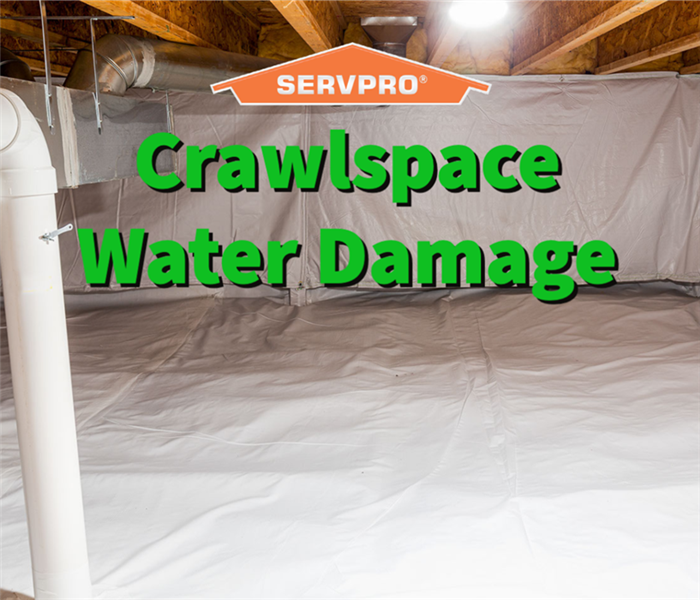 SERVPRO is available 24/7 for emergency water restoration services!
SERVPRO is available 24/7 for emergency water restoration services!
Crawlspace water damage can happen at any time, and it's essential to be aware of the signs so that you can take action as soon as possible.
There has recently been an influx of calls here at SERVPRO of Union, Towns, Fannin & Gilmer Counties regarding crawlspace water damage, and we have seen multiple different causes. Unfortunately, water damage in crawlspaces can quickly become a big problem. For example, we have witnessed flooded crawlspaces due to faulty sump pumps and slowly leaking pipes that have gone undetected for months.
We put this blog post together to help home and business owners identify the signs of crawlspace water damage and also to explain our process for crawlspace water damage restoration for when you need us. So without further ado, let's get started.
What is crawlspace water damage?
Crawlspace water damage is water damage that occurs in the crawlspace of a home or business. The crawlspace is the area between the ground and the first floor of a building and is typically only large enough for a person to enter by crawling.
While most people don't spend much time in their crawlspace, it's actually an essential part of their home or business. The crawlspace provides access to the plumbing and electrical systems, and it also helps to support the structure of the building. However, because crawlspaces are often dark and damp, they can be a breeding ground for mold and mildew. And if there is water damage in the crawlspace, it can quickly spread to other parts of the building.
What are the signs of crawlspace water damage?
There are four main signs of crawlspace water damage:
- Wet insulation: Wet insulation is one of the most common signs of crawlspace water damage. If you notice that your insulation is wet, it's a good idea to call in a professional to take a look. Insulation damaged by water can become moldy, and it will lose its ability to protect your home or business from heat and cold.
- Water stains on the walls or ceiling: Another common sign of crawlspace water damage is water stains on the walls or ceiling. Leaks in the crawlspace often cause these stains, and they can be a sign that there is significant water damage.
- Musty odors: Musty odors are another telltale sign of crawlspace water damage. If you notice a musty smell in your crawlspace, it's a good idea to call a professional to take a look. Musty odors are often caused by mold and mildew, which can signify significant water damage.
- Visible mold or mildew: Finally, visible mold or mildew is another sign of crawlspace water damage. If you see mold or mildew in your crawlspace, it's essential to call in a professional as soon as possible.
If you notice any of these signs of crawlspace water damage, it's essential to call in a professional as soon as possible. The sooner you take action, the less damage the water will cause.
How does SERVPRO restore crawlspace water damage?
When you call SERVPRO of Union, Towns, Fannin & Gilmer Counties for crawlspace water damage restoration, our first step is to assess the extent of the damage. We will then develop a plan to restore your crawlspace to its pre-damaged condition.
Our crawlspace water damage restoration process includes the following steps:
- Remove wet insulation: The first step in our crawlspace water damage restoration process is to remove any wet insulation. We will also dispose of any moldy or mildewed insulation.
- Dry out the crawlspace: Once the wet insulation has been removed, we will use industrial fans and dehumidifiers to dry out the crawlspace.
- Clean and disinfect the crawlspace: Once the crawlspace is dry, we will clean and disinfect it to prevent mold and mildew from growing.
- Install new insulation: Finally, we will install new insulation in your crawlspace. We will also ensure that any plumbing or electrical systems are in good working order.
Final thoughts
We hope you enjoyed reading this blog post about crawlspace water damage. If you have any questions about our crawlspace water damage restoration process, please don't hesitate to contact us. We are available 24/7, 365 days, for any size water damage emergency. Remember, the sooner you take action, the less damage the water will cause.
Before we wrap up, we must remind you that our professionals have undergone extensive training and are certified by the IICRC. We have the knowledge and experience to handle any size water damage emergency, big or small. So contact SERVPRO of Union, Towns, Fannin & Gilmer Counties today, and we will get to work right away on restoring your crawlspace.
The Top 4 Reasons Why Containment Walls Are Essential
7/1/2022 (Permalink)
 The professionals at SERVPRO can handle any size remediation project!
The professionals at SERVPRO can handle any size remediation project!
The professionals at SERVPRO of Union, Towns, Fannin & Gilmer Counties know the importance of containment walls during remediation projects.
Here at SERVPRO, we install containment walls when a property has mold growth concerns or asbestos removal is needed. When unwanted particles become airborne, they can quickly spread to other areas of a property through the HVAC system or people’s clothing unless the particles are contained.
There are many benefits to containment walls, but the top four include:
- Preventing cross-contamination.
- Protecting all parties in close proximity
- Ensuring the containment area is under negative pressure.
- Ensuring a successful remediation project.
Containment walls are vital if you want to avoid having to remediate a larger area than necessary. The following blog post will discuss containment walls and their role during a remediation project.
What is a containment wall?
A containment wall is a physical barrier that is used to separate the contaminated area from the rest of the structure. A containment area is typically under negative pressure, which means air is drawn into the containment area through an Air Filtration Device (AFD).
A well-designed containment wall contains materials that can withstand high humidity levels and cleaning agents used during the remediation process.
Why are containment walls essential?
As we mentioned earlier, there are several reasons why containment walls are essential, but the four main reasons are:
- To prevent cross-contamination
- To protect all parties in close proximity
- Ensuring the containment area is under negative pressure.
- To ensure that the mold remediation process is successful.
1. Preventing cross-contamination
At SERVPRO, we design the containment area so that it is sealed off from the rest of the structure to prevent the spread of mold spores and asbestos fibers. If the containment area is poorly sealed, air from the containment area can escape and contaminate other areas of the building.
2. Protecting all parties in close proximity
Containment walls protect people who are working in or near the containment area. For example, if asbestos fibers or mold spores become airborne, they will be contained by the containment wall within the containment area. Therefore, they will not spread to other areas of the building or people who are not wearing proper personal protective equipment.
3. Ensuring the containment area is under negative pressure.
One of the essential aspects of containment is ensuring that the containment area is under negative pressure. Negative pressure is air being drawn into the containment area through an Air Filtration Device (AFD).
The negative pressure will prevent air from escaping the containment area and ensure that any mold spores or asbestos fibers that become airborne are drawn into the containment area and filtered out.
4. Ensuring a successful remediation project
Containment walls are essential for ensuring that the mold remediation process is successful. If the containment area is sealed incorrectly, mold spores and asbestos fibers can escape and contaminate other building areas.
Let the experts at SERVPRO of Union, Towns, Fannin & Gilmer Counties build your containment walls.
When you have a mold or asbestos problem, containment is essential to preventing the spread of unwanted particles and ensuring a successful remediation project. The experts at SERVPRO of Union, Towns, Fannin & Gilmer Counties have the experience and training to build containment walls that will contain your remediation project and prevent it from spreading.
We have invested in top-of-the-line containment equipment, and our technicians are certified in mold remediation and asbestos abatement. We are available 24 hours a day, seven days a week, and we will work with you to create a containment solution that meets your needs.
Contact us today for any questions or more information on our containment process.
3 Beneficial Ways 3D Technology Is Changing the Restoration Industry
6/10/2022 (Permalink)
 Contact the professionals at SERVPRO for accurate property assessments!
Contact the professionals at SERVPRO for accurate property assessments!
The ability to generate three-dimensional (3D) models of restoration projects has vastly improved the accuracy and efficiency.
When a disaster strikes a property, be it from water, fire, or storm damage, time is of the essence to mitigate and repair the damage. In the past, this process required an on-site assessment by a restoration professional and insurance adjuster. Unfortunately, the on-site assessment was often inaccurate, as all parties missed essential details.
With 3D technology such as Matterport, restoration professionals can now create virtual 3D walkthroughs of properties allowing for a much more thorough and accurate assessment of the damage and a better understanding of what is needed to restore the property to its original condition. Matterport is just one of many 3D technologies used in our industry and has already made a considerable impact.
The following blog post will explore the top three benefits of using 3D technology and why you should contact SERVPRO of Union, Towns, Fannin & Gilmer Counties when your property needs restoring.
The top three benefits of 3D technology
Here are the three main benefits of 3D technology in the restoration industry:
Benefit 1: Increased accuracy
When a 3D model of a property is generated, it provides an incredibly accurate representation of the property because 3D models use lasers and 360-degree cameras, which capture every detail of the property.
This level of accuracy is essential for a more accurate assessment of the damage. An accurate assessment is vital because it will enable restoration professionals to develop a more precise repair plan.
Benefit 2: Save time
Another huge benefit of 3D technology is that it can save significant time. One of the most critical ways 3D models can save time is by being used for insurance claims. Insurance companies can assess the damage without sending an adjuster to the property. Again, this can save a significant amount of time, which is important when every minute counts.
Benefit 3: Improved communication
The last benefit of 3D technology is that it can improve communication. For example, 3D models can be used to create virtual walkthroughs of properties allowing those looking at the rendering to see a before and after of a restoration project.
Before and after scans can be beneficial for all parties, as they can see the extent of the damage and the quality of the work done.
Why SERVPRO 3D technology
We understand that you need a reliable and trustworthy restoration company when your property has significant damages. That's why we're proud to offer 3D renderings to our clients. This technology will give you an accurate damage assessment and a more precise repair plan.
SERVPRO is a proud user of Matterport. We are one of the first companies to use it in the restoration industry. As a result, we've seen firsthand how this technology can help our clients.
Wrapping up
We hope you enjoyed learning about the three benefits of 3D technology in the restoration industry. 3D technology is changing the way that restoration companies operate, and it is providing several benefits to both customers and restoration professionals.
SERVPRO of Union, Towns, Fannin & Gilmer Counties is proud to offer 3D technology to our clients, and we are committed to providing the best possible service. When you choose SERVPRO for property restoration services, we will:
- Use the 3D model to generate a virtual walkthrough of your property
- Use the 3D model to create an accurate damage assessment
- Use the 3D model to develop a more precise repair plan
- Perform a 3D scan before and after the restoration project to show you the quality of our work
If you have any questions or need a reliable and trustworthy restoration company, please contact SERVPRO of Union, Towns, Fannin & Gilmer Counties. We're here to help!
Firework Fire Damage: 5 Essential Safe Tips
6/3/2022 (Permalink)
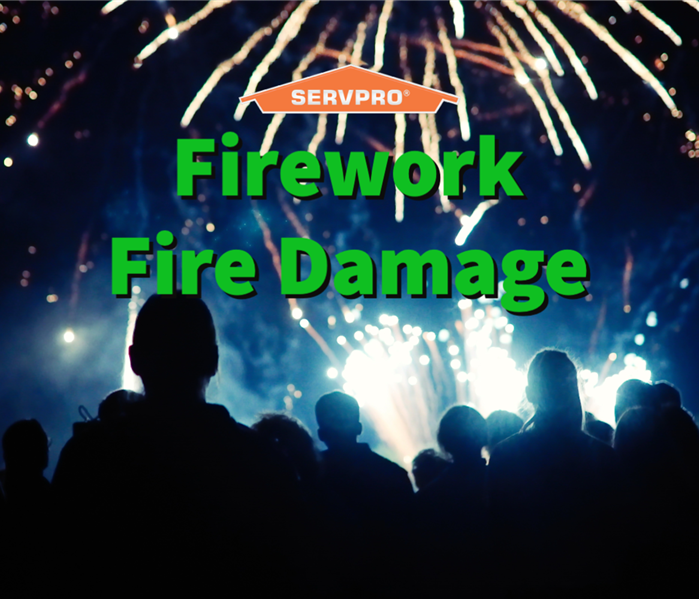 The professionals at SERVPRO are prepared for any size fire disaster!
The professionals at SERVPRO are prepared for any size fire disaster!
The professionals at SERVPRO have seen fireworks cause extensive fire damage.
Fireworks are a staple of celebrations all across America. These colorful explosives from the 4th of July to New Year's Eve provide plenty of excitement and fun. However, as with any type of firework, there is always a risk of fire damage.
The professionals at SERVPRO of Union, Towns, Fannin & Gilmer Counties have seen firsthand the damage that fireworks can cause. In fact, we responded to hundreds of fire damage calls a year, many of which were caused by fireworks.
In this blog post, we will discuss the dangers of fireworks and how to avoid firework fire damage. We are tired of homes and businesses being damaged by firecrackers and other fireworks because these tragic incidents can be preventable. By following the essential firework safe tips mentioned in this blog post, you can help keep your family and property safe from firework fire damage!
The dangers of fireworks
Fireworks can be dangerous if not handled properly. They often contain high levels of explosive material, which can cause extensive fire and smoke damage if they ignite.
It is essential to take the following five safety tips when handling fireworks to avoid fire damage:
- Always read the instructions on the fireworks before igniting them.
- Never try to relight a firework that has failed.
- Keep a bucket of water or sand nearby in case of a fire.
- Never point or throw fireworks at another person.
- Keep children and pets away from fireworks at all times.
When can you set off fireworks in Georgia?
In Georgia, you can set off fireworks any day of the week between 10 a.m. and 11:59 p.m. However, your local government can restrict these times with a general noise ordinance. If you are setting off fireworks on public property, you will need to get a permit from your local fire department.
You should also check with your homeowner's insurance policy to see if it covers fire damage caused by fireworks. Many policies have exclusions for fire damage caused by fireworks, so checking before setting them off is essential.
What should you do if a firework starts a fire?
If a firework does cause a fire, it is essential to call 911 immediately and evacuate the area. Do not try to extinguish yourself, as fireworks are highly flammable.
Once the fire is out, you will need to assess the damage and call a fire restoration company to begin the cleanup process. The right professionals will work quickly to assess the damage and develop a fire restoration plan. They will also work with your insurance company throughout the process to ensure that your property is restored to its pre-fire condition.
How SERVPRO of Union, Towns, Fannin & Gilmer Counties handles fire damage restoration?
When it comes to fire damage, time is of the essence. The sooner you call SERVPRO, the sooner we can get to work restoring your property.
Our fire restoration process includes the following steps:
Assessment: We will assess your property's fire, smoke, and water damage and develop an action plan.
Board-up and tarping service: We will tarp your roof and board up any windows or doors that have obtained damage. Board-up and traping services help prevent further damage to your property.
Water removal and drying: We will remove any water that has been left behind by the fire hoses and dry out your property.
Smoke and soot cleanup: We will clean any soot or smoke damage from your walls, ceilings, and floors.
Odor removal: We will identify and remove any lingering odors caused by the fire.
Reconstruction: We will repair any structural damage caused by the fire.
Need help recovering from firework fire damage?
You don't need to handle firework fire damage alone. SERVPRO of Union, Towns, Fannin & Gilmer Counties is here to help. We are a team of IICRC-certified fire restoration professionals dedicated to restoring your property.
We understand that fire damage can be overwhelming, but we will work with you to ensure that your property is restored as quickly and efficiently as possible.
Contact us today to get started on your fire restoration project. We are available 24/7 to take your call, and we will respond as soon as possible.
The Top 5 Common Reasons For An Air Conditioner Leak
5/27/2022 (Permalink)
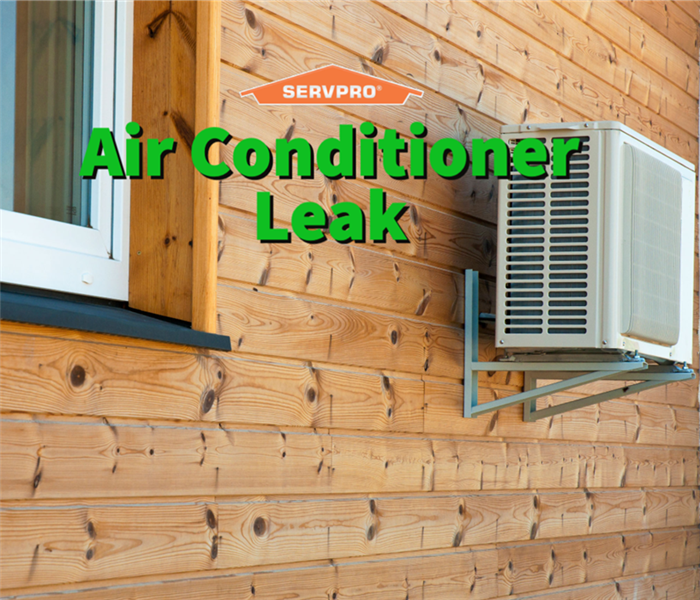 Contact the professionals at SERVPRO for any size water restoration project!
Contact the professionals at SERVPRO for any size water restoration project!
When an air conditioner is leaking, it's crucial to find out the cause and take corrective action as soon as possible.
Summer is right around the corner, which means that it's air conditioner season! Air conditioners are a lifesaver during the summer months, but they can also be a pain when they start to leak.
The professionals at SERVPRO of Union, Towns, Fannin & Gilmer Counties receive numerous calls each summer from customers whose air conditioners have caused water damage.
Puddles near your air conditioner are the most common indication that you have a leak. This blog post will discuss the top 5 most common reasons why an air conditioner leak occurs and how SERVPRO can help!
If your air conditioner is leaking, don't panic. We're here to help.
Indications of an air conditioner leak
An air conditioner unit that leaks water can cause a lot of damage to your home, so it's essential to take action as soon as you notice a leak. Some common indications that your air conditioner is leaking include:
- Water stains on the ceiling or walls near the air conditioner unit
- A musty smell near the air conditioner unit
- A puddle of water around the air conditioner unit
- Ice or frost on the air conditioner unit
If you notice any of these signs, it's essential to take action immediately. The longer you wait, the more damage your air conditioner will cause.
Top 5 common reasons for an air conditioner leak
Now that you are familiar with the signs of an air conditioner leak let's look at the top 5 most common reasons for air conditioners to start leaking.
1. A clogged drainage pipe
One of the most common reasons for an air conditioner leak is a clogged drainage pipe. An air conditioner unit produces a lot of condensation, which needs draining. If the drainage pipe becomes clogged, the water has nowhere to go and will start to leak out of the air conditioner unit.
2. A broken seal
Another common reason for air conditioner leaks is a broken seal. The air conditioner unit has a seal that prevents air and water from leaking out. If the seal is broken, air and water will leak out of the air conditioner unit.
3. A loose drain pan
The air conditioner unit has a drain pan that collects the condensation produced by the air conditioner. If the drain pan is loose, it can cause the air conditioner to leak.
4. A broken air handler
The air conditioner unit has an air handler that circulates air around the unit. If the air handler is broken, it can cause the air conditioner to leak.
5. A frozen coil
The air conditioner unit has a coil that helps to cool the air. If the coil becomes frozen, it can cause the air conditioner to leak.
How to prevent air conditioner leaks
Now that you know the top 5 most common reasons for air conditioner leaks let's look at some tips to prevent air conditioners from leaking.
Tip 1: Schedule regular maintenance
One of the best ways to prevent air conditioner leaks is to schedule regular maintenance. A professional can clean the air conditioner unit and check for any potential problems helping keep your air conditioner unit in good working condition and preventing leaks.
Tip 2: Replace the air filter
Another way to prevent air conditioner leaks is to replace the air filter. The air filter helps remove dust and dirt from the air, clogging the air conditioner unit.
Tip 3: Clean the air conditioner unit
You should also clean the air conditioner unit regularly to remove any dirt and debris that could clog the air conditioner unit.
Tip 4: Regularly check for leaks
You should also check for air conditioner leaks regularly. If you find any leaks, you should repair them immediately. Ignoring air conditioner leaks can lead to severe problems, such as water damage to your home.
What to do if your air conditioner causes water damage
Many air conditioner leaks can cause water damage to your home. If you find that your air conditioner has caused water damage, you should call a professional to restore the damage.
Ignoring air conditioner leaks can lead to severe problems, such as mold and mildew growth. In addition, mold and mildew can cause structural damage, so it is essential to repair air conditioner leaks immediately.
How SERVPRO of Union, Towns, Fannin & Gilmer Counties can help
When it comes to air conditioner leaks, prevention is vital. But if you do find yourself with a leaky air conditioner that causes water damage, SERVPRO of Union, Towns, Fannin & Gilmer Counties is here to help. We are a 24/7 emergency service company that specializes in water damage restoration. Our team of IICRC-certified technicians has the knowledge and experience to restore your home or business back to its preloss condition.
We understand the importance of timely mitigation and will work quickly to prevent further damage. We use state-of-the-art equipment and techniques to thoroughly remove the water and dry your property. We also disinfect and deodorize to help prevent mold and mildew growth.
Contact SERVPRO of Union, Towns, Fannin & Gilmer Counties today if you have questions about air conditioner leaks or water damage. We are always here to help!
Hotel Mold: 5 Amazing Prevention Tips
5/20/2022 (Permalink)
 Contact the professionals at SERVPRO for any size mold remediation project!
Contact the professionals at SERVPRO for any size mold remediation project!
Mold spores are not good to find in any environment, but they can be especially problematic in a hotel.
The professionals at SERVPRO of Union, Towns, Fannin & Gilmer Counties know that mold spores can be found almost anywhere and are not generally a good thing to find in any indoor environment.
One of the worst places to find mold is in a hotel because the rooms are often close to one another, and mold spores can spread quickly from room to room.
We put the following blog post together to help hotel owners prevent the spread of mold in their hotels. Your hotel guests rely on the establishment to provide a clean and healthy place to stay, and cleanliness will be compromised when mold is present.
If you're concerned about mold in your hotel, read this blog post until the end to find out the familiar places mold hides and what you can do about it.
What is mold?
Mold is a type of fungus that thrives in moist environments and can grow on virtually any surface. However, mold thrives in damp, dark places like bathrooms, kitchens, and basements.
While mold is necessary for the breakdown of organic matter, it can cause serious problems when it starts to grow indoors.
The places to look for mold in a hotel room
When it comes to spotting hotel mold, you should look at a few key places. The following are some of the most common areas where mold can grow in a hotel room:
- Behind the headboard: Mold often grows behind the headboard of a bed, as this is a dark and moist place.
- Inside the air conditioning unit: The air conditioning unit is another common place for mold to grow, as it is often damp and humid.
- In the bathroom: The bathroom is a prime spot for mold growth, as it is typically moist and humid. Be sure to check around the toilet, shower, and sink for any signs of mold.
Tips to prevent hotel mold
Now that you know where to look for mold in a hotel room, here are a few tips on how to prevent it:
- Keep the rooms clean: One of the best ways to prevent mold is to keep the rooms clean. Be sure to dust and vacuum regularly, and wipe down surfaces with a disinfectant.
- Use the air conditioning unit: The air conditioning unit can help to keep the room dry and prevent mold growth.
- Install a dehumidifier: A dehumidifier can help to keep the room dry and prevent mold growth.
- Open the windows: Opening the windows will allow fresh air to circulate and will help to keep the room dry.
- Clean up water damage: Any water damage should be cleaned up immediately to prevent mold from growing.
What to do if you find hotel mold
It is essential to take action immediately if you find mold in your hotel establishment. The following are some steps you should take if you find mold in one of your hotel rooms:
Identify the source of the problem: The first step is to identify the source of the problem. Identifying the source will help you to prevent the mold from returning.
Contain the mold: Once you have found mold in a hotel room, your should prioritize containing the spores. Containment will prevent spores from spreading to other areas of the hotel.
Remove the mold: The next step is to remove the mold. Hiring a professional remediation company is the best course of action.
Prevent the mold from returning: It is essential to fix the source of the problem to prevent the mold from returning. Fixing the source may involve fixing leaks, increasing ventilation, or installing a dehumidifier.
How SERVPRO of Union, Towns, Fannin & Gilmer Counties can help
We hope you enjoyed learning about how to spot and prevent hotel mold. However, if you do find mold in your hotel, it is vital to call a professional mold remediation company to help remove it.
At SERVPRO of Union, Towns, Fannin & Gilmer Counties, we are experts in commercial mold remediation. We have the training and experience necessary to safely and effectively remove mold from your hotel.
When you choose to contact us for a hotel mold issue, we will:
- Identify the source of the problem.
- Contain the mold
- Remove the mold
- Prevent the mold from returning
Our professionals are available 24/7 and understand the importance of addressing mold problems promptly. Our goal is to restore your hotel to its pre-mold condition, "Like it never even happened."
Apartment Water Damage: 5 Ways to Prevent Water Damage in Your Apartment
5/6/2022 (Permalink)
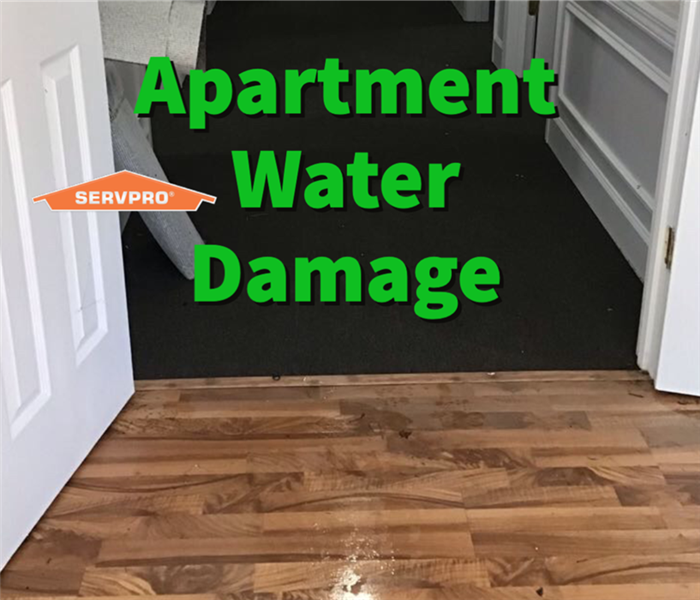 Quickly restoring apartment water damage is essential for you and your neighbors.
Quickly restoring apartment water damage is essential for you and your neighbors.
Water damage is a massive problem for many apartment complexes, and in some cases, evacuation is necessary until the problem is fixed.
Like most people, you probably don't think about water damage until it's too late. And unfortunately, one small leak can quickly turn into a significant problem. The professionals at SERVPRO have seen an apartment with a tiny leak lead to severe consequences for surrounding apartments.
If you're ever faced with water damage in your apartment, it's essential to take action right away to prevent any further damage to you and your neighbors' apartment.
The professionals at SERVPRO of Union, Towns, Fannin & Gilmer Counties put this article together to help prevent apartment water damage. We will include five ways to prevent water damage in your apartment to keep your home and belongings safe from water damage.
What is apartment water damage?
Apartment water damage is any water damage that occurs in an apartment. The common causes of apartment water damage include:
- A broken pipe
- A leaky roof
- Leaking windows
- A flooding toilet
What are the consequences of apartment water damage?
The consequences of apartment water damage can be severe. In some cases, the entire building may have to be evacuated until the problem is fixed. Some of the most common consequences of apartment water damage include:
- Mold growth
- Structural damage
- Electrical damage
Five ways to prevent apartment water damage
There are several steps you can take to prevent apartment water damage. Some of the most critical prevention tips include:
1. Check for leaks regularly
One of the best ways to prevent water damage in your apartment is to check for leaks regularly. Even a small leak can quickly become a big problem, so it's essential to catch them early. In addition, you should check all the plumbing fixtures in your apartment, including the sink, toilet, shower, and tub.
2. Repair any leaks immediately
If you find a leak in your apartment, it's essential to repair it immediately. Ignoring a small leak can often turn it into a big problem. So if you see any water damage, be sure to call a professional to fix the problem right away.
3. Check your roof and windows regularly
Another critical step in preventing water damage is regularly checking the roof and windows of your apartment. If you see any signs of leakage, be sure to call a professional to address the issue as soon as possible.
4. Install a leak detector
Installing a leak detector can also help prevent water damage in your apartment. These devices use sensors to detect any leaks or moisture in your home and then send you an alert so that you can take action right away.
5. Upgrade outdated appliances and fixtures
If your apartment has any outdated appliances or fixtures, it's essential to add upgraded appliances as soon as possible. These items are more likely to break and cause water damage, so replacing them with newer, more reliable models is essential.
Taking these steps can help prevent water damage in your apartment. However, if you face water damage, call a professional commercial water restoration company right away to prevent further damage.
You can count on SERVPRO.
We hope this article has helped provide ways to prevent apartment water damage. At SERVPRO of Union, Towns, Fannin & Gilmer Counties, we understand just how severe apartment water damage can be, and we're here to help you get your property back to normal as quickly as possible. So if you ever find yourself facing water damage in your apartment, don't hesitate to give us a call.
When you contact us, you will be receiving a team of IICRC certified restoration technicians who will handle your water damage emergency from start to finish. We know our way around insurance repairs, and we're here to make sure that your apartment is safe and sound. So if you need help with water damage in your apartment, don't hesitate to reach out to SERVPRO of Union, Towns, Fannin & Gilmer Counties today.
Kitchen Fires: The 3 Most Common Causes
4/22/2022 (Permalink)
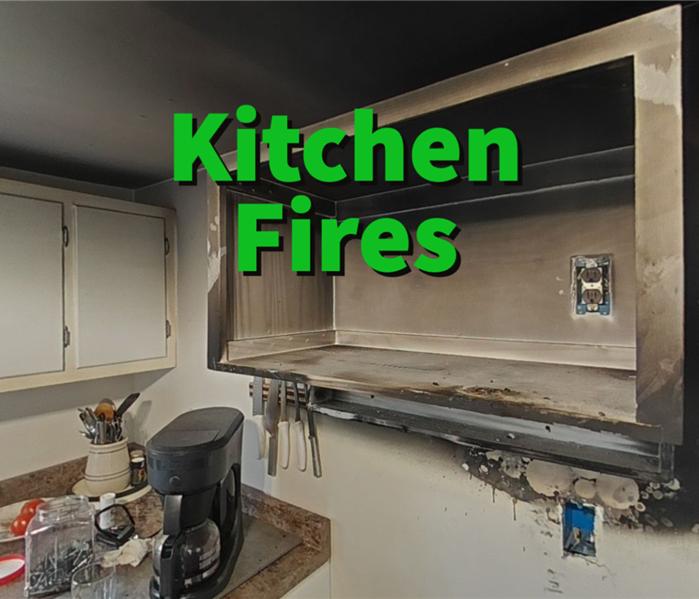 Contact the professionals at SERVPRO for fast responding fire restoration services!
Contact the professionals at SERVPRO for fast responding fire restoration services!
A kitchen fire can cause severe fire damage.
Kitchen fires can cause significant damage to your home. In the worst-case scenario, a kitchen fire can lead to a total loss of property. Some of the most common damages caused by kitchen fires include:
- Smoke damage
- Water damage from putting out the fire
- Damage to the kitchen cabinets, appliances, and countertops
- Soot damage
- Odor damage
The professionals at SERVPRO of Union, Towns, Fannin & Gilmer Counties receive multiple calls a year regarding kitchen fire damage. Out of all the fire calls we have received, there has been one thing to stay consistent; not one fire damage job is like another.
The following blog post will cover the three most common causes of kitchen fires. By the end of this post, you will know how to help prevent kitchen fires from happening in your home and who to call if they do.
The three causes of kitchen fires
When it comes to kitchen fires, there have been three leading causes that we have seen:
1) Leaving a pot or pan unattended on the stovetop
2) forgetting to turn off the oven
3) grease/oil build-up.
Now that we know the three most common causes of kitchen fires, let’s go into more detail about preventing a kitchen fire from occurring in your home.
How to prevent kitchen fires
The best way to deal with fire damage is to prevent it from happening in the first place. Here are some tips on how to help prevent kitchen fires:
1) Never leave a pot or pan unattended on the stovetop. If you have to leave the kitchen for any reason, turn off the stove.
2) Always double-check the oven before leaving the house or going to bed. Make sure that it is turned off and cooled down.
3) Keep your stovetop and oven clean. A build-up of grease and oil can quickly turn into a fire. Wipe up any spills as soon as they happen, and clean your stovetop and oven on a regular basis.
4) Don’t overload electrical outlets. If you need to use multiple appliances at the same time, use a power strip with built-in circuit protection.
5) Keep flammable items away from the stove. Everyday flammable items include things like paper towels, wooden utensils, and curtains.
6) Keep a fire extinguisher in the kitchen. Make sure that everyone living in the house knows how to use a fire extinguisher properly.
Who to call if you have kitchen fire damage
As you have already learned, kitchen fires can leave significant damage in their wake. So if you find yourself in this situation, the first thing you should do is call to call a team of fire restoration professionals.
When searching for the right team, you need to ensure that they have experience with kitchen fire damage and have the proper training from the IICRC. You will also want to ensure that they are a reputable business by checking out their reviews online.
Wrapping up
We hope you enjoyed learning about the three most common causes of kitchen fire damage. By following the tips in this post, you can help prevent a kitchen fire from happening in your home. In the event that a fire does occur, make sure to call SERVPRO of Union, Towns, Fannin & Gilmer Counties for all of your fire damage restoration needs!
The team at SERVPRO of Union, Towns, Fannin & Gilmer Counties has the experience and training from the IICRC needed to handle any size of kitchen fire damage. We are a locally owned and operated business with over 25 years of experience in the fire restoration industry. We have an A+ rating with the Better Business Bureau and will work quickly and efficiently to get your kitchen back to its original state.
If you need help with kitchen fire damage, contact us. We are available 24 hours a day, seven days a week, and will respond quickly to any size disaster.
5 Tips for Finding a Quality Contractor for Restoration Repairs
4/1/2022 (Permalink)
 SERVPRO provides quality work for any size project!
SERVPRO provides quality work for any size project!
It's not always easy finding a quality contractor when you need restoration repairs done on your home.
The devastation caused by a natural disaster can be heartbreaking. Not only do you have to deal with the emotional stress, but you also have to deal with the physical damage to your property. So when it comes time to start repairing your home, it is essential to find a quality contractor who will do the job right.
The good news is that you can do a few things to make the process easier and increase your chances of finding a company you can trust. This blog post will outline five tips for finding a quality contractor for restoration repairs. Keep these tips in mind during your search, and you should be able to find a company that meets your needs!
The importance of hiring a quality contractor
When it comes time to repair your home after a natural disaster, it is essential to hire a quality contractor. A quality contractor will do the job right and ensure that your home is properly restored.
There are a number of reasons why you should only hire a quality contractor. First of all, quality contractors are licensed and insured, meaning they have the proper training and insurance to do the job. They will also be up-to-date on all the latest OSHA safety regulations.
Second, quality contractors stand by their work. If there are any problems with the work done, quality contractors will be happy to fix them.
Third, quality contractors are professional and courteous. They will work with you to ensure the job is done on time and within budget. They will also clean up after themselves and leave your home in better condition than when they found it.
Finally, quality contractors are experienced. They have the knowledge and expertise to get the job done right the first time. You can trust them to do a good job, and they will always put your needs first. When it comes time to repair your home after a natural disaster, be sure to hire a quality contractor!
Tips for finding a quality contractor
Here are five tips for finding a quality contractor for restoration repairs:
1) Ask friends and family for recommendations. Recommendations from friends and family are always a good place to start.
2) Check online review websites like Yelp or Google Reviews. Reviews from past clients and any rating systems provided by the company should give you some idea about how good they might be.
3) Get insurance estimates from multiple contractors. Obtaining various insurance estimates will help you compare prices and quality of work. Keep in mind that not all contractors understand the insurance process, so be sure to ask them questions.
4) Request references from past clients. References are a great way to find out more about the contractor's past work.
5) Make sure the contractor is licensed and insured. You will want to hire a licensed and insured contractor to protect yourself from accidental damages.
When it comes time to find a quality contractor for restoration repairs, keep these tips in mind! With a little bit of research, you should be able to find the perfect company that meets your needs.
The #1 best quality contractor
There is no better company than SERVPRO of Union, Towns, Fannin & Gilmer Counties for restoration repairs. SERVPRO is a licensed and insured restoration contractor that stands behind its work. All crew members pride themselves on being professional and courteous and will work with you to ensure the job is done on time and within budget. Lastly, they are experienced, and we have the insurance repair knowledge and expertise to get the job done right the first time.
Wrapping up
We hope you found this blog post helpful in finding a quality contractor. Finding a quality contractor may be difficult, but it should be a little easier with the five tips we have provided. If you have any questions or want more information, please do not hesitate to contact us.
If you are looking for a fast responding quality contractor for restoration repairs, look no further than SERVPRO of Union, Towns, Fannin & Gilmer Counties! Our reviews speak for themselves, and we are licensed and insured. Not only do we stand behind our work and will do everything possible to make sure the job is done right the first time, but we are also an IICRC certified firm.
Contact us today for 24/7 emergency services!
Warehouse Mold: How 1 Mold Spore Caused A Severe Profit Loss
3/18/2022 (Permalink)
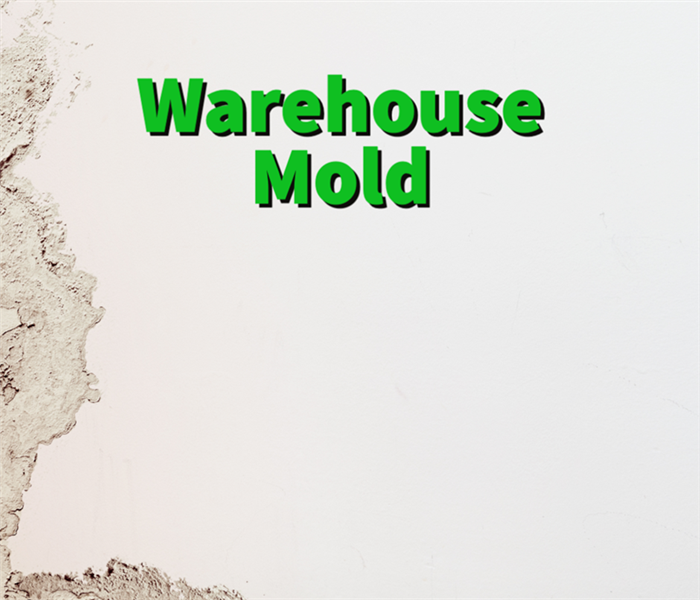 Contact the professionals at SERVPRO for top-of-the-line mold remediation services!
Contact the professionals at SERVPRO for top-of-the-line mold remediation services!
Keeping mold out of your warehouse storage area is essential to keep inventory safe.
A warehouse is a great place to store excess inventory, except when there is a mold issue in the warehouse. Mold can grow anywhere with moisture and a food source.
The professionals at SERVPRO have seen mold damage cause severe losses for a business. This article will explore the story of a business that faced significant financial damages after a minor mold issue developed in its warehouse. Unfortunately, the company was forced to close soon after finding the damages due to dramatic inventory loss. Fortunately, the company knew to contact a professional remediation company like SERVPRO of Union, Towns, Fannin & Gilmer Counties as soon as they noticed the mold issue.
We could not save their business but were able to completely remediate the warehouse mold damages. Here at SERVPRO, we offer comprehensive services that will quickly get your warehouse back to normal!
What is mold?
Mold is a type of fungi found both indoors and outdoors. There are many different types of mold, but the most common type found in warehouses is black mold. Black mold is a greenish-black color and can be fuzzy or slimy to the touch.
What can lead to mold growth in a warehouse?
There are a few things that need to be present for mold to grow:
- A food source: This can be from cellulose (wood, paper, cardboard) to protein (human or pet hair, skin flakes, meat).
- Moisture: Mold needs moisture to grow. Sources of moisture can come from a leak in the roof or walls, high humidity levels, or condensation.
- Warmth: Mold loves warmth and can grow in temperatures as low as 60 degrees Fahrenheit.
- Dark spaces: Mold also prefers dark spaces to grow.
If any of these conditions are present in your warehouse, you could be at risk for mold growth.
A recent warehouse mold damage call.
Mold can significantly affect businesses, especially if it goes undetected for an extended period. For example, recently, we received a call from a produce supply warehouse. They were calling because their warehouse had a small mold issue in one of its storage areas. The mold was visibly growing on the insulation in the ceiling.
The company had recently moved into this building and didn't realize a preexisting flat roof leak that was causing the high humidity levels. The high humidity and the warmth from the light fixtures created the perfect environment for mold to grow.
Unfortunately, after further inspection, we found that the mold had been growing for some time and had spread in more areas than the customer thought. As a result, there was significant damage to their stored inventory and the insulation in the ceiling. We didn't know right away but later found out that the supply warehouse had over $100,000 worth of mold-damaged inventory.
How can mold damage warehouse inventory?
Mold can damage inventory in a few ways:
Direct physical damage: Mold can cause physical damage to goods by eating away at the material it is growing on.
Contamination: Mold can cause goods to become contaminated. The damaged item is unsuitable for use and must be disposed of.
Odor: Mold releases an unpleasant odor that can contaminate nearby goods.
Awareness and prevention are key.
The best way to avoid mold damage is to be aware of the conditions that can lead to mold growth and take steps to prevent it.
Here are a few things you can do to prevent mold growth in your warehouse:
- Inspect the building for water leaks and repair them immediately.
- Keep the humidity levels low by using a dehumidifier or opening windows when weather permits.
- Inspect stored goods regularly for signs of mold damage.
- Keep storage areas well ventilated and free of clutter.
- If you find mold growing in your warehouse, take immediate action to remediate the problem.
SERVPRO of Union, Towns, Fannin & Gilmer Counties is here to help
If you've been in business for any time, you know that unexpected things can happen. And when it comes to warehouse mold, one small issue can cause severe losses for your company. That's why it's essential to have a reliable and experienced team like SERVPRO of Union, Towns, Fannin & Gilmer Counties on standby to help remediate any warehouse mold issues. We have the knowledge and resources necessary to handle any size mold problem quickly and efficiently.
Contact us today for more information!
Wet Insulation: The 2 Best Times to Replace Over Dry
3/4/2022 (Permalink)
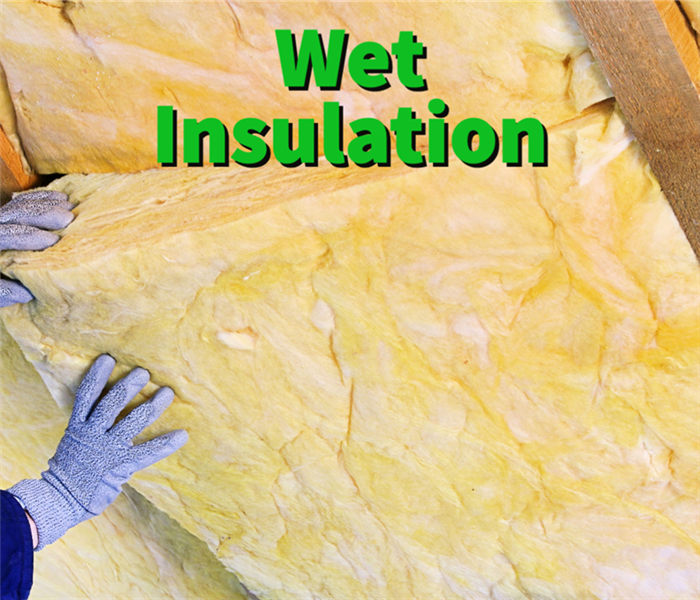 Contact the professionals at SERVPRO for any size water damage disaster!
Contact the professionals at SERVPRO for any size water damage disaster!
Wet insulation can be a severe problem, especially if you don't know when to replace it and instead dry it out.
Many times that a property has water damage, you will notice water stains on the ceilings, walls, and floors. Other times you may not have any external evidence of water damage, but you will notice a musty smell in certain areas of your home.
One effect of water damage is wet insulation. Wet insulation can lead to serious mold growth, decreased energy efficiency, and structural damage. This blog post will discuss the dangers of wet insulation and the best time to replace the damaged insulation rather than dry it out.
What is insulation?
Insulation is a material installed in buildings to reduce heat loss and prevent the formation of condensation on cold surfaces. There are several different types of insulation, but all insulation has two main components: a thermal barrier and a moisture barrier.
The thermal barrier prevents heat loss, while the moisture barrier prevents water vapor from passing through the insulation. However, when water vapor passes through the insulation, it can cause the insulation to become wet, leading to several problems.
What are the dangers of wet insulation?
There are several dangers associated with wet insulation. The most severe is when wet insulation leads to mold growth. Mold damage may lead to structural issues that can cause a building to be less stable.
The two options in handling wet insulation
When a property has wet insulation, there are only two choices: dry or replace the insulation.
Drying the insulation is a less expensive option and is usually the best course of action if the damage is not severe and caught soon enough. Wet insulation can commonly dry out within three to five days with the proper use of dehumidifiers and air movers. Replacing the insulation is a more expensive option but may be necessary.
The two times to replace wet insulation
There are two specific times when it is best to replace wet insulation rather than try to dry it out:
1) When the insulation is saturated with highly contaminated water. Category two and three water damage to insulation are two categories where the insulation needs to be replaced. Category two and three water damage is water that has been contaminated with fecal matter, urine, blood, or contains microorganisms. All items affected by these two categories of water damage need to be replaced to avoid the spread of disease. When choosing a restoration contractor for contaminated water damages, you should select a restoration company that prioritizes safety.
2) When there is mold growth on or around the insulation. In some cases, mold growth will not be visible. To be safe, you should consider getting your insulation tested by a third-party environmental consultant.
If the insulation falls into either of these categories, it is best to replace it rather than dry it out. The risks of drying out the insulation are too high, and the possible benefits do not outweigh the risks. If you are unsure what category of water has damaged your insulation, don't hesitate to contact a water restoration company to inspect the damaged material further.
Why call SERVPRO
You should highly consider contacting the professionals at SERVPRO of Union, Towns, Fannin & Gilmer Counties regarding wet insulation. Our SERVPRO professionals have the knowledge and experience to handle any water damage situation.
Our professionals are trained by the IICRC and have the equipment and resources to dry out your property quickly and safely. We also offer various services that can help you restore your property, including content cleaning, pack-outs, and storage.
If you think you may have water damage, please don't hesitate to contact us. We are available 24/7 to help.
5 Great Tips To Protect Your Home From Winter Storm Damage
2/18/2022 (Permalink)
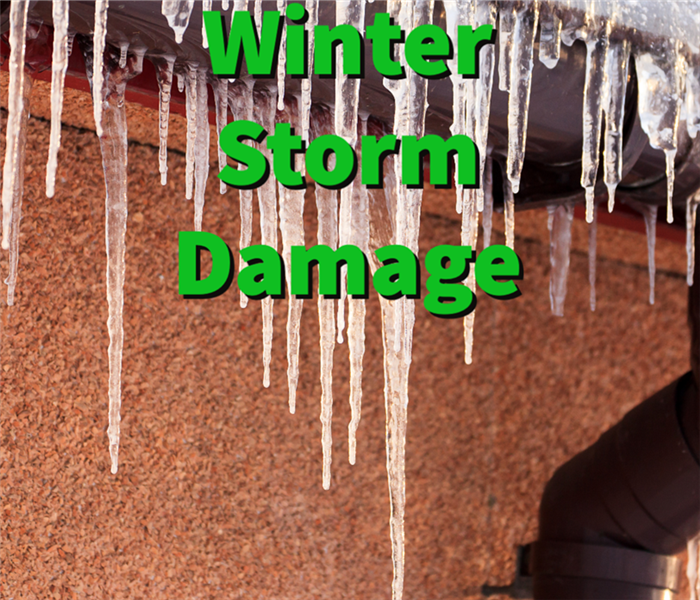 Contact the professionals at SERVPRO for winter storm damage repairs!
Contact the professionals at SERVPRO for winter storm damage repairs!
Winter storms can cause a lot of damage to your home.
Winter storm damage is a known culprit that causes many problems for homeowners. Not only can the weather be hazardous, but it can also lead to costly repairs. To protect your home from winter storm damage, you need to take some preventative steps before the storm hits.
The professionals at SERVPRO of Union, Towns, Fannin & Gilmer Counties know winter storms' impact on residential properties. Winter storm damage is typical in any storm that consists of wind, ice, snow, or sleet.
In the following blog post, we will go over preventative measures you can take before the storm. Then, we will follow up with actionable steps to take when your property does get hit by winter storm damage.
Protecting your home from a winter storm
There are five things you can do before the storm hits that will help protect your home from damage.
- Clear any snow or ice from your roof, as these elements could cause the roof to collapse.
- Clear any dead trees near your house. Dead trees can fall and damage your home during a heavy winter storm.
- Remove ice dams from the gutters. Ice dams occur when water accumulates and freezes on top of the roof and melts and refreezes over time. This process causes ice buildup around the dam at the eaves.
- Trim back any tree branches that are close to your house. Branches can snap during heavy winds and puncture holes in the siding of your home, or damage windows.
- Clean your gutters and downspouts so that water can flow freely away from your house.
Restoring winter storm damage
If your home does get damaged, it's essential to act quickly. The faster you address the damage, the easier it will be to repair.
When your property has winter storm damage, the first step is to contact a reliable restoration company. The team at SERVPRO of Union, Towns, Fannin & Gilmer Counties are experts in dealing with storms and water damage.
After you contact your restoration contractor, you will want to get in contact with your insurance adjuster to let them know about any damage.
The next step will be to determine what caused the winter storm damage. For example, was the damage caused by a fallen tree limb breaking windows or punctured holes in your siding, or water damage caused by a melted ice dam, or maybe the damage was caused by too much snow built up on your roof. No matter what kind of winter storm damage your home suffered from, it is essential to know how the damages happened in the first place for insurance purposes.
Next, it will be essential to document winter storm damage. As a homeowner, you will want to take pictures and videos of the damage to your home and its surrounding area. The documented images and videos will support your insurance claim.
If you follow the above steps, you will be in a great place to get your property restored promptly.
Final thoughts
Winter storm damage can be costly and devastating if not handled quickly and adequately. Taking proper precautions before a storm hits can help protect your home from costly repairs.
When it comes to winter storm damage repairs, you can rely on the professionals at SERVPRO of Union, Towns, Fannin & Gilmer Counties. All of our professionals are IICRC certified, which means you can have confidence that we follow industry best practices to restore your home to its pre-storm condition.
Contact us any time for more information about winter storm damage. All our crews are available 24/7 for storm damage restoration services.
Extension Cord Safety: 8 Tips to Help Avoid Fire Damage
2/11/2022 (Permalink)
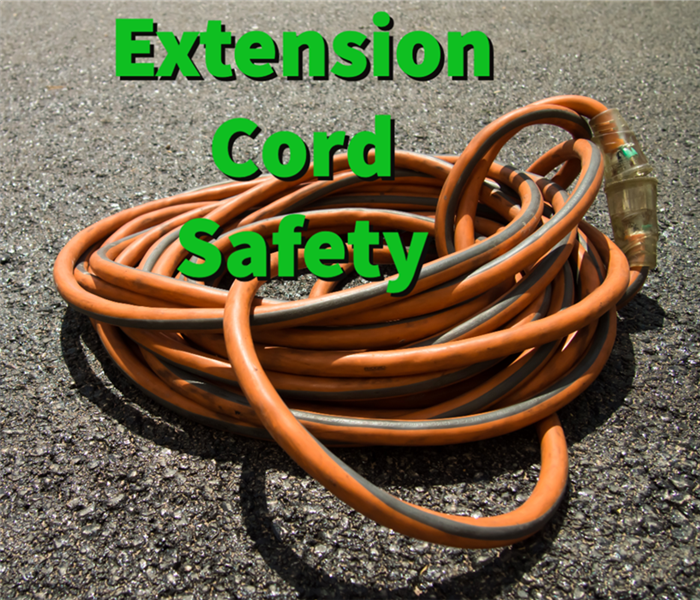 Contact the professionals at SERVPRO for superb fire restoration services!
Contact the professionals at SERVPRO for superb fire restoration services!
One of the best ways to avoid fire damage is knowing extension cord safety.
Fire damage to a property is one of the leading causes of insurance claims in the United States. Typically, short circuits are to blame for these types of fires, and the misuse of extension cords is one of the leading causes of short circuits. A short circuit can occur when an extension cord isn't used correctly or becomes damaged; there is an increased chance of an electrical current not following the intended path.
Each year, extension cords are responsible for starting thousands of fires in the United States. However, there are ways to use these cords safely and minimize the risk of a fire. In the following blog post, we will go over eight extension cord safety tips to help keep you and your family safe from unwanted fire damage!
The dangers of extension cords
The professionals at SERVPRO of Union, Towns, Fannin & Gilmer Counties know first hand that extension cords can be hazardous when not used correctly. Improper use of an extension cord can lead to a fire, which can cause extensive damage to a home and property.
An extension cord is made of tiny wires, each with a specific function. However, when these small wires are broken or crushed, they cannot do their job. If one of these tiny wires breaks, it can increase the resistance in that wire and cause the circuit to overload and eventually cause a fire.
Tips for using an extension cord safely and avoiding fire damage
To increase the lifespan of your extension cords and to avoid fire damage, there are eight things you should do when using them:
- Never remove the grounding pin to make a three-prong plug into a two-prong outlet: By doing this, you are removing one of the safety features of an extension cord.
- Don't overload the circuit: Don't plug too many things into the same extension cord. Using too much wattage in one extension cord can be very dangerous and overload the circuit, increasing the risk of an electrical fire.
- Keep all plugs and connections clean so that no debris can ignite.
- Don't run cords under rugs, carpets, or furniture.
- Periodically inspect the cord for damage, such as cuts or discoloration. If there are cuts or discolorations, replace the cord immediately.
- Unplug the cord when it is not in use, and before wrapping
- Use extension cords outside that are only labeled for outdoor use
- When using more than one extension cord to power an appliance, make sure they have a similar current output rating (do not exceed a cord's amperage rating)
Storing extension cords
When not in use, it is best to unplug your extension cords and store them in a dry place. If you must store them outdoors, make sure they are in a waterproof container. In addition, cords should be loosely coiled when stored and never kinked or tied in a knot.
Final thoughts
Extension cords are supposed to be used for short-term purposes, but some people like to use them permanently. If you choose to use your extension cord as a permanent fix, you must follow all of the safety tips above and inspect the extension cord regularly.
Extension cords are a great tool, but if they are misused or abused, then severe fire damage can occur, and the professionals at SERVPRO of Union, Towns, Fannin & Gilmer Counties have had to clean up quite a few fire damage claims caused by extension cord misuse.
Please contact us today for more information about our fire restoration services or the proper use of extension cords. All of our professionals are IICRC certified and can help with 24/7 emergency fire restoration services.
Moisture Mapping: 3 Reasons To Create A Moisture Map
2/4/2022 (Permalink)
 Contact the professionals at SERVPRO for superb moisture detection services.
Contact the professionals at SERVPRO for superb moisture detection services.
Moisture mapping is a key component in starting a restoration project.
Anytime there is water damage or a mold issue in a property, restoration professionals will start by creating a moisture map to help identify and inspect the source of water and how much damage is present in the property. Restoration efforts can begin once the source and the amount of moisture are identified.
The professionals at SERVPRO of Union, Towns, Fannin & Gilmer Counties also create moisture maps to help them develop a plan of action. The plan that the professionals at SERVPRO create will identify the damages and provide an accurate estimate for how long restoration efforts will take and what is needed to get a property back to normal again.
This blog post will discuss more on moisture mapping and list three reasons why restorations professionals create moisture maps before starting the restoration project.
What is a moisture map?
A moisture map is a diagram or image that shows the location and extent of moisture in a structure. It is created by taking readings with a moisture meter and then plotting these readings on a drawing or map of the structure.
Three reasons to create a moisture map
There are three main reasons why it is essential to create a moisture map:
- It can help identify hidden moisture sources.
- It can help prioritize drying more severely damaged locations.
- It can help document the drying process for insurance purposes.
By creating an elaborate moisture map, certified restoration professionals can ensure that every step is taken to restore your home or business to its preloss condition.
Tools needed for moisture mapping
It is essential to have the right tools when creating a moisture map. Standard tools include a moisture meter and thermal imaging technology to take readings. A drawing or image software to plot the data will also be necessary.
There are many different types of moisture meters on the market, so selecting one suited for the specific application is essential. For example, some meters are designed for reading wet drywall, while others are specialized and are for hard surfaces like concrete.
Accurate measurements are crucial when creating a moisture map because errors in data collection will lead to errors in the final map. For this reason, it is important not to disturb the area being measured so that there is no inaccurate data.
It is also important to ensure that the moisture meter is in good condition and has not been exposed to extreme temperatures or strong sunlight; the exposure to high heat affects a moisture meter's readings.
Once a restoration professional has plotted all of their data points on a moisture map, they may identify sources and patterns that can help prioritize restoration efforts and prevent future issues with the same areas of the structure.
Wrapping up
We hope you enjoyed learning about the importance of getting a moisture map created before starting the water damage restoration process. Creating a moisture map can be challenging because you must use the moisture meter in close contact with the surface being measured, which means getting close to the sources of moisture issues.
Reach out to SERVPRO of Union, Towns, Fannin & Gilmer Counties when you have moisture damage in your property. Our professionals are certified by the Institute of Inspection, Cleaning, and Restoration Certification (IICRC). We are also a preferred restoration vendor among many insurance companies.
If you have any questions about our moisture mapping services, please feel free to contact us at any time! We are happy to serve the residents and business owners in the Blue Ridge Mountains and surrounding areas.
3 Great Reasons to Call SERVPRO After a Grease Fire Occurs
1/21/2022 (Permalink)
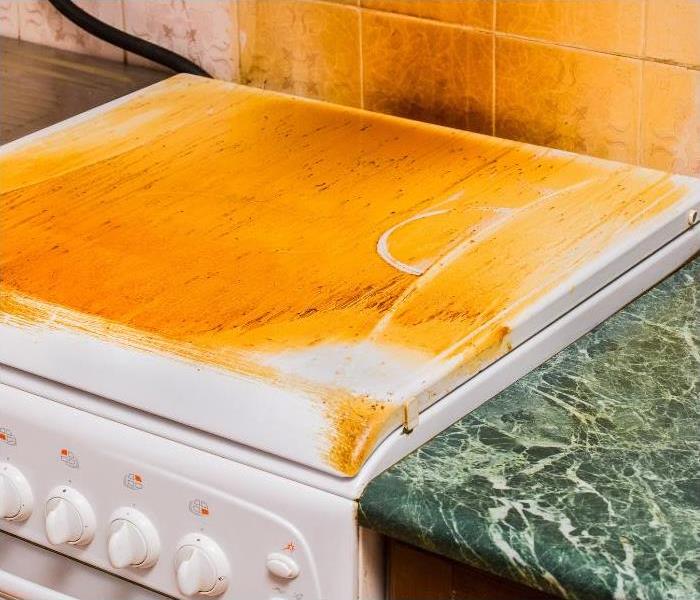 Contact the professionals at SERVPRO for immediate fire restoration services!
Contact the professionals at SERVPRO for immediate fire restoration services!
A grease fire can cause extensive damage to your home.
If your home has ever been damaged in a fire, you know just how devastating it can be. Not only do you have to worry about the damage to your property, but you also have to worry about the safety of your family and the health of your loved ones.
Grease fires are some of the most dangerous when it comes to fire types. They often occur in the kitchen area and quickly spread throughout a property if not extinguished properly.
It is essential to call professional firefighters immediately when experiencing a grease fire in your home. But what happens after the firefighters leave? That's where the professionals at SERVPRO of Union, Towns, Fannin & Gilmer Counties come in. We offer comprehensive grease fire cleaning services that will help get your home and life back to normal quickly and safely.
The following blog post will describe how grease fires start and the three main reasons you should contact SERVPRO for grease fire cleaning services. So without further ado, let's get started!
What is a grease fire?
A grease fire can be extremely dangerous because they're often fed by large quantities of cooking oil or grease that accumulate under stovetops and fryers. When grease catches on fire, it sticks to the walls and floor of your kitchen and any other areas to which it spreads. In addition, these grease stains can leave an oily residue that can damage your property even after extinguishing the flames.
3 Reasons why SERVPRO is the best company for grease fire cleaning services
1) SERVPRO prioritizes safety
When it comes to grease fire cleaning, SERVPRO places a high priority on safety. Grease fires can be hazardous; there might be broken glass and a variety of other safety hazards. The professionals at SERVPRO will take all necessary precautions to ensure that all parties involved in the fire restoration process are safe. They will use the latest equipment and safety gear to protect themselves from the dangers of grease fires, and we always follow proper safety protocols.
2) SERVPRO follows regulations
SERVPRO always follows all local fire cleaning regulations for grease fires. In some cases, not all damaged items are disposable in a normal dumpster. The SERVPRO professionals will ensure your grease fire restoration complies with all disposal laws in your local area.
3) SERVPRO can restore damaged items
The SERVPRO team has the experience and expertise necessary to clean up grease and oil stains quickly and safely without causing additional damage. In addition, they can effectively restore grease-stained items after grease fire cleaning services, which will save you time and effort in the long run.
After a grease fire, SERVPRO can restore upholstery, carpets, walls, cabinets, and other surfaces.
Wrapping up
The professionals at SERVPRO of Union, Towns, Fannin & Gilmer Counties hope that your home never gets damaged by a grease fire, but if it does, you know who to call!
Without professional help, the smell of smoke and soot can linger for months. Therefore, to ensure that your property is adequately restored, you will want to hire professional grease fire cleaning services as soon as possible.
SERVPRO of Union, Towns, Fannin & Gilmer Counties offers a wide range of fire restoration cleaning services that will help get your home back to its original condition. We have years of experience dealing with all types of fire damage, and we know what needs to be done to restore your home safely and quickly.
Contact us today to learn more about our services or emergency fire restoration services!
5 Property Damage Mistakes to Avoid For Homeowners
1/14/2022 (Permalink)
 Contact the restoration professionals at SERVPRO for property damage assistance!
Contact the restoration professionals at SERVPRO for property damage assistance!
Property damage can happen at any time, even to homeowners who make every effort to protect their homes.
Being a homeowner is a rewarding and important responsibility. One of the significant responsibilities of a homeowner is maintaining their property and knowing how to navigate property damage when it occurs.
The professionals at SERVPRO of Union, Towns, Fannin & Gilmer Counties have put together the following blog post to ensure that a homeowner avoids the most common property damage mistakes when navigating a property damage situation.
Not one property damage situation is like the other, but the most common mistakes are consistent. Therefore, you will want to read this post thoroughly to the end, where you will find why you should contact the professionals at SERVPRO to help you navigate your property damage situation.
What is property damage?
Property damage is damage done to a property caused by a natural event or an accident. Property damage often occurs when damages occur to a home's exterior or interior.
Different types of property damages that can occur:
- Water damage: Water damage commonly occurs when a property has a leaky roof or water from a burst pipe. When standing water is in your home, getting the water extracted right away and professionally dried must be a priority.
- Fire damage: Fire damage can occur when a fire has broken out in a home, and the most common area for fire damage is in the kitchen.
- Mold damage: Mold damage can occur when water damage is left untreated for longer than 48 hours. Mold can grow rapidly and create severe structural damages. It is essential to clean the entire area where there was water damage and then get it tested by a professional company specializing in mold damage.
- Storm damage: When there are strong winds or hail, this can cause major exterior damages such as damaged shingles; or even structural damages.
5 Property Damage Mistakes
- Waiting to file a claim
- Delaying property damage repairs
- Failing to document the damages
- Failure to keep an inventory list
- Throwing out damaged contents
Property damage mistake #1: Waiting to file a claim
One of the most significant property damage mistakes a homeowner can make is not promptly filing a claim with their insurance company. The more time a homeowner waits, the greater possibility the insurer will deny the claim.
When property damage occurs, it will be a good idea to call the insurance company to file a claim at the first sign of damages. All property damage claims go through an extensive process, which will take time. Therefore, the sooner you start the process, the better.
Property damage mistake #2: Delaying property damage repairs
When homeowners delay repairs, they usually do so because they hope that the damage is just a temporary situation or that it will get better with time.
Repairing property damage as soon as possible is the recommended procedure because it will save a homeowner money and time in the long run. Delayed repairs can result in more severe damages, costing much more to repair down the line.
Property damage mistake #3: Failing to document the damages
Documenting the property damage is crucial for insurance purposes. Therefore, it is good practice to record what was damaged.
When documenting damages, you will want to take pictures and videos of the damages. You will also want to keep records of quotes and bills you incur for property damage repairs while your insurance company processes your claim.
Property damage mistake #4: Failure to keep an inventory list
It would be beneficial if the homeowner could keep a list of the items in their home before damages occur. Therefore when property damage occurs, there will be a list that includes the damaged items and their estimated value. Keeping an inventory list has proven to help a homeowner get reimbursed for their damaged items.
The professionals at SERVPRO recommend using XactContents for all inventory needs.
Property damage mistake #5: Throwing out damaged contents
A homeowner may think it is easier to throw away everything damaged or ruined. However, this is not an ideal decision to make.
In some cases, the damaged content may help an insurance adjuster understand what happened to your property. Therefore, it is best to keep all damaged contents to help with the claims process and get reimbursed later on.
Wrapping up
If you avoid these five mistakes, your experience should be much smoother when trying to deal with property damage in your home. One last thing that we must mention is to keep calm and be patient to help you make the best decisions possible for the property damage situation.
When it comes to home property damages, you should trust the team at SERVPRO of Union, Towns, Fannin & Gilmer Counties to help you through the entire process. Our professionals are IICRC certified and have extensive knowledge of property damage restoration.
Please contact us if you have any questions. We are available 24/7 to help with your property damage restoration needs.
Basement Water Damage: 5 Great Recovery Tips
1/7/2022 (Permalink)
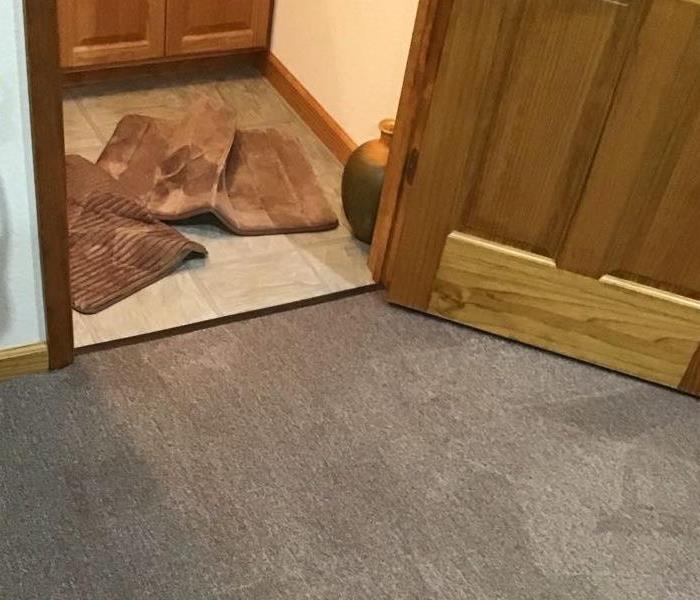 Contact the professionals at SERVPRO for emergency basement water damage repairs!
Contact the professionals at SERVPRO for emergency basement water damage repairs!
Basement water damage can have a devastating effect on your home.
Basement water damage can occur for numerous reasons; some of the most common causes include a sump pump failure, a pipe burst, and flooding.
Depending on the category of water damage present will dictate how the water damage professionals you choose to hire move forward in restoring your basement.
The following blog post will describe what a homeowner should do after their basement floods. We will also be including five tips to help you recover basement water damage. By following the tips below, you will take the proper steps to get your basement back to pre basement water damage condition.
Five basement water damage recovery tips
After your basement floods, you must contact a reliable water restoration company because basement flooding can cause extensive damage that only IICRC certified professionals can properly assess, remediate and restore.
Before the certified water damage professionals arrive, there are five things that you can do to enhance the basement water damage recovery:
1) Prioritize safety
Safety should always be the top priority before entering a basement with water damage. Understandably, you want to go down there and assess the damage but use your common sense. For example, it will not be a good idea to enter through knee-deep water or enter a basement with electrical hazards.
It will be a good idea to wear personal protective clothing if you decide to enter a flooded basement, especially if you do not know the source of the water damage.
2) Shut off the power supply
Before the water damage professionals arrive, you should consider shutting off the power supply to your basement, so electrical hazards do not exist. Water and electricity are not a good mix, and a homeowner needs to prevent electrocution at all costs.
3) Turn off the water source
In some cases, basement water damage will occur after a pipe burst. The professionals at SERVPRO have seen minor damages turn into more severe ones only because a homeowner neglected to turn off the water source.
Therefore, to speed up the water damage recovery process, you should shut off the main supply of water running into your basement. In addition, shutting off the water supply will help lower the degree of basement water damage that has already occurred.
4) Remove all non-affected contents
In some cases, there will be contents that did not come in contact with the water damage. It would be good to gather up all non-affected contents and put them in a dry location in the home to ensure they stay clean, dry, and safe.
5) Document the damages
Finally, for insurance purposes, it will be a good idea to take pictures and videos before the basement water damage recovery begins. The basement flood pictures will help document the damages that occurred.
Your home insurance may cover your basement water damage, but that depends on your insurance policy. Contact your insurance provider to find out if your water damage is covered.
Prevent future basement water damage
The water damage professionals at SERVPRO suggest taking the following preventive measures:
- Ensuring downspouts are directed away from your home.
- Grading around your property to achieve proper drainage is achieved.
- Installing a sump pump.
- Elevating all valuables off the basement floor.
Final Thoughts
When basement water damage occurs, there can be quite a bit of damage that happens quickly if not dealt with immediately. Therefore, it's important to take action quickly after basement water damage occurs. The best way to restore your home is to quickly contact the water damage restoration professionals at SERVPRO.
The professionals at SERVPRO of Union, Towns, Fannin & Gilmer Counties are preferred water restoration vendors that are known in the community for basement water damage services that are second to none.
Our professionals are IICRC certified and know the fastest way to recover from a basement water damage disaster. We will extract all standing water and inspect all furniture and belongings exposed to water. Our goal is to have your property completely dry within five days after the basement water damage occurred.
Please contact us today for basement water damage services.
3 Great Gutter Snow And Ice Buildup Prevention Tips
12/24/2021 (Permalink)
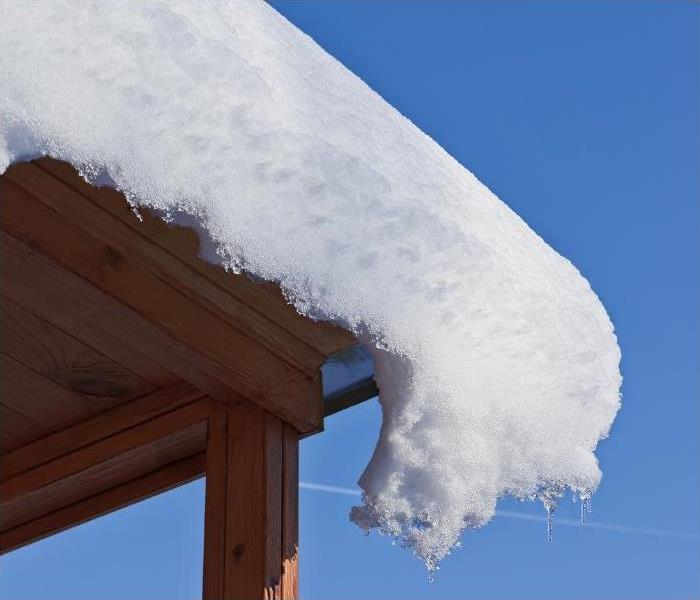 Contact the professionals at SERVPRO for emergency winter storm repairs!
Contact the professionals at SERVPRO for emergency winter storm repairs!
Is your gutter system equipped for the winter weather?
Winter has arrived, and many property owners will be looking to prepare for winter weather, including preventing snow and ice buildup in gutters.
The professionals at SERVPRO of Union, Towns, Fannin & Gilmer Counties have seen severe damage from snow and ice buildup. Snow and ice buildup might not seem like a huge issue, but it will be when water begins to enter the property.
We've put together the following blog post to keep ice and gutter debris from accumulating this winter. By the end of the post, you will have learned three tips to prevent snow and ice buildup and how the professionals at SERVPRO can help if your gutters become damaged from a winter storm.
Winter gutter inspection
Property owners must have their gutters inspected every few weeks to ensure no debris is built-up during the winter months. When inspecting the gutters, the property owner should look for any signs of gutter system damage that might have occurred, including:
- Gutter system leaks
- Cracks
- Missing pieces
Gutter snow and ice buildup prevention tips
The best way to avoid costly repairs from overflow or damage is by being proactive about keeping your gutters clean before they get clogged with heavy snow, sleet, and ice accumulation. We recommend three tips below on how property owners can protect their gutters from snow and ice buildup this winter season.
Tip #1: Remove debris
Remove leaves and branches from gutters before the first winter weather event. Leaves will stay moist during the winter months and eventually accumulate to form ice.
Fallen tree branches can cause damage to gutters if they settle in the gutter or on top of it. To ensure that tree limbs do not clog the gutters, homeowners should make sure to check and remove them at least once a month.
Extra advice: Consider installing a gutter guard system that will prevent leaves, twigs, and other debris from clogging up the gutters.
Tip #2: Install gutter heat tape
Gutter heat tape can significantly reduce the amount of snow packed in gutter areas. Ice dams will form when too much water is sitting inside a gutter system, leading to water intrusion. Installing gutter heat tape will keep the water inside the gutter system warm and have proper drainage.
Gutter heat tapes are readily available at most home improvement stores, but professionals must install them for maximum performance.
Tip #3: Trim surrounding trees
Trees close to buildings can become heavy with snow and ice, posing a risk to the roof structure, including the gutter system. To avoid this, customers should check the trees around their property and remove any branches directly above the gutter system.
SERVPRO is here to help
We hope you enjoyed learning about the best ways to protect your gutter system from heavy snow and ice buildup this winter using the three tips stated in this blog post.
In addition to the three tips, we want our customers to know that they can contact our professional restoration company at any time if they notice damage to their gutters following a winter weather event. The professionals at SERVPRO of Union, Towns, Fannin & Gilmer Counties are here to help and have the availability to repair and replace a damaged gutter system.
As well, our IICRC trained professionals will be able to assist in the cleanup and restoration process if a winter storm has damaged your home or business.
Please contact us if you have any other questions about preventing snow or ice damage this winter season. We are available 24 hours a day, seven days a week.
Contents Restoration Services: 5 Steps In Contents Cleaning
12/10/2021 (Permalink)
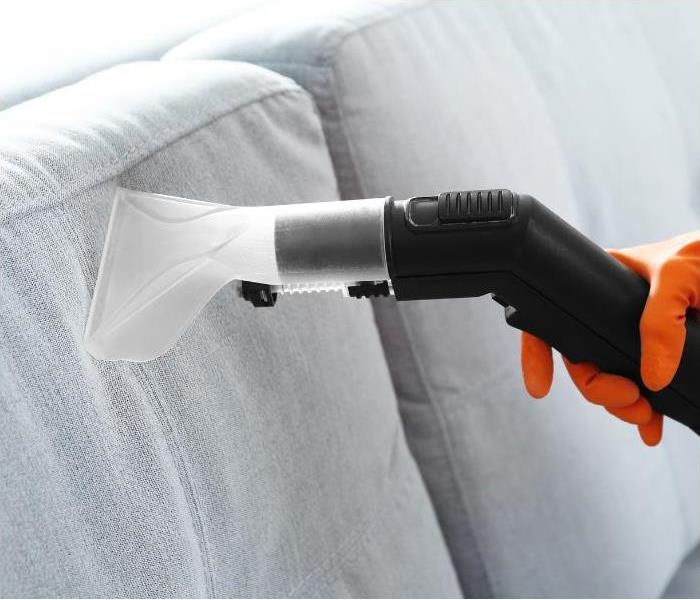 The professionals at SERVPRO are highly trained to clean damaged contents!
The professionals at SERVPRO are highly trained to clean damaged contents!
Content restoration services entail a difficult process, but the end result is worth it.
The professionals at SERVPRO of Union, Towns, Fannin & Gilmer Counties are one call away after your property suffers water or fire damage. Our professionals go through extensive training to go above and beyond while restoring your damaged property. One of the less talked about services we offer is our contents restoration services.
The following blog post will cover the definition of contents restoration and our proprietary contents cleaning process. By the end, you will know what to do if you are in the middle of a fire or water disaster and have damaged contents that need restoring.
What is content restoration?
Content restoration is the process of restoring personal belongings and furnishings after receiving damages from water, fire, or smoke. The goal of contents restoration is to return the contents within the property back to their preloss condition as closely as possible.
The five steps
The following five steps are how the professionals at SERVPRO of Union, Towns, Fannin, & Gilmer Counties execute their contents cleaning process:
- Contents Analysis
- Pack Out
- Contents Cleaning
- Contents Storing
- Pack Back
Step 1: Contents Analysis
The first step in our contents restoration services is to analyze all contents. In this step, our professionals will assess the damage done to your belongings and create a plan of action. This step is vitally important as it determines the severity of the damage and what items are salvageable. We communicate closely with the customer during content analysis, so we know what items to prioritize.
Step 2: Pack Out
The second step in our contents restoration process is to pack the salvageable contents. Contents are strategically packed to limit further damage and for easy accessibility while going through the contents cleaning process. We do this step by having items packed into our professional packing boxes customized just for moving or storing your belongings safely.
Step 3: Contents Cleaning
The contents cleaning process is the most important step in our contents restoration process. Our content cleaning technicians will work hard to remove all soot, dirt, and ash left behind from the fire or water damage. Contents are cleaned using high-powered vacuums and steam cleaners with an enzyme detergent which is non-toxic and safe for most items.
Items we can restore:
- Clothing, linens, shoes
- Curtains, drapes, blinds
- Wooden furniture & jewelry boxes
- Leather items (with cleaning approval)
- Papers and important documents
Step 4: Contents Storing
After the contents are finished going through the cleaning process, they will need to be stored. Our customer's contents are stored in our climate-controlled and secure warehouse. In addition, contents are inventoried and tracked using Xactcontents, so all parties know what is being stored and where.
Step 5: Pack Back
After the property is completely restored, it is time to return the newly restored contents. Contents are put back in the same order and place as when we first arrived on the scene. We take great care in this step to ensure everything is returned to its preloss condition.
Wrapping up
We hope you enjoyed learning about our contents cleaning process. Content restoration services are necessary when personal contents are exposed to water or fire damage.
The experts here at SERVPRO of Union, Towns, Fannin & Gilmer Counties are readily available to help you. Content restoration services take time and patience, but the end result is worth it. Lastly, we offer content restoration services for both residential and commercial properties.
Please contact us today for a content restoration professional to come out to your property. We are available 24/7, 365 days a year, and are more than happy to help you as soon as possible.
5 Great Steps To Take When Experiencing Wet Drywall
11/26/2021 (Permalink)
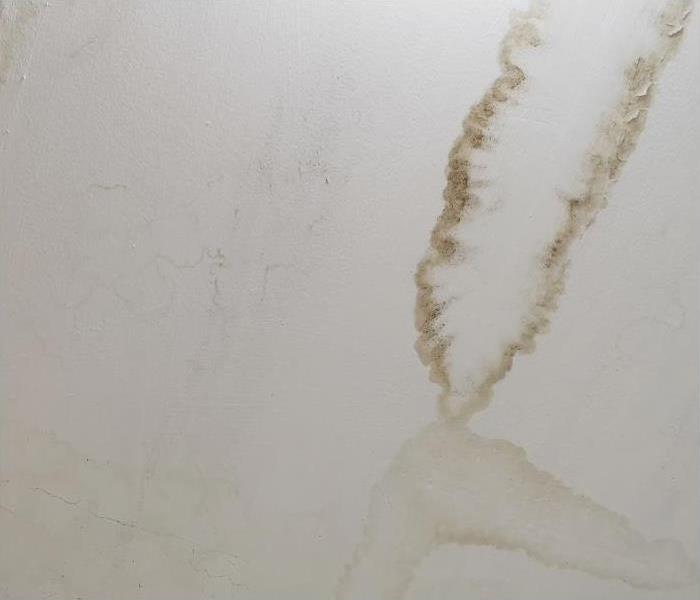 Contact the water damage professionals at SERVPRO for drywall repairs!
Contact the water damage professionals at SERVPRO for drywall repairs!
Wet drywall needs to be handled carefully to prevent further damage.
Water damage is a property owner's worst nightmare because there are only about 48 hours before mold growth begins to form. On top of that, whenever a home or business experiences water damage, you will likely find wet drywall and other structural damages.
Drywall is a wall building material made of gypsum plaster, commonly used on interior walls and ceilings. The term wet drywall describes a scenario where water has entered your walls, and they are absorbing moisture, usually because of a pipe burst or extreme flooding. If you have experienced this type of damage in your home or business, there are some steps that you should take immediately upon discovery.
In the following blog post, we will go through five great steps you should take when your home or business has experienced wet drywall damage. The purpose of this blog post is to help anyone with a small amount of drywall damage; for severe water damage, you should contact the professionals at SERVPRO ASAP.
The five steps to take
1) Assess the damage
The first thing you should do is assess the damage. Check to see if the moisture is only localized or spread out. The more water damage that has occurred, the longer it will take to clean up. Check for wet drywall along baseboards, wall studs, and ceilings.
Be sure to also check for mold or mildew growth on surfaces where moisture has come into contact with them (carpeting, walls). Mold damage will need to be cleaned thoroughly before proceeding with any other tasks.
To help assess the damage, you can find a moisture meter online or at your local hardware store that checks drywall moisture levels.
2) Remove all standing water
The next step is to remove all standing water with a wet vac. It is best to strategically place fans to speed up the drying process and ensure proper ventilation to prevent mold growth. Mold thrives in warm moist environments where the air is stagnant.
3) Remove any wet drywall
Once all the standing water has been removed, you will want to remove any wet drywall. You should use a drywall knife to help speed up the process, but be careful not to damage drywall in good condition.
4) Lower humidity levels
You will want to lower the humidity levels in the area that the water damage occurred because high moisture content can cause mold growth. You can purchase a dehumidifier online or at your local hardware store to accomplish this task.
5) Install new drywall
After completing the first four steps, you can now install new drywall in the areas needed.
Water damage can be hard to deal with, but if you follow these five steps, there is no reason why your home or business will not be back up and running in no time!
What to do when there is extensive water damage?
It is best to call for the professionals at SERVPRO of Union, Towns, Fannin & Gilmer Counties if you are dealing with extensive water damage where there is a lot of wet drywall that needs to be restored. With the help of our IICRC certified SERVPRO technicians, we will be able to bring your property back up to how it was before the damages occurred.
In most cases, water damages will be covered by your property insurance provider, so be sure to refer to your insurance policy for any terms and conditions.
Please contact us today if you are currently in the middle of a water damage disaster and need professional help.
Flood Mitigation Services: 4 Great Ways To Control Flood Damage
11/19/2021 (Permalink)
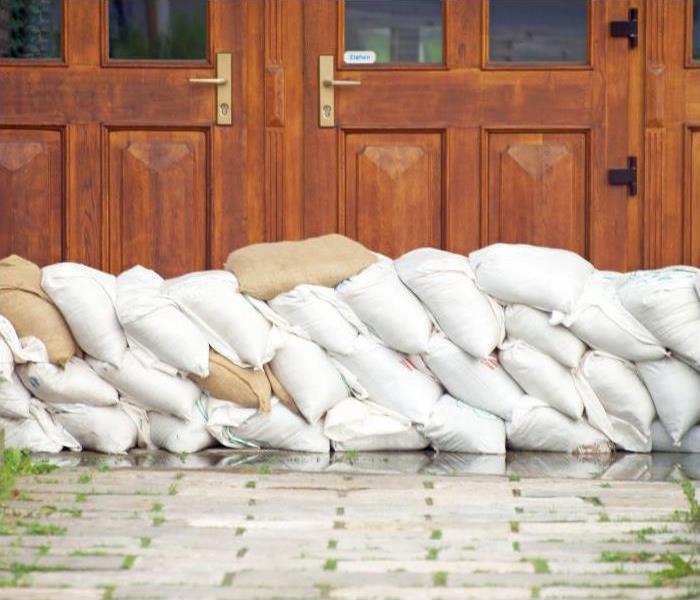 Contact the professionals at SERVPRO for quality flood mitigation services!
Contact the professionals at SERVPRO for quality flood mitigation services!
Being proactive and planning for flood damage is the first step in flood mitigation.
Flood damage can happen to any property owner. It doesn't matter if the property is on a flood plain, near a body of water, or in an area with known high flood potential. The number one way to prevent extensive flood damage to a home or business is to hire professionals for flood mitigation services.
The professionals at SERVPRO have seen flooding cause thousands of dollars in flood damage repairs. The most prone flood-damaged areas in a property are a basement and ground level.
In the following blog post, we'll look at four types of flood mitigation services and further explain why they are necessary for those who want to protect their property.
What is flood mitigation?
Flood mitigation services are the preventive measures that flood damage repair companies take against flood damage before they happen. Flood mitigation is necessary for those who live in areas that experience flooding regularly and want to protect their property. However, no flood mitigation services can guarantee complete flood protection.
How is flood mitigation different from flood restoration?
Flood mitigation is different from flood restoration because flood restoration is removing floodwater after it has already caused damage to a home or business. During flood restoration, an IICRC certified professional will strategically create a drying plan to remove flood water as soon as possible. Once floodwater is removed, and the property is restored, a flood mitigation professional will locate flood-prone areas and protect the home or business from future flood damage.
4 Types of flood mitigation services
There are four main types of flood mitigation services, and they include:
- Sandbagging
- Foundation waterproofing
- Sump pump installation
- Elevating a home or business.
Sandbagging
Sandbagging is the least expensive flood mitigation tactic that involves using sandbags in areas around a property that are prone to flood damage. For example, it is common to see a barricade of sandbags around doors and windows on the ground floor to protect a property from floodwater.
Foundation waterproofing
A flood mitigation professional will use foundation waterproofing tactics to prevent floodwater intrusion into a home or business. Foundation waterproofing is done by adding a waterproof coating to the foundation of a home or business. Foundation waterproofing is recommended for properties that have cracks or holes in their foundation because holes and cracks allow floodwater to seep through easily.
Sump pump installation
Flood mitigation experts will typically recommend floodproofing a property by installing a sump pump, especially when the property is on a floodplain or near a body of water. Sump pump installation helps to divert floodwaters away from a property once water enters.
Elevating the property
The elevation of a home or business is one of the most efficient floodproofing tactics for those who live in flood-prone areas. The whole idea is that rising floodwaters will not flood the home or business because of its elevation status. The elevation of a property will require renovations to lift the property.
SERVPRO flood mitigation services
People call us for flood mitigation services because we are trained to detect any possibility of floodwater intrusion into a property. Our professionals know that flood mitigation is the number one way to prevent flood damage to a home or business.
We hope you enjoyed learning about flood mitigation services and how our professionals can help prevent flood damage before it happens.
When you contact us for flood mitigation services, you can rest easy because you will be in control of any potential flood damage. The team at SERVPRO of Union, Towns, Fannin & Gilmer Counties is available 24/7, 365 days a year for flood mitigation services and flood restoration services.
Roof Storm Damage: 3 Signs You Need Roof Restoration Services
11/12/2021 (Permalink)
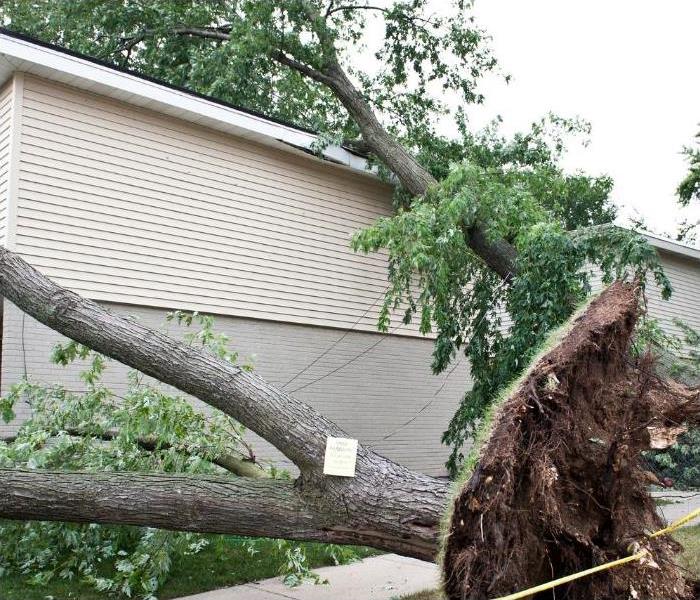 Contact the storm damage professionals for 24/7 emergency services!
Contact the storm damage professionals for 24/7 emergency services!
The professionals at SERVPRO understand the importance of checking for roof storm damage after a severe storm passes.
Roofs serve as the first line of defense against storms, high winds, and other natural disasters. However, some of the most significant storm damage comes from an unseen weakness in a roof's exterior. As a property owner, you want your roof in excellent condition because it plays an essential role in insulation and overall energy efficiency.
In the following blog post, we will be going over three common signs that indicate a roof needs restoration services. You will want to read until the end to find out how the professionals at SERVPRO can help you restore the most catastrophic roof storm damage.
Sign 1: Roof shingles are missing or busted
Missing or busted roof shingles are usually one of the more noticeable damages on roofs after a storm passes. You will notice busted roof shingles often with hail damage but also applies in cases where the roof has been struck by flying debris or even just high winds. Roof shingles are highly durable, but they are also very thin and will be the first thing to show wear.
After a storm passes, it is common to find missing shingles around the property in a garden or backyard pool. Roof shingles should be secure to your roof and should not be found on the ground.
If you notice missing shingles throughout your yard, you need to pinpoint where missing shingles are located and check for other signs of storm damage like water leaks or damaged flashing.
Sign 2: Water damage inside the home
Water damage is not always as easy to spot as other damages on homes, but it can cause significant problems and lead to some expensive damages. A quality roofing system will repel against water and funnel runoff into gutters that take excess water away from the property.
When there is storm damage to the roof, water may seep in through the cracks and gaps between boards, causing the attic insulation to become wet and leading to possible mold growth.
If you notice any signs of water damage in your home, you need to locate the source immediately and prevent further damage from starting. Look for water stains on any level of the house ceilings and feel walls for wet drywall.
Sign 3: Damaged roof flashing
Roof flashing is a thin metal piece on the roof designed to direct water away from certain areas of the home that are vulnerable to water damage. Roof flashing can be located around a chimney, at walls, and roof valleys.
After a storm passes, the roof flashing may be punctured or eroded by water exposure and debris. Roof flashing is installed to keep rainwater flowing away from home, but water can pool and enter the property when there are damages.
SERVPRO roof restoration services
When it comes to storm damage, the professionals at SERVPRO can help mitigate and restore all three of the most common signs of roof storm damage. Roofs are essential parts of a home or business, and when storm damage happens, it is hard to see. SERVPRO has specialized training and will use advanced equipment and techniques to assess your roofing damages and stop further damages from occurring down the road.
If you notice any signs of storm damage on your home, it is essential to contact the professionals at SERVPRO of Union, Towns, Fannin & Gilmer Counties immediately. Roof storm damage can happen to anyone, but the best way to avoid secondary damages will be by calling our team of professionals for roof restoration services.
3 Reasons Why Commercial Fridge May Be Leaking
11/5/2021 (Permalink)
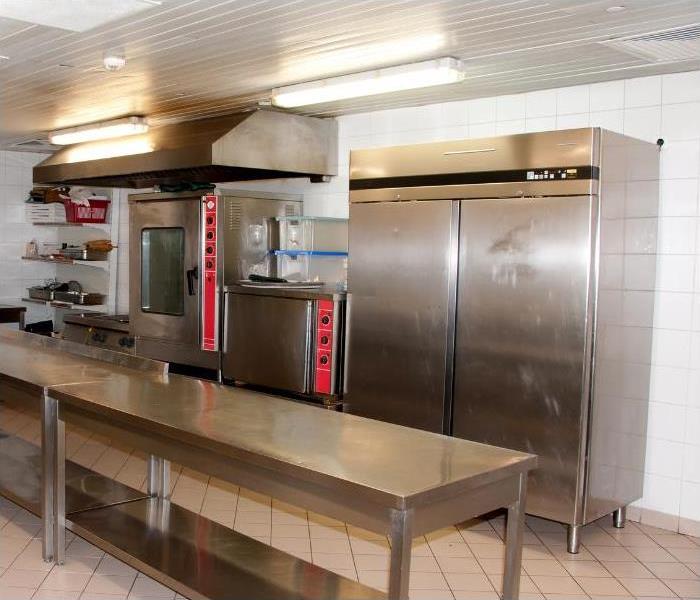 Contact the professionals at SERVPRO from commercial water damage restoration services!
Contact the professionals at SERVPRO from commercial water damage restoration services!
One of the most common causes of water damage in a commercial kitchen is a refrigerator leak.
The professionals at SERVPRO of Union, Towns, Fannin & Gilmer Counties have seen multiple causes of water damage in commercial properties. However, one of the worst kinds of water damages comes from a refrigerator leak because it can go unnoticed for a while. After all, the refrigerator will still be fully functional, but, eventually, a chef or staff member will notice the refrigerator leak when puddles develop or a strange smell appears.
If your refrigerator is leaking, it is essential to know the reason why. In the following blog post, we will go over the three main causes of a refrigerator leak and how you can prevent further issues from arising.
Why does a refrigerator leak need to be quickly attended to?
A refrigerator leak can be a major headache for any commercial property owner, especially if it's not fixed quickly enough. As we mentioned earlier, a refrigerator leak is one of the most common reasons for property damage in a kitchen. When a refrigerator leak is left unattended for too long, a property owner risks major water and mold damage.
The 3 causes for a leaky refrigerator
1) Malfunctioning water line
When the water line to the refrigerator is damaged, you'll quickly know because there will be water pools under your refrigerator on the floor. Also, you will see water dripping from behind the refrigerator.
When you notice water coming from the waterline connectors, you will need to get them replaced ASAP! If the leak continues, it will damage the floor underneath the refrigerator.
It is best to check the refrigerator waterline connector every six months to ensure it is in good condition with no damage. In some cases, the water line is loose and can be easily tightened.
2) Damaged water shut off valve
Unfortunately, the professionals at SERVPRO have seen loose, clogged, or damaged shut-off valves cause water damage. The water shut-off valve is located behind the refrigerator.
It is best to check that the water shut-off valve is in working condition every six months to ensure it is in working condition. If you notice water leaks from the water shut-off valve, you should have it replaced immediately.
3) A dirty drain pan
At the very bottom of a refrigerator is a drain plan. The purpose of the drain pan is to catch any refrigerator condensation or dripping water that falls.
If the refrigerator drain pan is clogged or dirty, water will not collect and cause water damage. It is best to examine the refrigerator drain pan every six months to ensure it is free of dirt and debris.
Wrapping up
We hope you enjoyed learning about the three main causes of refrigerator leaks and the importance of inspecting your refrigerator every six months for damages.
As we mentioned early on, there is likely water damage that needs to be mitigated with a refrigerator leak. The professionals at SERVPRO are not experts in fixing malfunctioning refrigerators, but we can help restore water damage.
Please remember that it is best to fix the problem before it gets out of hand when it comes to commercial water damage. For example, you should unplug the refrigerator and get it fixed ASAP at the first sign of a leak because the refrigerator repair costs will be much less than the water damage repair costs!
Contact the professionals at SERVPRO of Union, Towns, Fannin & Gilmer Counties at the first sign of water damage. Our IICRC trained professionals are ready to help you 24/7 with water damage restoration in your commercial property.
5 Ways To Spot Water Damage Early In Rental Properties
10/29/2021 (Permalink)
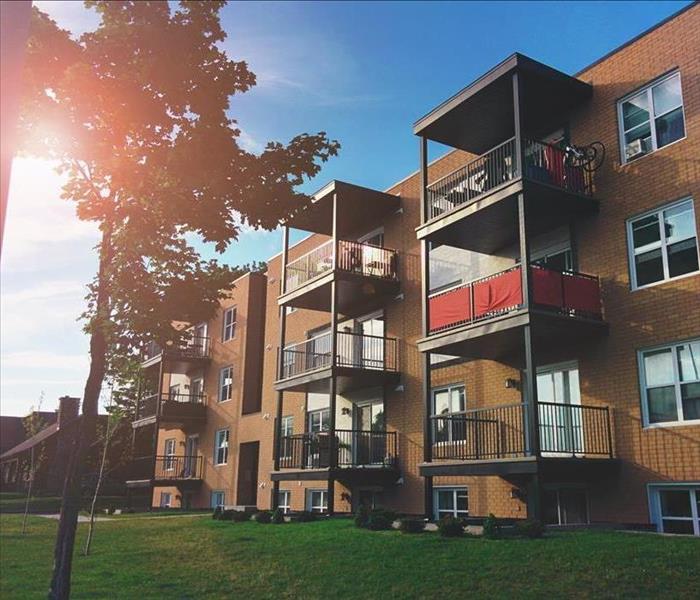 Contact the commercial water damage professionals at SERVPRO when you spot water damage in a rental unit.
Contact the commercial water damage professionals at SERVPRO when you spot water damage in a rental unit.
The best way to prevent severe issues is by being proactive.
Water damage in rental properties is one of the most common property management problems. Whether it's a flooded unit, faulty plumbing, or even severe weather, water damages need to be spotted early on before they impact other properties.
The best property managers know how to spot water damage in rental properties early on to avoid more expensive problems down the line. The professionals at SERVPRO of Union, Towns, Fannin & Gilmer Counties put together the following guide to help property managers identify the five tell-tale signs of water damage so that they can act accordingly before any significant damage occurs.
What is water damage?
Before we go into what you should look for, first know what water damage is. Water damage is any type of damage caused by water, whether it's a flood or leaks, but it can also include things like extreme humidity and the effects of freezing.
Water damage is not only expensive to repair but also hazardous. Water damage can be placed into three categories based on the source of the water damage.
Category 1: Clean Water - This is regular old H2O and will only affect the surface level. It's considered to be the least hazardous type of water damage.
Category 2: Gray Water - This is water that has been contaminated but may contain chemicals, such as in a dishwasher or washing machining water.
Category 3: Black Water - This is sewage or other forms of contaminated water. Blackwater can contain microorganisms and pathogens that are hazardous.
The five signs to look out for
Several signs of water damage will help property managers spot the issue early on. Below is a list of the top five things that you should look out for:
1) Look for watermarks on the ceiling
Stains or watermarks that appear on a ceiling are a tell-tale sign of a plumbing leak - either a broken pipe, a faulty seal, or a loose connection which will often become evident when it becomes time to pay the water bill!
2) Watermarks on the floors
As soon as a stain appears on the floor, consider it a red flag that water damage is involved. The problem with floor stains is that several different issues can cause them, but if there are multiple watermarks in one location, it's safe to assume there is a water leak issue.
3) Hard to open windows
If the window begins to stick or is difficult to open, this could indicate moisture in your walls. If not dealt with quickly, this can lead to mold and mildew growth.
4) Mildew and mold growth on walls, fixtures, and carpets.
Mildew and mold should not be taken lightly. If you notice mold or mildew growing in places exposed to moisture or humidity, there could be a larger issue than just water damage.
5) Plumbing issues
Plumbing issues like sludge buildup in sinks and toilets or unusual smells coming from pipes or drains are never a good sign as this could be the result of a clog that can turn into a leak.
Final Thoughts
Even though it takes a little bit more effort upfront, spotting water damage early on will prevent future issues from occurring and save you lots of headaches down the line - not to mention money! If you do happen to spot any of the water damage signs above, it's best to contact a professional with experience in restoration, like SERVPRO.
If you are looking for more information about commercial water damage, please contact us at any time. SERVPRO of Union, Towns, Fannin & Gilmer Counties is available 24/7, 365 days a year. We are certified by the IICRC and are ready to help mitigate the damage caused by water or other unexpected issues that may arise.
Cigarette Smoke Removal: 4 Great Professional Removal Steps
10/22/2021 (Permalink)
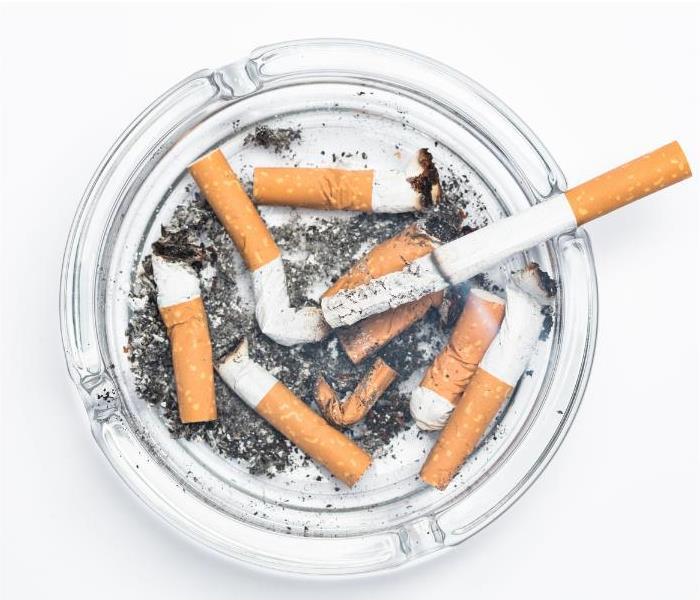 Contact the professionals at SERVPRO for smoke removal services!
Contact the professionals at SERVPRO for smoke removal services!
The best way to remove cigarette smoke from your home is by professional cigarette smoke removal services.
If you've ever smoked inside your home, you know how cigarette smoke stains and smells linger on surfaces for years, and the number of damages will depend on how long cigarette smoking has occurred in the home.
Cigarette smoke contains a chemical called nicotine which bonds to porous materials like wood, fabric, and paints. It doesn't matter if the cigarette is out; as long as it was lit at some point inside the home, there will be lingering traces of cigarette odors.
The best cigarette smoke removal tactics will require a combination of cigarette smoke odor neutralizers and specialized tools that remove cigarette smoke from different surfaces. In the following blog post, we will go over our professional cigarette smoke removal process for a home that was smoked inside for thirty years. By the end of this post, you will know how cigarette smoke is removed from a home and reasons not to smoke inside a home.
Removing decades of cigarette residue
Recently a homeowner called the professionals at SERVPRO of Union, Towns, Fannin & Gilmer Counties for water restoration services after a sink trap leak caused damage to the subflooring underneath a homeowners kitchen tile flooring. While performing our initial inspection, we realized that the home not only had water damage but also had cigarette smoke damage throughout the property.
We asked the homeowner how long they have been smoking inside their home, and they let us know that it has been over 30 years!
When cigarette smoke is present for a long time, everything in contact gets stained and discolored. For this customer, the cigarette smoke had been lingering in their home for years, not allowing us to know:
- The actual color of the carpet flooring
- The color of the walls
- The color of the ceramic tile in the bathroom
The customer asked us to perform both the water damage and cigarette smoke removal services because they planned to put their house on the market in the next six months.
The cigarette smoke removal process
The professionals at SERVPRO have found the best way to attack a cigarette smoke removal job is to attack it like a soot cleaning job.
First step: Strategically place ozone machines that disperse cigarette smoke odor neutralizers throughout the damaged areas. The cigarette smoke smells drawn into the ozone machines are changed through oxidation, which removes cigarette odors.
Second step: Wipe down walls, light switches, and door frames using a professional soot sponge. A soot sponge is a lint-free, absorbent sponge that cigarette smoke residue absorbs into.
Third step: Seal and repaint the walls. The cigarette smoke stains on the walls are now gone, but you will want to repaint them to make them look fresh and new.
Fourth step: Go over the entire area with a wet/dry vacuum removing all cigarette ash particles from soft surfaces such as carpets and fabrics. It may be best to completely remove and restore all damaged carpeting rather than spending time removing years of cigarette residue.
The entire cigarette smoke removal process took several days for the above job because cigarette smoke had seeped into both the padding and subflooring of their home. In the end, we are very proud to say that our cigarette smoke removal process allowed us to remove over 30 years' worth of cigarette odors and discoloration from the entire house!
Why you shouldn't smoke inside your home
As smoke and fire damage restoration professionals, we can't wrap up this blog post without giving you reasons not to smoke inside your home. Cigarette smoke damages everything it comes in contact with over time, not to mention the countless fire damage calls received caused by a single cigarette. So please do yourself a favor and do not smoke inside your home!
For more information about cigarette smoke removal services, please contact us today. SERVPRO of Union, Towns, Fannin & Gilmer Counties is available 24/7 to answer any type of smoke removal questions you might have.
3 Steps To Recovery After A Storm Damages Your Rental Property
10/15/2021 (Permalink)
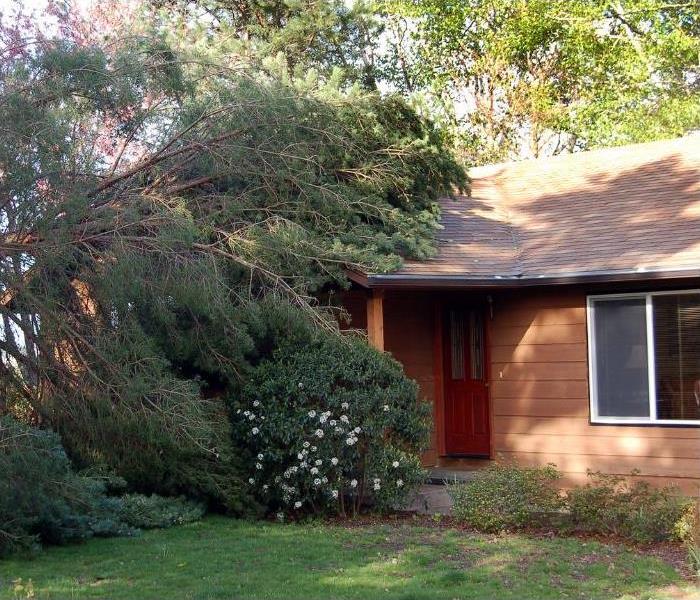 Contact the storm damages professionals at SERVPRO for 24/7 emergency services!
Contact the storm damages professionals at SERVPRO for 24/7 emergency services!
Knowing the best way to navigate storm damages to your rental property is essential, so your tenets stay happy and safe.
The professionals at SERVPRO of Union, Towns, Fannin & Gilmer Counties know how stressful it is to navigate a storm that causes damages, let alone ones that happen to a rental property. For anyone looking to recover from storm damages, we want to ensure that all members involved are safe, and that is why we put together the following blog post.
The best way to prepare is to have a plan in place before a disaster strikes, so you know how to navigate storm damages to a rental property. Continue reading if you are interested in the three most essential steps to take after a storm damages a rental property.
Communicating with your insurance company
Communicating with an insurance adjuster can be difficult right after storm damages occur to a rental property because the insurance company will be busy with multiple claims regarding storm damages in the area. Before your initial call with your insurance adjuster, you will want to:
- Describe the severity of the damage
- Note if the property is inhabitable
- Describe how it impacted the tenants and their belongings
3 Immediate steps directly after the storm damages
As a landlord of the rental property, it is your responsibility to contact your insurance company as soon as possible to start the claims process. Your insurer will most likely want to come out and assess the damages. To ensure that you are well prepared before the property inspection, you will want to take the following three steps:
1) Document the damages: Right after the storm has passed, the landlord's responsibility is to perform an initial inspection of the damages that occurred to the rental. The best way to get started will be by taking pictures and documenting what damages occurred to the rental property. The documentation will be helpful for not only your insurance company but also the restoration professionals you hire for repairs on your rental property.
2) Assess the needs of your tenants: Directly after storm damages, you will want to contact all the tenants that inhabit the rental property. In some cases, you may need to provide temporary housing accommodations if necessary for those who cannot live on-site due to damages. In the meantime, you should advise your tenets to make a claim with their renter's insurance so that they can recover any losses.
3) Avoid further damage: The best way to avoid further damages to a rental property is going to be by being proactive and noticing all compromised areas. Depending on the extent of the damages, you may need to further secure roof or siding damage with tarps and boards to avoid additional damages from occurring before repairs take place. In addition, if there is storm damage to electrical appliances, you should go ahead and shut off all electrical power to prevent any further damages.
Getting an estimate
Estimating the cost of damages to the property and belongings inside the rental is critical in restoring your rental to its pre-storm condition. And no matter how much damage there is, you will want to hire honest and reliable restoration professionals. The restoration experts at SERVPRO can provide you with an estimate for damages and help make sure that everything is restored to its original state.
Please contact us today to learn more about how SERVPRO of Union, Towns, Fannin & Gilmer Counties can help you get back on track with the restoration process.
SERVPRO of Union, Towns, Fannin & Gilmer Counties is a professional remediation and restoration contractor that provides 24-hour emergency service. We are ready to respond immediately to your residential or commercial property for any water, fire, mold, storm damage, or repairs needs.
Emergency Roof Tarp: The #1 Best Way To Avoid Water Damage
10/8/2021 (Permalink)
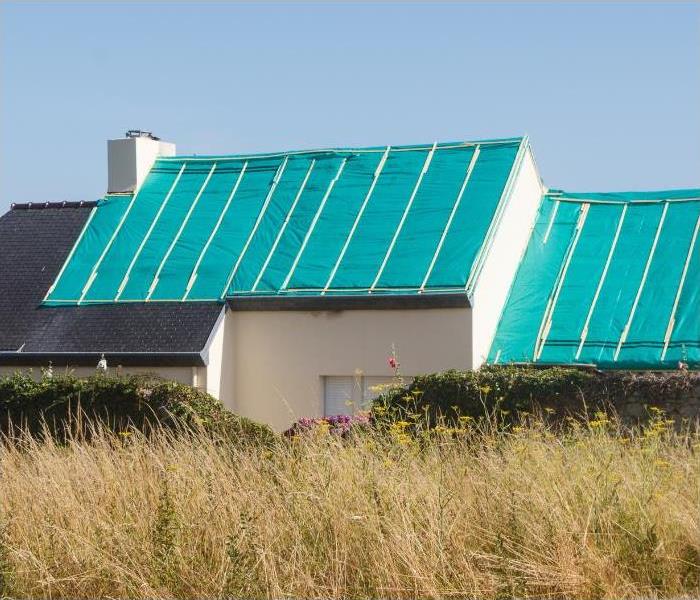 Contact the professionals at SERVPRO for emergency roof tarp services!
Contact the professionals at SERVPRO for emergency roof tarp services!
After a property has experienced roof damage, the owner must quickly contact restoration professionals for emergency roof tarp services.
No matter the type of roof a property has, it will always be susceptible to having leaks or damages. In fact, it doesn't take much to cause a leak in a property. The professionals at SERVPRO of Union, Towns, Fannin & Gilmer Counties receive many calls a year for emergency roof tarp services after:
- A heavy branch or entire tree falls and damages the roof.
- A storm with high wind speeds causes shingles to go missing.
- An old roof has holes.
You now know the common calls that our SERVPRO professionals receive regarding roof tarping, but are you now wondering what the emergency roof tarp process looks like? Well, we're here to explain! The professionals at SERVPRO want you to avoid water damage. If you ever need emergency roof tarp services, SERVPRO is available 24 hours a day 7 days a week, for emergency services.
Our emergency roof tarp process
The professionals at SERVPRO of Union, Towns, Fannin & Gilmer Counties have years of experience tarping roofs of different sizes. To ensure that each roof is tarped in the quickest amount of time, we have created a process that ensures quality and fast installation times.
- Measure & Inspect: To start the emergency roof tarp process, we will first measure and inspect the roof to determine damages that require tarping.
- Pre-mitigation pictures: All of our professionals know the importance of taking pre mitigation pictures of the damaged parts for insurance claim purposes. We will take pictures before any work is performed.
- Remove debris: Next, we will remove any debris on the roof. It is best to leave a roof clean at all times to avoid any gutter clogs.
- Cover the damaged roof: This part of the process is covering the damages with a tarp.
- Secure the tarp: The final step in our emergency roof tarp process is securing the tarp. To adequately secure a tarp, the ending of the tarp will need to be wrapped around a piece of lumber. The lumber will serve as an anchor so that the tarp stays secure. The amount of lumber used will vary depending on the extent of the roof damage.
The best type of tarps for temporary roofing
No matter who you choose to perform emergency roof tarp services at your property, you need to know what kind of tarp will be installed. The best types of roof tarps for temporary roofing are UV-treated, heavy-duty, and waterproof.
Here are some questions to consider when choosing a temporary roofing tarp:
- Is it designed to withstand abrasion and heavy winds?
- Can the tarp withstand different types of climates (Winter/Summer)?
- Is it mold and mildew resilient?
- Is it flame retardant?
- Does it come in different colors?
- Does it have a certain odor?
The above questions will help property owners choose the best emergency roof tarp to protect their property.
Wrapping up
We hope you enjoyed learning about roof tarps and the process the professionals at SERVPRO of Union, Towns, Fannin & Gilmer Counties follow when tarping a roof.
Please contact us today if your property has recently had damages to the roof and requires emergency roof tarp services. The professionals at SERVPRO are available 24/7, 365 days a year, and promise to treat your property as if it were our own. When you call us, you will receive a team of IICRC certified professionals who will quickly install an emergency roof tarp because we understand that an emergency roof tarp is the best way to avoid future water damage.
Damaged Chimney Flue: 1 Small Crack Can Cause Serious Fire Damages
10/1/2021 (Permalink)
 Contact the professionals at SERVPRO for complete fire restoration services!
Contact the professionals at SERVPRO for complete fire restoration services!
The professionals at SERVPRO have had to restore severe fire damages caused by chimney flue issues.
A damaged chimney flue can cause severe damages to your property without warning. To avoid an unwanted fire damage disaster, you should get your chimney flue inspected for any cracks or damages once a year.
A damaged chimney flue can be caused by many things, such as a small crack that worsens over time. The following blog post will go into detail about how a chimney flue can become damaged and a real-life situation that left an elderly couple with a home with severe fire damage.
How can a chimney flue become damaged?
Natural disasters, neglect, or improper installation are the main causes of a damaged chimney flue. The number one way to tell if the chimney flue has damages is when there is chipped-off cement mortar inside the fireplace. A property owner must contact a chimney repair specialist at the first sign of excess cement mortar; a crack will only worsen over time and lead to serious structural damage.
A damaged chimney flue may not directly lead to fire damage right away, but the cracks will allow for moisture to enter, increasing the likelihood of mold growth or water damage. It is best to contact the property restoration professionals at SERVPRO when water or mold issues are inside the property.
A recent call
Earlier this year, the professionals at SERVPRO of Union, Towns, Fannin & Gilmer Counties received a call from a distraught gentleman. The call was because the home that he and his wife have been living in for the last fifty years caught on fire and damaged their living room and bedroom.
Soon after the call, we dispatched our crews and were on-site in thirty minutes. Upon arrival, we were greeted by a fire marshal who explained to us that a crack in the chimney flue caused the fire loss.
After the property owners signed the necessary paperwork, we began removing all the fire-damaged debris and categorizing what could and couldn't be salvaged. The fire damage clean-up took two weeks to completely remove all caracoled items and free the property from excess smoke damage.
The next step was to rebuild the property "Like it never even happened." Before the rebuild process, the rebuild team at SERVPRO agreed that we wanted the elderly homeowners to feel like they were getting an upgrade rather than a replacement for their home. So, we went and upgraded their bedroom and living room that now has their dream bar.
In the end, the elderly couple was delighted with our team and was astonished at how we turned a terrible situation into something that they can proudly call their home.
How to avoid chimney flue fire damage?
The best way to avoid any type of chimney fire damage is to schedule regular chimney inspections with a chimney repair company. During a chimney inspection, the professionals will carry out a complete check of your chimney to ensure no damaged or worn parts are in place. If there is excess soot build-up, they will even perform a chimney cleaning.
Wrapping up
We hope you now know how important it is to schedule professional chimney inspections because when your chimney flue gets damaged, it can cause severe fire damage to the inside of your home.
Please contact the professionals when a damaged chimney flue causes fire damage to your property. SERVPRO of Union, Towns, Fannin & Gilmer Counties is an IICRC certified firm with the professional knowledge to handle any size fire damage disaster. We are readily available 24 hours a day, every day of the year, to help you with your fire damage claim.
Siding Damage: 4 Steps To Get Siding Replaced By Insurance
9/24/2021 (Permalink)
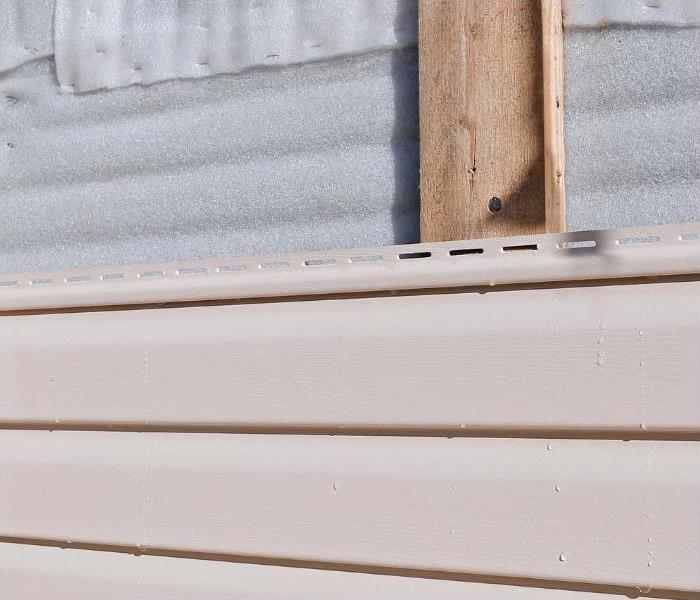 Contact the professionals at SERVPRO for siding repairs!
Contact the professionals at SERVPRO for siding repairs!
Wind and hail are two natural forces that are known to cause siding damage.
The siding on your property is one exterior element that protects the property from outdoor elements. When the siding gets damaged, the home or business will become more susceptible to water damages leaking through the damaged areas.
Damage to the siding can be stressful to navigate. Fortunately, the professionals at SERVPRO of Union, Towns, Fannin & Gilmer Counties have found that insurance companies will commonly cover damaged siding replacement costs. Therefore, we have put together the following blog post to help property owners get their damaged siding replaced by insurance. We will go over the clear signs of wind or hail siding damage and the four steps in getting your siding replaced by your property insurance company.
When to check for siding damage
As a property owner, you want to always ensure that the property is safe from the outdoor elements. The best way to ensure that your property is ready to fight against mother nature is to check the siding for damages regularly, but most importantly, right after a recent storm has passed.
To check for siding damage, you will need to have a reference image of what the siding looked like before any damages occurred. The best reference type will be a video or pictures of the siding when it was in good condition.
There are two signs to watch out for when checking for siding damage:
- Cracks or holes
- Missing planks
The four steps for insurance repairs
Suppose the siding on your property was damaged during a windstorm, hail storm, or another natural force. If this is the case, it needs to be addressed and replaced ASAP so no further damages will occur to the property. The following four steps are the fastest proven way to get your property fixed and covered by a property insurance company.
1) Fast contact: When dealing with an insurance claim, it is best to contact the insurance provider sooner rather than later. The faster that the property owner contacts the insurance company, the faster the claim will get started.
2) Accurate information: Not all siding is alike. Different types of siding require different siding replacement protocols. Knowing the type and color of the siding that received damages will help the insurance adjuster ensure accurate siding is compensated.
3) Documentation: To ensure that the siding damage insurance claim is quickly processed, you will want to provide the property insurance company with pictures and videos of the siding damages.
4) The number to a reliable restoration contractor: Having the number to a reliable restoration contractor is imperative to getting the siding replaced. In addition, the right restoration contractor will know how to communicate with insurance adjusters to ensure that a claim is quickly estimated and approved.
Wrapping up
Wind and hail siding damage can happen at any time without warning. You might be going about your day when a storm blows through, or you might be sleeping soundly in bed on a windy night. Either way, siding damage is not something that people plan for.
We hope you enjoyed learning about siding damage and how to get the claim processed by your property insurance company. SERVPRO of Union, Towns, Fannin & Gilmer Counties is a well-known reliable restoration contractor throughout north Georgia and is available 24/7.
As an IICRC certified firm, we guarantee that all restoration projects are professionally done while focusing on customer satisfaction. In addition, all of our restoration professionals are well trained in using industry-standard equipment and follow insurance restoration protocols.
Please contact us today if your siding has recently been damaged by wind or hail.
Warehouse Flood: 5 Ways to Reduce the Severity of Flood Damages
9/10/2021 (Permalink)
 Contact SERVPRO when flood damages affect your warehouse!
Contact SERVPRO when flood damages affect your warehouse!
A warehouse flood can result in many thousands of dollars worth of damages.
A warehouse can serve many purposes, but it is most common for a warehouse to hold large amounts of product and inventory for a business or multiple businesses. The last thing that any warehouse owner or manager wants is to have damages from flooding.
Not only is the flooding itself detrimental to the warehouse structure, but it will also leave the warehouse owner with a large mess to clean up and the need to reduce product damages as soon as possible.
The following blog post will discuss 5 ways to ensure minimal damages will occur before a warehouse flood occurs. The professionals at SERVPRO of Union, Towns, Fannin & Gilmer Counties have mitigated the most severe warehouse flood damages. With that being said, we want to ensure that you are well prepared for a warehouse flood and the best ways to make the cleanup process easier for when a flood disaster occurs.
5 Ways to reduce damages before flooding occurs
As you probably are already aware, flooding can result in catastrophic damages to a warehouse. To prevent flood damages from resulting in more severe damages, we put together the following list:
1) Have a video surveillance system installed. The installation of a video surveillance system will keep your warehouse protected from thieves and help monitor inside and outside of the warehouse.
2) Keep all packages and products at least a foot above the ground. The higher up you can keep the stored products in the warehouse, the better. The professionals at SERVPRO have found that keeping products on pallets will not be high enough when flooding occurs.
3) Design an emergency flood plan. When designing the warehouse flood plan, ensure that it includes all emergency exits and emergency shut-off valves for electricity, water, and gas supply lines.
4) Ensure that all members of the managing staff have the number to a restoration contractor. Having the number to a professional restoration contractor will ensure that the damages are mitigated quickly and adequately.
5) Monitor and check the property frequently for damages. For example, holes and cracks in the warehouse will make it more susceptible to damages when flooding occurs.
What to do when flooding occurs
When flooding occurs to your warehouse, you will want to call an IICRC certified restoration contractor to come out and mitigate and restore the damages that occurred to the property. The right team of restoration contractors will:
- Document all the warehouse flood damages
- Extract standing water from all surfaces
- Move all salvageable packages and products to a dry location
- Use dehumidifiers or air movers to ensure that the property is dry
- Work with the property insurance company to ensure that all parties are compensated correctly for the damages
Why choose SERVPRO
Have you just experienced a flood in your warehouse? You are not the first, nor will you be the last. The professionals at SERVPRO know that water damages are the most common causes for business interruption, loss of inventory, and damage to equipment.
When you choose to work, hire SERVPRO of Union, Towns, Fannin & Gilmer Counties, you will be granted an IICRC certified team of professionals that have helped property owners with all types of property damages.
As a preferred insurance vendor, we know how to properly communicate with property insurance companies to ensure that the property damage claim is processed quickly.
Please contact us today if you are in the middle of dealing with a warehouse flood situation in North Georgia. It does not matter what time you call; emergency service crews are available 24/7, 365 days a year.
Attic Water Damage: 2 Main Causes With Prevention Tips
8/27/2021 (Permalink)
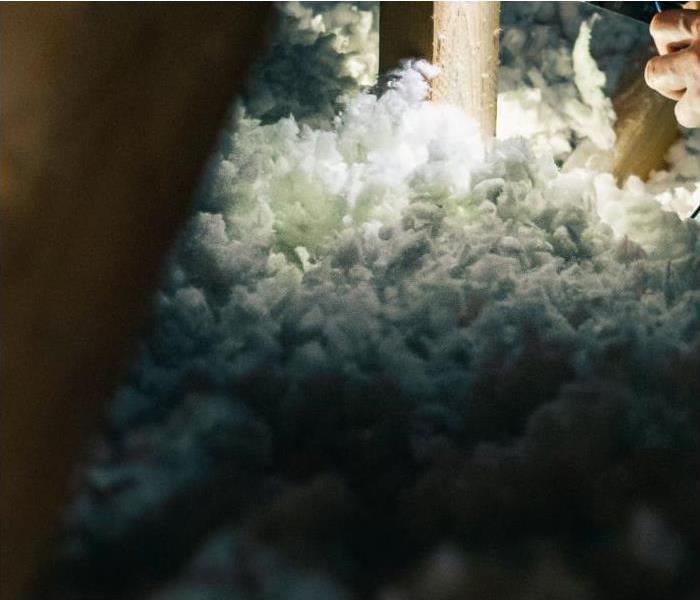 Contact SERVPRO the next time your property has water damage!
Contact SERVPRO the next time your property has water damage!
Any property owner can experience the unfortunate event of attic water damage.
One of the most devastating things that can happen to a home or business is attic water damage. When attic water damage occurs, you may be left wondering how it started in the first place. To make matters worse, what seemed to be a small water damage situation may have turned into mold growth because an attic environment is a perfect place for mold to grow.
The good news is that attic water damage is preventable by paying attention to key factors like insulation and moisture control. In this blog post, we will discuss the two main causes of attic water damage in detail, so you know what you're up against!
What does attic water damage look like?
Every attic water damage situation will differ depending on the amount of water damage present and how long the damages were left to sit. When an attic experiences water damage, the property will be left with:
Water stains on the ceiling: Dark-colored spots on the ceiling directly below the attic will start to appear.
Wet insulation: Wet insulation will become discolored and absorb water like a sponge, often leaving the attic with an unpleasant odor that may only be remediated by removal.
Wet attic rafters: During an attic water damage situation, the attic rafters will become wet, and without quick attention, attic mold growth will occur because an attics environment encourages moisture retention on the attic rafters when wet.
There are two main causes of attic water damage:
1) Roof leaks: A roof leak can cause severe damage to the attic and the rest of the property. In most cases, a roof leak will go unnoticed until it has caused severe attic water damage.
To prevent attic water damage from a roof leak, you will want to check the roof for any leaks after a heavy rainstorm passes because, during these times, a roofing system will be especially vulnerable to leakage. The best way to check for attic water damage is by physically going up into the attic space after a rainstorm.
Suppose you do not feel comfortable entering the attic space. In that case, you should consider hiring a reputable water damage restoration company like SERVPRO or a professional roofer to inspect your roof and attic for any signs of a roof leak.
2) HVAC leaks: Attic water damage will occur when the property has an HVAC system that leaks inside the attic. An HVAC leak in an attic is more likely to occur in a commercial building, but the professionals at SERVPRO have also seen HVAC systems leak in residential homes.
The best way to prevent an HVAC leak in an attic will be to schedule regular checks of the attic HVAC system.
Who to call for attic water damage?
The number one company to call for attic water damage is SERVPRO of Union, Towns, Fannin & Gilmer Counties. SERVPRO is a highly reputable national restoration company that has been helping property owners since 1967.
The IICRC certified professionals at SERVPRO understand that water damage can be very costly, especially when it occurs in the attic and goes unnoticed for a while. Therefore, when you contact us, we will not only help you mitigate the damages done to the property, but we will also help you with your property insurance claim.
Keep in mind that the best way to prevent water damage in the attic is to check the attic space at least once a month and never let attic water damages sit for a prolonged period because the water damage will turn to mold damage.
Please contact us for any further questions regarding attic water damage prevention!
Clean Gutters: 3 Reasons Why Simple Exterior Maintenance is Essential
8/13/2021 (Permalink)
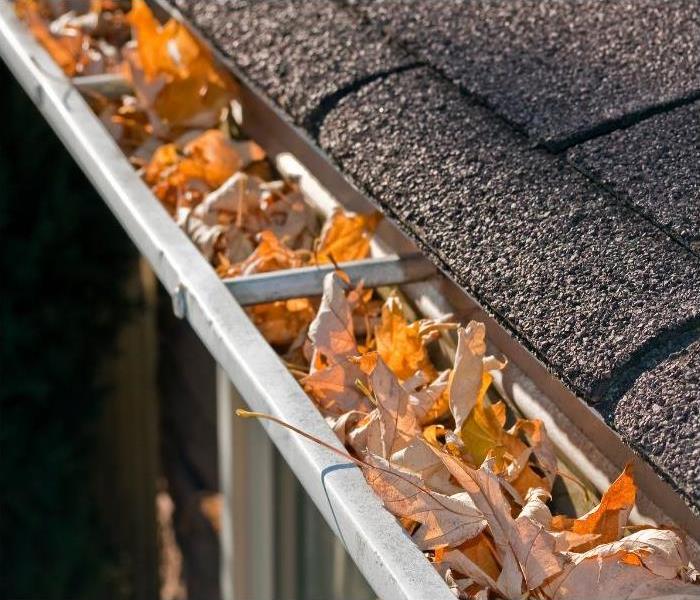 The professionals at SERVPRO are prepared for any size disaster!
The professionals at SERVPRO are prepared for any size disaster!
Having clean gutters is a sure way to keep your property safe from unwanted damage!
With fall right around the corner, the experts at SERVPRO of Union, Towns, Fannin & Gilmer Counties want to ensure that your gutters are clean to prevent unnecessary water damage. In the following blog post, we will be going over why well-maintained gutters are necessary for a home and the three damages caused by dirty gutters.
Why are clean gutters necessary?
We are sure that you have heard multiple times that your gutters are an important part of your home, but do you know why? Clean gutter systems will help prevent water from seeping into the building and causing costly damage to your property's structure.
Additionally, your property's gutters will protect against mold and mildew growth that can lead to structural damage. In the following paragraph, we will share a real-world scenario that our SERVPRO professional handled last fall.
Real-world scenario
Last fall, our IICRC certified professionals received a call from an elderly property owner who found water and mold damage in the basement of their vacation home in Blue Ridge, Georgia. During our initial inspection, our professionals located the cause of the loss.
At first, we thought that the cause of the loss was a foundation leak, but after further inspection, we found out that a gutter clog was the culprit. When we looked at the gutters, we noticed that they were full of debris that prevented water from flowing away from the property.
In this particular case, water backed up into the roof and down into the walls causing wall water damage and a flooded basement. To move forward, we performed demolition to remove all the materials affected by mold and set our industry-standard drying equipment.
The property was completely dry and free of damaged materials within five days. To go the extra mile, we put together an extensive insurance estimate for rebuilding the property. After approval from their homeowner's insurance, we began to rebuild the customer's dream basement. In the end, the property owner was extremely happy with the finished remodel and told us that their new basement was better than the damaged one.
4 Damages caused by dirty gutters
Keeping leaves and twigs out of gutters is crucial for protecting the structure of your home and preventing costly damage. Having dirty gutters can lead to the following three different issues:
- A damaged roof - When water continues to flood over a gutter system, it will cause excess water to potentially rot the roof's fascia.
- Interior water damage- Rainwater may not drain properly and may cause water damage to the interior of a home. (See above case study)
- A cracked foundation- Excess water around your property will occur when a property's gutters are clogged. Pooling water will eventually start deteriorating the foundation of a home and cause cracks.
Final thoughts
We hope you enjoyed learning about the importance of having clean gutters and the three types of damages you want to prevent. To ensure your property does not experience water damage caused by dirty gutters, we recommend you check your gutters at least once a month to ensure they are functioning correctly.
Clean gutters are essential for preventing water damage, and they also help prevent the growth of mold and mildew in your home. Please contact us today for any further questions about water damage and tips on how you can prevent damages from occurring in your home.
SERVPRO of Union, Towns, Fannin & Gilmer Counties is a well-known water damage restoration company in north Georgia. All of our SERVPRO professionals are highly trained and are ready to handle any size disaster!
3 Great Reasons To Hire Asbestos Abatement Contractors
7/30/2021 (Permalink)
 Contact the asbestos abatement professionals at SERVPRO today!
Contact the asbestos abatement professionals at SERVPRO today!
It is possible for a property built before 1980 to contain asbestos in old floor tiles, ceiling tiles, roof shingles, and insulation.
Asbestos is a building material that the EPA did not officially ban in the United States until July 1989, when they issued the Asbestos Ban and Phase-Out Rule (ABPR). Although it was banned in 1989, many residential and commercial property builders halted using asbestos in 1970 when the EPA banned spray-applied asbestos products.
In the following blog post, we will discuss the dangers of asbestos and three reasons why it is important to hire a licensed asbestos abatement contractor for removal.
Why was asbestos used in building materials?
Asbestos was commonly used in construction materials for its durability and heat-resistant properties until the 1980s when the science behind the dangers of asbestos was released, and safer alternatives became available. Although asbestos materials are no longer legal in modern-day construction, they can still be found in older homes throughout the counties in North Georgia.
To ensure that a property is asbestos-free, a property owner should contact a licensed asbestos abatement contractor to perform a thorough inspection. During an asbestos inspection, a licensed asbestos abatement contractor will remove a building sample to send to a third party to get tested for asbestos. Suppose the sample comes back positive for asbestos. In that case, a property owner must move forward with asbestos abatement by a licensed asbestos abatement contractor.
1) An asbestos abatement contractor will follow asbestos removal laws.
SERVPRO of Union, Towns, Fannin & Gilmer Counties is licensed for asbestos abatement and follows the asbestos removal laws by The State of Georgia, and are OSHA trained to work with high-risk materials.
2) An asbestos abatement contractor will ensure all members of the property are safe.
During an asbestos removal project, the professionals at SERVPRO will contain the area to avoid airborne asbestos particles from traveling to other parts of the property.
When there is a lot of asbestos-containing materials present, the asbestos abatement professionals may not allow any of the property members to be anywhere near the property. No matter the amount of asbestos present, it is always recommended to stay away until all the asbestos is safely removed.
3) An asbestos abatement contractor will ensure all asbestos materials are properly disposed of.
When the professionals at SERVPRO remove asbestos, they will ensure that the asbestos is disposed of only in a permitted landfill. In addition, they will ensure the asbestos-containing waste in a sealed leak-proof container that is properly labeled.
Common reasons when SERVPRO gets called for asbestos removal
The only time asbestos is dangerous is when it is disturbed and becomes airborne. Asbestos can be disturbed from water damage, fire damage, mold damage, and a remodeling project. The professionals at SERVPRO know the importance of taking precautionary measures when they arrive at a property built prior to 1980. Property owners are often happy to find out that SERVPRO can move forward with the asbestos removal process when found in a property that requires emergency restoration services.
Why Contact SERVPRO for asbestos removal?
When choosing an asbestos removal contractor, you will want to choose a contractor that prioritizes safety and training. SERVPRO professionals are trained to handle asbestos removal in a way that is safe for their customer and their property.
The experts at SERVPRO of Union, Towns, Fannin & Gilmer Counties have dedicated themselves to providing excellent service, unsurpassed quality, and competitive pricing on any size asbestos abatement project.
Please contact us today if you own a property built prior to 1980 and require an asbestos inspection. We are available 24/7, 365 days a year, for any questions or emergency services.
Fire Pit Safety: What is the Correct Fire Pit Distance From A House?
7/16/2021 (Permalink)
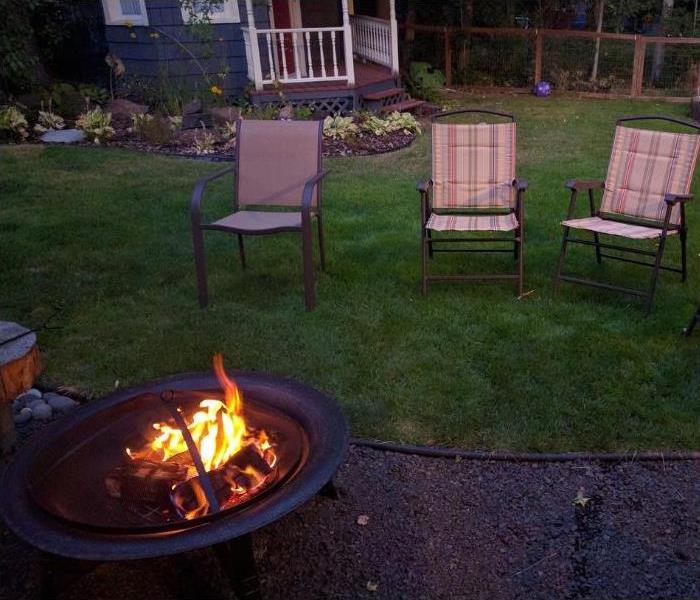 Count on the professionals at SERVPRO for any size fire restoration project caused by a backyard fire pit!
Count on the professionals at SERVPRO for any size fire restoration project caused by a backyard fire pit!
Make sure your fire pit is the correct place this summer.
There is nothing better than starting a fire in a fire pit on a pleasant summer evening. A fire's warmth and light are the perfect way to end the day. But before you fire up your fire pit, there are some important things to keep in mind for safety's sake!
In the following blog post, we will discuss two types of fireplaces: permanent and portable, as well as how far your fire pit should be from your house, as well as fire pit safety tips to make sure that everyone stays safe.
The 2 types of fire pits: permanent and portable
There are two main types of fire pits homeowners install on their property: permanent fire pits and portable fire pits.
Permanent fire pits are often built into the ground, with cement blocks to contain the fire. This type of fire pit is most common in areas where fire restrictions are minimal.
On the other hand, portable fire pits are often made from metal and don't need to be built into the ground. These fire pits are great for a homeowner who is curious if they want to invest in a permanent fire pit.
The proper fire pit distance from a house
No matter what type of fire pit you decide to use, fire safety must always be a top priority. Fire pits should be at least ten feet from the house, but we recommend 20 feet to avoid fire damage. The fire pit should also be at least ten feet away from any other type of flammable surface, such as a swing set or tree.
Fire safety needs to be a priority!
Whenever you decide to start a fire in a fire pit, you need to ensure that appropriate safety measures are followed. The team at SERVPRO of Union, Towns, Fannin & Gilmer Counties has put together a list of 10 fire pit safety tips to ensure you get the most enjoyment from your fire pit this summer while keeping everyone safe.
10 Fire pit safety tips
- A fire pit should never be placed on a wooden deck or any wooden surface.
- Avoid burning seasoned wood
- Follow any fire pit laws by your local city and county authorities.
- Keep a fire extinguisher or a water source close by in case of an emergency
- Avoid operating a fire pit beneath a building overhang or under a partially enclosed space.
- Keep a portable fire pit make sure the ground is level
- Check for overhanging trees that can easily ignite from sparks.
- Surround a fire pit with non-combustible materials, like stone, brick, and sand.
- Don't use lighter fluid or gasoline to start a fire.
- Surrounding chairs should be at least 5 feet away from the fire pit.
What to do when a fire pit causes fire damage
If you are dealing with fire damage caused by a fire pit, you need to contact a reliable fire damage restoration company for help.
Professional fire restoration experts will clean up the fire-damaged area and remove all of the smoke damage left behind after the fire is put out.
The right team of fire restoration professionals may be able to save certain items from your home that were not significantly fire-damaged through an extensive cleaning process.
Final Thoughts
As with any outdoor fire event, homeowners need to keep their property safe when hosting guests by following the backyard fire safety tips above.
When dealing with a fire damage claim, you can count on the professionals at SERVPRO of Union, Towns, Fannin & Gilmer Counties. All of their fire damage restoration professionals have gone through extensive training and are IICRC certified.
Please feel free to contact us for further questions on our fire restoration services. We hope you are having a great summer!
The Dishwasher Leak: 2 Causes for Dishwasher Water Damage
7/2/2021 (Permalink)
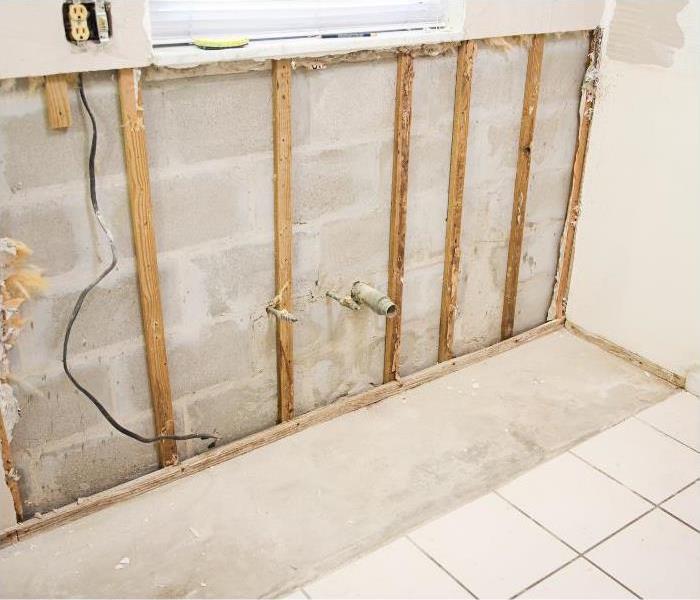 Dishwasher water damage needs to be handled by a certified professional!
Dishwasher water damage needs to be handled by a certified professional!
A leaky dishwasher could lead to a major water damage disaster in your home.
The water damage professionals at SERVPRO have seen it all when it comes to home water damages. To date, one of the leading causes of water damage is the result of a leaking dishwasher. The SERVPRO professionals have seen a small leak turn into a severe disaster when a homeowner allows the water to leak for a prolonged period of time. Therefore, a homeowner needs to get a dishwasher leak fixed as soon as it is first noticed to avoid further expenses.
In this blog post, we'll teach you why a dishwasher may be leaking, the damages it can cause, and who to call when your home suffers from dishwasher water damage.
Why does a Dishwasher leak?
There can be many reasons why a dishwasher leaks, but there are two leading causes the SERVPRO professionals have found:
- Dishwasher door malfunction
- Poor dishwasher drainage.
A door malfunction will be quickly noticed when a puddle is located directly under the door of a dishwasher. A dishwasher door may malfunction because the door latch is either bent or loose, causing it not to latch properly. If the door latch is not the cause of the dishwasher water damage, it may be because of a faulty dishwasher door seal. A seal can be compromised if the metal or plastic around it is bent, broken, or has any damage to it.
Another main cause of dishwasher water damage is when there is improper drainage causing the dishwasher to overflow. When a dishwasher is not properly draining, water will be forced out of the dishwasher and onto the floor.
What to do when you notice a dishwasher leak?
To avoid severe water damages, stop use and unplug the dishwasher at the first sign of a dishwasher leak. Next, check the owner's manual and the manufacturer's website to see if there are any recalls on your dishwasher. At this time, it would also be an excellent time to see if you are lucky enough to have your dishwasher under a manufacturer's warranty. You may be able to get the leaky dishwasher fixed for free if it is still under warranty. Under warranty or not, you will need to decide if you want to get the dishwasher professionally fixed or buy a new dishwasher altogether.
Damages a dishwasher leak can cause
Dishwasher water damage will be a massive headache for a homeowner. A prolonged leak will cause water damage to the flooring, subflooring, and walls of the kitchen. As well, if your kitchen is on the second floor, the dishwasher leak can head toward the basement and cause water damage to the ceiling and other areas in the basement. You will want to get the water damages mitigated as quickly as possible to avoid secondary damages like mold growth and structural damages.
Who to call for dishwasher water damage restoration?
It is essential to call for professional water restoration help at the first sign of dishwasher water damage. A water restoration company will be able to take care of the dishwasher leak and make sure that your kitchen is back in order with minimal fuss.
Throughout North Georgia, the locals have relied on SERVPRO of Union, Towns, Fannin & Gilmer Counties for water damage restoration services. All of the professionals at SERVPRO have gone through extensive training by the IICRC. They have also proven to be a reliable water damage restoration company by the Better Business Bureau with their A+ rating.
Contact SERVPRO today if you are in the middle of a dishwasher water damage disaster and need fast quality services. We are available 24/7, 365 days a year!
Flat Roof Leaks: 3 Reasons Why There's Now Water Damage
6/18/2021 (Permalink)
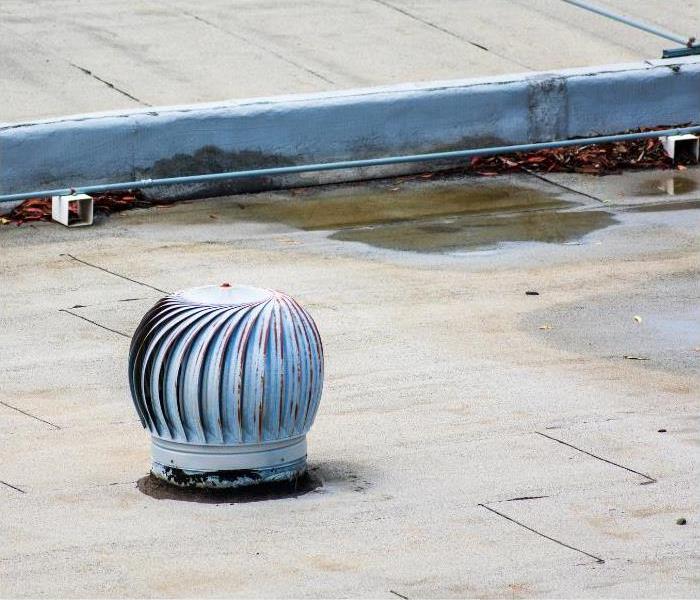 Contact the professionals at SERVPRO for flat roof leak issues!
Contact the professionals at SERVPRO for flat roof leak issues!
A flat roof leak is one of the most common reasons for water damage in a commercial property.
A flat roof system is designed to be waterproof and withstand heavy rainfall. As time goes on, a flat roof can have problems with leaks that cause commercial water damage, but do you know what is causing the flat roof leak?
The following post is designed for commercial property owners or property managers that have a flat roofing system. We will go over three of the most common reasons why there may be a flat roof leak to your commercial property.
3 most common reasons for a flat roof leak
- Ponding water
- Damaged membrane
- Penetrating structures
A flat roof leak from ponding water
The professionals at SERVPRO have seen ponding water as the most common cause of a flat roof leak to a commercial property. Flat roof ponding is where water will pool on the flat roof. When ponding occurs for longer than 48 hours, it will possibly lead to a flat roof leak causing water damage to your building. A good rule of thumb to remember is, the longer that water ponds, the greater the chance of a flat roof leak.
Call a reputable commercial roofing contractor to come out and inspect your property's roof if you are worried about ponding. They will ensure that the commercial flat roof was designed with a slight slope so that the water can quickly drain. Keep in mind that even if the flat roof is designed with a slight slant, ponding can still occur, especially when the flat roof is old.
A flat roof leak due to a damaged membrane
In more recent years, roofing membranes are made from thin, durable rubber, unlike back in the day when a commercial flat roof involved multiple layers of materials.
The common day flat roof membranes are less expensive and faster to install yet can be damaged as time goes on. The most common causes of damages and wear to a membrane is:
- Punctures
- Splits
- Cracks
- Blisters
These kinds of wear can happen over time from wind, hailstones damaging the roof's surface, or tree branches falling on the flat roof. A damaged membrane will give rainwater quick access to insulation beneath the membrane. As the insulation beneath the membrane gets saturated, it will then lead to commercial water damage. To avoid water damage, you should contact a reputable roofing contractor to come and inspect your commercial roofing system.
A flat roof leak from penetrating structures
Penetrating structures are structures that rise through the surface of a flat roofing system. Every penetrating structure installed on a flat roof will be vulnerable to a flat roof leak.
Common penetrating structures are:
- Plumbing vents
- Pipes
- Gas lines
- HVAC tubes
Professional commercial roofers commonly use roof boots to protect commercial properties from a flat roof leak. Even with the best-installed roof boot, water may still find its way into the property and cause water damage. If you are worried about a penetrating structure causing a flat roof leak, you need to call a reputable roofing contractor for a commercial roof inspection.
Final thoughts
We hope you enjoyed learning about the three most common causes of a flat roof leak. The professionals at SERVPRO of Union, Towns, Fannin & Gilmer Counties receive many calls a year for commercial water damage caused by one of the three common causes. Contact us ASAP if you are currently in the middle of a flat roof leak issue. Our IICRC certified crews will quickly respond because we understand that we have roughly 48 hours before mold will start to grow.
We are available 24/7, 365 days a year, for emergency services. Once we receive your call, we will dispatch a crew immediately to mitigate any size disaster!
5 Steps To Take When An Elevator is Affected By Water Damage
6/4/2021 (Permalink)
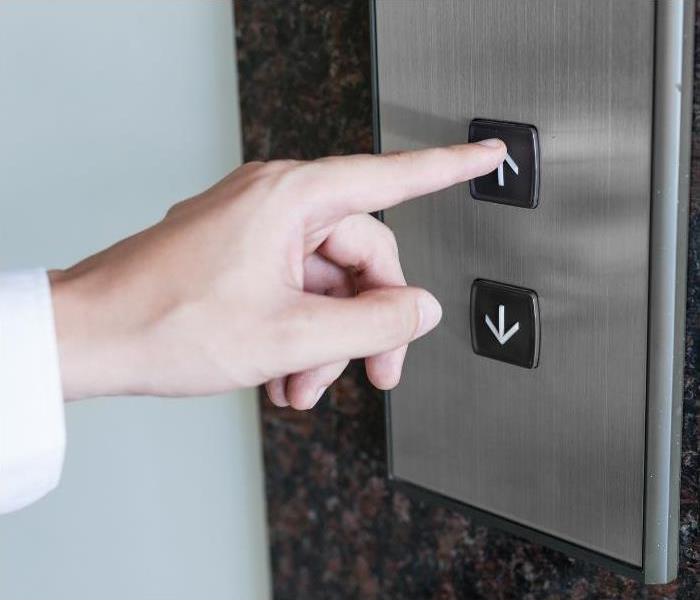 The commercial water damage professionals at SERVPRO are ready for any size disaster!
The commercial water damage professionals at SERVPRO are ready for any size disaster!
Water damage to an elevator needs to be mitigated quickly.
If your elevator has been affected by water damage, you may be wondering what to do. Many outcomes can occur when an elevator is damaged by water, but these five tips will help your elevator get back up and running as soon as possible!
Commercial property owners and property managers have a lot of responsibility on their plate. They have to make sure the property is being taken care of, residents are happy, and ensure everything is maintained regularly.
A property manager's worst nightmare will be when there is fire or water damage to their property. In this post, we hope to relieve some stress if your property has elevator water damage. We go through common reasons why elevator water damage occurs and five actionable steps you can take to ensure your elevator is quickly back to running normally.
How can elevator water damage occur?
Elevator water damage can occur from multiple different sources. Normally, it results from water ingress or commercial sprinklers in the property going off and flooding the elevator shaft.
The water damage professionals at SERVPRO have also seen an overflowing toilet or sink flood the area in and around your elevator, causing severe damage to the elevator equipment.
5 steps to take during an elevator water situation
Once a water damage situation arises, the key is to act swiftly in a calm manner. The most important thing you need to do as a property manager is to ensure that all of the residents and staff of the property are safe. With that being said, here are 5 steps for when a property has elevator water damage:
- Ensure no one is trapped inside the water-damaged elevator.
- Shut off all power to the elevator
- Document the entire scenario through pictures. Ensure you include all the damaged areas and anything that has been in contact with water.
- Contact a reliable water restoration vendor.
- Contact your elevator service provider.
By following the 5 steps above, your property will be back up and running in no time. Since your elevator runs off electricity, under no circumstance should you turn the elevator back on until it has been cleared by an elevator repair professional.
How to protect an elevator from water damage
Building engineers know that the elevator pit is the lowest point in a building's infrastructure, so even a broken pipe could easily cause flooding.
Here are specific steps you can take to ensure minimal or no damage from water hazards:
- Equip your elevator with a surge protection system.
- Conduct inspection of all emergency lighting and call systems.
- Ensure a standby generator is functional.
- There should be no point of leakage anywhere in the elevator.
- Install sump pumps in the elevator pit and make sure they function.
Understanding what kind of water is present in the elevator
When you are dealing with elevator water damage, you must know what type of water is present. There are three categories of water damage that you will be learning. Before we get started, remember that the water is deemed less sanitary the higher the category.
1.CLEAN WATER
This category involves water damage sourced from a place of sanitation. It can include broken water lines, toilets, or faucets. And although this source is considered sanitary, it can proceed to unhygienic standards if not treated promptly.
2.GRAY WATER
As the name suggests, this category involves water that is not entirely sanitary and has been contaminated in one way or another. Sources of greywater are from a broken dishwasher, overflowing toilet, or washing machine. These bodies of water contain a varying amount of bacteria and other organisms that make it imperative to be addressed in a timely fashion.
3.BLACKWATER
The third category is the most unsanitary out of all the varieties. This water may have human or animal feces and many other pollutants. Floods and sewage water commonly cause blackwater water damage.
Contact SERVPRO for commercial water restoration.
In instances such as water damage, it is imperative to seek professional help to limit the destruction. SERVPRO of Union, Towns, Fannin & Gilmer Counties has water damage restoration specialists available at your service 24 hours a day, 7 days a week, for emergency purposes. When you contact us, you will be getting highly trained, and IICRC certified technicians at your property. You can count on us to put you, the customer, first!
Photoelectric or Ionization: Which Smoke Detector is Right for You?
5/21/2021 (Permalink)
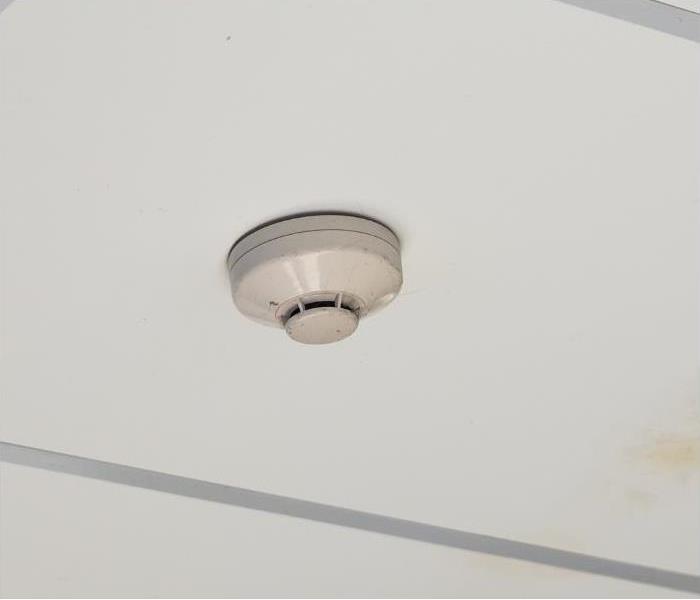 We are ready for any size fire restoration job!
We are ready for any size fire restoration job!
Learn about the two main types of smoke detectors to install in your property
When it comes to protecting your property from fire, safety is the most important thing. You want to ensure that you are alerted quickly and can escape safely with minimal damage if a fire starts in your home or business. But which type of smoke detector should you install?
Both photoelectric and ionization detectors use sensors to sense smoke and fires differently based on where they think the source of the fire started.
Understanding the differences between the two will help you make the right decision about the smoke alarms protecting your property. Keep on reading to find out what smoke detector you should install!
What is an ionization smoke detector?
An ionization smoke detector uses a sensor that responds to both visible and invisible combustion particles by releasing electrons that travel through the air. When airborne molecules collide with the internal sensing chamber an electric charge will trigger the alarm.
Unlike photoelectric alarms, this type of smoke detector will not detect fires in areas with no smoke or fire present (i.e., false alarms). It has fewer detection levels than photoelectric detectors because it does not have any kind of light-sensing component like photoelectric sensors do. Ionization smoke detectors detect fast flaming fires and are best installed in kitchens and bathrooms and places you may leave unattended for long periods, such as your home office.
What is a photoelectric smoke detector?
A photoelectric smoke detector uses a light-sensing component to detect slow smoldering fires. The sensor is either an array of LEDs or an infrared beam, which activates when the light from these devices reflects off smoke particles in the air. When smoke is sensed, the alarm will sound and notify you that there has been a fire detected in your property.
Photoelectric vs. Ionization Smoke Detector: Which to choose?
Both photoelectric and ionization smoke detectors have their strengths and weaknesses. The main difference between photoelectric and ionization is that one has an airborne sensor that senses fires through light sensors (photoelectric). At the same time, the other relies on particles being released into the air (ionization). Which smoke detector you choose to install will depend on your needs for detection.
Ionizing Smoke Detector: These detectors work best when installed in kitchens and bathrooms as well as places you may leave unattended for long periods, such as your home office.
Photoelectric smoke detectors are best installed in places where you are most likely to see the fire, such as your kitchen during a grease fire.
The IICRC certified professionals at SERVPRO can not say that one type of smoke detector is better than the other. We recommend installing both ionization and photoelectric smoke detectors to ensure maximum detection of the various types of fires.
Call SERVPRO for fire or smoke damage restoration.
Call SERVPRO of Union, Towns, Fannin & Gilmer Counties if, unfortunately, your smoke detectors didn't do the job quick enough and you are left with fire or smoke damage; we are skilled professionals in the fire damage restoration field who can remove all soot webs and restore your property to a pre-disaster state within no time.
Fire disasters always come without warning, and such an unfortunate thing can happen to anyone. We respond quickly to emergencies, 24 hours a day, 365 days a year because we know that every second will count when minimizing property damage.
At SERVPRO, we truly understand how devastating it can be to find yourself in a fire damage situation. Contact us today for immediate help!
SERVPRO Knows When To Use An Air Scrubber, Do You?
5/7/2021 (Permalink)
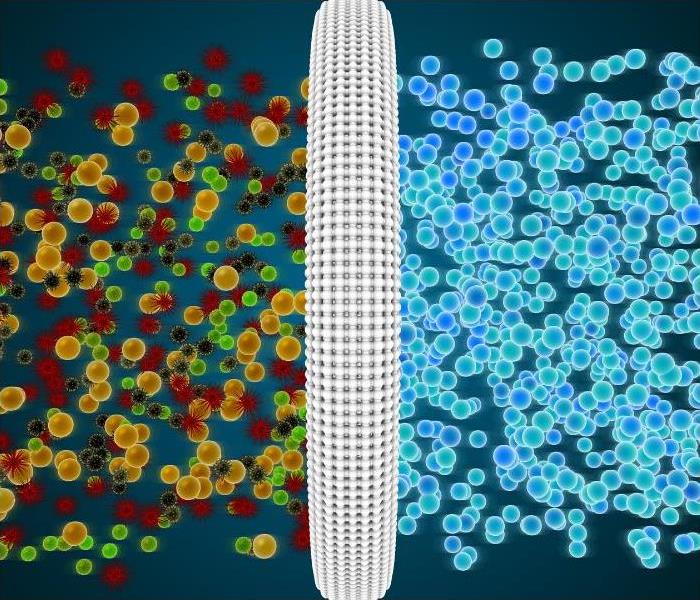 Contact the professionals at SERVPRO to enhance your indoor air quality!
Contact the professionals at SERVPRO to enhance your indoor air quality!
Learn why correctly placing an air scrubber is essential.
According to the Environmental Protection Agency, indoor air is two to five times more polluted than outdoor air.
Confined indoor spaces can contain various toxins such as dust particles, odors, pollutants, and microscopic living organisms such as mold. During a mold remediation project, the professionals at SERVPRO understand the importance of air purification options to maintain a clean atmosphere inside their homes/businesses.
Cleaning the air may be done in various ways, but air scrubbers are among the most popular, especially when a property has a mold issue.
What is an air scrubber?
An air scrubber is a form of air circulator that draws a room's air through a series of filters to minimize gas and particle levels before emitting filtered air out the other side. An air scrubber reduces contaminants in a property and provides clean air.
The air scrubber is set up so that a properties room air is drawn into the filters and then released into the containment as filtered air. The airflow rates are adjusted so that the containment is kept at a positive pressure, which helps to prevent contaminants from entering.
Considering the effectiveness of air scrubbers, it is evident that our team at SERVPRO will prioritize using them in any of their restoration/repair procedures because, at SERVPRO, we put the health and safety of our customers above anything.
Where to place an air scrubber?
When utilizing the benefits of an air scrubber, it's important to pick a spot that isn't hidden behind furniture or directly under shelves. For maximum performance, a few feet of clearance should be maintained at the front and sides of the air scrubber. Also, an air scrubber will perform at its best when it is in a contained area.
For mold and asbestos damage repair an air scrubber should be put in the middle of the affected contained area. The air scrubber will draw in the surrounding air and clean it before returning it to the same location. When working in vast spaces with partitions, doorways, or hallways separating them, there needs to be more than one air scrubber.
Air scrubber technology
The air scrubber device is used to clean contaminated air through a sequence of procedures. When you turn on the air scrubber, the surrounding air passes into the titanium dioxide-coated honeycomb matrix of the air scrubber. The air passing through is exposed to the filtration system, which destroys contaminants in the air.
Air scrubbers kill germs and bacteria, unlike HVAC air filters, which only collect them. Advanced air scrubbers often transform the bacteria that have been destroyed into effective oxidizers. These oxidizers are then released into the air to kill any germs they encounter.
When does SERVPRO use air scrubbers?
Any work involving water, mold, asbestos, or smoke damage cleaning can produce large quantities of contaminated air and odor. These contaminants are a direct product of both the damage and need to utilize the benefits of air scrubbers for removal.
Clean unwanted air with SERVPRO air scrubbers
SERVPRO of Union, Towns, Fannin & Gilmer Counties is a well-known restoration company in Young Harris specializing in mold, fire, and water damage restoration. It is evident that disasters such as fires bring devastation, and a lot of mitigation and restoration work needs to be done to restore the damaged property.
When choosing a restoration contractor, ensure that they aim to safely and effectively restore the customer's indoor atmosphere to preloss status. Addressing the quality of the air within the building is a part of our obligation.
If you believe that there is a mold or asbestos issue in your home, you should contact us to schedule an appointment for remediation services. We will install an air scrubber in your home to enhance the air quality!
What Type of Commercial Sprinkler System Is Installed At Your Property?
4/23/2021 (Permalink)
 Contact the best commercial water cleanup professionals!
Contact the best commercial water cleanup professionals!
Every commercial building needs to have a sprinkler system installed to fight fire damage
When you’re a commercial property owner, one of the prime concerns is to have safety and precautionary measures in case of an emergency. It is imperative to have a system in place that follows both OSHA and the EPA guidelines to protect your infrastructure as well as your personnel. One of these includes having a commercial sprinkler system that lessens the damage if a fire breaks out. Many apprehensions surround the use of commercial sprinkler systems; understanding the various types will enable you to make an informed, timely decision when installing a commercial sprinkler system.
Have you ever paid attention to whether or not you have such a commercial sprinkler system installed in your building? And if not, do you intend to have one installed? How would you know which type works best for your business? This post will be going over the importance of a commercial sprinkler system and the types you should consider getting installed.
What is a commercial sprinkler system?
When you have any commercial property or building, you need specific fire safety protocols in place in case of an emergency. A fire sprinkler system does precisely that; it lessens the damage caused by a fire breakout. Sprinkler systems generally work in conjunction with a smoke alarm to protect your infrastructure and personnel from an unprecedented event.
How do commercial sprinkler systems work?
Fire sprinkler systems are usually placed in ceilings and contain a water source, a distribution channel pipe, and a sprinkler head. The sprinkler releases water when the fire is recognized and acts as both a means of detection and eradication.
Types of commercial sprinkler systems
There are primarily four different types of commercial sprinkler systems.
- Pre-Action: Pre-Action sprinklers are ideal for buildings where valuable items are stored. Water stays inside the pipes, and the valve only opens when there is an actual fire detected. These are, however, costly in terms of maintenance and installation.
- Wet-Pipe: Typically found in North Georgia commercial buildings, a wet-pipe commercial sprinkler system keeps standing water in the pipes allowing them to act timely in case of a fire. They are the most commonly used type because they are cheaper to install and maintain, but chances of water damage arise at higher temperatures.
- Dry-Pipe: A dry-pipe commercial sprinkler system does not contain water but stores air or nitrogen inside the pipes, but water is released onto the target area when the fire is detected. These are ideal in places with shallow temperatures, and so they cost more to maintain and include a slight delay between the signal and water release.
- Foam-Water: A foam-water commercial sprinkler system mixes water with a concentration of foam that then puts out the fire. It is rapid in dissipating the fumes and eliminates solvent fires.
How can commercial sprinklers cause water damage?
Commercial sprinkler systems are your safety net when it comes to commercial properties. The property owner has invested millions in the building infrastructure, so specific safety protocols must be put in place to secure the property and the personnel.
A typical sprinkler system utilizes hundreds of gallons of water to put out a fire which means there will likely be a water damage problem on your hands once the catastrophe is averted. Common issues with sprinkler system water damage include mold, stagnant water, wet drywalls, or damaged upholstery.
Call SERVPRO for commercial sprinkler water damage cleanup.
SERVPRO is your one-stop solution to all kinds of catastrophic events. Their professionals are trained in providing timely emergency services, water restoration, and various other cleaning operations.
When it comes to commercial water damage, hiring a professional cleaning service is imperative to ensure that the problem is sought after to complete restoration. SERVPRO will assess the issue and strategize a plan to ensure that your property is renewed.
A commercial water damage plan includes:
- Analyzing existing possessions: Any porous or susceptible object is removed from the premises to avoid further damage.
- Dry the water: Equipment including dehumidifiers, water extractors, and air movers are used to dry up any ceiling water damage or existing moisture that has affected the structure.
- Odor Control
- Upholstery & Fabric Cleaning
Final thoughts
With the information provided above, it is safe to say that commercial sprinkler systems are mandatory preventive measures that ensure protection in an emergency. The water damage that follows can quickly be restored with the help of skilled professionals like those offered at SERVPRO of Union, Towns, Fannin & Gilmer Counties. We will restore any size damage and follow the SERVPRO slogan “Like It Never Even Happened.”
5 Steps To Mitigate A Water Damaged Ceiling
4/9/2021 (Permalink)
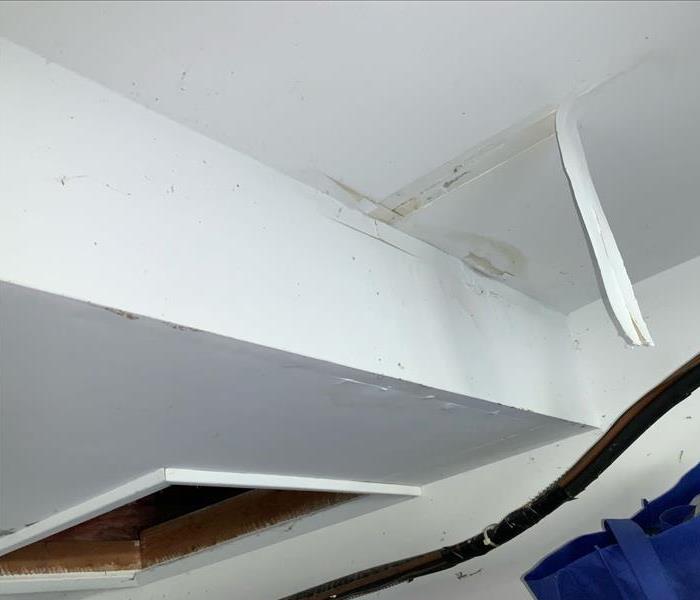 Contact us today for any ceiling water damage repairs!
Contact us today for any ceiling water damage repairs!
Ceiling water damages need to be mitigated quickly.
One night you're at home resting in the living room with your favorite beverage, having a relaxing, lovely evening. As you lay back against the sofa, stretch out a little, and raise your eyes to the ceiling, and notice a bulging, brown patch on your white ceiling.
Your first thought is wondering what the cause could be and how to move forward. How can you possibly get rid of all ceiling water damage? What is the correct way to deal with a water damaged ceiling?
If you are currently in this position, then this blog post is for you. The Blue Ridge water damage professionals at SERVPRO have the answers to all of your questions. Read on!
5 steps to mitigate ceiling water damage
By following the following five steps, you can minimize any water damage caused by a leak and move on to the restoration process. Mitigation happens before restoration takes place. Check out this post to learn more about the difference between mitigation and restoration.
The five steps:
- Step 1: Prevent Further Damage
As soon as you notice the ceiling water damage, remove the furniture from the damaged area and place a bucket or bowl on the floor to catch the water.
- Step 2: Search for the source
Once that situation is stabilized, identify the leak's source. Is it coming from inside or outside the house? The timing of the leak is a good predictor of its source. If the leak only occurs when it is raining outside, then that is a clear sign that there is a roof leak.
Leaks that arise continuously indicate that the leak originates from inside the property. Depending on the source, you might be able to stop it temporarily.
After the leak's source has been located, you will want to ensure that the leak does not become a recurring issue. Stopping the leak may mean calling a local roofing contractor to perform roof repairs or calling a plumber to perform pipe repairs.
- Step 4: Remove the Damaged Materials
Once the source of water damage is fixed, it is time to remove all the damaged material. Keep in mind that wet drywall can crumble; it is best to put down a plastic sheet to collect all the waste. All damaged materials should be placed in plastic bags for the trash.
- Step 5: Dry out the water damaged ceiling
The last step in the mitigation process is to dry out the water damaged ceiling. To properly dry out any size water damage, you will want to get help from IICRC certified water restorers. The accredited professionals will use advanced drying techniques to ensure your property is dried correctly.
Avoiding mold damage
It's essential to call an expert as soon as you detect ceiling water damage because the sooner a specialist comes to assess the issue, the sooner the water damage issue will be fixed. Mold growth is typical when water is not adequately removed.
Mold growth can start in the first 24-48 hours in ideal conditions that include moisture. If left untreated, mold will quickly spread throughout your house. Here are two signs of mold growth.
- Musty odors (Mold will have a powerful, musty smell around the damaged area.)
- Visible mold growth (Brown, dark-green, or black)
Address the situation calmly
Ceiling leaks aren't fun, but you don't have to be distressed when they happen. When you have the proper knowledge, you can confidently take complete control of the problem and quickly develop a solution. Panicking will only slow things down, and you will not be able to temporarily fix the problem until professional help arrives. With that being said, it is best to address the situation calmly.
When to call SERVPRO
When a disaster occurs, one can only do just a little without the proper knowledge; It is always wise to seek professional help as soon as possible to avoid secondary water damages. The faster you get an expert's assistance, the faster you'll get rid of the problem.
The professionals at SERVPRO are insurance preferred water restorers that have been serving Blue Ridge customers since 1967. If you want your everyday life to be normal again after you have suffered damage from leaks in your ceilings, then SERVPRO is the most reliable option for you.
4 Distinct Ways To identify Hail Damage
3/26/2021 (Permalink)
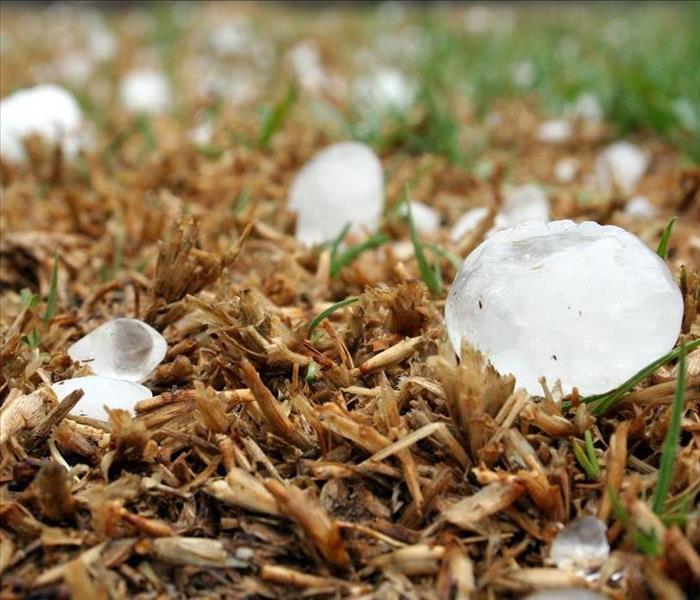 The larger the hailstone the more severe the damages to your property will be!
The larger the hailstone the more severe the damages to your property will be!
Hail damage affects many Georgia homeowners
In the US alone, high-speed winds and hail cost $15 billion last year. Hundreds of homes were destroyed causing many homeowner’s insurance claims. It is important to understand what to do when your property is affected by hail damage because hail damages affect just about everything exterior; your windows, siding, and roof are all susceptible to hail damage.
When inspecting hail damage, you may notice that some hail damage is apparent, such as a broken window or a dented vehicle. Although, other kinds of hail damage are unnoticeable and require a trained professional eye to detect. When you suspect that your property has had hail damage, you will need to have a hail damage inspection to determine the extent of the property damage. A professional will inspect all of the exterior parts of your property and provide an action plan to continue with any necessary repairs.
How does hail cause damage?
Hailstones can cause significant damage to houses, depending on the speed and size when they fall. Hail damage is one of the most common causes of a homeowner's claim every year.
The growing popularity and the use of vinyl siding for house exteriors is one of the reasons for an increase in these claims. Vinyl siding's lightweight design, built to survive high winds, allows it to withstand most weather conditions. However, when massive, fast-falling hailstones strike the panels, the panels will chip or crack. Even minor hail storms may cause significant hail damage to the siding.
One of the more challenging types of hail damage to detect is roof hail damage. Roof hail damage is challenging to detect because it is not possible to see from the ground level. When a roof has hail damage, a home will be prone to roof leaks, water ingress, or shingle deterioration.
4 Ways to identify hail damage
There are some methods for determining whether or not to file a claim after a hailstorm. When it's safe to step outside, pay attention to the following signs that your house has been damaged:
- Downspouts and gutters that have been dented.
- Siding and window sills with buckling, dings, warping, and dents.
- Substantial or irregular gaps across or between siding layers.
- Damage to your patio cover or a wooden deck.
What can hail damage?
You may see hail damage in the form of dents on a home's exterior, but it is not the only kind of hail damage there is. Like the shape, the damage can come in several different forms.
The size of hail damage will cause:
- The size of a quarter: Little exterior damage.
- Half Dollar: Minor damage (Cracks)
- Walnut: Dents wood, severe roof damage.
- Golf Ball: Major exterior damage.
- Tennis Ball: Severe damages to roofing, siding, and breaks windows.
Does insurance cover hail damage?
Homeowners insurance will typically cover hail damage to the roof and other parts of your home. Hail storms can strike just about anywhere in North Georgia. If your home has been damaged by hail, you should seek professional help to determine the damage before filing a claim. The professionals at SERVPRO can help you check your policy for coverage restrictions and submit a homeowners insurance claim.
SERVPRO hail damage professionals
Flood and storm damage can be extremely costly. You need to act quickly, and you need a company that has dealt with all types of storm damage. In the industry, SERVPRO is a renowned company, and it has been serving the clients of North Georgia since 1967. If you want your everyday work life to be normal again after you have suffered hail damage, SERVPRO of Union, Towns, Fannin & Gilmer Counties is the most reliable option for you.
Our SERVPRO IICRC certified team is fully equipped with state-of-the-art tools and has over 20 years of experience restoring storm damage. Your property will be back in a "pre-disaster" state in no time. We offer 24/7 emergency services, meaning you can contact us at any time you need assistance!
What Causes Soot Webs On The Wall?
3/15/2021 (Permalink)
 Contact the professionals at SERVPRO before trying to clean soot webs on your own!
Contact the professionals at SERVPRO before trying to clean soot webs on your own!
After a fire breaks out, you may be left with soot webs.
Fire disasters can cause devastating consequences, and it is crucial to understand the impact of smoke damage. All fire damages result in smoke and soot damage. Soot consists of carbon particles that are released as a product of incomplete combustion.
When there is a fire, the heat moves towards cooler surrounding areas as a phenomenon of atmospheric equilibrium. Thus, enabling the smoke and soot particles to circulate along with air to spread around the entire space.
High vapor pressure forces these particles into closed and sealed spaces, creating newly formed soot chains, known as soot webs or soot tags. The development of soot webs may look like an initial consequence of prior existing spider webs, but that is false. Soot webs are formed entirely as a consequence of a fire disaster.
What Are Soot Webs Made Of?
Soot webs are created as a product of improperly combusted carbon particles following a fire disaster. The development of soot webs is facilitated by air motion and thermal equilibrium. These soot webs resemble spider webs, except they form immediately after a fire, they appear darker, and they have a strong odor of oil present.
How Do You Clean Soot Webs?
Soot webs can range from light to heavy and are often detected as dust that reappears even after being vigorously cleaned. It is noticed on hands as charcoal would when touched. Soot smears on the surfaces of walls when touched. Additionally, soot produces a lingering smell of smoke.
The cleaning of soot webs can be a highly challenging and daunting task. The first thing to do is to open doors and windows to ensure that there is sufficient ventilation. Turn off all fans and air-conditioners to prevent the spread of loose soot dust within the vents.
To clean soot:
- Wear a multilayered face-mask or a respirator to avoid breathing in soot particle deposition.
- Effectively remove furniture uncovered in soot to prevent unnecessary deposition and contamination that could occur while the soot webs are cleared.
- Begin the soot cleaning by vacuuming in and around the walls and surfaces covered in soot or soot webs. This will eradicate the loose dusty soot and leave the adherent particles intact.
- Follow this step by wiping the area with a special chemical sponge.
When to contact SERVPRO
Cleaning soot webs calls for attention to urgent damage restoration by professionals to efficiently clean up these soot webs and clear up all closed and sealed spaces. Soot adheres to multiple surfaces and is notorious for leaving permanent stains if not tended to immediately.
The entire process is tedious and can be extremely hard to manage without adequate equipment and training.
The professionals at SERVPRO specialize in damage restoration and cleaning up of all devastating consequences following a fire disaster. The highly trained workers at SERVPRO will make sure to restore your place in a good-as-new condition.
Contact us today if you have any questions about our soot web cleaning process. We are available 24/7 to answer your questions!
Is Your Business Prepared for a Fire?
3/14/2021 (Permalink)
How prepared are you? Do you have a fire escape plan for your business? A fire can spread quickly, leaving only minutes to escape. Having a plan in place prior to an emergency will allow you and your employees to exit quickly in the event of a fire. We at SERVPRO can help you plan for a fire or other emergency by creating an Emergency Ready Profile (ERP) for your facility. The ERP is a comprehensive document containing critical information about your business, including: emergency contact information, shut-off valve locations and priority areas. The ERP is a no-cost assessment. All it requires is a little time, making it a great value that could save a lot of time in the future. Call us at 706-896-1880 or 706-273-7776 to schedule an appointment to begin your ERP.
Its the Small Things
3/9/2021 (Permalink)
Have you ever heard the old adage that great things come in small packages. I believe that’s true. In fact, most of the time, it’s the small things that make life so very special.
As a marketing rep at SERVPRO, I find it’s the small things that make this job so great. Riding in the Christmas parade and seeing all of your friends waving back at you is not a grand and huge undertaking but it surely is fun! Decorating a Christmas tree at the Chamber of Commerce is not a huge deal, but it gives you a great sense of satisfaction when it’s done.
This week I had the opportunity to perform a very small task but it gave a great sense of accomplishment to many folks and for me completed another satisfying day at the job. I took a ride yesterday and delivered Continuing Education certificates to the participants of our 2 classes this past month. When I walked in the door with an envelope, they immediately began to smile because they knew what I had for them. And each of them were so complimentary and gracious in their remarks about SERVPRO and how appreciative they were that our company believes in reaching out beyond our “walls” and providing this service.
And so thank you SERVPRO for giving us a great opportunity to provide for our insurance agents. Thank you for the opportunity to build into our community and to make it better! Thank you to our team who made this possible – our crew who set up, our operations manager who was instrumental in paperwork, etc., our franchise owners who are always behind this great task and our instructor who hit a grand slam.
After all, it’s the small things.......
It's a Beautiful Day in the Neighborhood
3/9/2021 (Permalink)
It’s a beautiful day in the neighborhood, a beautiful day for a neighbor. Would you be mine? Would you be mine?
There was a movie created that celebrates the life and legacy of Mr. Rogers. It’s starring Tom Hanks and my understanding is that he does an outstanding job representing this kind and gentle man who built his life into our children through the wonderful avenue of television. While I’ll even bet that the jingle is still playing in your mind and you hear the train whistle and bell clanging as it rounds the corner.
While we think of the music, the sweater, the tennis shoes and the train coming around the bend, we can also think of our company, SERVPRO of Union, Towns, Fannin and Gilmer counties. After all, I believe that’s why we are in business. Day after day, we receive multiple calls asking us to rescue those who are in need. Sometimes it’s dealing with water, flooding, frozen pipes, and mold and then sometimes, it’s dealing with the heartbreaking losses of fire and smoke damage. I’ve experienced this trauma myself and can speak firsthand of the devastation that goes with it and I would never wish that on anyone. Many people look at it as a job where I see it as a ministry. Along the way of reassuring our customers that they are in excellent hands we can even make it "Like it never even happened." And we can encourage them emotionally and spiritually as well. Isn’t this a great job?!
So I’m starting my day with a little jingle, “please won’t you be my neighbor?”
5 Important Questions To Ask When Choosing The Right Restoration Contractor
2/26/2021 (Permalink)
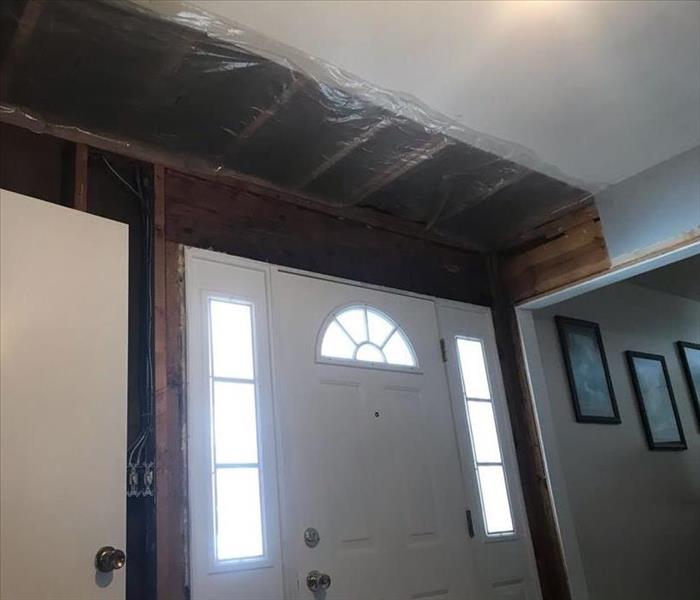 Contact the restoration contractors at SERVPRO!
Contact the restoration contractors at SERVPRO!
Not all restoration companies are the same.
Have you recently undergone water damage at your property? To be safe from getting the run around from many restoration contractors, there are specific questions you can ask for picking out the perfect restoration contractor for services. In order to get long term results, your service provider must be detail-oriented and certified. Your main goal should be to hire a company that can quickly repair the damaged area of concern and get rid of the source of the problem to avoid a future loss.
The following questions are designed to aid you in picking out the perfect service for water restoration:
Is the restoration contractor qualified?
You need to be well aware that many contractors take as many jobs as they possibly can. They hold making money and their business profit margins at a greater value than delivering high-quality work.
Ensure that your restoration contractor is the best at their job and are reliable.
Please do your homework about them beforehand. Carefully examine customers’ past experiences with them. Look at their portfolios, paying attention to testimonials and reviews from past clients. You can also go further ahead by requesting a customer list of references so that you can get in touch with them directly. Every contractor works differently, and you ought to always pick out the best company for your home or business water damage repairs.
Can the restoration contractor handle all of the repairs?
Just like any other service provider business, every company that delivers restoration services may not be able to cater to every issue regarding your home insurance claim. Some restoration vendors may only have expertise in water cleanup or fire mitigation services; some might only deal with mold remediation. To ensure the best possible experience, try working with a provider that deals with everything restoration related, from beginning to end. Let us dive into common circumstances a homeowner would find themselves in:
Roof Leaks
Several situations, sometimes natural, sometimes not, can deteriorate a roof. Your water restoration contractor must be capable enough to diagnose and spot the exact source from where the penetration of water is happening. Repairing the problems would include:
- Finding the intrusion of water and take care of the leaking roof
- Inspecting for damage in walls, floors, or ceilings and take care of any repairs
- Mold remediation services
- Re-insulating walls, floors, and ceilings
- Drywall repairs
When faced with water damage, you should get in touch with a provider familiar with the process and service of remediation. The restoration contractor should also be capable enough to carry out the repairs for home construction efficiently.
Pipe Bursts
A common result of the freezing temperatures can cause a pipe to freeze cold and burst. A pipe burst can result in a home being left with a flood. Pipe burst damages can be massive if they are not looked noticed quickly. Additionally, if the water leak managed to occur on a
the upper story of the house, the restoration damage will be much worse.
Once again, the contractor must have a tight grasp of the following services.
- Repairing the pipes that might be broken
- Inspect for damage to the structure of the home and make required repairs
- Re-insulate all ceilings and walls
- Replace and repair drywall
The repairing process starts by first diagnosing, then mitigating the water intrusion immediately. You will want to hire a contractor that is available 24/7 and has expertise in all the services mentioned. In case of a pipe breaking, the 24/7 available contractor can show up immediately, decreasing the repairs’ cost.
Is the restoration contractor within budget?
We are well aware that sudden expenses are stressful. One might need to take out money from a savings account. The best-case scenario is that your insurance company will handle the cost. The restoration contractor you choose should have experience working with insurance claims to ensure you get what you desire.
Does the water restoration vendor know mold remediation?
It is possible that the water damage claim will require mold remediation. However, if mold remediation is required, it should be ensured to be done thoroughly. Things will continue to get worse if the restoration contractor is not competent enough to diagnose the origin or fails to remove the mold growth effectively.
It is best to ensure that the restoration contractor you choose has experience dealing with a mold infestation. An IICRC certified mold specialist will know the meat remediation practices so that the mold is not exposed to any other areas of the property.
Is the restoration company detailed-oriented?
Getting repairs to your home or business requires top quality service. The company hired to perform the job for you must be very detail-oriented. The restoration service should ensure that all risks are eliminated.
Hire the restoration professionals at SERVPRO
The professionals at SERVPRO of Union, Towns, Fannin & Gilmer Counties have all the qualifications and certifications. SERVPRO will deliver detailed-oriented work no matter what kind of restoration services you may need. SERVPRO is a preferred insurance vendor known to provide high-quality work “Like it never even happened.”
Common Damages Caused by Wind in North Georgia
2/12/2021 (Permalink)
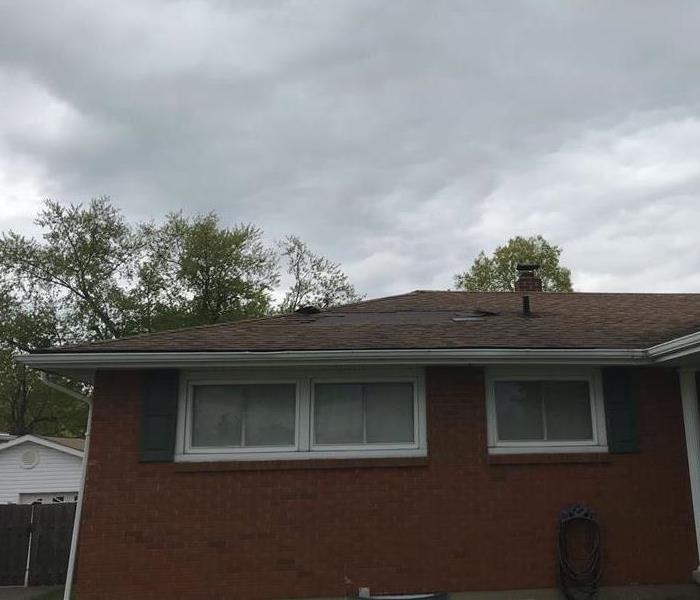 Contact the SERVPRO storm damage professionals today!
Contact the SERVPRO storm damage professionals today!
Damages to our property will depend on how fast the wind is blowing.
For homeowners insurance purposes, it is essential to know that the extent of the damage caused by wind is determined by the wind's speed that caused the damage. Wind speed reaching a minimum of 50mph can cause catastrophic damage. Wind speeds that exceed 50-60mph can lead to substantial destruction to the landscaping and a property's infrastructure.
Here' a more detailed break down:
- Wind speed of 45-57mph is considered non-severe and is associated with slight damage. These wind speeds can break tree branches and cause loose shingles to a roof.
- A faster wind speed of 58-74mph is categorized as severe. It can cause damage to trees by uprooting them, rip off shingles and lead to a damaged chimney.
- Wind speed between 78-89mph can lead to devastating roof damage in commercial and residential properties buildings.
- Wind speeds that exceed a speed of 90mph will cause severely significant damage.
Some of the most common damages are associated with winds faster than 50mph and include the following:
- The uprooting of trees inevitably ends up blocking roadsides and making it nearly impossible to drive on the roads safely.
- Broken tree trunks and debris fly with tremendous energy and impact housing structures and vehicles along the way.
- Significant rooftop damage
- Broken chimneys, windows, gutters, collapsed exterior walls, and blocked drainage systems causing water ingress.
- Damaged air-cooled condensing units and outdoor heat pump units.
What is wind?
Wind is known as the movement of air. It is further categorized into a few other types based on their speed, the type of forces that cause them, and the location they occurred. A faster and stronger wind is associated with a great degree of damage. Infrastructure damages caused by wind can impact roofs, decking, exterior structures, gutters, drainage systems, vehicles, etc.
Gutter damage caused by wind
Wind can cause some degree of damage to gutters, especially to gutter systems that are improperly installed or old. Their shape, angle, and vertical alignment enable them to easily pop out of place. Windblown debris can further blow into the gutters with incredible velocity and cause impact, leading to impairment. Furthermore, larger objects and broken tree trunks can contact the gutter system and dislodge the gutter.
Vehicle damage caused by wind
Damage to vehicles is also commonly seen in storms with strong winds. The damage to the vehicles is generally due to falling bricks or roofing tiles from high wind speeds. Sometimes, a flying tree branch, an uprooted tree, or a detached electrical pole can fall and cause significant harm to the vehicle.
Roof damage caused by wind
Significant rooftop damage is the most common structural damage caused by strong winds. The rooftop damage can be caused primarily by the wind and aggravated by other associated factors such as broken tree limbs, detached billboards, and electrical poles. Rooftop damage is identified by missing shingles, dislodged roofing systems, and punctures in the roof.
SERVPRO storm damage professionals
It is crucial to fix damage caused by storms as soon as possible to lessen the probability of permanent damage and to avoid secondary damages. The professionals at SERVPRO of Union, Towns, Fannin & Gilmer Counties provide a highly trained team with excellent resources that can cater to any size of the damage and will resolve and reverse the damage done.
What To Do When A Concrete Water Tank Leaks
1/29/2021 (Permalink)
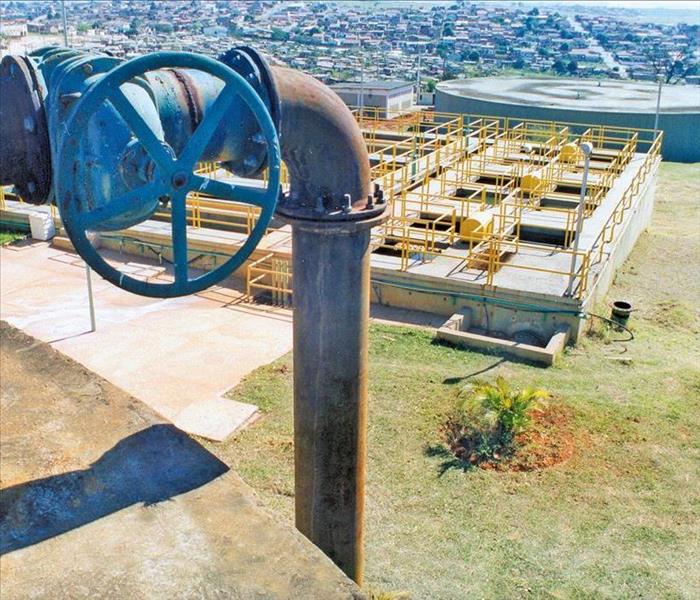 Call the water damage professionals at SERVPRO when your commercial property is hit by water damage.
Call the water damage professionals at SERVPRO when your commercial property is hit by water damage.
Your commercial property is at risk when a concrete water tank is damaged.
Concrete water tanks have become famous due to their cheap building materials and accessibility. However, durable concrete might be, it can’t last forever. When leaking concrete water tanks appear, you’ve got a problem on your hands.
Small leaks can cause more significant damage if they’re left unnoticed and unattended. They can increase in frequency or cause larger leaks.
Leaking concrete water tanks in commercial buildings waste large amounts of water and can increase the company’s costs. If you want to avoid such problems, seek professional help as soon as there’s a water problem. Any sign of a leak is enough to contact a professional, so you avoid the additional costs associated with the leakage.
What is a concrete water tank?
Concrete water tanks store water. The design is dependent on where the water is stored; for example, underground and above-ground tanks have different structures.
These tanks come in various shapes and sizes, but most are rectangular or circular. Elevated tanks sit high above the ground, and underground tanks reside in the building’s base.
All concrete tanks are tough and durable. Leaking concrete water tanks are a problem that requires immediate attention.
Concrete water tank damage
Over time a concrete water tank can develop various cracks. These cracks could result from the concrete contracting in extreme weather or the shifting of the tank.
Cracks are one of the significant causes of a leaking concrete water tank. The leak will cause the water to drain away, and there’s a chance for bacteria to build in the crack. This water could become dangerous, resulting in significant health problems.
A professional repairs cracks through a cement liner and patch.
Fixing the leak
These are the steps the SERVPRO professionals take to solve your leaking concrete water tank issue. These will help prevent further damage:
Step 1. Measure the tank
Firstly, we measure the concrete water tank before repair. This measurement affects the size of the tank liner.
Step 2. Unload the tank
It is crucial to empty and clean the water tank before repairing the leakage. Once no water remains, we will check whether there is any dirt or cracks in it. Experts will remove loose concrete or debris instantly. There will be time given for the tank to dry, and nobody should put tools directly into the cracks.
Step 3. Repair the first layer
Once the tank has dried, a concrete binding agent will be brushed on the first layer, focusing on the affected area around the crack.
Step 4. Create the cement solution
A concrete solution is made and applied to the walls of the tanks. The cement solution will have a moist, dirt-like consistency. We will check if cement is sticking to the surface—this is a crucial part of repairing the leakage.
Step 5. Fixing liner into the tank
In this step, the tank’s exterior is coated with epoxy, and the liners are installed inside. These linings help the water from being polluted with bacteria. They also extend the life of your tank and prevent leaks and erosion.
Step 6. Final step
The final step in repairing the leaking concrete water tank is adding holes in the concrete walls, injecting the epoxy, and letting it dry. This process reinforces the liner’s edges and provides a perfect finish. After this, refill the tank without leakage.
Commercial restoration professionals
Leaking concrete water tanks have the potential for creating larger water damage issues. Quick action will ensure that you minimize the risk of more extensive repairs down the line.
Whenever your property suffers water damage, there’s a risk of mold, bacterial growth, and more significant structural damage.
Whatever hazard hits your business, SERVPRO of Union, Towns, Fannin & Gilmer Counties is here for you. At SERVPRO, we have professional IICRC certified restoration technicians who will provide critical support and mitigate water damage, including leaking concrete water tanks. Efficient and fast clean up is crucial. Our commercial restoration specialists can help your business get in pre-disaster condition and fully operational.
What To Do When A Sink Trap Leaks?
1/27/2021 (Permalink)
 Common kitchen water damages are caused by sink trap leaks.
Common kitchen water damages are caused by sink trap leaks.
A leaking pipe can be tough to navigate; let the professionals help
The pipe below your kitchen sink is called a sink trap. The purpose of a sink trap is to allow the water to flow and reach the sink tap. However, these pipes can easily cause water damage to your entire kitchen when not properly maintained. The good thing is that these pipes are designed to be easily changeable to keep you from suffering from a pipe burst or sink trap leak.
In this blog post, you will learn the importance of fixing a leaking sink trap and the common causes why a sink trap may leak.
A leaking sink trap can cause severe water damage
The leakage of a sink trap isn't similar to the leak from the pressurized water pipe. A leaking sink trap can cause major damages unless you notice pooling at the base of your cabinet early on.
If a sink trap leak goes unnoticed for a long period, it will increase your water bill. An expensive water bill is not the only thing to worry about; if you do not notice the leak quickly, it can cause mold growth.
Mix water damage with mold, and you can be certain that there will be structural damages to your home showing in the form of discoloration and stains. Be mindful that structural damage can decrease the value of your home as well.
Common causes of sink trap leaks
The most crucial thing when dealing with a leaking sink trap is to know the primary cause. Here are some common causes of a sink trap leak:
If a P-Trap causes leakage, it probably is due to a loose connector that needs tightening. If this is the case, you need to get the appropriate size wrench and tighten the loose connection.
Another common cause of a sink trap leak is the displacement of an O ring. Sometimes, the O ring moves out of its correct position, causing a leak. If the O ring happens to be out of place, then unscrew the two joining pieces and place them back together and ensure that the O ring is in the right place. Follow the same process if the O rings are worn out. Unscrew the trap and replace the old O ring.
Plumbing systems that haven't been maintained for years might be affected by rust or corrosion. Rust and corrosion can eat away the pipes and cause a sink trap leak.
Sudden changes in the extreme water temperature can cause the water pipes to expand or contract. These radical changes from too hot to too cold can result in the pipes cracking, which will lead to water leakage. In such a case, make sure your sink traps are prepared for unexpected temperature changes.
Excess water pressure can destroy your water traps and eventually your house. If your traps are being strained with a pressure they can't withstand, they will leak. Contact a plumbing professional to help lower the water pressure to your property.
Call the water damage pros for water damage repairs
If you happen to wake up one morning and find water on your kitchen floor, you need to call the professionals at SERVPRO ASAP! SERVPRO understands the worry and distress a water leakage can cause.
When an IICRC certified water damage professional shows up to your property, they will start by locating the water damage source and then proceed with water mitigation services. For plumbing issues, they will ensure that the pipes are properly working to ensure secondary water damages don't occur.
SERVPRO of Union, Towns, Fannin & Gilmer Counties is a preferred water restoration vendor that provides the best team of heroes to repair any size water damage.
4 Common Plumbing Problems In Apartments
1/25/2021 (Permalink)
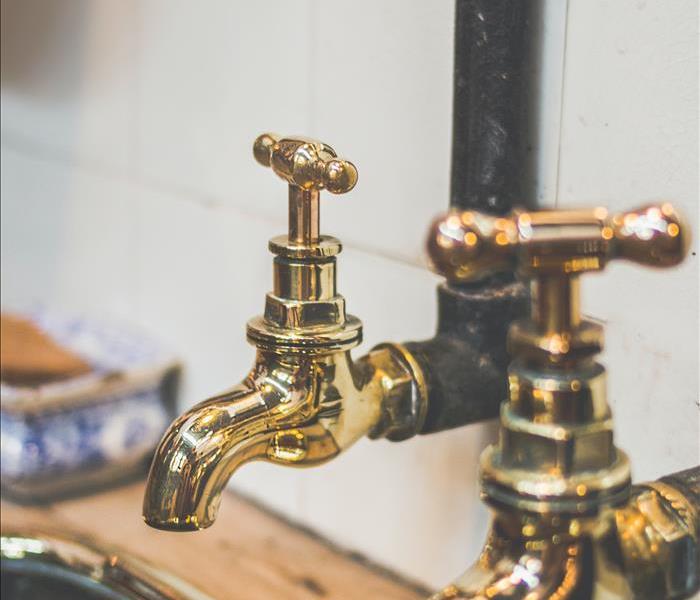 An apartment can be damaged by faulty plumbing in a matter of minutes!
An apartment can be damaged by faulty plumbing in a matter of minutes!
In short, older apartments are more susceptible to plumbing problems.
A sound plumbing system is one of the most overlooked aspects of a properly functioning home. It's one of those things that people take for granted until there's a problem.
Plumbing problems appear anywhere, whether you're living in a house or an apartment.
This article is about common plumbing problems in apartments. Although they are possible in all apartments, older apartments are at a higher risk of occurring.
Signs of plumbing issues
Being on the lookout for plumbing issues is essential for anyone occupying a home, but property managers and owners have more skin in the game.
Renters have the luxury of calling someone else. Property managers and owners call SERVPRO.
The most common sign of a plumbing issue is an altered flow rate. Weak streams can indicate problems with seals or joints, and if the flow rate stops altogether, you have a clog on your hands.
Other signs include water leakages. These can show up as wet spots on your walls or as collected water on the floor.
Plumbing problems in apartments occur in greater frequency in older units because there is more time for seals to rupture or sediment.
What's worse, the proximity to other units creates a hassle for multiple occupants.
4 common problems
Here are some of the most common plumbing problems in apartments that you might encounter. This list will help you identify what might be happening on your property so that you can take steps to remedy the situation, including calling IICRC certified specialists.
1. Poor drainage
One of the biggest plumbing problems in apartments is the clogging of drains that leads to water backing up. This issue usually happens due to some residues blocking the drain, such as soap, bathing products, or hair. Another cause of blockage is grease from the kitchen going down the sink.
You can quickly fix this issue yourself at home in one of two ways. You can use a drain snake to break the clog or use a liquid drain cleaner to clean your sink. Carefully follow the included instructions; if these don't solve the problem, contact SERVPRO.
2. Clogged toilets
Clogged toilets are another pretty common plumbing issue that you are likely to experience in your apartment. Clogged toilets are very similar to clogged drains— materials block the pipes.
To fix this, use a plunger with a flange to cover the bottom bowl of the toilet. Push air into the pipe through the flange of your plunger and keep repeating it until you loosen up the clog. Then flush it several times to ensure the clearance of the pipe.
Be careful: this process may cause contaminated water to push back out. If the dirty water overflows and you can't stop it, make sure to call a water remediation company.
3. Rattling pipes
Rattling pipes are a problem that is quite frustrating—your pipes should be reasonably quiet, even with water rushing through them.
These noises commonly occur after you shut off the valve. The banging noises are made when the flow of water changes direction and creates a shockwave, generally caused by high water pressure in the pipes.
In the case of older buildings, the irritating noise is made through the flooding of air chambers.
Poor pipe design can also cause this. Pipes weaken over time, and the spaces created by shifting seams can make noises and result in water damage and even bursting of pipes. In such a case, you will need to contact a water damage restoration company like SERVPRO.
4. Low water pressure
Another one of the most recurring plumbing problems in apartments is low water pressure. It can affect everything from taking a shower to washing dishes.
Apartment buildings face this issue quite a lot due to the blockage of the aerators. The first thing a professional will do is check if both the hot and cold water valves are working. If they are not, they will remove the aerators and clean them. Replacing the aerators can drastically help in improving the water flow.
Plumbing problems lead to water damage
Some of the plumbing problems in the apartments are simple and basic enough to fix yourself, but many complex ones might require you to seek a professional's help. These problems won't only cause annoyance but can also end up increasing your water bill, cause a foul odor, or create a scenario of unstoppable leakage.
Without proper action taken, these plumbing problems can lead to water damage, which has a higher cost and an intense restoration process. Water damage puts your property's structure at risk and can cause mold.
All of this can pose problems for your budget as well as a risk to the health of your property. So, make sure to call the SERVPRO experts to inspect all the plumbing problems and fix them before the job turns into a water damage disaster. SERVPRO is a preferred water damage vendor for many of the major insurance companies for a reason. Contact the certified water damage professionals today!
Water Ingress In Buildings After A Storm
1/19/2021 (Permalink)
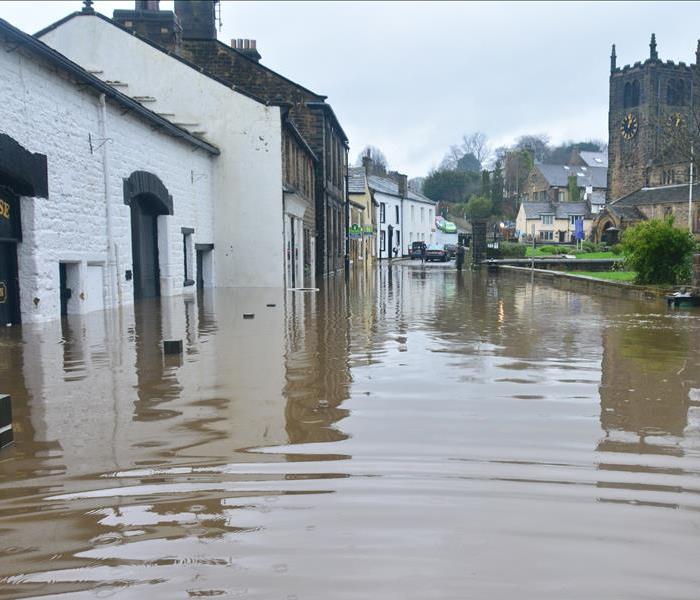 Storms can cause water ingress
Storms can cause water ingress
Call SERVPRO when outside water makes its way indoors!
SERVPRO is a leader in disaster restoration. Our services include water damage, fire damage, and mold remediation.
Water damage can occur for several reasons, including burst pipes, broken appliances, and flooding from natural disasters.
One of the most common types of water damage calls we receive after storms is called water ingress.
What is water ingress?
Water ingress, also known as penetrating damp, is when water from outside infiltrates a property. It happens for various reasons and ways.
Put another way, whenever water passes through walls and comes inside the property, it’s water ingress.
Water making its way into your building or house is something to worry about because it could result in damage and lead to expensive and further problems.
The damage can include fungal decay, destruction of the decoration, and long-term mold issues associated with dampness. These can have a negative and drastic impact on your health and lifestyle; therefore, preventing water ingress is crucial. The solution? Contact a local water ingress expert like SERVPRO.
Causes of water ingress in buildings:
There are several reasons for water ingress. Here are some of the most common:
- Damaged Walls - deteriorated wall results in seals between mortar and brickwork becoming porous; this allows water through the wall, otherwise known as water ingress.
- Defective or leaking drainage - cracked, blocked, and defective downpipes with faulty seals are one of the main reasons for penetrating damp and water ingress.
- Roof damage - Any missing shingles or defective seals will allow water ingress. Roof maintenance and inspection are essential in identifying broken or missing tiles or seals to prevent this water entryway.
- Leaky basement window seals - if there are broken or damaged seals around basement windows, the waterproofing capabilities are diminished, and water will likely ingress into the building.
- Flash Flooding - If your residency is in an area where floods are common, then the large volume of water is a common factor for resulting water ingress
In short, defects in the building, such as cracks, put your property at risk of water ingress. Water ingress risk increases with a large volume of water from flash floods or storms.
Where can water ingress?
Water ingress in basements, cellars, and roofs has the greatest chance of occurrence in any property.
If you’re going to assess where water ingress has a chance for developing on your property, you should look at these common signs:
- Plaster peeling off the wall
- Damp, musty smell in the attic or basement
- Mold growth on any wall
- Damp patches on any wall
- Visible water in basement or attic
Type C waterproofing systems are widely known and used to drain out the water safely from the property. If you suspect your waterproofing system is damaged, contact a waterproofing specialist like SERVPRO. We deal with all kinds of queries and are here to serve and assist you.
Water ingress mitigation
In mitigation, you first need to assess the situation. The most crucial stage to treat the water ingress is to check the dampness and determine the water’s source. After the assessment, professionals must remove moisture and water from your property from both the structure and air itself. The last step of the mitigation process is the restoration and sanitation of the property to return to a healthy and safe condition. Trust the professionals at SERVPRO to determine the cause of the situation and provide the necessary steps for repairs.
Regular checks will help ensure that building defects will not be hazardous and stop the water from making its way into the property. Efficient and fast clean up is crucial; we have water ingress mitigation specialists to help your business get in the pre-disaster condition and become fully operational again.
Suppose you’re struggling with any damp related issue or water ingress. In that case, SERVPRO is the preferred water restoration vendor for many insurance companies. They will help you diagnose and identify the solution so you can be free from water ingress and dampness-related issues.
Water mitigation is an essential part of restoring your property. Address any water damage signs as soon as you spot them—this will save you from long-term hassles, time, and further costs. SERVPRO specializes in drying, cleaning, restoring, and sanitizing your property. Contact us if you’ve noticed water ingress at your office, business, or home. We are here to assist you!
Does Homeowner’s Insurance Cover Wind Damage?
1/18/2021 (Permalink)
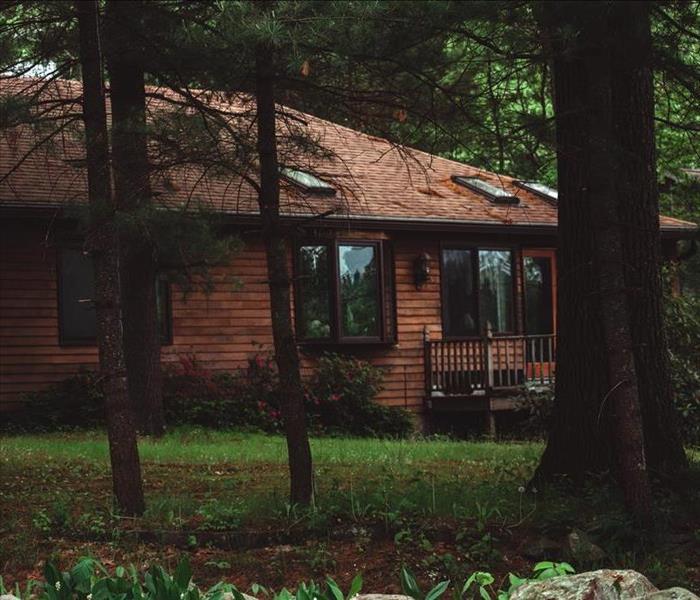 High winds can cause trees to fall on your home.
High winds can cause trees to fall on your home.
Properties in Blue Ridge GA Are Susceptible To Wind Damage
Among all the extreme weather events, high winds are at the forefront of Blue Ridge’s weather challenges. A report that counted weather events from 1950 to 2010 shows how thunderstorm winds and hail winds have remained a source of great distress for its residents over the decades. In Blue Ridge, wind damage mitigation is a service used to identify wind damages to property structures.
While high winds and gusts of cool air are a blessing in stifling Georgia summers, they can quickly turn into something far damaging in adverse weather conditions. Your property and the wildlife around you are at risk when you are facing severe wind currents.
Before we get into the technicalities of homeowners insurance and how SERVPRO can mitigate wind damage to your property, there are few things that you need to know about wind damages.
What Damage Can Wind Do?
Your Blue Ridge house can suffer a varying degree of damages depending on the speed of the winds. Roofing is the first sign of wind damage. After non-severe winds (ranging from 45 to 57 mph), you may notice loose shingles. Wind damages become severe when their speed exceeds the 58-mph mark. The structure of your property will go beyond a few loose shingles at extreme wind speeds. High winds can rip off perfectly fitted shingles as well as uproot the trees around your house. The damages up until winds at 58mph are still sustainable, but higher wind speeds will result in hefty repairs.
How To Identify Wind Damage?
You can hire a professional at SERVPRO to inspect your roof for any wind damages though there are clear indicators that will show you whether your roof is suffering from wind damage or not.
- Chimney damages: Chimneys can show clear signs of wind damage when there are missing pieces.
- Roof Damages: Clear signs of roof damage are curling, peeling, and loose or missing bits and pieces from your roof.
- Siding Damage: Like roof damage, siding damage will show peeling and loose or missing bits and pieces from your property's siding.
Depending on your house’s roof type, you’ll have to look for different materials missing from your house's structure. Common home materials in Blue Ridge, Georgia, include shingles, bricks, and asphalt. Damaged granules essential for roofs with shingles are often the cause of making them lose their grip. Inspecting drains and ventilation systems for roofing granules might be a good start to identify wind damages in your house’s roof.
Another thing that should be a dead giveaway for roof wind damages is water leakage caused by missing or loose soffit and fascia. Water damages are the precursor of wind damage, especially when your home has ceiling leaks.
SERVPRO Helps With Insurance Claims
Different insurance companies cover different types of house damages in their agreement. There is no standard answer that can be universally applicable for all insurance policies. You need to consult with your homeowner insurance company to determine whether they cover wind damage to your Blue Ridge property.
Almost all insurance policies cover basic house damages, especially those caused by extreme weather events. However, keep in mind that some policies include a clause or two against damages caused by “natural disasters.”
SERVPRO cannot help you with your insurance coverage's legalities, but we can help you file your homeowner insurance claim. Everything you might need from damage estimates, cost of repairs and initial inspections will help you get your homeowner's insurance claim processed quickly.
Your property needs to be inspected and taken care of after a windstorm. Call the IICRC certified professionals at SERVPRO of Union, Towns, Fannin & Gilmer Counties to inspect your property after a severe wind storm to prevent a water damage disaster.
What is the SERVPRO Slogan?
1/14/2021 (Permalink)
 A few months ago, this kitchen had a grease fire; now it's back "Like it never even happened."
A few months ago, this kitchen had a grease fire; now it's back "Like it never even happened."
“Like it never even happened.”
SERVPRO is one of the largest repair and restoration services in the U.S. Our service providers are dedicated to assisting residential and commercial properties to recover from floods, sewage, or other crises. We have almost 50 years of expertise in offering water damage repair and restoration facilities throughout America.
We stay true and adhere to our slogan, “Like it never even happened.” This slogan, kept in mind by every professional we employ, separates us from other service providers. In short, it means we do our services in a manner that would make you wonder, “Did any damage even occur?”
We are fortunate to be employing service providers that express a dedication to innovation and consumer service, all of which are sponsored by our strategic support staff. Our staff is renowned for the utmost commitment to your issue, so you can be confident that we can restore your home from fire damage, water damage, and mold.
What does “Like it never even happened,” mean?
SERVPRO strictly adheres and lives up to our motto, “Like it never even happened.” This motto implies that we strive to make it seem like it was never dirty, like it never overflowed, like it never caught fire, like it never leaked, like it never smoldered – whatever the case, our mission is to make it “Like it never even happened.”
No matter what “it” is.
We live up to this slogan through the use of unique restoration solutions and the following essential steps:
Evaluation
When we arrive on-site, the very first step we perform is evaluating the magnitude of the damage. We then follow up with a detailed plan to thoroughly remedy the situation.
Mitigation of damage
In the first phase in restoring and upgrading, we employ the latest technologies to ensure that the disaster or incident doesn’t cause further damage.
Cleaning of debris
We sweep and remove any debris from the affected area, preparing it for our final step.
Restoration
The restoration method varies depending on the cause of the damage and involves restoring the affected area returning to its pre-affected state, “Like it never even happened.”
Why choose SERVPRO restoration services
When your residential property is damaged by rough weather, water damage, floods, or burning, it is vital to employ a specialist repair service as soon as possible to avoid any significant damage. Fires can lead to structural damage; flooding leads to mold.
Looking for a successful online repair business can be challenging since there is a multitude of distinct companies to pick from online. What makes SERVPRO so unique to be chosen?
SERVPRO is dedicated to professionalism in every area of its service. From making sure our restoration technicians are qualified and fully accredited and keeping ourselves upgraded on the new property restoration methods and technology to deliver superior customer service, we are here for you.
Here are some reasons why SERVPRO is worth your business:
The best level of service
SERVPRO is committed to offering the highest quality restoration services possible. Don’t think about heading to second-rate firms that do substandard work. Our professionals are committed to making it “Like it never even happened,” so you can get your life back. We arrive at your home well trained and well qualified to cope with all the aspects of restoration.
Cost-effectiveness
We will always charge you a fair price for our services—that’s our promise. SERVPRO is committed to transparency by telling you the truth of what we’re doing and describing the rationale behind the billing. We are trustworthy, polite, and our services are competitive for our high-quality service. Wouldn’t you like a service that reaches beyond your expectations?
Knowledge and competence
Our team is individually recruited and encouraged to be the finest they can be. Each employee is trained by the IICRC and available to do any needed restoration work. We recognize that they are also the hallmarks of our company, so we take good care of the environment and well-being of our family.
Prompt
We realize that your time is precious, and that’s why we are clear about our scheduling. Doing this means that we reach our clients on schedule at all times and that we will not leave you hanging.
Dedication to customer service
Our goal is to put positive energy and pleasant attitudes into our successful work; this leads to fulfilled customers. When you’re glad, we’re happy, too. Our company is sure that it will achieve, and surpass, all your expectations as we make your property “Like it never even happened.” We ensure outstanding customer loyalty by doing all we can to fix the problems.
SERVPRO professionals are here for you
SERVPRO workers are much more than just professionals; we are caring and diligent peace of mind providers. We understand that it can be challenging to cope with fire and water damage and that health effects from mold can be frightening. Irrespective of whether you speak to the office workers on the phone or the workers in person, we strive to make every interaction a bit less unpleasant, and the problem “Like it never even happened.”
SERVPRO wants to help you get your home or your business back “Like it never even happened,” as quickly as we can while also offering you the consistency of the final service you expect.
What is Inside a SERVPRO Truck?
1/11/2021 (Permalink)
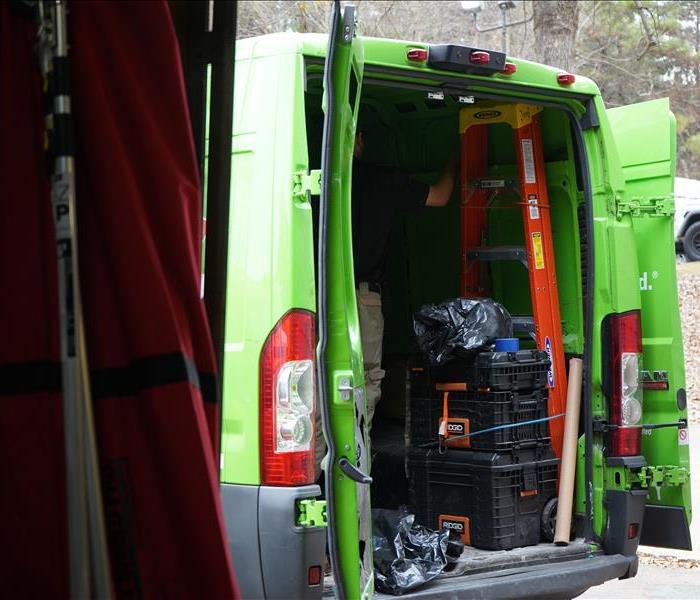 A peek inside a SERVPRO truck
A peek inside a SERVPRO truck
SERVPRO trucks are uniquely designed for restoration services
The top priority of every SERVPRO professional is to return the damaged items and areas and bring them to their pre-disaster condition “Like it never even happened.” Each of our team members is dedicated to restoring the lives and property of our customers.
One of the most important things about our company is the SERVPRO truck. It has various equipment to deal with water, fire, or mold restoration. Our famous extractor truck has a mount extractor. It's one of our top machines as it's compelling and has a 250-foot hose, which enables us to get inside the business or house dealing with water damages. The water extractor helps to carpet clean too, which is an extra benefit to our arsenal. Due to the size of the truck, various items and equipment are easily added if needed.
Restoration is an extremely complex operation, and versatile vehicles are demanded of it. With the help of SERVPRO trucks, we can remove material waste and quickly access tools for various jobs so performed work can go smoothly.
Equipment inside a SERVPRO truck
SERVPRO understands how crucial it is to have the proper equipment to perform any size restoration repair. Our team consists of IICRC trained professionals knowing how to use industrial equipment. Here are common pieces of equipment found inside a SERVPRO truck:
Moisture Detection Equipment:
It involves scoping, which locates the areas affected by water and determines how much the contents and structures have absorbed water. Moisture detection devices enable the insurance that an environment is completely dry. Moisture sensors detect moisture in walls, baseboards, and flooring.
Thermo hygrometers:
Thermo hygrometers measure relative humidity and temperature. These two readings are conducted by a SERVPRO professional to determine specific dew point, humidity, and vapor pressure.
Extractors:
Extractors are used in removing water and cleaning carpets. They can either be portable or truck-mounted, thus enabling greater access.
Air Moving Equipment:
Air movers are used in enhancing evaporation at the surface level and are beneficial in water damage restoration; when the airflow rises, the moisture increases, which is then finished through the dehumidification equipment.
Dehumidification Equipment:
Dehumidification lowers the humidity level and discharges warm, dry air. SERVPRO experts use two types of dehumidifiers, refrigerant, and desiccant.
Deodorization Equipment:
These foggers have an ultra-low volume, which has deodorizing agents that enable an odor-causing to accumulate. The device helps to inject disinfectants and antimicrobials into problematic areas removing any unwanted wall or carpet odors.
Why are SERVPRO trucks green?
SERVPRO restoration crews have been out and about in neighborhoods and helped people recover disasters from mold loss, fire, and water. Our trucks are in green color, and there's a story behind this initiative.
The founder of SERVPRO in the early 1970's determined the most eye-catching color through a color chip paint sample. Choosing the right color for a logo is a well thought out process, and when the founders asked the majority of the people regarding which color cannot be missed, by a vast margin, the most identified color was green.
Conclusion
SERVPRO trucks have proven to provide flexibility, performance, and utility across all restoration divisions. SERVPRO trucks are more than just a place for equipment; they assure property owners that their property will be put together as if the disaster never occurred.
Contact us, and we promise to pull up with our renowned SERVPRO truck and restore the damage caused to your business site or home. You can rely on the preferred restoration vendors at SERVPRO of Union, Towns, Fannin & Gilmer Counties for quality mitigation, restoration, and repairs.
What Are Fire Chasers?
1/4/2021 (Permalink)
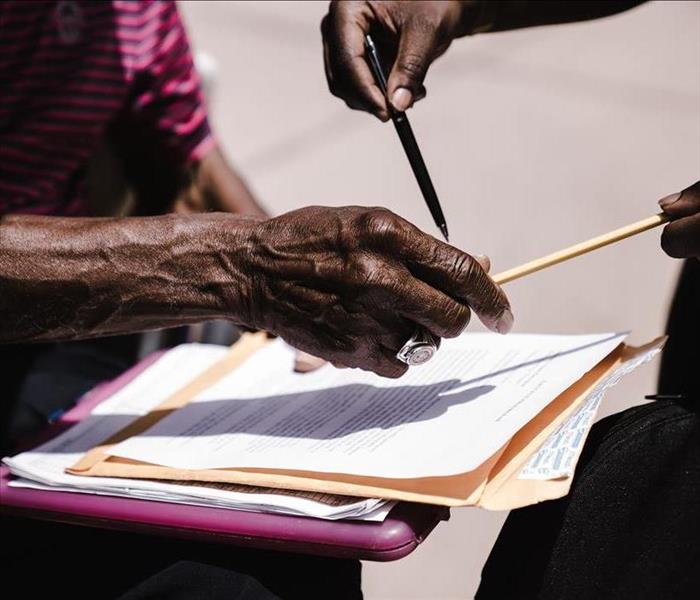 When working with a fire chaser, be sure to know what you are signing.
When working with a fire chaser, be sure to know what you are signing.
Fire chasers chase fires and offer fire damage services
Imagine your business site or home is up in flames. You hope this is all a bad dream as you see all your life's belongings burning away. The feeling of despair clouds your mind. Amid all these emotions, you see random people surrounding your property, thrusting documents, and contracts in your face. You are too bewildered to ask yourself, "Who told them that I have a fire?". Just as you are wondering this, you see another restoration company reaching your site. You are then questioning yourself: How did this happen?
A fire chaser is also known as a first responder. It is a person that possesses extensive experience in dealing with incidents of property loss. Fire chasers belong to a restoration services team that has been notified by a third party that a property is suffering from fire damage. When a fire chaser reaches a fire loss location, they are aimed at convincing the owner of the property, who very likely is worried and stressed, to use them for fire restoration services. Some fire chasers intentionally create an emergency atmosphere so they can get their contracts as soon as possible and sell their service. Fire chasers can have a bad reputation because they are known as clever people who aim to take advantage of people at the vulnerable stage of facing a disaster.
Are fire chasers good or bad?
While there can be many considerable benefits of being a fire chaser, there can also be disadvantages. Fire chasers know one solid fact: they are dealing with vulnerable victims of the disaster. Hence they are known to easily take full advantage of the victims. While the victims are certain that it will require effort, time, and money, they also want to escape this grueling process and get the pre-disaster condition of their property as soon as possible.
We have heard about other restoration companies in Atlanta weaponizing the fear factor by placing shock and panic in the victim, causing them to make decisions that they might not agree with later. At SERVPRO of Union, Towns, Fannin & Gilmer Counties, we do not agree with this method of selling. When you choose us to clean your fire-damaged property, we can ensure you that we will take care of everything and offer you help however you may need it. We know that you are in a vulnerable place; that is why we won't make you feel pressured to decide by signing any documents and contracts until you are certain how you want to move forward.
How do fire chasers get paid?
Cutting to the chase, the pay of fire chasers depends on the situation at hand, and many factors. It depends upon the restoration company that employs them. However, typically, fire chasers are paid on a percentage of the total damage loss. It ranges from 5 percent to 15 percent of the total homeowner's insurance claim money that the restoration company receives for the fire damage repairs.
You can trust SERVPRO
With over 50 years of experience and more than 1,700 franchises nationwide, SERVPRO excels at all restoration services. In times of crisis, you need a company that is faster, possesses advanced technology, and has highly trained certified professionals; this is what SERVPRO offers. Whether the restoration services are required for water, fire, or mold mediation, SERVPRO will give exceptional services with its certified and highly trained team. SERVPRO has years of experience in residential as well as commercial services. Their responsibility consists of being available 24/7 to cater to any calls of assistance regarding property damage incidents. Their vast experience enables them to be equipped with dealing with all extents of all damage. The damage can be of water, mold, or fire. No matter the source of the incidents, you can rely on SERVPRO for their readily-available help with their professional and capable tools.
Contact us and we promise to help you preserve the damage caused to your business site or home. You can rely on the team at SERVPRO of Union, Towns, Fannin & Gilmer Counties to ensure your property will be protected from further damages such as pests, rain, and potential looters after a fire loss.
Is Black Mold Covered By Insurance?
12/29/2020 (Permalink)
 Black Mold Needs To Be Addressed ASAP
Black Mold Needs To Be Addressed ASAP
Your Homeowners Insurance May Cover Your Black Mold Claim
As researchers name it, black mold, or Stachybotrys chartarum, is a tiny mold characterized by its darkened color. It occurs in areas that are damp, moist, or humid. Black mold development can harm structures and entail comprehensive cleanup, maintenance, and extraordinary measures to avoid future development. Black mold spreads quickly throughout a property and causes carpet odors; that is why it's best to get it addressed and removed ASAP.
Mold is a fungus that can be located nearly anywhere in and out of your house. However, certain mold types are deemed dangerous, like black mold, which may contain contaminants that can damage your home's structure. It can cause significant damage to the items in your home as well. Often, owners are protected by mold insurance, but not always. The coverage relies on the policy and what has induced the mold to grow.
Continue reading to find out when your homeowners' policy protects against mold damage.
For years, mold was a very controversial subject in the home insurance sector. When insurance companies or agencies insured mold damage, insurance agencies compensated thousands and thousands of dollars in premiums. Insurers soon found that shielding mold was too dangerous to undertake; thus, most policies now only provide minimal coverage, if any.
Molds created due to immediate and unintentional water damage, such as a burst drain, are usually protected by homeowners' policy. Still, mold formed with time attributable to excessive humidity, leaky pipes, or floods may not be insured by your insurance provider.
Did you know a homeowners insurance policy will not insure damage incurred by maintenance issues or inaction? When the insurance claims that mold development in your house was avoidable or that the mold was in place before, your claim will most likely be rejected.
When Is Mold Damage Covered By Insurance?
Most homeowners' insurance includes mold contamination if induced by a "covered peril." In some conditions, traditional homeowners' policies include mold damage. Suppose the mold is the consequence of a protected risk—like water damage— incurred by unexpected and unintentional accidents. In that case, the repair and cleanup of the mold are expected to be covered by your insurance company. So if you have mold in your house or your pipes spontaneously break, there's a fair possibility that your insurer can offset the expense of repairs.
The estimated cost that the insurer spends for mold claims could vary from 1,000 to 100,000 dollars depending on the amount of damage that is present at the property. While mold can be subject to homeowners' insurance in some cases, coverage for fungus damage is generally limited.
How To Avoid Your Black Mold Claim From Being Declined
You can perform various measures to increase the likelihood of your claim being accepted if you experience mold damage. Mold is often typically found in regions of higher humidity. That could involve leaking water pipes or basements with drainage problems, and equipment hoses, leaky roof.
To prevent mold damage, you can do the following:
- Place dehumidifiers in places that are damp-resistant
- Using air conditioners or dehumidifiers to maintain your home's relative humidity around 30% to 50%
- Address plumbing issues as quickly as possible
- Thoroughly monitor plumbing pipes to check leakage.
- Prevent the insertion of carpets in wet areas
- Keeping the gutters clear to avoid ice jams in the winter that can contribute to leakage
- Suitably ventilate bathrooms, laundry rooms, bedrooms, as well as other parts of your house where mold can have the potential to spread.
- Use fans to guarantee sufficient airflow.
- Properly insulate indoor and outdoor pipes in winter to prevent breakage or leakage.
- Remove stagnant water and other types of water damage.
- Check hoses and valves every week to avoid leakage.
If you have to claim damages of the mold, then:
- Record the damage appropriately with images and video
- Supply your insurance adjuster with an updated servicing report
- Take all directions that the insurance provider sends you to handle the claim.
- Contract licensed mold removal company like SERVPRO to mitigate the damages
Steps To Take If Your Claim Is Declined
If your insurance provider rejects your mold claim, you may need a qualified professional to give a second view about what induced the damage. You can also decide to contest the refusal against the insurance provider if it has a clear appeal policy. If that's not the case, the state insurance agent will be willing to assist with what you can expect to have the claim accepted or to submit a rejection complaint.
SERVPRO Insurance Claim Specialists
Did you know that SERVPRO will help you file a homeowners insurance claim with your insurance company? SERVPRO of Union, Towns, Fannin & Gilmer Counties has over 50 years of combined experience working with insurance adjusters. We have partnerships with many insurance companies and are a preferred insurance vendor. Contact us today for a mold estimate, and we promise to get your property back "Like it never even happened."
How to Trace a Leak in the Ceiling?
12/29/2020 (Permalink)
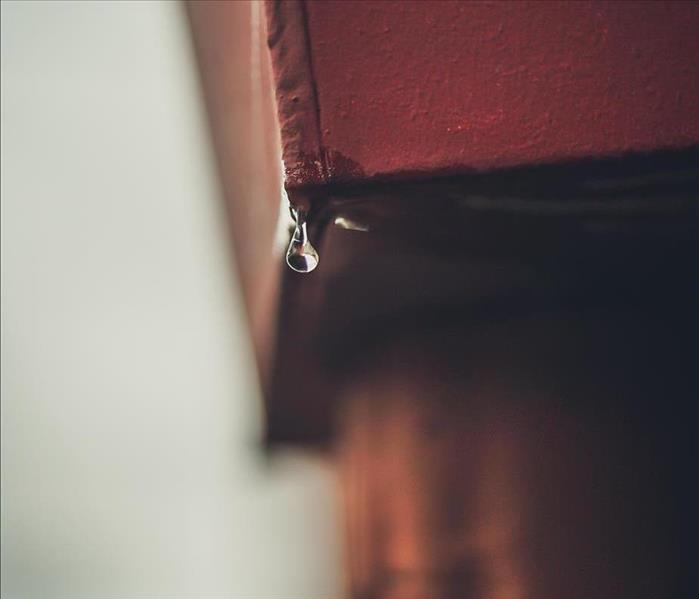 At SERVPRO, we have the technology to quickly locate a water leak.
At SERVPRO, we have the technology to quickly locate a water leak.
Locate the Source of a Water Leak like Pros
An unattended leak in the ceiling can cause significant damage to the structure of a commercial property. While some leaks may be easily traceable, especially when water is dripping, but sometimes ceiling leaks remain concealed and end up weakening the ceiling without a single sign. To avoid severe structural damage, it is essential that leaks are identified early and treated accordingly.
Three ways to locate a ceiling leak
The highly trained certified water damage vendors at SERVPRO have suggested a few simple ways to identify and trace a leak in the ceiling. Here are a few signs that will help property owners inspect these leaks sooner and get them resolved before they cause substantial damage:
One: One of the clear signs of a leak in the ceiling includes discoloration over an entire area. The discoloration will be apparent if the ceiling is white. You may notice that the ceiling paint starts to peel off in a particular spot. There may be blistering of the plaster or the most obvious sign; the entire ceiling may crumble from underneath the leak.
Two: Other leaks leave a yellow or brown stain at a spot on the ceiling. These stains might be easy to miss when the ceiling is not painted white. We recommend that you use a flashlight directed towards the ceiling to help identify any ceiling spots.
Three: Another way to inspect a leak is to press on the ceiling and assess dampness and sagging within the ceiling. If you choose to press on the ceiling, be sure to use a stable ladder to climb up and get better access to the ceiling.
Common leak sources
While identifying a leak is an essential first step, it is vital to locate the leak source. One of the most familiar ways to tell the source is through the appearance of the water causing the leak. Water that is brown or dirty in color is likely to be coming from the roof. Roof leaks generally occur after a rain or ice buildup. If you suspect the source is the roof, use a hose to spray water on the roof, and then look out for dripping water from the ceiling. If you spot damp insulation within the ceiling, it usually means you have found the source.
Wet insulation is a sign of a problem coming from plumbing pipes. Common plumbing issues usually direct leaks near kitchen sinks, basins, and around or beneath bathrooms. If you suspect faulty pipes, you can identify the source by wrapping tissue paper around the pipe; the tissues will ultimately dampen where the pipe is leaking. Once a source has been narrowed down, you should turn off the water supply valve to limit further damage and call a local professional to resolve the issue.
Roof or pipe leak?
A leak in the ceiling might be easier to identify based on the kind of signs visible. Leaks that originate with the ceiling are usually associated with clear water and faulty plumbing pipes. If the water is dirty, it means the leak is in the roof as the water takes up the dust on the way. The water might leave a trail that will be identifiable by dampened paint or crumbled ceiling, and following the trail will help conclude if the leak is from within the ceiling or outside.
Avoid mold growth
When a leak has been identified in the ceiling, the first thing you should do is prevent further damage. Spread a plastic sheet on the floor beneath it and place a bucket over it. Using a stable ladder to drill a half an inch hole in the damp spot allows the pooled water to drain into the bucket, preventing further harm to the drywall and enabling it to clear up. Keeping this area dry will prevent the buildup of any mold. Make sure to turn off the water supply to that area, open all the windows, and remove any carpets or rugs that are wet. Keeping the area dry will prevent the growth of any mold.
Ceiling leak repair specialists
Our exceptional SERVPRO team is the perfect solution to all your clean-up and restoration related problems. They possess impeccable skills and will help transform your worries into solutions. We, at SERVPRO, make sure that trusting us for cleaning and restoration services will be the best decision you make. Contact us today if you have any issues with ceiling leaks or water intrusions from your faulty roof.
Mitigation vs. Restoration
12/29/2020 (Permalink)
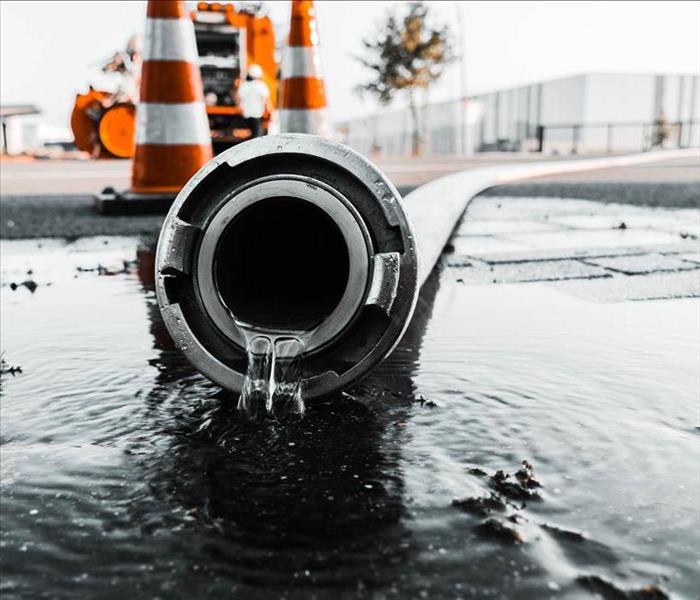 We are mitigation and restoration professionals!
We are mitigation and restoration professionals!
SERVPRO offers both mitigation and restoration services
To prepare your business premises and yourself for any disaster and its cleanup, you should be aware of the work type that needs to be done. Knowing the difference between restoration and mitigation is necessary when a disaster strikes; they are standard terms used in the disaster restoration industry. In this blog post, we will use commercial fire damage as an example of defining mitigation and restoration.
What is the difference between mitigation and restoration:
Mitigation
Mitigation is referred to as reducing the seriousness of something, which is, in this case, are the consequences of fire damage. For example, say the fire damage resulted in smoke damage from a kitchen fire. With the help of mitigation, further secondary damage is avoided.
Mitigation companies restrict the damage by methods and tools like:
- Installing roof tarps
- Building a vital structure that is safe against collapse
- Water to be removed through firefighting efforts.
- Plugging holes
- Disinfecting and cleaning
Mitigation services don't replace or repair but ensure that the hazard doesn't continue to have further consequences.
Restoration
Restoration is started after mitigation. The experts help rebuild and repair your damaged property and bring it back to the pre-disaster condition. They help to replace floors and walls that have been damaged and combat odors, mold, and infestations. The most common difference between them both is that mitigation allows you to move forward. Mitigation helps prevent further damage by the fire cleanup, whereas restoration helps your business get back to normal.
What does a mitigation company do?
The SERVPRO team consists of mitigation professionals. As mitigation requires a lot of experience and skills, we are known to be the best. A mitigation company's job is to lessen the damage to your business or home and make it secure for repairs after water damage, mold damage, smoke, and fire damage that have drastically affected a property. The SERVPRO team is an expert in cleaning, drying, and making an area ready for restoration services.
Water mitigation services
Water mitigation is referred to as the process of providing all the safety precautions necessary, such as stabilizing floors and ensuring that the water damage doesn't continue to cause further damages.
The severity of the water damage will help to determine its mitigation services. Our certified technicians will remove unsalvageable contents, perform water extraction, and use antimicrobial agents. Sketches will also be prepared for drying logs for the insurance company.
Water restoration services
Water restoration is the act of restoring a property after water damage occurs once the water damage is stabilized. Water damage restoration professionals will remove, dried, and disinfected all wet contents.
The drying and cleaning time will be determined by the damage that occurred. It can take from 3 days to a week but will be done as quickly as possible. The air movers and water damage equipment are left at your property to complete the cleanup process. The equipment will only be removed when the humidity and moisture test confirms that all affected areas are dry.
Further water restoration services include replacing damaged floors and walls, mold removal, repair roof damage, and moisture and humidity tests to ensure that all the problems are treated efficiently and resolved. The services drastically depend on the seriousness of water damage that has occurred.
SERVPRO restoration and mitigation services
Different mitigation and restoration services are depending on the type of hazard that has occurred. Mitigation is referred to as long-term pre-disaster planning, which involves non-structural and structural efforts to prevent future risks.
For fire damage, SERVPRO can mitigate and secure your structure caused by smoke, fire, and water. In water damage, we will take quick action to prevent the destruction of your structure. For mold damage, tests will be conducted, and the necessary precautions will be taken. At SERVPRO, we will handle all such emergencies and will be here for your assistance so that you're stress-free in this challenging time.
When your business or home has experienced any kind of hazard or damage, be it from smoke, flood, or fire, it's essential to get accurate mitigation and restoration services so your lifestyle can quickly get back to normal. SERVPRO is a preferred restoration vendor amongst insurance companies and offers residential and commercial restoration services that will make your business and home damage "Like it never even happened."
How To Get Rid Of Carpet Odors From Flooding
12/18/2020 (Permalink)
 Ignored water damage will leave musty carpet odors
Ignored water damage will leave musty carpet odors
Musty Carpet Odors Are Hard To Ignore
A musty mildew-filled carpet can be challenging to overlook. When you first notice your carpeting to smell, you should check to see if there is mold damage. Removing odors out of carpeting is relatively easy. Particularly if your area had been flooded, getting rid of the smell (with thorough attention) can be easy.
Consider yourself lucky if you have not struggled with carpeting smelling your entire home. There are many reasons for carpet odors, like extra moisture, leaks, or floods. Wetness left untreated will cause mold, which may be the source of the unpleasant scent.
In this blog, we'll look closely into some of the most effective ways to remove stinking carpet odors, saving your time and money in the long run.
Why Does The House Stink After A Flood?
The most frequent source of a peculiar musty smell in your home is caused by flooding. As pipes break during flooding, sewage and groundwater won't be delivered to public sewage lines causing a backup in your home.
If the furniture from flood water is not removed correctly or washed, the bacteria can release a heavy, irritating odor. When homeowners don't let their homes properly dry after flooding, mold and mildew development can also occur.
Getting rid of the odors
If you're struggling with floodwater carpet damage, the following are ideas to get rid of the stinky smells:
Dry or clean the area
Stinky or unpleasant odors in the carpet are typically the consequence of floodwaters. When your home suffers from flooding, there is likely ongoing water damage in the neighborhood. The best course of action would be to use the same water restoration company for services since they are already in the area.
Vacuum the carpet
When your carpet becomes dry, vacuum it to minimize the dust to allow the smell to disperse quicker. Make use of a Wet vacuum cleaner to clear extra particles.
Apply Vinegar or Baking Soda
Vinegar is a perfect home cure to remove unpleasant smells. Based on the scale of mildew on the carpet, add one cup of white vinegar per two cups of water. Transfer the spray bottle's solution and spray it on the carpet, making a nice layer. Be cautious not to overdo it! Additional moisture can contribute to mold formation.
Also, use baking soda, as it is one of the safest odor neutralizers. Drop a considerable quantity of baking soda on the smelly carpet, as it will not damage the carpet. Then consider waiting a few hours or for better performance, let sit overnight.
Know when to call for professionals
If the smell remains, repeat this procedure. If all your attempts remain ineffective, get your carpet treated by a reputable restoration company like SERVPRO. SERVPRO offers professional carpet cleaning, water restoration cleanup, and mold damage recovery. When we execute our cleaning services, we do so with outstanding consumer satisfaction as our main focus. Our open and friendly professionals have are qualified in various restoration fields to detect and assess any future problems.
Types of Water Damages That Affects Carpeting
Water damage doesn't originate from a single cause. Did you know that there are various kinds of water damage? It may come from a broken toilet, leaked drains, waste, etc. In addition to getting a greater understanding of how severe the condition could be, you have to consider the three forms of water damage that can impact your home's smell.
Clean Water
Clean water is often referred to as the best or most secure of all categories of water damage. An overflowing sink is generally the cause of this type of damage.
Gray Water
Gray water is much more harmful than clean water. A prime example of a gray water occurrence will be a toilet bowl leak.
Black Water
Blackwater (the most serious of all) arises from natural hazards such as flooding and hazardous waste. In all instances, the carpet and padding need to be removed.
Count on SERVPRO
You can count on the professionals at SERVPRO of Union, Towns, Fannin & Gilmer Counties to mitigate and treat all unwanted damages. We are a preferred water restoration vendor for many insurance companies, and all of our SERVPRO heroes are IICRC certified.
Call us at (706) 896-1880
Ozone Machine For Smoke Damage
12/17/2020 (Permalink)
 A properly performed ozone treatment will relieve your home from nasty odors
A properly performed ozone treatment will relieve your home from nasty odors
Ozone Treatment—an Effective Solution for Removing Unpleasant Odors
There are many daunting factors associated with a fire outbreak; it wouldn't be wrong to state that these unfortunate circumstances leave homeowners in an overwhelming situation. Fire and smoke damage will cause significant damage to the property and considerable financial loss.
However, apart from all these damages, the most troubling factor is the strange, pungent smell that makes it even harder to continue living in the property. When SERVPRO gets a call about fire damage, you will notice that the fire restoration professional will be placing ozone machines throughout the property.
An ozone treatment serves to be the most viable high-tech solution that works efficiently in eradicating musty odors. The ozone machine will provide you with a fresh and smell-free environment. Let us dive deeper into the benefits associated with this remarkable technology.
What is Ozone?
Ozone is a molecular gas composed of three atoms of oxygen, with excellent commercial and residential cleaning uses. Ozone is used for cleaning purposes mainly because it can easily detach one of the oxygen molecules and then re-attach to other molecular substances, thereby changing their composition chemically. Due to this capability, ozone works efficiently in eradicating the unpleasant odor of smoke and other reagents that cause a foul odor.
Ozone Machine—Removing Smoke Odor Now Made Easier
The ozone machine is a piece of efficient equipment, generally available in a mobile unit that removes indoor odors and pollutants. It has a compartment that traps carbon dioxide from the environment. An electrical discharge is then used to split oxygen into a molecular state. This process, which is known as corona discharge, helps in forming ozone gas— a highly reactive gas that clears out the pungent smell present in the environment.
Precautionary steps while using the machine
As you are working with high voltages, it is essential to take severe protection while using the machine; hence, it is always recommended to ground the fault circuits to avoid current issues. Apart from that, all the metal casing must also be adequately grounded to ensure you do not leave loose metal parts while the machinery is in function. Though the machine looks simple to use, there are certain imminent dangers associated with it. Therefore, hiring a professional staff to carry on with the procedures is a more convenient solution.
Hire professionals to get done with the job efficiently
Although the machine looks simple to use, there are certain imminent dangers associated with it. Hiring a professional staff to carry on with the procedures is a more convenient solution. The SERVPRO professionals take specific precautionary measures into strict consideration. Certified fire damage professionals should be the only ones to handle an ozone machine due to ozone gas's reactiveness and capabilities to remove pungent odors. Though the machine looks simple to use, there are certain imminent dangers associated with it. Therefore, hiring a professional staff to carry on with the procedures is a more convenient solution.
SERVPRO Ozone Treatment—the Professional Fire Cleaners
From providing fire damage restoration to top-to-bottom cleaning, the professionals at SERVPRO of Union, Towns, Fannin & Gilmer Counties have you covered. With over 50 years of expertise, our specialists are dedicated to providing all-inclusive fire restoration services with the highest quality. We are among the renowned providers of residential and commercial ozone treatments. We have set high standards with our reliable and professional services.
Call us at (706) 896-1880
How To Prepare For A Storm?
12/7/2020 (Permalink)
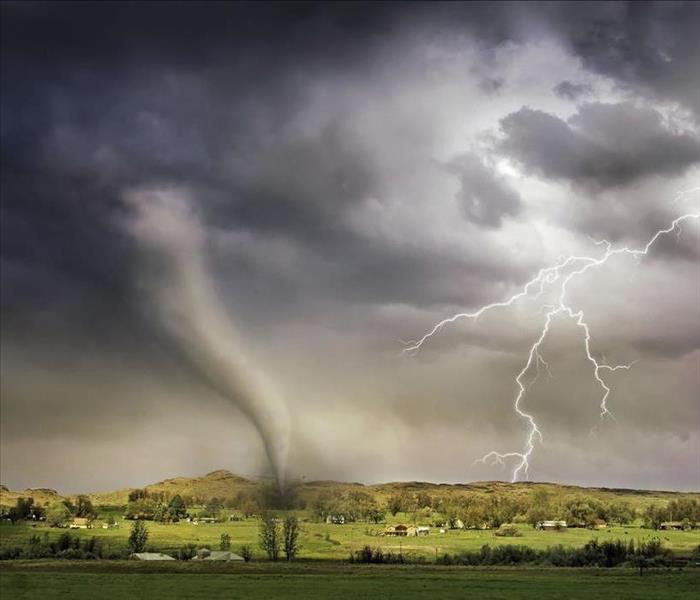 SERVPRO is available 24/7 for storm damage repairs
SERVPRO is available 24/7 for storm damage repairs
Preparing for a storm will save you time and money.
Tropical storms, tornadoes, floods, hurricanes, and other natural disasters can do a significant amount of damage to local communities and businesses. The sad part is, no one can control or prevent any of these acts of God. However, you can take some storm preparation precautionary measures to make sure that the losses you suffer are minimal. However, even if you spend days preparing for a storm, your home may still suffer from storm damage; in this case, you should consider hiring storm damage repair experts when your home suffers from storm damage.
Preparing For A Storm
Every year, natural disasters cause billions in damage in the United States. However, with some storm preparation, you can minimize the loss and protect your loved ones. If you live in an area with a lot of flooding, you can consider getting flood insurance so you can file a homeowners insurance claim to cover damages when the worst happens.
Now, you might be wondering what you can do to minimize the damage a storm may cause to your property. Well, here are some of the storm damage preparation measures you can take to save yourself from complete devastation.
Create A Storm Safety Plan
The first part of storm preparation is creating a storm safety plan is to gather all the members of your household and decide who will handle what. Details of the storm plan will delegate who is responsible for doing things like turning off the electricity and gas supply when a storm hits. An essential part of the storm safety plan will be setting an emergency meeting point such as a park nearby or any other landmark close to your home.
Lastly, it will also be wise to assign a relative who lives out of the state to be your family's emergency contact when severe storm damages strike. A storm safety plan may be time-consuming, but it will minimize safety risks, which is way more valuable than personal property.
Storm Emergency Kit
To prepare for a storm, make sure each family member has an emergency kit that contains all the essential items for survival. Ensure that each family member keeps the emergency kit in an area that is easily accessible. The following emergency kit checklist aims to have all the essential items when evacuating from a storm.
Storm Preparation Emergency Kit Checklist.
- Battery-powered flashlight
- Portable battery-powered radio
- Extra set of batteries
- First aid kit
- List of emergency contact numbers
- Water bottles
- Cash and/or credit card
- Important papers such as ID and bank information
- Sturdy boots
- Essential medicines and prescriptions
- Whistle or any other similar thing to signal for help
With all these things in an emergency survival kit, you will be prepared to keep yourself safe during a storm, even if you have to leave your home.
Four steps to protect your property from storm damage
Here are some steps you can take to protect your property from a lot of damage. Although depending on the storm's size, there is a chance that these steps will not help.
- Cover the windows with plywood or storm shutters.
- Clean out the rain gutters to prevent flooding inside your home.
- Tape the windows to prevent the glass shards from dispersing all over the place.
- Learn to properly sandbag your home if you live in an area with a lot of flooding.
Why Is It Essential To Prepare For A Storm
As mentioned earlier, a storm is something that can not be prevented by anything. If it were possible, the US wouldn't face billions in damages every year. But, you can still take some simple steps to minimize the storm damage loss. You and your family will most likely recover quickly from storm damage if you decide to follow the storm preparation steps in this blog.
Please remember that you and your family's safety is the number one priority in preparing for a storm. Once you are safe after a storm, you should address all the damage that had occurred to your property and call restoration professionals so you can start living on your property as you were before the storm damages occurred!
Call us at (706) 896-1880
How To Effectively Clean Grimy Soot Off 3 Different Surfaces
11/30/2020 (Permalink)
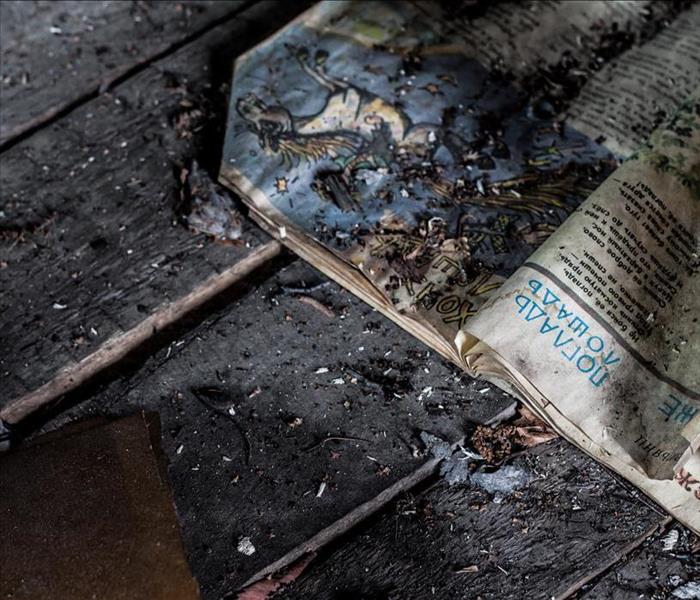 Call The Soot Cleaning Professionals Today!
Call The Soot Cleaning Professionals Today!
For most varieties, leave cleaning soot to smoke restoration professionals.
Cleaning soot is not as easy as wiping the dust off your house’s furniture.
If you don’t use the suitable equipment and the right method for cleaning soot, you’ll end up with a bigger mess on your hands. Not everyone has access to a vacuum with a HEPA filter or other high-powered electronic devices needed to repair smoke damage!
Soot that emits from rubber and plastic combustion is oily in texture and is not easy to clean with household cleaning equipment.
Moreover, soot stains in the kitchen result from protein burnout, making them the most stubborn soot stains. Call the soot cleaning professionals for repairs if you don’t want your house to emit toxic fumes and particles long after being damaged in a fire.
What is soot?
Soot is the impure carbon particles resulting from incomplete combustion of hydrocarbons like wood, oil, and charcoal. When organic matter burns, it releases the residue of its pyrolyzed fuel in the air, which is either brown or black.
They are a type of pollutant that is sticky to touch and can get smudged easily upon contact on any surface.
These particles get stuck on different surfaces like walls, fans, ventilators, and chimneys and can cause various complications–especially in people with respiratory issues like asthma.
What surfaces can soot stick to?
Different types of soot stick to various surfaces and require specific cleaning protocols. For example, dry soot is like dust that settles on furniture, whereas wet soot–moisture mixed with dry soot–can easily stick to any surface.
Among all soot types, dry soot is the easiest to clean. The other classes (wet soot, oily soot, protein soot) often require hiring professional help.
You can try cleaning the other types of soot on your own; professionals do the task in a fraction of the time.
Cleaning soot from painted walls
Find a clean cloth and dab rubbing alcohol or paint thinner on it. Then, gently rub it against soot stains on the painted walls.
Cleaning soot from painted walls is the easiest of all available options, especially if the paint used is stain-resistant. A chemical dry-cleaning sponge will be able to do the same job as well.
In some cases, using a wet cloth on the walls smudges the carbon particles over the surface. Soot particles are soft to touch, but their texture is sticky; therefore, direct use of a wetted cloth for cleaning can create a mud-like mess on your wall.
If you find yourself in a similar situation, try cleaning it using a dry-cleaning sponge first, then use something wet to clean the remaining residue.
Cleaning soot from brick fireplace
Fireplaces don’t pose an immediate danger to you and your family, but if you don’t clean them regularly, they can malfunction, depositing soot in the surrounding area.
For their cleaning soot from fireplaces malfunction: first, remove ashes from the hearth, then sweep off debris and dust particles from the area as much as possible. Then, clean the difficult places using a long brush. Don’t forget the nooks and crannies!
The final step uses either a mixture of water and vinegar or a paste of baking soda and dish detergent to scrub the soot off the interior of your fireplace. You might need to do a fair amount of scrubbing, but that’s the downside of not hiring a professional–SERVPRO’s team is up to the task if you need support!
Cleaning soot from stone
The most efficient way of cleaning soot from stone surfaces is with TSP (trisodium phosphate), which you can buy in either liquid or powder form from the market. The product is toxic if ingested, and direct exposure can irritate your skin and eyes.
Cleaning soot from concrete floor
Not many products can clean soot from concrete floors, especially in cases of extreme smoke damage. If you want to give it a try, use grill cleaners; many people have attested that it works if you rub the surface long enough.
Call soot cleaning professionals!
Most of the cleaning methods mentioned above require careful handling. If you are doing it yourself, use gloves, goggles, and cover other cleaned surfaces with a tarp before staring at your soot cleaning task since the methods described can be harmful.
Cleaning soot stains in your kitchen are possible without any professional help, but things like a fireplace cleaning or smoke damage clean up requires professional restoration. We advise you to always go for the most comprehensive solution for your home instead of the cheapest.
Some smoke damages are beyond repair–only a professional restoration crew can bring these surfaces back to life. You don’t need to strain your body and risk your health for an impossible cleaning task–leave it to the professionals!
Call us at (706) 896-1880
Is it safe to stay in a house with smoke damage?
11/30/2020 (Permalink)
 SERVPRO professionals follow all safety protocols when cleaning smoke damage.
SERVPRO professionals follow all safety protocols when cleaning smoke damage.
In short, smoke damage after a house fire needs to be cleaned by professionals ASAP.
Fires can decimate your property and destroy all types of furniture. Even after the initial fire has been put out, it is still unsafe to enter the home due to smoke damage.
If left untreated, smoke damage can potentially cause more harm than the initial fire.
After a house fire, professionals should inspect the smoke damage before anyone else enters the household. It may seem safe to enter the house but, even if you cannot see any smoke, there still may be particles left behind walls. It is imperative that a smoke damage professional inspects the house and clears any remaining smoke particles.
Types of smoke damage
Smoke damage is any damage that is caused directly by the smoke, not the fire. It can fit into the most narrow areas such as wiring, pipes, and other small gaps. The composition of smoke damage varies from house to house, based on the items burnt. There are four primary smoke damage categories: dry smoke, protein residue, fuel/oil residue, and wet smoke. The types of things burnt determine their classification.
The burning of paper and wood generally causes dry smoke. It leaves behind small particles that are easily cleaned but that gets into small cracks and porous materials.
Protein residue is common in kitchen fires. It’s when organic materials are incinerated during low-heat fires.
Fuel/oil residue isn’t common in residential fires, but it is possible if the home is storing petroleum products. Cleaning this type of smoke damage is incredibly difficult, so its rare occurrence is a benefit.
Wet smoke is the product of burning rubber or plastic. This classification type is characterized by dark black smoke. This type of smoke damage is sticky and dense, making clean up near impossible without specialized equipment.
Also, after the removal of fire, walls and furniture are usually soaked with water. Removal of water from these areas is vital, and professionals can do this with dehumidifiers or air movers.
The professionals at SERVPRO have the best techniques to remove soot and smoke effectively from these surfaces. Our experts can promptly assess the amount of damage and lie out the best method for the complete removal of soot and smoke from your household.
How long does smoke damage last?
How long smoke damage lasts depends on how fast action is taken to clean it up.
Certain items need to be saved within minutes to prevent permanent damage. Walls and furniture can become permanently stained if not treated by 1-2 days.
The quicker you take action, the better. We take immediate action here at SERVPRO, arriving at your home within minutes of your call.
SERVPRO fire and smoke damage services
Smoke damage is no joke and should not be taken lightly; entering the household without proper protection or masks can prove deadly. The safest decision is to call professionals to inspect and assess the amount of damage done to the house.
SERVPRO of Union, Towns, Fannin & Gilmer Counties team of experts can quickly assess, contain, and neutralize any smoke before further damage occurs. SERVPRO IICRC certified experts will carefully inspect all the rooms of the property to develop a proper plan. Give SERVPRO a call now and ensure the safety of both you and your loved ones!
Call us at (706) 896-1880
Know The Right Way To File A Water Leak Insurance Claim
11/30/2020 (Permalink)
 Call us today at (706) 896-1880
Call us today at (706) 896-1880
SERVPRO Can Communicate With The Insurance Company On Your Behalf
Experiencing any damage to their property can be stressful for the owner. Not only does the incident take time, but the restoration procedure can be costly as well without insurance.
But, if you did take precautionary measures and get coverage, you will save plenty of money and hard work. All you would need to do is file an insurance claim.
What is a homeowners insurance claim for water leaks?
Filing an insurance claim can be challenging for people, especially those doing it for the first time. So, let’s see how you can file an insurance claim for water damage; after all, it is the most common type of claim for households around the country.
Once you file an insurance claim for water damage, there are a few things that you should keep in mind and take care of to avoid any complications in the process.
Before we get into those essential steps, let us see how you can file an insurance claim in the first place.
Filing An Insurance Claim
Although steps for filing an insurance claim may vary, some standard steps get most jobs done. Here are all the general steps you need to take to file a claim.
1- Contact Your Insurance Company Regarding The Claim
The first thing you need to do is contact your insurance company and tell them about the water damage you suffered and the resulting claim you want to file. You can do this by contacting them by phone, email, or even live chat. They will then send you all the necessary forms for you to fill.
2- Meet The Adjuster
Although the time when the adjuster is bound to meet you after a claim has been filed varies according to the State you live in, typically, it is the next 15 days. So, once you have filed the claim successfully, the adjuster will visit your premises and assess the damages.
3- Get A Claim Verdict
Once the adjuster assesses the damages, he has another 15 days to decide whether the water damage claim is valid or not. During this time, you can look for water damage vendors who will restore your damages, such as SERVPRO, the specialists in water, fire, and mold damage restoration.
4- Negotiate
If you think that the settlement is not fair, or the verdict is not in your favor, you can negotiate with the insurance company for a more favorable settlement.
5- Agreement
Lastly, once you and the insurance company are on the same page, you can finally accept the terms of the claim, and the funds are supposed to be transferred within the next five working days so you can start the restoration process.
Claiming on house insurance for water leak
Keep the following things in mind while filing a water damage insurance claim.
Secure Valuable And Prevent Any Additional Damage
Keep your valuables in a safe and secure place for your peace of mind, and take reasonable steps to ensure there is no additional water damage to the property.
Record Proof Of Water Damage
Take photos or make videos of all the water damage to use as concrete evidence when filing an insurance claim. Just don’t throw away or alter anything before the adjuster comes and assesses the situation.
Review The Insurance Policy
Make sure your insurance policy covers the water damage that occurred on your property, or else the claim would fail inevitably. Some insurance policies do not cover water damage by floods and drain backup, while others do.
Make An Accurate Inventory Of The Damaged Property
To get a fair estimate about all the expenses for the restoration or replacement of damaged property, you need to make an accurate inventory, listing the make and model, replacement cost, and cash value of the damaged goods.
How SERVPRO can help
If you want a company that can do both - restoring water damage and communicating with the insurance company for filing the claim - SERVPRO is here for you. With years of experience and countless damage restorations, we ensure complete client satisfaction.
With SERVPRO of Union, Towns, Fannin & Gilmer Counties on your side, you can get the compensation you deserve for the damage alongside world-class complete water damage restoration.
How to Choose The Right Water Restoration Vendor
11/23/2020 (Permalink)
 Choosing the right water restoration vendor is a lot like being pointed in two different directions.
Choosing the right water restoration vendor is a lot like being pointed in two different directions.
SERVPRO Is A Preferred Insurance Water Restoration Vendor
After an unfortunate event such as water damage, you will want to file a claim for your homeowner's insurance. Then you will need to make sure that you also find the best and licensed water restoration vendor with the right set of skills to manage all the repairs on your property. Although many of the best insurance companies recommend water restoration contractors to get the job done, you will want to go with one YOU can trust.
Before choosing the first water restoration vendor provided by your insurance adjuster, you should look and see past reviews, years of experience, highly-trained professionals, and the quality of repairs. In this post, you will learn all that makes a trustworthy water restoration vendor.
3 Things That A Good Water Restoration Vendor Must Provide
There are five things that all food water damage vendors must provide you before they start mitigating the damages. Those five things are as follows:
- A written estimate that states all the possible expenses, including the labor and equipment used to carry out the repairs.
- Give you an estimate about the time the repairs could take.
- The right water restoration vendor will provide you with their contractor's license number, the amount of liability insurance they carry, and the insurance policy number for their liability coverage.
Remember that any professional water restoration vendor will provide you with all the necessary information beforehand.
4 Steps to Protect Yourself When Working With Water Damage Restoration Contractors
Once you find the right water damage contractor you can trust, you will want to follow the following four steps to safeguard your interests.
1) Get A Written Estimate Cost From The Contractor
The first thing you need to do is get a written estimate. A written estimate will safeguard any future disagreements because there will be documented proof.
2) Check Contractor's Reviews And Licensing
To ensure that you are the best water restoration vendor out there, it is always good to check online reviews. Secondly, it is essential to make sure the water damage contractor has insurance and proper licensing. Go with a preferred water damage vendor recommended by your insurance agent. You will not have to worry about their documentation because preferred vendors need to have the proper documentation to be part of the programs.
3) Get Approval From Your Insurance Company
Carefully examine and read all the papers that the contractor asks you to sign to ensure that your rights are protected. Also, getting approval from your insurance company is vital to ensure that all damages will be covered.
4) Keep A Record Of All Claim Repairs, Details, And Receipts
Keep a file containing all essential information and paperwork of the work being done. Here are some of the things you might want to include:
- The signed contract
- Bills and invoices
- Specifications and plans of all the work being done
- Information of any subcontractors (if applicable)
- Copies of certificates of insurance
- Before and after restoration images
If you have all such essential information, your claim will go much smoother.
Conclusion
When you hire the professionals at SERVPRO of Union, Towns, Fannin & Gilmer Counties as your water restoration vendor, you will be happy to know you are working with the best restoration contractors in North Georgia. We are a preferred insurance repair contractor and have experience in fire, mold, water restoration cleanup.
Call us at (706) 896-1880
How To Remove Water In The Elevator Shaft
11/16/2020 (Permalink)
 Call SERVPRO today if there is any standing water in your commercial elevator!
Call SERVPRO today if there is any standing water in your commercial elevator!
Water Getting Inside The Elevator Shaft Is Common
Although standing water in the elevator shaft is common, you must be aware that it limits the elevator's functionality, and it can also cause a hefty amount of damage. So, when you find out that there is water in the elevator shaft, here is what you need to do about it!
If there is water in the elevator shaft, you need to take the following 3 steps to ensure you minimize damages.
How Can Water Get Inside The Elevator Shaft
Suppose you are wondering how water gets inside the elevator shaft in the first place. The most common way the SERVPRO professionals have seen is when water seeps inside the shaft through the pit's walls. Water seepage is usually caused by water damage from a pipe burst or buildings with cracks in the concrete or has leaky foundations. Foundation leaks are the most common cause of water getting inside the elevator shaft. The risk for foundation leaks is significantly higher for building near areas with a higher water table and where the land is poorly drained.
3 Steps To Take When Water Is In The Elevator Shaft
1) Halt Elevator Usage For The Time Being
The first and probably the most important thing you need to do is stop elevator usage as long as there is water in the elevator shaft. It is common knowledge that water near an electrical system can cause an electrical short circuit and, in the worst case, even fire. Also, if there is someone in the elevator, a short circuit may lead to them being trapped.
2) Contact The Elevator Service Provider
You might think that ordinary staff working at the premises may know how to service the damaged elevator. However, that is not the case. You need to contact the elevator service provider as soon as possible because they have the required expertise to ensure that the elevator does not receive any additional damage. Let the experts do the job for you!
3) Contact A Professional Water Restoration Company
Lastly, contact a professional water restoration company like SERVPRO to remove the water in the elevator shaft. With qualified technicians and years of experience, your safety will be ensured. We will remove the water from the elevator shaft and make sure there is no more water intrusion that can damage the electrical system.
Also, water being stuck in the elevator shaft can lead to mold growth. Fortunately, SERVPRO can help with mold restoration as well.
Why Choose SERVPRO For Elevator Water Damages?
SERVPRO ensures that there is no mold or other intoxicants and takes out water from the shafts by carefully carrying out the following steps:
- We use a suitable sump pump and remove all the standing water in the elevator shaft. The remaining water is then wiped out with the help of a suitable water extraction machine.
- We use IICRC cleaning techniques to remove any mold damages.
- We take the necessary steps to ensure water does not seep in anymore, and the elevator is safe to use again.
If you want complete water restoration cleanup, SERVPRO is your best bet. SERVPRO of Union, Towns, Fannin & Gilmer Counties is available 24/7 to help you with any water loss.
Commercial Biohazardous Waste Disposal Guidelines
11/9/2020 (Permalink)
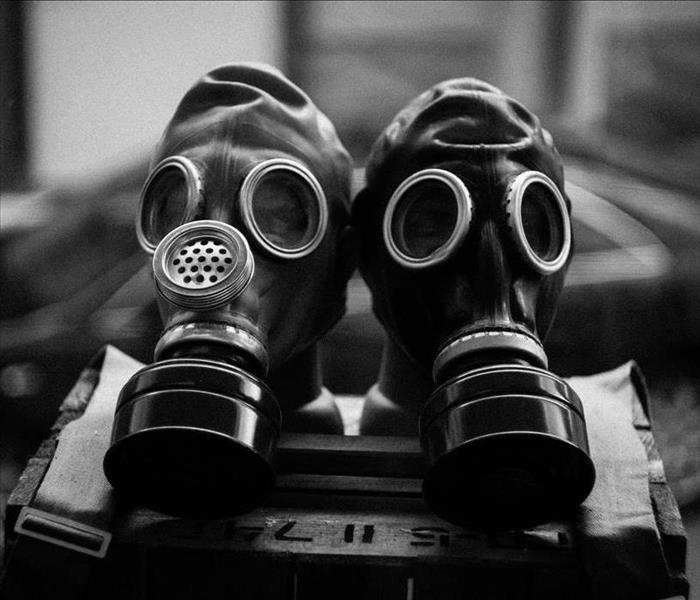 We specialize in trauma clean up!
We specialize in trauma clean up!
SERVPRO follows the OSHA biohazardous waste disposal guidelines
Due to the extremely harmful nature of biohazard waste, it is essential that professionals, such as those at SERVPRO, dispose of the waste using OSHA biohazardous waste disposal guidelines!
What are the biohazardous waste disposal guidelines?
Biohazardous waste generally means any waste with potentially infectious materials or agents that prove hazardous to health and the environment. Biohazardous waste includes sharp objects, medical waste, animal waste, and microbiological waste. Furthermore, there are four different categories of biohazardous waste, which include:
- Solid waste: these include non-sharp items such as gloves, towels, pipettes, or other materials with biological materials or bodily fluids.
- Liquid waste: these include massive quantities of bodily fluids or blood.
- Sharp waste: these include wastes that can puncture or pierce through the skin and are contaminated, such as needles, syringes, broken glass pieces, etc.
- Pathological waste: these include human tissues, organs, and other parts except for teeth.
Biohazardous waste disposal containers
There are some basic guidelines that you must know when disposing of biohazard waste. The first and most significant thing that needs to be done is by segregating the different types of waste in their respective containers.
- General healthcare waste or non-hazardous material should be kept separate from biohazardous waste. If mixed, all of the waste must be considered hazardous.
- Sharps must be contained in a tamper-proof and puncture-proof container. These may include containers made of high-density plastic or metal.
- Infectious waste must be contained in suitable containers or leak-proof plastic bags.
How to properly dispose of biohazard waste
If the waste is in decay, the date of packaging, required storage conditions, and type must be included in the labeling. A professional will write a clear description of the waste on the labels and include recognizable biohazardous waste symbols. Other vital information to add to the label will consist of the container's weight, the organization's name, where the waste was produced, and the date the container was produced. Properly labeling will comply with all the OSHA rules and regulations.
As a rule of thumb, the container should be only three-quarters (3/4) full. Once the containers are closed, they must be sealed appropriately to avoid any accidental spillage during transportation. Also, ensure that the vehicle being used for transportation does not have any sharp edges or pointy materials in the storage area that can damage the containers.
Additional guidelines to follow when storing biohazardous waste:
- The storage area floor must be easy to clean and disinfect, have a good drainage system, and be impermeable.
- Cleaning equipment, water supply, protective clothing, containers, and water bags must be easily accessible and available.
- The staff and waste-collection vehicles must have easy access to storage.
- It must be well-guarded to prevent any unauthorized personnel from entering.
- Not even birds, animals, or insects must be able to get into the facility.
- Do not expose the containers to direct sunlight.
- There must be adequate lighting and ventilation to avoid health problems or accidents.
- The storage facility must not be near food preparation areas or food stores.
The most common way to treat biohazardous waste will be done by incineration. The sanitary landfill will apply extremely high temperatures to the waste and kill all the organic substances that are potentially hazardous.
Another process to treat biohazardous waste is known as autoclaving. Autoclaving includes sterilizing biomedical waste in a highly pressurized and steam-heated chamber. If the waste consists of plastic, this process can make it pathogen-free!
SERVPRO's approved method for disposal of pathologic biohazardous waste
Collecting, storing, and disposing of biohazard waste while keeping the OSHA guidelines in mind can be pretty challenging for anyone. Therefore, SERVPRO is here to do the job for you. We follow the steps provided by OSHA, which include accumulation, handling, and transportation. If you require cleanup services for the following, we are here for you!
- Blood cleanup
- Vehicle blood and bioremediation
- biohazard remediation and removal
- Homicide and suicide cleanup
There is no reason to put your staff in a risky position when you can hire us to do all the work for you. By hiring us, you are protecting yourself and everyone around you by contacting the SERVPRO of Union, Towns, Fannin & Gilmer Counties professionals. We work quickly and follow all standard biohazardous waste disposal protocols and make your commercial property sterile again!
Space Heater Fire Hazards Are More Likely To Occur In The Colder Months
11/2/2020 (Permalink)
 When a fire occurs we will remove all smoke and soot from all surfaces!
When a fire occurs we will remove all smoke and soot from all surfaces!
A Professional Fire Restoration Company Will Mitigate Any Fire damage.
With the winter season well upon us, all anyone can think of doing is curling up in front of their space heater, all snug and cozy. After all, who doesn’t like unwinding after a long, cold day with a mug of their favorite cocoa, a festive movie, and the warmth of a heater? But space heaters can do as much damage as they do good, and it’s essential to take precautions to prevent any space heater fire hazards from occurring.
Is Your Space Heater a Fire Hazard?
Remember when someone asked you who your best friend was? Well, for these next couple of months, that’s your space heater. But believe it or not, your space heater can turn out to be quite the fire hazard. According to the Consumer Product Safety Commission (CPSC), from 2008 to 2010, portable electric heaters were the cause of roughly 1,200 fires per year.
With most heaters containing a 1500 watts voltage, this is more than enough power to cause a spark should any of the appliance's components prove faulty. So, it’s best to look out for a damaged wire, cord, or plug. Additionally, if you’re using an extension cord, then it is essential to check that too; fires are often caused by extensions instead of the heater itself.
Of course, even a correctly functioning space heater can be prone to combustion, and the most common cause of this is its surroundings. Space heaters should be kept at a safe distance from all items, roughly a distance of about three feet, but people often forgo this advice and huddle up close to get maximum heat. This seemingly harmless act could prove fatal if any of the nearby materials were to catch fire.
Are All Space Heater the Same?
Although there’s no doubt that a space heater can turn out to be dangerous, that doesn’t mean that it is an appliance not suited to your home. It is one of the best sources of indoor heat to help you get through the harsh winters. All you need to do is use it safely, and you’ll be all set.
The best type of space heater to go for are electric space heaters as these have proven to be the safest, with the following 4 types of space heaters to keep clear of:
1) Fan Heaters
2) Ceramic Heaters
3) Oil Heaters
4) Convection Heaters
Still, if you choose to use one of the above types – as they are usually cheaper – Please keep a close watch.
How Do I Make My Space Heater Safer?
Of course, everyone can’t get an electric space heater, and so, there are a few steps that you can take to make your space heater safer – whatever type it may be.
Space heater precautions to consider:
- Steer clear of extensions wherever possible
- Do not leave your space heater without supervision or running overnight
- Stick to your heater’s operation manual
- Turn off your heater at the first signs of a spark or overheating
- Give your space heater adequate rest, ideally after every few hours
- Keep your space heater well away from any liquids
- Place the space heater on a straight surface
- Place all materials and items at a distance of at least three feet
- Make sure your space heater is UL certified
Just follow these simple guidelines, and the chances of a space heater fire hazard will fall drastically.
One of the smartest things you can do is install heat and smoke sensors at various points throughout your home, taking special care to place them in rooms where your space heater is used. These alarms are excellent at detecting the smallest signs of a space heater fire hazard, as their reaction time is just a couple of minutes. Just make sure your alarm has a loud enough sound, so you’ll be able to notice it even if you’re immersed elsewhere.
Final Thoughts
So, is it likely that your space heater starts a fire? Is a space heater’s risk of fire far too significant? Not at all! As long as you stick by the precautionary methods and keep safe, your space heater is an excellent addition for the winter months.
Remember to call SERVPRO of Union, Towns, Fannin & Gilmer Counties when a space heater fire breaks out in your home or business. SERVPRO are fire damage restoration professionals on call 24/7 and will be there to help you every step of the restoration process.
Who to Call for Blue Ridge Gutter damage After A Storm Passes
10/26/2020 (Permalink)
 We're Highly Trained Storm Damage Specialists
We're Highly Trained Storm Damage Specialists
Here in Blue Ridge, we have seen weather cause a wide array of issues for roofs and gutters.
Most homeowners in Blue Ridge make the common mistake of not examining their homes or businesses' roofs after a severe weather event occurs. This common mistake could cost you a lot of money in the future.
Rain, snow, hail, sleet, and high winds have the potential to cause gutter damage. Some gutter damage is easy to spot, like fallen downspouts. But not all storm gutter damage is easy to spot. Gutter damage can be hidden entirely from ground level; if it goes unnoticed, it can cause problems later to your home's interior.
What is Gutter Damage?
After a massive storm, wind and heavy rain may loosen and bend gutters and downspouts. Here at SERVPRO, we have seen countless damaged gutters, especially if they are older, in poor condition, and not securely attached. Heavy rain can also wash debris and dirt into your gutters, causing a potential clog. Once the gutters of your home become clogged, they no longer carry water away from the roof. When the gutters stop doing the job that they are designed to do, there is a potential for backup and water damage to the roof or interior of your Blue Ridge home. After a storm passes, it is essential to have your gutters and roof inspected because the heavy debris's weight can cause your home gutters to sag.
Home Damages Caused by Malfunctioning Gutters
Here are typical types of damages to watch out for after your gutter system fails.
After a storm passes and your gutter system breaks down, check the ceilings of your home for water spots. Water spots look like damp rusty-colored rings on the ceiling. The discoloration is usually the sign of a roof leak caused by damaged gutters. Contact SERVPRO ASAP to avoid further problems that can become more expensive as the leak worsens and spreads.
Rain, snow, and other forms of long-term moisture from severe weather can create expensive repair issues as well if your gutter system is malfunctioning. The water damage professionals at SERVPRO have seen flood damage appear on the walls near where the roof meets the home. After multiple weather event occurrences, moisture can build up in the walls of your home. Prolonged repair to damaged gutters may cause flood damage to the interior of your home.
In more severe cases where a homeowner does nothing to fix the damaged gutters, we have seen mold developed in areas of the home. Mold damage is typically due to the home not being protected from moisture. Your home gutter system is designed to remove rainwater far from your home.
As you have seen, here in Blue Ridge, severe weather events are more than a rare occurrence. Having secure gutters is essential to protect your home and your valuable assets inside. It is a good idea to get your gutter system inspected to catch potential issues. When issues are found by a SERVPRO professional, they will offer you a detailed plan of action to repair the damage early on to save you money down the road.
It is always a good time to get your roof inspected even if you do not think there is an issue. SERVPRO of Union, Towns, Fannin & Gilmer Counties can provide an inexpensive, professional assessment of your roof, rain gutters, attic, and all other related parts that make up the home's protective shield.
If one of our certified professionals identify storm damage to your home, you will get a written estimate for repairs. While we are performing your estimate, it will be a good idea to contact your insurance company and file a claim. We will work with your insurance company to ensure that you are reimbursed for the storm damage repairs. We know what insurance companies look for in property damage claims. We will provide photos and a detailed estimate for your insurance provider.
Contact SERVPRO
SERVPRO will come out and inspect your damaged gutter system. Our SERVPRO restoration professionals are highly trained by the IICRC and will walk you through every part of your gutter damage job.
Category 3 Water Remediation - 5 of The Most Common Sources of Category 3 Water
10/19/2020 (Permalink)
 We have the resources to handle fungi and bacteria caused by storms and disasters!
We have the resources to handle fungi and bacteria caused by storms and disasters!
Category 3 water remediation occurs because category three water is grossly contaminated with pollutants, including fungi and bacteria.
SERVPRO understands the stress and questions that come with a category 3 water loss. The SERVPRO goal is to quickly assess the level of contamination your property has endured and advise you on the best course of action to move forward.
The information in this blog post is intended for any homeowner that has recently undergone a water damage loss and has questions about category 3 water remediation.
Category 3 water is nasty contaminated water and can contain pathogenic, toxigenic, or other harmful agents. Dirty water can carry silt, organic matter, pesticides, heavy metals, regulated materials, or toxic organic substances.
Please note that no two water losses are alike, and each category 3 water remediation will be treated depending on the unique needs of the damaged property. Category 3 water remediation needs to be handled by professionals who have attended an IICRC WRT Class, an IICRC ASD Class.
Causes of Category 3 Water Remediation?
Category 3 water damage can occur when highly contaminated black water damages a property. There are significant health risks as well as a high chance of injury associated with category 3 water remediation. There are different causes of category three water losses. The professionals at SERVPRO know the most common causes of category three water losses are sewage backups. A sewage backup creates a nasty mess, but this type of water loss is not the only source of unsafe, dirty water. Another common dirty water type comes from flash floodwaters. Flash floods are known to push organic and chemical contaminants into the house. Outside of these two causes, there are also five other leading causes.
5 of the most common sources of Category 3 water include:
- Broken sewer lines
- Backed-up sewer mains
- Extended rain events
- Ground surface water
- Hurricane flooding
Did you know a small toilet overflow can cause Category 3 damage?
It's because dirty water deposits bacteria will damage the floor, baseboards, and surrounding bathroom fixtures.
How Does Dirty Water Spread?
In all of our category 3 water remediation jobs, we have found that the porous surfaces become a breeding ground for pathogens and fungus. Humidity, temperature, and stagnant air in a flooded home will create an ideal environment for bacteria and fungi to grow.
A Deeper Understanding Of Category 3 Water Remediation
To further clarify the risks involved in cleaning up this type of damage, we are going to list what diseases are affiliated with improperly handling a category 3 water loss:
- Hepatitis B and C
- Norovirus
- Tetanus
- West Nile virus
- Tuberculosis
- HIV / AIDS
As you can see, any type of category 3 water can pose serious health risks.
What To Do During A Category 3 Loss?
When you suffer from a category 3 water loss, it's best to call a professional restoration company that is certified in handling Category 3 contamination. It is essential to hire highly trained technicians who adhere to strict OSHA and EPA standards.
We Specialize In Category 3 Water Remediation
SERVPRO professionals use specialized water damage equipment to sanitize, dry, and repair affected areas. As you learned today, trying to perform category 3 water remediation by yourself isn’t a good idea. SERVPRO of Union, Towns, Fannin & Gilmer Counties is available 24/7 to help you with any water loss.
Does Mold Attract Bugs? 5 Bugs That Eat Mold At Commercial Properties
10/12/2020 (Permalink)
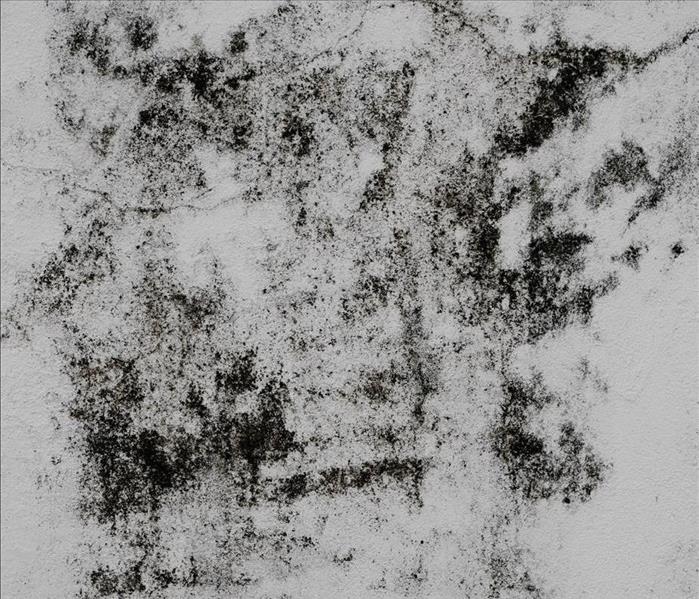 SERVPRO is Faster to Any Size Disaster!
SERVPRO is Faster to Any Size Disaster!
The majority of the time that SERVPRO professionals arrive at a mold damage job, the job site is also experiencing a bug issue. The reason being is that mold and bugs thrive in the same environmental conditions. In this blog post, you will learn why mold attracts bugs.
Environmental Conditions For Mold Growth
Mold and bugs thrive in the same environmental conditions. Warmer, wet conditions are the known best environmental condition for mold and bugs. Mold and bugs are similar to most living organisms; they both need food and water to survive. The real questions are, do mold and bugs feed on the same things? And does mold attract bugs?
What Do Mold and Bugs Eat?
What Does Mold Eat?
Mold mostly enjoys eating things that are made of porous materials. Porous materials make it easy for mold to grow and plant more mold spores.
Porous materials include the following:
- Sponges
- Wood
- Rubber
- Rocks
- Drywall
Porous materials are everywhere inside your home. If you’d like to know more about mold and how SERVPRO handles mold issues, check out What is Black Mold.
What Do Bugs Eat?
Since this post focuses on mold eating bugs, we will go through the types of bugs we see at mold remediation jobs. Bugs associated with active mold growth like to consume things outside of mold itself as well. The SERVPRO professionals have found bugs eating food in the pantry, organic matter, and wet drywall. Mold mites are one known type of bug with a name to reflect their relationship with mold eating. The following are other bugs that are attracted to mold:
Bugs That Mold Attracts:
1. Mold Mites
Mold mites, are the cousins of dust mites, thrive off of mold. These bugs need a source of constant humidity and moisture to survive. Mold grows where the air is humid, making it a perfect habitat for mold mites. A mold mite is a tiny white bug consisting of long hairs known as setae. Mold mites may be hard to notice at first because they're nearly invisible to the naked eye.
2. Cockroaches
Cockroaches survive by eating paper and easily digestible foods. Mold breaks down wet drywall, making it easier for a cockroach to digest. Mold also can break down wood, making wooden materials a delicacy meal for cockroaches.
3. Termites
A typical mold job will consist of musty odors that attract termites. These musty odors are also known as mycotoxins or Volatile Organic Compounds (VOC's). The VOC’s produced by mold contribute to a termite growing appetite. Mold will also break down the wood and makes it more easily penetrable for termites. Termites will contribute to home mold growth by tunneling wood, causing it to spread.
4. Booklice
Booklice has received its name by consuming the paper of books. The mold professionals have also found these bugs in wet paper piles, behind damaged wallpaper, and around windows in a mold damage job. Mold will break down paper and cause a booklice infestation because they love to eat moldy paper.
5. Foreign Grain Beetles
The foreign grain beetle is usually found in older homes with high humidity levels. However, the SERVPRO professionals have seen these bugs to infest new homes where lumber and building materials are still wet, attracting mold growth.
Concluding, Does Mold Attract Bugs?
Yes, mold attracts bugs. Mold and bugs seem to have an engaging relationship since mold provides excellent food sources for the different listed bugs in this post. The easiest way to prevent mold growth and the bugs is to control the amount of moisture in your commercial property. The best way to remove excess moisture is by investing in a commercial dehumidifier. If you have mold and bugs in your home, it is best to contact a professional mold remediation company like SERVPRO of Union, Towns, Fannin & Gilmer Counties.
Call us at (706) 896-1880
3 Common Flood Types Caused By Chattahoochee River flooding
10/5/2020 (Permalink)
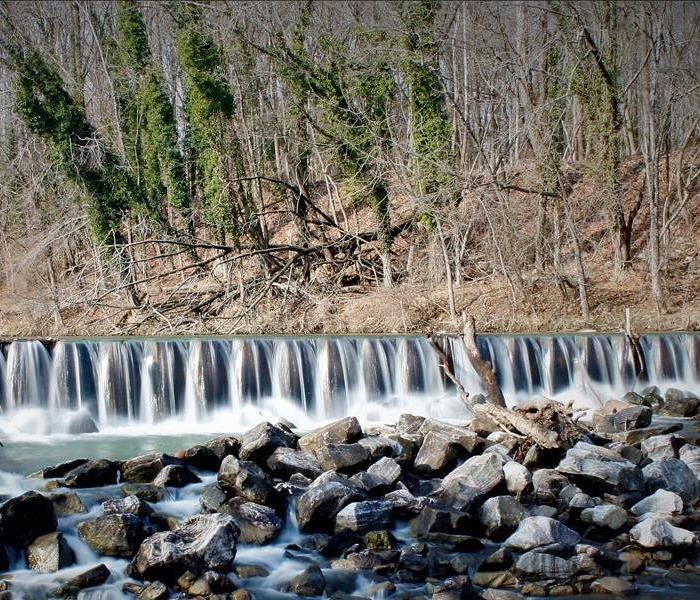 We offer 24-Hour Emergency Services
We offer 24-Hour Emergency Services
Chattahoochee River flooding has caused thousands of dollars worth of flood damage to homeowners each year.
Floods are known to cause damage to any property in a flood zone. In this post, you will learn about the various types of floods and how they can affect your property.
SERVPRO knows first hand that water damages come in all shapes and sizes. The most severe water damages fall under a Category 3 water damage. A Category 3 water damage, also known as "black water" damage, includes rising flooding, seawater, sewage water, and river water. These water losses require quick action to mitigate any potential health risks.
Chattahoochee River flooding can occur quickly or slowly, affecting prominent flood zone areas and those that appear completely harmless in dry weather.
How can floods affect your Georgia Property?
Water damage from flooding produces potential health and safety risks if the water is not immediately cleaned up, including:
- Structural damage
- Electrical damage and risks
- Sanitary hazards and diseases from standing water
- Defunct drainage and sewage systems
- Destruction to roads and bridges
- Landslides
Although flooding in northern Georgia does not occur often, it is still something that needs to be considered. SERVPRO is here to help with any flooding from the Chattahoochee River, Toccoa River, and Ocoee Rivers.
3 Types of Chattahoochee River flooding Damages
Chattahoochee River flood stage is characterized by the size of riverbank overflows caused by extensive rainfall over an extended period of time. Most structural damages occur when a property is located in a flood zone and undergoes mass amounts of rainfall.
Outside of rising waters from the Chattahoochee River, we have seen the following three types of flooding also occur:
1. Flash Floods
Flash floods are caused by heavy rainfall or when snowfall thaws quickly. Flash floods are typically known to be fast-moving waters that sweep anything that comes in their path. A typical flash flood usually covers a small area lasting around six hours or less. Flash floods have the capability to move large objects such as cars, rocks, and trees. It is essential to have a local water restoration number when a flash flood occurs near your property.
2. Pluvial floods
Pluvial flooding is similar to urban flooding, but it mainly only occurs in rural areas. These floods form in flat areas where the terrain can’t absorb the rainwater, causing puddles and ponds. Pluvial floods have a severe effect on agriculture, causing many damaged crops.
3. Urban floods
Urban floods occur when the drainage system in a city or town fails to absorb the water from heavy rain. An urban flood will result in water flowing out onto the street, making transportation very dangerous. The average water levels of an urban flood is a few inches deep, but they cause significant structural damage.
Conclusion
Chattahoochee River flooding can cause severe flood damage to properties, but there are many ways to prevent it. Contact SERVPRO today to come out and evaluate your property and see how you can protect yourself from Chattahoochee River flooding. The SERVPRO restoration professionals are highly trained by the IICRC. Flooding is not something that should be taken lightly that is why we suggest to all of our local residents to have a flood plan in place.
More on the Chattahoochee River
Call us at (706) 896-1880
Meet Our Team-Christine Osborn
9/21/2020 (Permalink)
 Christine Osborn - General Manager
Christine Osborn - General Manager
Christine Osborn is the General Manager for SERVPRO of Union, Towns, Fannin, and Gilmer Counties servicing the Hiawassee, Blairsville, Young Harris, Blue Ridge, and Ellijay communities. She has been apart of the SERVPRO family for approximately 6 years.
When Christine is not assisting her SERVPRO team members, she likes to ride horses and spend time with her two little boys.
The most influential thing Christine has gained by working at SERVPRO has been a change in mindset. She believes that life has absolutely no limitations except the ones you make. Take the chance to Make a Difference with every opportunity you are presented, the world needs your smile!
What she likes most about working at SERVPRO is she has the opportunity to Make a Difference every day, whether that be with a co-worker, with a customer or helping her community in a time of need – she is always there to help.
Christine is IICRC certified in WRT, FSRT and OCT and is ready whenever help is needed.
Meet Our Team-Caleb Weaver
9/20/2020 (Permalink)
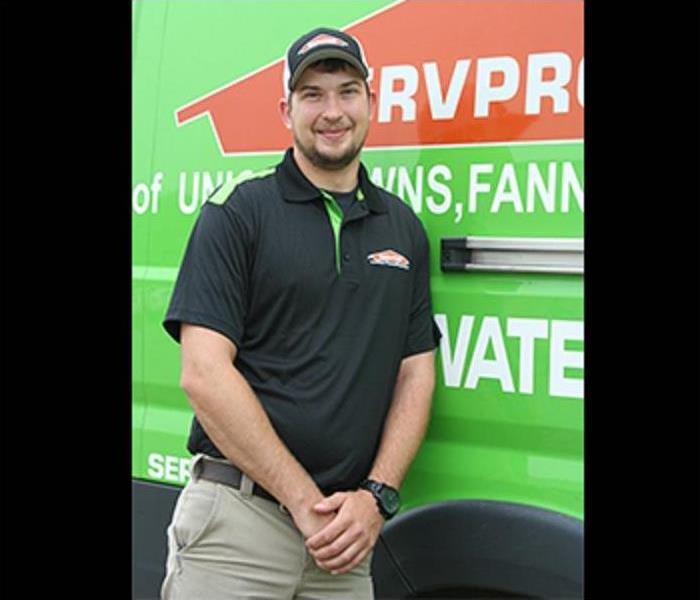 Caleb Weaver - Production Manager
Caleb Weaver - Production Manager
Caleb Weaver has been Production Manager for SERVPRO of Union, Towns, Fannin, and Gilmer Counties servicing the Hiawassee, Blairsville, Young Harris, Blue Ridge, and Ellijay communities.
Caleb has been with SERVPRO for approximately 11 years and has IICRC certifications in WRT, ASD, AMRT, FSRT, and he is a certified lead paint renovator in the states of Georgia and North Carolina.
The thing Caleb likes most about being a part of the SERVPRO team is helping our community and the skills he has learned in customer service to serve our customers.
When he is not at work, he enjoys spending time in the woods. But most of all, Caleb enjoys spending quality time with his adorable daughter.
Meet Our Team-Clancy Shelton
9/19/2020 (Permalink)
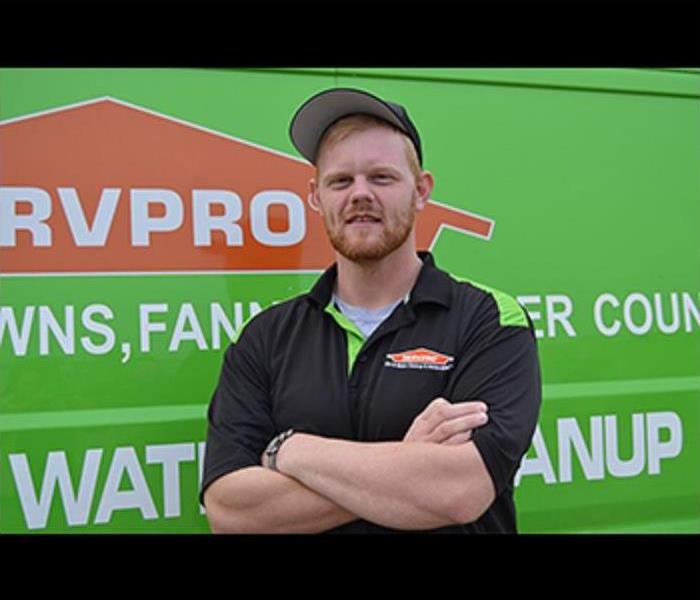 Clancy Shelton - Crew Chief
Clancy Shelton - Crew Chief
Clancy Shelton has been a Crew Chief for SERVPRO of Union, Towns, Fannin, and Gilmer Counties for approximately 2 years servicing the Hiawassee, Blairsville, Young Harris, Blue Ridge, and Ellijay communities.
Clancy has the an IICRC certification in WRT.
The thing Clancy likes most about being a part of the SERVPRO team is going to different places, meeting new people, and being able to help customers through what can be an over-whelming situation.
He has learned how to focus on what needs to be done in a chaotic situation.
When Clancy is not at work, he enjoys doing anything outdoors. But most of all, he adores spending time with his adorable daughter.
Meet Our Team-Karon Davis
9/18/2020 (Permalink)
 Karon Davis - Accounting Clerk
Karon Davis - Accounting Clerk
Karon Davis has been an Accounting Clerk for SERVPRO of Union, Towns, Fannin, and Gilmer Counties for approximately 8 years servicing the Hiawassee, Blairsville, Young Harris, Blue Ridge, and Ellijay communities.
Karon has the following IICRC certifications in WRT and notary public.
The thing Karon likes most about being a part of the SERVPRO team is working with a team that truly cares about their customers and each other. Also, experiencing a team caring and treating one another like family.
While at SERVPRO, Karon has learned that your duct work needs cleaning often; as well as water and humidity can be very damaging.
When Karon is not working, she enjoys to cross stich and read. But most of all, she enjoys spending time with her wonderful family and grandkids.
Meet Our Team-Jeff Van Mill
9/16/2020 (Permalink)
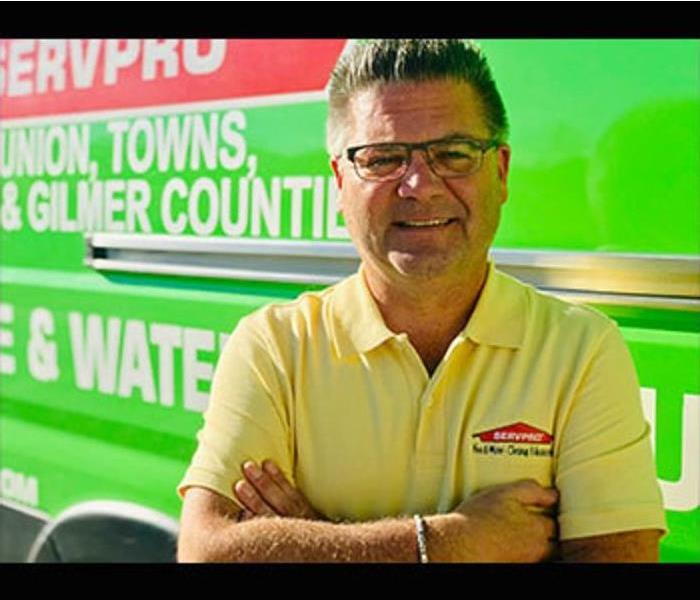 Jeff Van Mill - Marketing Representative
Jeff Van Mill - Marketing Representative
Jeff Van Mill has been a Marketing Representative for SERVPRO of Union, Towns, Fannin, and Gilmer Counties for 1 year servicing the Hiawassee, Blairsville, Young Harris, Blue Ridge, and Ellijay communities. Over that time period he has learned how important mold coverage is to have on your insurance policy and that close-knit teamwork is needed when handling crisis situations. He has also learned how a terrible flood, and how important it is be handled promptly to turn the situation around.
The thing Jeff likes most about being a part of the SERVPRO team is helping customers get thru a bad situation they’ve never gone through before. He also values working with a great team and customers, with no drama, and meeting new people and networking.
When Jeff is not working, he enjoys gardening and taking care of plants. He likes going to parks, waterfalls, and vineyards with his dogs, along with taking day trips to new places.
Meet Our Team-Chris Henson
9/13/2020 (Permalink)
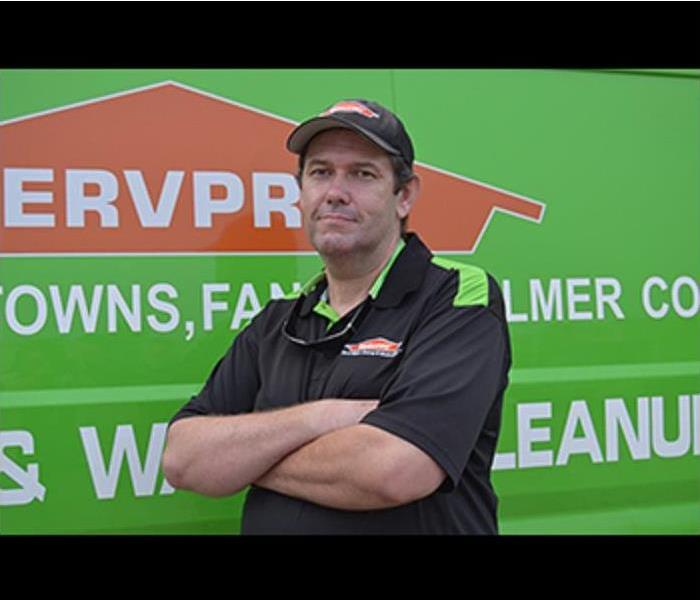 Chris Henson-Crew Chief
Chris Henson-Crew Chief
Chris Henson has been a Crew Chief for SERVPRO of Union, Towns, Fannin, and Gilmer Counties for approximately 2 years servicing the Hiawassee, Blairsville, Young Harris, Blue Ridge, and Ellijay communities.
Chris has the following IICRC certifications in WRT and CCT.
The thing Chris likes most about being a part of the SERVPRO team is being able to assist our customers in their time of need.
The most influential thing he has learned by being apart of the SERVPRO team is it’s better to work together as a family.
When Chris is not working, he takes pleasure in spending quality time with his beautiful grandchildren.
When DIY is Not a Good Idea
8/10/2020 (Permalink)
Some people in Northern Georgia attempt to save money on the expense of water or mold damage restoration by skipping the process of hiring restoration professionals. Instead, they try to handle the tear-out and dry-out processes themselves. For many "minor" spills (those only involving a few gallons of water at most), this can be fine as long as the spill is cleaned up quickly and occurs well away from walls or other places where the moisture from the spill can reach a gap and seep into the subfloor.
But that kind of DIY is usually NAGI (not a good idea). Whenever there's a major amount of moisture damage, it's very important for a professional restoration service like SERVPRO of Union, Towns, Fannin & Gilmer Counties to be brought in to manage the dry-out process. Without the help of a trained and experienced expert, someone who attempts DIY moisture removal may miss pockets of moisture in the building, leading to:
- Damaged building infrastructure - moisture can seep into the structural materials behind the walls and under the floor, causing damage. But with proper dry-out and moisture remediation, much of the damage can be mitigated or even avoided.
- Warped flooring - when moisture seeps into subfloor materials, it can cause wooden boards to shift, bend, and cup. This creates an uneven floor and poses a safety risk to the building’s occupants.
- Mold growth - left unchecked, moisture trapped in a building can promote the growth of mold, particularly in cool, dark places such as basements and in-between walls. As any IAQ (Indoor Air Quality) Specialist can tell you, mold spores in the air pose a serious respiratory risk to children and people with respiratory conditions such as asthma.
As a rule of thumb, if the water or mold damage to your home or business is severe enough to warrant an insurance claim, then you shouldn't try to handle the restoration process on your own. Damage that occurs as a result of DIY restoration efforts is typically not covered by insurance, and restoration work can be hazardous for those who haven't been trained for the risks associated with working amidst dirty water, mold, and water-damaged structures.
As a character of Clint Eastwood once said, "A man’s got to know his limitations." So, if you don’t have experience making water or mold damage "Like it never even happened," then give SERVPRO of Union, Towns, Fannin & Gilmer Counties a call immediately!
7 Reasons Not to Ignore Water Damage
6/5/2020 (Permalink)
If you experience water damage in Northern Georgia, it’s no big deal. Right? Afterall, it’s only water. But water is known as the universal solvent for a good reason - because it dissolves more substances than any other liquid. That includes major structural parts of your home or business. And that’s just the tip of the iceberg. Here’s are seven negative impacts of leaving water damage untreated:
- Devalued Property - The signs of water damage are difficult to hide. They’ll usually reveal themselves to any appraiser even if you attempt to paint over the stains. Also, when water’s left untreated, a repellent smell can linger which will probably turn buyers away.
- Structural Damage - this occurs depending on the amount of water surrounding the affected area. Drywall begins to deteriorate and the subfloor can easily warp or even split, meaning you’ll end up replacing and restoring the affected areas. Even solid materials that foundations are made of, whether masonry, concrete or stone, can soak up small amounts of water through their cracks and pores. Unless these pockets of water are removed, they can create defects in the building foundation that eventually weaken the entire structure.
- Mold - Any presence of water can cause mold to begin growing in as quickly as 48 hours. Once mold is present, it can be very difficult and expensive to treat and remove. Also, if mold is left untreated it can spread and can cause health effects.
- Electrical Damage - Once electrical systems are damaged by moisture, wiring, outlets, and electric boxes become unsafe to use until they’re professionally inspected. Electrical water damage usually occurs to kitchen appliances, washing machines, dryers, hot water tanks, furnaces, and low mounted electrical outlets.
- Health Hazards - A home or business exposed to floodwaters are susceptible to harmful bacteria and other microbes. If not treated correctly, toxins will linger on your affected furniture, carpets, and inside your HVAC system long after the water has dried. Those bacteria and microbes can cause serious respiratory issues and other health issues.
- Lost Personal Items - The same water that causes structural damage can destroy many personal items including, photographs, books, electronics, and personal documents, among other items. However, if you act quickly and call SERVPRO of Union, Towns, Fannin & Gilmer Counties, we can help save and restore many of your personal items.
- And…Bugs! - Bugs love moisture and water damage creates the perfect breeding ground for mosquitoes, beetles, fleas, ticks, spiders, and more. And the hatching eggs and dying bugs will attract even more insects to the area as well as spread bacteria.
As you can see, when water damage occurs, immediate action is needed as it helps to minimize the damage and cleaning and restoration costs. SERVPRO of Union, Towns, Fannin & Gilmer Counties is strategically positioned to be faster to any size emergency. Be sure to give us a call so you never have to suffer long from the seven dangerous impacts of water damage.
Cleaning and Disinfecting – They’re Not the Same
5/12/2020 (Permalink)
Our homes are supposed to be a haven where we can relax and recuperate from the pressures of the world. Unfortunately, we wind up bringing home some of the world and its germs through dirty hands, shoes, clothing, and phones.
Even if your North Georgia home looks clean, it could still be hiding contaminants that could affect your health. Dr. Michael Schmidt, professor of microbiology at the Medical University of South Carolina and chair of the American Society of Microbiology's Council on Microbial Sciences, says that the best way to protect your family is to quite simply to clean your house.
Dr. Schmidt points out that after washing our hands, the best way to protect your family is to wipe down countertops, doorknobs, light switches, and common surfaces with a microfiber cloth dampened in a solution of hot water and an all-purpose cleaner twice a day. "The slight abrasion of the microfiber cloth and the cleaning solution will lift and dilute any microbes that have settled on the surfaces," says Dr. Schmidt. "Since electronics don't hold up well to soap and water, use an alcohol wipe with at least 70% isopropyl alcohol to clean cell phones, remotes, and keyboards."
But cleaning shouldn't be confused with disinfecting. Cleaning means you're removing germs, but not killing, while disinfecting means you're actually killing them. This difference is important because you might clean surfaces well but you might not be disinfecting, leaving germs and bacteria to grow.
However, "Disinfecting cleaners can give a false sense of security if they are not used properly and are only necessary if someone in the household is ill," says Dr. Schmidt. The crucial areas to address are surfaces shared by family members and those that come in close contact with bodily fluids. If you have dirty windows, they aren't a big health concern, but a doorknob touched after a sneeze can be.
It’s important to read labels and follow the directions on products. Products labeled as disinfectants will adequately kill viruses and bacteria if used correctly. But if the label promises to just "sanitize" a surface, the fine print might say it’ll kill 99.9% of the bacteria, but not mention if it's effective against viruses or fungi. You want to look for disinfectants because they can kill bacteria, viruses, and fungi when used properly.
Before disinfecting anything in your house, decide whether you'll wear gloves and what kind. Rubber gloves are more durable and reusable, but disposable latex ones also work. Just remember to always wash your hands with soap and warm water after using any cleaning products.
If you need help with any deep cleaning and disinfecting needs, contact us at SERVPRO of Union, Towns, Fannin & Gilmer Counties. Not only do we use the proper disinfectants, but our professionals receive the necessary training and field experience to service your home or workplace to achieve the highest standards of cleanliness and customer satisfaction.
Bleach Disinfects – But it Can Also Be Dangerous
5/7/2020 (Permalink)
Chlorine-based bleach has been around for a long, long, time. It was invented in Europe in the late 18th century, and many consider it the be-all and end-all solution to their cleaning needs. And now with concerns about the coronavirus (Covid-19), it’s use has greatly increased. The good news is that the Centers for Disease Control and Prevention (CDC) recommends a diluted bleach solution for disinfecting your home against Covid-19. But make sure your bleach isn’t past its expiration date or it’ll be ineffective against the virus.
The CDC recommends using the following solution on an appropriate hard surface. (See ‘Why Not to Use Bleach’ below.) Be sure to let this solution set for at least one minute:
- 5 tablespoons (1/3rd cup) bleach per gallon of water
OR - 4 teaspoons bleach per quart of water
For soft or hard surfaces, the CDC recommends you disinfect with any of these EPA-registered household disinfectants. They meet EPA’s criteria for use against COVID-19.
Why Not to Use Bleach
But while bleach can help disinfect your home, in reality it’s a dangerous chemical that can do you great harm if you’re not careful. Here are the Top Ten reasons why bleach isn’t always a good choice for cleaning your Northeast Georgia home:
- Chlorine lacks detergency – in other words, it contains no wetting agents that allow it to penetrate soils, so surfaces must be pre-cleaned before chlorine will effectively kill germs. This is a 2-step process that requires more time.
- Chlorine is very caustic to human tissue. It can produce irritation and burning on your skin and could cause blindness.
- Chlorine reacts with other chemicals to create toxic byproducts and gases. For instance, when bleach mixes with ammonia, it can form chlorine gas, causing cellular damage in nasal passageways and lungs. The accidental mixture of these two products has resulted in death. It’s also incompatible with products that contain hydrochloric acid, phosphoric acid and acetic acid (vinegar).
- It may harm your children. After using, bleach remains on surfaces and continues to emit fumes. Recent studies show that children who been exposed to bleach in their homes are more likely to suffer from respiratory illness. In addition, various studies have linked the use of bleach in a household to a higher prevalence of asthma and allergies.
- Using bleach can hurt your pets. Your cleaning products can stay on a pet’s paws or fur. Since cats and dogs often lick themselves, they may ingest harmful chemicals. Due to their tiny size, birds can become sick upon inhaling only a small amount of the fumes. Bleach poisoning in pets can result in vomiting, convulsions, and sometimes death.
- Bleach can kill mold, BUT it depends on the surface the mold is on. Mold grows on both porous and non-porous materials. When dealing with mold on non-porous materials such as shower tiles, tubs, vinyl window trims, counter tops, etc. you can use bleach to kill the mold and disinfect. But using bleach to remove mold from porous materials like drywall and wood can actually accelerate mold growth rather than killing it!
How? When bleach is used on porous materials, the chlorine is left on the surface and only the water component of the bleach is absorbed into the material, aggravating the situation as this provides more moisture for the mold to feed on, where it may then produce allergens and irritants. If you have a mold infestation, call SERVPRO of Union, Towns, Fannin & Gilmer Counties to professionally remove it.
- Chlorine is extremely corrosive to metal surfaces and can permanently discolor countertops. It can also damage floor finishes, requiring them to be stripped and recoated, which is an expensive process.
- Chlorine discolors fibers and colored surfaces. Carpets, upholstery and clothing are just a few of the materials that may be damaged.
- Chlorine bleach’s disinfectant power is rapidly inactivated by contact with organic matter, such as blood, saliva, tissue, urine, feces, dirt, etc. Chlorine is also weakened by sunlight.
- Diluted chlorine bleach quickly loses its effectiveness, is unstable and can lose its disinfectant qualities very rapidly compared to other, more stable disinfectants.
Safe and Effective Alternatives to Bleach
- Baking soda and white vinegar – they’re non-toxic and non-corrosive. Use them to freshen fabrics, eliminate grease, and clean glass. (Not effective against COVID-19)
- Rubbing alcohol – effectively cleans plastic surfaces of electronics (A concentration of around 70% will kill COVID-19)
- Hydrogen peroxide – it’s nontoxic and can be used to disinfect household surfaces. Unlike bleach, hydrogen peroxide is safe to use around food products. (Effective against COVID-19)
- Soap and warm water – the basics! It’ll clean just about anything in your home and won’t present any health risks. (Effective against COVID-19)
Although bleach products may be a bargain, you owe it to yourself, your family or coworkers to use a product that truly cleans, thoroughly disinfects and is safe to use.
We are Cleaning Experts
3/28/2020 (Permalink)
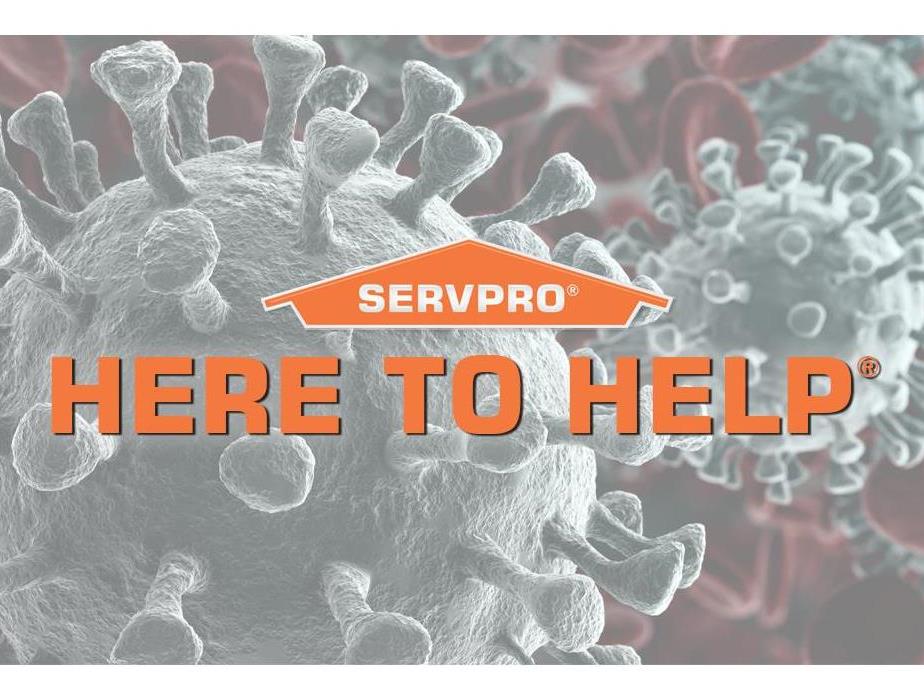 SERVPRO of Union, Towns, Fannin & Gilmer Counties is Here to Help
SERVPRO of Union, Towns, Fannin & Gilmer Counties is Here to Help
SERVPRO is Here to Help during this time of need
During this unprecedented time caused by the global pandemic of coronavirus, this is a reminder to our customers that we are specialists in cleaning services, and we adhere to the highest cleaning and sanitation standards.
Specialized Training
We are prepared to clean and disinfect your home or business, according to protocols set forth by the Centers for Disease Control and Prevention. We have years of experience in dealing with biological contaminants, and we will go beyond the scope of work that regular janitorial staff perform on a daily basis.
The CDC encourages cleaning of high-touch surfaces such as counters, tabletops, doorknobs, light switches, bathroom fixtures, toilets, phones, keyboards, tablets and tables. Other spaces mentioned in the CDC’s guidance for commercial spaces include:
- Kitchen/Food Areas
- Bathrooms
- Schools/Classrooms
- Offices
- Retail Spaces
- Water Fountains
- Shelving/Racks
- Sales Counters
- Carpets and Rugs
- Stair Handrails
- Elevator Cars
- Playground Equipment
- Fitness Equipment
Specialized Products
The CDC recommends usage of a labeled hospital-grade disinfectant with claims against similar pathogens to the coronavirus. Multiple products in the SERVPRO product line carry the EPA-approved emerging pathogens claims. While there is currently no product tested against this particular strain of the coronavirus, we are following all guidelines as provided by the CDC and local authorities.
Call Today for a Proactive Cleaning
If your home or business needs deep cleaning services, call the experts today – SERVPRO of Union, Towns, Fannin & Gilmer Counties, 706-896-1880
Sources:
https://www.cdc.gov/coronavirus/2019-ncov/hcp/guidance-prevent-spread.html?CDC_AA_refVal=https%3A%2F%2Fwww.cdc.gov%2Fcoronavirus%2F2019-ncov%2Fguidance-prevent-spread.html
https://www.cdc.gov/coronavirus/2019-ncov/specific-groups/guidance-business-response.html
After a Fire, the Danger Isn't Over
3/15/2020 (Permalink)
There’s been a fire at your home or business. Once the firemen leave, your first inclination may be to go inside the structure to see what’s salvageable and start the cleaning process. But cleaning up after a fire is much more complicated than regular cleaning. It’s also very dangerous. Because once the last flame has been snuffed out, the dangers from a fire linger.
Soot Hazards
Since fire destroys all materials, the soot that covers everything you touch and that you kick up in the air is full of toxic substances. That’s why the highly trained professionals at SERVPRO of Union, Towns, Fannin & Gilmer Counties wear heavy duty personal protection equipment (PPE) on fire mitigation jobs until all the soot is removed. Here are some of the poisons found in the soot and ashes of a building fire:
- Mesothelioma (cancer) causing asbestos fibers from building materials
- Carbon materials can produce carbon monoxide, ammonia, and nitrogen oxides
- PVC can create hydrogen chloride, phosgene (used as a chemical weapon during World War I), dioxin, Refrigerant-40, bromomethane (a pesticide), etc.
- Hydrogen sulfide and sulfur dioxide (poisonous gasses)
- Petroleum based items can produce formaldehyde, acrolein, furfural, cresols, and other harmful chemicals
- Even wood smoke releases more than 100 chemicals also found in cigarette smoke
Removing the Odors
One of the main aftereffects of a fire are odors. These can be difficult to remove without professional know-how and equipment. For instance, did you know that four factors (The Four S’s) can impact the strength of fire odors? Those are:
- Size - The bigger the fire, the more objects have burned, and thus there’s been more smoke.
- Span -The longer a structure has been exposed to smoke, the more deeply odor has seeped into porous materials.
- Space - When a fire occurs in a smaller room, the smoke odor becomes more intense and concentrated.
- Stuff - Not all odors are equal. For instance, burning wood, plastic and protein, all emit different smells with varied consistency.
SERVPRO of Union, Towns, Fannin & Gilmer Counties has the knowledge and equipment to eliminate the diverse and pungent odors that occur after a fire. Besides the easily accessible areas, we also examine wall cavities, duct work, crawl spaces and plumbing chases to establish whether they also suffered any smoke or fire damage. We’ll ensure that they’re cleaned, repaired and that all traces of odor are removed.
So as tempting as it may be to rush back into your fire damaged home or business once the fire is out, play it safe and call SERVPRO of Union, Towns, Fannin & Gilmer Counties so that we can safely make it “Like it never even happened.”
Do You Have "4" Knowledge?
3/10/2020 (Permalink)
There’s been a fire at your home or business. Once the firemen leave, your first inclination may be to go inside the structure to see what’s salvageable and start the cleaning process. But cleaning up after a fire is much more complicated than regular cleaning. It’s also very dangerous. Because once the last flame has been snuffed out, the dangers from a fire linger.
Soot Hazards
Since fire destroys all materials, the soot that covers everything you touch and that you kick up in the air is full of toxic substances. That’s why the highly trained professionals at SERVPRO of Union, Towns, Fannin & Gilmer Counties wear heavy duty personal protection equipment (PPE) on fire mitigation jobs until all the soot is removed. Here are some of the poisons found in the soot and ashes of a building fire:
- Mesothelioma (cancer) causing asbestos fibers from building materials
- Carbon materials can produce carbon monoxide, ammonia, and nitrogen oxides
- PVC can create hydrogen chloride, phosgene (used as a chemical weapon during World War I), dioxin, Refrigerant-40, bromomethane (a pesticide), etc.
- Hydrogen sulfide and sulfur dioxide (poisonous gasses)
- Petroleum based items can produce formaldehyde, acrolein, furfural, cresols, and other harmful chemicals
- Even wood smoke releases more than 100 chemicals also found in cigarette smoke
Removing the Odors
One of the main aftereffects of a fire are odors. These can be difficult to remove without professional know-how and equipment. For instance, did you know that four factors (The Four S’s) can impact the strength of fire odors? Those are:
- Size - The bigger the fire, the more objects have burned, and thus there’s been more smoke.
- Span -The longer a structure has been exposed to smoke, the more deeply odor has seeped into porous materials.
- Space - When a fire occurs in a smaller room, the smoke odor becomes more intense and concentrated.
- Stuff - Not all odors are equal. For instance, burning wood, plastic and protein, all emit different smells with varied consistency.
SERVPRO of Union, Towns, Fannin & Gilmer Counties has the knowledge and equipment to eliminate the diverse and pungent odors that occur after a fire. Besides the easily accessible areas, we also examine wall cavities, duct work, crawl spaces and plumbing chases to establish whether they also suffered any smoke or fire damage. We’ll ensure that they’re cleaned, repaired and that all traces of odor are removed.
So as tempting as it may be to rush back into your fire damaged home or business once the fire is out, play it safe and call SERVPRO of Union, Towns, Fannin & Gilmer Counties so that we can safely make it “Like it never even happened.”
Water Damage Can Be Invisible
2/6/2020 (Permalink)
Have you ever seen the disappearing water trick where a magician causes water that’s poured into a cup to magically vanish, as if into thin air? (Spoiler alert: sodium polyacrylate, the stuff in disposable diapers, is first put in the bottom of the cup to soak up the water!)
But water can still disappear even without any “magic” involved. It’s very adept at hiding and can be almost invisible. It sometimes hides so effectively that it can’t be detected unless special moisture meters are used. Why do you need to know this? Because even though water is essential for life, it’s also one the most destructive elements that can attack your north Georgia home or business.
It Can Run…
Water can be elusive because of the way it moves. It spreads out like the letter "T" – moving out and downward from its source. Even if water looks to be setting still, it really isn’t. Gravity continues to pull it down into the surface of the material it’s resting on. And as it moves, it spreads and soaks into whatever porous (allowing liquid or air to pass through) materials it encounters. But after spreading out and down it has another trick up its sleeve. It can also move up. It does this by wicking action. For example, water sitting at the bottom of drywall can wick up the wall at a rate of one inch per hour for the first 24 hours!
Because of water’s meandering ways it can easily hide inside insulation, behind walls and cabinets and in subfloors. Even if a surface feels dry, there may still be moisture hiding underneath or inside of it. What this can mean for your north Georgia home or business is that secondary damage like mold or warping may occur. It can even ruin expensive hardwood floors.
But it Can’t Hide
If you have, or even if you suspect you may have water damage, it’s highly important that a professional from SERVPRO of Union, Towns, Fannin & Gilmer Counties comes out and tests for moisture with specialized moisture meters and thermal imaging cameras. With this equipment we’ll be able to locate the confines of the affected area and show you the scope of the damage. Then our techs will go to work removing and drying the moisture to ensure that no further damage occurs, making it “Like it never even happened."
Why do we do this? Because water can’t hide from SERVPRO of Union, Towns, Fannin & Gilmer Counties!
Union, Towns, Fannin & Gilmer Counties 24 Hour Emergency Water Damage Service
12/23/2019 (Permalink)
SERVPRO of Union, Towns, Fannin & Gilmer Counties is available 24 hours a day for water emergencies, large or small. When you are dealing with water damage, immediate action is crucial. A delay of just a few hours can greatly increase the severity of the water damage.
We Answer the Phone Ready to Help
Call Today - (706) 896-1880
We understand that when you call us, you may be feeling confused, stressed, and vulnerable. You need an expert to guide you through this crisis. SERVPRO of Union, Towns, Fannin & Gilmer Counties has the specific water damage training and experience to help you through this tough time. We specialize in water damage restoration—in fact, it's the cornerstone of our business.
What to Expect
When you call, we will ask several questions regarding your water damage emergency. These questions will help us determine what equipment and resources to bring, including how many trained SERVPRO Professionals may be needed.
Our SERVPRO Representative will ask several questions:
- Your name and contact information
- Your insurance information (if applicable)
- The street address of the water-damaged home or business
- When did the flooding or water damage occur?
- What caused the water damage (if known)?
- Is there electricity available (on-site)?
About SERVPRO of Union, Towns, Fannin & Gilmer Counties
SERVPRO of Union, Towns, Fannin & Gilmer Counties specializes in the cleanup and restoration of residential and commercial property after a fire, smoke or water damage event. Our staff is highly trained in property damage restoration. From initial and ongoing training at SERVPRO’s corporate training facility to regular IICRC-industry certification, rest assured our staff is equipped with the knowledge to restore your property.
http://www.SERVPROuniontownsfanningilmercounties.com/crew-photos
National Preparedness Month
9/28/2019 (Permalink)
SERVPRO Industries, LLC, is once again proud to be a member of the National Preparedness Month Coalition and is committed to helping the U.S. Department of Homeland Security in their efforts to promote the importance of preparedness planning.
What does it mean to be prepared?
For FAMILIES, it means households have an emergency supply kit so they can be self-reliant for at least three days in case of emergency, and they have a plan for how they will respond and reconnect after an emergency.
For BUSINESSES, it means employers have planned for how they will survive a disaster; they've backed up critical information, developed a plan for assisting employees on site, established a call tree to account for employees, and identified back-up sources of power and supplies.
For SCHOOLS, it means schools and districts have developed, implemented, and communicated crisis plans.
Being prepared means staying informed, knowing how to get information and alerts from local emergency management agencies, and understanding the specific risks in your community and preparing against them.
Home Carpet Cleaning Should Always Involve Professionals
9/27/2019 (Permalink)
Frequent home carpet cleaning is the only sure way to keep carpeting in good shape, but too many people still neglect to perform it often enough. Carpeting sustains a lot of wear and tear, picking up pet dander, soils, food particles, water, chemical residues, and a number of other contaminants. If these contaminants are allowed to sit for too long, they can damage the fibers, discolor them, or even attract pests or mold. It’s a situation no homeowner wants to get into, and professional treatment is the only way to ensure it doesn’t become a reality.
Why should professionals be brought in to perform home carpet cleaning?
It’s often impossible to know just how soiled the carpeting is, so it’s best to ensure treatment is thorough. And when it comes to thorough treatment, certified technicians are a homeowner’s best bet. Store bought or rented machines are limited in their effectiveness, and don’t provide the same level of performance that a commercial machine offers. Rented machines can’t agitate the fibers as vigorously, they can’t penetrate as deeply as a commercial machines, and they aren’t as precise. This leads to inferior treatment and rapid resoiling of the carpeting.
While operating rental machinery may seem simple, there’s more to the process than one might realize. The biggest problems untrained people have when cleaning their carpets is using too much or too little water. With too little water, it will be impossible to effectively remove soils, and detergent residue will be left behind to dry and adhere to the flooring. Too much water, and the floor will remain damp for too long, allowing mold and pests to take root, and making it easy for people to dirty the flooring again. A lack of training is not the only issue, either, as rented machinery isn’t as precise at dispensing water, nor is it powerful enough to reliably extract it.
Professional home carpet cleaning firms do not have these issues, as they are certified in the best industry practices and have the commercial quality equipment to match their expertise. For example, certified crews have received training from the Institute of Inspection, Cleaning and Restoration Certification (IICRC), and are armed with the IICRC’s sophisticated treatment practices. This includes comprehensive procedures in removing dry soil, suspending matted-in soils, and removing them as well. Soil suspension and removal is not something a homeowner is equipped to handle, and that’s a problem because most of the worst soils are matted into the flooring.
Certified home carpet cleaning professionals have powerful technology, including water extraction machines that agitate the fibers down to the backing. Professionals can also treat the carpeting to protect it from additional soiling and extend the carpeting’s longevity. It’s much more affordable than replacing the carpet, and much less of a headache, so professional treatment should be considered an investment, and not just a service.
www.IICRC.org
How To Choose Water Damage Restoration Services
9/27/2019 (Permalink)
When a storm leaves a home flooded, or a burst pipe causes serious issues in the house, getting water damage restoration services from a respected company should be considered a top priority. Unfortunately, this industry is not regulated, and there are people out there who pose as professionals or overstate their qualifications. Therefore, homeowners should be mindful of who they hire, as an untrained technician may do more harm than good or delay repairs, resulting in a higher degree of destruction. Before selecting a company to handle the job, keep in mind these points of emphasis:
· Only choose certified professionals to perform water damage restoration services. Even though the industry is not regulated, technicians who have received certification have made the effort to get the best training possible, proving that they take their job seriously. Certification through the Institute of Inspection, Cleaning and Restoration Certification (IICRC) is a sign that a professional has received the most up to date training and is knowledgeable in the latest techniques and technologies employed during repairs. The IICRC operates a Certified Firm registrant-only database on its site, making it easy to find a local, certified professional without trouble.
· Do not select a technician based only on the price or an insurance company’s recommendation. When possible, speak to neighbors or friends who have had to hire a technician recently and try to get a recommendation from them. Insurance companies often select a restoration company based on price, and unusually low pricing suggests the company does not use modern drying or repair methods.
· Choose a company that offers a range of water damage restoration services. The easiest way to determine the expertise of a firm is to see if they provide a full range of options for homeowners. Mold remediation, for example, is often needed given how quickly mold can set in. This is a standard field of knowledge that advanced technicians should possess. If a company doesn’t offer mold remediation, it may not be prepared for all job settings.
· A company that is available 24/7 is a good sign. Stay away from any firms that are reluctant to start right away. In many cases modern equipment can enable near-complete drying in as little as 36 hours, although many situations require longer. Also, a homeowner should not have to wait before repairs begin. Every minute counts when there is standing water present, and reputable professionals understand this. If a technician insists on waiting to begin the remediation portion of the loss, they probably cannot be trusted to see the job through in a reasonable timeframe.
Using these guidelines, a homeowner should be able to find a technician that can be trusted and is equipped to do the job the right way. A storm or other disaster is hard enough to deal with, and a remediation firm should do everything in its power to make this difficult process easier.
http://www.IICRC.org
Flooded Home Results in Mold
9/26/2019 (Permalink)
An unrecognized water loss resulted in this home being over-run with large amounts of mold. The home was a second home in Blairsville, GA and was not frequently visited. This photo shows what moisture left unattended can lead to.
If you see visible mold, do not disturb it. You can inadvertently spread the mold infestation throughout your home. When mold is disturbed, the mold can release microscopic mold spores which become airborne and can circulate inside your home.
What to Do:
- Stay out of affected areas.
- Turn off the HVAC system and fans.
- Contact SERVPRO of Union, Towns, Fannin & Gilmer Counties for mold remediation services.
What Not to Do:
- Don’t touch or disturb the mold.
- Don’t blow air across any surfaces with visible or suspected mold growth.
- Don’t attempt to dry the area yourself.
- Don’t spray bleach or other disinfectants on the mold.
SERVPRO of Union, Towns, Fannin & Gilmer Counties was called in to handle the damage to this home. The owners of this property were overjoyed with the results.
Hiring Rug Cleaning Services Instead Of Attempting DIY
9/26/2019 (Permalink)
Choosing to hire certified rug cleaning services rather than opting to tackle a more DIY approach is the best option for any homeowner. While the process may seem as simple as a good vacuum and spot removal job, those alone will not help in prolonging the life of the rug. Many are instead leaving it up to a technician that has been highly educated and trained through the Institute of Inspection, Cleaning, and Restoration Certification (IICRC) will ensure the job is done properly. They have the latest tools and skills to carry out the job with the utmost care and detail.
An increasing number of homeowners are finding themselves with area rugs in one or more rooms of their living space. Typically, they take quite a bit of abuse due to the day-to-day wear and tear done by family, pets, and guests. That heavy foot traffic leaves dirt, dust, odors and stains behind. What started out as a useful, yet decorative piece in a room ends up looking worn, dingy, and full of bothersome allergens. Routine upkeep such as vacuuming and minor stain removal can be done, yet it is imperative to have the piece removed and professionally cleaned on a regular basis. The frequency of this process truly depends on the extent of use the piece has.
Technicians that are IICRC-certified have had the coursework and training necessary to provide superior rug cleaning services. From start to finish they will work tirelessly to restore the piece to its original, vibrant appearance. This attention to detail starts with an initial inspection to establish the type of material that will be dealt with, what debris and allergens are present, and if there is any damage to be addressed. At this time they will be able to give the homeowner an idea of the extent of treatment and time frame required. Typically the piece is removed from the home and brought to the business location, which is fully equipped to complete the job. The technician starts with a careful vacuuming to remove loose debris, which is followed by any needed stain and damage treatment, and a good rinse. Once completely dampened a gentle but effective cleansing solution is applied and a soft agitating brush is used on the surface. A hot water extraction technique may be utilized at this time for a deeper clean or it may go through a total immersion process. The rug is then meticulously rinsed.. Depending on the equipment in place, it may be placed in a rotating centrifuge to draw out a majority of the water or other another extraction method may be utilized. It is hung for complete drying before being transported and delivered back to the home. Prior to final delivery it will be groomed via a finishing brush and a combing of the fringe to complete its pristine appearance.
While the do-it-yourself approach may seem doable to some, a true comprehensive treatment can only be done by those certified to perform these specialized rug cleaning services. It is important for homeowners to do a little investigating prior to choosing the firm to entrust with the job. Personal and online recommendations are a great starting point, as is the IICRC's own website. They provide a database of certified firms that are current on their training and continue to follow the industry standards. Additionally, viewing their website, contacting the business directly, and even visiting their facility will offer insight into the service and result to be expected.
For most, this type of floor covering was an investment in the home's warmth and overall decor. While it is there to be walked upon, it is also important to protect and maintain it regularly.
www.IICRC.org
Union, Towns, Fannin & Gilmer Residents: We Specialize in Flooded Basement Cleanup and Restoration!
9/25/2019 (Permalink)
A basement can flood at any time, although flooding most often occurs during heavy rainfall. Basements are inherently prone to flooding because they are the lowest level of a building and are normally built partly or entirely below ground level. There are a number of reasons why your basement could flood, including:
- A blocked or failed sewer lateral pipe
- Heavy rain causes surface water to pool around your home
- Storm sewer backup
- Sanitary sewer backup
- Foundation drainage failure
- Water supply-line break or hot-water tank failure
- And many more
Have Questions about Basement Flooding?
Call Today - 706-896-1880
If flood water is not handled quickly and properly, it can jeopardize your health and safety, and cause severe damage to your home’s structure. Remember, the longer you wait, the worse the problem will get.
The bottom line: a flooded basement can jeopardize your health, safety, and your home’s integrity. It’s worth making a call to SERVPRO of Union, Towns, Fannin & Gilmer Counties and let our trained, professional crews handle the situation safely and correctly. We have earned the trust of hundreds of homeowners, business owners, and property professionals.
We are Flooded Basement Specialists:
- We are Available 24 hours/7 days per week
- We’re a Preferred Vendor to many National Insurance Companies
- We Bill The Insurance Directly – One Less Thing For You To Worry About
- Our Technicians are Highly-Trained in Water Restoration Techniques
- We use s500 IICRC Restoration Standards
- Advanced Inspection and Extraction Equipment
Basement Flooded? Call Us Today – We’re Ready To Help 706-896-1880
Choosing the Proper Fire Extinguisher
9/25/2019 (Permalink)
A fire extinguisher can be a life-saving tool when used correctly. The U.S. Fire Administration (USFA) recommends individuals are properly trained in order to use and maintain an extinguisher.
USFA says an extinguisher should only be used if:
- You have alerted other occupants and someone has called the fire department.
- The fire is small and contained to a single object, such as a wastebasket.
- You are safe from the toxic smoke produced by the fire.
- You have a means of escape identified and the fire is not between you and the fire escape route.
- Your instincts tell you that it is safe to use an extinguisher.
Classes of Fire Extinguishers:
Class A: Use on ordinary combustible materials, such as cloth, wood, rubber, paper, and many plastics.
Class B: Use on flammable liquids, such as grease, gasoline and oil.
Class C: Use on appliances, tools, or other equipment that is electrically energized or plugged in.
Class D: Use on flammable metals and are often specific for the type of metal in question. These are typically found only in factories working with these metals.
Class K: Use on vegetable oils, animal oils, or fats in cooking appliances. These are generally found in commercial kitchens, but are suitable for the residential market.
Check out the Fire Equipment Manufacturers Association for more information about fire extinguisher use, type and care.
Smoke and Soot Cleanup
9/24/2019 (Permalink)
Smoke and soot is very invasive and can penetrate various cavities within your home, causing hidden damage and odor. Our smoke damage expertise and experience allows us to inspect and accurately assess the extent of the damage to develop a comprehensive plan of action.
Smoke and soot facts:
- Hot smoke migrates to cooler areas and upper levels of a structure.
- Smoke flows around plumbing systems, seeping through the holes used by pipes to go from floor to floor.
- The type of smoke may greatly affect the restoration process.
Different Types of Smoke
There are two different types of smoke–wet and dry. As a result, there are different types of soot residue after a fire. Before restoration begins, SERVPRO of Union, Towns, Fannin & Gilmer Counties will test the soot to determine which type of smoke damage occurred. The cleaning procedures will then be based on the information identified during pretesting. Here is some additional information:
Wet Smoke – Plastic and Rubber
- Low heat, smoldering, pungent odor, sticky, smeary. Smoke webs are more difficult to clean.
Dry Smoke – Paper and Wood
- Fast burning, high temperatures, heat rises therefore smoke rises.
Protein Fire Residue – Produced by evaporation of material rather than from a fire
- Virtually invisible, discolors paints and varnishes, extreme pungent odor.
Our Fire Damage Restoration Services
Since each smoke and fire damage situation is a little different, each one requires a unique solution tailored for the specific conditions. We have the equipment, expertise, and experience to restore your fire and smoke damage. We will also treat your family with empathy and respect and your property with care.
Have Questions about Fire, Smoke, or Soot Damage?
Call Us Today – 706-896-1880
Caleb Weaver: Production Manager
9/23/2019 (Permalink)

SERVPRO® of Union, Towns, Fannin & Gilmer Counties, a premier cleanup and restoration company, congratulates Caleb Weaver, as the new Production Manager. He will be responsible for managing production crews and jobs from start to finish.
Weaver joined the SERVPRO production team in 2009 as a Technician. He progressed to Crew Chief, Senior Crew Chief, and Assistant Production Manager before this promotion. He has earned the Water Damage Restoration and Applied Structural Drying certifications from the Institute of Inspection Cleaning & Restoration . He is a certified lead paint renovator and has also completed forklift training.
“Our most important priority is to provide the very best support and service to our customers,” said Keith Wall, owner of SERVPRO® of Union, Towns, Fannin & Gilmer Counties. “The experience, knowledge and skills that Caleb Weaver brings to our franchise management team will help us better serve our community and continue to ensure our customers' satisfaction.”
“I’m very excited to join the management team at SERVPRO® of Union, Towns, Fannin & Gilmer Counties,” said Weaver. “It’s a unique opportunity to continue to grow as a professional while helping people in a time of need.”
SERVPRO® of Union, Towns, Fannin & Gilmer Counties provides cleanup and restoration services following a fire, water or even mold-related damage. Additional services offered include: cleaning and restoration of special items, such as HVAC duct systems; building exteriors; electronic equipment, including computers and documents that have sustained water damage.
For more information on SERVPRO® of Union, Towns, Fannin & Gilmer Counties , please contact Keith Wall at 706-896-1880.
Fireworks Safety
9/22/2019 (Permalink)
Almost everyone loves fireworks! The Fourth of July is just around the corner and we will be looking forward to watching the beautiful fireworks displays. Some of us will go to local displays and some of us will watch the magnificent displays around the country on television. Did you know that the largest fireworks display in the world happened at the New Year countdown on January 1, 2016? It was in the Philippine Arena, Ciudad de Victoria Bocaue Bulacan, Manila, Philippines, consisting of 810,904 fireworks, lasting for 1 hour 1 minute 32.35 seconds in the pouring rain. Amazing, isn’t it?The Chinese stumbled upon a kind of natural firecracker as early as 200 B.C. They would roast bamboo, which would explode with a bang due to the hollow air pockets inside. They believed that the noise would ward off evil spirits. At some point between 600 and 900 A.D., Chinese alchemists mixed together saltpeter (a common kitchen seasoning) charcoal, sulfur and a few other ingredients, unwittingly yielding the first crude form of gunpowder. It is speculated that they were possibly trying to make an elixir for immortality. When the Chinese began stuffing this volatile substance into bamboo shoots and throwing them into a fire, the first fireworks were born. By the time of the Renaissance, pyrotechnic schools were training fireworks artists across Europe. In the 1830s, the Italians began to incorporate very small amounts of metals and other additives to their fireworks, thus creating the bright, multicolored sparks and sunbursts seen in contemporary fireworks shows. Until then, fireworks were just loud noises, orange flashes and faint golden traces of light. Legend has it that Captain John Smith set off the first fireworks display in America in 1608. Some of the colonists may have gotten a little carried away and a spate of firecracker-related pranks became a public nuisance, prompting officials in Rhode Island to ban the “mischievous use of pyrotechnics” in 1731. Today, most states regulate how and where fireworks may be used, as well as the types of explosives would be available for consumers to purchase. In 2009, nearly 9,000 Americans were hurt by fireworks with a disproportionate number of the injuries occurring in July. This is why fireworks safety is so important. The Fireworks Safety Code • Only buy fireworks marked BS 7114• Don’t drink alcohol if setting off fireworks• Keep fireworks in a closed box• Follow the instructions on each firework• Light them at arm’s length, using a taper• Stand well back• Never go near a firework that has been lit. Even if• It hasn’t gone off, it could still explode• Never put fireworks in your pocket or throw them• Always supervise children around fireworks• Light sparklers one at a time and wear gloves• Never give sparklers to children under 5• Keep pets indoors• Don’t set off noisy fireworks late at night and never past 11pm
Buy Local Extravaganza 2019
9/22/2019 (Permalink)
SERVPRO of Union, Towns, Fannin & Gilmer Counties had so much fun at the Buy Local Extravaganza in Blairsville hosted at North Georgia Technical College! We were able to meet customers and give them information they never knew regarding what was lurking in their HVAC duct systems and information regarding mold due to flooding among so much more! Thank you to everyone who came out to see us! If you didn't get a chance to come out or have questions for us, feel free to contact SERVPRO of Union, Towns, Fannin & Gilmer Counties and our office will be happy to answer any questions you may have any kinds of issues you are experiencing. SERVPRO of Union, Towns, Fannin and Gilmer Counties is always here to help!
What to do in a Flood
9/21/2019 (Permalink)
Floods are one of the most common and widespread natural disasters in the United States, causing more damage than any other weather-related disaster. The location of your home or business has little to do with your risk factor for flooding. Just because you haven’t experienced a flood in the past, doesn’t mean you won’t in the future. According to the National Flood Insurance Program (NFIP), 20% of all claims were for policies in low-risk communities. Floods cost an average of $3 billion in annual losses with the average Commercial claims being $75,000,000.
The American Red Cross (ARC) offers the following flood safety tips:
Stay away from flood waters. If you come up on a flowing stream where the water is above your ankles, stop, turn around and go another way. Six inches of swiftly moving water can sweep you off of your feet.
Do not try to drive on a flooded road. If you approach a roadway that is flooded, turn around and go another way. If you are caught on a flooded road and the water is rising rapidly, get out of the car and get to higher ground. Most cars can be swept away by less than two of moving water.
Keep children out of the water. Children are curious and lack judgment about running water and contaminated water.
That’s pretty basic…so here are some less well known tips to keep you safer in a flood!
- If you have time, secure your home. Bring in outdoor furniture. Move essential items to an upper floor.
- Do not walk through moving water.Use a stick to check the firmness of the ground in front of you.
- Turn off utilities at the main switches or valves if instructed to do so. Disconnect electrical appliances. Do not touch electrical equipment if you are wet or standing in water.
- Six inches of water will reach the bottom of most passenger cars causing loss of control and possible stalling.
- A foot of water will float many vehicles.
After a Flood
- Listen for news reports to learn whether the community’s water supply is safe to drink.
- Be aware of areas where floodwaters have receded. Roads may have weakened and could collapse under the weight of a car.
- Clean and disinfect everything that got wet. Mud left from floodwater can contain sewage and chemicals. Call SERVPRO of Union, Towns, Fannin & Gilmer Counties to help with cleanup, we have the equipment and expertise to restore your home to it's former glory.
The Next Step After Having Fire And Water Damage
9/20/2019 (Permalink)
Fire and water damage are nightmares for any home or business owner because they typically force expensive repairs. This is particularly true when the building is flooded or a pipe bursts. Such disasters can destroy entire floors of a building, and make it uninhabitable until it is cleaned out. But cleaning it out is something that only professionals should be allowed to handle, especially if there is contaminated fluid or a lot of ash residue present. Certified technicians will have the tools and expertise needed to restore the building to normal and allow people to work or live in it without fear of health issues.
How do professionals perform fire and water damage restoration?
The only way to deal with a flame’s aftermath is to clean the area up thoroughly. Even a small fire can leave behind a good deal of ash and soot, and it will become more than just an annoyance if it is allowed to spread through the building. Smoke is another concern, as it will create noxious odors that penetrate through walls and seemingly last forever. Technicians are prepared to work through the building, scrubbing down all affected surfaces, and surveying the property to find areas where the residue has settled. This includes the ventilation system as well, as ash is readily picked up by the building’s climate control system. In places where the residue has formed a thick, almost lacquer-like substance, technicians have special detergents that can eat through the muck and make it easy to wipe away. As for smoke odors, professionals typically use a device known as a thermal fogger. This device will fill the building with particles designed to neutralize smoke odors, and these particles are small enough to reach through walls, so they can go where the smoke is.
Floods, sewage backflows and plumbing disasters offer their own challenges, and take a lot of equipment that only fire and water damage restoration professionals have access to. For example, if the building is harboring several inches of water, industrial strength pumps will be needed to pull it out, and these pumps are often mounted to a truck. Once this is done, trained professionals will be able to identify what materials can be rescued and what materials are completely compromised. It is essential to get this part right because destroyed materials that are left behind can ferment mold and bacterial growth.
Technicians will then work to dry the building, a process that requires several heavy duty air mover fans and dehumidifiers. This normally takes several days to see through, and technicians will monitor drying progress with moisture meters and regular inspections. Also, if there are any areas infested with mold or other microbes, fire and water damage restoration professionals can eliminate the threat with fungicides or other cleaning solutions.
Certified fire and water damage restoration professionals are the people to call when disaster strikes. They can operate in any environment and ensure a building is as good as new, giving people the peace of mind they need when returning home or to work.
www.IICRC.org
Water Damage
9/20/2019 (Permalink)
When the Pipes Crack: Tips to Prevent Water Damage
When extreme temperatures strike, homeowners across the U.S. are crippled with millions of dollars in water damage to homes and buildings.
Leaving a home alone can become an expensive implication if things go astray while you are gone. And unfortunately more often than not, things do go wrong. Opportunely, there are certain things homeowners can do to protect their home and the interior possessions.
Water is the homeowners’ biggest enemy. If a pipe were to burst thousands of gallons of water can begin to flood the home. The IICRC responds as an authority on pulling the pieces back together for home and business owners. When water damage results from cracked pipes, IICRC offers these tips for clean-up.
To Prevent Frozen Pipes:
• Wrap electrical heating tape on exterior pipes. Remove garden hoses from faucets.
• Cover pipes with foam rubber or fiberglass insulation and secure it with tape.
• Let cold and hot water faucets drip. Running water helps prevent freezing pipes and reduces pressure build up in them.
• Inside the home, open kitchen and bathroom cabinet doors to promote warm air circulation around plumbing.
• Leave the thermostat at the same temperature both day and night, at least 55°F.
To Thaw Frozen Pipes:
• Locate the problem pipe, if possible, and open a faucet. As the pipe thaws, running water aids the melting process.
• Apply heat to the frozen section using a hand-held hair dryer or portable electric space heater. Do not use a blow torch as it could cause the pipe to explode. Do not use a propane or kerosene heater as these are hazardous for indoor use.
• If you are unable to locate or access the frozen pipe area, call a licensed plumber.
• If all else fails and you experience a burst pipe that results in water damage, shut off the main water valve and contact a professional water damage restoration company with trained technicians and extraction, drying and dehumidifying equipment.
If Water Damage Occurs, Tips for Clean-Up:
• Shut off the main water valve, if practical, and call a plumber to fix the leak.
• Call an IICRC-certified professional water restoration firm immediately for mitigation services, as required by your insurance policy. Certified Firms have the knowledge, experience and equipment to locate water wherever it goes, remove the excess, and dry your structure to industry standards.
• Mop up standing water on flooring surfaces to prevent slip/fall hazards. If the burst pipe is overhead, drain ceiling cavities by punching “weep” holes.
• Prevent mold growth. Although it takes a few days to appear, mold thrives on wood, paper, particle board or even household soil, when stagnant air, moisture, and temperatures between 68 and 86 degrees are present.
• Wet clothing usually is salvageable. A 10-minute wash cycle in detergent and hot water should sanitize washable clothing and many household fabrics.
• Dry out before you rebuild. Professional water restorers have a variety of instruments to determine when a building is dry, to prevent on-going microbial growth. Drying should not stop until wood or drywall moisture content (MC) falls below 16% MC. Normal MC is around 10% in most areas of the country.
www.IICRC.org
Summer Safety Tips!
9/19/2019 (Permalink)
Summer is synonymous with barbecues, parades and fireworks displays; but along with all the festivities are plenty of visits to emergency rooms-especially during July.
In 2013, eight people died and about 11,400 were injured badly enough to require medical treatment after fireworks-related incidents, according to the U.S. Consumer Product Safety Commission. In addition to causing injury, fireworks are also responsible for thousands of house fires each year with millions of dollars in property damage.
There is nothing like firing up the grill during the summer months! Did you know, July is the peak month for grills fires? A backyard barbecue can become dangerous quickly if proper safety precautions aren't considered. SERVPRO of Union, Towns, Fannin & Gilmer Counties wants you to have an enjoyable and safe summer.
Consider the following tips to ensure your summer celebrations are disaster-free!
- Propane and charcoal BBQ grills should only be used outdoors.
- The grill should be placed well away from the home, deck railings and out from under eaves and overhanging branches.
- Keep children and pets away from grill area.
- Keep your grill clean by removing grease or fat buildup from the grills and in trays below the grill.
- When using a charcoal grill, let the coals completely cool before disposing in a metal container.
- Never leave your grill unattended.
- Anyone using fireworks or standing nearby should wear protective eyewear.
- Do not try to re-light or handle malfunctioning fireworks. Keep a bucket of water nearby to fully extinguish fireworks that don't go off or in case of fire. Children should never pick up fireworks that may be left over, as they may still be active.
- The safest way to enjoy fireworks is to attend a public display conducted by trained professionals.
Fire And Water Restoration Needs Immediate Attention
9/18/2019 (Permalink)
Houses can suffer a great deal of damage from a natural catastrophe, making fire and water restoration jobs two of the most common emergency services. It is even more common for these damages to arise from within the home itself, be it from faulty pipes or improper construction. Families shouldn’t suffer beyond the physical damage of their houses, so it becomes imperative to seek out only certified technicians in order to properly repair a home. Since these disasters can quickly get out of hand and will get worse as time goes on, one must move to expediently address the damages.
Depending on where the source is, rain and storm damage will begin to erode the bare surfaces surrounding it. Drywall for instance is one of the first victims, as it will quickly become saturated and discolored, eventually losing its structural integrity and collapsing. Fire and water restoration typically involves a thorough inspection of the premises, as the underlying source must be identified and treated in order to properly prevent the building from future damages. Carpet, furniture and electronics can all be damaged or destroyed if the problem is not dealt with in a reasonable time frame and by certified technicians.
The process for resolving this type of damage involves removing any saturated drywall and replacing it with new material. In order to maintain the appearance throughout the home, technicians will affix the new drywall with the proper fasteners and it is then sanded down to match the surrounding wall. Further complications, either from waiting too long to treat, or from improper drying, involve the growth of mold throughout the home. To avoid this, technicians will use air mover fans and dehumidifiers to accelerate the natural drying process and fully remove the threat.
As destructive as floods and pipe breakages can be, damages from a blaze can be just as disastrous. IICRC-certified fire and water restoration crews use only the most recent and effective means in treating these types of disasters. While the worst-case scenarios involve the destruction of the entire building, blazes can affect many different things in a building, even if they were very small. For instance, soot is notorious for spreading into every nook and cranny. While it can be nearly impossible to remove it by one’s self, trained technicians utilize large HEPA certified vacuums and thermal fogging machines to remove all traces completely.
On top of the immediate damage, fire and water restoration crews are necessary for removing the residual damage that can linger from old disasters. Only trained technicians can properly inspect a building or home in order to uncover problem areas such as damp materials and ash. Damp materials can foster mold growth, while ash can corrode metal, scratch glass, and when left untreated for long enough time, it can cause a strong, unpleasant odor.
www.IICRC.org
Where there's smoke, there is fire ... tips for fire prevention
9/17/2019 (Permalink)
In 2011, there were 1.3 million house fires in the United States.
1.3 million families temporarily displaced.
We attach our memories to things. We often scoff at materialism and we even poke fun at those who tend to accumulate lots of “things” … but the truth is, sometimes, things have meaning.
Your grandmother’s quilt, photos of your children, artwork, the shoes you wore on your first date with your husband, a movie ticket from a special day with a good friend … these are all seemingly meaningless things. Some of us are more sentimental than others.
Out of 1.3 million, it’s a safe bet that some important “things” were lost. We helped approximately 240 customers last year and though we restored a lot of belongings, some items were too far gone. Some of those things were not replaceable. Worse than things are people injured or killed. Nearly 25 thousand people each year are injured or killed by fire and that’s why prevention is so important. Here are some less common tips from Ready.gov, a website dedicated to disaster prevention.
Electrical
· Frayed wires can cause fires. Replace all worn, old or damaged appliance cords immediately and do not run cords under rugs or furniture.
· Buy electrical products evaluated by a nationally recognized laboratory, such as Underwriters Laboratories (UL).
· If an appliance has a three-prong plug, use it only in a three-slot outlet. Never force it to fit into a two-slot outlet or extension cord.
· Use electrical extension cords wisely; never overload extension cords or wall sockets.
· Immediately shut off, then professionally replace, light switches that are hot to the touch and lights that flicker.
Cooking
· Stay in the kitchen when you are frying, grilling, or broiling food. If you leave the kitchen for even a short period of time, turn off the stove.
· Wear short, close-fitting or tightly rolled sleeves when cooking.
· Do not cook if you are sleepy, have been drinking alcohol, or have taken medicine that makes you drowsy.
· Keep children away from cooking areas by enforcing a "kid-free zone" of 3 feet around the stove.
· Position barbecue grills at least 10 feet away from siding and deck railings, and out from under eaves and overhanging branches.
Fires can spread from nearly harmless to engulfing in less than 30 seconds. Reavy.gov reports many people do not realize how incredibly fast fire is. Fire is not bright and glowing as it would seem. Especially in a house it quickly produces thick black smoke making everything dark. Additionally, it’s smoke and toxic fumes from the various materials in a home that usually kills people. These hard facts should be enough to help you create a fire escape plan for your family.
As for those belongings, put precious mementos in fireproof safe or box. Have your photos scanned so you have digital copies of all family photos, old and new. Terry and Tonya, two of our team members who help inventory belongings and restore items have thoroughly enjoyed breathing new life into “Grandmother’s China” and even finding lost treasures in the process of moving furniture and cleaning up after a disaster.
Here at SERVPRO, we are used to working with insurance companies to help restore or rebuild homes. In the Blue Ridge area, one of the agents we are blessed to work with is Kevin Panter, who offers the following advice “Insureds need to take their annual review with their insurance agent seriously. It is often determined during a time of loss that the insured’s building limits and personal property contents limits are not adequate. Having proper documentation and adequate limits will help make the claim process much easier. Having cell phone videos and storing proper documentation off the premises will help greatly should a claim arise.” You can reach Kevin through his company http://www.kevinpanterinsurance.com/ .
“Our whole reason for existing as a business is to help our customers feel confident and comfortable as we restore their homes or businesses to preloss conditions. When disaster, small or large, strikes, you feel like you’ve lost control. We want to help you get it back. Our crews are often praised for their compassion. It is truly heartfelt,” explains Carnie Wall, co-owner.
Grilling Safety
9/16/2019 (Permalink)
Summer time is grilling time. We all love to either cook on a grill or eat what has been cooked. Just thinking of all the mouthwatering goodies that can come off a grill makes me hungry, but before eating, comes safety! When grilling weather finally gets here after a long, cold winter, a lot of us will go drag the grill out of the garage and fire it up. If we don’t take time to check things out and clean everything properly (which ideally was done before putting it away last year), we are asking for trouble. Safety tips and procedures are given to us for a reason- our personal safety and the safety of our surroundings. In 2014 alone, over 16,000 people ended up in emergency rooms because of injuries involving grills. A failure to properly clean the grill was the leading factor contributing to the fire and a close second was having the grill too close to a flammable object, such as the house or porch railing. It can seem like a waste of precious grilling time to clean everything before firing up the grill, especially if you have done so before storage for the winter. You must remember that dust and insects can get into places that could cause a problem while your grill is in storage. Here is a comprehensive list of sensible rules to follow so that your grilling season will be a safe and happy experience:
1.Read the owner’s manual. I know, who reads those things. We all should so that we understand the proper way to use our equipment. Even if you have been grilling for years, when you buy a new grill, it is extremely important to read the manual. All grills are not the same.
2.Grills are for outside use ONLY. Both charcoal and gas grills should never be used indoors, never inside a tent and garage or any other enclosed space. Grills produce carbon monoxide, which may accumulate and kill you.
3.Use only in a well-ventilated area. Always set up your grill in an open area away from structures. Avoid dry leaves or brush and high traffic areas. No one wants little Bobby to come running around the corner and knock the grill over, that would spoil your whole day.
4.Follow electric codes. If you use an electrical apparatus, such as a rotisserie, with your grill, make sure it is up to code and the cord is place so that it is not a trip hazard.
5.Use long handled utensils. Barbecuing tools are made with extra-long handles for a reason, to avoid burns on your hands and arms. Use them.
6.Wear safe clothing. It probably wouldn’t be a good idea to wear a fancy shirt or dress while barbecuing. Even if you are hosting a big party. Close fitting garments are best as they are less likely to come into contact with hot coals or gas burners. Those cumbersome oven mitts can be your best friends while grilling; scorched fingers from hot items are no fun.
7. Keep the fire under control. Keeping a close watch on the temperature of your fire can lessen flare-ups. If you must douse a flare-up with a mist of water, remove the food first. A fire extinguisher, a bucket of sand or even a water hose should be close by in case of a problem. Use baking soda to put out a grease fire; using water in this instance will just spread the fire.
8. Never leave a hot grill unattended. Just because the cooking is done and the fire is out doesn’t make a grill safe. It can stay hot enough to cause problems for up to an hour after being extinguished. Wait until it has cooled off before trying move it. And don't let people play around the grill while it is still hot. Grilling out is one of the best things about summer time. Hot dogs, hamburgers, even chicken all seem to taste better when cooked on the grill. This year you may want to try your hand at more exotic dishes such as Ginger-soy glazed Mahi-Mahi or Grilled Shrimp in a Banana-leaf Pouch. Whatever you decide to cook on your grill this summer, be sure to follow the safety rules so that you and your loved ones will have a fabulous summer with no trips to the emergency room.
For more tips and tricks to help you prevent leaks, fires and more sign up for occasional email newsletters OR please visit the SERVPRO of Union, Towns, Fannin & Gilmer Counties website!
Play that funky music, but get rid of that funky smell
9/16/2019 (Permalink)
Most of us have walked into a business or even a home that didn’t smell … well, good. Sometimes the odor is identifiable and superficial cleaning will fix it or maybe it can just be stemming from some unpleasant thing that’s out of sight and no longer alive thus creating a big ol “eeewww” in the olfactory department.
More often, weird odors are not clearly seen or understood. Like musty basements … what is “musty” any way? That’s just a weird word. Restaurants often start to have an odd and not altogether pleasant smell from fryer oils, grease traps, garbage and other unsightly and unappetizing things we really don’t love to talk about. Maybe you are now thinking back to when your very own nose was offended by such an odor and how you really wish you hadn’t picked that particular place to try a salmon burger.
At SERVPRO of Union, Towns, Fannin and Gilmer Counties (yeah, we know that is a crazy long name) we are challenged with helping businesses and homeowners get rid of funky things. We can suggest a new musical playlist that’s less 1970s too, but we don’t specialize and can’t promise your satisfaction in that!
One of the ways we help to get rid of “funk” is through Air Duct Cleaning. Sometimes, you can change the carpet, paint the walls, bleach the tile and there is STILL an odor. Often times, that odor is coming from your Heat Ventilation and Air Conditioning (HVAC) system. So, along with a smell, the air you are breathing isn’t so great either. Even the EPA suggests Air Duct and Ventilation system cleaning can be beneficial in situations where mold has been present or if any type of contaminant could have breached your system. Breaches happen in the case of older systems and just like your coffee table gets covered in dust, so does your duct work. We’ve talked about a lot of yucky things in this article and sadly, even the tidiest of Sally (or Sam) Homemakers can’t stop dust.
Inspecting the ventilation system is also a great way to reveal efficiency issues and potential hazards or problems. There could be lack of insulation along with a multitude of possible scenarios our technicians encounter when they go crawling around in attics and under floors. We have stories …
We pride ourselves on integrity, responsibility and commitment in our business. Our jobs often include doing our full level best to turn someone’s disaster into a happy ending, so in performing routine cleaning and inspections we are thrilled when we can be the ones to point out an issue and prevent disaster. That’s what we call a very good day.
To learn more about our Air Duct and HVAC Cleaning services visit www.SERVPROuniontownsfanningilmercounties.com
Continuing Education
9/13/2019 (Permalink)
Everyone loves the opportunity to go back to school, right? Of course we do, especially when it’s “Continuing Education” sponsored by SERVPRO of Union, Towns, Fannin & Gilmer Counties!
On November 15, we will be hosting our much requested Continuing Education Sessions in our Blue Ridge office. This year, we are offering 2 different courses that will provide 2 hours of credit for each session for a total of 4 credit hours. This year’s courses are “Restorative Drying for Water Damage”, Course # 51896 (2 insurance credit hours) with registration at 9:00 a.m. and teaching time at 10:00 a.m. until 12:00 noon and also “Understanding Mold in the Restoration Industry”, Course # 52382 (2 insurance credit hours) with registration beginning at 12:15 pm and course time from 12:30 p.m. until 2:30 p.m. Refreshments will be served during course times and lunch will be provided between courses. The courses will be held at our Blue Ridge office at 5800 Appalachian Highway (just across the highway from T J Maxx).
You can make your reservation by calling SERVPRO of Union, Towns, Fannin & Gilmer Counties at 706-898-1880 or by emailing.
Remember that you must attend 100% of the session to receive course credit. It is also extremely important that you be on time for each course as course regulations require a point that doors are locked and no one else will be admitted.
Hope to see you then!
Understanding The Fire Restoration Process
9/11/2019 (Permalink)
It is imperative that IICRC-approved fire restoration should be implemented as soon as possible after a house fire is out. The longer the delay in contacting a restoration company, the more opportunity there is for damage from water and smoke to intensify. A homeowner’s insurance company should be able to refer an approved and experienced restoration firm. It is surprising just how well restoration works in light of how destructive a fire can be. Depending on the damage, a home can often be restored to its before-fire state. A restoration team has a difficult task to perform, and a great deal of responsibility, but IICRC-approved technicians are well-equipped to return a home to its original condition.
The fire restoration process involves the repair of any structures damaged by smoke, fire, or water. Carpets undergo a chemical process to remove smoke odor. Sub-floor materials undergo inspection for damage and may need to be replaced. Upholstery and curtains are subject to a similar process. Furnishings are taken to a separate location and restored to pre-fire condition. The home is aired out for as long as needed to diminish the effects of odor and mildew, and deodorization efforts continue throughout the process. Through the cooperation of the insurance company, the restoration team, and the homeowner, a home can be restored and made safe to live in once again.
www.IICRC.org
Don't take a chance on getting the Heebee Jeebees!
9/11/2019 (Permalink)
Household mold is fungi and is commonly referred to as mildew. You know the stuff, mostly ... you know the smell. Childhood visits to lakeside cabins, 1970s ranch home basements and even your grandma's house might bring back the memory of your mom saying "shew, it smells musty in here." Musty, is, in all actuality a word. Your mom didn't make it up. See, fungi used to be classified as plants, for years, until some scientist discovered that it acts more like an animal. So, fungi got their very own kingdom. Ah, a kingdom … "my kingdom for a horse" said Shakespeare. Seemingly simple (like the illustration from the Bard), fungi actually appears in many forms, the quickest to come to mind is usually, a mushroom. Additionally, fungi can appear as a plant parasite and damage crops. The type of fungi we are talking about today is the type which produces household, “mildewly” and musty ol mold. That culprit, though common, is actually a diverse group of organisms.
All fungi are made up of tiny filaments called hyphae. Isn't that interes … zzzzzz ….
The hard walls of fungus (mold) are built out of chitin, the same material that insects and arthropods have as a hard outer shell. Ok, so that's kinda cool. That totally makes the "like animals" part make more sense. Mold reproduces via microscopic particles called spores. It's largely understood that spores are irritants and can cause health effects. The fungi in the outdoors is part of the highly complex process of decomposition, you know … how fallen trees rot and stuff. Organisms such as ants will actually transport bits of fungus to their food supply (usually leaves or plants) to aid in the breakdown. Ants cannot digest cellulose. So, they use fungi kinda like we use meat tenderizer.
Mold lives by breaking down organic material and it spreads in a largely invisible web. The type of fungi that produces household mold and woodland mushrooms do differ, however; in the way that mushrooms emerge as visible evidence of fungi, so does dusty, fuzzy looking household mold.
The common denominator in the growth of all mold, is moisture. All this talk of fungi, mold, mildewy smells, invisible webs … it's creepy, huh? That's why, here at SERVPRO, we recommend you never try to take care of mold issues in your house by yourself. If you can see it, there is usually so much you can't see … we don't want you to even think about it.
We offer complete mold remediation services so you don't even have to! See, now that you understand how mold works … you'll also understand that a spray bottle of bleach and some rubber gloves are only going to worsen the bigger issue. If there is mold showing on the wall, the carpet … that invisible web we talked about ... is strewn far and wide. You can't be thinking about that! You'll get the heebee jeebees! No one wants the heebee jeebees! Not to mention, if you start trying to eradicate the visible stuff and you manage to get a little of the not so visible stuff, you'll stir up the spores! So, please if you see or suspect mold in your home, or Grandma's home … give us a call!
Smoke Alarm Campaign
9/11/2019 (Permalink)
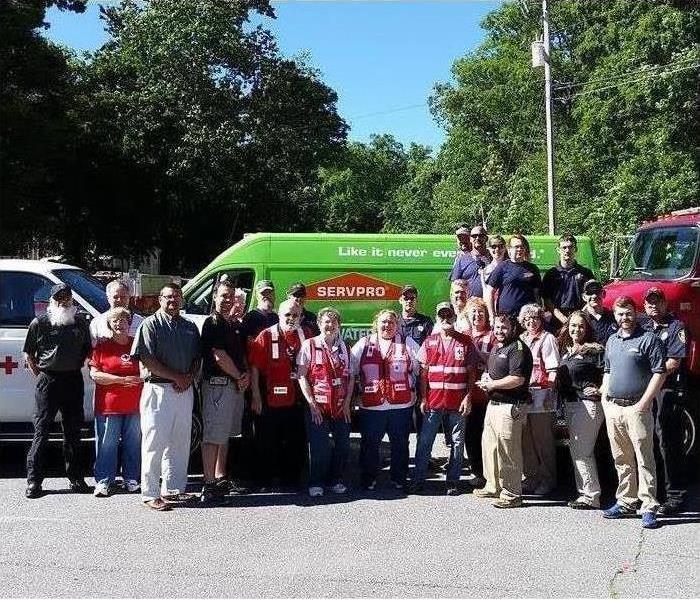
The Red Cross DAT team and the Towns County Fire Dept. finished up their third SMOKE ALARM CAMPAIGN in Towns County and welcomed their new community partner SERVPRO of Union, Towns, Fannin & Gilmer Counties. SERVPRO was a great addition to the team that provided much needed additional manpower, as well as, additional smoke alarms.
Red Cross is in its forth year of working with Fire Chief Harold Copeland and his fire fighters on the Smoke Alarms Saves Lives Campaign. This campaign was a program started by the Red Cross nationwide 3 years ago in an effort to reduce injuries and deaths in house fires by 25% within 5 years. On Wednesday, June 8th, we installed 150 new 10 year lithium battery smoke alarms in 51 homes in Towns County that couldn't afford them, didn't have working smoke alarms, or had old ones that needed replacing. We also proudly expanded this program to include Veterans in need of these alarms.
The Red Cross and Fire Dept. would like to especially thank Mr. Keith Wall, Owner, of SERVPRO of Union, Towns, Fannin & Gilmer Counties and his team who are now a permanent member of this campaign going forward for all their time and efforts supporting this life saving campaign and for the purchase of the additional alarms needed. We'd like to thank Home Depot of Blairsville for their discounts on those smoke alarms.
We'd also would like to thank additional businesses in Hiawassee that supported us in this campaign. They are Hiawassee Hardware who provided batteries to be used in some current existing alarms, as well as, Hardee's, McDonalds and Zaxby's for
providing food for all the volunteers who came out to work this event. And last but not least thank you to all the workers, SERVPRO employees, Fire Fighters and Red Cross volunteers, this couldn't have been accomplished without you.
Christine Osborn: Operations Manager
9/3/2019 (Permalink)
Meet Christine Osborn, the Operations Manager of SERVPRO of Union, Towns, Fannin & Gilmer Counties!
Christine wears many, many hats for SERVPRO. She manages all of the functions that happen within the franchise. She will even suit up and help out production to assist our customers to get their homes back to normal again.
Her background is in management, marketing and graphic design. She grew up on a farm in a small town in Iowa. She was in the Iowa Army National Guard and studied Music Education at a private university in Storm Lake, IA. She has a very wide variety of talents and interests.
Christine is the mother of two very intelligent and loving sons, Braxton & Walter Lane, who are her entire world. In her free time she enjoys motivating others to set goals because her goal in life is to "Make A Difference". She says nothing is impossible as long as you tell yourself you can do it. Her and her sons are also huge supporters of the Armed Services...past, present and future.
SERVPRO of Union, Towns, Fannin & Gilmer Counties specializes in the cleanup and restoration of residential and commercial property after a fire, smoke or water damage event. Our staff is highly trained in property damage restoration. From initial and ongoing training at SERVPRO’s corporate training facility to regular IICRC-industry certification, rest assured our staff is equipped with the knowledge to restore your property. If we can assist you with any restoration needs, do not hesitate to contact our office.
Home and Garden Show 2019
9/3/2019 (Permalink)
SERVPRO of Union, Towns, Fannin & Gilmer Counties had so much fun at the Home & Garden Show in Hiawassee hosted at the Towns County Recreational Center! We were able to meet customers and give them information they never knew regarding what was lurking in their HVAC duct systems and information regarding mold due to flooding among so much more! Thank you to everyone who came out to see us! If you didn't get a chance to come out or have questions for us, feel free to contact SERVPRO of Union, Towns, Fannin & Gilmer Counties and our office will be happy to answer any questions you may have any kinds of issues you are experiencing. SERVPRO of Union, Towns, Fannin & Gilmer Counties is always here to help!
Relay for Life
9/3/2019 (Permalink)
SERVPRO of Union, Towns, Fannin and Gilmer Counties had so much fun last Friday at the Relay for Life event in Blue Ridge, GA! Thank you to everyone who came out to support the cause!
What Is Relay?
- Organized, overnight community fundraising walk
- Teams of people camp out around a track
- Members of each team take turns walking around the track
- Food, games and activities provide entertainment and build camaraderie
- Family-friendly environment for the entire community
Because it's a team event, individual participants are not required to be there the entire time. But it's so much fun, you'll find it hard to leave!
SERVPRO of Union, Towns, Fannin & Gilmer Counties specializes in the cleanup and restoration of residential and commercial property after a fire, smoke or water damage event. Our staff is highly trained in property damage restoration and we are an IICRC Certified Firm. We believe in continuous training: from initial and ongoing training at SERVPRO’s corporate training facility to regular IICRC-industry certification, rest assured our staff is equipped with the knowledge to restore your property.
Apple Blossom Festival 2019
9/3/2019 (Permalink)
SERVPRO of Union, Towns, Fannin and Gilmer Counties participated in the 2019 Apple Blossom Festival in Ellijay, GA this May. We were able to meet customers from all over and give them information they never knew regarding what was lurking in their HVAC duct systems and information regarding mold due to flooding among so much more! Thank you to everyone who came out to see us! If you didn't get a chance to come out or have questions for us, feel free to contact SERVPRO of Union, Towns, Fannin & Gilmer Counties and our office or production staff will be happy to answer any questions you may have any kinds of issues you are experiencing. SERVPRO of Union, Towns, Fannin and Gilmer Counties is always here to help!
About SERVPRO of Union, Towns, Fannin & Gilmer Counties
SERVPRO of Union, Towns, Fannin & Gilmer Counties specializes in the cleanup and restoration of residential and commercial property after a fire, smoke or water damage event. Our staff is highly trained in property damage restoration. From initial and ongoing training at SERVPRO’s corporate training facility to regular IICRC-industry certification, rest assured our staff is equipped with the knowledge to restore your property.
https://www.SERVPROuniontownsfanningilmercounties.com/employee-photos
Restoring Your Commercial Property After A Water Damage
9/3/2019 (Permalink)
Flooding and water damage events at commercial properties are often complex with numerous issues that require a knowledgeable and flexible response. Whether we’re dealing with a relatively small water cleanup scenario or a large scale event, we work quickly to assess each unique situation and isolate the damaged area. In many instances, normal operations can continue in a temporary space while we restore your facility.
Restoring Commercial Properties Presents Unique Challenges
Our professionals are trained to be mindful of legal and environmental concerns and strive to fully restore the damaged area while working within your budgetary constraints. We understand that every hour spent cleaning up is an hour of lost revenue and productivity. So when an emergency situation arises in your business, give us a call and we’ll be there fast with the help you need.
About SERVPRO of Union, Towns, Fannin & Gilmer Counties
SERVPRO of Union, Towns, Fannin & Gilmer Counties specializes in the cleanup and restoration of commercial and residential property after a water damage event. Our staff is highly trained in property damage restoration. From initial and ongoing training at SERVPRO’s corporate training facility to regular IICRC-industry certification, rest assured our staff is equipped with the knowledge to restore your property.
http://www.SERVPROuniontownsfanningilmercounties.com/crew-photos
Union, Towns, Fannin & Gilmer Counties 24 Hour Emergency Water Damage Service
9/3/2019 (Permalink)
SERVPRO of Union, Towns, Fannin & Gilmer Counties is available 24 hours a day for water emergencies, large or small. When you are dealing with water damage, immediate action is crucial. A delay of just a few hours can greatly increase the severity of the water damage.
We Answer the Phone Ready to Help
Call Today - (706) 896-1880
We understand that when you call us, you may be feeling confused, stressed, and vulnerable. You need an expert to guide you through this crisis. SERVPRO of Union, Towns, Fannin & Gilmer Counties has the specific water damage training and experience to help you through this tough time. We specialize in water damage restoration—in fact, it's the cornerstone of our business.
What to Expect
When you call, we will ask several questions regarding your water damage emergency. These questions will help us determine what equipment and resources to bring, including how many trained SERVPRO Professionals may be needed.
Our SERVPRO Representative will ask several questions:
- Your name and contact information
- Your insurance information (if applicable)
- The street address of the water-damaged home or business
- When did the flooding or water damage occur?
- What caused the water damage (if known)?
- Is there electricity available (on-site)?
About SERVPRO of Union, Towns, Fannin & Gilmer Counties
SERVPRO of Union, Towns, Fannin & Gilmer Counties specializes in the cleanup and restoration of residential and commercial property after a fire, smoke or water damage event. Our staff is highly trained in property damage restoration. From initial and ongoing training at SERVPRO’s corporate training facility to regular IICRC-industry certification, rest assured our staff is equipped with the knowledge to restore your property.
http://www.SERVPROuniontownsfanningilmercounties.com/crew-photos
When Storms or Floods hit, SERVPRO is ready!
9/3/2019 (Permalink)
SERVPRO of Union, Towns, Fannin & Gilmer Counties specializes in storm and flood damage restoration. Our crews are highly trained and we use specialized equipment to restore your property to its pre-storm condition.
Faster Response
Since we are locally owned and operated, we are able to respond quicker with the right resources, which is extremely important. A fast response lessens the damage, limits further damage, and reduces the restoration cost.
Resources to Handle Floods and Storms
When storms hit, we can scale our resources to handle a large storm or flooding disaster. We can access equipment and personnel from a network of 1,650 Franchises across the country and elite Disaster Recovery Teams http://www.SERVPROuniontownsfanningilmercounties.com/storm-flooding-restoration that are strategically located throughout the United States.
Have Storm or Flood Damage? Call Us Today 706-896-1880
As a trusted leader in the restoration industry, SERVPRO of Union, Towns, Fannin & Gilmer Counties provides 24-hour residential and commercial services. As a locally owned and operated business, we’re dedicated to being faster to any size disaster, with the training, equipment, and expertise to handle your restoration and cleaning needs.
Flood Safety Tips
9/3/2019 (Permalink)
Even though we live in the mountains, there is the potential for flooding. Anywhere it can rain, it can flood. The most dangerous type of flood, a flash flood, happens quickly with little or no warning. Just ask the people who live in Gilmer County who experienced flooding in early August--or the people in Union County who experienced flooding in early July.
Here are some tips provided by ready.gov to keep you safe during floods:
- Do not walk through moving water. Six inches of moving water can make you fall.
- Do not drive into flooded areas. If floodwaters rise around your car, abandon the car and move to higher ground if you can do so safely. You and the vehicle can be swept away quickly.
- Avoid floodwaters; water may be contaminated by oil, gasoline, or raw sewage.
- If your property suffers flood damage, clean and disinfect everything that got wet. Mud left from floodwaters can contain sewage and chemicals.
Ready for Whatever Happens!
9/3/2019 (Permalink)
As severe weather approaches, you and your family are reminded to check our emergency supply kits, we are also reminded of the SERVPRO slogan "Ready for whatever happens". The U.S. Department of Homeland Security recommends having at least one full emergency supply kit for your home and smaller portable kits for your office and vehicles.
A basic emergency supply kit should contain at least the following:
- Water (one gallon per person per day)
- Food (non-perishable 3-day supply)
- Manual can opener
- Battery operated radio, preferably a NOAA weather radio
- Flashlight and extra batteries
- First aid kit
- Whistle to signal for help
- Clothing
- Dust masks or bandanas
- Plastic sheeting, garbage bags and duct tape
- Wrench or pliers to turn off utilities
- Hygiene items
- Important documents; copies of insurance policies, ID and bank account information
- Cash
- Fire extinguisher
- Matches in a waterproof container
Remember, this is only a basic kit. Your circumstances may require additional items. Check out the U.S. Department of Homeland Security website on readiness at www.ready.gov for more information. You can also contact SERVPRO of Union, Towns, Fannin & Gilmer Counties to learn more and be "Ready for whatever happens!"
Fire And Water Restoration Needs Immediate Attention
3/29/2019 (Permalink)
Houses can suffer a great deal of damage from a natural catastrophe, making fire and water restoration jobs two of the most common emergency services. It is even more common for these damages to arise from within the home itself, be it from faulty pipes or improper construction. Families shouldn’t suffer beyond the physical damage of their houses, so it becomes imperative to seek out only certified technicians in order to properly repair a home. Since these disasters can quickly get out of hand and will get worse as time goes on, one must move to expediently address the damages.
Depending on where the source is, rain and storm damage will begin to erode the bare surfaces surrounding it. Drywall for instance is one of the first victims, as it will quickly become saturated and discolored, eventually losing its structural integrity and collapsing. Fire and water restoration typically involves a thorough inspection of the premises, as the underlying source must be identified and treated in order to properly prevent the building from future damages. Carpet, furniture and electronics can all be damaged or destroyed if the problem is not dealt with in a reasonable time frame and by certified technicians.
The process for resolving this type of damage involves removing any saturated drywall and replacing it with new material. In order to maintain the appearance throughout the home, technicians will affix the new drywall with the proper fasteners and it is then sanded down to match the surrounding wall. Further complications, either from waiting too long to treat, or from improper drying, involve the growth of mold throughout the home. To avoid this, technicians will use air mover fans and dehumidifiers to accelerate the natural drying process and fully remove the threat.
As destructive as floods and pipe breakages can be, damages from a blaze can be just as disastrous. IICRC-certified fire and water restoration crews use only the most recent and effective means in treating these types of disasters. While the worst-case scenarios involve the destruction of the entire building, blazes can affect many different things in a building, even if they were very small. For instance, soot is notorious for spreading into every nook and cranny. While it can be nearly impossible to remove it by one’s self, trained technicians utilize large HEPA certified vacuums and thermal fogging machines to remove all traces completely.
On top of the immediate damage, fire and water restoration crews are necessary for removing the residual damage that can linger from old disasters. Only trained technicians can properly inspect a building or home in order to uncover problem areas such as damp materials and ash. Damp materials can foster mold growth, while ash can corrode metal, scratch glass, and when left untreated for long enough time, it can cause a strong, unpleasant odor.
www.IICRC.org
Mold from Heavy Flooding a Serious Concern
2/1/2019 (Permalink)
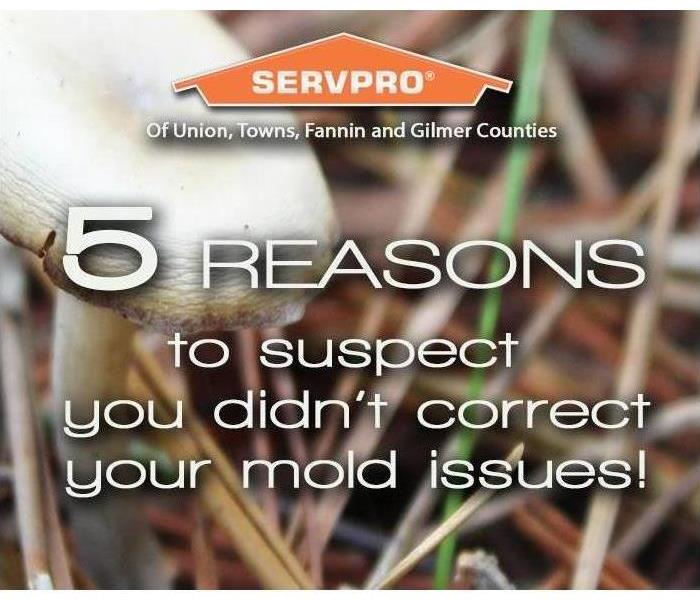 5 reasons to suspect you didn't cure your mold issues on your own! SERVPRO of Union, Towns, Fannin & Gilmer Counties is here to help!
5 reasons to suspect you didn't cure your mold issues on your own! SERVPRO of Union, Towns, Fannin & Gilmer Counties is here to help!
Mold from Heavy Flooding a Serious Concern
From August till the end of December 2015, North Georgia saw several incidents of heavy rainfall that led to massive flooding. In some parts, like Blairsville’s Meeks Park or entire neighborhoods in Ellijay, rising water levels were enough to shutter access to main roads and close down communities completely.
As the new year brings a break from the rain and the region settles into its familiar chilly weather pattern, many residents are still left dealing with the aftermath of last year’s torrential rains. Most notably, the potential for mold and bacteria growth is concern for those affected by flooding.
SERVPRO has been helping businesses and residents since 1967. They will be happy to assist you in the cleanup and restoration of your home from the serious aftermath effects of flooding fromheavy rains or plumbing.
5 reasons to suspect you didn’t cure your mold issues on your own:
Mold spores are airborne and invisible to the human eye. They can quickly multiply after your cleaning attempt. Air duct cleaning is essential after mold cleanup to capture mold spores and sanitize the system.
If you used bleach, it leaves residual moisture, which is one condition mold needs to grow.
If you used bleach on porous surfaces, such as unfinished wood and drywall, you may have killed mold on the surface. However, you quite possibly did not kill the roots beneath the surface.
You have a musty smell after cleaning.
If a dark stain reappears after cleaning, it could possibly be the return of mold
You may need a professional to, at least, evaluate your home and make sure it’s mold free. Mold issues are always best caught early or completely prevented.
For more information please visit SERVPROBLUERIDGE.com or call us today at 706-896-1880.
10 Ways to Prevent Water Damage
2/1/2019 (Permalink)
Flooding and water damage is very invasive. Water quickly spreads throughout your home and gets absorbed into floors, walls, furniture, and more. SERVPRO of Union, Towns, Fannin & Gilmer Counties arrives quickly and starts the water extraction process almost immediately. This immediate response helps to minimize the damage and the cleaning and restoration costs. Here are some ways to prevent water damage to your home or business:
1. Clean and inspect gutters regularly.
2. Keep downspouts clear of any blockages.
3. Repair or replace roofing as needed.
4. Be sure soffit vents are clean and unobstructed.
5. Check for any cracks or peeling paint. These could indicate moisture retention.
6. Fill low spots around building foundation with clean fill dirt.
7. Create slope away from structure to drain runoff properly.
8. Trim plants around building to avoid growth of mold or mildew.
9. Make sure garden areas have adequate drainage.
10. Apply a waterproofing coating to interior or exterior basement walls.
If you have any questions regarding any troubles you are experiencing, do not hesitate to contact our SERVPRO of Union, Towns, Fannin & Gilmer Counties office.
Spruce Up Your Space
2/1/2019 (Permalink)
Birds are chirping and the temperatures have warmed up---spring is finally here! Spring cleaning is a tradition allowing us to freshen our environment and get a head start on the hectic seasons of spring and summer. While many people deep clean their homes, this is also a great time to clean and organize your business.
SERVPRO of Union, Towns, Fannin & Gilmer Counties can help get your facility in tip top shape. In addition to air duct and HVAC cleaning, SERVPRO of Union, Towns, Fannin & Gilmer Counties crew professionals are trained to use state-of-the-art equipment to remove soils hiding deep within your carpet, as well as focused stain removal and stain resistance applications. Other services include: upholstery and drapery cleaning, hard floor cleaning and care, and odor deodorization.
A clean environment is a healthy environment! Improve your living and work spaces this spring. If you need a little help, don’t work, SERVPRO of Union, Towns, Fannin & Gilmer Counties have the tools to make your home or business sparkle in no time!
Here are some Spring Cleaning Tips in Your Workplace from SERVPRO!
· Divide Your Workspace Into Zones:
Determine how you want and need to use the space and set up zones for your daily functions. You may require a workspace for your computer, a library area for your research, a storage area for supplies and a filing area for your archives. This will provide a foundation for a more efficient use of space.
· Keep Only What You Need At Arm’s Length:
Boxes of pens, stacks of papers and old coffee cups need to go. Rid your desk of visual clutter by paring down the items on top to the essentials only. Supplies, paperwork and personal items should be kept in the zones you’ve established for them.
· Sort Your Catch-All Drawer:
Use drawer dividers to give everything a place, like compartments for paperclips and rubber bands. Go through the drawer every six weeks and clear out anything that is out of place or isn’t being used.
· Eliminate Digital Clutter:
Digital clutter can be just as stressful as physical clutter. Organize digital files and your e-mail inbox just as you would paper files-with a system of logical and clearly labeled folders. Also, keep the icons on your desktop to a bare minimum, and trade in sticky notes on your monitor for calendar reminders.
· Create A Daily Paper System:
Consider creating hanging files or baskets labeled “To Read,” “To Do,” and “To File.” Establish set days for each, so that you don’t get behind or feel the overwhelming need to do everything at once.
· Disinfect Regularly:
Prevent the buildup of dust, dirt, food stains and fingerprints. Wipe down your desk, phone keyboard and monitor once a week with disinfection wipes.
Grilling Safety
8/1/2018 (Permalink)
Summer time is grilling time. We all love to either cook on a grill or eat what has been cooked. Just thinking of all the mouthwatering goodies that can come off a grill makes me hungry, but before eating, comes safety! When grilling weather finally gets here after a long, cold winter, a lot of us will go drag the grill out of the garage and fire it up. If we don’t take time to check things out and clean everything properly (which ideally was done before putting it away last year), we are asking for trouble. Safety tips and procedures are given to us for a reason- our personal safety and the safety of our surroundings. In 2014 alone, over 16,000 people ended up in emergency rooms because of injuries involving grills. A failure to properly clean the grill was the leading factor contributing to the fire and a close second was having the grill too close to a flammable object, such as the house or porch railing. It can seem like a waste of precious grilling time to clean everything before firing up the grill, especially if you have done so before storage for the winter. You must remember that dust and insects can get into places that could cause a problem while your grill is in storage. Here is a comprehensive list of sensible rules to follow so that your grilling season will be a safe and happy experience:
1.Read the owner’s manual. I know, who reads those things. We all should so that we understand the proper way to use our equipment. Even if you have been grilling for years, when you buy a new grill, it is extremely important to read the manual. All grills are not the same.
2.Grills are for outside use ONLY. Both charcoal and gas grills should never be used indoors, never inside a tent and garage or any other enclosed space. Grills produce carbon monoxide, which may accumulate and kill you.
3.Use only in a well-ventilated area. Always set up your grill in an open area away from structures. Avoid dry leaves or brush and high traffic areas. No one wants little Bobby to come running around the corner and knock the grill over, that would spoil your whole day.
4.Follow electric codes. If you use an electrical apparatus, such as a rotisserie, with your grill, make sure it is up to code and the cord is place so that it is not a trip hazard.
5.Use long handled utensils. Barbecuing tools are made with extra-long handles for a reason, to avoid burns on your hands and arms. Use them.
6.Wear safe clothing. It probably wouldn’t be a good idea to wear a fancy shirt or dress while barbecuing. Even if you are hosting a big party. Close fitting garments are best as they are less likely to come into contact with hot coals or gas burners. Those cumbersome oven mitts can be your best friends while grilling; scorched fingers from hot items are no fun.
7. Keep the fire under control. Keeping a close watch on the temperature of your fire can lessen flare-ups. If you must douse a flare-up with a mist of water, remove the food first. A fire extinguisher, a bucket of sand or even a water hose should be close by in case of a problem. Use baking soda to put out a grease fire; using water in this instance will just spread the fire.
8. Never leave a hot grill unattended. Just because the cooking is done and the fire is out doesn’t make a grill safe. It can stay hot enough to cause problems for up to an hour after being extinguished. Wait until it has cooled off before trying move it. And don't let people play around the grill while it is still hot. Grilling out is one of the best things about summer time. Hot dogs, hamburgers, even chicken all seem to taste better when cooked on the grill. This year you may want to try your hand at more exotic dishes such as Ginger-soy glazed Mahi-Mahi or Grilled Shrimp in a Banana-leaf Pouch. Whatever you decide to cook on your grill this summer, be sure to follow the safety rules so that you and your loved ones will have a fabulous summer with no trips to the emergency room.
For more tips and tricks to help you prevent leaks, fires and more sign up for occasional email newsletters OR please visit the SERVPRO of Union, Towns, Fannin & Gilmer Counties website!
Play that funky music, but get rid of that funky smell
8/1/2018 (Permalink)
Most of us have walked into a business or even a home that didn’t smell … well, good. Sometimes the odor is identifiable and superficial cleaning will fix it or maybe it can just be stemming from some unpleasant thing that’s out of sight and no longer alive thus creating a big ol “eeewww” in the olfactory department.
More often, weird odors are not clearly seen or understood. Like musty basements … what is “musty” any way? That’s just a weird word. Restaurants often start to have an odd and not altogether pleasant smell from fryer oils, grease traps, garbage and other unsightly and unappetizing things we really don’t love to talk about. Maybe you are now thinking back to when your very own nose was offended by such an odor and how you really wish you hadn’t picked that particular place to try a salmon burger.
At SERVPRO of Union, Towns, Fannin and Gilmer Counties (yeah, we know that is a crazy long name) we are challenged with helping businesses and homeowners get rid of funky things. We can suggest a new musical playlist that’s less 1970s too, but we don’t specialize and can’t promise your satisfaction in that!
One of the ways we help to get rid of “funk” is through Air Duct Cleaning. Sometimes, you can change the carpet, paint the walls, bleach the tile and there is STILL an odor. Often times, that odor is coming from your Heat Ventilation and Air Conditioning (HVAC) system. So, along with a smell, the air you are breathing isn’t so great either. Even the EPA suggests Air Duct and Ventilation system cleaning can be beneficial in situations where mold has been present or if any type of contaminant could have breached your system. Breaches happen in the case of older systems and just like your coffee table gets covered in dust, so does your duct work. We’ve talked about a lot of yucky things in this article and sadly, even the tidiest of Sally (or Sam) Homemakers can’t stop dust.
Inspecting the ventilation system is also a great way to reveal efficiency issues and potential hazards or problems. There could be lack of insulation along with a multitude of possible scenarios our technicians encounter when they go crawling around in attics and under floors. We have stories …
We pride ourselves on integrity, responsibility and commitment in our business. Our jobs often include doing our full level best to turn someone’s disaster into a happy ending, so in performing routine cleaning and inspections we are thrilled when we can be the ones to point out an issue and prevent disaster. That’s what we call a very good day.
To learn more about our Air Duct and HVAC Cleaning services visit www.SERVPROuniontownsfanningilmercounties.com
Relay for Life
8/1/2018 (Permalink)
SERVPRO of Union, Towns, Fannin and Gilmer Counties had so much fun last Friday at the Relay for Life event in Blue Ridge, GA! Thank you to everyone who came out to support the cause!
What Is Relay?
- Organized, overnight community fundraising walk
- Teams of people camp out around a track
- Members of each team take turns walking around the track
- Food, games and activities provide entertainment and build camaraderie
- Family-friendly environment for the entire community
Because it's a team event, individual participants are not required to be there the entire time. But it's so much fun, you'll find it hard to leave!
SERVPRO of Union, Towns, Fannin & Gilmer Counties specializes in the cleanup and restoration of residential and commercial property after a fire, smoke or water damage event. Our staff is highly trained in property damage restoration and we are an IICRC Certified Firm. We believe in continuous training: from initial and ongoing training at SERVPRO’s corporate training facility to regular IICRC-industry certification, rest assured our staff is equipped with the knowledge to restore your property.
Sneaky Leaks: Tips to avoid disaster
8/1/2018 (Permalink)
Did you know that the EPA reports that plumbing leaks account for more than One Trillion gallons of water waste, Nationwide. That’s TRILLION, with a T. One million gallons of water will fill a football field sized swimming pool nearly four feet deep.
The EPA also reports, the average household loses 10,000 gallons each year due to leaks. That’s enough to fill a backyard pool six feet deep.
So, what’s so leaky? Some leaks are super sneaky.
Here are five places you might be able to sneak up on your leaks!
1. HVAC drainage line: this isn’t a leak that uses excess water but it is a leak that can spill out of its containment pan, onto the floor and cause damage.
THE FIX: It’s usually just that the line is clogged with dust or debris. Generally simple to fix.
2. Ice maker lines: Your ice maker is a workhorse. Tirelessly, it pools water into the mold so you can have cold beverages. The waterline that supplies this process is generally tucked behind the refrigerator, out of sight. Older models are usually equipped with a clear plastic tube that can pinch, become brittle and crack open or just get pulled out of the fixture. Newer models have a stainless, flexible hose that is much more durable.
THE FIX: Check behind your fridge for any moisture or pooled water. A slow leak my never be seen depending on the type of flooring you have. Replacing this item is a YouTube video away.
3. Faucets: So, maybe faucets are less sneaky than attic or basement water lines … but little drips add up. It’s worth turning the controls a smidge tighter to see if you have a drip or just poor hand strength.
THE FIX: It’s usually just an O ring or a washer. The internal workings of the standard kitchen or bathroom faucet do not work for forever. Also, you might consider changing the supply tube lines with braided lines.
4. Outdoor faucets: The invention of frost proof fixtures have significantly cut down on problems with outdoor faucets wreaking havoc. However, one little caveat we see time after time, is the improper installation of these handy-dandy faucets. See, they are supposed to be installed at a slight angle as to encourage any remaining water to run out of the pipe. Because: without water, a pipe can’t really freeze and burst.
THE FIX: Unscrew the hose … run a little water on the ground, turn off the water … does the water continue to drip out of the faucet for a bit? If it’s dry as bone, there’s probably a good chance it’s not going to drain out. You are likely going to need a handy person or a plumber to fix this. **Remember, never leave hoses connected to faucets in the winter.
5. Dishwashers: Oh how we love or hate our dishwashers. Either they are saving us from the task of scrubbing never ending dishes, or they are doing a terrible job and we are still scrubbing dishes. Tucked back flush with our cabinets, we cannot see what is going on with the kitchen help.
THE FIX: Look closely at the adjoining cabinetry for signs of moisture. If you are seeing the leak, it could be the door gasket or something rather simple. If it’s older, the tubs can form holes.
THE FIX: Don’t over load your dishwasher and definitely use the proper soap. Other leaks, you may need help to resolve.
Other places to look for leaks: hot water heater, washing machine hoses (we recommend you change these every 5-7 years or switch to a braided line), under sinks, attic and basement pumping, access panels to plumbing otherwise walled off.
Remember at SERVPRO we can make sure any disaster you encounter is “Like it never even happened” but we also fully subscribe to the theory “an ounce of prevention is worth a pound of cure”.
Should you have a leak sneak up on you and cause more than mess than you can handle, "SERVPRO of Union, Towns, Fannin & Gilmer Counties" is just a phone call away.
www.SERVPROBlueRidge.com
(706) 896-1880
Where there's smoke, there is fire ... tips for fire prevention
8/1/2018 (Permalink)
In 2011, there were 1.3 million house fires in the United States.
1.3 million families temporarily displaced.
We attach our memories to things. We often scoff at materialism and we even poke fun at those who tend to accumulate lots of “things” … but the truth is, sometimes, things have meaning.
Your grandmother’s quilt, photos of your children, artwork, the shoes you wore on your first date with your husband, a movie ticket from a special day with a good friend … these are all seemingly meaningless things. Some of us are more sentimental than others.
Out of 1.3 million, it’s a safe bet that some important “things” were lost. We helped approximately 240 customers last year and though we restored a lot of belongings, some items were too far gone. Some of those things were not replaceable. Worse than things are people injured or killed. Nearly 25 thousand people each year are injured or killed by fire and that’s why prevention is so important. Here are some less common tips from Ready.gov, a website dedicated to disaster prevention.
Electrical
· Frayed wires can cause fires. Replace all worn, old or damaged appliance cords immediately and do not run cords under rugs or furniture.
· Buy electrical products evaluated by a nationally recognized laboratory, such as Underwriters Laboratories (UL).
· If an appliance has a three-prong plug, use it only in a three-slot outlet. Never force it to fit into a two-slot outlet or extension cord.
· Use electrical extension cords wisely; never overload extension cords or wall sockets.
· Immediately shut off, then professionally replace, light switches that are hot to the touch and lights that flicker.
Cooking
· Stay in the kitchen when you are frying, grilling, or broiling food. If you leave the kitchen for even a short period of time, turn off the stove.
· Wear short, close-fitting or tightly rolled sleeves when cooking.
· Do not cook if you are sleepy, have been drinking alcohol, or have taken medicine that makes you drowsy.
· Keep children away from cooking areas by enforcing a "kid-free zone" of 3 feet around the stove.
· Position barbecue grills at least 10 feet away from siding and deck railings, and out from under eaves and overhanging branches.
Fires can spread from nearly harmless to engulfing in less than 30 seconds. Reavy.gov reports many people do not realize how incredibly fast fire is. Fire is not bright and glowing as it would seem. Especially in a house it quickly produces thick black smoke making everything dark. Additionally, it’s smoke and toxic fumes from the various materials in a home that usually kills people. These hard facts should be enough to help you create a fire escape plan for your family.
As for those belongings, put precious mementos in fireproof safe or box. Have your photos scanned so you have digital copies of all family photos, old and new. Terry and Tonya, two of our team members who help inventory belongings and restore items have thoroughly enjoyed breathing new life into “Grandmother’s China” and even finding lost treasures in the process of moving furniture and cleaning up after a disaster.
Here at SERVPRO, we are used to working with insurance companies to help restore or rebuild homes. In the Blue Ridge area, one of the agents we are blessed to work with is Kevin Panter, who offers the following advice “Insureds need to take their annual review with their insurance agent seriously. It is often determined during a time of loss that the insured’s building limits and personal property contents limits are not adequate. Having proper documentation and adequate limits will help make the claim process much easier. Having cell phone videos and storing proper documentation off the premises will help greatly should a claim arise.” You can reach Kevin through his company http://www.kevinpanterinsurance.com/ .
“Our whole reason for existing as a business is to help our customers feel confident and comfortable as we restore their homes or businesses to preloss conditions. When disaster, small or large, strikes, you feel like you’ve lost control. We want to help you get it back. Our crews are often praised for their compassion. It is truly heartfelt,” explains Carnie Wall, co-owner.
Damage from Water Should be Cleaned by Certified Professionals
7/28/2018 (Permalink)
The amount of damage water can cause is amazing, and often underestimated by homeowners. Excess moisture is bad enough, but when a home is flooded or hit with a plumbing disaster (like a burst pipe), the situation can quickly get out of hand. There’s a reason why these incidents are among the most expensive problems a homeowner can face. Contaminated water not only creates immediate structural problems, it can leave serious biological threats behind after it has been removed.
Floods, sewage backflows, and other sources of contaminated fluid usually cause the worst damage. Dirty water is filled with all kinds of harmful substances, ranging from chemical residues to animal feces to parasites. Bacteria, viruses and fungi grow explosively in contaminated fluid, and severe health risks, like salmonella and hepatitis, are common in flood waters.
This problem is compounded by the composition of most homes, which are filled with organic materials. Drywall, wood and the matter that is trapped in carpet fibers are just a few examples, and they can give pathogens room to grow. Within 48 hours, mold may begin creeping behind the walls and releasing spores, and any organic materials that have been soaked through by contaminated fluid will usually have to be destroyed.
That’s why restoration firms, in addition to surveying the home for structural problems, will dry the home quickly and apply antibacterial, antiviral, and antifungal agents to all surfaces that had contact with the water. This ensures the family can return to a safe home, and not one harboring a collection of harmful pathogens.
www.IICRC.org
Fire And Water Restoration Needs Immediate Attention
7/28/2018 (Permalink)
Houses can suffer a great deal of damage from a natural catastrophe, making fire and water restoration jobs two of the most common emergency services. It is even more common for these damages to arise from within the home itself, be it from faulty pipes or improper construction. Families shouldn’t suffer beyond the physical damage of their houses, so it becomes imperative to seek out only certified technicians in order to properly repair a home. Since these disasters can quickly get out of hand and will get worse as time goes on, one must move to expediently address the damages.
Depending on where the source is, rain and storm damage will begin to erode the bare surfaces surrounding it. Drywall for instance is one of the first victims, as it will quickly become saturated and discolored, eventually losing its structural integrity and collapsing. Fire and water restoration typically involves a thorough inspection of the premises, as the underlying source must be identified and treated in order to properly prevent the building from future damages. Carpet, furniture and electronics can all be damaged or destroyed if the problem is not dealt with in a reasonable time frame and by certified technicians.
The process for resolving this type of damage involves removing any saturated drywall and replacing it with new material. In order to maintain the appearance throughout the home, technicians will affix the new drywall with the proper fasteners and it is then sanded down to match the surrounding wall. Further complications, either from waiting too long to treat, or from improper drying, involve the growth of mold throughout the home. To avoid this, technicians will use air mover fans and dehumidifiers to accelerate the natural drying process and fully remove the threat.
As destructive as floods and pipe breakages can be, damages from a blaze can be just as disastrous. IICRC-certified fire and water restoration crews use only the most recent and effective means in treating these types of disasters. While the worst-case scenarios involve the destruction of the entire building, blazes can affect many different things in a building, even if they were very small. For instance, soot is notorious for spreading into every nook and cranny. While it can be nearly impossible to remove it by one’s self, trained technicians utilize large HEPA certified vacuums and thermal fogging machines to remove all traces completely.
On top of the immediate damage, fire and water restoration crews are necessary for removing the residual damage that can linger from old disasters. Only trained technicians can properly inspect a building or home in order to uncover problem areas such as damp materials and ash. Damp materials can foster mold growth, while ash can corrode metal, scratch glass, and when left untreated for long enough time, it can cause a strong, unpleasant odor.
www.IICRC.org
Summer Safety Tips!
7/26/2018 (Permalink)
Summer is synonymous with barbecues, parades and fireworks displays; but along with all the festivities are plenty of visits to emergency rooms-especially during July.
In 2013, eight people died and about 11,400 were injured badly enough to require medical treatment after fireworks-related incidents, according to the U.S. Consumer Product Safety Commission. In addition to causing injury, fireworks are also responsible for thousands of house fires each year with millions of dollars in property damage.
There is nothing like firing up the grill during the summer months! Did you know, July is the peak month for grills fires? A backyard barbecue can become dangerous quickly if proper safety precautions aren't considered. SERVPRO of Union, Towns, Fannin & Gilmer Counties wants you to have an enjoyable and safe summer.
Consider the following tips to ensure your summer celebrations are disaster-free!
- Propane and charcoal BBQ grills should only be used outdoors.
- The grill should be placed well away from the home, deck railings and out from under eaves and overhanging branches.
- Keep children and pets away from grill area.
- Keep your grill clean by removing grease or fat buildup from the grills and in trays below the grill.
- When using a charcoal grill, let the coals completely cool before disposing in a metal container.
- Never leave your grill unattended.
- Anyone using fireworks or standing nearby should wear protective eyewear.
- Do not try to re-light or handle malfunctioning fireworks. Keep a bucket of water nearby to fully extinguish fireworks that don't go off or in case of fire. Children should never pick up fireworks that may be left over, as they may still be active.
- The safest way to enjoy fireworks is to attend a public display conducted by trained professionals.
The Damage Water Causes Can Be Permanent If Not Treated Properly
7/26/2018 (Permalink)
The kind of damage water can create in the home is staggering, and if not dealt with promptly, it may result in permanent issues for the homeowner. Excess moisture is a constant enemy in buildings, seeping in around windows, through the HVAC system, from the plumbing, and even through the air every time a door is opened. As long as the home is maintained well, this isn’t a problem, but a flood or burst pipe can quickly change the situation.
What damage can water cause in the home?
Excess moisture is unique in its destructive capabilities. Not only can it create significant and immediate physical devastation, it can make the home a hotspot for bacteria, viruses and molds. Floods are particularly troublesome, as they can fill the home with contaminated water.
When a flood slams into a building, it gathers in the lowest rooms, soaking everything in its wake. The flood brings in many hazards with it, sometimes including wildlife, chemical runoff, and various pathogens. For this reason, untrained people are strongly cautioned not to enter a building that has been wracked by a flood, as they may be bit or stung by dangerous wildlife. Chemical runoff includes fertilizers, road oils, and precipitants sitting on rooftops. This can make the fluid highly toxic and leave stains and odors.
But perhaps the most concerning damage water creates is pathological. Floods pick up fluid from rivers, lakes and ditches, and this fluid may contain cholera, hepatitis, dysentery and salmonella. It can wash in molds as well, turning the home into a biological hazard. What makes microbes especially dangerous in the home is that most houses are filled with organic materials, and these provide ideal conditions for microbes to grow. Drywall, carpets, upholstery, and wood are among the organic materials microbes may latch onto, and within 48 hours, any material that has been soaked through with contaminated fluid will usually be beyond salvaging. And even if the fluid is mostly benign, the withering exposure to moisture can yellow drywall and erode its integrity, and cause wood to warp.
There is no getting around it, the kind of damage water can produce is staggering, and it’s capable of leaving a building in a condemnable condition.
That’s why restoration firms are equipped to respond to disasters day and night, and are ready to treat floods and plumbing mishaps right away. Certified restoration firms, like those trained through the Institute of Inspection, Cleaning and Restoration Certification (IICRC), have the skills and tools needed to deal with all kinds of moisture related disasters. Within a few days, restoration firms can remove all signs of excess moisture, saving sensitive materials, drying out the home, and destroying any signs of mold and microbes.
Floods and plumbing disasters cannot be ignored, and when they do emerge, the only way to deal with them safely is with a certified professional’s help.
www.IICRC.org
The Next Step After Having Fire And Water Damage
7/26/2018 (Permalink)
Fire and water damage are nightmares for any home or business owner because they typically force expensive repairs. This is particularly true when the building is flooded or a pipe bursts. Such disasters can destroy entire floors of a building, and make it uninhabitable until it is cleaned out. But cleaning it out is something that only professionals should be allowed to handle, especially if there is contaminated fluid or a lot of ash residue present. Certified technicians will have the tools and expertise needed to restore the building to normal and allow people to work or live in it without fear of health issues.
How do professionals perform fire and water damage restoration?
The only way to deal with a flame’s aftermath is to clean the area up thoroughly. Even a small fire can leave behind a good deal of ash and soot, and it will become more than just an annoyance if it is allowed to spread through the building. Smoke is another concern, as it will create noxious odors that penetrate through walls and seemingly last forever. Technicians are prepared to work through the building, scrubbing down all affected surfaces, and surveying the property to find areas where the residue has settled. This includes the ventilation system as well, as ash is readily picked up by the building’s climate control system. In places where the residue has formed a thick, almost lacquer-like substance, technicians have special detergents that can eat through the muck and make it easy to wipe away. As for smoke odors, professionals typically use a device known as a thermal fogger. This device will fill the building with particles designed to neutralize smoke odors, and these particles are small enough to reach through walls, so they can go where the smoke is.
Floods, sewage backflows and plumbing disasters offer their own challenges, and take a lot of equipment that only fire and water damage restoration professionals have access to. For example, if the building is harboring several inches of water, industrial strength pumps will be needed to pull it out, and these pumps are often mounted to a truck. Once this is done, trained professionals will be able to identify what materials can be rescued and what materials are completely compromised. It is essential to get this part right because destroyed materials that are left behind can ferment mold and bacterial growth.
Technicians will then work to dry the building, a process that requires several heavy duty air mover fans and dehumidifiers. This normally takes several days to see through, and technicians will monitor drying progress with moisture meters and regular inspections. Also, if there are any areas infested with mold or other microbes, fire and water damage restoration professionals can eliminate the threat with fungicides or other cleaning solutions.
Certified fire and water damage restoration professionals are the people to call when disaster strikes. They can operate in any environment and ensure a building is as good as new, giving people the peace of mind they need when returning home or to work.
www.IICRC.org
Water Damage
7/26/2018 (Permalink)
When the Pipes Crack: Tips to Prevent Water Damage
When extreme temperatures strike, homeowners across the U.S. are crippled with millions of dollars in water damage to homes and buildings.
Leaving a home alone can become an expensive implication if things go astray while you are gone. And unfortunately more often than not, things do go wrong. Opportunely, there are certain things homeowners can do to protect their home and the interior possessions.
Water is the homeowners’ biggest enemy. If a pipe were to burst thousands of gallons of water can begin to flood the home. The IICRC responds as an authority on pulling the pieces back together for home and business owners. When water damage results from cracked pipes, IICRC offers these tips for clean-up.
To Prevent Frozen Pipes:
• Wrap electrical heating tape on exterior pipes. Remove garden hoses from faucets.
• Cover pipes with foam rubber or fiberglass insulation and secure it with tape.
• Let cold and hot water faucets drip. Running water helps prevent freezing pipes and reduces pressure build up in them.
• Inside the home, open kitchen and bathroom cabinet doors to promote warm air circulation around plumbing.
• Leave the thermostat at the same temperature both day and night, at least 55°F.
To Thaw Frozen Pipes:
• Locate the problem pipe, if possible, and open a faucet. As the pipe thaws, running water aids the melting process.
• Apply heat to the frozen section using a hand-held hair dryer or portable electric space heater. Do not use a blow torch as it could cause the pipe to explode. Do not use a propane or kerosene heater as these are hazardous for indoor use.
• If you are unable to locate or access the frozen pipe area, call a licensed plumber.
• If all else fails and you experience a burst pipe that results in water damage, shut off the main water valve and contact a professional water damage restoration company with trained technicians and extraction, drying and dehumidifying equipment.
If Water Damage Occurs, Tips for Clean-Up:
• Shut off the main water valve, if practical, and call a plumber to fix the leak.
• Call an IICRC-certified professional water restoration firm immediately for mitigation services, as required by your insurance policy. Certified Firms have the knowledge, experience and equipment to locate water wherever it goes, remove the excess, and dry your structure to industry standards.
• Mop up standing water on flooring surfaces to prevent slip/fall hazards. If the burst pipe is overhead, drain ceiling cavities by punching “weep” holes.
• Prevent mold growth. Although it takes a few days to appear, mold thrives on wood, paper, particle board or even household soil, when stagnant air, moisture, and temperatures between 68 and 86 degrees are present.
• Wet clothing usually is salvageable. A 10-minute wash cycle in detergent and hot water should sanitize washable clothing and many household fabrics.
• Dry out before you rebuild. Professional water restorers have a variety of instruments to determine when a building is dry, to prevent on-going microbial growth. Drying should not stop until wood or drywall moisture content (MC) falls below 16% MC. Normal MC is around 10% in most areas of the country.
www.IICRC.org
What to do in a Flood
7/26/2018 (Permalink)
Floods are one of the most common and widespread natural disasters in the United States, causing more damage than any other weather-related disaster. The location of your home or business has little to do with your risk factor for flooding. Just because you haven’t experienced a flood in the past, doesn’t mean you won’t in the future. According to the National Flood Insurance Program (NFIP), 20% of all claims were for policies in low-risk communities. Floods cost an average of $3 billion in annual losses with the average Commercial claims being $75,000,000.
The American Red Cross (ARC) offers the following flood safety tips:
Stay away from flood waters. If you come up on a flowing stream where the water is above your ankles, stop, turn around and go another way. Six inches of swiftly moving water can sweep you off of your feet.
Do not try to drive on a flooded road. If you approach a roadway that is flooded, turn around and go another way. If you are caught on a flooded road and the water is rising rapidly, get out of the car and get to higher ground. Most cars can be swept away by less than two of moving water.
Keep children out of the water. Children are curious and lack judgment about running water and contaminated water.
That’s pretty basic…so here are some less well known tips to keep you safer in a flood!
- If you have time, secure your home. Bring in outdoor furniture. Move essential items to an upper floor.
- Do not walk through moving water.Use a stick to check the firmness of the ground in front of you.
- Turn off utilities at the main switches or valves if instructed to do so. Disconnect electrical appliances. Do not touch electrical equipment if you are wet or standing in water.
- Six inches of water will reach the bottom of most passenger cars causing loss of control and possible stalling.
- A foot of water will float many vehicles.
After a Flood
- Listen for news reports to learn whether the community’s water supply is safe to drink.
- Be aware of areas where floodwaters have receded. Roads may have weakened and could collapse under the weight of a car.
- Clean and disinfect everything that got wet. Mud left from floodwater can contain sewage and chemicals. Call SERVPRO of Union, Towns, Fannin & Gilmer Counties to help with cleanup, we have the equipment and expertise to restore your home to it's former glory.
Apple Blossom Festival
7/26/2018 (Permalink)
SERVPRO of Union, Towns, Fannin and Gilmer Counties participated in the 2016 Apple Blossom Festival in Ellijay, GA this May. We were able to meet customers from all over and give them information they never knew regarding what was lurking in their HVAC duct systems and information regarding mold due to flooding among so much more! Thank you to everyone who came out to see us! If you didn't get a chance to come out or have questions for us, feel free to contact SERVPRO of Union, Towns, Fannin & Gilmer Counties and our office or production staff will be happy to answer any questions you may have any kinds of issues you are experiencing. SERVPRO of Union, Towns, Fannin and Gilmer Counties is always here to help!
About SERVPRO of Union, Towns, Fannin & Gilmer Counties
SERVPRO of Union, Towns, Fannin & Gilmer Counties specializes in the cleanup and restoration of residential and commercial property after a fire, smoke or water damage event. Our staff is highly trained in property damage restoration. From initial and ongoing training at SERVPRO’s corporate training facility to regular IICRC-industry certification, rest assured our staff is equipped with the knowledge to restore your property.
http://www.SERVPROuniontownsfanningilmercounties.com/crew-photos
Does Your Home Have A Mold Problem?
7/26/2018 (Permalink)
Microscopic mold spores naturally occur almost everywhere, both outdoors and indoors. This makes it impossible to remove all mold from a home or business. Therefore, mold remediation reduces the mold spore count back to its natural or baseline level. Some restoration businesses advertise “mold removal” and even guarantee to remove all mold, which is a fallacy. Consider the following mold facts:
- Mold is present almost everywhere, indoors and outdoors.
- Mold spores are microscopic and float along in the air and may enter your home through windows, doors, or AC/heating systems or even hitch a ride indoors on your clothing or a pet.
- Mold spores thrive on moisture. Mold spores can quickly grow into colonies when exposed to water. These colonies may produce allergens and irritants.
- Before mold remediation can begin, any sources of water or moisture must be addressed. Otherwise, the mold may return.
- Mold often produces a strong, musty odor and can lead you to possible mold problem areas.
- Even higher-than-normal indoor humidity can support mold growth. Keep indoor humidity below 45 percent.
If your home or business has a mold problem, we can inspect and assess your property and use our specialized training, equipment, and expertise to remediate your mold infestation.
If You See Signs of Mold, Call Us Today –706-896-1880
Fireworks Safety
7/26/2018 (Permalink)
Almost everyone loves fireworks! The Fourth of July is just around the corner and we will be looking forward to watching the beautiful fireworks displays. Some of us will go to local displays and some of us will watch the magnificent displays around the country on television. Did you know that the largest fireworks display in the world happened at the New Year countdown on January 1, 2016? It was in the Philippine Arena, Ciudad de Victoria Bocaue Bulacan, Manila, Philippines, consisting of 810,904 fireworks, lasting for 1 hour 1 minute 32.35 seconds in the pouring rain. Amazing, isn’t it?The Chinese stumbled upon a kind of natural firecracker as early as 200 B.C. They would roast bamboo, which would explode with a bang due to the hollow air pockets inside. They believed that the noise would ward off evil spirits. At some point between 600 and 900 A.D., Chinese alchemists mixed together saltpeter (a common kitchen seasoning) charcoal, sulfur and a few other ingredients, unwittingly yielding the first crude form of gunpowder. It is speculated that they were possibly trying to make an elixir for immortality. When the Chinese began stuffing this volatile substance into bamboo shoots and throwing them into a fire, the first fireworks were born. By the time of the Renaissance, pyrotechnic schools were training fireworks artists across Europe. In the 1830s, the Italians began to incorporate very small amounts of metals and other additives to their fireworks, thus creating the bright, multicolored sparks and sunbursts seen in contemporary fireworks shows. Until then, fireworks were just loud noises, orange flashes and faint golden traces of light. Legend has it that Captain John Smith set off the first fireworks display in America in 1608. Some of the colonists may have gotten a little carried away and a spate of firecracker-related pranks became a public nuisance, prompting officials in Rhode Island to ban the “mischievous use of pyrotechnics” in 1731. Today, most states regulate how and where fireworks may be used, as well as the types of explosives would be available for consumers to purchase. In 2009, nearly 9,000 Americans were hurt by fireworks with a disproportionate number of the injuries occurring in July. This is why fireworks safety is so important. The Fireworks Safety Code • Only buy fireworks marked BS 7114• Don’t drink alcohol if setting off fireworks• Keep fireworks in a closed box• Follow the instructions on each firework• Light them at arm’s length, using a taper• Stand well back• Never go near a firework that has been lit. Even if• It hasn’t gone off, it could still explode• Never put fireworks in your pocket or throw them• Always supervise children around fireworks• Light sparklers one at a time and wear gloves• Never give sparklers to children under 5• Keep pets indoors• Don’t set off noisy fireworks late at night and never past 11pm
Restoring Your Commercial Property After A Water Damage
7/26/2018 (Permalink)
Flooding and water damage events at commercial properties are often complex with numerous issues that require a knowledgeable and flexible response. Whether we’re dealing with a relatively small water cleanup scenario or a large scale event, we work quickly to assess each unique situation and isolate the damaged area. In many instances, normal operations can continue in a temporary space while we restore your facility.
Restoring Commercial Properties Presents Unique Challenges
Our professionals are trained to be mindful of legal and environmental concerns and strive to fully restore the damaged area while working within your budgetary constraints. We understand that every hour spent cleaning up is an hour of lost revenue and productivity. So when an emergency situation arises in your business, give us a call and we’ll be there fast with the help you need.
About SERVPRO of Union, Towns, Fannin & Gilmer Counties
SERVPRO of Union, Towns, Fannin & Gilmer Counties specializes in the cleanup and restoration of commercial and residential property after a water damage event. Our staff is highly trained in property damage restoration. From initial and ongoing training at SERVPRO’s corporate training facility to regular IICRC-industry certification, rest assured our staff is equipped with the knowledge to restore your property.
http://www.SERVPROuniontownsfanningilmercounties.com/crew-photos
SERVPRO Christmas
7/26/2018 (Permalink)
The ladies of SERVPRO of Union, Towns, Fannin & Gilmer Counties had a great time at the Christmas Party! If you have questions for us, feel free to contact SERVPRO of Union, Towns, Fannin & Gilmer Counties and our office or production staff will be happy to answer any questions you may have any kinds of issues you are experiencing. SERVPRO of Union, Towns, Fannin and Gilmer Counties is always here to help!
About SERVPRO of Union, Towns, Fannin & Gilmer Counties
SERVPRO of Union, Towns, Fannin & Gilmer Counties specializes in the cleanup and restoration of residential and commercial property after a fire, smoke or water damage event. Our staff is highly trained in property damage restoration. From initial and ongoing training at SERVPRO’s corporate training facility to regular IICRC-industry certification, rest assured our staff is equipped with the knowledge to restore your property.
http://www.SERVPROuniontownsfanningilmercounties.com/crew-photos
Smoke Alarm Campaign
7/26/2018 (Permalink)

The Red Cross DAT team and the Towns County Fire Dept. finished up their third SMOKE ALARM CAMPAIGN in Towns County and welcomed their new community partner SERVPRO of Union, Towns, Fannin & Gilmer Counties. SERVPRO was a great addition to the team that provided much needed additional manpower, as well as, additional smoke alarms.
Red Cross is in its second year of working with Fire Chief Harold Copeland and his fire fighters on the Smoke Alarms Saves Lives Campaign. This campaign was a program started by the Red Cross nationwide 3 years ago in an effort to reduce injuries and deaths in house fires by 25% within 5 years. On Wednesday, June 8th, we installed 150 new 10year lithium battery smoke alarms in 51 homes in Towns County that couldn't afford them, didn't have working smoke alarms, or had old ones that needed replacing. We also proudly expanded this program to include Veterans in need of these alarms.
The Red Cross and Fire Dept. would like to especially thank Mr. Keith Wall, Owner, of SERVPRO of Union, Towns, Fannin & Gilmer Counties and his team who are now a permanent member of this campaign going forward for all their time and efforts supporting this life saving campaign and for the purchase of the additional alarms needed. We'd like to thank Home Depot of Blairsville for their discounts on those smoke alarms.
We'd also would like to thank additional businesses in Hiawassee that supported us in this campaign. They are Hiawassee Hardware who provided batteries to be used in some current existing alarms, as well as, Hardee's, McDonalds and Zaxby's for
providing food for all the volunteers who came out to work this event. And last but not least thank you to all the workers, SERVPRO employees, Fire Fighters and Red Cross volunteers, this couldn't have been accomplished without you.
Towns County Sheriff's Office Empty Stocking Fund
7/26/2018 (Permalink)
SERVPRO of Union, Towns, Fannin and Gilmer Counties is so excited to help Sheriff Chris Clinton and the Towns County Sheriff's Office with their Empty Stocking Fund! We were able to provide toys to more than 61 children!
The Empty Stocking Fund empowers parents and guardians of children living in poverty by providing them with an opportunity to give their children gifts at Christmas time.
About SERVPRO of Union, Towns, Fannin & Gilmer Counties
SERVPRO of Union, Towns, Fannin and Gilmer Counties specializes in the cleanup and restoration of residential and commercial property after a fire, smoke or water damage event. Our staff is highly trained in property damage restoration. From initial and ongoing training at SERVPRO’s corporate training facility to regular IICRC-industry certification, rest assured our staff is equipped with the knowledge to restore your property.
http://www.SERVPROuniontownsfanningilmercounties.com/crew-photos
Union, Towns, Fannin & Gilmer Counties 24 Hour Emergency Water Damage Service
7/26/2018 (Permalink)
SERVPRO of Union, Towns, Fannin & Gilmer Counties is available 24 hours a day for water emergencies, large or small. When you are dealing with water damage, immediate action is crucial. A delay of just a few hours can greatly increase the severity of the water damage.
We Answer the Phone Ready to Help
Call Today - (706) 896-1880
We understand that when you call us, you may be feeling confused, stressed, and vulnerable. You need an expert to guide you through this crisis. SERVPRO of Union, Towns, Fannin & Gilmer Counties has the specific water damage training and experience to help you through this tough time. We specialize in water damage restoration—in fact, it's the cornerstone of our business.
What to Expect
When you call, we will ask several questions regarding your water damage emergency. These questions will help us determine what equipment and resources to bring, including how many trained SERVPRO Professionals may be needed.
Our SERVPRO Representative will ask several questions:
- Your name and contact information
- Your insurance information (if applicable)
- The street address of the water-damaged home or business
- When did the flooding or water damage occur?
- What caused the water damage (if known)?
- Is there electricity available (on-site)?
About SERVPRO of Union, Towns, Fannin & Gilmer Counties
SERVPRO of Union, Towns, Fannin & Gilmer Counties specializes in the cleanup and restoration of residential and commercial property after a fire, smoke or water damage event. Our staff is highly trained in property damage restoration. From initial and ongoing training at SERVPRO’s corporate training facility to regular IICRC-industry certification, rest assured our staff is equipped with the knowledge to restore your property.
http://www.SERVPROuniontownsfanningilmercounties.com/crew-photos
Union, Towns, Fannin & Gilmer County Residents: Follow These Mold Safety Tips If You Suspect Mold
7/26/2018 (Permalink)
If you see visible mold, do not disturb it. You can inadvertently spread the mold infestation throughout your home. When mold is disturbed, the mold can release microscopic mold spores which become airborne and can circulate inside your home.
What to Do:
- Stay out of affected areas.
- Turn off the HVAC system and fans.
- Contact SERVPRO of Union, Towns, Fannin & Gilmer Counties for mold remediation services.
What Not to Do:
- Don’t touch or disturb the mold.
- Don’t blow air across any surfaces with visible or suspected mold growth.
- Don’t attempt to dry the area yourself.
- Don’t spray bleach or other disinfectants on the mold.
About Our Mold Remediation Services
SERVPRO of Union, Towns, Fannin & Gilmer Counties specializes in mold cleanup and restoration, in fact, it’s a cornerstone of our business. Our crews are highly trained restoration professionals that use specialized equipment and techniques to properly remediate your mold problem quickly and safely.
If You See Signs of Mold, Call Us Today –706-896-1880
When Storms or Floods hit, SERVPRO is ready!
7/26/2018 (Permalink)
SERVPRO of Union, Towns, Fannin & Gilmer Counties specializes in storm and flood damage restoration. Our crews are highly trained and we use specialized equipment to restore your property to its pre-storm condition.
Faster Response
Since we are locally owned and operated, we are able to respond quicker with the right resources, which is extremely important. A fast response lessens the damage, limits further damage, and reduces the restoration cost.
Resources to Handle Floods and Storms
When storms hit, we can scale our resources to handle a large storm or flooding disaster. We can access equipment and personnel from a network of 1,650 Franchises across the country and elite Disaster Recovery Teams http://www.SERVPROuniontownsfanningilmercounties.com/storm-flooding-restoration that are strategically located throughout the United States.
Have Storm or Flood Damage? Call Us Today 706-896-1880
As a trusted leader in the restoration industry, SERVPRO of Union, Towns, Fannin & Gilmer Counties provides 24-hour residential and commercial services. As a locally owned and operated business, we’re dedicated to being faster to any size disaster, with the training, equipment, and expertise to handle your restoration and cleaning needs.
Caleb Weaver: Production Manager
7/26/2018 (Permalink)
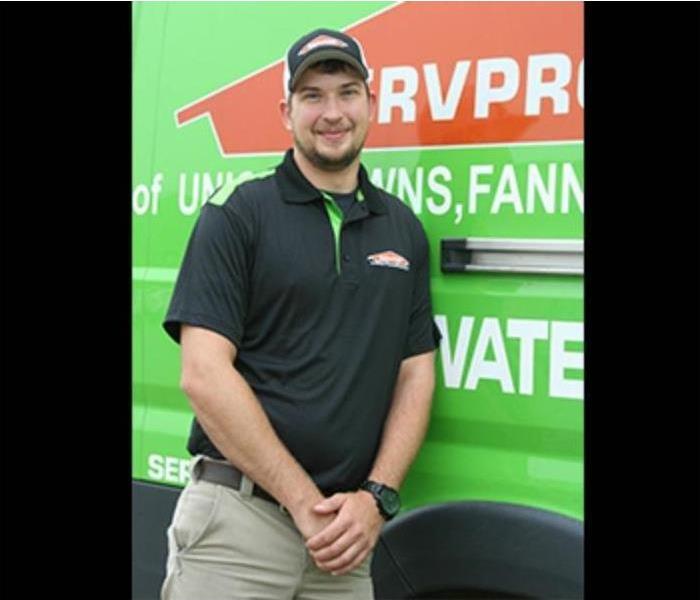
SERVPRO® of Union, Towns, Fannin & Gilmer Counties, a premier cleanup and restoration company, congratulates Caleb Weaver, as the new Production Manager. He will be responsible for managing production crews and jobs from start to finish.
Weaver joined the SERVPRO production team in 2009 as a Technician. He progressed to Crew Chief, Senior Crew Chief, and Assistant Production Manager before this promotion. He has earned the Water Damage Restoration and Applied Structural Drying certifications from the Institute of Inspection Cleaning & Restoration . He is a certified lead paint renovator and has also completed forklift training.
“Our most important priority is to provide the very best support and service to our customers,” said Keith Wall, owner of SERVPRO® of Union, Towns, Fannin & Gilmer Counties. “The experience, knowledge and skills that Caleb Weaver brings to our franchise management team will help us better serve our community and continue to ensure our customers' satisfaction.”
“I’m very excited to join the management team at SERVPRO® of Union, Towns, Fannin & Gilmer Counties,” said Weaver. “It’s a unique opportunity to continue to grow as a professional while helping people in a time of need.”
SERVPRO® of Union, Towns, Fannin & Gilmer Counties provides cleanup and restoration services following a fire, water or even mold-related damage. Additional services offered include: cleaning and restoration of special items, such as HVAC duct systems; building exteriors; electronic equipment, including computers and documents that have sustained water damage.
For more information on SERVPRO® of Union, Towns, Fannin & Gilmer Counties , please contact Keith Wall at 706-896-1880.
Faster to your Union, Towns, Fannin & Gilmer County Water Damage Ever
7/26/2018 (Permalink)
Flooding and water emergencies don’t wait for regular business hours and neither do we. SERVPRO of Santa Barbara provides emergency cleaning and restoration services 24 hours a day, 7 days a week—including all holidays.
Faster To Any Size Disaster
Flooding and water damage is very invasive. Water quickly spreads throughout your home and gets absorbed into floors, walls, furniture, and more. SERVPRO of Union, Towns, Fannin & Gilmer Counties arrives quickly and starts the water extraction process almost immediately. This immediate response helps to minimize the damage and the cleaning and restoration costs.
Need Emergency Service? Call Us 24/7 –706-896-1880
Water Damage Timeline
Within Minutes
- Water quickly spreads throughout your property, saturating everything in its path.
- Water is absorbed into walls, floors, upholstery, and belongings.
- Furniture finishes may bleed, causing permanent staining on carpets.
- Photographs, books, and other paper goods start to swell and warp.
Hours 1 - 24:
- Drywall begins to swell and break down.
- Metal surfaces begin to tarnish.
- Furniture begins to swell and crack.
- Dyes and inks from cloth and paper goods spread and stain.
- A musty odor appears.
48 Hours to 1 Week:
- Mold and mildew may grow and spread.
- Doors, windows, and studs swell and warp.
- Metal begins to rust and corrode.
- Furniture warps and shows signs of mold.
- Paint begins to blister.
- Wood flooring swells and warps.
- Serious biohazard contamination is possible.
More Than 1 Week:
- Restoration time and cost increase dramatically; replacing contaminated materials and structural rebuilding may be extensive.
- Structural safety, mold growth, and biohazard contaminants pose serious risks to occupants.
About SERVPRO of Union, Towns, Fannin & Gilmer Counties
SERVPRO of Union, Towns, Fannin & Gilmer Counties specializes in the cleanup and restoration of residential and commercial property after a fire, smoke or water damage event. Our staff is highly trained in property damage restoration. From initial and ongoing training at SERVPRO’s corporate training facility to regular IICRC-industry certification, rest assured our staff is equipped with the knowledge to restore your property.
For Immediate Service in Union, Towns, Fannin & Gilmer Counties, Call SERVPRO
7/26/2018 (Permalink)
SERVPRO of Union, Towns, Fannin & Gilmer Counties provides 24-hour emergency service and is dedicated to being faster to any-sized disaster inUnion, Towns, Fannin & Gilmer Counties. We can respond immediately to your emergency and have the expertise to handle your restoration or cleaning needs.
- 24-Hour Emergency Service
- Faster to Any-Sized Disaster
- Highly Trained Restoration Technicians
- A Trusted Leader in the Restoration Industry
- Locally Owned and Operated
- Advanced Restoration and Cleaning Equipment
Have Questions? Call Us 24/7 –706-896-1880
Residential Services
Whether your home needs emergency flood damage or your upholstery cleaned, you can depend on us. Our technicians have extensive cleaning and restoration training and can make your property look its best. Learn more about our residential services:
- Water Damage Restoration
- Fire Damage Restoration
- Mold Remediation
- Storm Damage Restoration
- Cleaning Services
- Building/Reconstruction Services
Commercial Services
There's never a convenient time for fire or Water damage to strike your commercial property. Every hour spent cleaning up is an hour of lost revenue and productivity. So when the need arises for professional cleaning or emergency restoration services we have the training and expertise to respond promptly with highly trained technicians to get your property back to business. Learn more about our commercial services: http://www.SERVPROuniontownsfanningilmercounties.com/commercial-restoration-cleaning
- Commercial Water Damage Restoration
- Commercial Fire Damage Restoration
Our Highly Trained Restoration Specialists can restore your Home
7/26/2018 (Permalink)
SERVPRO of Union, Towns, Fannin & Gilmer Counties is an IICRC firm. The Institute of Inspection, Cleaning and Restoration Certification (IICRC) creates the standards for the restoration industry and provides training and certification to restoration companies. IICRC Certified Firms have the right to display the IICRC Certified Logo.
IICRC Certified Firms must
• Present accurate information to consumers and conduct business with honesty and integrity.
• Require a technician on all jobs who has been formally trained and passed all required tests.
• Require a continuing education program to keep technicians up-to-date on the latest changes in the industry.
• Maintain liability insurance to protect all parties in the event of an accident.
• Maintain a written complaint policy and agree to Better Business Bureau or similar arbitration to resolve disputes, and accept the conclusions and recommendations of arbitration.
The IICRC Develops The Standards For The Restoration Industry
The IICRC has been the driving force in establishing the main industry standards and reference guides for professional carpet cleaning, water damage restoration and mold remediation. These IICRC standards take years to develop and require the coordination of experts in the field: manufacturers, industry organizations, insurance professionals, training schools, contractors, and public health professionals.
Every five years, the standards are reviewed and updated. The water damage restoration field changes rapidly with advancements in technology and science, and therefore the standards must evolve to keep pace.
About SERVPRO of Union, Towns, Fannin & Gilmer Counties
SERVPRO of Union, Towns, Fannin & Gilmer Counties specializes in the cleanup and restoration of residential and commercial property after a fire, smoke or water damage event. Our staff is highly trained in property damage restoration and we are an IICRC Certified Firm. We believe in continuous training: from initial and ongoing training at SERVPRO’s corporate training facility to regular IICRC-industry certification, rest assured our staff is equipped with the knowledge to restore your property.
http://www.SERVPROuniontownsfanningilmercounties.com/crew-photos
Smoke and Soot Cleanup
7/26/2018 (Permalink)
Smoke and soot is very invasive and can penetrate various cavities within your home, causing hidden damage and odor. Our smoke damage expertise and experience allows us to inspect and accurately assess the extent of the damage to develop a comprehensive plan of action.
Smoke and soot facts:
- Hot smoke migrates to cooler areas and upper levels of a structure.
- Smoke flows around plumbing systems, seeping through the holes used by pipes to go from floor to floor.
- The type of smoke may greatly affect the restoration process.
Different Types of Smoke
There are two different types of smoke–wet and dry. As a result, there are different types of soot residue after a fire. Before restoration begins, SERVPRO of Union, Towns, Fannin & Gilmer Counties will test the soot to determine which type of smoke damage occurred. The cleaning procedures will then be based on the information identified during pretesting. Here is some additional information:
Wet Smoke – Plastic and Rubber
- Low heat, smoldering, pungent odor, sticky, smeary. Smoke webs are more difficult to clean.
Dry Smoke – Paper and Wood
- Fast burning, high temperatures, heat rises therefore smoke rises.
Protein Fire Residue – Produced by evaporation of material rather than from a fire
- Virtually invisible, discolors paints and varnishes, extreme pungent odor.
Our Fire Damage Restoration Services
Since each smoke and fire damage situation is a little different, each one requires a unique solution tailored for the specific conditions. We have the equipment, expertise, and experience to restore your fire and smoke damage. We will also treat your family with empathy and respect and your property with care.
Have Questions about Fire, Smoke, or Soot Damage?
Call Us Today – 706-896-1880
Union, Towns, Fannin & Gilmer Residents: We Specialize in Flooded Basement Cleanup and Restoration!
7/26/2018 (Permalink)
A basement can flood at any time, although flooding most often occurs during heavy rainfall. Basements are inherently prone to flooding because they are the lowest level of a building and are normally built partly or entirely below ground level. There are a number of reasons why your basement could flood, including:
- A blocked or failed sewer lateral pipe
- Heavy rain causes surface water to pool around your home
- Storm sewer backup
- Sanitary sewer backup
- Foundation drainage failure
- Water supply-line break or hot-water tank failure
- And many more
Have Questions about Basement Flooding?
Call Today - 706-896-1880
If flood water is not handled quickly and properly, it can jeopardize your health and safety, and cause severe damage to your home’s structure. Remember, the longer you wait, the worse the problem will get.
The bottom line: a flooded basement can jeopardize your health, safety, and your home’s integrity. It’s worth making a call to SERVPRO of Union, Towns, Fannin & Gilmer Counties and let our trained, professional crews handle the situation safely and correctly. We have earned the trust of hundreds of homeowners, business owners, and property professionals.
We are Flooded Basement Specialists:
- We are Available 24 hours/7 days per week
- We’re a Preferred Vendor to many National Insurance Companies
- We Bill The Insurance Directly – One Less Thing For You To Worry About
- Our Technicians are Highly-Trained in Water Restoration Techniques
- We use s500 IICRC Restoration Standards
- Advanced Inspection and Extraction Equipment
Basement Flooded? Call Us Today – We’re Ready To Help 706-896-1880
Choosing the Proper Fire Extinguisher
7/17/2018 (Permalink)
A fire extinguisher can be a life-saving tool when used correctly. The U.S. Fire Administration (USFA) recommends individuals are properly trained in order to use and maintain an extinguisher.
USFA says an extinguisher should only be used if:
- You have alerted other occupants and someone has called the fire department.
- The fire is small and contained to a single object, such as a wastebasket.
- You are safe from the toxic smoke produced by the fire.
- You have a means of escape identified and the fire is not between you and the fire escape route.
- Your instincts tell you that it is safe to use an extinguisher.
Classes of Fire Extinguishers:
Class A: Use on ordinary combustible materials, such as cloth, wood, rubber, paper, and many plastics.
Class B: Use on flammable liquids, such as grease, gasoline and oil.
Class C: Use on appliances, tools, or other equipment that is electrically energized or plugged in.
Class D: Use on flammable metals and are often specific for the type of metal in question. These are typically found only in factories working with these metals.
Class K: Use on vegetable oils, animal oils, or fats in cooking appliances. These are generally found in commercial kitchens, but are suitable for the residential market.
Check out the Fire Equipment Manufacturers Association for more information about fire extinguisher use, type and care.
Food Safety Tips
7/17/2018 (Permalink)
Even though we live in the mountains, there is the potential for flooding. Anywhere it can rain, it can flood. The most dangerous type of flood, a flash flood, happens quickly with little or no warning. Just ask the people who live in Gilmer County who experienced flooding in early August--or the people in Union County who experienced flooding in early July.
Here are some tips provided by ready.gov to keep you safe during floods:
- Do not walk through moving water. Six inches of moving water can make you fall.
- Do not drive into flooded areas. If floodwaters rise around your car, abandon the car and move to higher ground if you can do so safely. You and the vehicle can be swept away quickly.
- Avoid floodwaters; water may be contaminated by oil, gasoline, or raw sewage.
- If your property suffers flood damage, clean and disinfect everything that got wet. Mud left from floodwaters can contain sewage and chemicals.
Flooded Home Results in Mold
7/17/2018 (Permalink)
An unrecognized water loss resulted in this home being over-run with large amounts of mold. The home was a second home in Blairsville, GA and was not frequently visited. This photo shows what moisture left unattended can lead to.
If you see visible mold, do not disturb it. You can inadvertently spread the mold infestation throughout your home. When mold is disturbed, the mold can release microscopic mold spores which become airborne and can circulate inside your home.
What to Do:
- Stay out of affected areas.
- Turn off the HVAC system and fans.
- Contact SERVPRO of Union, Towns, Fannin & Gilmer Counties for mold remediation services.
What Not to Do:
- Don’t touch or disturb the mold.
- Don’t blow air across any surfaces with visible or suspected mold growth.
- Don’t attempt to dry the area yourself.
- Don’t spray bleach or other disinfectants on the mold.
SERVPRO of Union, Towns, Fannin & Gilmer Counties was called in to handle the damage to this home. The owners of this property were overjoyed with the results.
Hiring Rug Cleaning Services Instead Of Attempting DIY
7/17/2018 (Permalink)
Choosing to hire certified rug cleaning services rather than opting to tackle a more DIY approach is the best option for any homeowner. While the process may seem as simple as a good vacuum and spot removal job, those alone will not help in prolonging the life of the rug. Many are instead leaving it up to a technician that has been highly educated and trained through the Institute of Inspection, Cleaning, and Restoration Certification (IICRC) will ensure the job is done properly. They have the latest tools and skills to carry out the job with the utmost care and detail.
An increasing number of homeowners are finding themselves with area rugs in one or more rooms of their living space. Typically, they take quite a bit of abuse due to the day-to-day wear and tear done by family, pets, and guests. That heavy foot traffic leaves dirt, dust, odors and stains behind. What started out as a useful, yet decorative piece in a room ends up looking worn, dingy, and full of bothersome allergens. Routine upkeep such as vacuuming and minor stain removal can be done, yet it is imperative to have the piece removed and professionally cleaned on a regular basis. The frequency of this process truly depends on the extent of use the piece has.
Technicians that are IICRC-certified have had the coursework and training necessary to provide superior rug cleaning services. From start to finish they will work tirelessly to restore the piece to its original, vibrant appearance. This attention to detail starts with an initial inspection to establish the type of material that will be dealt with, what debris and allergens are present, and if there is any damage to be addressed. At this time they will be able to give the homeowner an idea of the extent of treatment and time frame required. Typically the piece is removed from the home and brought to the business location, which is fully equipped to complete the job. The technician starts with a careful vacuuming to remove loose debris, which is followed by any needed stain and damage treatment, and a good rinse. Once completely dampened a gentle but effective cleansing solution is applied and a soft agitating brush is used on the surface. A hot water extraction technique may be utilized at this time for a deeper clean or it may go through a total immersion process. The rug is then meticulously rinsed.. Depending on the equipment in place, it may be placed in a rotating centrifuge to draw out a majority of the water or other another extraction method may be utilized. It is hung for complete drying before being transported and delivered back to the home. Prior to final delivery it will be groomed via a finishing brush and a combing of the fringe to complete its pristine appearance.
While the do-it-yourself approach may seem doable to some, a true comprehensive treatment can only be done by those certified to perform these specialized rug cleaning services. It is important for homeowners to do a little investigating prior to choosing the firm to entrust with the job. Personal and online recommendations are a great starting point, as is the IICRC's own website. They provide a database of certified firms that are current on their training and continue to follow the industry standards. Additionally, viewing their website, contacting the business directly, and even visiting their facility will offer insight into the service and result to be expected.
For most, this type of floor covering was an investment in the home's warmth and overall decor. While it is there to be walked upon, it is also important to protect and maintain it regularly.
www.IICRC.org
Home Carpet Cleaning Should Always Involve Professionals
7/17/2018 (Permalink)
Frequent home carpet cleaning is the only sure way to keep carpeting in good shape, but too many people still neglect to perform it often enough. Carpeting sustains a lot of wear and tear, picking up pet dander, soils, food particles, water, chemical residues, and a number of other contaminants. If these contaminants are allowed to sit for too long, they can damage the fibers, discolor them, or even attract pests or mold. It’s a situation no homeowner wants to get into, and professional treatment is the only way to ensure it doesn’t become a reality.
Why should professionals be brought in to perform home carpet cleaning?
It’s often impossible to know just how soiled the carpeting is, so it’s best to ensure treatment is thorough. And when it comes to thorough treatment, certified technicians are a homeowner’s best bet. Store bought or rented machines are limited in their effectiveness, and don’t provide the same level of performance that a commercial machine offers. Rented machines can’t agitate the fibers as vigorously, they can’t penetrate as deeply as a commercial machines, and they aren’t as precise. This leads to inferior treatment and rapid resoiling of the carpeting.
While operating rental machinery may seem simple, there’s more to the process than one might realize. The biggest problems untrained people have when cleaning their carpets is using too much or too little water. With too little water, it will be impossible to effectively remove soils, and detergent residue will be left behind to dry and adhere to the flooring. Too much water, and the floor will remain damp for too long, allowing mold and pests to take root, and making it easy for people to dirty the flooring again. A lack of training is not the only issue, either, as rented machinery isn’t as precise at dispensing water, nor is it powerful enough to reliably extract it.
Professional home carpet cleaning firms do not have these issues, as they are certified in the best industry practices and have the commercial quality equipment to match their expertise. For example, certified crews have received training from the Institute of Inspection, Cleaning and Restoration Certification (IICRC), and are armed with the IICRC’s sophisticated treatment practices. This includes comprehensive procedures in removing dry soil, suspending matted-in soils, and removing them as well. Soil suspension and removal is not something a homeowner is equipped to handle, and that’s a problem because most of the worst soils are matted into the flooring.
Certified home carpet cleaning professionals have powerful technology, including water extraction machines that agitate the fibers down to the backing. Professionals can also treat the carpeting to protect it from additional soiling and extend the carpeting’s longevity. It’s much more affordable than replacing the carpet, and much less of a headache, so professional treatment should be considered an investment, and not just a service.
www.IICRC.org
How To Choose Water Damage Restoration Services
7/17/2018 (Permalink)
When a storm leaves a home flooded, or a burst pipe causes serious issues in the house, getting water damage restoration services from a respected company should be considered a top priority. Unfortunately, this industry is not regulated, and there are people out there who pose as professionals or overstate their qualifications. Therefore, homeowners should be mindful of who they hire, as an untrained technician may do more harm than good or delay repairs, resulting in a higher degree of destruction. Before selecting a company to handle the job, keep in mind these points of emphasis:
· Only choose certified professionals to perform water damage restoration services. Even though the industry is not regulated, technicians who have received certification have made the effort to get the best training possible, proving that they take their job seriously. Certification through the Institute of Inspection, Cleaning and Restoration Certification (IICRC) is a sign that a professional has received the most up to date training and is knowledgeable in the latest techniques and technologies employed during repairs. The IICRC operates a Certified Firm registrant-only database on its site, making it easy to find a local, certified professional without trouble.
· Do not select a technician based only on the price or an insurance company’s recommendation. When possible, speak to neighbors or friends who have had to hire a technician recently and try to get a recommendation from them. Insurance companies often select a restoration company based on price, and unusually low pricing suggests the company does not use modern drying or repair methods.
· Choose a company that offers a range of water damage restoration services. The easiest way to determine the expertise of a firm is to see if they provide a full range of options for homeowners. Mold remediation, for example, is often needed given how quickly mold can set in. This is a standard field of knowledge that advanced technicians should possess. If a company doesn’t offer mold remediation, it may not be prepared for all job settings.
· A company that is available 24/7 is a good sign. Stay away from any firms that are reluctant to start right away. In many cases modern equipment can enable near-complete drying in as little as 36 hours, although many situations require longer. Also, a homeowner should not have to wait before repairs begin. Every minute counts when there is standing water present, and reputable professionals understand this. If a technician insists on waiting to begin the remediation portion of the loss, they probably cannot be trusted to see the job through in a reasonable timeframe.
Using these guidelines, a homeowner should be able to find a technician that can be trusted and is equipped to do the job the right way. A storm or other disaster is hard enough to deal with, and a remediation firm should do everything in its power to make this difficult process easier.
http://www.IICRC.org/
Is Your Business Prepared for a Fire?
7/17/2018 (Permalink)
How prepared are you? Do you have a fire escape plan for your business? A fire can spread quickly, leaving only mnutes to escape. Having a plan in place prior to an emergency will allow you and your employees to exit quickly in the event of a fire. We at SERVPRO can help you plan for a fire or other emergency by creating an Emergency Ready Profile (ERP) for your facility. The ERP is a comprehensive document containing critical information about your business, including: emergency contact information, shut-off valve locations and priority areas. The ERP is a no-cost assessment. All it requires is a little time, making it a great value that could save a lot of time in the future. Call us at 706-896-1880 or 706-273-7776 to schedule an appointment to begin your ERP.
National Preparedness Month
7/17/2018 (Permalink)
SERVPRO Industries, Inc. is once again proud to be a member of the National Preparedness Month Coalition and is committed to helping the U.S. Department of Homeland Security in their efforts to promote the importance of preparedness planning.
What does it mean to be prepared?
For FAMILIES, it means households have an emergency supply kit so they can be self-reliant for at least three days in case of emergency, and they have a plan for how they will respond and reconnect after an emergency.
For BUSINESSES, it means employers have planned for how they will survive a disaster; they've backed up critical information, developed a plan for assisting employees on site, established a call tree to account for employees, and identified back-up sources of power and supplies.
For SCHOOLS, it means schools and districts have developed, implemented, and communicated crisis plans.
Being prepared means staying informed, knowing how to get information and alerts from local ememrgency management agencies, and understanding the specific risks in your community and preparing against them.
Ready for Whatever Happens!
7/17/2018 (Permalink)
As severe weather approaches, you and your family are reminded to check our emergency supply kits, we are also reminded of the SERVPRO slogan "Ready for whatever happens". The U.S. Department of Homeland Security recommends having at least one full emergency supply kit for your home and smaller portable kits for your office and vehicles.
A basic emergency supply kit should contain at least the following:
- Water (one gallon per person per day)
- Food (non-perishable 3-day supply)
- Manual can opener
- Battery operated radio, preferably a NOAA weather radio
- Flashlight and extra batteries
- First aid kit
- Whistle to signal for help
- Clothing
- Dust masks or bandanas
- Plastic sheeting, garbage bags and duct tape
- Wrench or pliers to turn off utilities
- Hygiene items
- Important documents; copies of insurance policies, ID and bank account information
- Cash
- Fire extinguisher
- Matches in a waterproof container
Remember, this is only a basic kit. Your circumstances may require additional items. Check out the U.S. Department of Homeland Security website on readiness at www.ready.gov for more information. You can also contact SERVPRO of Union, Towns, Fannin & Gilmer Counties to learn more and be "Ready for whatever happens!"
Food Safety Tips
3/22/2018 (Permalink)
Even though we live in the North Georgia mountains, there is the potential for flooding. Anywhere it can rain, it can flood. The most dangerous type of flood, a flash flood, happens quickly with little or no warning. Just ask the people who live in Ellijay who experienced flooding in early August, or the people in Blairsville who experienced flooding in early July.
Here are some tips provided by ready.gov to keep you safe during floods:
- Do not walk through moving water. Six inches of moving water can make you fall.
- Do not drive into flooded areas. If floodwaters rise around your car, abandon the car and move to higher ground if you can do so safely. You and the vehicle can be swept away quickly.
- Avoid floodwaters; water may be contaminated by oil, gasoline, or raw sewage.
- If your property suffers flood damage, clean and disinfect everything that got wet. Mud left from floodwaters can contain sewage and chemicals.
National Preparedness Month
3/22/2018 (Permalink)
SERVPRO Industries, Inc. is once again proud to be a member of the National Preparedness Month Coalition and is committed to helping the U.S. Department of Homeland Security in their efforts to promote the importance of preparedness planning.
What does it mean to be prepared?
For FAMILIES, it means households have an emergency supply kit so they can be self-reliant for at least three days in case of emergency, and they have a plan for how they will respond and reconnect after an emergency.
For BUSINESSES, it means employers have planned for how they will survive a disaster; they've backed up critical information, developed a plan for assisting employees on site, established a call tree to account for employees, and identified back-up sources of power and supplies.
For SCHOOLS, it means schools and districts have developed, implemented, and communicated crisis plans.
Being prepared means staying informed, knowing how to get information and alerts from local ememrgency management agencies, and understanding the specific risks in your community and preparing against them.
Is Your Business Prepared for a Fire?
3/22/2018 (Permalink)
How prepared are you? Do you have a fire escape plan for your business? A fire can spread quickly, leaving only mnutes to escape. Having a plan in place prior to an emergency will allow you and your employees to exit quickly in the event of a fire. We at SERVPRO can help you plan for a fire or other emergency by creating an Emergency Ready Profile (ERP) for your facility. The ERP is a comprehensive document containing critical information about your business, including: emergency contact information, shut-off valve locations and priority areas. The ERP is a no-cost assessment. All it requires is a little time, making it a great value that could save a lot of time in the future. Call us at 706-896-1880 or 706-273-7776 to schedule an appointment to begin your ERP.
Water Damage
3/22/2018 (Permalink)
When the Pipes Crack: Tips to Prevent Water Damage
When extreme temperatures strike, homeowners across the U.S. are crippled with millions of dollars in water damage to homes and buildings.
Leaving a home alone can become an expensive implication if things go astray while you are gone. And unfortunately more often than not, things do go wrong. Opportunely, there are certain things homeowners can do to protect their home and the interior possessions.
Water is the homeowners’ biggest enemy. If a pipe were to burst thousands of gallons of water can begin to flood the home. The IICRC responds as an authority on pulling the pieces back together for home and business owners. When water damage results from cracked pipes, IICRC offers these tips for clean-up.
To Prevent Frozen Pipes:
• Wrap electrical heating tape on exterior pipes. Remove garden hoses from faucets.
• Cover pipes with foam rubber or fiberglass insulation and secure it with tape.
• Let cold and hot water faucets drip. Running water helps prevent freezing pipes and reduces pressure build up in them.
• Inside the home, open kitchen and bathroom cabinet doors to promote warm air circulation around plumbing.
• Leave the thermostat at the same temperature both day and night, at least 55°F.
To Thaw Frozen Pipes:
• Locate the problem pipe, if possible, and open a faucet. As the pipe thaws, running water aids the melting process.
• Apply heat to the frozen section using a hand-held hair dryer or portable electric space heater. Do not use a blow torch as it could cause the pipe to explode. Do not use a propane or kerosene heater as these are hazardous for indoor use.
• If you are unable to locate or access the frozen pipe area, call a licensed plumber.
• If all else fails and you experience a burst pipe that results in water damage, shut off the main water valve and contact a professional water damage restoration company with trained technicians and extraction, drying and dehumidifying equipment.
If Water Damage Occurs, Tips for Clean-Up:
• Shut off the main water valve, if practical, and call a plumber to fix the leak.
• Call an IICRC-certified professional water restoration firm immediately for mitigation services, as required by your insurance policy. Certified Firms have the knowledge, experience and equipment to locate water wherever it goes, remove the excess, and dry your structure to industry standards.
• Mop up standing water on flooring surfaces to prevent slip/fall hazards. If the burst pipe is overhead, drain ceiling cavities by punching “weep” holes.
• Prevent mold growth. Although it takes a few days to appear, mold thrives on wood, paper, particle board or even household soil, when stagnant air, moisture, and temperatures between 68 and 86 degrees are present.
• Wet clothing usually is salvageable. A 10-minute wash cycle in detergent and hot water should sanitize washable clothing and many household fabrics.
• Dry out before you rebuild. Professional water restorers have a variety of instruments to determine when a building is dry, to prevent on-going microbial growth. Drying should not stop until wood or drywall moisture content (MC) falls below 16% MC. Normal MC is around 10% in most areas of the country.
www.IICRC.org
Flooded Home Results in Mold
3/22/2018 (Permalink)
An unrecognized water loss resulted in this home being over-run with large amounts of mold. The home was a second home in Blairsville, GA and was not frequently visited. This photo shows what moisture left unattended can lead to.
If you see visible mold, do not disturb it. You can inadvertently spread the mold infestation throughout your home. When mold is disturbed, the mold can release microscopic mold spores which become airborne and can circulate inside your home.
What to Do:
- Stay out of affected areas.
- Turn off the HVAC system and fans.
- Contact SERVPRO of Union, Towns, Fannin & Gilmer Counties for mold remediation services.
What Not to Do:
- Don’t touch or disturb the mold.
- Don’t blow air across any surfaces with visible or suspected mold growth.
- Don’t attempt to dry the area yourself.
- Don’t spray bleach or other disinfectants on the mold.
SERVPRO of Union, Towns, Fannin & Gilmer Counties was called in to handle the damage to this home. The owners of this property were overjoyed with the results.
Fire And Water Restoration Needs Immediate Attention
3/22/2018 (Permalink)
Houses can suffer a great deal of damage from a natural catastrophe, making fire and water restoration jobs two of the most common emergency services. It is even more common for these damages to arise from within the home itself, be it from faulty pipes or improper construction. Families shouldn’t suffer beyond the physical damage of their houses, so it becomes imperative to seek out only certified technicians in order to properly repair a home. Since these disasters can quickly get out of hand and will get worse as time goes on, one must move to expediently address the damages.
Depending on where the source is, rain and storm damage will begin to erode the bare surfaces surrounding it. Drywall for instance is one of the first victims, as it will quickly become saturated and discolored, eventually losing its structural integrity and collapsing. Fire and water restoration typically involves a thorough inspection of the premises, as the underlying source must be identified and treated in order to properly prevent the building from future damages. Carpet, furniture and electronics can all be damaged or destroyed if the problem is not dealt with in a reasonable time frame and by certified technicians.
The process for resolving this type of damage involves removing any saturated drywall and replacing it with new material. In order to maintain the appearance throughout the home, technicians will affix the new drywall with the proper fasteners and it is then sanded down to match the surrounding wall. Further complications, either from waiting too long to treat, or from improper drying, involve the growth of mold throughout the home. To avoid this, technicians will use air mover fans and dehumidifiers to accelerate the natural drying process and fully remove the threat.
As destructive as floods and pipe breakages can be, damages from a blaze can be just as disastrous. IICRC-certified fire and water restoration crews use only the most recent and effective means in treating these types of disasters. While the worst-case scenarios involve the destruction of the entire building, blazes can affect many different things in a building, even if they were very small. For instance, soot is notorious for spreading into every nook and cranny. While it can be nearly impossible to remove it by one’s self, trained technicians utilize large HEPA certified vacuums and thermal fogging machines to remove all traces completely.
On top of the immediate damage, fire and water restoration crews are necessary for removing the residual damage that can linger from old disasters. Only trained technicians can properly inspect a building or home in order to uncover problem areas such as damp materials and ash. Damp materials can foster mold growth, while ash can corrode metal, scratch glass, and when left untreated for long enough time, it can cause a strong, unpleasant odor.
www.IICRC.org
Hiring Rug Cleaning Services Instead Of Attempting DIY
3/22/2018 (Permalink)
Choosing to hire certified rug cleaning services rather than opting to tackle a more DIY approach is the best option for any homeowner. While the process may seem as simple as a good vacuum and spot removal job, those alone will not help in prolonging the life of the rug. Many are instead leaving it up to a technician that has been highly educated and trained through the Institute of Inspection, Cleaning, and Restoration Certification (IICRC) will ensure the job is done properly. They have the latest tools and skills to carry out the job with the utmost care and detail.
An increasing number of homeowners are finding themselves with area rugs in one or more rooms of their living space. Typically, they take quite a bit of abuse due to the day-to-day wear and tear done by family, pets, and guests. That heavy foot traffic leaves dirt, dust, odors and stains behind. What started out as a useful, yet decorative piece in a room ends up looking worn, dingy, and full of bothersome allergens. Routine upkeep such as vacuuming and minor stain removal can be done, yet it is imperative to have the piece removed and professionally cleaned on a regular basis. The frequency of this process truly depends on the extent of use the piece has.
Technicians that are IICRC-certified have had the coursework and training necessary to provide superior rug cleaning services. From start to finish they will work tirelessly to restore the piece to its original, vibrant appearance. This attention to detail starts with an initial inspection to establish the type of material that will be dealt with, what debris and allergens are present, and if there is any damage to be addressed. At this time they will be able to give the homeowner an idea of the extent of treatment and time frame required. Typically the piece is removed from the home and brought to the business location, which is fully equipped to complete the job. The technician starts with a careful vacuuming to remove loose debris, which is followed by any needed stain and damage treatment, and a good rinse. Once completely dampened a gentle but effective cleansing solution is applied and a soft agitating brush is used on the surface. A hot water extraction technique may be utilized at this time for a deeper clean or it may go through a total immersion process. The rug is then meticulously rinsed.. Depending on the equipment in place, it may be placed in a rotating centrifuge to draw out a majority of the water or other another extraction method may be utilized. It is hung for complete drying before being transported and delivered back to the home. Prior to final delivery it will be groomed via a finishing brush and a combing of the fringe to complete its pristine appearance.
While the do-it-yourself approach may seem doable to some, a true comprehensive treatment can only be done by those certified to perform these specialized rug cleaning services. It is important for homeowners to do a little investigating prior to choosing the firm to entrust with the job. Personal and online recommendations are a great starting point, as is the IICRC's own website. They provide a database of certified firms that are current on their training and continue to follow the industry standards. Additionally, viewing their website, contacting the business directly, and even visiting their facility will offer insight into the service and result to be expected.
For most, this type of floor covering was an investment in the home's warmth and overall decor. While it is there to be walked upon, it is also important to protect and maintain it regularly.
www.IICRC.org
Home Carpet Cleaning Should Always Involve Professionals
3/22/2018 (Permalink)
Frequent home carpet cleaning is the only sure way to keep carpeting in good shape, but too many people still neglect to perform it often enough. Carpeting sustains a lot of wear and tear, picking up pet dander, soils, food particles, water, chemical residues, and a number of other contaminants. If these contaminants are allowed to sit for too long, they can damage the fibers, discolor them, or even attract pests or mold. It’s a situation no homeowner wants to get into, and professional treatment is the only way to ensure it doesn’t become a reality.
Why should professionals be brought in to perform home carpet cleaning?
It’s often impossible to know just how soiled the carpeting is, so it’s best to ensure treatment is thorough. And when it comes to thorough treatment, certified technicians are a homeowner’s best bet. Store bought or rented machines are limited in their effectiveness, and don’t provide the same level of performance that a commercial machine offers. Rented machines can’t agitate the fibers as vigorously, they can’t penetrate as deeply as a commercial machines, and they aren’t as precise. This leads to inferior treatment and rapid resoiling of the carpeting.
While operating rental machinery may seem simple, there’s more to the process than one might realize. The biggest problems untrained people have when cleaning their carpets is using too much or too little water. With too little water, it will be impossible to effectively remove soils, and detergent residue will be left behind to dry and adhere to the flooring. Too much water, and the floor will remain damp for too long, allowing mold and pests to take root, and making it easy for people to dirty the flooring again. A lack of training is not the only issue, either, as rented machinery isn’t as precise at dispensing water, nor is it powerful enough to reliably extract it.
Professional home carpet cleaning firms do not have these issues, as they are certified in the best industry practices and have the commercial quality equipment to match their expertise. For example, certified crews have received training from the Institute of Inspection, Cleaning and Restoration Certification (IICRC), and are armed with the IICRC’s sophisticated treatment practices. This includes comprehensive procedures in removing dry soil, suspending matted-in soils, and removing them as well. Soil suspension and removal is not something a homeowner is equipped to handle, and that’s a problem because most of the worst soils are matted into the flooring.
Certified home carpet cleaning professionals have powerful technology, including water extraction machines that agitate the fibers down to the backing. Professionals can also treat the carpeting to protect it from additional soiling and extend the carpeting’s longevity. It’s much more affordable than replacing the carpet, and much less of a headache, so professional treatment should be considered an investment, and not just a service.
www.IICRC.org
The Damage Water Causes Can Be Permanent If Not Treated Properly
3/22/2018 (Permalink)
The kind of damage water can create in the home is staggering, and if not dealt with promptly, it may result in permanent issues for the homeowner. Excess moisture is a constant enemy in buildings, seeping in around windows, through the HVAC system, from the plumbing, and even through the air every time a door is opened. As long as the home is maintained well, this isn’t a problem, but a flood or burst pipe can quickly change the situation.
What damage can water cause in the home?
Excess moisture is unique in its destructive capabilities. Not only can it create significant and immediate physical devastation, it can make the home a hotspot for bacteria, viruses and molds. Floods are particularly troublesome, as they can fill the home with contaminated water.
When a flood slams into a building, it gathers in the lowest rooms, soaking everything in its wake. The flood brings in many hazards with it, sometimes including wildlife, chemical runoff, and various pathogens. For this reason, untrained people are strongly cautioned not to enter a building that has been wracked by a flood, as they may be bit or stung by dangerous wildlife. Chemical runoff includes fertilizers, road oils, and precipitants sitting on rooftops. This can make the fluid highly toxic and leave stains and odors.
But perhaps the most concerning damage water creates is pathological. Floods pick up fluid from rivers, lakes and ditches, and this fluid may contain cholera, hepatitis, dysentery and salmonella. It can wash in molds as well, turning the home into a biological hazard. What makes microbes especially dangerous in the home is that most houses are filled with organic materials, and these provide ideal conditions for microbes to grow. Drywall, carpets, upholstery, and wood are among the organic materials microbes may latch onto, and within 48 hours, any material that has been soaked through with contaminated fluid will usually be beyond salvaging. And even if the fluid is mostly benign, the withering exposure to moisture can yellow drywall and erode its integrity, and cause wood to warp.
There is no getting around it, the kind of damage water can produce is staggering, and it’s capable of leaving a building in a condemnable condition.
That’s why restoration firms are equipped to respond to disasters day and night, and are ready to treat floods and plumbing mishaps right away. Certified restoration firms, like those trained through the Institute of Inspection, Cleaning and Restoration Certification (IICRC), have the skills and tools needed to deal with all kinds of moisture related disasters. Within a few days, restoration firms can remove all signs of excess moisture, saving sensitive materials, drying out the home, and destroying any signs of mold and microbes.
Floods and plumbing disasters cannot be ignored, and when they do emerge, the only way to deal with them safely is with a certified professional’s help.
www.IICRC.org
The Next Step After Having Fire And Water Damage
3/22/2018 (Permalink)
Fire and water damage are nightmares for any home or business owner because they typically force expensive repairs. This is particularly true when the building is flooded or a pipe bursts. Such disasters can destroy entire floors of a building, and make it uninhabitable until it is cleaned out. But cleaning it out is something that only professionals should be allowed to handle, especially if there is contaminated fluid or a lot of ash residue present. Certified technicians will have the tools and expertise needed to restore the building to normal and allow people to work or live in it without fear of health issues.
How do professionals perform fire and water damage restoration?
The only way to deal with a flame’s aftermath is to clean the area up thoroughly. Even a small fire can leave behind a good deal of ash and soot, and it will become more than just an annoyance if it is allowed to spread through the building. Smoke is another concern, as it will create noxious odors that penetrate through walls and seemingly last forever. Technicians are prepared to work through the building, scrubbing down all affected surfaces, and surveying the property to find areas where the residue has settled. This includes the ventilation system as well, as ash is readily picked up by the building’s climate control system. In places where the residue has formed a thick, almost lacquer-like substance, technicians have special detergents that can eat through the muck and make it easy to wipe away. As for smoke odors, professionals typically use a device known as a thermal fogger. This device will fill the building with particles designed to neutralize smoke odors, and these particles are small enough to reach through walls, so they can go where the smoke is.
Floods, sewage backflows and plumbing disasters offer their own challenges, and take a lot of equipment that only fire and water damage restoration professionals have access to. For example, if the building is harboring several inches of water, industrial strength pumps will be needed to pull it out, and these pumps are often mounted to a truck. Once this is done, trained professionals will be able to identify what materials can be rescued and what materials are completely compromised. It is essential to get this part right because destroyed materials that are left behind can ferment mold and bacterial growth.
Technicians will then work to dry the building, a process that requires several heavy duty air mover fans and dehumidifiers. This normally takes several days to see through, and technicians will monitor drying progress with moisture meters and regular inspections. Also, if there are any areas infested with mold or other microbes, fire and water damage restoration professionals can eliminate the threat with fungicides or other cleaning solutions.
Certified fire and water damage restoration professionals are the people to call when disaster strikes. They can operate in any environment and ensure a building is as good as new, giving people the peace of mind they need when returning home or to work.
www.IICRC.org
Summer Safety Tips!
3/22/2018 (Permalink)
Summer is synonymous with barbecues, parades and fireworks displays; but along with all the festivities are plenty of visits to emergency rooms-especially during July.
In 2013, eight people died and about 11,400 were injured badly enough to require medical treatment after fireworks-related incidents, according to the U.S. Consumer Product Safety Commission. In addition to causing injury, fireworks are also responsible for thousands of house fires each year with millions of dollars in property damage.
There is nothing like firing up the grill during the summer months! Did you know, July is the peak month for grills fires? A backyard barbecue can become dangerous quickly if proper safety precautions aren't considered. SERVPRO of Union, Towns, Fannin & Gilmer Counties wants you to have an enjoyable and safe summer. Consider the following tips to ensure your summer celebrations are disaster-free!
- Propane and charcoal BBQ grills should only be used outdoors.
- The grill should be placed well away from the home, deck railings and out from under eaves and overhanging branches.
- Keep children and pets away from grill area.
- Keep your grill clean by removing grease or fat buildup from the grills and in trays below the grill.
- When using a charcoal grill, let the coals completely cool before disposing in a metal container.
- Never leave your grill unattended.
- Anyone using fireworks or standing nearby should wear protective eyewear.
- Do not try to re-light or handle malfunctioning fireworks. Keep a bucket of water nearby to fully extinguish fireworks that don't go off or in case of fire. Children should never pick up fireworks that may be left over, as they may still be active.
- The safest way to enjoy fireworks is to attend a public display conducted by trained professionals.
Choosing the Proper Fire Extinguisher
3/22/2018 (Permalink)
A fire extinguisher can be a life-saving tool when used correctly. The U.S. Fire Administration (USFA) recommends individuals are properly trained in order to use and maintain an extinguisher.
USFA says an extinguisher should only be used if:
- You have alerted other occupants and someone has called the fire department.
- The fire is small and contained to a single object, such as a wastebasket.
- You are safe from the toxic smoke produced by the fire.
- You have a means of escape identified and the fire is not between you and the fire escape route.
- Your instincts tell you that it is safe to use an extinguisher.
Classes of Fire Extinguishers:
Class A: Use on ordinary combustible materials, such as cloth, wood, rubber, paper, and many plastics.
Class B: Use on flammable liquids, such as grease, gasoline and oil.
Class C: Use on appliances, tools, or other equipment that is electrically energized or plugged in.
Class D: Use on flammable metals and are often specific for the type of metal in question. These are typically found only in factories working with these metals.
Class K: Use on vegetable oils, animal oils, or fats in cooking appliances. These are generally found in commercial kitchens, but are suitable for the residential market.
Check out the Fire Equipment Manufacturers Association for more information about fire extinguisher use, type and care.
Damage from Water Should be Cleaned by Certified Professionals
3/22/2018 (Permalink)
The amount of damage water can cause is amazing, and often underestimated by homeowners. Excess moisture is bad enough, but when a home is flooded or hit with a plumbing disaster (like a burst pipe), the situation can quickly get out of hand. There’s a reason why these incidents are among the most expensive problems a homeowner can face. Contaminated water not only creates immediate structural problems, it can leave serious biological threats behind after it has been removed.
Floods, sewage backflows, and other sources of contaminated fluid usually cause the worst damage. Dirty water is filled with all kinds of harmful substances, ranging from chemical residues to animal feces to parasites. Bacteria, viruses and fungi grow explosively in contaminated fluid, and severe health risks, like salmonella and hepatitis, are common in flood waters.
This problem is compounded by the composition of most homes, which are filled with organic materials. Drywall, wood and the matter that is trapped in carpet fibers are just a few examples, and they can give pathogens room to grow. Within 48 hours, mold may begin creeping behind the walls and releasing spores, and any organic materials that have been soaked through by contaminated fluid will usually have to be destroyed.
That’s why restoration firms, in addition to surveying the home for structural problems, will dry the home quickly and apply antibacterial, antiviral, and antifungal agents to all surfaces that had contact with the water. This ensures the family can return to a safe home, and not one harboring a collection of harmful pathogens.
www.IICRC.org
How To Choose Water Damage Restoration Services
3/22/2018 (Permalink)
When a storm leaves a home flooded, or a burst pipe causes serious issues in the house, getting water damage restoration services from a respected company should be considered a top priority. Unfortunately, this industry is not regulated, and there are people out there who pose as professionals or overstate their qualifications. Therefore, homeowners should be mindful of who they hire, as an untrained technician may do more harm than good or delay repairs, resulting in a higher degree of destruction. Before selecting a company to handle the job, keep in mind these points of emphasis:
· Only choose certified professionals to perform water damage restoration services. Even though the industry is not regulated, technicians who have received certification have made the effort to get the best training possible, proving that they take their job seriously. Certification through the Institute of Inspection, Cleaning and Restoration Certification (IICRC) is a sign that a professional has received the most up to date training and is knowledgeable in the latest techniques and technologies employed during repairs. The IICRC operates a Certified Firm registrant-only database on its site, making it easy to find a local, certified professional without trouble.
· Do not select a technician based only on the price or an insurance company’s recommendation. When possible, speak to neighbors or friends who have had to hire a technician recently and try to get a recommendation from them. Insurance companies often select a restoration company based on price, and unusually low pricing suggests the company does not use modern drying or repair methods.
· Choose a company that offers a range of water damage restoration services. The easiest way to determine the expertise of a firm is to see if they provide a full range of options for homeowners. Mold remediation, for example, is often needed given how quickly mold can set in. This is a standard field of knowledge that advanced technicians should possess. If a company doesn’t offer mold remediation, it may not be prepared for all job settings.
· A company that is available 24/7 is a good sign. Stay away from any firms that are reluctant to start right away. In many cases modern equipment can enable near-complete drying in as little as 36 hours, although many situations require longer. Also, a homeowner should not have to wait before repairs begin. Every minute counts when there is standing water present, and reputable professionals understand this. If a technician insists on waiting to begin the remediation portion of the loss, they probably cannot be trusted to see the job through in a reasonable timeframe.
Using these guidelines, a homeowner should be able to find a technician that can be trusted and is equipped to do the job the right way. A storm or other disaster is hard enough to deal with, and a remediation firm should do everything in its power to make this difficult process easier.
http://www.IICRC.org/
Ready for Whatever Happens!
3/22/2018 (Permalink)
As severe weather approaches, you and your family are reminded to check our emergency supply kits, we are also reminded of the SERVPRO slogan "Ready for whatever happens". The U.S. Department of Homeland Security recommends having at least one full emergency supply kit for your home and smaller portable kits for your office and vehicles.
A basic emergency supply kit should contain at least the following:
- Water (one gallon per person per day)
- Food (non-perishable 3-day supply)
- Manual can opener
- Battery operated radio, preferably a NOAA weather radio
- Flashlight and extra batteries
- First aid kit
- Whistle to signal for help
- Clothing
- Dust masks or bandanas
- Plastic sheeting, garbage bags and duct tape
- Wrench or pliers to turn off utilities
- Hygiene items
- Important documents; copies of insurance policies, ID and bank account information
- Cash
- Fire extinguisher
- Matches in a waterproof container
Remember, this is only a basic kit. Your circumstances may require additional items. Check out the U.S. Department of Homeland Security website on readiness at www.ready.gov for more information. You can also contact SERVPRO of Union, Towns, Fannin & Gilmer Counties to learn more and be "Ready for whatever happens!"
Mold from Heavy Flooding a Serious Concern
2/27/2018 (Permalink)
Mold from Heavy Flooding a Serious Concern
From August till the end of December 2015, North Georgia saw several incidents of heavy rainfall that led to massive flooding. In some parts, like Blairsville’s Meeks Park or entire neighborhoods in Ellijay, rising water levels were enough to shutter access to main roads and close down communities completely.
As the new year brings a break from the rain and the region settles into its familiar chilly weather pattern, many residents are still left dealing with the aftermath of last year’s torrential rains. Most notably, the potential for mold and bacteria growth is concern for those affected by flooding.
SERVPRO has been helping businesses and residents since 1967. They will be happy to assist you in the cleanup and restoration of your home from the serious aftermath effects of flooding fromheavy rains or plumbing.
5 reasons to suspect you didn’t cure your mold issues on your own:
Mold spores are airborne and invisible to the human eye. They can quickly multiply after your cleaning attempt. Air duct cleaning is essential after mold cleanup to capture mold spores and sanitize the system.
If you used bleach, it leaves residual moisture, which is one condition mold needs to grow.
If you used bleach on porous surfaces, such as unfinished wood and drywall, you may have killed mold on the surface. However, you quite possibly did not kill the roots beneath the surface.
You have a musty smell after cleaning.
If a dark stain reappears after cleaning, it could possibly be the return of mold
You may need a professional to, at least, evaluate your home and make sure it’s mold free. Mold issues are always best caught early or completely prevented.
For more information please visit SERVPROuniontownsfanningilmercounties.com or call us today at 706-896-1880
10 Ways to Prevent Water Damage
2/27/2018 (Permalink)
Flooding and water damage is very invasive. Water quickly spreads throughout your home and gets absorbed into floors, walls, furniture, and more. SERVPRO of Union, Towns, Fannin & Gilmer Counties arrives quickly and starts the water extraction process almost immediately. This immediate response helps to minimize the damage and the cleaning and restoration costs. Here are some ways to prevent water damage to your home or business:
1. Clean and inspect gutters regularly.
2. Keep downspouts clear of any blockages.
3. Repair or replace roofing as needed.
4. Be sure soffit vents are clean and unobstructed.
5. Check for any cracks or peeling paint. These could indicate moisture retention.
6. Fill low spots around building foundation with clean fill dirt.
7. Create slope away from structure to drain runoff properly.
8. Trim plants around building to avoid growth of mold or mildew.
9. Make sure garden areas have adequate drainage.
10. Apply a waterproofing coating to interior or exterior basement walls.
If you have any questions regarding any troubles you are experiencing, do not hesitate to contact our SERVPRO of Union, Towns, Fannin & Gilmer Counties office.
Spruce Up Your Space
2/27/2018 (Permalink)
Birds are chirping and the temperatures have warmed up---spring is finally here! Spring cleaning is a tradition allowing us to freshen our environment and get a head start on the hectic seasons of spring and summer. While many people deep clean their homes, this is also a great time to clean and organize your business.
SERVPRO of Union, Towns, Fannin & Gilmer Counties can help get your facility in tip top shape. In addition to air duct and HVAC cleaning, SERVPRO of Union, Towns, Fannin & Gilmer Counties crew professionals are trained to use state-of-the-art equipment to remove soils hiding deep within your carpet, as well as focused stain removal and stain resistance applications. Other services include: upholstery and drapery cleaning, hard floor cleaning and care, and odor deodorization.
A clean environment is a healthy environment! Improve your living and work spaces this spring. If you need a little help, don’t work, SERVPRO of Union, Towns, Fannin & Gilmer Counties have the tools to make your home or business sparkle in no time!
Here are some Spring Cleaning Tips in Your Workplace from SERVPRO!
· Divide Your Workspace Into Zones:
Determine how you want and need to use the space and set up zones for your daily functions. You may require a workspace for your computer, a library area for your research, a storage area for supplies and a filing area for your archives. This will provide a foundation for a more efficient use of space.
· Keep Only What You Need At Arm’s Length:
Boxes of pens, stacks of papers and old coffee cups need to go. Rid your desk of visual clutter by paring down the items on top to the essentials only. Supplies, paperwork and personal items should be kept in the zones you’ve established for them.
· Sort Your Catch-All Drawer:
Use drawer dividers to give everything a place, like compartments for paperclips and rubber bands. Go through the drawer every six weeks and clear out anything that is out of place or isn’t being used.
· Eliminate Digital Clutter:
Digital clutter can be just as stressful as physical clutter. Organize digital files and your e-mail inbox just as you would paper files-with a system of logical and clearly labeled folders. Also, keep the icons on your desktop to a bare minimum, and trade in sticky notes on your monitor for calendar reminders.
· Create A Daily Paper System:
Consider creating hanging files or baskets labeled “To Read,” “To Do,” and “To File.” Establish set days for each, so that you don’t get behind or feel the overwhelming need to do everything at once.
· Disinfect Regularly:
Prevent the buildup of dust, dirt, food stains and fingerprints. Wipe down your desk, phone keyboard and monitor once a week with disinfection wipes.
Restoring Your Commercial Property After A Water Damage Event
1/26/2018 (Permalink)
Flooding and water damage events at commercial properties are often complex with numerous issues that require a knowledgeable and flexible response. Whether we’re dealing with a relatively small water cleanup scenario or a large scale event, we work quickly to assess each unique situation and isolate the damaged area. In many instances, normal operations can continue in a temporary space while we restore your facility.
Restoring Commercial Properties Presents Unique Challenges
Our professionals are trained to be mindful of legal and environmental concerns and strive to fully restore the damaged area while working within your budgetary constraints. We understand that every hour spent cleaning up is an hour of lost revenue and productivity. So when an emergency situation arises in your business, give us a call and we’ll be there fast with the help you need.
About SERVPRO of Union, Towns, Fannin & Gilmer Counties
SERVPRO of Union, Towns, Fannin & Gilmer Counties specializes in the cleanup and restoration of commercial and residential property after a water damage event. Our staff is highly trained in property damage restoration. From initial and ongoing training at SERVPRO’s corporate training facility to regular IICRC-industry certification, rest assured our staff is equipped with the knowledge to restore your property.
http://www.SERVPROuniontownsfanningilmercounties.com/crew-photos
Smoke Alarm Campaign
1/26/2018 (Permalink)
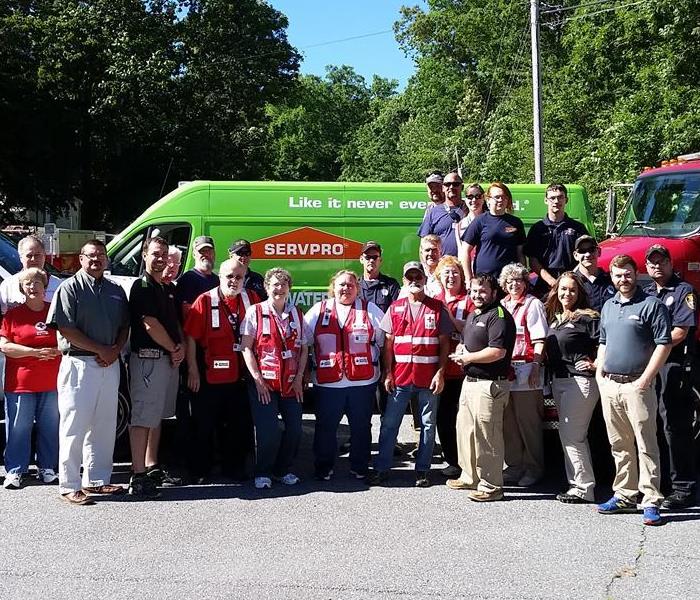
The Red Cross DAT team and the Towns County Fire Dept. finished up their third SMOKE ALARM CAMPAIGN in Towns County and welcomed their new community partner SERVPRO of Union, Towns, Fannin & Gilmer Counties. SERVPRO was a great addition to the team that provided much needed additional manpower, as well as, additional smoke alarms.
Red Cross is in its second year of working with Fire Chief Harold Copeland and his fire fighters on the Smoke Alarms Saves Lives Campaign. This campaign was a program started by the Red Cross nationwide 3 years ago in an effort to reduce injuries and deaths in house fires by 25% within 5 years. On Wednesday, June 8th, we installed 150 new 10year lithium battery smoke alarms in 51 homes in Towns County that couldn't afford them, didn't have working smoke alarms, or had old ones that needed replacing. We also proudly expanded this program to include Veterans in need of these alarms.
The Red Cross and Fire Dept. would like to especially thank Mr. Keith Wall, Owner, of SERVPRO of Union, Towns, Fannin & Gilmer Counties and his team who are now a permanent member of this campaign going forward for all their time and efforts supporting this life saving campaign and for the purchase of the additional alarms needed. We'd like to thank Home Depot of Blairsville for their discounts on those smoke alarms.
We'd also would like to thank additional businesses in Hiawassee that supported us in this campaign. They are Hiawassee Hardware who provided batteries to be used in some current existing alarms, as well as, Hardee's, McDonalds and Zaxby's for
providing food for all the volunteers who came out to work this event. And last but not least thank you to all the workers, SERVPRO employees, Fire Fighters and Red Cross volunteers, this couldn't have been accomplished without you.
Union, Towns, Fannin & Gilmer County Residents: Follow These Mold Safety Tips If You Suspect Mold
1/26/2018 (Permalink)
If you see visible mold, do not disturb it. You can inadvertently spread the mold infestation throughout your home. When mold is disturbed, the mold can release microscopic mold spores which become airborne and can circulate inside your home.
What to Do:
- Stay out of affected areas.
- Turn off the HVAC system and fans.
- Contact SERVPRO of Union, Towns, Fannin & Gilmer Counties for mold remediation services.
What Not to Do:
- Don’t touch or disturb the mold.
- Don’t blow air across any surfaces with visible or suspected mold growth.
- Don’t attempt to dry the area yourself.
- Don’t spray bleach or other disinfectants on the mold.
About Our Mold Remediation Services
SERVPRO of Union, Towns, Fannin & Gilmer Counties specializes in mold cleanup and restoration, in fact, it’s a cornerstone of our business. Our crews are highly trained restoration professionals that use specialized equipment and techniques to properly remediate your mold problem quickly and safely.
If You See Signs of Mold, Call Us Today –706-896-1880
Relay for Life 2016
8/18/2017 (Permalink)
SERVPRO of Union, Towns, Fannin and Gilmer Counties had so much fun last Friday at the Relay for Life event in Blue Ridge, GA! Thank you to everyone who came out to support the cause!
What Is Relay?
- Organized, overnight community fundraising walk
- Teams of people camp out around a track
- Members of each team take turns walking around the track
- Food, games and activities provide entertainment and build camaraderie
- Family-friendly environment for the entire community
Because it's a team event, individual participants are not required to be there the entire time. But it's so much fun, you'll find it hard to leave!
SERVPRO of Union, Towns, Fannin & Gilmer Counties specializes in the cleanup and restoration of residential and commercial property after a fire, smoke or water damage event. Our staff is highly trained in property damage restoration and we are an IICRC Certified Firm. We believe in continuous training: from initial and ongoing training at SERVPRO’s corporate training facility to regular IICRC-industry certification, rest assured our staff is equipped with the knowledge to restore your property.
Sneaky Leaks: Tips to avoid disaster
8/18/2017 (Permalink)
Did you know that the EPA reports that plumbing leaks account for more than One Trillion gallons of water waste, Nationwide. That’s TRILLION, with a T. One million gallons of water will fill a football field sized swimming pool nearly four feet deep.
The EPA also reports, the average household loses 10,000 gallons each year due to leaks. That’s enough to fill a backyard pool six feet deep.
So, what’s so leaky? Some leaks are super sneaky.
Here are five places you might be able to sneak up on your leaks!
1. HVAC drainage line: this isn’t a leak that uses excess water but it is a leak that can spill out of its containment pan, onto the floor and cause damage.
THE FIX: It’s usually just that the line is clogged with dust or debris. Generally simple to fix.
2. Ice maker lines: Your ice maker is a workhorse. Tirelessly, it pools water into the mold so you can have cold beverages. The waterline that supplies this process is generally tucked behind the refrigerator, out of sight. Older models are usually equipped with a clear plastic tube that can pinch, become brittle and crack open or just get pulled out of the fixture. Newer models have a stainless, flexible hose that is much more durable.
THE FIX: Check behind your fridge for any moisture or pooled water. A slow leak my never be seen depending on the type of flooring you have. Replacing this item is a YouTube video away.
3. Faucets: So, maybe faucets are less sneaky than attic or basement water lines … but little drips add up. It’s worth turning the controls a smidge tighter to see if you have a drip or just poor hand strength.
THE FIX: It’s usually just an O ring or a washer. The internal workings of the standard kitchen or bathroom faucet do not work for forever. Also, you might consider changing the supply tube lines with braided lines.
4. Outdoor faucets: The invention of frost proof fixtures have significantly cut down on problems with outdoor faucets wreaking havoc. However, one little caveat we see time after time, is the improper installation of these handy-dandy faucets. See, they are supposed to be installed at a slight angle as to encourage any remaining water to run out of the pipe. Because: without water, a pipe can’t really freeze and burst.
THE FIX: Unscrew the hose … run a little water on the ground, turn off the water … does the water continue to drip out of the faucet for a bit? If it’s dry as bone, there’s probably a good chance it’s not going to drain out. You are likely going to need a handy person or a plumber to fix this. **Remember, never leave hoses connected to faucets in the winter.
5. Dishwashers: Oh how we love or hate our dishwashers. Either they are saving us from the task of scrubbing never ending dishes, or they are doing a terrible job and we are still scrubbing dishes. Tucked back flush with our cabinets, we cannot see what is going on with the kitchen help.
THE FIX: Look closely at the adjoining cabinetry for signs of moisture. If you are seeing the leak, it could be the door gasket or something rather simple. If it’s older, the tubs can form holes.
THE FIX: Don’t over load your dishwasher and definitely use the proper soap. Other leaks, you may need help to resolve.
Other places to look for leaks: hot water heater, washing machine hoses (we recommend you change these every 5-7 years or switch to a braided line), under sinks, attic and basement pumping, access panels to plumbing otherwise walled off.
Remember at SERVPRO we can make sure any disaster you encounter is “Like it never even happened” but we also fully subscribe to the theory “an ounce of prevention is worth a pound of cure”.
Should you have a leak sneak up on you and cause more than mess than you can handle, SERVPRO of Union, Towns, Fannin & Gilmer Counties is just a phone call away.
www.SERVPROBlueRidge.com
(706) 896-1880
Where there's smoke, there is fire ... tips for fire prevention
8/18/2017 (Permalink)
In 2011, there were 1.3 million house fires in the United States.
1.3 million families temporarily displaced.
We attach our memories to things. We often scoff at materialism and we even poke fun at those who tend to accumulate lots of “things” … but the truth is, sometimes, things have meaning.
Your grandmother’s quilt, photos of your children, artwork, the shoes you wore on your first date with your husband, a movie ticket from a special day with a good friend … these are all seemingly meaningless things. Some of us are more sentimental than others.
Out of 1.3 million, it’s a safe bet that some important “things” were lost. We helped approximately 240 customers last year and though we restored a lot of belongings, some items were too far gone. Some of those things were not replaceable. Worse than things are people injured or killed. Nearly 25 thousand people each year are injured or killed by fire and that’s why prevention is so important. Here are some less common tips from Ready.gov, a website dedicated to disaster prevention.
Electrical
· Frayed wires can cause fires. Replace all worn, old or damaged appliance cords immediately and do not run cords under rugs or furniture.
· Buy electrical products evaluated by a nationally recognized laboratory, such as Underwriters Laboratories (UL).
· If an appliance has a three-prong plug, use it only in a three-slot outlet. Never force it to fit into a two-slot outlet or extension cord.
· Use electrical extension cords wisely; never overload extension cords or wall sockets.
· Immediately shut off, then professionally replace, light switches that are hot to the touch and lights that flicker.
Cooking
· Stay in the kitchen when you are frying, grilling, or broiling food. If you leave the kitchen for even a short period of time, turn off the stove.
· Wear short, close-fitting or tightly rolled sleeves when cooking.
· Do not cook if you are sleepy, have been drinking alcohol, or have taken medicine that makes you drowsy.
· Keep children away from cooking areas by enforcing a "kid-free zone" of 3 feet around the stove.
· Position barbecue grills at least 10 feet away from siding and deck railings, and out from under eaves and overhanging branches.
Fires can spread from nearly harmless to engulfing in less than 30 seconds. Reavy.gov reports many people do not realize how incredibly fast fire is. Fire is not bright and glowing as it would seem. Especially in a house it quickly produces thick black smoke making everything dark. Additionally, it’s smoke and toxic fumes from the various materials in a home that usually kills people. These hard facts should be enough to help you create a fire escape plan for your family.
As for those belongings, put precious mementos in fireproof safe or box. Have your photos scanned so you have digital copies of all family photos, old and new. Terry and Tonya, two of our team members who help inventory belongings and restore items have thoroughly enjoyed breathing new life into “Grandmother’s China” and even finding lost treasures in the process of moving furniture and cleaning up after a disaster.
Here at SERVPRO, we are used to working with insurance companies to help restore or rebuild homes. In the Blue Ridge area, one of the agents we are blessed to work with is Kevin Panter, who offers the following advice “Insureds need to take their annual review with their insurance agent seriously. It is often determined during a time of loss that the insured’s building limits and personal property contents limits are not adequate. Having proper documentation and adequate limits will help make the claim process much easier. Having cell phone videos and storing proper documentation off the premises will help greatly should a claim arise.” You can reach Kevin through his company www.KevinPanterInsurance.com .
“Our whole reason for existing as a business is to help our customers feel confident and comfortable as we restore their homes or businesses to preloss conditions. When disaster, small or large, strikes, you feel like you’ve lost control. We want to help you get it back. Our crews are often praised for their compassion. It is truly heartfelt,” explains Carnie Wall, co-owner.
Play that funky music, but get rid of that funky smell
8/18/2017 (Permalink)
Most of us have walked into a business or even a home that didn’t smell … well, good. Sometimes the odor is identifiable and superficial cleaning will fix it or maybe it can just be stemming from some unpleasant thing that’s out of sight and no longer alive thus creating a big ol “eeewww” in the olfactory department.
More often, weird odors are not clearly seen or understood. Like musty basements … what is “musty” any way? That’s just a weird word. Restaurants often start to have an odd and not altogether pleasant smell from fryer oils, grease traps, garbage and other unsightly and unappetizing things we really don’t love to talk about. Maybe you are now thinking back to when your very own nose was offended by such an odor and how you really wish you hadn’t picked that particular place to try a salmon burger.
At SERVPRO of Union, Towns, Fannin and Gilmer Counties (yeah, we know that is a crazy long name) we are challenged with helping businesses and homeowners get rid of funky things. We can suggest a new musical playlist that’s less 1970s too, but we don’t specialize and can’t promise your satisfaction in that!
One of the ways we help to get rid of “funk” is through Air Duct Cleaning. Sometimes, you can change the carpet, paint the walls, bleach the tile and there is STILL an odor. Often times, that odor is coming from your Heat Ventilation and Air Conditioning (HVAC) system. So, along with a smell, the air you are breathing isn’t so great either. Even the EPA suggests Air Duct and Ventilation system cleaning can be beneficial in situations where mold has been present or if any type of contaminant could have breached your system. Breaches happen in the case of older systems and just like your coffee table gets covered in dust, so does your duct work. We’ve talked about a lot of yucky things in this article and sadly, even the tidiest of Sally (or Sam) Homemakers can’t stop dust.
Inspecting the ventilation system is also a great way to reveal efficiency issues and potential hazards or problems. There could be lack of insulation along with a multitude of possible scenarios our technicians encounter when they go crawling around in attics and under floors. We have stories …
We pride ourselves on integrity, responsibility and commitment in our business. Our jobs often include doing our full level best to turn someone’s disaster into a happy ending, so in performing routine cleaning and inspections we are thrilled when we can be the ones to point out an issue and prevent disaster. That’s what we call a very good day.
To learn more about our Air Duct and HVAC Cleaning services visit www.SERVPROuniontownsfanningilmercounties.com
Don't take a chance on getting the Heebee Jeebees!
8/18/2017 (Permalink)
Household mold is fungi and is commonly referred to as mildew. You know the stuff, mostly ... you know the smell. Childhood visits to lakeside cabins, 1970s ranch home basements and even your grandma's house might bring back the memory of your mom saying "shew, it smells musty in here." Musty, is, in all actuality a word. Your mom didn't make it up. See, fungi used to be classified as plants, for years, until some scientist discovered that it acts more like an animal. So, fungi got their very own kingdom. Ah, a kingdom … "my kingdom for a horse" said Shakespeare. Seemingly simple (like the illustration from the Bard), fungi actually appears in many forms, the quickest to come to mind is usually, a mushroom. Additionally, fungi can appear as a plant parasite and damage crops. The type of fungi we are talking about today is the type which produces household, “mildewly” and musty ol mold. That culprit, though common, is actually a diverse group of organisms.
All fungi are made up of tiny filaments called hyphae. Isn't that interes … zzzzzz ….
The hard walls of fungus (mold) are built out of chitin, the same material that insects and arthropods have as a hard outer shell. Ok, so that's kinda cool. That totally makes the "like animals" part make more sense. Mold reproduces via microscopic particles called spores. It's largely understood that spores are irritants and can cause health effects. The fungi in the outdoors is part of the highly complex process of decomposition, you know … how fallen trees rot and stuff. Organisms such as ants will actually transport bits of fungus to their food supply (usually leaves or plants) to aid in the breakdown. Ants cannot digest cellulose. So, they use fungi kinda like we use meat tenderizer.
Mold lives by breaking down organic material and it spreads in a largely invisible web. The type of fungi that produces household mold and woodland mushrooms do differ, however; in the way that mushrooms emerge as visible evidence of fungi, so does dusty, fuzzy looking household mold.
The common denominator in the growth of all mold, is moisture. All this talk of fungi, mold, mildewy smells, invisible webs … it's creepy, huh? That's why, here at SERVPRO, we recommend you never try to take care of mold issues in your house by yourself. If you can see it, there is usually so much you can't see … we don't want you to even think about it.
We offer complete mold remediation services so you don't even have to! See, now that you understand how mold works … you'll also understand that a spray bottle of bleach and some rubber gloves are only going to worsen the bigger issue. If there is mold showing on the wall, the carpet … that invisible web we talked about ... is strewn far and wide. You can't be thinking about that! You'll get the heebee jeebees! No one wants the heebee jeebees! Not to mention, if you start trying to eradicate the visible stuff and you manage to get a little of the not so visible stuff, you'll stir up the spores! So, please if you see or suspect mold in your home, or Grandma's home … give us a call!
Grilling Safety
8/18/2017 (Permalink)
Summertime is grilling time. We all love to either cook on a grill or eat what has been cooked. Just thinking of all the mouthwatering goodies that can come off a grill makes me hungry. But, before eating, comes safety! When grilling weather finally gets here after a long, cold winter, a lot of us will go drag the grill out of the garage and fire it up. If we don’t take time to check things out and clean everything properly (which ideally was done before putting it away last year), we are asking for trouble.Safety tips and procedures are given to us for a reason- our personal safety and the safety of our surroundings. In 2014 alone, over 16,000 people ended up in emergency rooms because of injuries involving grills. A failure to properly clean the grill was the leading factor contributing to the fire and a close second was having the grill too close to a flammable object, such as the house or porch railing. It can seem like a waste of precious grilling time to clean everything before firing up the grill, especially if you have done so before storage for the winter. You must remember that dust and insects can get into places that could cause a problem while your grill is in storage.Here is a comprehensive list of sensible rules to follow so that your grilling season will be a safe and happy experience:
1.Read the owner’s manual.
I know, who reads those things. We all should so that we understand the proper way to use our equipment. Even if you have been grilling for years, when you buy a new grill, it is extremely important to read the manual. All grills are not the same.
2.Grills are for outside use ONLY.
Both charcoal and gas grills shouldneverbe used indoors, never inside a tent or garage or any other enclosed space. Grills produce carbon monoxide, which may accumulate and kill you.3.Use only in a well-ventilated area.Always set up your grill in an open area away from structures. Avoid dry leaves or brush and high traffic areas. No one wants little Bobby to come running around the corner and knock the grill over, that would spoil your whole day.
5.Follow electric codes.
If you use an electrical apparatus, such as a rotisserie, with your grill, make sure it is up to code and the cord is place so that it is not a trip hazard.
6.Use long handled utensils.
Barbecuing tools are made with extra-long handles for a reason, to avoid burns on your hands and arms. Use them.
7.Wear safe clothing.
It probably wouldn’t be a good idea to wear a fancy shirt or dress while barbecuing. Even if you are hosting a big party. Close fitting garments are best as they are less likely to come into contact with hot coals or gas burners. Those cumbersome oven mitts can be your best friends while grilling; scorched fingers from hot items are no fun.
8. Keep the fire under control.
Keeping a close watch on the temperature of your fire can lessen flare-ups. If you must douse a flare-up with a mist of water, remove the food first. A fire extinguisher, a bucket of sand or even a water hose should be close by in case of a problem. Use baking soda to put out a grease fire; using water in this instance will just spread the fire.
9. Never leave a hot grill unattended.
Just because the cooking is done and the fire is out doesn’t make a grill safe. It can stay hot enough to cause problems for up to an hour after being extinguished. Wait until it has cooled off before trying move it. And don't let people play aroung the grill while it is still hot.Grilling out is one of the best things about summer time. Hot dogs, hamburgers, even chicken all seem to taste better when cooked on the grill. This year you may want to try your hand at more exotic dishes such as Ginger-soy glazed Mahi-Mahi or Grilled Shrimp in a Banana-leaf Pouch. Whatever you decide to cook on your grill this summer, be sure to follow the safety rules so that you and your loved ones will have a fabulous summer with no trips to the emergency room.
For more tips and tricks to help you prevent leaks, fires and more ... sign up for occassional email newsletters OR please visit theSERVPRO of Union, Towns, Fannin & Gilmer Countieswebsite!
Home & Garden Show 2017
8/9/2017 (Permalink)
 Julie Seabolt (Marketing SMR) at the Home & Garden Show
Julie Seabolt (Marketing SMR) at the Home & Garden Show
SERVPRO of Union, Towns, Fannin & Gilmer Counties had so much fun at the Home & Garden Show in Hiawassee hosted at the Towns County Recreational Facitlity! We were able to meet customers and give them information they never knew regarding what was lurking in their HVAC duct systems and information regarding mold due to flooding among so much more! Thank you to everyone who came out to see us! If you didn't get a chance to come out or have questions for us, feel free to contact SERVPRO of Union, Towns, Fannin & Gilmer Counties and our office will be happy to answer any questions you may have any kinds of issues you are experiencing. SERVPRO of Union, Towns, Fannin and Gilmer Counties is always here to help!
Understanding The Fire Restoration Process
8/9/2017 (Permalink)
It is imperative that IICRC-approved fire restoration should be implemented as soon as possible after a house fire is out. The longer the delay in contacting a restoration company, the more opportunity there is for damage from water and smoke to intensify. A homeowner’s insurance company should be able to refer an approved and experienced restoration firm. It is surprising just how well restoration works in light of how destructive a fire can be. Depending on the damage, a home can often be restored to its before-fire state. A restoration team has a difficult task to perform, and a great deal of responsibility, but IICRC-approved technicians are well-equipped to return a home to its original condition.
The fire restoration process involves the repair of any structures damaged by smoke, fire, or water. Carpets undergo a chemical process to remove smoke odor. Sub-floor materials undergo inspection for damage and may need to be replaced. Upholstery and curtains are subject to a similar process. Furnishings are taken to a separate location and restored to pre-fire condition. The home is aired out for as long as needed to diminish the effects of odor and mildew, and deodorization efforts continue throughout the process. Through the cooperation of the insurance company, the restoration team, and the homeowner, a home can be restored and made safe to live in once again.
www.IICRC.org
Christine Harriott : Office Manager
8/7/2017 (Permalink)
 Christine Harriott : Office Manager
Christine Harriott : Office Manager
Meet Christine Harriott, the Office Manger of SERVPRO of Union, Towns, Fannin & Gilmer Counties!
Christine wears many, many hats for SERVPRO. She manages all of the functions that happen in the office as well as acts as marketing's side kick. She has also suited up and helped out production to assist our customers to get their homes back to normal again.
Her background is in management, marketing and graphic design. She grew up on a farm in a small town in Iowa. She was in the Iowa Army National Guard and studied Music Education at a private university in Storm Lake, IA. She has a very wide variety of talents and interests.
Christine is the mother of a very intelligent and loving autisic son, Braxton, who is her entire world. In her free time she enjoys motivating others to set goals because her goal in life is to "Make A Difference". She says nothing is impossible as long as you tell yourself you can do it. Her and her son are also huge supporters of the Armed Services...past, present and future.
SERVPRO of Union, Towns, Fannin & Gilmer Counties specializes in the cleanup and restoration of residential and commercial property after a fire, smoke or water damage event. Our staff is highly trained in property damage restoration. From initial and ongoing training at SERVPRO’s corporate training facility to regular IICRC-industry certification, rest assured our staff is equipped with the knowledge to restore your property. If we can assist you with any restoration needs, do not hesitate to contact our office.
Caleb Weaver: Production Manager
8/4/2017 (Permalink)

SERVPRO® of Union, Towns, Fannin & Gilmer Counties, a premier cleanup and restoration company, congratulates Caleb Weaver, as the new Production Manager. He will be responsible for managing production crews and jobs from start to finish.
Weaver joined the SERVPRO production team in 2009 as a Technician. He progressed to Crew Chief, Senior Crew Chief, and Assistant Production Manager before this promotion. He has earned the Water Damage Restoration and Applied Structural Drying certifications from the Institute of Inspection Cleaning & Restoration . He is a certified lead paint renovator and has also completed forklift training.
“Our most important priority is to provide the very best support and service to our customers,” said Keith Wall, owner of SERVPRO® of Union, Towns, Fannin & Gilmer Counties. “The experience, knowledge and skills that Caleb Weaver brings to our franchise management team will help us better serve our community and continue to ensure our customers' satisfaction.”
“I’m very excited to join the management team at SERVPRO® of Union, Towns, Fannin & Gilmer Counties,” said Weaver. “It’s a unique opportunity to continue to grow as a professional while helping people in a time of need.”
SERVPRO® of Union, Towns, Fannin & Gilmer Counties provides cleanup and restoration services following a fire, water or even mold-related damage. Additional services offered include: cleaning and restoration of special items, such as HVAC duct systems; building exteriors; electronic equipment, including computers and documents that have sustained water damage.
For more information on SERVPRO® of Union, Towns, Fannin & Gilmer Counties , please contact Keith Wall at 706-896-1880.
Faster to your Union, Towns, Fannin & Gilmer County Water Damage Ever
8/4/2017 (Permalink)
Flooding and water emergencies don’t wait for regular business hours and neither do we. SERVPRO of Santa Barbara provides emergency cleaning and restoration services 24 hours a day, 7 days a week—including all holidays.
Faster To Any Size Disaster
Flooding and water damage is very invasive. Water quickly spreads throughout your home and gets absorbed into floors, walls, furniture, and more. SERVPRO of Union, Towns, Fannin & Gilmer Counties arrives quickly and starts the water extraction process almost immediately. This immediate response helps to minimize the damage and the cleaning and restoration costs.
Need Emergency Service? Call Us 24/7 –706-896-1880
Water Damage Timeline
Within Minutes
- Water quickly spreads throughout your property, saturating everything in its path.
- Water is absorbed into walls, floors, upholstery, and belongings.
- Furniture finishes may bleed, causing permanent staining on carpets.
- Photographs, books, and other paper goods start to swell and warp.
Hours 1 - 24:
- Drywall begins to swell and break down.
- Metal surfaces begin to tarnish.
- Furniture begins to swell and crack.
- Dyes and inks from cloth and paper goods spread and stain.
- A musty odor appears.
48 Hours to 1 Week:
- Mold and mildew may grow and spread.
- Doors, windows, and studs swell and warp.
- Metal begins to rust and corrode.
- Furniture warps and shows signs of mold.
- Paint begins to blister.
- Wood flooring swells and warps.
- Serious biohazard contamination is possible.
More Than 1 Week:
- Restoration time and cost increase dramatically; replacing contaminated materials and structural rebuilding may be extensive.
- Structural safety, mold growth, and biohazard contaminants pose serious risks to occupants.
About SERVPRO of Union, Towns, Fannin & Gilmer Counties
SERVPRO of Union, Towns, Fannin & Gilmer Counties specializes in the cleanup and restoration of residential and commercial property after a fire, smoke or water damage event. Our staff is highly trained in property damage restoration. From initial and ongoing training at SERVPRO’s corporate training facility to regular IICRC-industry certification, rest assured our staff is equipped with the knowledge to restore your property.
Union, Towns, Fannin & Gilmer Residents: We Specialize in Flooded Basement Cleanup and Restoration!
8/4/2017 (Permalink)
A basement can flood at any time, although flooding most often occurs during heavy rainfall. Basements are inherently prone to flooding because they are the lowest level of a building and are normally built partly or entirely below ground level. There are a number of reasons why your basement could flood, including:
- A blocked or failed sewer lateral pipe
- Heavy rain causes surface water to pool around your home
- Storm sewer backup
- Sanitary sewer backup
- Foundation drainage failure
- Water supply-line break or hot-water tank failure
- And many more
Have Questions about Basement Flooding?
Call Today - 706-896-1880
If flood water is not handled quickly and properly, it can jeopardize your health and safety, and cause severe damage to your home’s structure. Remember, the longer you wait, the worse the problem will get.
The bottom line: a flooded basement can jeopardize your health, safety, and your home’s integrity. It’s worth making a call to SERVPRO of Union, Towns, Fannin & Gilmer Counties and let our trained, professional crews handle the situation safely and correctly. We have earned the trust of hundreds of homeowners, business owners, and property professionals.
We are Flooded Basement Specialists:
- We are Available 24 hours/7 days per week
- We’re a Preferred Vendor to many National Insurance Companies
- We Bill The Insurance Directly – One Less Thing For You To Worry About
- Our Technicians are Highly-Trained in Water Restoration Techniques
- We use s500 IICRC Restoration Standards
- Advanced Inspection and Extraction Equipment
Basement Flooded? Call Us Today – We’re Ready To Help 706-896-1880
Our Highly Trained Restoration Specialists can restore your Home
8/4/2017 (Permalink)
SERVPRO of Union, Towns, Fannin & Gilmer Counties is an IICRC firm. The Institute of Inspection, Cleaning and Restoration Certification (IICRC) creates the standards for the restoration industry and provides training and certification to restoration companies. IICRC Certified Firms have the right to display the IICRC Certified Logo.
IICRC Certified Firms must
• Present accurate information to consumers and conduct business with honesty and integrity.
• Require a technician on all jobs who has been formally trained and passed all required tests.
• Require a continuing education program to keep technicians up-to-date on the latest changes in the industry.
• Maintain liability insurance to protect all parties in the event of an accident.
• Maintain a written complaint policy and agree to Better Business Bureau or similar arbitration to resolve disputes, and accept the conclusions and recommendations of arbitration.
The IICRC Develops The Standards For The Restoration Industry
The IICRC has been the driving force in establishing the main industry standards and reference guides for professional carpet cleaning, water damage restoration and mold remediation. These IICRC standards take years to develop and require the coordination of experts in the field: manufacturers, industry organizations, insurance professionals, training schools, contractors, and public health professionals.
Every five years, the standards are reviewed and updated. The water damage restoration field changes rapidly with advancements in technology and science, and therefore the standards must evolve to keep pace.
About SERVPRO of Union, Towns, Fannin & Gilmer Counties
SERVPRO of Union, Towns, Fannin & Gilmer Counties specializes in the cleanup and restoration of residential and commercial property after a fire, smoke or water damage event. Our staff is highly trained in property damage restoration and we are an IICRC Certified Firm. We believe in continuous training: from initial and ongoing training at SERVPRO’s corporate training facility to regular IICRC-industry certification, rest assured our staff is equipped with the knowledge to restore your property.
http://www.SERVPROuniontownsfanningilmercounties.com/crew-photos
For Immediate Service in Union, Towns, Fannin & Gilmer Counties, Call SERVPRO
8/4/2017 (Permalink)
SERVPRO of Union, Towns, Fannin & Gilmer Counties provides 24-hour emergency service and is dedicated to being faster to any-sized disaster inUnion, Towns, Fannin & Gilmer Counties. We can respond immediately to your emergency and have the expertise to handle your restoration or cleaning needs.
- 24-Hour Emergency Service
- Faster to Any-Sized Disaster
- Highly Trained Restoration Technicians
- A Trusted Leader in the Restoration Industry
- Locally Owned and Operated
- Advanced Restoration and Cleaning Equipment
Have Questions? Call Us 24/7 –706-896-1880
Residential Services
Whether your home needs emergency flood damage or your upholstery cleaned, you can depend on us. Our technicians have extensive cleaning and restoration training and can make your property look its best. Learn more about our residential services:
- Water Damage Restoration
- Fire Damage Restoration
- Mold Remediation
- Storm Damage Restoration
- Cleaning Services
- Building/Reconstruction Services
Commercial Services
There's never a convenient time for fire or Water damage to strike your commercial property. Every hour spent cleaning up is an hour of lost revenue and productivity. So when the need arises for professional cleaning or emergency restoration services we have the training and expertise to respond promptly with highly trained technicians to get your property back to business. Learn more about our commercial services: http://www.SERVPROuniontownsfanningilmercounties.com/commercial-restoration-cleaning
- Commercial Water Damage Restoration
- Commercial Fire Damage Restoration
Smoke and Soot Cleanup
8/4/2017 (Permalink)
Smoke and soot is very invasive and can penetrate various cavities within your home, causing hidden damage and odor. Our smoke damage expertise and experience allows us to inspect and accurately assess the extent of the damage to develop a comprehensive plan of action.
Smoke and soot facts:
- Hot smoke migrates to cooler areas and upper levels of a structure.
- Smoke flows around plumbing systems, seeping through the holes used by pipes to go from floor to floor.
- The type of smoke may greatly affect the restoration process.
Different Types of Smoke
There are two different types of smoke–wet and dry. As a result, there are different types of soot residue after a fire. Before restoration begins, SERVPRO of Union, Towns, Fannin & Gilmer Counties will test the soot to determine which type of smoke damage occurred. The cleaning procedures will then be based on the information identified during pretesting. Here is some additional information:
Wet Smoke – Plastic and Rubber
- Low heat, smoldering, pungent odor, sticky, smeary. Smoke webs are more difficult to clean.
Dry Smoke – Paper and Wood
- Fast burning, high temperatures, heat rises therefore smoke rises.
Protein Fire Residue – Produced by evaporation of material rather than from a fire
- Virtually invisible, discolors paints and varnishes, extreme pungent odor.
Our Fire Damage Restoration Services
Since each smoke and fire damage situation is a little different, each one requires a unique solution tailored for the specific conditions. We have the equipment, expertise, and experience to restore your fire and smoke damage. We will also treat your family with empathy and respect and your property with care.
Have Questions about Fire, Smoke, or Soot Damage?
Call Us Today – 706-896-1880
SERVPRO Christmas
7/31/2017 (Permalink)
The ladies of SERVPRO of Union, Towns, Fannin & Gilmer Counties had a great time at the Christmas Party! If you have questions for us, feel free to contact SERVPRO of Union, Towns, Fannin & Gilmer Counties and our office or production staff will be happy to answer any questions you may have any kinds of issues you are experiencing. SERVPRO of Union, Towns, Fannin and Gilmer Counties is always here to help!
About SERVPRO of Union, Towns, Fannin & Gilmer Counties
SERVPRO of Union, Towns, Fannin & Gilmer Counties specializes in the cleanup and restoration of residential and commercial property after a fire, smoke or water damage event. Our staff is highly trained in property damage restoration. From initial and ongoing training at SERVPRO’s corporate training facility to regular IICRC-industry certification, rest assured our staff is equipped with the knowledge to restore your property.
http://www.SERVPROuniontownsfanningilmercounties.com/crew-photos
Towns County Sheriff's Office Empty Stocking Fund
7/31/2017 (Permalink)
SERVPRO of Union, Towns, Fannin and Gilmer Counties is so excited to help Sheriff Chris Clinton and the Towns County Sheriff's Office with their Empty Stocking Fund! We were able to provide toys to more than 61 children!
The Empty Stocking Fund empowers parents and guardians of children living in poverty by providing them with an opportunity to give their children gifts at Christmas time.
About SERVPRO of Union, Towns, Fannin & Gilmer Counties
SERVPRO of Union, Towns, Fannin and Gilmer Counties specializes in the cleanup and restoration of residential and commercial property after a fire, smoke or water damage event. Our staff is highly trained in property damage restoration. From initial and ongoing training at SERVPRO’s corporate training facility to regular IICRC-industry certification, rest assured our staff is equipped with the knowledge to restore your property.
http://www.SERVPROuniontownsfanningilmercounties.com/crew-photos
Apple Blossom Festival
7/31/2017 (Permalink)
SERVPRO of Union, Towns, Fannin and Gilmer Counties participated in the 2016 Apple Blossom Festival in Ellijay, GA this May. We were able to meet customers from all over and give them information they never knew regarding what was lurking in their HVAC duct systems and information regarding mold due to flooding among so much more! Thank you to everyone who came out to see us! If you didn't get a chance to come out or have questions for us, feel free to contact SERVPRO of Union, Towns, Fannin & Gilmer Counties and our office or production staff will be happy to answer any questions you may have any kinds of issues you are experiencing. SERVPRO of Union, Towns, Fannin and Gilmer Counties is always here to help!
About SERVPRO of Union, Towns, Fannin & Gilmer Counties
SERVPRO of Union, Towns, Fannin & Gilmer Counties specializes in the cleanup and restoration of residential and commercial property after a fire, smoke or water damage event. Our staff is highly trained in property damage restoration. From initial and ongoing training at SERVPRO’s corporate training facility to regular IICRC-industry certification, rest assured our staff is equipped with the knowledge to restore your property.
http://www.SERVPROuniontownsfanningilmercounties.com/crew-photos
Home & Garden Show 2016
7/31/2017 (Permalink)
SERVPRO of Union, Towns, Fannin & Gilmer Counties had so much fun at the Home & Garden Show in Hiawassee hosted at the Events Center at Fieldstone! We were able to meet customers and give them information they never knew regarding what was lurking in their HVAC duct systems and information regarding mold due to flooding among so much more! Thank you to everyone who came out to see us! If you didn't get a chance to come out or have questions for us, feel free to contact SERVPRO of Union, Towns, Fannin & Gilmer Counties and our office will be happy to answer any questions you may have any kinds of issues you are experiencing. SERVPRO of Union, Towns, Fannin and Gilmer Counties is always here to help!
Home & Garden Show 2016
7/31/2017 (Permalink)
SERVPRO of Union, Towns, Fannin & Gilmer Counties had so much fun at the Home & Garden Show in Hiawassee hosted at the Events Center at Fieldstone! We were able to meet customers and give them information they never knew regarding what was lurking in their HVAC duct systems and information regarding mold due to flooding among so much more! Thank you to everyone who came out to see us! If you didn't get a chance to come out or have questions for us, feel free to contact SERVPRO of Union, Towns, Fannin & Gilmer Counties and our office will be happy to answer any questions you may have any kinds of issues you are experiencing. SERVPRO of Union, Towns, Fannin and Gilmer Counties is always here to help!
Smoke Alarm Campaign
7/31/2017 (Permalink)

The Red Cross DAT team and the Towns County Fire Dept. finished up their third SMOKE ALARM CAMPAIGN in Towns County and welcomed their new community partner SERVPRO of Union, Towns, Fannin & Gilmer Counties. SERVPRO was a great addition to the team that provided much needed additional manpower, as well as, additional smoke alarms.
Red Cross is in its second year of working with Fire Chief Harold Copeland and his fire fighters on the Smoke Alarms Saves Lives Campaign. This campaign was a program started by the Red Cross nationwide 3 years ago in an effort to reduce injuries and deaths in house fires by 25% within 5 years. On Wednesday, June 8th, we installed 150 new 10year lithium battery smoke alarms in 51 homes in Towns County that couldn't afford them, didn't have working smoke alarms, or had old ones that needed replacing. We also proudly expanded this program to include Veterans in need of these alarms.
The Red Cross and Fire Dept. would like to especially thank Mr. Keith Wall, Owner, of SERVPRO of Union, Towns, Fannin & Gilmer Counties and his team who are now a permanent member of this campaign going forward for all their time and efforts supporting this life saving campaign and for the purchase of the additional alarms needed. We'd like to thank Home Depot of Blairsville for their discounts on those smoke alarms.
We'd also would like to thank additional businesses in Hiawassee that supported us in this campaign. They are Hiawassee Hardware who provided batteries to be used in some current existing alarms, as well as, Hardee's, McDonalds and Zaxby's for
providing food for all the volunteers who came out to work this event. And last but not least thank you to all the workers, SERVPRO employees, Fire Fighters and Red Cross volunteers, this couldn't have been accomplished without you.
Union, Towns, Fannin & Gilmer Counties 24 Hour Emergency Water Damage Service
7/31/2017 (Permalink)
SERVPRO of Union, Towns, Fannin & Gilmer Counties is available 24 hours a day for water emergencies, large or small. When you are dealing with water damage, immediate action is crucial. A delay of just a few hours can greatly increase the severity of the water damage.
We Answer the Phone Ready to Help
Call Today - (706) 896-1880
We understand that when you call us, you may be feeling confused, stressed, and vulnerable. You need an expert to guide you through this crisis. SERVPRO of Union, Towns, Fannin & Gilmer Counties has the specific water damage training and experience to help you through this tough time. We specialize in water damage restoration—in fact, it's the cornerstone of our business.
What to Expect
When you call, we will ask several questions regarding your water damage emergency. These questions will help us determine what equipment and resources to bring, including how many trained SERVPRO Professionals may be needed.
Our SERVPRO Representative will ask several questions:
- Your name and contact information
- Your insurance information (if applicable)
- The street address of the water-damaged home or business
- When did the flooding or water damage occur?
- What caused the water damage (if known)?
- Is there electricity available (on-site)?
About SERVPRO of Union, Towns, Fannin & Gilmer Counties
SERVPRO of Union, Towns, Fannin & Gilmer Counties specializes in the cleanup and restoration of residential and commercial property after a fire, smoke or water damage event. Our staff is highly trained in property damage restoration. From initial and ongoing training at SERVPRO’s corporate training facility to regular IICRC-industry certification, rest assured our staff is equipped with the knowledge to restore your property.
http://www.SERVPROuniontownsfanningilmercounties.com/crew-photos
Does Your Home Have A Mold Problem?
7/31/2017 (Permalink)
Microscopic mold spores naturally occur almost everywhere, both outdoors and indoors. This makes it impossible to remove all mold from a home or business. Therefore, mold remediation reduces the mold spore count back to its natural or baseline level. Some restoration businesses advertise “mold removal” and even guarantee to remove all mold, which is a fallacy. Consider the following mold facts:
- Mold is present almost everywhere, indoors and outdoors.
- Mold spores are microscopic and float along in the air and may enter your home through windows, doors, or AC/heating systems or even hitch a ride indoors on your clothing or a pet.
- Mold spores thrive on moisture. Mold spores can quickly grow into colonies when exposed to water. These colonies may produce allergens and irritants.
- Before mold remediation can begin, any sources of water or moisture must be addressed. Otherwise, the mold may return.
- Mold often produces a strong, musty odor and can lead you to possible mold problem areas.
- Even higher-than-normal indoor humidity can support mold growth. Keep indoor humidity below 45 percent.
If your home or business has a mold problem, we can inspect and assess your property and use our specialized training, equipment, and expertise to remediate your mold infestation.
If You See Signs of Mold, Call Us Today –706-896-1880
Union, Towns, Fannin & Gilmer County Residents: Follow These Mold Safety Tips If You Suspect Mold
7/31/2017 (Permalink)
If you see visible mold, do not disturb it. You can inadvertently spread the mold infestation throughout your home. When mold is disturbed, the mold can release microscopic mold spores which become airborne and can circulate inside your home.
What to Do:
- Stay out of affected areas.
- Turn off the HVAC system and fans.
- Contact SERVPRO of Union, Towns, Fannin & Gilmer Counties for mold remediation services.
What Not to Do:
- Don’t touch or disturb the mold.
- Don’t blow air across any surfaces with visible or suspected mold growth.
- Don’t attempt to dry the area yourself.
- Don’t spray bleach or other disinfectants on the mold.
About Our Mold Remediation Services
SERVPRO of Union, Towns, Fannin & Gilmer Counties specializes in mold cleanup and restoration, in fact, it’s a cornerstone of our business. Our crews are highly trained restoration professionals that use specialized equipment and techniques to properly remediate your mold problem quickly and safely.
If You See Signs of Mold, Call Us Today –706-896-1880
When Storms or Floods hit, SERVPRO is ready!
7/31/2017 (Permalink)
SERVPRO of Union, Towns, Fannin & Gilmer Counties specializes in storm and flood damage restoration. Our crews are highly trained and we use specialized equipment to restore your property to its pre-storm condition.
Faster Response
Since we are locally owned and operated, we are able to respond quicker with the right resources, which is extremely important. A fast response lessens the damage, limits further damage, and reduces the restoration cost.
Resources to Handle Floods and Storms
When storms hit, we can scale our resources to handle a large storm or flooding disaster. We can access equipment and personnel from a network of 1,650 Franchises across the country and elite Disaster Recovery Teams http://www.SERVPROuniontownsfanningilmercounties.com/storm-flooding-restoration that are strategically located throughout the United States.
Have Storm or Flood Damage? Call Us Today 706-896-1880
As a trusted leader in the restoration industry, SERVPRO of Union, Towns, Fannin & Gilmer Counties provides 24-hour residential and commercial services. As a locally owned and operated business, we’re dedicated to being faster to any size disaster, with the training, equipment, and expertise to handle your restoration and cleaning needs.
Restoring Your Commercial Property After A Water Damage
7/31/2017 (Permalink)
Flooding and water damage events at commercial properties are often complex with numerous issues that require a knowledgeable and flexible response. Whether we’re dealing with a relatively small water cleanup scenario or a large scale event, we work quickly to assess each unique situation and isolate the damaged area. In many instances, normal operations can continue in a temporary space while we restore your facility.
Restoring Commercial Properties Presents Unique Challenges
Our professionals are trained to be mindful of legal and environmental concerns and strive to fully restore the damaged area while working within your budgetary constraints. We understand that every hour spent cleaning up is an hour of lost revenue and productivity. So when an emergency situation arises in your business, give us a call and we’ll be there fast with the help you need.
About SERVPRO of Union, Towns, Fannin & Gilmer Counties
SERVPRO of Union, Towns, Fannin & Gilmer Counties specializes in the cleanup and restoration of commercial and residential property after a water damage event. Our staff is highly trained in property damage restoration. From initial and ongoing training at SERVPRO’s corporate training facility to regular IICRC-industry certification, rest assured our staff is equipped with the knowledge to restore your property.
http://www.SERVPROuniontownsfanningilmercounties.com/crew-photos
Fireworks Safety
7/31/2017 (Permalink)
Almost everyone loves fireworks! The Fourth of July is just around the corner and we will be looking forward to watching the beautiful fireworks displays. Some of us will go to local displays and some of us will watch the magnificent displays around the country on television. Did you know that the largest fireworks display in the world happened at the New Year countdown on January 1, 2016? It was in the Philippine Arena, Ciudad de Victoria Bocaue Bulacan, Manila, Philippines, consisting of 810,904 fireworks, lasting for 1 hour 1 minute 32.35 seconds in the pouring rain. Amazing, isn’t it?The Chinese stumbled upon a kind of natural firecracker as early as 200 B.C. They would roast bamboo, which would explode with a bang due to the hollow air pockets inside. They believed that the noise would ward off evil spirits. At some point between 600 and 900 A.D., Chinese alchemists mixed together saltpeter (a common kitchen seasoning) charcoal, sulfur and a few other ingredients, unwittingly yielding the first crude form of gunpowder. It is speculated that they were possibly trying to make an elixir for immortality. When the Chinese began stuffing this volatile substance into bamboo shoots and throwing them into a fire, the first fireworks were born. By the time of the Renaissance, pyrotechnic schools were training fireworks artists across Europe. In the 1830s, the Italians began to incorporate very small amounts of metals and other additives to their fireworks, thus creating the bright, multicolored sparks and sunbursts seen in contemporary fireworks shows. Until then, fireworks were just loud noises, orange flashes and faint golden traces of light. Legend has it that Captain John Smith set off the first fireworks display in America in 1608. Some of the colonists may have gotten a little carried away and a spate of firecracker-related pranks became a public nuisance, prompting officials in Rhode Island to ban the “mischievous use of pyrotechnics” in 1731. Today, most states regulate how and where fireworks may be used, as well as the types of explosives would be available for consumers to purchase. In 2009, nearly 9,000 Americans were hurt by fireworks with a disproportionate number of the injuries occurring in July. This is why fireworks safety is so important. The Fireworks Safety Code • Only buy fireworks marked BS 7114• Don’t drink alcohol if setting off fireworks• Keep fireworks in a closed box• Follow the instructions on each firework• Light them at arm’s length, using a taper• Stand well back• Never go near a firework that has been lit. Even if• It hasn’t gone off, it could still explode• Never put fireworks in your pocket or throw them• Always supervise children around fireworks• Light sparklers one at a time and wear gloves• Never give sparklers to children under 5• Keep pets indoors• Don’t set off noisy fireworks late at night and never past 11pm
Ready for Whatever Happens!
7/28/2017 (Permalink)
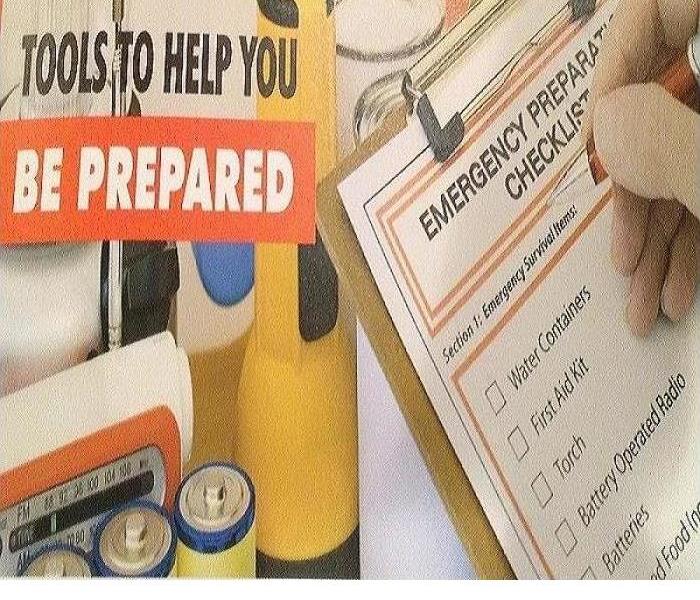 SERVPRO of Union, Towns, Fannin & Gilmer Counties is always "Ready for whatever happens!"
SERVPRO of Union, Towns, Fannin & Gilmer Counties is always "Ready for whatever happens!"
As severe weather approaches, you and your family are reminded to check our emergency supply kits, we are also reminded of the SERVPRO slogan "Ready for whatever happens". The U.S. Department of Homeland Security recommends having at least one full emergency supply kit for your home and smaller portable kits for your office and vehicles.
A basic emergency supply kit should contain at least the following:
- Water (one gallon per person per day)
- Food (non-perishable 3-day supply)
- Manual can opener
- Battery operated radio, preferably a NOAA weather radio
- Flashlight and extra batteries
- First aid kit
- Whistle to signal for help
- Clothing
- Dust masks or bandanas
- Plastic sheeting, garbage bags and duct tape
- Wrench or pliers to turn off utilities
- Hygiene items
- Important documents; copies of insurance policies, ID and bank account information
- Cash
- Fire extinguisher
- Matches in a waterproof container
Remember, this is only a basic kit. Your circumstances may require additional items. Check out the U.S. Department of Homeland Security website on readiness at www.ready.gov for more information. You can also contact SERVPRO of Union, Towns, Fannin & Gilmer Counties to learn more and be "Ready for whatever happens!"
How To Choose Water Damage Restoration Services
7/28/2017 (Permalink)
When a storm leaves a home flooded, or a burst pipe causes serious issues in the house, getting water damage restoration services from a respected company should be considered a top priority. Unfortunately, this industry is not regulated, and there are people out there who pose as professionals or overstate their qualifications. Therefore, homeowners should be mindful of who they hire, as an untrained technician may do more harm than good or delay repairs, resulting in a higher degree of destruction. Before selecting a company to handle the job, keep in mind these points of emphasis:
· Only choose certified professionals to perform water damage restoration services. Even though the industry is not regulated, technicians who have received certification have made the effort to get the best training possible, proving that they take their job seriously. Certification through the Institute of Inspection, Cleaning and Restoration Certification (IICRC) is a sign that a professional has received the most up to date training and is knowledgeable in the latest techniques and technologies employed during repairs. The IICRC operates a Certified Firm registrant-only database on its site, making it easy to find a local, certified professional without trouble.
· Do not select a technician based only on the price or an insurance company’s recommendation. When possible, speak to neighbors or friends who have had to hire a technician recently and try to get a recommendation from them. Insurance companies often select a restoration company based on price, and unusually low pricing suggests the company does not use modern drying or repair methods.
· Choose a company that offers a range of water damage restoration services. The easiest way to determine the expertise of a firm is to see if they provide a full range of options for homeowners. Mold remediation, for example, is often needed given how quickly mold can set in. This is a standard field of knowledge that advanced technicians should possess. If a company doesn’t offer mold remediation, it may not be prepared for all job settings.
· A company that is available 24/7 is a good sign. Stay away from any firms that are reluctant to start right away. In many cases modern equipment can enable near-complete drying in as little as 36 hours, although many situations require longer. Also, a homeowner should not have to wait before repairs begin. Every minute counts when there is standing water present, and reputable professionals understand this. If a technician insists on waiting to begin the remediation portion of the loss, they probably cannot be trusted to see the job through in a reasonable timeframe.
Using these guidelines, a homeowner should be able to find a technician that can be trusted and is equipped to do the job the right way. A storm or other disaster is hard enough to deal with, and a remediation firm should do everything in its power to make this difficult process easier.
http://www.IICRC.org/
Damage from Water Should be Cleaned by Certified Professionals
7/28/2017 (Permalink)
The amount of damage water can cause is amazing, and often underestimated by homeowners. Excess moisture is bad enough, but when a home is flooded or hit with a plumbing disaster (like a burst pipe), the situation can quickly get out of hand. There’s a reason why these incidents are among the most expensive problems a homeowner can face. Contaminated water not only creates immediate structural problems, it can leave serious biological threats behind after it has been removed.
Floods, sewage backflows, and other sources of contaminated fluid usually cause the worst damage. Dirty water is filled with all kinds of harmful substances, ranging from chemical residues to animal feces to parasites. Bacteria, viruses and fungi grow explosively in contaminated fluid, and severe health risks, like salmonella and hepatitis, are common in flood waters.
This problem is compounded by the composition of most homes, which are filled with organic materials. Drywall, wood and the matter that is trapped in carpet fibers are just a few examples, and they can give pathogens room to grow. Within 48 hours, mold may begin creeping behind the walls and releasing spores, and any organic materials that have been soaked through by contaminated fluid will usually have to be destroyed.
That’s why restoration firms, in addition to surveying the home for structural problems, will dry the home quickly and apply antibacterial, antiviral, and antifungal agents to all surfaces that had contact with the water. This ensures the family can return to a safe home, and not one harboring a collection of harmful pathogens.
www.IICRC.org
Choosing the Proper Fire Extinguisher
7/28/2017 (Permalink)
A fire extinguisher can be a life-saving tool when used correctly. The U.S. Fire Administration (USFA) recommends individuals are properly trained in order to use and maintain an extinguisher.
USFA says an extinguisher should only be used if:
- You have alerted other occupants and someone has called the fire department.
- The fire is small and contained to a single object, such as a wastebasket.
- You are safe from the toxic smoke produced by the fire.
- You have a means of escape identified and the fire is not between you and the fire escape route.
- Your instincts tell you that it is safe to use an extinguisher.
Classes of Fire Extinguishers:
Class A: Use on ordinary combustible materials, such as cloth, wood, rubber, paper, and many plastics.
Class B: Use on flammable liquids, such as grease, gasoline and oil.
Class C: Use on appliances, tools, or other equipment that is electrically energized or plugged in.
Class D: Use on flammable metals and are often specific for the type of metal in question. These are typically found only in factories working with these metals.
Class K: Use on vegetable oils, animal oils, or fats in cooking appliances. These are generally found in commercial kitchens, but are suitable for the residential market.
Check out the Fire Equipment Manufacturers Association for more information about fire extinguisher use, type and care.
Summer Safety Tips!
7/28/2017 (Permalink)
Summer is synonymous with barbecues, parades and fireworks displays; but along with all the festivities are plenty of visits to emergency rooms-especially during July.
In 2013, eight people died and about 11,400 were injured badly enough to require medical treatment after fireworks-related incidents, according to the U.S. Consumer Product Safety Commission. In addition to causing injury, fireworks are also responsible for thousands of house fires each year with millions of dollars in property damage.
There is nothing like firing up the grill during the summer months! Did you know, July is the peak month for grills fires? A backyard barbecue can become dangerous quickly if proper safety precautions aren't considered. SERVPRO of Union, Towns, Fannin & Gilmer Counties wants you to have an enjoyable and safe summer. Consider the following tips to ensure your summer celebrations are disaster-free!
- Propane and charcoal BBQ grills should only be used outdoors.
- The grill should be placed well away from the home, deck railings and out from under eaves and overhanging branches.
- Keep children and pets away from grill area.
- Keep your grill clean by removing grease or fat buildup from the grills and in trays below the grill.
- When using a charcoal grill, let the coals completely cool before disposing in a metal container.
- Never leave your grill unattended.
- Anyone using fireworks or standing nearby should wear protective eyewear.
- Do not try to re-light or handle malfunctioning fireworks. Keep a bucket of water nearby to fully extinguish fireworks that don't go off or in case of fire. Children should never pick up fireworks that may be left over, as they may still be active.
- The safest way to enjoy fireworks is to attend a public display conducted by trained professionals.
The Next Step After Having Fire And Water Damage
7/28/2017 (Permalink)
Fire and water damage are nightmares for any home or business owner because they typically force expensive repairs. This is particularly true when the building is flooded or a pipe bursts. Such disasters can destroy entire floors of a building, and make it uninhabitable until it is cleaned out. But cleaning it out is something that only professionals should be allowed to handle, especially if there is contaminated fluid or a lot of ash residue present. Certified technicians will have the tools and expertise needed to restore the building to normal and allow people to work or live in it without fear of health issues.
How do professionals perform fire and water damage restoration?
The only way to deal with a flame’s aftermath is to clean the area up thoroughly. Even a small fire can leave behind a good deal of ash and soot, and it will become more than just an annoyance if it is allowed to spread through the building. Smoke is another concern, as it will create noxious odors that penetrate through walls and seemingly last forever. Technicians are prepared to work through the building, scrubbing down all affected surfaces, and surveying the property to find areas where the residue has settled. This includes the ventilation system as well, as ash is readily picked up by the building’s climate control system. In places where the residue has formed a thick, almost lacquer-like substance, technicians have special detergents that can eat through the muck and make it easy to wipe away. As for smoke odors, professionals typically use a device known as a thermal fogger. This device will fill the building with particles designed to neutralize smoke odors, and these particles are small enough to reach through walls, so they can go where the smoke is.
Floods, sewage backflows and plumbing disasters offer their own challenges, and take a lot of equipment that only fire and water damage restoration professionals have access to. For example, if the building is harboring several inches of water, industrial strength pumps will be needed to pull it out, and these pumps are often mounted to a truck. Once this is done, trained professionals will be able to identify what materials can be rescued and what materials are completely compromised. It is essential to get this part right because destroyed materials that are left behind can ferment mold and bacterial growth.
Technicians will then work to dry the building, a process that requires several heavy duty air mover fans and dehumidifiers. This normally takes several days to see through, and technicians will monitor drying progress with moisture meters and regular inspections. Also, if there are any areas infested with mold or other microbes, fire and water damage restoration professionals can eliminate the threat with fungicides or other cleaning solutions.
Certified fire and water damage restoration professionals are the people to call when disaster strikes. They can operate in any environment and ensure a building is as good as new, giving people the peace of mind they need when returning home or to work.
www.IICRC.org
The Damage Water Causes Can Be Permanent If Not Treated Properly
7/28/2017 (Permalink)
The kind of damage water can create in the home is staggering, and if not dealt with promptly, it may result in permanent issues for the homeowner. Excess moisture is a constant enemy in buildings, seeping in around windows, through the HVAC system, from the plumbing, and even through the air every time a door is opened. As long as the home is maintained well, this isn’t a problem, but a flood or burst pipe can quickly change the situation.
What damage can water cause in the home?
Excess moisture is unique in its destructive capabilities. Not only can it create significant and immediate physical devastation, it can make the home a hotspot for bacteria, viruses and molds. Floods are particularly troublesome, as they can fill the home with contaminated water.
When a flood slams into a building, it gathers in the lowest rooms, soaking everything in its wake. The flood brings in many hazards with it, sometimes including wildlife, chemical runoff, and various pathogens. For this reason, untrained people are strongly cautioned not to enter a building that has been wracked by a flood, as they may be bit or stung by dangerous wildlife. Chemical runoff includes fertilizers, road oils, and precipitants sitting on rooftops. This can make the fluid highly toxic and leave stains and odors.
But perhaps the most concerning damage water creates is pathological. Floods pick up fluid from rivers, lakes and ditches, and this fluid may contain cholera, hepatitis, dysentery and salmonella. It can wash in molds as well, turning the home into a biological hazard. What makes microbes especially dangerous in the home is that most houses are filled with organic materials, and these provide ideal conditions for microbes to grow. Drywall, carpets, upholstery, and wood are among the organic materials microbes may latch onto, and within 48 hours, any material that has been soaked through with contaminated fluid will usually be beyond salvaging. And even if the fluid is mostly benign, the withering exposure to moisture can yellow drywall and erode its integrity, and cause wood to warp.
There is no getting around it, the kind of damage water can produce is staggering, and it’s capable of leaving a building in a condemnable condition.
That’s why restoration firms are equipped to respond to disasters day and night, and are ready to treat floods and plumbing mishaps right away. Certified restoration firms, like those trained through the Institute of Inspection, Cleaning and Restoration Certification (IICRC), have the skills and tools needed to deal with all kinds of moisture related disasters. Within a few days, restoration firms can remove all signs of excess moisture, saving sensitive materials, drying out the home, and destroying any signs of mold and microbes.
Floods and plumbing disasters cannot be ignored, and when they do emerge, the only way to deal with them safely is with a certified professional’s help.
www.IICRC.org
Home Carpet Cleaning Should Always Involve Professionals
7/28/2017 (Permalink)
Frequent home carpet cleaning is the only sure way to keep carpeting in good shape, but too many people still neglect to perform it often enough. Carpeting sustains a lot of wear and tear, picking up pet dander, soils, food particles, water, chemical residues, and a number of other contaminants. If these contaminants are allowed to sit for too long, they can damage the fibers, discolor them, or even attract pests or mold. It’s a situation no homeowner wants to get into, and professional treatment is the only way to ensure it doesn’t become a reality.
Why should professionals be brought in to perform home carpet cleaning?
It’s often impossible to know just how soiled the carpeting is, so it’s best to ensure treatment is thorough. And when it comes to thorough treatment, certified technicians are a homeowner’s best bet. Store bought or rented machines are limited in their effectiveness, and don’t provide the same level of performance that a commercial machine offers. Rented machines can’t agitate the fibers as vigorously, they can’t penetrate as deeply as a commercial machines, and they aren’t as precise. This leads to inferior treatment and rapid resoiling of the carpeting.
While operating rental machinery may seem simple, there’s more to the process than one might realize. The biggest problems untrained people have when cleaning their carpets is using too much or too little water. With too little water, it will be impossible to effectively remove soils, and detergent residue will be left behind to dry and adhere to the flooring. Too much water, and the floor will remain damp for too long, allowing mold and pests to take root, and making it easy for people to dirty the flooring again. A lack of training is not the only issue, either, as rented machinery isn’t as precise at dispensing water, nor is it powerful enough to reliably extract it.
Professional home carpet cleaning firms do not have these issues, as they are certified in the best industry practices and have the commercial quality equipment to match their expertise. For example, certified crews have received training from the Institute of Inspection, Cleaning and Restoration Certification (IICRC), and are armed with the IICRC’s sophisticated treatment practices. This includes comprehensive procedures in removing dry soil, suspending matted-in soils, and removing them as well. Soil suspension and removal is not something a homeowner is equipped to handle, and that’s a problem because most of the worst soils are matted into the flooring.
Certified home carpet cleaning professionals have powerful technology, including water extraction machines that agitate the fibers down to the backing. Professionals can also treat the carpeting to protect it from additional soiling and extend the carpeting’s longevity. It’s much more affordable than replacing the carpet, and much less of a headache, so professional treatment should be considered an investment, and not just a service.
www.IICRC.org
Hiring Rug Cleaning Services Instead Of Attempting DIY
7/28/2017 (Permalink)
Choosing to hire certified rug cleaning services rather than opting to tackle a more DIY approach is the best option for any homeowner. While the process may seem as simple as a good vacuum and spot removal job, those alone will not help in prolonging the life of the rug. Many are instead leaving it up to a technician that has been highly educated and trained through the Institute of Inspection, Cleaning, and Restoration Certification (IICRC) will ensure the job is done properly. They have the latest tools and skills to carry out the job with the utmost care and detail.
An increasing number of homeowners are finding themselves with area rugs in one or more rooms of their living space. Typically, they take quite a bit of abuse due to the day-to-day wear and tear done by family, pets, and guests. That heavy foot traffic leaves dirt, dust, odors and stains behind. What started out as a useful, yet decorative piece in a room ends up looking worn, dingy, and full of bothersome allergens. Routine upkeep such as vacuuming and minor stain removal can be done, yet it is imperative to have the piece removed and professionally cleaned on a regular basis. The frequency of this process truly depends on the extent of use the piece has.
Technicians that are IICRC-certified have had the coursework and training necessary to provide superior rug cleaning services. From start to finish they will work tirelessly to restore the piece to its original, vibrant appearance. This attention to detail starts with an initial inspection to establish the type of material that will be dealt with, what debris and allergens are present, and if there is any damage to be addressed. At this time they will be able to give the homeowner an idea of the extent of treatment and time frame required. Typically the piece is removed from the home and brought to the business location, which is fully equipped to complete the job. The technician starts with a careful vacuuming to remove loose debris, which is followed by any needed stain and damage treatment, and a good rinse. Once completely dampened a gentle but effective cleansing solution is applied and a soft agitating brush is used on the surface. A hot water extraction technique may be utilized at this time for a deeper clean or it may go through a total immersion process. The rug is then meticulously rinsed.. Depending on the equipment in place, it may be placed in a rotating centrifuge to draw out a majority of the water or other another extraction method may be utilized. It is hung for complete drying before being transported and delivered back to the home. Prior to final delivery it will be groomed via a finishing brush and a combing of the fringe to complete its pristine appearance.
While the do-it-yourself approach may seem doable to some, a true comprehensive treatment can only be done by those certified to perform these specialized rug cleaning services. It is important for homeowners to do a little investigating prior to choosing the firm to entrust with the job. Personal and online recommendations are a great starting point, as is the IICRC's own website. They provide a database of certified firms that are current on their training and continue to follow the industry standards. Additionally, viewing their website, contacting the business directly, and even visiting their facility will offer insight into the service and result to be expected.
For most, this type of floor covering was an investment in the home's warmth and overall decor. While it is there to be walked upon, it is also important to protect and maintain it regularly.
www.IICRC.org
Water Damage
7/28/2017 (Permalink)
When the Pipes Crack: Tips to Prevent Water Damage
When extreme temperatures strike, homeowners across the U.S. are crippled with millions of dollars in water damage to homes and buildings.
Leaving a home alone can become an expensive implication if things go astray while you are gone. And unfortunately more often than not, things do go wrong. Opportunely, there are certain things homeowners can do to protect their home and the interior possessions.
Water is the homeowners’ biggest enemy. If a pipe were to burst thousands of gallons of water can begin to flood the home. The IICRC responds as an authority on pulling the pieces back together for home and business owners. When water damage results from cracked pipes, IICRC offers these tips for clean-up.
To Prevent Frozen Pipes:
• Wrap electrical heating tape on exterior pipes. Remove garden hoses from faucets.
• Cover pipes with foam rubber or fiberglass insulation and secure it with tape.
• Let cold and hot water faucets drip. Running water helps prevent freezing pipes and reduces pressure build up in them.
• Inside the home, open kitchen and bathroom cabinet doors to promote warm air circulation around plumbing.
• Leave the thermostat at the same temperature both day and night, at least 55°F.
To Thaw Frozen Pipes:
• Locate the problem pipe, if possible, and open a faucet. As the pipe thaws, running water aids the melting process.
• Apply heat to the frozen section using a hand-held hair dryer or portable electric space heater. Do not use a blow torch as it could cause the pipe to explode. Do not use a propane or kerosene heater as these are hazardous for indoor use.
• If you are unable to locate or access the frozen pipe area, call a licensed plumber.
• If all else fails and you experience a burst pipe that results in water damage, shut off the main water valve and contact a professional water damage restoration company with trained technicians and extraction, drying and dehumidifying equipment.
If Water Damage Occurs, Tips for Clean-Up:
• Shut off the main water valve, if practical, and call a plumber to fix the leak.
• Call an IICRC-certified professional water restoration firm immediately for mitigation services, as required by your insurance policy. Certified Firms have the knowledge, experience and equipment to locate water wherever it goes, remove the excess, and dry your structure to industry standards.
• Mop up standing water on flooring surfaces to prevent slip/fall hazards. If the burst pipe is overhead, drain ceiling cavities by punching “weep” holes.
• Prevent mold growth. Although it takes a few days to appear, mold thrives on wood, paper, particle board or even household soil, when stagnant air, moisture, and temperatures between 68 and 86 degrees are present.
• Wet clothing usually is salvageable. A 10-minute wash cycle in detergent and hot water should sanitize washable clothing and many household fabrics.
• Dry out before you rebuild. Professional water restorers have a variety of instruments to determine when a building is dry, to prevent on-going microbial growth. Drying should not stop until wood or drywall moisture content (MC) falls below 16% MC. Normal MC is around 10% in most areas of the country.
www.IICRC.org
Fire And Water Restoration Needs Immediate Attention
7/28/2017 (Permalink)
Houses can suffer a great deal of damage from a natural catastrophe, making fire and water restoration jobs two of the most common emergency services. It is even more common for these damages to arise from within the home itself, be it from faulty pipes or improper construction. Families shouldn’t suffer beyond the physical damage of their houses, so it becomes imperative to seek out only certified technicians in order to properly repair a home. Since these disasters can quickly get out of hand and will get worse as time goes on, one must move to expediently address the damages.
Depending on where the source is, rain and storm damage will begin to erode the bare surfaces surrounding it. Drywall for instance is one of the first victims, as it will quickly become saturated and discolored, eventually losing its structural integrity and collapsing. Fire and water restoration typically involves a thorough inspection of the premises, as the underlying source must be identified and treated in order to properly prevent the building from future damages. Carpet, furniture and electronics can all be damaged or destroyed if the problem is not dealt with in a reasonable time frame and by certified technicians.
The process for resolving this type of damage involves removing any saturated drywall and replacing it with new material. In order to maintain the appearance throughout the home, technicians will affix the new drywall with the proper fasteners and it is then sanded down to match the surrounding wall. Further complications, either from waiting too long to treat, or from improper drying, involve the growth of mold throughout the home. To avoid this, technicians will use air mover fans and dehumidifiers to accelerate the natural drying process and fully remove the threat.
As destructive as floods and pipe breakages can be, damages from a blaze can be just as disastrous. IICRC-certified fire and water restoration crews use only the most recent and effective means in treating these types of disasters. While the worst-case scenarios involve the destruction of the entire building, blazes can affect many different things in a building, even if they were very small. For instance, soot is notorious for spreading into every nook and cranny. While it can be nearly impossible to remove it by one’s self, trained technicians utilize large HEPA certified vacuums and thermal fogging machines to remove all traces completely.
On top of the immediate damage, fire and water restoration crews are necessary for removing the residual damage that can linger from old disasters. Only trained technicians can properly inspect a building or home in order to uncover problem areas such as damp materials and ash. Damp materials can foster mold growth, while ash can corrode metal, scratch glass, and when left untreated for long enough time, it can cause a strong, unpleasant odor.
www.IICRC.org
Flooded Home Results in Mold
7/28/2017 (Permalink)
An unrecognized water loss resulted in this home being over-run with large amounts of mold. The home was a second home in Blairsville, GA and was not frequently visited. This photo shows what moisture left unattended can lead to.
If you see visible mold, do not disturb it. You can inadvertently spread the mold infestation throughout your home. When mold is disturbed, the mold can release microscopic mold spores which become airborne and can circulate inside your home.
What to Do:
- Stay out of affected areas.
- Turn off the HVAC system and fans.
- Contact SERVPRO of Union, Towns, Fannin & Gilmer Counties for mold remediation services.
What Not to Do:
- Don’t touch or disturb the mold.
- Don’t blow air across any surfaces with visible or suspected mold growth.
- Don’t attempt to dry the area yourself.
- Don’t spray bleach or other disinfectants on the mold.
SERVPRO of Union, Towns, Fannin & Gilmer Counties was called in to handle the damage to this home. The owners of this property were overjoyed with the results.
Is Your Business Prepared for a Fire?
7/28/2017 (Permalink)
How prepared are you? Do you have a fire escape plan for your business? A fire can spread quickly, leaving only mnutes to escape. Having a plan in place prior to an emergency will allow you and your employees to exit quickly in the event of a fire. We at SERVPRO can help you plan for a fire or other emergency by creating an Emergency Ready Profile (ERP) for your facility. The ERP is a comprehensive document containing critical information about your business, including: emergency contact information, shut-off valve locations and priority areas. The ERP is a no-cost assessment. All it requires is a little time, making it a great value that could save a lot of time in the future. Call us at 706-896-1880 or 706-273-7776 to schedule an appointment to begin your ERP.
National Preparedness Month
7/28/2017 (Permalink)
SERVPRO Industries, Inc. is once again proud to be a member of the National Preparedness Month Coalition and is committed to helping the U.S. Department of Homeland Security in their efforts to promote the importance of preparedness planning.
What does it mean to be prepared?
For FAMILIES, it means households have an emergency supply kit so they can be self-reliant for at least three days in case of emergency, and they have a plan for how they will respond and reconnect after an emergency.
For BUSINESSES, it means employers have planned for how they will survive a disaster; they've backed up critical information, developed a plan for assisting employees on site, established a call tree to account for employees, and identified back-up sources of power and supplies.
For SCHOOLS, it means schools and districts have developed, implemented, and communicated crisis plans.
Being prepared means staying informed, knowing how to get information and alerts from local ememrgency management agencies, and understanding the specific risks in your community and preparing against them.
Flood Safety Tips
7/28/2017 (Permalink)
Even though we live in the mountains, there is the potential for flooding. Anywhere it can rain, it can flood. The most dangerous type of flood, a flash flood, happens quickly with little or no warning. Just ask the people who live in Gilmer County who experienced flooding in early August--or the people in Union County who experienced flooding in early July.
Here are some tips provided by ready.gov to keep you safe during floods:
- Do not walk through moving water. Six inches of moving water can make you fall.
- Do not drive into flooded areas. If floodwaters rise around your car, abandon the car and move to higher ground if you can do so safely. You and the vehicle can be swept away quickly.
- Avoid floodwaters; water may be contaminated by oil, gasoline, or raw sewage.
- If your property suffers flood damage, clean and disinfect everything that got wet. Mud left from floodwaters can contain sewage and chemicals.
What to Do in A Flood!
7/28/2017 (Permalink)
Floods are one of the most common and widespread natural disasters in the United States, causing more damage than any other weather-related disaster. The location of your home or business has little to do with your risk factor for flooding. Just because you haven’t experienced a flood in the past, doesn’t mean you won’t in the future. According to the National Flood Insurance Program (NFIP), 20% of all claims were for policies in low-risk communities. Floods cost an average of $3 billion in annual losses with the average Commercial claims being $75,000,000.
The American Red Cross (ARC) offers the following flood safety tips:
Stay away from flood waters. If you come up on a flowing stream where the water is above your ankles, stop, turn around and go another way. Six inches of swiftly moving water can sweep you off of your feet.
Do not try to drive on a flooded road. If you approach a roadway that is flooded, turn around and go another way. If you are caught on a flooded road and the water is rising rapidly, get out of the car and get to higher ground. Most cars can be swept away by less than two of moving water.
Keep children out of the water. Children are curious and lack judgment about running water and contaminated water.
That’s pretty basic…so here are some less well known tips to keep you safer in a flood!
- If you have time, secure your home. Bring in outdoor furniture. Move essential items to an upper floor.
- Do not walk through moving water.Use a stick to check the firmness of the ground in front of you.
- Turn off utilities at the main switches or valves if instructed to do so. Disconnect electrical appliances. Do not touch electrical equipment if you are wet or standing in water.
- Six inches of water will reach the bottom of most passenger cars causing loss of control and possible stalling.
- A foot of water will float many vehicles.
After a Flood
- Listen for news reports to learn whether the community’s water supply is safe to drink.
- Be aware of areas where floodwaters have receded. Roads may have weakened and could collapse under the weight of a car.
- Clean and disinfect everything that got wet. Mud left from floodwater can contain sewage and chemicals. Call SERVPRO of Union, Towns, Fannin & Gilmer Counties to help with cleanup, we have the equipment and expertise to restore your home to it's former glory.
The Damage Water Causes Can Be Permanent If Not Treated Properly
6/25/2017 (Permalink)
The kind of damage water can create in the home is staggering, and if not dealt with promptly, it may result in permanent issues for the homeowner. Excess moisture is a constant enemy in buildings, seeping in around windows, through the HVAC system, from the plumbing, and even through the air every time a door is opened. As long as the home is maintained well, this isn’t a problem, but a flood or burst pipe can quickly change the situation.
What damage can water cause in the home?
Excess moisture is unique in its destructive capabilities. Not only can it create significant and immediate physical devastation, it can make the home a hotspot for bacteria, viruses and molds. Floods are particularly troublesome, as they can fill the home with contaminated water.
When a flood slams into a building, it gathers in the lowest rooms, soaking everything in its wake. The flood brings in many hazards with it, sometimes including wildlife, chemical runoff, and various pathogens. For this reason, untrained people are strongly cautioned not to enter a building that has been wracked by a flood, as they may be bit or stung by dangerous wildlife. Chemical runoff includes fertilizers, road oils, and precipitants sitting on rooftops. This can make the fluid highly toxic and leave stains and odors.
But perhaps the most concerning damage water creates is pathological. Floods pick up fluid from rivers, lakes and ditches, and this fluid may contain cholera, hepatitis, dysentery and salmonella. It can wash in molds as well, turning the home into a biological hazard. What makes microbes especially dangerous in the home is that most houses are filled with organic materials, and these provide ideal conditions for microbes to grow. Drywall, carpets, upholstery, and wood are among the organic materials microbes may latch onto, and within 48 hours, any material that has been soaked through with contaminated fluid will usually be beyond salvaging. And even if the fluid is mostly benign, the withering exposure to moisture can yellow drywall and erode its integrity, and cause wood to warp.
There is no getting around it, the kind of damage water can produce is staggering, and it’s capable of leaving a building in a condemnable condition.
That’s why restoration firms are equipped to respond to disasters day and night, and are ready to treat floods and plumbing mishaps right away. Certified restoration firms, like those trained through the Institute of Inspection, Cleaning and Restoration Certification (IICRC), have the skills and tools needed to deal with all kinds of moisture related disasters. Within a few days, restoration firms can remove all signs of excess moisture, saving sensitive materials, drying out the home, and destroying any signs of mold and microbes.
Floods and plumbing disasters cannot be ignored, and when they do emerge, the only way to deal with them safely is with a certified professional’s help.
www.IICRC.org
Flood Safety Tips
3/20/2017 (Permalink)
Even though we live in the mountains, there is the potential for flooding. Anywhere it can rain, it can flood. The most dangerous type of flood, a flash flood, happens quickly with little or no warning. Just ask the people who live in Gilmer County who experienced flooding in early August--or the people in Union County who experienced flooding in early July.
Here are some tips provided by ready.gov to keep you safe during floods:
- Do not walk through moving water. Six inches of moving water can make you fall.
- Do not drive into flooded areas. If floodwaters rise around your car, abandon the car and move to higher ground if you can do so safely. You and the vehicle can be swept away quickly.
- Avoid floodwaters; water may be contaminated by oil, gasoline, or raw sewage.
- If your property suffers flood damage, clean and disinfect everything that got wet. Mud left from floodwaters can contain sewage and chemicals.
National Preparedness Month
3/20/2017 (Permalink)
SERVPRO Industries, Inc. is once again proud to be a member of the National Preparedness Month Coalition and is committed to helping the U.S. Department of Homeland Security in their efforts to promote the importance of preparedness planning.
What does it mean to be prepared?
For FAMILIES, it means households have an emergency supply kit so they can be self-reliant for at least three days in case of emergency, and they have a plan for how they will respond and reconnect after an emergency.
For BUSINESSES, it means employers have planned for how they will survive a disaster; they've backed up critical information, developed a plan for assisting employees on site, established a call tree to account for employees, and identified back-up sources of power and supplies.
For SCHOOLS, it means schools and districts have developed, implemented, and communicated crisis plans.
Being prepared means staying informed, knowing how to get information and alerts from local ememrgency management agencies, and understanding the specific risks in your community and preparing against them.
Is Your Business Prepared for a Fire?
3/20/2017 (Permalink)
How prepared are you? Do you have a fire escape plan for your business? A fire can spread quickly, leaving only mnutes to escape. Having a plan in place prior to an emergency will allow you and your employees to exit quickly in the event of a fire. We at SERVPRO can help you plan for a fire or other emergency by creating an Emergency Ready Profile (ERP) for your facility. The ERP is a comprehensive document containing critical information about your business, including: emergency contact information, shut-off valve locations and priority areas. The ERP is a no-cost assessment. All it requires is a little time, making it a great value that could save a lot of time in the future. Call us at 706-896-1880 or 706-273-7776 to schedule an appointment to begin your ERP.
Flooded Home Results in Mold
3/20/2017 (Permalink)
An unrecognized water loss resulted in this home being over-run with large amounts of mold. The home was a second home in Blairsville, GA and was not frequently visited. This photo shows what moisture left unattended can lead to.
If you see visible mold, do not disturb it. You can inadvertently spread the mold infestation throughout your home. When mold is disturbed, the mold can release microscopic mold spores which become airborne and can circulate inside your home.
What to Do:
- Stay out of affected areas.
- Turn off the HVAC system and fans.
- Contact SERVPRO of Union, Towns, Fannin & Gilmer Counties for mold remediation services.
What Not to Do:
- Don’t touch or disturb the mold.
- Don’t blow air across any surfaces with visible or suspected mold growth.
- Don’t attempt to dry the area yourself.
- Don’t spray bleach or other disinfectants on the mold.
SERVPRO of Union, Towns, Fannin & Gilmer Counties was called in to handle the damage to this home. The owners of this property were overjoyed with the results.
Fire And Water Restoration Needs Immediate Attention
3/20/2017 (Permalink)
Houses can suffer a great deal of damage from a natural catastrophe, making fire and water restoration jobs two of the most common emergency services. It is even more common for these damages to arise from within the home itself, be it from faulty pipes or improper construction. Families shouldn’t suffer beyond the physical damage of their houses, so it becomes imperative to seek out only certified technicians in order to properly repair a home. Since these disasters can quickly get out of hand and will get worse as time goes on, one must move to expediently address the damages.
Depending on where the source is, rain and storm damage will begin to erode the bare surfaces surrounding it. Drywall for instance is one of the first victims, as it will quickly become saturated and discolored, eventually losing its structural integrity and collapsing. Fire and water restoration typically involves a thorough inspection of the premises, as the underlying source must be identified and treated in order to properly prevent the building from future damages. Carpet, furniture and electronics can all be damaged or destroyed if the problem is not dealt with in a reasonable time frame and by certified technicians.
The process for resolving this type of damage involves removing any saturated drywall and replacing it with new material. In order to maintain the appearance throughout the home, technicians will affix the new drywall with the proper fasteners and it is then sanded down to match the surrounding wall. Further complications, either from waiting too long to treat, or from improper drying, involve the growth of mold throughout the home. To avoid this, technicians will use air mover fans and dehumidifiers to accelerate the natural drying process and fully remove the threat.
As destructive as floods and pipe breakages can be, damages from a blaze can be just as disastrous. IICRC-certified fire and water restoration crews use only the most recent and effective means in treating these types of disasters. While the worst-case scenarios involve the destruction of the entire building, blazes can affect many different things in a building, even if they were very small. For instance, soot is notorious for spreading into every nook and cranny. While it can be nearly impossible to remove it by one’s self, trained technicians utilize large HEPA certified vacuums and thermal fogging machines to remove all traces completely.
On top of the immediate damage, fire and water restoration crews are necessary for removing the residual damage that can linger from old disasters. Only trained technicians can properly inspect a building or home in order to uncover problem areas such as damp materials and ash. Damp materials can foster mold growth, while ash can corrode metal, scratch glass, and when left untreated for long enough time, it can cause a strong, unpleasant odor.
www.IICRC.org
Water Damage
3/20/2017 (Permalink)
When the Pipes Crack: Tips to Prevent Water Damage
When extreme temperatures strike, homeowners across the U.S. are crippled with millions of dollars in water damage to homes and buildings.
Leaving a home alone can become an expensive implication if things go astray while you are gone. And unfortunately more often than not, things do go wrong. Opportunely, there are certain things homeowners can do to protect their home and the interior possessions.
Water is the homeowners’ biggest enemy. If a pipe were to burst thousands of gallons of water can begin to flood the home. The IICRC responds as an authority on pulling the pieces back together for home and business owners. When water damage results from cracked pipes, IICRC offers these tips for clean-up.
To Prevent Frozen Pipes:
• Wrap electrical heating tape on exterior pipes. Remove garden hoses from faucets.
• Cover pipes with foam rubber or fiberglass insulation and secure it with tape.
• Let cold and hot water faucets drip. Running water helps prevent freezing pipes and reduces pressure build up in them.
• Inside the home, open kitchen and bathroom cabinet doors to promote warm air circulation around plumbing.
• Leave the thermostat at the same temperature both day and night, at least 55°F.
To Thaw Frozen Pipes:
• Locate the problem pipe, if possible, and open a faucet. As the pipe thaws, running water aids the melting process.
• Apply heat to the frozen section using a hand-held hair dryer or portable electric space heater. Do not use a blow torch as it could cause the pipe to explode. Do not use a propane or kerosene heater as these are hazardous for indoor use.
• If you are unable to locate or access the frozen pipe area, call a licensed plumber.
• If all else fails and you experience a burst pipe that results in water damage, shut off the main water valve and contact a professional water damage restoration company with trained technicians and extraction, drying and dehumidifying equipment.
If Water Damage Occurs, Tips for Clean-Up:
• Shut off the main water valve, if practical, and call a plumber to fix the leak.
• Call an IICRC-certified professional water restoration firm immediately for mitigation services, as required by your insurance policy. Certified Firms have the knowledge, experience and equipment to locate water wherever it goes, remove the excess, and dry your structure to industry standards.
• Mop up standing water on flooring surfaces to prevent slip/fall hazards. If the burst pipe is overhead, drain ceiling cavities by punching “weep” holes.
• Prevent mold growth. Although it takes a few days to appear, mold thrives on wood, paper, particle board or even household soil, when stagnant air, moisture, and temperatures between 68 and 86 degrees are present.
• Wet clothing usually is salvageable. A 10-minute wash cycle in detergent and hot water should sanitize washable clothing and many household fabrics.
• Dry out before you rebuild. Professional water restorers have a variety of instruments to determine when a building is dry, to prevent on-going microbial growth. Drying should not stop until wood or drywall moisture content (MC) falls below 16% MC. Normal MC is around 10% in most areas of the country.
www.IICRC.org
Hiring Rug Cleaning Services Instead Of Attempting DIY
3/20/2017 (Permalink)
Choosing to hire certified rug cleaning services rather than opting to tackle a more DIY approach is the best option for any homeowner. While the process may seem as simple as a good vacuum and spot removal job, those alone will not help in prolonging the life of the rug. Many are instead leaving it up to a technician that has been highly educated and trained through the Institute of Inspection, Cleaning, and Restoration Certification (IICRC) will ensure the job is done properly. They have the latest tools and skills to carry out the job with the utmost care and detail.
An increasing number of homeowners are finding themselves with area rugs in one or more rooms of their living space. Typically, they take quite a bit of abuse due to the day-to-day wear and tear done by family, pets, and guests. That heavy foot traffic leaves dirt, dust, odors and stains behind. What started out as a useful, yet decorative piece in a room ends up looking worn, dingy, and full of bothersome allergens. Routine upkeep such as vacuuming and minor stain removal can be done, yet it is imperative to have the piece removed and professionally cleaned on a regular basis. The frequency of this process truly depends on the extent of use the piece has.
Technicians that are IICRC-certified have had the coursework and training necessary to provide superior rug cleaning services. From start to finish they will work tirelessly to restore the piece to its original, vibrant appearance. This attention to detail starts with an initial inspection to establish the type of material that will be dealt with, what debris and allergens are present, and if there is any damage to be addressed. At this time they will be able to give the homeowner an idea of the extent of treatment and time frame required. Typically the piece is removed from the home and brought to the business location, which is fully equipped to complete the job. The technician starts with a careful vacuuming to remove loose debris, which is followed by any needed stain and damage treatment, and a good rinse. Once completely dampened a gentle but effective cleansing solution is applied and a soft agitating brush is used on the surface. A hot water extraction technique may be utilized at this time for a deeper clean or it may go through a total immersion process. The rug is then meticulously rinsed.. Depending on the equipment in place, it may be placed in a rotating centrifuge to draw out a majority of the water or other another extraction method may be utilized. It is hung for complete drying before being transported and delivered back to the home. Prior to final delivery it will be groomed via a finishing brush and a combing of the fringe to complete its pristine appearance.
While the do-it-yourself approach may seem doable to some, a true comprehensive treatment can only be done by those certified to perform these specialized rug cleaning services. It is important for homeowners to do a little investigating prior to choosing the firm to entrust with the job. Personal and online recommendations are a great starting point, as is the IICRC's own website. They provide a database of certified firms that are current on their training and continue to follow the industry standards. Additionally, viewing their website, contacting the business directly, and even visiting their facility will offer insight into the service and result to be expected.
For most, this type of floor covering was an investment in the home's warmth and overall decor. While it is there to be walked upon, it is also important to protect and maintain it regularly.
www.IICRC.org
Home Carpet Cleaning Should Always Involve Professionals
3/20/2017 (Permalink)
Frequent home carpet cleaning is the only sure way to keep carpeting in good shape, but too many people still neglect to perform it often enough. Carpeting sustains a lot of wear and tear, picking up pet dander, soils, food particles, water, chemical residues, and a number of other contaminants. If these contaminants are allowed to sit for too long, they can damage the fibers, discolor them, or even attract pests or mold. It’s a situation no homeowner wants to get into, and professional treatment is the only way to ensure it doesn’t become a reality.
Why should professionals be brought in to perform home carpet cleaning?
It’s often impossible to know just how soiled the carpeting is, so it’s best to ensure treatment is thorough. And when it comes to thorough treatment, certified technicians are a homeowner’s best bet. Store bought or rented machines are limited in their effectiveness, and don’t provide the same level of performance that a commercial machine offers. Rented machines can’t agitate the fibers as vigorously, they can’t penetrate as deeply as a commercial machines, and they aren’t as precise. This leads to inferior treatment and rapid resoiling of the carpeting.
While operating rental machinery may seem simple, there’s more to the process than one might realize. The biggest problems untrained people have when cleaning their carpets is using too much or too little water. With too little water, it will be impossible to effectively remove soils, and detergent residue will be left behind to dry and adhere to the flooring. Too much water, and the floor will remain damp for too long, allowing mold and pests to take root, and making it easy for people to dirty the flooring again. A lack of training is not the only issue, either, as rented machinery isn’t as precise at dispensing water, nor is it powerful enough to reliably extract it.
Professional home carpet cleaning firms do not have these issues, as they are certified in the best industry practices and have the commercial quality equipment to match their expertise. For example, certified crews have received training from the Institute of Inspection, Cleaning and Restoration Certification (IICRC), and are armed with the IICRC’s sophisticated treatment practices. This includes comprehensive procedures in removing dry soil, suspending matted-in soils, and removing them as well. Soil suspension and removal is not something a homeowner is equipped to handle, and that’s a problem because most of the worst soils are matted into the flooring.
Certified home carpet cleaning professionals have powerful technology, including water extraction machines that agitate the fibers down to the backing. Professionals can also treat the carpeting to protect it from additional soiling and extend the carpeting’s longevity. It’s much more affordable than replacing the carpet, and much less of a headache, so professional treatment should be considered an investment, and not just a service.
www.IICRC.org
The Damage Water Causes Can Be Permanent If Not Treated Properly
3/20/2017 (Permalink)
The kind of damage water can create in the home is staggering, and if not dealt with promptly, it may result in permanent issues for the homeowner. Excess moisture is a constant enemy in buildings, seeping in around windows, through the HVAC system, from the plumbing, and even through the air every time a door is opened. As long as the home is maintained well, this isn’t a problem, but a flood or burst pipe can quickly change the situation.
What damage can water cause in the home?
Excess moisture is unique in its destructive capabilities. Not only can it create significant and immediate physical devastation, it can make the home a hotspot for bacteria, viruses and molds. Floods are particularly troublesome, as they can fill the home with contaminated water.
When a flood slams into a building, it gathers in the lowest rooms, soaking everything in its wake. The flood brings in many hazards with it, sometimes including wildlife, chemical runoff, and various pathogens. For this reason, untrained people are strongly cautioned not to enter a building that has been wracked by a flood, as they may be bit or stung by dangerous wildlife. Chemical runoff includes fertilizers, road oils, and precipitants sitting on rooftops. This can make the fluid highly toxic and leave stains and odors.
But perhaps the most concerning damage water creates is pathological. Floods pick up fluid from rivers, lakes and ditches, and this fluid may contain cholera, hepatitis, dysentery and salmonella. It can wash in molds as well, turning the home into a biological hazard. What makes microbes especially dangerous in the home is that most houses are filled with organic materials, and these provide ideal conditions for microbes to grow. Drywall, carpets, upholstery, and wood are among the organic materials microbes may latch onto, and within 48 hours, any material that has been soaked through with contaminated fluid will usually be beyond salvaging. And even if the fluid is mostly benign, the withering exposure to moisture can yellow drywall and erode its integrity, and cause wood to warp.
There is no getting around it, the kind of damage water can produce is staggering, and it’s capable of leaving a building in a condemnable condition.
That’s why restoration firms are equipped to respond to disasters day and night, and are ready to treat floods and plumbing mishaps right away. Certified restoration firms, like those trained through the Institute of Inspection, Cleaning and Restoration Certification (IICRC), have the skills and tools needed to deal with all kinds of moisture related disasters. Within a few days, restoration firms can remove all signs of excess moisture, saving sensitive materials, drying out the home, and destroying any signs of mold and microbes.
Floods and plumbing disasters cannot be ignored, and when they do emerge, the only way to deal with them safely is with a certified professional’s help.
www.IICRC.org
The Next Step After Having Fire And Water Damage
3/20/2017 (Permalink)
Fire and water damage are nightmares for any home or business owner because they typically force expensive repairs. This is particularly true when the building is flooded or a pipe bursts. Such disasters can destroy entire floors of a building, and make it uninhabitable until it is cleaned out. But cleaning it out is something that only professionals should be allowed to handle, especially if there is contaminated fluid or a lot of ash residue present. Certified technicians will have the tools and expertise needed to restore the building to normal and allow people to work or live in it without fear of health issues.
How do professionals perform fire and water damage restoration?
The only way to deal with a flame’s aftermath is to clean the area up thoroughly. Even a small fire can leave behind a good deal of ash and soot, and it will become more than just an annoyance if it is allowed to spread through the building. Smoke is another concern, as it will create noxious odors that penetrate through walls and seemingly last forever. Technicians are prepared to work through the building, scrubbing down all affected surfaces, and surveying the property to find areas where the residue has settled. This includes the ventilation system as well, as ash is readily picked up by the building’s climate control system. In places where the residue has formed a thick, almost lacquer-like substance, technicians have special detergents that can eat through the muck and make it easy to wipe away. As for smoke odors, professionals typically use a device known as a thermal fogger. This device will fill the building with particles designed to neutralize smoke odors, and these particles are small enough to reach through walls, so they can go where the smoke is.
Floods, sewage backflows and plumbing disasters offer their own challenges, and take a lot of equipment that only fire and water damage restoration professionals have access to. For example, if the building is harboring several inches of water, industrial strength pumps will be needed to pull it out, and these pumps are often mounted to a truck. Once this is done, trained professionals will be able to identify what materials can be rescued and what materials are completely compromised. It is essential to get this part right because destroyed materials that are left behind can ferment mold and bacterial growth.
Technicians will then work to dry the building, a process that requires several heavy duty air mover fans and dehumidifiers. This normally takes several days to see through, and technicians will monitor drying progress with moisture meters and regular inspections. Also, if there are any areas infested with mold or other microbes, fire and water damage restoration professionals can eliminate the threat with fungicides or other cleaning solutions.
Certified fire and water damage restoration professionals are the people to call when disaster strikes. They can operate in any environment and ensure a building is as good as new, giving people the peace of mind they need when returning home or to work.
www.IICRC.org
Summer Safety Tips!
3/20/2017 (Permalink)
Summer is synonymous with barbecues, parades and fireworks displays; but along with all the festivities are plenty of visits to emergency rooms-especially during July.
In 2013, eight people died and about 11,400 were injured badly enough to require medical treatment after fireworks-related incidents, according to the U.S. Consumer Product Safety Commission. In addition to causing injury, fireworks are also responsible for thousands of house fires each year with millions of dollars in property damage.
There is nothing like firing up the grill during the summer months! Did you know, July is the peak month for grills fires? A backyard barbecue can become dangerous quickly if proper safety precautions aren't considered. SERVPRO of Union, Towns, Fannin & Gilmer Counties wants you to have an enjoyable and safe summer. Consider the following tips to ensure your summer celebrations are disaster-free!
- Propane and charcoal BBQ grills should only be used outdoors.
- The grill should be placed well away from the home, deck railings and out from under eaves and overhanging branches.
- Keep children and pets away from grill area.
- Keep your grill clean by removing grease or fat buildup from the grills and in trays below the grill.
- When using a charcoal grill, let the coals completely cool before disposing in a metal container.
- Never leave your grill unattended.
- Anyone using fireworks or standing nearby should wear protective eyewear.
- Do not try to re-light or handle malfunctioning fireworks. Keep a bucket of water nearby to fully extinguish fireworks that don't go off or in case of fire. Children should never pick up fireworks that may be left over, as they may still be active.
- The safest way to enjoy fireworks is to attend a public display conducted by trained professionals.
Choosing the Proper Fire Extinguisher
3/20/2017 (Permalink)
A fire extinguisher can be a life-saving tool when used correctly. The U.S. Fire Administration (USFA) recommends individuals are properly trained in order to use and maintain an extinguisher.
USFA says an extinguisher should only be used if:
- You have alerted other occupants and someone has called the fire department.
- The fire is small and contained to a single object, such as a wastebasket.
- You are safe from the toxic smoke produced by the fire.
- You have a means of escape identified and the fire is not between you and the fire escape route.
- Your instincts tell you that it is safe to use an extinguisher.
Classes of Fire Extinguishers:
Class A: Use on ordinary combustible materials, such as cloth, wood, rubber, paper, and many plastics.
Class B: Use on flammable liquids, such as grease, gasoline and oil.
Class C: Use on appliances, tools, or other equipment that is electrically energized or plugged in.
Class D: Use on flammable metals and are often specific for the type of metal in question. These are typically found only in factories working with these metals.
Class K: Use on vegetable oils, animal oils, or fats in cooking appliances. These are generally found in commercial kitchens, but are suitable for the residential market.
Check out the Fire Equipment Manufacturers Association for more information about fire extinguisher use, type and care.
Damage from Water Should be Cleaned by Certified Professionals
3/20/2017 (Permalink)
The amount of damage water can cause is amazing, and often underestimated by homeowners. Excess moisture is bad enough, but when a home is flooded or hit with a plumbing disaster (like a burst pipe), the situation can quickly get out of hand. There’s a reason why these incidents are among the most expensive problems a homeowner can face. Contaminated water not only creates immediate structural problems, it can leave serious biological threats behind after it has been removed.
Floods, sewage backflows, and other sources of contaminated fluid usually cause the worst damage. Dirty water is filled with all kinds of harmful substances, ranging from chemical residues to animal feces to parasites. Bacteria, viruses and fungi grow explosively in contaminated fluid, and severe health risks, like salmonella and hepatitis, are common in flood waters.
This problem is compounded by the composition of most homes, which are filled with organic materials. Drywall, wood and the matter that is trapped in carpet fibers are just a few examples, and they can give pathogens room to grow. Within 48 hours, mold may begin creeping behind the walls and releasing spores, and any organic materials that have been soaked through by contaminated fluid will usually have to be destroyed.
That’s why restoration firms, in addition to surveying the home for structural problems, will dry the home quickly and apply antibacterial, antiviral, and antifungal agents to all surfaces that had contact with the water. This ensures the family can return to a safe home, and not one harboring a collection of harmful pathogens.
www.IICRC.org
How To Choose Water Damage Restoration Services
3/20/2017 (Permalink)
When a storm leaves a home flooded, or a burst pipe causes serious issues in the house, getting water damage restoration services from a respected company should be considered a top priority. Unfortunately, this industry is not regulated, and there are people out there who pose as professionals or overstate their qualifications. Therefore, homeowners should be mindful of who they hire, as an untrained technician may do more harm than good or delay repairs, resulting in a higher degree of destruction. Before selecting a company to handle the job, keep in mind these points of emphasis:
· Only choose certified professionals to perform water damage restoration services. Even though the industry is not regulated, technicians who have received certification have made the effort to get the best training possible, proving that they take their job seriously. Certification through the Institute of Inspection, Cleaning and Restoration Certification (IICRC) is a sign that a professional has received the most up to date training and is knowledgeable in the latest techniques and technologies employed during repairs. The IICRC operates a Certified Firm registrant-only database on its site, making it easy to find a local, certified professional without trouble.
· Do not select a technician based only on the price or an insurance company’s recommendation. When possible, speak to neighbors or friends who have had to hire a technician recently and try to get a recommendation from them. Insurance companies often select a restoration company based on price, and unusually low pricing suggests the company does not use modern drying or repair methods.
· Choose a company that offers a range of water damage restoration services. The easiest way to determine the expertise of a firm is to see if they provide a full range of options for homeowners. Mold remediation, for example, is often needed given how quickly mold can set in. This is a standard field of knowledge that advanced technicians should possess. If a company doesn’t offer mold remediation, it may not be prepared for all job settings.
· A company that is available 24/7 is a good sign. Stay away from any firms that are reluctant to start right away. In many cases modern equipment can enable near-complete drying in as little as 36 hours, although many situations require longer. Also, a homeowner should not have to wait before repairs begin. Every minute counts when there is standing water present, and reputable professionals understand this. If a technician insists on waiting to begin the remediation portion of the loss, they probably cannot be trusted to see the job through in a reasonable timeframe.
Using these guidelines, a homeowner should be able to find a technician that can be trusted and is equipped to do the job the right way. A storm or other disaster is hard enough to deal with, and a remediation firm should do everything in its power to make this difficult process easier.
http://www.IICRC.org/
Ready for Whatever Happens!
3/20/2017 (Permalink)
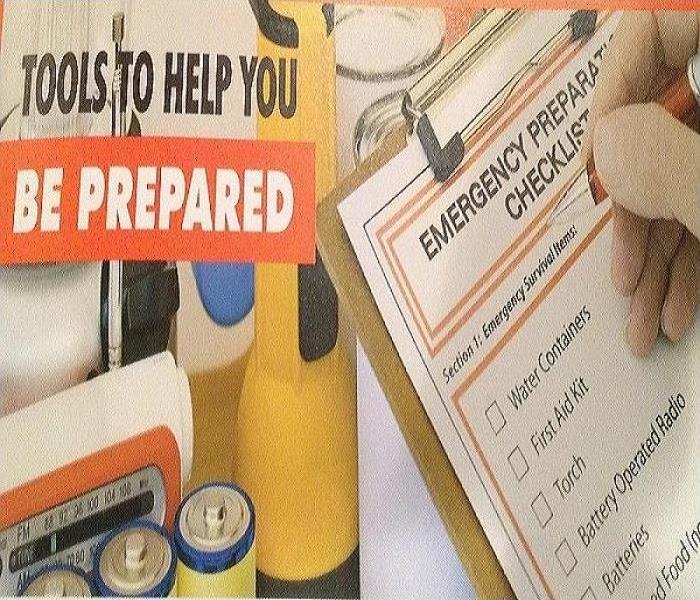 SERVPRO of Union, Towns, Fannin & Gilmer Counties is always "Ready for whatever happens!"
SERVPRO of Union, Towns, Fannin & Gilmer Counties is always "Ready for whatever happens!"
As severe weather approaches, you and your family are reminded to check our emergency supply kits, we are also reminded of the SERVPRO slogan "Ready for whatever happens". The U.S. Department of Homeland Security recommends having at least one full emergency supply kit for your home and smaller portable kits for your office and vehicles.
A basic emergency supply kit should contain at least the following:
- Water (one gallon per person per day)
- Food (non-perishable 3-day supply)
- Manual can opener
- Battery operated radio, preferably a NOAA weather radio
- Flashlight and extra batteries
- First aid kit
- Whistle to signal for help
- Clothing
- Dust masks or bandanas
- Plastic sheeting, garbage bags and duct tape
- Wrench or pliers to turn off utilities
- Hygiene items
- Important documents; copies of insurance policies, ID and bank account information
- Cash
- Fire extinguisher
- Matches in a waterproof container
Remember, this is only a basic kit. Your circumstances may require additional items. Check out the U.S. Department of Homeland Security website on readiness at www.ready.gov for more information. You can also contact SERVPRO of Union, Towns, Fannin & Gilmer Counties to learn more and be "Ready for whatever happens!"
Mold from Heavy Flooding a Serious Concern
2/3/2017 (Permalink)
 5 reasons to suspect you didn’t cure your mold issues on your own! SERVPRO of Union, Towns, Fannin & Gilmer Counties is here to help!
5 reasons to suspect you didn’t cure your mold issues on your own! SERVPRO of Union, Towns, Fannin & Gilmer Counties is here to help!
Mold from Heavy Flooding a Serious Concern
From August till the end of December 2015, North Georgia saw several incidents of heavy rainfall that led to massive flooding. In some parts, like Blairsville’s Meeks Park or entire neighborhoods in Ellijay, rising water levels were enough to shutter access to main roads and close down communities completely.
As the new year brings a break from the rain and the region settles into its familiar chilly weather pattern, many residents are still left dealing with the aftermath of last year’s torrential rains. Most notably, the potential for mold and bacteria growth is concern for those affected by flooding.
SERVPRO has been helping businesses and residents since 1967. They will be happy to assist you in the cleanup and restoration of your home from the serious aftermath effects of flooding fromheavy rains or plumbing.
5 reasons to suspect you didn’t cure your mold issues on your own:
Mold spores are airborne and invisible to the human eye. They can quickly multiply after your cleaning attempt. Air duct cleaning is essential after mold cleanup to capture mold spores and sanitize the system.
If you used bleach, it leaves residual moisture, which is one condition mold needs to grow.
If you used bleach on porous surfaces, such as unfinished wood and drywall, you may have killed mold on the surface. However, you quite possibly did not kill the roots beneath the surface.
You have a musty smell after cleaning.
If a dark stain reappears after cleaning, it could possibly be the return of mold
You may need a professional to, at least, evaluate your home and make sure it’s mold free. Mold issues are always best caught early or completely prevented.
For more information please visit SERVPROBLUERIDGE.com or call us today at 706-896-1880.
10 Ways to Prevent Water Damage
2/3/2017 (Permalink)
Flooding and water damage is very invasive. Water quickly spreads throughout your home and gets absorbed into floors, walls, furniture, and more. SERVPRO of Union, Towns, Fannin & Gilmer Counties arrives quickly and starts the water extraction process almost immediately. This immediate response helps to minimize the damage and the cleaning and restoration costs. Here are some ways to prevent water damage to your home or business:
1. Clean and inspect gutters regularly.
2. Keep downspouts clear of any blockages.
3. Repair or replace roofing as needed.
4. Be sure soffit vents are clean and unobstructed.
5. Check for any cracks or peeling paint. These could indicate moisture retention.
6. Fill low spots around building foundation with clean fill dirt.
7. Create slope away from structure to drain runoff properly.
8. Trim plants around building to avoid growth of mold or mildew.
9. Make sure garden areas have adequate drainage.
10. Apply a waterproofing coating to interior or exterior basement walls.
If you have any questions regarding any troubles you are experiencing, do not hesitate to contact our SERVPRO of Union, Towns, Fannin & Gilmer Counties office.
Spruce Up Your Space
2/3/2017 (Permalink)
Birds are chirping and the temperatures have warmed up---spring is finally here! Spring cleaning is a tradition allowing us to freshen our environment and get a head start on the hectic seasons of spring and summer. While many people deep clean their homes, this is also a great time to clean and organize your business.
SERVPRO of Union, Towns, Fannin & Gilmer Counties can help get your facility in tip top shape. In addition to air duct and HVAC cleaning, SERVPRO of Union, Towns, Fannin & Gilmer Counties crew professionals are trained to use state-of-the-art equipment to remove soils hiding deep within your carpet, as well as focused stain removal and stain resistance applications. Other services include: upholstery and drapery cleaning, hard floor cleaning and care, and odor deodorization.
A clean environment is a healthy environment! Improve your living and work spaces this spring. If you need a little help, don’t work, SERVPRO of Union, Towns, Fannin & Gilmer Counties have the tools to make your home or business sparkle in no time!
Here are some Spring Cleaning Tips in Your Workplace from SERVPRO!
· Divide Your Workspace Into Zones:
Determine how you want and need to use the space and set up zones for your daily functions. You may require a workspace for your computer, a library area for your research, a storage area for supplies and a filing area for your archives. This will provide a foundation for a more efficient use of space.
· Keep Only What You Need At Arm’s Length:
Boxes of pens, stacks of papers and old coffee cups need to go. Rid your desk of visual clutter by paring down the items on top to the essentials only. Supplies, paperwork and personal items should be kept in the zones you’ve established for them.
· Sort Your Catch-All Drawer:
Use drawer dividers to give everything a place, like compartments for paperclips and rubber bands. Go through the drawer every six weeks and clear out anything that is out of place or isn’t being used.
· Eliminate Digital Clutter:
Digital clutter can be just as stressful as physical clutter. Organize digital files and your e-mail inbox just as you would paper files-with a system of logical and clearly labeled folders. Also, keep the icons on your desktop to a bare minimum, and trade in sticky notes on your monitor for calendar reminders.
· Create A Daily Paper System:
Consider creating hanging files or baskets labeled “To Read,” “To Do,” and “To File.” Establish set days for each, so that you don’t get behind or feel the overwhelming need to do everything at once.
· Disinfect Regularly:
Prevent the buildup of dust, dirt, food stains and fingerprints. Wipe down your desk, phone keyboard and monitor once a week with disinfection wipes.
Grilling Safety
7/25/2016 (Permalink)
Summertime is grilling time. We all love to either cook on a grill or eat what has been cooked. Just thinking of all the mouthwatering goodies that can come off a grill makes me hungry. But, before eating, comes safety! When grilling weather finally gets here after a long, cold winter, a lot of us will go drag the grill out of the garage and fire it up. If we don’t take time to check things out and clean everything properly (which ideally was done before putting it away last year), we are asking for trouble. Safety tips and procedures are given to us for a reason- our personal safety and the safety of our surroundings. In 2014 alone, over 16,000 people ended up in emergency rooms because of injuries involving grills. A failure to properly clean the grill was the leading factor contributing to the fire and a close second was having the grill too close to a flammable object, such as the house or porch railing. It can seem like a waste of precious grilling time to clean everything before firing up the grill, especially if you have done so before storage for the winter. You must remember that dust and insects can get into places that could cause a problem while your grill is in storage. Here is a comprehensive list of sensible rules to follow so that your grilling season will be a safe and happy experience: 1. Read the owner’s manual. I know, who reads those things. We all should so that we understand the proper way to use our equipment. Even if you have been grilling for years, when you buy a new grill, it is extremely important to read the manual. All grills are not the same. 2. Grills are for outside use ONLY. Both charcoal and gas grills should never be used indoors, never inside a tent or garage or any other enclosed space. Grills produce carbon monoxide, which may accumulate and kill you. 3. Use only in a well-ventilated area. Always set up your grill in an open area away from structures. Avoid dry leaves or brush and high traffic areas. No one wants little Bobby to come running around the corner and knock the grill over, that would spoil your whole day. 5. Follow electric codes. If you use an electrical apparatus, such as a rotisserie, with your grill, make sure it is up to code and the cord is place so that it is not a trip hazard. 6. Use long handled utensils. Barbecuing tools are made with extra-long handles for a reason, to avoid burns on your hands and arms. Use them. 7. Wear safe clothing. It probably wouldn’t be a good idea to wear a fancy shirt or dress while barbecuing. Even if you are hosting a big party. Close fitting garments are best as they are less likely to come into contact with hot coals or gas burners. Those cumbersome oven mitts can be your best friends while grilling; scorched fingers from hot items are no fun. 8. Keep the fire under control. Keeping a close watch on the temperature of your fire can lessen flare-ups. If you must douse a flare-up with a mist of water, remove the food first. A fire extinguisher, a bucket of sand or even a water hose should be close by in case of a problem. Use baking soda to put out a grease fire; using water in this instance will just spread the fire. 9. Never leave a hot grill unattended. Just because the cooking is done and the fire is out doesn’t make a grill safe. It can stay hot enough to cause problems for up to an hour after being extinguished. Wait until it has cooled off before trying move it. And don't let people play aroung the grill while it is still hot. Grilling out is one of the best things about summer time. Hot dogs, hamburgers, even chicken all seem to taste better when cooked on the grill. This year you may want to try your hand at more exotic dishes such as Ginger-soy glazed Mahi-Mahi or Grilled Shrimp in a Banana-leaf Pouch. Whatever you decide to cook on your grill this summer, be sure to follow the safety rules so that you and your loved ones will have a fabulous summer with no trips to the emergency room. For more tips and tricks to help you prevent leaks, fires and more ... sign up for occassional email newsletters OR please visit the SERVPRO of Union, Towns, Fannin & Gilmer Counties website!
Fireworks Safety
7/25/2016 (Permalink)
Almost everyone loves fireworks! The Fourth of July is just around the corner and we will be looking forward to watching the beautiful fireworks displays. Some of us will go to local displays and some of us will watch the magnificent displays around the country on television. Did you know that the largest fireworks display in the world happened at the New Year countdown on January 1, 2016? It was in the Philippine Arena, Ciudad de Victoria Bocaue Bulacan, Manila, Philippines, consisting of 810,904 fireworks, lasting for 1 hour 1 minute 32.35 seconds in the pouring rain. Amazing, isn’t it?The Chinese stumbled upon a kind of natural firecracker as early as 200 B.C. They would roast bamboo, which would explode with a bang due to the hollow air pockets inside. They believed that the noise would ward off evil spirits. At some point between 600 and 900 A.D., Chinese alchemists mixed together saltpeter (a common kitchen seasoning) charcoal, sulfur and a few other ingredients, unwittingly yielding the first crude form of gunpowder. It is speculated that they were possibly trying to make an elixir for immortality. When the Chinese began stuffing this volatile substance into bamboo shoots and throwing them into a fire, the first fireworks were born. By the time of the Renaissance, pyrotechnic schools were training fireworks artists across Europe. In the 1830s, the Italians began to incorporate very small amounts of metals and other additives to their fireworks, thus creating the bright, multicolored sparks and sunbursts seen in contemporary fireworks shows. Until then, fireworks were just loud noises, orange flashes and faint golden traces of light. Legend has it that Captain John Smith set off the first fireworks display in America in 1608. Some of the colonists may have gotten a little carried away and a spate of firecracker-related pranks became a public nuisance, prompting officials in Rhode Island to ban the “mischievous use of pyrotechnics” in 1731. Today, most states regulate how and where fireworks may be used, as well as the types of explosives would be available for consumers to purchase. In 2009, nearly 9,000 Americans were hurt by fireworks with a disproportionate number of the injuries occurring in July. This is why fireworks safety is so important. The Fireworks Safety Code • Only buy fireworks marked BS 7114• Don’t drink alcohol if setting off fireworks• Keep fireworks in a closed box• Follow the instructions on each firework• Light them at arm’s length, using a taper• Stand well back• Never go near a firework that has been lit. Even if• It hasn’t gone off, it could still explode• Never put fireworks in your pocket or throw them• Always supervise children around fireworks• Light sparklers one at a time and wear gloves• Never give sparklers to children under 5• Keep pets indoors• Don’t set off noisy fireworks late at night and never past 11pm
Don't take a chance on getting the Heebee Jeebees!
7/25/2016 (Permalink)
 Avoiding the heebee jeebees is easy with one call to SERVPRO!
Avoiding the heebee jeebees is easy with one call to SERVPRO!
Household mold is fungi and is commonly referred to as mildew. You know the stuff, mostly ... you know the smell. Childhood visits to lakeside cabins, 1970s ranch home basements and even your grandma's house might bring back the memory of your mom saying "shew, it smells musty in here." Musty, is, in all actuality a word. Your mom didn't make it up. See, fungi used to be classified as plants, for years, until some scientist discovered that it acts more like an animal. So, fungi got their very own kingdom. Ah, a kingdom … "my kingdom for a horse" said Shakespeare. Seemingly simple (like the illustration from the Bard), fungi actually appears in many forms, the quickest to come to mind is usually, a mushroom. Additionally, fungi can appear as a plant parasite and damage crops. The type of fungi we are talking about today is the type which produces household, “mildewly” and musty ol mold. That culprit, though common, is actually a diverse group of organisms.
All fungi are made up of tiny filaments called hyphae. Isn't that interes … zzzzzz ….
The hard walls of fungus (mold) are built out of chitin, the same material that insects and arthropods have as a hard outer shell. Ok, so that's kinda cool. That totally makes the "like animals" part make more sense. Mold reproduces via microscopic particles called spores. It's largely understood that spores are irritants and can cause health effects. The fungi in the outdoors is part of the highly complex process of decomposition, you know … how fallen trees rot and stuff. Organisms such as ants will actually transport bits of fungus to their food supply (usually leaves or plants) to aid in the breakdown. Ants cannot digest cellulose. So, they use fungi kinda like we use meat tenderizer.
Mold lives by breaking down organic material and it spreads in a largely invisible web. The type of fungi that produces household mold and woodland mushrooms do differ, however; in the way that mushrooms emerge as visible evidence of fungi, so does dusty, fuzzy looking household mold.
The common denominator in the growth of all mold, is moisture. All this talk of fungi, mold, mildewy smells, invisible webs … it's creepy, huh? That's why, here at SERVPRO, we recommend you never try to take care of mold issues in your house by yourself. If you can see it, there is usually so much you can't see … we don't want you to even think about it.
We offer complete mold remediation services so you don't even have to! See, now that you understand how mold works … you'll also understand that a spray bottle of bleach and some rubber gloves are only going to worsen the bigger issue. If there is mold showing on the wall, the carpet … that invisible web we talked about ... is strewn far and wide. You can't be thinking about that! You'll get the heebee jeebees! No one wants the heebee jeebees! Not to mention, if you start trying to eradicate the visible stuff and you manage to get a little of the not so visible stuff, you'll stir up the spores! So, please if you see or suspect mold in your home, or Grandma's home … give us a call!
Where there's smoke, there is fire ... tips for fire prevention
7/25/2016 (Permalink)
 Tips from to prevent fires and good advice from local insurance pros.
Tips from to prevent fires and good advice from local insurance pros.
In 2011, there were 1.3 million house fires in the United States.
1.3 million families temporarily displaced.
We attach our memories to things. We often scoff at materialism and we even poke fun at those who tend to accumulate lots of “things” … but the truth is, sometimes, things have meaning.
Your grandmother’s quilt, photos of your children, artwork, the shoes you wore on your first date with your husband, a movie ticket from a special day with a good friend … these are all seemingly meaningless things. Some of us are more sentimental than others.
Out of 1.3 million, it’s a safe bet that some important “things” were lost. We helped approximately 240 customers last year and though we restored a lot of belongings, some items were too far gone. Some of those things were not replaceable. Worse than things are people injured or killed. Nearly 25 thousand people each year are injured or killed by fire and that’s why prevention is so important. Here are some less common tips from Ready.gov, a website dedicated to disaster prevention.
Electrical
· Frayed wires can cause fires. Replace all worn, old or damaged appliance cords immediately and do not run cords under rugs or furniture.
· Buy electrical products evaluated by a nationally recognized laboratory, such as Underwriters Laboratories (UL).
· If an appliance has a three-prong plug, use it only in a three-slot outlet. Never force it to fit into a two-slot outlet or extension cord.
· Use electrical extension cords wisely; never overload extension cords or wall sockets.
· Immediately shut off, then professionally replace, light switches that are hot to the touch and lights that flicker.
Cooking
· Stay in the kitchen when you are frying, grilling, or broiling food. If you leave the kitchen for even a short period of time, turn off the stove.
· Wear short, close-fitting or tightly rolled sleeves when cooking.
· Do not cook if you are sleepy, have been drinking alcohol, or have taken medicine that makes you drowsy.
· Keep children away from cooking areas by enforcing a "kid-free zone" of 3 feet around the stove.
· Position barbecue grills at least 10 feet away from siding and deck railings, and out from under eaves and overhanging branches.
Fires can spread from nearly harmless to engulfing in less than 30 seconds. Reavy.gov reports many people do not realize how incredibly fast fire is. Fire is not bright and glowing as it would seem. Especially in a house it quickly produces thick black smoke making everything dark. Additionally, it’s smoke and toxic fumes from the various materials in a home that usually kills people. These hard facts should be enough to help you create a fire escape plan for your family.
As for those belongings, put precious mementos in fireproof safe or box. Have your photos scanned so you have digital copies of all family photos, old and new. Terry and Tonya, two of our team members who help inventory belongings and restore items have thoroughly enjoyed breathing new life into “Grandmother’s China” and even finding lost treasures in the process of moving furniture and cleaning up after a disaster.
Here at SERVPRO, we are used to working with insurance companies to help restore or rebuild homes. In the Blue Ridge area, one of the agents we are blessed to work with is Kevin Panter, who offers the following advice “Insureds need to take their annual review with their insurance agent seriously. It is often determined during a time of loss that the insured’s building limits and personal property contents limits are not adequate. Having proper documentation and adequate limits will help make the claim process much easier. Having cell phone videos and storing proper documentation off the premises will help greatly should a claim arise.” You can reach Kevin through his company www.KevinPanterInsurance.com .
“Our whole reason for existing as a business is to help our customers feel confident and comfortable as we restore their homes or businesses to pre-loss conditions. When disaster, small or large, strikes, you feel like you’ve lost control. We want to help you get it back. Our crews are often praised for their compassion. It is truly heartfelt,” explains Carnie Wall, co-owner.
Play that funky music, but get rid of that funky smell
7/25/2016 (Permalink)
 Got an odor? Is it a mystery? No need for Scooby Doo, it could be your HVAC system!
Got an odor? Is it a mystery? No need for Scooby Doo, it could be your HVAC system!
Most of us have walked into a business or even a home that didn’t smell … well, good. Sometimes the odor is identifiable and superficial cleaning will fix it or maybe it can just be stemming from some unpleasant thing that’s out of sight and no longer alive thus creating a big ol “eeewww” in the olfactory department.
More often, weird odors are not clearly seen or understood. Like musty basements … what is “musty” any way? That’s just a weird word. Restaurants often start to have an odd and not altogether pleasant smell from fryer oils, grease traps, garbage and other unsightly and unappetizing things we really don’t love to talk about. Maybe you are now thinking back to when your very own nose was offended by such an odor and how you really wish you hadn’t picked that particular place to try a salmon burger.
At SERVPRO of Union, Towns, Fannin and Gilmer Counties (yeah, we know that is a crazy long name) we are challenged with helping businesses and homeowners get rid of funky things. We can suggest a new musical playlist that’s less 1970s too, but we don’t specialize and can’t promise your satisfaction in that!
One of the ways we help to get rid of “funk” is through Air Duct Cleaning. Sometimes, you can change the carpet, paint the walls, bleach the tile and there is STILL an odor. Often times, that odor is coming from your Heat Ventilation and Air Conditioning (HVAC) system. So, along with a smell, the air you are breathing isn’t so great either. Even the EPA suggests Air Duct and Ventilation system cleaning can be beneficial in situations where mold has been present or if any type of contaminant could have breached your system. Breaches happen in the case of older systems and just like your coffee table gets covered in dust, so does your duct work. We’ve talked about a lot of yucky things in this article and sadly, even the tidiest of Sally (or Sam) Homemakers can’t stop dust.
Inspecting the ventilation system is also a great way to reveal efficiency issues and potential hazards or problems. There could be lack of insulation along with a multitude of possible scenarios our technicians encounter when they go crawling around in attics and under floors. We have stories …
We pride ourselves on integrity, responsibility and commitment in our business. Our jobs often include doing our full level best to turn someone’s disaster into a happy ending, so in performing routine cleaning and inspections we are thrilled when we can be the ones to point out an issue and prevent disaster. That’s what we call a very good day.
To learn more about our Air Duct and HVAC Cleaning services visit www.SERVPROuniontownsfanningilmercounties.com
Sneaky Leaks: Tips to avoid disaster
7/25/2016 (Permalink)
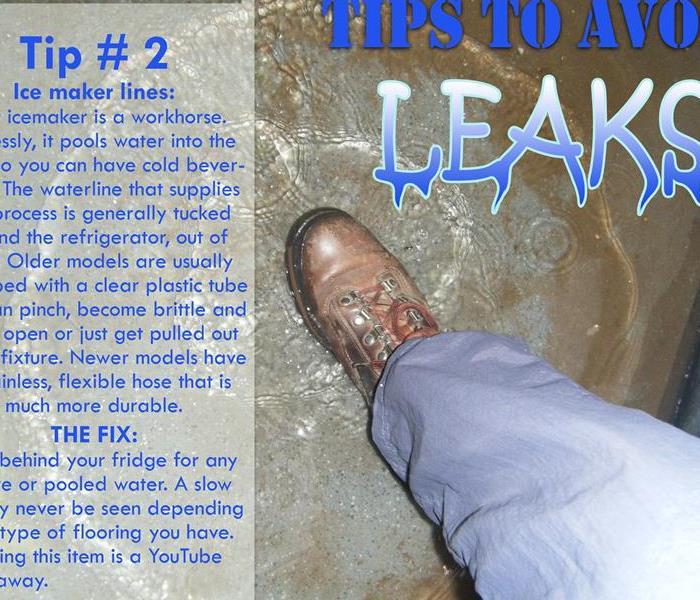 We detail several ways to avoid the sneakiest leaks of all.
We detail several ways to avoid the sneakiest leaks of all.
Did you know that the EPA reports that plumbing leaks account for more than One Trillion gallons of water waste, Nationwide. That’s TRILLION, with a T. One million gallons of water will fill a football field sized swimming pool nearly four feet deep.
The EPA also reports, the average household loses 10,000 gallons each year due to leaks. That’s enough to fill a backyard pool six feet deep.
So, what’s so leaky? Some leaks are super sneaky.
Here are five places you might be able to sneak up on your leaks!
1. HVAC drainage line: this isn’t a leak that uses excess water but it is a leak that can spill out of its containment pan, onto the floor and cause damage.
THE FIX: It’s usually just that the line is clogged with dust or debris. Generally simple to fix.
2. Ice maker lines: Your icemaker is a workhorse. Tirelessly, it pools water into the mold so you can have cold beverages. The waterline that supplies this process is generally tucked behind the refrigerator, out of sight. Older models are usually equipped with a clear plastic tube that can pinch, become brittle and crack open or just get pulled out of the fixture. Newer models have a stainless, flexible hose that is much more durable.
THE FIX: Check behind your fridge for any moisture or pooled water. A slow leak my never be seen depending on the type of flooring you have. Replacing this item is a YouTube video away.
3. Faucets: So, maybe faucets are less sneaky than attic or basement water lines … but little drips add up. It’s worth turning the controls a smidge tighter to see if you have a drip or just poor hand strength.
THE FIX: It’s usually just an O ring or a washer. The internal workings of the standard kitchen or bathroom faucet do not work for forever. Also, you might consider changing the supply tube lines with braided lines.
4. Outdoor faucets: The invention of frost proof fixtures have significantly cut down on problems with outdoor faucets wreaking havoc. However, one little caveat we see time after time, is the improper installation of these handy-dandy faucets. See, they are supposed to be installed at a slight angle as to encourage any remaining water to run out of the pipe. Because: without water, a pipe can’t really freeze and burst.
THE FIX: Unscrew the hose … run a little water on the ground, turn off the water … does the water continue to drip out of the faucet for a bit? If it’s dry as bone, there’s probably a good chance it’s not going to drain out. You are likely going to need a handy person or a plumber to fix this. **Remember, never leave hoses connected to faucets in the winter.
5. Dishwashers: Oh how we love or hate our dishwashers. Either they are saving us from the task of scrubbing never ending dishes, or they are doing a terrible job and we are still scrubbing dishes. Tucked back flush with our cabinets, we cannot see what is going on with the kitchen help.
THE FIX: Look closely at the adjoining cabinetry for signs of moisture. If you are seeing the leak, it could be the door gasket or something rather simple. If it’s older, the tubs can form holes.
THE FIX: Don’t over load your dishwasher and definitely use the proper soap. Other leaks, you may need help to resolve.
Other places to look for leaks: hot water heater, washing machine hoses (we recommend you change these every 5-7 years or switch to a braided line), under sinks, attic and basement pumping, access panels to plumbing otherwise walled off.
Remember at SERVPRO we can make sure any disaster you encounter is “like it never even happened” but we also fully subscribe to the theory “an ounce of prevention is worth a pound of cure”.
Should you have a leak sneak up on you and cause more than mess than you can handle, SERVPRO of Union, Towns, Fannin & Gilmer Counties is just a phone call away.
www.SERVPROBlueRidge.com
(706) 896-1880
Restoring Your Commercial Property After A Water Damage Event
7/11/2016 (Permalink)
Flooding and water damage events at commercial properties are often complex with numerous issues that require a knowledgeable and flexible response. Whether we’re dealing with a relatively small water cleanup scenario or a large scale event, we work quickly to assess each unique situation and isolate the damaged area. In many instances, normal operations can continue in a temporary space while we restore your facility.
Restoring Commercial Properties Presents Unique Challenges
Our professionals are trained to be mindful of legal and environmental concerns and strive to fully restore the damaged area while working within your budgetary constraints. We understand that every hour spent cleaning up is an hour of lost revenue and productivity. So when an emergency situation arises in your business, give us a call and we’ll be there fast with the help you need.
About SERVPRO of Union, Towns, Fannin & Gilmer Counties
SERVPRO of Union, Towns, Fannin & Gilmer Counties specializes in the cleanup and restoration of commercial and residential property after a water damage event. Our staff is highly trained in property damage restoration. From initial and ongoing training at SERVPRO’s corporate training facility to regular IICRC-industry certification, rest assured our staff is equipped with the knowledge to restore your property.
http://www.SERVPROuniontownsfanningilmercounties.com/crew-photos
Smoke and Soot Cleanup
7/11/2016 (Permalink)
Smoke and soot is very invasive and can penetrate various cavities within your home, causing hidden damage and odor. Our smoke damage expertise and experience allows us to inspect and accurately assess the extent of the damage to develop a comprehensive plan of action.
Smoke and soot facts:
- Hot smoke migrates to cooler areas and upper levels of a structure.
- Smoke flows around plumbing systems, seeping through the holes used by pipes to go from floor to floor.
- The type of smoke may greatly affect the restoration process.
Different Types of Smoke
There are two different types of smoke–wet and dry. As a result, there are different types of soot residue after a fire. Before restoration begins, SERVPRO of Union, Towns, Fannin & Gilmer Counties will test the soot to determine which type of smoke damage occurred. The cleaning procedures will then be based on the information identified during pretesting. Here is some additional information:
Wet Smoke – Plastic and Rubber
- Low heat, smoldering, pungent odor, sticky, smeary. Smoke webs are more difficult to clean.
Dry Smoke – Paper and Wood
- Fast burning, high temperatures, heat rises therefore smoke rises.
Protein Fire Residue – Produced by evaporation of material rather than from a fire
- Virtually invisible, discolors paints and varnishes, extreme pungent odor.
Our Fire Damage Restoration Services
Since each smoke and fire damage situation is a little different, each one requires a unique solution tailored for the specific conditions. We have the equipment, expertise, and experience to restore your fire and smoke damage. We will also treat your family with empathy and respect and your property with care.
Have Questions about Fire, Smoke, or Soot Damage?
Call Us Today – 706-896-1880
For Immediate Service in Union, Towns, Fannin & Gilmer Counties, Call SERVPRO
7/11/2016 (Permalink)
SERVPRO of Union, Towns, Fannin & Gilmer Counties provides 24-hour emergency service and is dedicated to being faster to any-sized disaster inUnion, Towns, Fannin & Gilmer Counties. We can respond immediately to your emergency and have the expertise to handle your restoration or cleaning needs.
- 24-Hour Emergency Service
- Faster to Any-Sized Disaster
- Highly Trained Restoration Technicians
- A Trusted Leader in the Restoration Industry
- Locally Owned and Operated
- Advanced Restoration and Cleaning Equipment
Have Questions? Call Us 24/7 –706-896-1880
Residential Services
Whether your home needs emergency flood damage or your upholstery cleaned, you can depend on us. Our technicians have extensive cleaning and restoration training and can make your property look its best. Learn more about our residential services:
- Water Damage Restoration
- Fire Damage Restoration
- Mold Remediation
- Storm Damage Restoration
- Cleaning Services
- Building/Reconstruction Services
Commercial Services
There's never a convenient time for fire or Water damage to strike your commercial property. Every hour spent cleaning up is an hour of lost revenue and productivity. So when the need arises for professional cleaning or emergency restoration services we have the training and expertise to respond promptly with highly trained technicians to get your property back to business. Learn more about our commercial services: http://www.SERVPROuniontownsfanningilmercounties.com/commercial-restoration-cleaning
- Commercial Water Damage Restoration
- Commercial Fire Damage Restoration
Our Highly Trained Restoration Specialists can restore your Home
7/11/2016 (Permalink)
SERVPRO of Union, Towns, Fannin & Gilmer Counties is an IICRC firm. The Institute of Inspection, Cleaning and Restoration Certification (IICRC) creates the standards for the restoration industry and provides training and certification to restoration companies. IICRC Certified Firms have the right to display the IICRC Certified Logo.
IICRC Certified Firms must
• Present accurate information to consumers and conduct business with honesty and integrity.
• Require a technician on all jobs who has been formally trained and passed all required tests.
• Require a continuing education program to keep technicians up-to-date on the latest changes in the industry.
• Maintain liability insurance to protect all parties in the event of an accident.
• Maintain a written complaint policy and agree to Better Business Bureau or similar arbitration to resolve disputes, and accept the conclusions and recommendations of arbitration.
The IICRC Develops The Standards For The Restoration Industry
The IICRC has been the driving force in establishing the main industry standards and reference guides for professional carpet cleaning, water damage restoration and mold remediation. These IICRC standards take years to develop and require the coordination of experts in the field: manufacturers, industry organizations, insurance professionals, training schools, contractors, and public health professionals.
Every five years, the standards are reviewed and updated. The water damage restoration field changes rapidly with advancements in technology and science, and therefore the standards must evolve to keep pace.
About SERVPRO of Union, Towns, Fannin & Gilmer Counties
SERVPRO of Union, Towns, Fannin & Gilmer Counties specializes in the cleanup and restoration of residential and commercial property after a fire, smoke or water damage event. Our staff is highly trained in property damage restoration and we are an IICRC Certified Firm. We believe in continuous training: from initial and ongoing training at SERVPRO’s corporate training facility to regular IICRC-industry certification, rest assured our staff is equipped with the knowledge to restore your property.
http://www.SERVPROuniontownsfanningilmercounties.com/crew-photos
When Storms or Floods hit, SERVPRO is ready!
7/11/2016 (Permalink)
SERVPRO of Union, Towns, Fannin & Gilmer Counties specializes in storm and flood damage restoration. Our crews are highly trained and we use specialized equipment to restore your property to its pre-storm condition.
Faster Response
Since we are locally owned and operated, we are able to respond quicker with the right resources, which is extremely important. A fast response lessens the damage, limits further damage, and reduces the restoration cost.
Resources to Handle Floods and Storms
When storms hit, we can scale our resources to handle a large storm or flooding disaster. We can access equipment and personnel from a network of 1,650 Franchises across the country and elite Disaster Recovery Teams http://www.SERVPROuniontownsfanningilmercounties.com/storm-flooding-restoration that are strategically located throughout the United States.
Have Storm or Flood Damage? Call Us Today 706-896-1880
As a trusted leader in the restoration industry, SERVPRO of Union, Towns, Fannin & Gilmer Counties provides 24-hour residential and commercial services. As a locally owned and operated business, we’re dedicated to being faster to any size disaster, with the training, equipment, and expertise to handle your restoration and cleaning needs.
Union, Towns, Fannin & Gilmer County Residents: Follow These Mold Safety Tips If You Suspect Mold
7/11/2016 (Permalink)
If you see visible mold, do not disturb it. You can inadvertently spread the mold infestation throughout your home. When mold is disturbed, the mold can release microscopic mold spores which become airborne and can circulate inside your home.
What to Do:
- Stay out of affected areas.
- Turn off the HVAC system and fans.
- Contact SERVPRO of Union, Towns, Fannin & Gilmer Counties for mold remediation services.
What Not to Do:
- Don’t touch or disturb the mold.
- Don’t blow air across any surfaces with visible or suspected mold growth.
- Don’t attempt to dry the area yourself.
- Don’t spray bleach or other disinfectants on the mold.
About Our Mold Remediation Services
SERVPRO of Union, Towns, Fannin & Gilmer Counties specializes in mold cleanup and restoration, in fact, it’s a cornerstone of our business. Our crews are highly trained restoration professionals that use specialized equipment and techniques to properly remediate your mold problem quickly and safely.
If You See Signs of Mold, Call Us Today –706-896-1880
Does Your Home Have A Mold Problem?
7/11/2016 (Permalink)
Microscopic mold spores naturally occur almost everywhere, both outdoors and indoors. This makes it impossible to remove all mold from a home or business. Therefore, mold remediation reduces the mold spore count back to its natural or baseline level. Some restoration businesses advertise “mold removal” and even guarantee to remove all mold, which is a fallacy. Consider the following mold facts:
- Mold is present almost everywhere, indoors and outdoors.
- Mold spores are microscopic and float along in the air and may enter your home through windows, doors, or AC/heating systems or even hitch a ride indoors on your clothing or a pet.
- Mold spores thrive on moisture. Mold spores can quickly grow into colonies when exposed to water. These colonies may produce allergens and irritants.
- Before mold remediation can begin, any sources of water or moisture must be addressed. Otherwise, the mold may return.
- Mold often produces a strong, musty odor and can lead you to possible mold problem areas.
- Even higher-than-normal indoor humidity can support mold growth. Keep indoor humidity below 45 percent.
If your home or business has a mold problem, we can inspect and assess your property and use our specialized training, equipment, and expertise to remediate your mold infestation.
If You See Signs of Mold, Call Us Today –706-896-1880
Union, Towns, Fannin & Gilmer Residents: We Specialize in Flooded Basement Cleanup and Restoration!
7/11/2016 (Permalink)
A basement can flood at any time, although flooding most often occurs during heavy rainfall. Basements are inherently prone to flooding because they are the lowest level of a building and are normally built partly or entirely below ground level. There are a number of reasons why your basement could flood, including:
- A blocked or failed sewer lateral pipe
- Heavy rain causes surface water to pool around your home
- Storm sewer backup
- Sanitary sewer backup
- Foundation drainage failure
- Water supply-line break or hot-water tank failure
- And many more
Have Questions about Basement Flooding?
Call Today - 706-896-1880
If flood water is not handled quickly and properly, it can jeopardize your health and safety, and cause severe damage to your home’s structure. Remember, the longer you wait, the worse the problem will get.
The bottom line: a flooded basement can jeopardize your health, safety, and your home’s integrity. It’s worth making a call to SERVPRO of Union, Towns, Fannin & Gilmer Counties and let our trained, professional crews handle the situation safely and correctly. We have earned the tust of hundreds of homeowners, business owners, and property professionals.
We are Flooded Basement Specialists:
- We are Available 24 hours/7 days per week
- We’re a Preferred Vendor to many National Insurance Companies
- We Bill The Insurance Directly – One Less Thing For You To Worry About
- Our Technicians are Highly-Trained in Water Restoration Techniques
- We use s500 IICRC Restoration Standards
- Advanced Inspection and Extraction Equipment
Basement Flooded? Call Us Today – We’re Ready To Help 706-896-1880
Faster to your Union, Towns, Fannin & Gilmer County Water Damage Even
7/11/2016 (Permalink)
Flooding and water emergencies don’t wait for regular business hours and neither do we. SERVPRO of Santa Barbara provides emergency cleaning and restoration services 24 hours a day, 7 days a week—including all holidays.
Faster To Any Size Disaster
Flooding and water damage is very invasive. Water quickly spreads throughout your home and gets absorbed into floors, walls, furniture, and more. SERVPRO of Union, Towns, Fannin & Gilmer Counties arrives quickly and starts the water extraction process almost immediately. This immediate response helps to minimize the damage and the cleaning and restoration costs.
Need Emergency Service? Call Us 24/7 –706-896-1880
Water Damage Timeline
Within Minutes
- Water quickly spreads throughout your property, saturating everything in its path.
- Water is absorbed into walls, floors, upholstery, and belongings.
- Furniture finishes may bleed, causing permanent staining on carpets.
- Photographs, books, and other paper goods start to swell and warp.
Hours 1 - 24:
- Drywall begins to swell and break down.
- Metal surfaces begin to tarnish.
- Furniture begins to swell and crack.
- Dyes and inks from cloth and paper goods spread and stain.
- A musty odor appears.
48 Hours to 1 Week:
- Mold and mildew may grow and spread.
- Doors, windows, and studs swell and warp.
- Metal begins to rust and corrode.
- Furniture warps and shows signs of mold.
- Paint begins to blister.
- Wood flooring swells and warps.
- Serious biohazard contamination is possible.
More Than 1 Week:
- Restoration time and cost increase dramatically; replacing contaminated materials and structural rebuilding may be extensive.
- Structural safety, mold growth, and biohazard contaminants pose serious risks to occupants.
About SERVPRO of Union, Towns, Fannin & Gilmer Counties
SERVPRO of Union, Towns, Fannin & Gilmer Counties specializes in the cleanup and restoration of residential and commercial property after a fire, smoke or water damage event. Our staff is highly trained in property damage restoration. From initial and ongoing training at SERVPRO’s corporate training facility to regular IICRC-industry certification, rest assured our staff is equipped with the knowledge to restore your property.
Union, Towns, Fannin & Gilmer Counties 24 Hour Emergency Water Damage Service
7/11/2016 (Permalink)
SERVPRO of Union, Towns, Fannin & Gilmer Counties is available 24 hours a day for water emergencies, large or small. When you are dealing with water damage, immediate action is crucial. A delay of just a few hours can greatly increase the severity of the water damage.
We Answer the Phone Ready to Help
Call Today - (706) 896-1880
We understand that when you call us, you may be feeling confused, stressed, and vulnerable. You need an expert to guide you through this crisis. SERVPRO of Union, Towns, Fannin & Gilmer Counties has the specific water damage training and experience to help you through this tough time. We specialize in water damage restoration—in fact, it's the cornerstone of our business.
What to Expect
When you call, we will ask several questions regarding your water damage emergency. These questions will help us determine what equipment and resources to bring, including how many trained SERVPRO Professionals may be needed.
Our SERVPRO Representative will ask several questions:
- Your name and contact information
- Your insurance information (if applicable)
- The street address of the water-damaged home or business
- When did the flooding or water damage occur?
- What caused the water damage (if known)?
- Is there electricity available (on-site)?
About SERVPRO of Union, Towns, Fannin & Gilmer Counties
SERVPRO of Union, Towns, Fannin & Gilmer Counties specializes in the cleanup and restoration of residential and commercial property after a fire, smoke or water damage event. Our staff is highly trained in property damage restoration. From initial and ongoing training at SERVPRO’s corporate training facility to regular IICRC-industry certification, rest assured our staff is equipped with the knowledge to restore your property.
http://www.SERVPROuniontownsfanningilmercounties.com/crew-photos
Smoke Alarm Campaign May 2016
6/13/2016 (Permalink)
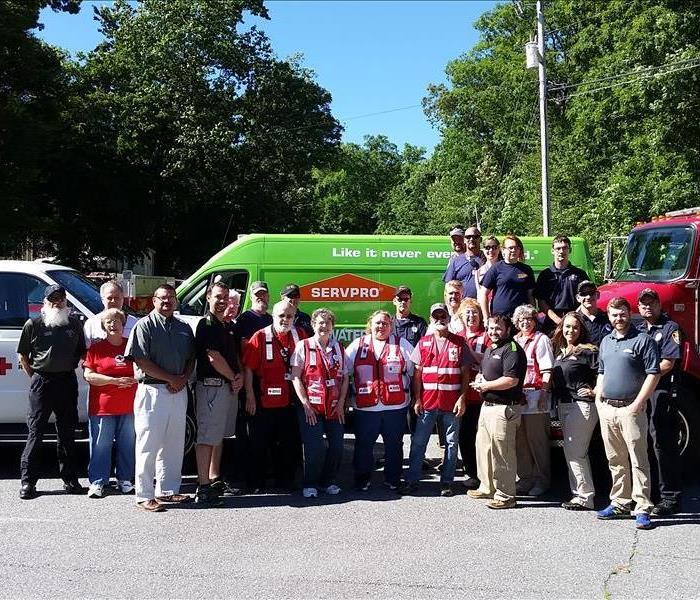
The Red Cross DAT team and the Towns County Fire Dept. finished up their third SMOKE ALARM CAMPAIGN in Towns County and welcomed their new community partner SERVPRO of Union, Towns, Fannin & Gilmer Counties. SERVPRO was a great addition to the team that provided much needed additional manpower, as well as, additional smoke alarms.
Red Cross is in its second year of working with Fire Chief Harold Copeland and his fire fighters on the Smoke Alarms Saves Lives Campaign. This campaign was a program started by the Red Cross nationwide 3 years ago in an effort to reduce injuries and deaths in house fires by 25% within 5 years. On Wednesday, June 8th, we installed 150 new 10year lithium battery smoke alarms in 51 homes in Towns County that couldn't afford them, didn't have working smoke alarms, or had old ones that needed replacing. We also proudly expanded this program to include Veterans in need of these alarms.
The Red Cross and Fire Dept. would like to especially thank Mr. Keith Wall, Owner, of SERVPRO of Union, Towns, Fannin & Gilmer Counties and his team who are now a permanent member of this campaign going forward for all their time and efforts supporting this life saving campaign and for the purchase of the additional alarms needed. We'd like to thank Home Depot of Blairsville for their discounts on those smoke alarms.
We'd also would like to thank additional businesses in Hiawassee that supported us in this campaign. They are Hiawassee Hardware who provided batteries to be used in some current existing alarms, as well as, Hardee's, McDonalds and Zaxby's for
providing food for all the volunteers who came out to work this event. And last but not least thank you to all the workers, SERVPRO employees, Fire Fighters and Red Cross volunteers, this couldn't have been accomplished without you.
Home & Garden Show 2016
6/13/2016 (Permalink)
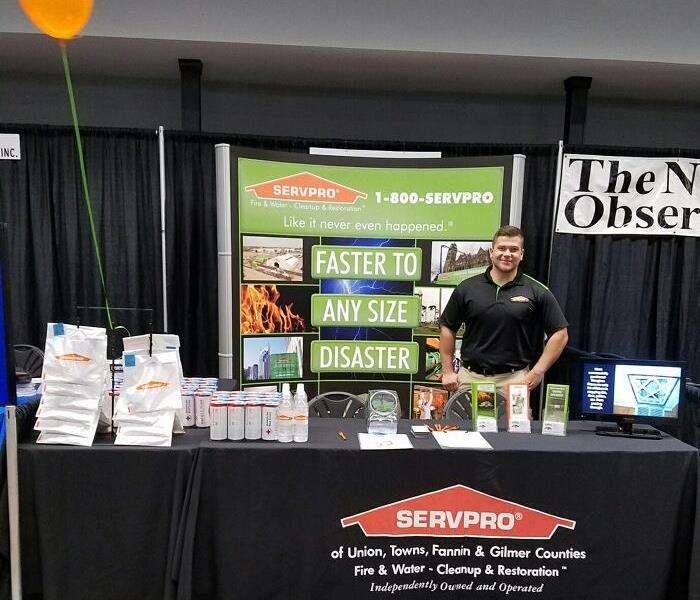 Jesse Gibson
Jesse Gibson
SERVPRO of Union, Towns, Fannin & Gilmer Counties had so much fun at the Home & Garden Show in Hiawassee hosted at the Events Center at Fieldstone! We were able to meet customers and give them information they never knew regarding what was lurking in their HVAC duct systems and information regarding mold due to flooding among so much more! Thank you to everyone who came out to see us! If you didn't get a chance to come out or have questions for us, feel free to contact SERVPRO of Union, Towns, Fannin & Gilmer Counties and our office will be happy to answer any questions you may have any kinds of issues you are experiencing. SERVPRO of Union, Towns, Fannin and Gilmer Counties is always here to help!
Home & Garden Show 2016
6/13/2016 (Permalink)
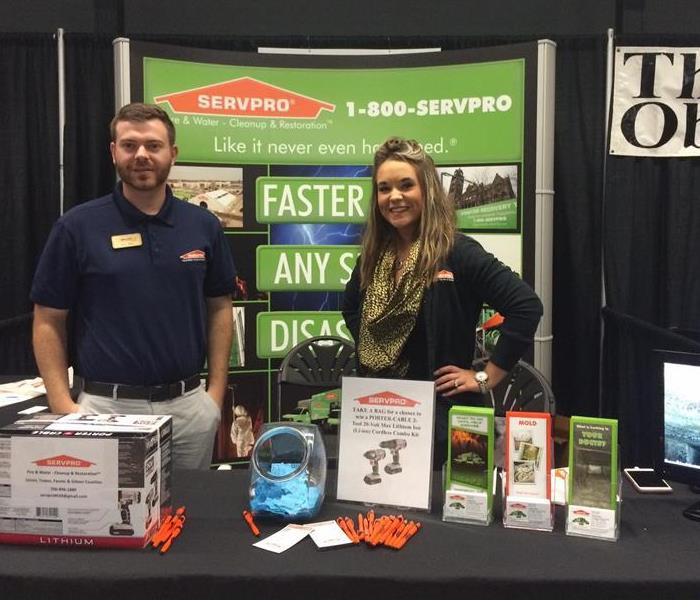 RL Key and Christine Harriott
RL Key and Christine Harriott
SERVPRO of Union, Towns, Fannin & Gilmer Counties had so much fun at the Home & Garden Show in Hiawassee hosted at the Events Center at Fieldstone! We were able to meet customers and give them information they never knew regarding what was lurking in their HVAC duct systems and information regarding mold due to flooding among so much more! Thank you to everyone who came out to see us! If you didn't get a chance to come out or have questions for us, feel free to contact SERVPRO of Union, Towns, Fannin & Gilmer Counties and our office will be happy to answer any questions you may have any kinds of issues you are experiencing. SERVPRO of Union, Towns, Fannin and Gilmer Counties is always here to help!
Apple Blossom Festival 2016
6/13/2016 (Permalink)
SERVPRO of Union, Towns, Fannin and Gilmer Counties participated in the 2016 Apple Blossom Festival in Ellijay, GA this May. We were able to meet customers from all over and give them information they never knew regarding what was lurking in their HVAC duct systems and information regarding mold due to flooding among so much more! Thank you to everyone who came out to see us! If you didn't get a chance to come out or have questions for us, feel free to contact SERVPRO of Union, Towns, Fannin & Gilmer Counties and our office or production staff will be happy to answer any questions you may have any kinds of issues you are experiencing. SERVPRO of Union, Towns, Fannin and Gilmer Counties is always here to help!
About SERVPRO of Union, Towns, Fannin & Gilmer Counties
SERVPRO of Union, Towns, Fannin & Gilmer Counties specializes in the cleanup and restoration of residential and commercial property after a fire, smoke or water damage event. Our staff is highly trained in property damage restoration. From initial and ongoing training at SERVPRO’s corporate training facility to regular IICRC-industry certification, rest assured our staff is equipped with the knowledge to restore your property.
http://www.SERVPROuniontownsfanningilmercounties.com/crew-photos
Relay for Life 2016
6/13/2016 (Permalink)
SERVPRO of Union, Towns, Fannin and Gilmer Counties had so much fun last Friday at the Relay for Life event in Blue Ridge, GA! Thank you to everyone who came out to support the cause!
What Is Relay?
- Organized, overnight community fundraising walk
- Teams of people camp out around a track
- Members of each team take turns walking around the track
- Food, games and activities provide entertainment and build camaraderie
- Family-friendly environment for the entire community
Because it's a team event, individual participants are not required to be there the entire time. But it's so much fun, you'll find it hard to leave!
SERVPRO of Union, Towns, Fannin & Gilmer Counties specializes in the cleanup and restoration of residential and commercial property after a fire, smoke or water damage event. Our staff is highly trained in property damage restoration and we are an IICRC Certified Firm. We believe in continuous training: from initial and ongoing training at SERVPRO’s corporate training facility to regular IICRC-industry certification, rest assured our staff is equipped with the knowledge to restore your property.
Towns County Sheriff's Office Empty Stocking Fund
6/13/2016 (Permalink)
SERVPRO of Union, Towns, Fannin and Gilmer Counties is so excited to help Sheriff Chris Clinton and the Towns County Sheriff's Office with their Empty Stocking Fund! We were able to provide toys to more than 61 children!
The Empty Stocking Fund empowers parents and guardians of children living in poverty by providing them with an opportunity to give their children gifts at Christmas time.
About SERVPRO of Union, Towns, Fannin & Gilmer Counties
SERVPRO of Union, Towns, Fannin and Gilmer Counties specializes in the cleanup and restoration of residential and commercial property after a fire, smoke or water damage event. Our staff is highly trained in property damage restoration. From initial and ongoing training at SERVPRO’s corporate training facility to regular IICRC-industry certification, rest assured our staff is equipped with the knowledge to restore your property.
http://www.SERVPROuniontownsfanningilmercounties.com/crew-photos
Towns County Sheriff's Office Empty Stocking Parade
6/13/2016 (Permalink)
We had so much fun participating in Towns County Sheriff's Office Empty Stocking Parade! SERVPRO of Union, Towns, Fannin & Gilmer Counties placed 3rd in the float competition!
Caleb Weaver: Production Manager
6/13/2016 (Permalink)

SERVPRO® of Union, Towns, Fannin & Gilmer Counties, a premier cleanup and restoration company, congratulates Caleb Weaver, as the new Production Manager. He will be responsible for managing production crews and jobs from start to finish.
Weaver joined the SERVPRO production team in 2009 as a Technician. He progressed to Crew Chief, Senior Crew Chief, and Assistant Production Manager before this promotion. He has earned the Water Damage Restoration and Applied Structural Drying certifications from the Institute of Inspection Cleaning & Restoration . He is a certified lead paint renovator and has also completed forklift training.
“Our most important priority is to provide the very best support and service to our customers,” said Keith Wall, owner of SERVPRO® of Union, Towns, Fannin & Gilmer Counties. “The experience, knowledge and skills that Caleb Weaver brings to our franchise management team will help us better serve our community and continue to ensure our customers' satisfaction.”
“I’m very excited to join the management team at SERVPRO® of Union, Towns, Fannin & Gilmer Counties,” said Weaver. “It’s a unique opportunity to continue to grow as a professional while helping people in a time of need.”
SERVPRO® of Union, Towns, Fannin & Gilmer Counties provides cleanup and restoration services following a fire, water or even mold-related damage. Additional services offered include: cleaning and restoration of special items, such as HVAC duct systems; building exteriors; electronic equipment, including computers and documents that have sustained water damage.
For more information on SERVPRO® of Union, Towns, Fannin & Gilmer Counties , please contact Keith Wall at 706-896-1880.
2015 SERVPRO Christmas
6/13/2016 (Permalink)
The ladies of SERVPRO of Union, Towns, Fannin & Gilmer Counties had a great time at the Christmas Party! If you have questions for us, feel free to contact SERVPRO of Union, Towns, Fannin & Gilmer Counties and our office or production staff will be happy to answer any questions you may have any kinds of issues you are experiencing. SERVPRO of Union, Towns, Fannin and Gilmer Counties is always here to help!
About SERVPRO of Union, Towns, Fannin & Gilmer Counties
SERVPRO of Union, Towns, Fannin & Gilmer Counties specializes in the cleanup and restoration of residential and commercial property after a fire, smoke or water damage event. Our staff is highly trained in property damage restoration. From initial and ongoing training at SERVPRO’s corporate training facility to regular IICRC-industry certification, rest assured our staff is equipped with the knowledge to restore your property.
http://www.SERVPROuniontownsfanningilmercounties.com/crew-photos
Mountain Holiday Fest Shopping Spree Winner
6/13/2016 (Permalink)
We had such a great time shopping with our Mountain Holiday Fest $100 Shopping Spree winner, Wyatt McRae and his father Matthew McRae this Saturday! Be sure to like us on Facebook to keep up with all our community events!
Matthew Parton
6/13/2016 (Permalink)
"Being able to bring great customer service to our customers in their time of need is the best part of my job. We are the first step in making their disaster like it never even happened."
Fun in the Sun
6/13/2016 (Permalink)
 Jesse Gibson and owner, Carnie Wall
Jesse Gibson and owner, Carnie Wall
Our crew enjoyed a weekend out on the lake!
Snowball Gala
6/13/2016 (Permalink)
 Keith, Sharla and Carnie at the Snowball Gala.
Keith, Sharla and Carnie at the Snowball Gala.
1st Annual Fundraising Snow Ball Gala hosted by the Mountain Marty. This event was held on November 15th at Brasstown Valley Resort and was a huge success.
Trap Shoot Event for Georgia's Sheriff's Youth Homes
6/13/2016 (Permalink)
 Carnie Wall, Caleb Weaver, Matthew Parton, Roy Johnson, Dalton Taylor, Jesse Gibson and Christine Harriott
Carnie Wall, Caleb Weaver, Matthew Parton, Roy Johnson, Dalton Taylor, Jesse Gibson and Christine Harriott
SERVPRO of Union, Towns, Fannin & Gilmer Counties had a BLAST at the Trap Shoot Event for Georgia's Sheriff's Youth Homes! Thank you to the Towns County Sheriff's Office and to the Towns County CLEA group for making this possible! Our guys definitely enjoyed it!
Apple Blossom Festival 2016
6/10/2016 (Permalink)
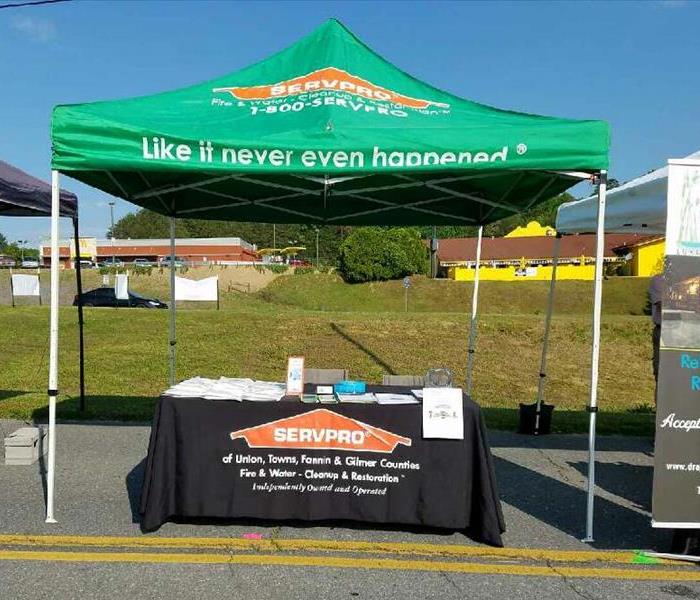 Our booth at the 2016 Apple Blossom Festival in Ellijay, GA.
Our booth at the 2016 Apple Blossom Festival in Ellijay, GA.
SERVPRO of Union, Towns, Fannin & Gilmer Counties had a booth at the 2016 Apple Blossom Festival in Ellijay, GA!
We spent the day informing people about just what we do here at SERVPRO of Union, Towns, Fannin & Gilmer Counties.
Smoke Alarm Campaign 2016
6/10/2016 (Permalink)
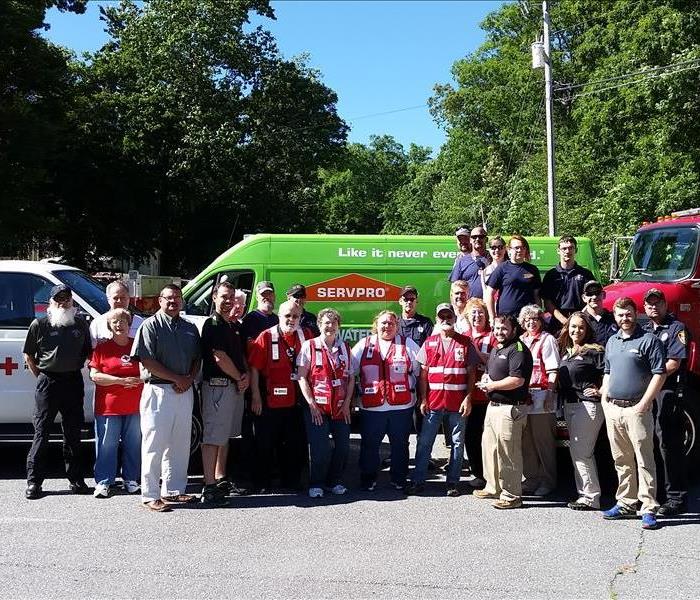 Owner, Keith Wall, and our SERVPRO crew with the American Red Cross and the Towns County Fire Department.
Owner, Keith Wall, and our SERVPRO crew with the American Red Cross and the Towns County Fire Department.
The Red Cross DAT team and the Towns County Fire Dept. finished up their third SMOKE ALARM CAMPAIGN in Towns County and welcomed their new community partner SERVPRO of Union, Towns, Fannin & Gilmer Counties. SERVPRO was a great addition to the team that provided much needed additional manpower, as well as, additional smoke alarms.
Red Cross is in its second year of working with Fire Chief Harold Copeland and his fire fighters on the Smoke Alarms Saves Lives Campaign. This campaign was a program started by the Red Cross nationwide 3 years ago in an effort to reduce injuries and deaths in house fires by 25% within 5 years. On Wednesday, June 8th, we installed 150 new 10year lithium battery smoke alarms in 51 homes in Towns County that couldn't afford them, didn't have working smoke alarms, or had old ones that needed replacing. We also proudly expanded this program to include Veterans in need of these alarms.
The Red Cross and Fire Dept. would like to especially thank Mr. Keith Wall, Owner, of SERVPRO of Union, Towns, Fannin & Gilmer Counties and his team who are now a permanent member of this campaign going forward for all their time and efforts supporting this life saving campaign and for the purchase of the additional alarms needed. We'd like to thank Home Depot of Blairsville for their discounts on those smoke alarms.
We'd also would like to thank additional businesses in Hiawassee that supported us in this campaign. They are Hiawassee Hardware who provided batteries to be used in some current existing alarms, as well as, Hardee's, McDonalds and Zaxby's for
providing food for all the volunteers who came out to work this event. And last but not least thank you to all the workers, SERVPRO employees, Fire Fighters and Red Cross volunteers, this couldn't have been accomplished without you.
What to Do in A Flood!
6/1/2016 (Permalink)
Floods are one of the most common and widespread natural disasters in the United States, causing more damage than any other weather-related disaster. The location of your home or business has little to do with your risk factor for flooding. Just because you haven’t experienced a flood in the past, doesn’t mean you won’t in the future. According to the National Flood Insurance Program (NFIP), 20% of all claims were for policies in low-risk communities. Floods cost an average of $3 billion in annual losses with the average Commercial claims being $75,000,000.
The American Red Cross (ARC) offers the following flood safety tips:
Stay away from flood waters. If you come up on a flowing stream where the water is above your ankles, stop, turn around and go another way. Six inches of swiftly moving water can sweep you off of your feet.
Do not try to drive on a flooded road. If you approach a roadway that is flooded, turn around and go another way. If you are caught on a flooded road and the water is rising rapidly, get out of the car and get to higher ground. Most cars can be swept away by less than two of moving water.
Keep children out of the water. Children are curious and lack judgement about running water and contaminated water.
That’s pretty basic…so here are some less well known tips to keep you safer in a flood!
If you have time, secure your home. Bring in outdoor furniture. Move essential items to an upper floor.Do not walk through moving water.Use a stick to check the firmness of the ground in front of you.Turn off utilities at the main switches or valves if instructed to do so. Disconnect electrical appliances. Do not touch electrical equipment if you are wet or standing in water.Six inches of water will reach the bottom of most passenger cars causing loss of control and possible stalling.A foot of water will float many vehicles.After a Flood
Listen for news reports to learn whether the community’s water supply is safe to drink.Be aware of areas where floodwaters have receded. Roads may have weakened and could collapse under the weight of a car. Clean and disinfect everything that got wet. Mud left from floodwater can contain sewage and chemicals. Call SERVPRO of Union, Towns, Fannin & Gilmer Counties to help with cleanup, we have the equipment and expertise to restore your home to it's former glory.
Flood Safety Tips
4/28/2016 (Permalink)
Even though we live in the mountains, there is the potential for flooding. Anywhere it can rain, it can flood. The most dangerous type of flood, a flash flood, happens quickly with little or no warning. Just ask the people who live in Gilmer County who experienced flooding in early August--or the people in Union County who experienced flooding in early July.
Here are some tips provided by ready.gov to keep you safe during floods:
Do not walk through moving water. Six inches of moving water can make you fall.Do not drive into flooded areas. If floodwaters rise around your car, abandon the car and move to higher ground if you can do so safely. You and the vehicle can be swept away quickly.Avoid floodwaters; water may be contaminated by oil, gasoline, or raw sewage.If your property suffers flood damage, clean and disinfect everything that got wet. Mud left from floodwaters can contain sewage and chemicals.
National Preparedness Month
4/28/2016 (Permalink)
SERVPRO Industries, Inc. is once again proud to be a member of the National Preparedness Month Coalition and is committed to helping the U.S. Department of Homeland Security in their efforts to promote the importance of preparedness planning.
What does it mean to be prepared?
For FAMILIES, it means households have an emergency supply kit so they can be self-reliant for at least three days in case of emergency, and they have a plan for how they will respond and reconnect after an emergency.
For BUSINESSES, it means employers have planned for how they will survive a disaster; they've backed up critical information, developed a plan for assisting employees on site, established a call tree to account for employees, and identified back-up sources of power and supplies.
For SCHOOLS, it means schools and districts have developed, implemented, and communicated crisis plans.
Being prepared means staying informed, knowing how to get information and alerts from local ememrgency management agencies, and understanding the specific risks in your community and preparing against them.
Is Your Business Prepared for a Fire?
4/28/2016 (Permalink)
How prepared are you? Do you have a fire escape plan for your business? A fire can spread quickly, leaving only mnutes to escape. Having a plan in place prior to an emergency will allow you and your employees to exit quickly in the event of a fire. We at SERVPRO can help you plan for a fire or other emergency by creating an Emergency Ready Profile (ERP) for your facility. The ERP is a comprehensive document containing critical information about your business, including: emergency contact information, shut-off valve locations and priority areas. The ERP is a no-cost assessment. All it requires is a little time, making it a great value that could save a lot of time in the future. Call us at 706-896-1880 or 706-273-7776 to schedule an appointment to begin your ERP.
Flooded Home Results in Mold
4/28/2016 (Permalink)
An unrecognized water loss resulted in this home being over-run with large amounts of mold. The home was a second home in Blairsville, GA and was not frequently visited. This photo shows what moisture left unattended can lead to.
If you see visible mold, do not disturb it. You can inadvertently spread the mold infestation throughout your home. When mold is disturbed, the mold can release microscopic mold spores which become airborne and can circulate inside your home.
What to Do:
- Stay out of affected areas.
- Turn off the HVAC system and fans.
- Contact SERVPRO of Union, Towns, Fannin & Gilmer Counties for mold remediation services.
What Not to Do:
- Don’t touch or disturb the mold.
- Don’t blow air across any surfaces with visible or suspected mold growth.
- Don’t attempt to dry the area yourself.
- Don’t spray bleach or other disinfectants on the mold.
SERVPRO of Union, Towns, Fannin & Gilmer Counties was called in to handle the damage to this home. The owners of this property were overjoyed with the results.
Frozen Pipes in North Georgia
4/28/2016 (Permalink)
It is very important, if you own a second home or are going to be gone for an extended period of time, that some form of heat if left on if the temperatures could get to freezing or below.
Most feel that they will be saving SO much money by turning off all their heat. But how much money is going to be saved when you come home to busted water pipes that have resulted in this type of damage?
Fire And Water Restoration Needs Immediate Attention
4/21/2016 (Permalink)
Houses can suffer a great deal of damage from a natural catastrophe, making fire and water restoration jobs two of the most common emergency services. It is even more common for these damages to arise from within the home itself, be it from faulty pipes or improper construction. Families shouldn’t suffer beyond the physical damage of their houses, so it becomes imperative to seek out only certified technicians in order to properly repair a home. Since these disasters can quickly get out of hand and will get worse as time goes on, one must move to expediently address the damages.
Depending on where the source is, rain and storm damage will begin to erode the bare surfaces surrounding it. Drywall for instance is one of the first victims, as it will quickly become saturated and discolored, eventually losing its structural integrity and collapsing. Fire and water restoration typically involves a thorough inspection of the premises, as the underlying source must be identified and treated in order to properly prevent the building from future damages. Carpet, furniture and electronics can all be damaged or destroyed if the problem is not dealt with in a reasonable time frame and by certified technicians.
The process for resolving this type of damage involves removing any saturated drywall and replacing it with new material. In order to maintain the appearance throughout the home, technicians will affix the new drywall with the proper fasteners and it is then sanded down to match the surrounding wall. Further complications, either from waiting too long to treat, or from improper drying, involve the growth of mold throughout the home. To avoid this, technicians will use air mover fans and dehumidifiers to accelerate the natural drying process and fully remove the threat.
As destructive as floods and pipe breakages can be, damages from a blaze can be just as disastrous. IICRC-certified fire and water restoration crews use only the most recent and effective means in treating these types of disasters. While the worst-case scenarios involve the destruction of the entire building, blazes can affect many different things in a building, even if they were very small. For instance, soot is notorious for spreading into every nook and cranny. While it can be nearly impossible to remove it by one’s self, trained technicians utilize large HEPA certified vacuums and thermal fogging machines to remove all traces completely.
On top of the immediate damage, fire and water restoration crews are necessary for removing the residual damage that can linger from old disasters. Only trained technicians can properly inspect a building or home in order to uncover problem areas such as damp materials and ash. Damp materials can foster mold growth, while ash can corrode metal, scratch glass, and when left untreated for long enough time, it can cause a strong, unpleasant odor.
www.IICRC.org
Water Damage
4/21/2016 (Permalink)
When the Pipes Crack: Tips to Prevent Water Damage
When extreme temperatures strike, homeowners across the U.S. are crippled with millions of dollars in water damage to homes and buildings.
Leaving a home alone can become an expensive implication if things go astray while you are gone. And unfortunately more often than not, things do go wrong. Opportunely, there are certain things homeowners can do to protect their home and the interior possessions.
Water is the homeowners’ biggest enemy. If a pipe were to burst thousands of gallons of water can begin to flood the home. The IICRC responds as an authority on pulling the pieces back together for home and business owners. When water damage results from cracked pipes, IICRC offers these tips for clean-up.
To Prevent Frozen Pipes:
• Wrap electrical heating tape on exterior pipes. Remove garden hoses from faucets.
• Cover pipes with foam rubber or fiberglass insulation and secure it with tape.
• Let cold and hot water faucets drip. Running water helps prevent freezing pipes and reduces pressure build up in them.
• Inside the home, open kitchen and bathroom cabinet doors to promote warm air circulation around plumbing.
• Leave the thermostat at the same temperature both day and night, at least 55°F.
To Thaw Frozen Pipes:
• Locate the problem pipe, if possible, and open a faucet. As the pipe thaws, running water aids the melting process.
• Apply heat to the frozen section using a hand-held hair dryer or portable electric space heater. Do not use a blow torch as it could cause the pipe to explode. Do not use a propane or kerosene heater as these are hazardous for indoor use.
• If you are unable to locate or access the frozen pipe area, call a licensed plumber.
• If all else fails and you experience a burst pipe that results in water damage, shut off the main water valve and contact a professional water damage restoration company with trained technicians and extraction, drying and dehumidifying equipment.
If Water Damage Occurs, Tips for Clean-Up:
• Shut off the main water valve, if practical, and call a plumber to fix the leak.
• Call an IICRC-certified professional water restoration firm immediately for mitigation services, as required by your insurance policy. Certified Firms have the knowledge, experience and equipment to locate water wherever it goes, remove the excess, and dry your structure to industry standards.
• Mop up standing water on flooring surfaces to prevent slip/fall hazards. If the burst pipe is overhead, drain ceiling cavities by punching “weep” holes.
• Prevent mold growth. Although it takes a few days to appear, mold thrives on wood, paper, particle board or even household soil, when stagnant air, moisture, and temperatures between 68 and 86 degrees are present.
• Wet clothing usually is salvageable. A 10-minute wash cycle in detergent and hot water should sanitize washable clothing and many household fabrics.
• Dry out before you rebuild. Professional water restorers have a variety of instruments to determine when a building is dry, to prevent on-going microbial growth. Drying should not stop until wood or drywall moisture content (MC) falls below 16% MC. Normal MC is around 10% in most areas of the country.
www.iicrc.org
Hiring Rug Cleaning Services Instead Of Attempting DIY
4/21/2016 (Permalink)
Choosing to hire certified rug cleaning services rather than opting to tackle a more DIY approach is the best option for any homeowner. While the process may seem as simple as a good vacuum and spot removal job, those alone will not help in prolonging the life of the rug. Many are instead leaving it up to a technician that has been highly educated and trained through the Institute of Inspection, Cleaning, and Restoration Certification (IICRC) will ensure the job is done properly. They have the latest tools and skills to carry out the job with the utmost care and detail.
An increasing number of homeowners are finding themselves with area rugs in one or more rooms of their living space. Typically, they take quite a bit of abuse due to the day-to-day wear and tear done by family, pets, and guests. That heavy foot traffic leaves dirt, dust, odors and stains behind. What started out as a useful, yet decorative piece in a room ends up looking worn, dingy, and full of bothersome allergens. Routine upkeep such as vacuuming and minor stain removal can be done, yet it is imperative to have the piece removed and professionally cleaned on a regular basis. The frequency of this process truly depends on the extent of use the piece has.
Technicians that are IICRC-certified have had the coursework and training necessary to provide superior rug cleaning services. From start to finish they will work tirelessly to restore the piece to its original, vibrant appearance. This attention to detail starts with an initial inspection to establish the type of material that will be dealt with, what debris and allergens are present, and if there is any damage to be addressed. At this time they will be able to give the homeowner an idea of the extent of treatment and time frame required. Typically the piece is removed from the home and brought to the business location, which is fully equipped to complete the job. The technician starts with a careful vacuuming to remove loose debris, which is followed by any needed stain and damage treatment, and a good rinse. Once completely dampened a gentle but effective cleansing solution is applied and a soft agitating brush is used on the surface. A hot water extraction technique may be utilized at this time for a deeper clean or it may go through a total immersion process. The rug is then meticulously rinsed.. Depending on the equipment in place, it may be placed in a rotating centrifuge to draw out a majority of the water or other another extraction method may be utilized. It is hung for complete drying before being transported and delivered back to the home. Prior to final delivery it will be groomed via a finishing brush and a combing of the fringe to complete its pristine appearance.
While the do-it-yourself approach may seem doable to some, a true comprehensive treatment can only be done by those certified to perform these specialized rug cleaning services. It is important for homeowners to do a little investigating prior to choosing the firm to entrust with the job. Personal and online recommendations are a great starting point, as is the IICRC's own website. They provide a database of certified firms that are current on their training and continue to follow the industry standards. Additionally, viewing their website, contacting the business directly, and even visiting their facility will offer insight into the service and result to be expected.
For most, this type of floor covering was an investment in the home's warmth and overall decor. While it is there to be walked upon, it is also important to protect and maintain it regularly.
www.iicrc.org
Home Carpet Cleaning Should Always Involve Professionals
4/21/2016 (Permalink)
Frequent home carpet cleaning is the only sure way to keep carpeting in good shape, but too many people still neglect to perform it often enough. Carpeting sustains a lot of wear and tear, picking up pet dander, soils, food particles, water, chemical residues, and a number of other contaminants. If these contaminants are allowed to sit for too long, they can damage the fibers, discolor them, or even attract pests or mold. It’s a situation no homeowner wants to get into, and professional treatment is the only way to ensure it doesn’t become a reality.
Why should professionals be brought in to perform home carpet cleaning?
It’s often impossible to know just how soiled the carpeting is, so it’s best to ensure treatment is thorough. And when it comes to thorough treatment, certified technicians are a homeowner’s best bet. Store bought or rented machines are limited in their effectiveness, and don’t provide the same level of performance that a commercial machine offers. Rented machines can’t agitate the fibers as vigorously, they can’t penetrate as deeply as a commercial machines, and they aren’t as precise. This leads to inferior treatment and rapid resoiling of the carpeting.
While operating rental machinery may seem simple, there’s more to the process than one might realize. The biggest problems untrained people have when cleaning their carpets is using too much or too little water. With too little water, it will be impossible to effectively remove soils, and detergent residue will be left behind to dry and adhere to the flooring. Too much water, and the floor will remain damp for too long, allowing mold and pests to take root, and making it easy for people to dirty the flooring again. A lack of training is not the only issue, either, as rented machinery isn’t as precise at dispensing water, nor is it powerful enough to reliably extract it.
Professional home carpet cleaning firms do not have these issues, as they are certified in the best industry practices and have the commercial quality equipment to match their expertise. For example, certified crews have received training from the Institute of Inspection, Cleaning and Restoration Certification (IICRC), and are armed with the IICRC’s sophisticated treatment practices. This includes comprehensive procedures in removing dry soil, suspending matted-in soils, and removing them as well. Soil suspension and removal is not something a homeowner is equipped to handle, and that’s a problem because most of the worst soils are matted into the flooring.
Certified home carpet cleaning professionals have powerful technology, including water extraction machines that agitate the fibers down to the backing. Professionals can also treat the carpeting to protect it from additional soiling and extend the carpeting’s longevity. It’s much more affordable than replacing the carpet, and much less of a headache, so professional treatment should be considered an investment, and not just a service.
www.iicrc.org
The Damage Water Causes Can Be Permanent If Not Treated Properly
4/21/2016 (Permalink)
The kind of damage water can create in the home is staggering, and if not dealt with promptly, it may result in permanent issues for the homeowner. Excess moisture is a constant enemy in buildings, seeping in around windows, through the HVAC system, from the plumbing, and even through the air every time a door is opened. As long as the home is maintained well, this isn’t a problem, but a flood or burst pipe can quickly change the situation.
What damage can water cause in the home?
Excess moisture is unique in its destructive capabilities. Not only can it create significant and immediate physical devastation, it can make the home a hotspot for bacteria, viruses and molds. Floods are particularly troublesome, as they can fill the home with contaminated water.
When a flood slams into a building, it gathers in the lowest rooms, soaking everything in its wake. The flood brings in many hazards with it, sometimes including wildlife, chemical runoff, and various pathogens. For this reason, untrained people are strongly cautioned not to enter a building that has been wracked by a flood, as they may be bit or stung by dangerous wildlife. Chemical runoff includes fertilizers, road oils, and precipitants sitting on rooftops. This can make the fluid highly toxic and leave stains and odors.
But perhaps the most concerning damage water creates is pathological. Floods pick up fluid from rivers, lakes and ditches, and this fluid may contain cholera, hepatitis, dysentery and salmonella. It can wash in molds as well, turning the home into a biological hazard. What makes microbes especially dangerous in the home is that most houses are filled with organic materials, and these provide ideal conditions for microbes to grow. Drywall, carpets, upholstery, and wood are among the organic materials microbes may latch onto, and within 48 hours, any material that has been soaked through with contaminated fluid will usually be beyond salvaging. And even if the fluid is mostly benign, the withering exposure to moisture can yellow drywall and erode its integrity, and cause wood to warp.
There is no getting around it, the kind of damage water can produce is staggering, and it’s capable of leaving a building in a condemnable condition.
That’s why restoration firms are equipped to respond to disasters day and night, and are ready to treat floods and plumbing mishaps right away. Certified restoration firms, like those trained through the Institute of Inspection, Cleaning and Restoration Certification (IICRC), have the skills and tools needed to deal with all kinds of moisture related disasters. Within a few days, restoration firms can remove all signs of excess moisture, saving sensitive materials, drying out the home, and destroying any signs of mold and microbes.
Floods and plumbing disasters cannot be ignored, and when they do emerge, the only way to deal with them safely is with a certified professional’s help.
www.iicrc.org
The Next Step After Having Fire And Water Damage
4/21/2016 (Permalink)
Fire and water damage are nightmares for any home or business owner because they typically force expensive repairs. This is particularly true when the building is flooded or a pipe bursts. Such disasters can destroy entire floors of a building, and make it uninhabitable until it is cleaned out. But cleaning it out is something that only professionals should be allowed to handle, especially if there is contaminated fluid or a lot of ash residue present. Certified technicians will have the tools and expertise needed to restore the building to normal and allow people to work or live in it without fear of health issues.
How do professionals perform fire and water damage restoration?
The only way to deal with a flame’s aftermath is to clean the area up thoroughly. Even a small fire can leave behind a good deal of ash and soot, and it will become more than just an annoyance if it is allowed to spread through the building. Smoke is another concern, as it will create noxious odors that penetrate through walls and seemingly last forever. Technicians are prepared to work through the building, scrubbing down all affected surfaces, and surveying the property to find areas where the residue has settled. This includes the ventilation system as well, as ash is readily picked up by the building’s climate control system. In places where the residue has formed a thick, almost lacquer-like substance, technicians have special detergents that can eat through the muck and make it easy to wipe away. As for smoke odors, professionals typically use a device known as a thermal fogger. This device will fill the building with particles designed to neutralize smoke odors, and these particles are small enough to reach through walls, so they can go where the smoke is.
Floods, sewage backflows and plumbing disasters offer their own challenges, and take a lot of equipment that only fire and water damage restoration professionals have access to. For example, if the building is harboring several inches of water, industrial strength pumps will be needed to pull it out, and these pumps are often mounted to a truck. Once this is done, trained professionals will be able to identify what materials can be rescued and what materials are completely compromised. It is essential to get this part right because destroyed materials that are left behind can ferment mold and bacterial growth.
Technicians will then work to dry the building, a process that requires several heavy duty air mover fans and dehumidifiers. This normally takes several days to see through, and technicians will monitor drying progress with moisture meters and regular inspections. Also, if there are any areas infested with mold or other microbes, fire and water damage restoration professionals can eliminate the threat with fungicides or other cleaning solutions.
Certified fire and water damage restoration professionals are the people to call when disaster strikes. They can operate in any environment and ensure a building is as good as new, giving people the peace of mind they need when returning home or to work.
www.iicrc.org
Summer Safety Tips!
4/21/2016 (Permalink)
Summer is synonymous with barbecues, parades and fireworks displays; but along with all the festivities are plenty of visits to emergency rooms-especially during July.
In 2013, eight people died and about 11,400 were injured badly enough to require medical treatment after fireworks-related incidents, according to the U.S. Consumer Product Safety Commission. In addition to causing injury, fireworks are also responsible for thousands of house fires each year with millions of dollars in property damage.
There is nothing like firing up the grill during the summer months! Did you know, July is the peak month for grills fires? A backyard barbecue can become dangerous quickly if proper safety precautions aren't considered. SERVPRO of Union, Towns, Fannin & Gilmer Counties wants you to have an enjoyable and safe summer. Consider the following tips to ensure your summer celebrations are disaster-free!
- Propane and charcoal BBQ grills should only be used outdoors.
- The grill should be placed well away from the home, deck railings and out from under eaves and overhanging branches.
- Keep children and pets away from grill area.
- Keep your grill clean by removing grease or fat buildup from the grills and in trays below the grill.
- When using a charcoal grill, let the coals completely cool before disposing in a metal container.
- Never leave your grill unattended.
- Anyone using fireworks or standing nearby should wear protective eyewear.
- Do not try to re-light or handle malfunctioning fireworks. Keep a bucket of water nearby to fully extinguish fireworks that don't go off or in case of fire. Children should never pick up fireworks that may be left over, as they may still be active.
- The safest way to enjoy fireworks is to attend a public display conducted by trained professionals.
Choosing the Proper Fire Extinguisher
4/21/2016 (Permalink)
A fire extinguisher can be a life-saving tool when used correctly. The U.S. Fire Administration (USFA) recommends individuals are properly trained in order to use and maintain an extinguisher.
USFA says an extinguisher should only be used if:
- You have alerted other occupants and someone has called the fire department.
- The fire is small and contained to a single object, such as a wastebasket.
- You are safe from the toxic smoke produced by the fire.
- You have a means of escape identified and the fire is not between you and the fire escape route.
- Your instincts tell you that it is safe to use an extinguisher.
Classes of Fire Extinguishers:
Class A: Use on ordinary combustible materials, such as cloth, wood, rubber, paper, and many plastics.
Class B: Use on flammable liquids, such as grease, gasoline and oil.
Class C: Use on appliances, tools, or other equipment that is electrically energized or plugged in.
Class D: Use on flammable metals and are often specific for the type of metal in question. These are typically found only in factories working with these metals.
Class K: Use on vegetable oils, animal oils, or fats in cooking appliances. These are generally found in commercial kitchens, but are suitable for the residential market.
Check out the Fire Equipment Manufacturers Association for more information about fire extinguisher use, type and care.
Damage from Water Should be Cleaned by Certified Professionals
4/21/2016 (Permalink)
The amount of damage water can cause is amazing, and often underestimated by homeowners. Excess moisture is bad enough, but when a home is flooded or hit with a plumbing disaster (like a burst pipe), the situation can quickly get out of hand. There’s a reason why these incidents are among the most expensive problems a homeowner can face. Contaminated water not only creates immediate structural problems, it can leave serious biological threats behind after it has been removed.
Floods, sewage backflows, and other sources of contaminated fluid usually cause the worst damage. Dirty water is filled with all kinds of harmful substances, ranging from chemical residues to animal feces to parasites. Bacteria, viruses and fungi grow explosively in contaminated fluid, and severe health risks, like salmonella and hepatitis, are common in flood waters.
This problem is compounded by the composition of most homes, which are filled with organic materials. Drywall, wood and the matter that is trapped in carpet fibers are just a few examples, and they can give pathogens room to grow. Within 48 hours, mold may begin creeping behind the walls and releasing spores, and any organic materials that have been soaked through by contaminated fluid will usually have to be destroyed.
That’s why restoration firms, in addition to surveying the home for structural problems, will dry the home quickly and apply antibacterial, antiviral, and antifungal agents to all surfaces that had contact with the water. This ensures the family can return to a safe home, and not one harboring a collection of harmful pathogens.
www.iicrc.org
How To Choose Water Damage Restoration Services
4/12/2016 (Permalink)
When a storm leaves a home flooded, or a burst pipe causes serious issues in the house, getting water damage restoration services from a respected company should be considered a top priority. Unfortunately, this industry is not regulated, and there are people out there who pose as professionals or overstate their qualifications. Therefore, homeowners should be mindful of who they hire, as an untrained technician may do more harm than good or delay repairs, resulting in a higher degree of destruction. Before selecting a company to handle the job, keep in mind these points of emphasis:
· Only choose certified professionals to perform water damage restoration services. Even though the industry is not regulated, technicians who have received certification have made the effort to get the best training possible, proving that they take their job seriously. Certification through the Institute of Inspection, Cleaning and Restoration Certification (IICRC) is a sign that a professional has received the most up to date training and is knowledgeable in the latest techniques and technologies employed during repairs. The IICRC operates a Certified Firm registrant-only database on its site, making it easy to find a local, certified professional without trouble.
· Do not select a technician based only on the price or an insurance company’s recommendation. When possible, speak to neighbors or friends who have had to hire a technician recently and try to get a recommendation from them. Insurance companies often select a restoration company based on price, and unusually low pricing suggests the company does not use modern drying or repair methods.
· Choose a company that offers a range of water damage restoration services. The easiest way to determine the expertise of a firm is to see if they provide a full range of options for homeowners. Mold remediation, for example, is often needed given how quickly mold can set in. This is a standard field of knowledge that advanced technicians should possess. If a company doesn’t offer mold remediation, it may not be prepared for all job settings.
· A company that is available 24/7 is a good sign. Stay away from any firms that are reluctant to start right away. In many cases modern equipment can enable near-complete drying in as little as 36 hours, although many situations require longer. Also, a homeowner should not have to wait before repairs begin. Every minute counts when there is standing water present, and reputable professionals understand this. If a technician insists on waiting to begin the remediation portion of the loss, they probably cannot be trusted to see the job through in a reasonable timeframe.
Using these guidelines, a homeowner should be able to find a technician that can be trusted and is equipped to do the job the right way. A storm or other disaster is hard enough to deal with, and a remediation firm should do everything in its power to make this difficult process easier.
http://www.iicrc.org/
Ready for Whatever Happens!
4/5/2016 (Permalink)
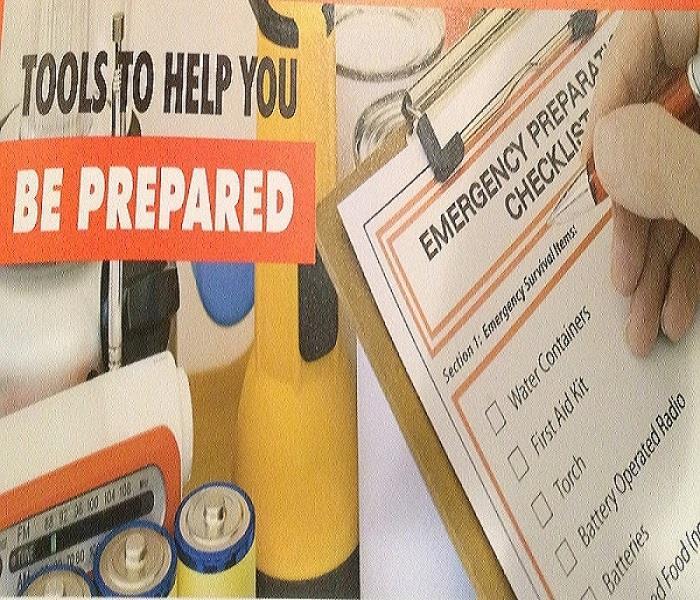 SERVPRO of Union, Towns, Fannin & Gilmer Counties is always "Ready for whatever happens!"
SERVPRO of Union, Towns, Fannin & Gilmer Counties is always "Ready for whatever happens!"
As severe weather approaches, you and your family are reminded to check our emergency supply kits, we are also reminded of the SERVPRO slogan "Ready for whatever happens". The U.S. Department of Homeland Security recommends having at least one full emergency supply kit for your home and smaller portable kits for your office and vehicles.
A basic emergency supply kit should contain at least the following:
- Water (one gallon per person per day)
- Food (non-perishable 3-day supply)
- Manual can opener
- Battery operated radio, preferably a NOAA weather radio
- Flashlight and extra batteries
- First aid kit
- Whistle to signal for help
- Clothing
- Dust masks or bandanas
- Plastic sheeting, garbage bags and duct tape
- Wrench or pliers to turn off utilities
- Hygiene items
- Important documents; copies of insurance policies, ID and bank account information
- Cash
- Fire extinguisher
- Matches in a waterproof container
Remember, this is only a basic kit. Your circumstances may require additional items. Check out the U.S. Department of Homeland Security website on readiness at www.ready.gov for more information. You can also contact SERVPRO of Union, Towns, Fannin & Gilmer Counties to learn more and be "Ready for whatever happens!"
SERVPRO Ranks #7 on 2015 Franchise 500 List
4/16/2015 (Permalink)
SERVPRO maintains its hold on the No. 7 spot overall on the Entrepreneur magazine's 2015 Franchise 500 list. This recognition marks the sixth consecutive year Entrepreneur has included the company in its Top 10 list and the 12th consecutive year SERVPRO has earned the top spot on the magazine's list in its own industry-Restoration Services.
'It's very satisfying to represent the ongoing brand leadership of SERVPRO for disaster cleanup and restoration services in the Union, Towns, Fannin & Gilmer Counties areas," said Keith Wall, owner of SERVPRO of Union, Towns, Fannin & Gilmer Counties. "As a SERVPRO franchise, we have the tools and knowledge--and the responsibility--to provide the best possible service to every customer."
2014 Georgia SERVPRO Franchise of the Year
2/25/2015 (Permalink)
We are excited, humbled and blessed to announce the we were named the 2014 Georgia SERVPRO Franchise of the Year at the State meeting on February 20th. We are grateful to our customers for their trust in us, to our employees for the hard work they perform all the time, and to those who refer business to us. We will always work to make our customers feel comfortable and confident as we bring their homes and businesses back to pre-loss conditions. "Like it never even happened."
Super Bowl Squares Winners
2/5/2015 (Permalink)
Congratulations to the winners of our 2015 Super Bowl Squares. Allison from Jeff Davis State Farm in Blairsville, Brenda from The Insurance Mart in Blue Ridge X 2 and Haley from Kevin Panter Insurance in Blue Ridge. Glad we could share the excitement with these and a HUGE Thank You to ALL who participated.
Light Up Ellijay Parade
12/5/2014 (Permalink)
 Light Up Ellijay Parade
Light Up Ellijay Parade
Fun Times at the Light Up Ellijay Parade
Employee of the Month
10/7/2014 (Permalink)
 Employee of the Month
Employee of the Month
Congratulations to Russ Clouchete for being our September Employee of the Month. Russ was chosen for his hard work and attention to detail. Russ is also responsible for all the mechanic work at our company and does a great job of staying on top of any issues. Russ was awarded a $150 gift certificate at the place of his choice. WAY TO GO RUSS!
Winner of Tablet at Kiwanis Rodeo in Blue Ridge
8/21/2014 (Permalink)
Congratulations to Christine Tipton of Copper Hill, TN for being the winner of our give-a-way tablet at the Rodeo in Blue Ridge on August 16th. A huge Thank You for everyone who visited our booth.
Production Crew
5/30/2014 (Permalink)
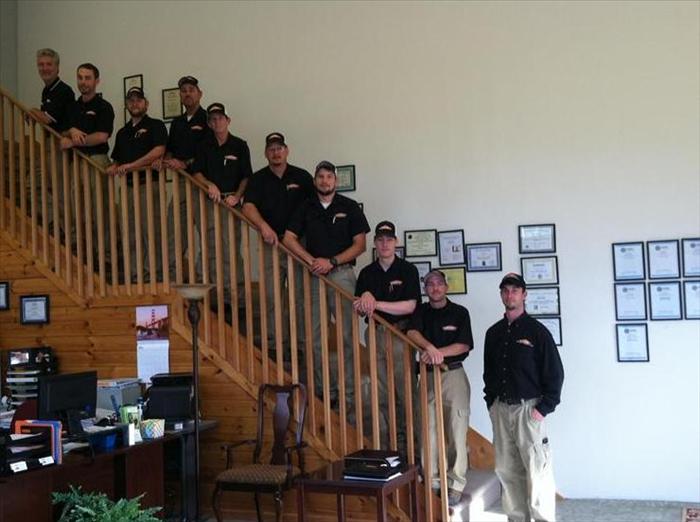 From Left to Right: Owner-Keith Wall, Production Manager-Matthew Parton, Brett, John, Russ, David, Kaleb, Dalton, Roy and Jason.
From Left to Right: Owner-Keith Wall, Production Manager-Matthew Parton, Brett, John, Russ, David, Kaleb, Dalton, Roy and Jason.
Our Production Crew and their new uniforms. A huge thank you to all of our guys for their hard work and continually putting their best foot forward to do their best. So proud of them! Thank you for all you do!!






 24/7 Emergency Service
24/7 Emergency Service







































































































